



21 March 13:00





21 March 13:00
Celtic and Greek coins
Roman Provincial Coins
Roman Coins: Republican, Imperatorial and Imperial Migrationary and Byzantine coins
Islamic, Medieval and World coins
22 March 13:00
The Pavlos S. Pavlou Collection of Ptolemaic coins
Please note the Pavlos S. Pavlou Collection is a timed auction.
Please note this is a purely internet and telephone based event and the auction will not be held at a public venue. To find out more about participating please see page iv & v.
No live bidding fees will apply.
At the office of Roma Numismatics: 40 Villiers Street London, WC2N 6NJ United Kingdom
From 26 February - 21 March
Monday - friday, 09.30 - 17.30 by appointment
To assist you with making informed bidding decisions, high resolution images of our auction lots are available upon request.
LOT PICKUP WILL BE AVAILABLE FROM 13.00 ON Monday 25 March









BID ONLINE PRIOR TO THE AUCTION, SEE BIDS UPDATED IN REAL-TIME ON THE ROMA SITE. Commission bids may be submitted prior to the auction at www.RomaNumismatics.com - these bids will be automatically executed on the website, and will then be carried over into the live auction and executed by the auctioneer on the day. Commission bids can be placed up until 12pm on the day of the sale.
Bids may be placed by telephone as the auction is in progress, but are accepted only at the discretion of Roma Numismatics and at the risk of the customer. Roma Numismatics will not be held responsible for any failure to execute bids by telephone during the auction resulting from technical issues, miscommunication or any other reason. Any client wishing to bid by telephone should inform Roma Numismatics no later than 72 hours before the auction, and should have a prepared list of all the lots they wish to bid on.
You may submit an absentee bid that will be executed on your behalf by Roma Numismatics. Roma Numismatics will attempt to obtain the lot for you at the lowest possible price, and will not purchase the lot for you at a price higher than the maximum you specify. This service is free and confidential. Absentee bids must be sent and received in good time.
To place absentee bids please submit your list of lots, together with your maximum bids by email, or online at www.romanumismatics.com.
You may participate live online during the sale at www.RomaNumismatics.com. NO LIVE BIDDING FEES WILL APPLY FOR THIS SALE


w ww.biddr.com


Real-time bids may be placed on the Roma Numismatics’ website at www.RomaNumismatics.com/live-bidding and at www.biddr.ch on the day of the sale. These bids will be executed live on the floor. Roma Numismatics is not responsible for any missed lots or bids due to network speed or down-time. It is advisable to register as early as possible for these services. NO LIVE BIDDING FEES WILL APPLY FOR THIS SALE.
Successful bidders will be notified and invoiced normally within 24 hours of the auction. Prices realised will be published around the same time.
We are now able to offer shipment to EU clients with qualifying invoices via our partner office in the Netherlands. NL import VAT of 9% and a service charge of £200 will be payable in addition to normal shipping charges. This service is upon request only and available to clients with invoices over £5,000 - please inform us at the point of bidding if you would like to make use of this option.

1. The following Terms and Conditions apply to Bidders of all Auctions held by Roma Numismatics Ltd. By making a Bid, the Bidder agrees to these Terms and Conditions and accepts to be bound by them.
ESTIMATES
2. All estimates for Lots are in pounds sterling (£). Any other currency displayed against a Lot is indicative only for the convenience of the Bidder and does not constitute an offer by Roma Numismatics Ltd to pay in any other currency.
DESCRIPTIONS
3. The details of any Lot(s), including a description of each item is contained in the Catalogue and/or on Roma Numismatics Ltd’s website.
4. All grades, descriptions and rarity information are the opinion of the cataloguer. Conditions of all Lot(s) are as they appear in the photographs displayed in the Catalogue and/or on the Roma Numismatics Ltd website. Condition reports are available upon request.
5. Bidders are encouraged to carefully examine in person any Lot(s) for which they intend or do Bid for as it is not possible to note all marks or defects or colours. Roma Numismatics Ltd makes no guarantee as to the physical quality or condition of any Lot(s).
6. Any prospective Bidders who exercise the opportunity to physically inspect and examine any Lot(s) in hand shall assume all responsibility and liability for any damage they cause in the course of such examination. Roma Numismatics Ltd shall have sole discretion in determining the value of any damage caused, which shall be promptly paid to Roma Numismatics Ltd by the prospective Bidder.
7. Roma Numismatics Ltd guarantees the absolute authenticity of all Lots Sold. There is no expiration to this guarantee.
8. Unless otherwise determined at the discretion of the auctioneer, opening Bids will be 60% of the estimate unless there are existing higher Bids.
9. A Bid, once placed, is final. A Bid cannot be revoked.
10. A Bid is placed:
10.1. In the case of a Live (Printed) Auction when the auctioneer acknowledges a Bid and communicates to the other Bidders participating in the Auction that the Bid price has been altered accordingly; or
10.2. In the case of an Absentee (mail or other written) Bid, when a Bid is received by Roma Numismatics Ltd no later than one hour before the commencement of an Auction at which the Lot is due to be auctioned. It is the Bidder’s responsibility to ensure that Absentee Bid(s), whether submitted via the Roma Numismatics Ltd website or by other acceptable means, are accurate and placed in accordance with this sub-clause. Bids received after this point are not guaranteed to be accepted, but when accepted and executed the Bidder is subject to the same terms above.
11. If your Bid is successful You will become the Buyer of that particular Lot and be liable to pay the Hammer Price, plus those applicable charges and fees set out in the “Charges & Payment” section in these Terms and Conditions.
12. Roma Numismatics Ltd shall have absolute discretion to accept or decline any Bid, withdraw Lots from sale or re-open Bidding for any Lot at any time, whether before or after a Lot is Sold, until such time as the Buyer takes physical possession of the Lot, in circumstances which may include, but are not limited to (1) a bidding error has occurred (2) Roma Numismatics Ltd becomes aware of a dispute in relation to the Lot, Sale or Auction (3) Roma Numismatics Ltd has not received payment for the Lot.
13. For the protection of Absentee Bids, no ‘unlimited’ or ‘buy’ Bids will be accepted by Roma Numismatics Ltd.
14. When identical Bids are received for the same Lot, preference will be given to the Bid received first. Absentee Bids will take preference over a floor Bid.
15. Some Lots may carry a Reserve. Roma Numismatics Ltd reserves the right not to sell a Lot below the Reserve, or will repurchase the item on behalf of the consignor or for the account of Roma Numismatics Ltd. If a Reserve exists Roma Numismatics Ltd reserves the right to Bid on any Lot on behalf of the consignor up to the amount of the Reserve against any other Bidders.
16. A Buyer’s Fee equivalent to 22.5% of the Hammer Price will be added to the Hammer Price and payable by the Buyer to Roma Numismatics Ltd in accordance with these Terms and Conditions:
17. VAT at the applicable rate (applicable to customers within the UK) is due on the Buyer’s Fee only, not the Hammer Price. Roma Numismatics Ltd registered VAT number is 901478828.
18. A 2% surcharge of the Hammer Price will be applied to Bids submitted via post or email, rather than being placed on the Roma Numismatics Ltd website.
19. Invoices are due immediately upon receipt by the Buyer. Roma Numismatics Ltd reserves the right to charge interest on invoices that remain unpaid for 1 calendar month after the date they become due at the rate of 2% per calendar month, except where prior agreement has been made with regards to payment.
20. The Buyer is responsible for paying all bank charges and any shipping and insurance costs.
21. Invoices are sent to Buyers by email. They can also be found listed under ‘Pending Invoices’ in the ‘My Account’ section of the Roma Numismatics Ltd’ website, and can be paid via the website by selecting the preferred payment option of BACS, PayPal or Credit/Debit card. Cash payments are no longer accepted. PayPal and Credit/Debit card payments are accepted only for invoices of £2,500 total value or less.
22. The Buyer will be required to satisfy the requirements of Roma Numismatics Ltd AML Policy before the Lot will be released. Buyers may, subject to payment of any fees or charges for delivery, either:
22.1. Collect Lots Sold to them from Roma Numismatics Ltd in person from the main office at 40 Villiers Street, London, WC2N 6NJ by prior appointment, or 22.2. Arrange with Roma Numismatics Ltd to send or deliver the Lot to the Buyer’s nominated address by post, courier or such other method as agreed with Roma Numismatics Ltd. Shipping and insurance are at the Buyer’s risk.
22.3. The Buyer is responsible for any fees and charges payable upon importation and is responsible for acquiring the necessary information on any applicable customs and import regulations in their jurisdiction.
23. Buyers shall at all times be liable for any costs or expenses incurred by Roma Numismatics Ltd associated with the Buyer’s nominated delivery method. Roma Numismatics Ltd standard delivery costs are set out in the Catalogue and on the Roma Numismatics Ltd website. Any additional costs will be as displayed in the Catalogue and /or the Roma Numismatics Ltd website.
24. Roma Numismatics Ltd shall store any Lot following Sale until shipment to the Buyer without charge.
RISK & TITLE
25. Risk in the Lot passes to the Buyer when the Buyer takes physical possession of the Lot, or the Lot is dispatched to the Buyer, whichever is the sooner.
26. Title remains with the owner until such time as all sums owed to Roma Numismatics Ltd, by the Buyer, have been received by Roma Numismatics Ltd as cleared funds into Roma Numismatics Ltd’s bank account.
27. Any Lot that is Sold that is subject to United States of America (US) or German import restrictions must be legally imported into the US or Germany (unless otherwise explicitly stated in the Lot description).
28. Our commitment to ethical and responsible provenance ensures that the Seller is required to affirm that each Lot is Their lawful property to sell, and where cultural property restrictions may exist, that to the best of their knowledge it meets the requirements to be legally imported into the US and/or Germany. Responsibility for this affirmation rests with the Seller and Roma Numismatics Ltd will not be held responsible for errors, omissions, or false statements made by the Seller
29. Roma Numismatics Ltd will endeavour to assist with provision of documentation to facilitate importations on behalf of the Buyer and enable delivery of that Lot to the Buyer’s nominated location but the Buyer is ultimately responsible for ensuring compliance with import regulations and procedures, and Roma Numismatics Ltd accepts no liability for any loss resulting from detention or seizure of any Lot by any government agency before or after delivery of the Lot.
29.1. Any Buyer, whether based in the US, Germany or elsewhere, who purchases a Lot that cannot be lawfully imported into either the US, Germany or the country of their nominated delivery address, with the intention that the Lot is sent to any of those jurisdictions, shall be deemed to purchase the Lot and will be liable to pay all fees, charges and cost that become due when Knocked Down.
30. Roma Numismatics Ltd will not, and will not be compelled to, under any circumstances accept instructions from any person, make arrangements or be required to forward or send any Lot that cannot be lawfully imported to any jurisdiction to that jurisdiction.
31. Roma Numismatics Ltd undertakes to obtain export licences for those Lots that require them.
RETURNS
32. If a Buyer suspects a Lot is not authentic they must notify Roma Numismatics Ltd as soon as possible. Rejection by any third party grading service for any reason will not by itself constitute grounds for return of the Lot(s). The Buyer must support any claim of non-authenticity by valid technical evidence provided by at least 2 (two) separate qualified firms or individuals. A Lot may only be returned to Roma Numismatics Ltd if it is agreed to be not authentic by Roma Numismatics Ltd.
33. A Lot may be returned to Roma Numismatics Ltd within 21 (twenty one) days of the Sale Date if it is materially different from its description.
34. In circumstances where a Lot is returned by a Buyer pursuant to clause 32 or 33 and Roma Numismatics Ltd agrees to a refund, the amount to be refunded to the Buyer shall be (1) the Hammer Price (2) the Buyer’s Fee (3) the surcharge paid under clause 18 (if any). In all other cases, Roma Numismatics Ltd is not liable to refund or pay a Buyer for any fees or costs associated with returning a Lot to Roma Numismatics Ltd or the refund of any shipping charges or external or 3rd party costs.
35. All refunds will be made in Pounds Sterling unless otherwise agreed. Roma Numismatics Ltd is not liable for any exchange rate differences.
36. Roma Numismatics Ltd is under no obligation to release a Lot to a Buyer until such time as the Buyer has paid Roma Numismatics Ltd. All sums that are due or which may become due as set out in these Terms and Conditions.
37. Lots will be held by Roma Numismatics Ltd for a period of 3 calendar months from the date the Lot is Knocked Down unless otherwise agreed. After 3 (three) calendar months Roma Numismatics Ltd shall be entitled to cancel the Sale and re-auction the Lot in accordance with clause 12.
38. Roma Numismatics Ltd shall not be liable to You for any loss of profits, loss of sales or business, loss of agreement or contracts, loss of anticipated savings, loss of or damage to goodwill or indirect or consequential loss.
39. Our liability to You is capped at the amount You have paid to Us in respect of a Lot.
40. Roma Numismatics Ltd does not exclude or limit in any way its liability to You where it would be unlawful.
41. Roma Numismatics Ltd shall not be in breach of these Terms and Conditions nor liable for delay in performing, or failure to perform, any of its obligations under these Terms and Conditions if such delay or failure result from events, circumstances or causes beyond its reasonable control.
42. Any notice or other communication given to a party under or in connection with these Terms and Conditions shall be in writing, addressed to that party at its registered office (if it is a company) or such other address as that party may have specified to the other party in writing, and shall be delivered personally, sent by pre-paid first class post or other next working day delivery service, commercial courier or email.
43. A notice or other communication shall be deemed to have been received if delivered personally, when left at the address referred to in clause 42w: if sent by pre-paid first class post or other next working day delivery service, at 9.00 am on the second business day after posting; if delivered by commercial courier, on the date and at the time that the courier’s delivery receipt is signed; or, if sent by email, one business day after transmission.
44. These Terms and Conditions and any document produced by Roma Numismatics Ltd or otherwise mentioned herein constitutes the entire agreement between the parties and supersedes and extinguishes all previous agreements, promises, assurances, warranties, representations and understandings between them, whether written or oral, relating to its subject matter.
45. Roma Numismatics Ltd will only use Your personal information as set out in Our privacy policy, a copy of which can be viewed at: https://www.romanumismatics.com/privacy-policy. We may amend this policy from time to time.
46. Roma Numismatics Ltd’s Anti-Money Laundering Policy (AML Policy) sets out Roma Numismatics Ltd’s policy for ensuring compliance with anti-money laundering legislation that applies to some of its activities.
47. We may amend these Terms and Conditions from time to time.
48. No failure or delay by Roma Numismatics Ltd to exercise any right or remedy provided under these Terms and Conditions or by law shall constitute a waiver of that or any other right or remedy, nor shall it prevent or restrict the further exercise of that or any other right or remedy.
49. Nobody else has any rights under these Terms and Conditions.
50. If any provision or part-provision of these Terms and Conditions is or becomes invalid, illegal or unenforceable, it shall be deemed modified to the minimum extent necessary to make it valid, legal and enforceable. If such modification is not possible, the relevant provision or part-provision shall be deemed deleted. Any modification to or deletion of a provision or part-provision under this clause shall not affect the validity and enforceability of the rest of these Terms and Conditions.
51. These Terms and Conditions and any dispute or claim (including non-contractual disputes or claims) arising out of or in connection with it or its subject matter or formation, shall be governed by and construed in accordance with the law of England and Wales.
52. Each party irrevocably agrees that the courts of England and Wales shall have exclusive jurisdiction to settle any dispute or claim (including non-contractual disputes or claims) arising out of or in connection with these Terms and Conditions or its subject matter or formation.
PAYMENT METHODS:
Invoices can found listed under ‘Pending Invoices’ in the ‘My Account’ section of the Roma Numismatics’ website, and can be paid directly through the site by selecting the preferred payment option of BACS or Credit/Debit card.
Credit/Debit Card: For invoices with a total value of £2,500 or less.
Bank Transfer: VIRGIN MONEY, 30 St Vincent Place, Glasgow, G1 2HL, UK | Account Name: Roma Numismatics
IBAN: GB90 CLYD 8211 0780 5786 60 | BIC: CLYD GB21943 | SORT CODE: 82-11-07 | ACC #: 80578660
1. We reserve the right not to enrol individuals with resident addresses in certain countries and/or regions or restrict transfers and changes of registered address. Such countries and/or regions are subject to change however reasonable advance notice will be given in circumstances where the removal of a country and/or region will affect the Membership of existing Members.
2. Membership is offered at our discretion and we may refuse Membership to any applicant or revoke said Membership at any time.
3. Membership applicants must state their full name, date of birth, preferred mailing address, email address and telephone number for correspondence.
4. Risk (for example, theft or unauthorised or fraudulent redemption) associated with Points passes to the Member as soon as Points are recorded on the Member ’s account, or otherwise awarded to the Member. We are not liable for unauthorised or fraudulent redemptions. You are the holder of Points and are responsible for their security. We are the owner of all Points and they remain our property at all times.
5. Membership will terminate automatically in the event of the expiry of all Points when a Member has not earned or redeemed or bought for 24 consecutive months; or upon the death of a Member, Points accumulated but unused at the time of death shall be cancelled together with Membership of the Scheme; or if we reasonably believe that you have committed an act of Fraud or Misconduct against us. The Member shall be liable to us for the full price of any goods or services obtained wholly or partly as a result of such Fraud and/or Misconduct and any legal fees incurred by us.
6. Members may terminate their Membership by contacting us stating that they no longer wish to be a Member. Any such termination will result in a loss of all Points and does not relieve the Member of any continuing obligations under these Terms and Conditions.
7. In the case of Fraud and/or Misconduct, we may cancel all accrued and accruing Points of the Member and any Rewards.
8. We will record Points in the Member’s personal account. Points cannot be redeemed until we have recorded it in the Member’s personal account. It will take up to 48 hours for points to be credited to the Member’s account.
9. Further details of how Points are earned and the applicable earn rates are contained on the Website.
10. Points may not be earned under the Scheme if any form of discount or preferential treatment is also received for the same activity. In the event we grant any Points in such circumstances we reserve the right to cancel the Points without notice to you.
11. Points can only be earned on the cash value of the hammer price of lots purchased at auction. Buyers’ Premiums, Vendors’ Commissions, shipping charges, external fees and any other cost or charge is not eligible. The award of Points will be calculated in accordance with the information published on our Website.
12. Points are redeemable for products and service as described on the Website, and at the redemption values stated. In the case of auction lots, Points are redeemable only against the Hammer Value in blocks of 2000 points. Members are responsible for paying Buyers’ Premiums, taxes, fees, charges and surcharges.
13. Points may be redeemed online at the Website or via the Office in accordance with such procedures that may be in force from time to time for the issue of Rewards, as set out on the Website. Redemptions can only be requested by the Member.
14. When Points have been used as part payment, the Points will be refundable only where the base product is refundable. Partial refunds will be credited to the Member’s Points account up to the value of the original part payment, with any remainder credited to the original method of payment together.
15. Except as otherwise provided by us and communicated to the Member and subject to any stated limitations, Points are not transferable in any way (whether from person to person, account to account, statement to statement, Scheme to any other loyalty type scheme or otherwise.
16. Any purported purchase, sale, transfer, unauthorised use (including bartering), procurement or redemption of Points issued or awarded to another person or any other use of Points contrary to these Terms and Conditions will, unless explicitly authorised, constitute a fundamental breach by the Member of these Terms and Conditions and therefore the contract between us.
17. Other than as provided for herein Points are not redeemable for cash, refundable or exchangeable for anything else. At no time may Points be purchased by, sold to, bartered or otherwise transferred to other persons.
18. The Buyer can buy a maximum of 1,000,000 Points in any one calendar year.
19. In normal circumstances Points will be available to use immediately but it could take up to 3 working days for Points to appear on your account.
20. Points can only be bought online at the Website. The Buyer must be a member of the Scheme, members whose accounts have expired will not be able to buy Points.
21. Buying Points will be considered as collecting Points and will reset the 24 month expiry rule.
22. You have the right to cancel contracts for the buying of Points within 14 days without giving any reason provided the Points have not been used. The cancellation period will expire after 14 days from the day on which you purchase the Points. To exercise the right to cancel, you must inform us of your decision to cancel this contract by a clear statement (e.g letter sent by post or email). If you cancel, we will reimburse to you all payment received from you. We will make the reimbursement without undue delay, and not later than 14 days after the day on which we were informed about your decision to cancel this contract.
23. Points which are subsequently refunded will not constitute activity for the purposes of the 24 month expiry rule.
24. The Buyer of a Gift can buy a maximum of 1,000,000 Points as a gift for any number of Members, in any one calendar year. Members may not buy Points as a Gift to their own account. The Buyer can only buy Points for one Recipient per transaction.
25. A Gift Recipient of bought Points can only receive a maximum of 1,000,000 Points in any one calendar year in aggregate, irrespective of the number of Buyers.
26. In order to buy Points as a gift, the Buyer will need to know the Recipient’s full name, email address and client number. The Buyer should ensure that the Recipient has not received more than 1,000,000 Points, including the proposed Points transaction, in that calendar year. Points may not be bought for a Member whose account has expired. Buying Points will reset the 24 month Points expiry rule for the recipient. The Buyer must not demand and the Recipient must not offer any value or value in kind for Points. Such activity or any other use of Points contrary to these Terms and Conditions will constitute a fundamental breach by the member of these Terms and Conditions and therefore the contract between us and the Member. In the event of such a breach, we reserve the right at any time in our absolute discretion to terminate the Membership of any member.
POINTS EXPIRY
27. If a Member has not earned or redeemed Points or bought or transferred Points for 24 consecutive months, all Points that have accrued to that date will expire.
28. Roma Numismatics Ltd reserves the right to alter the rules for earning Tier status at any time.
29. Seasonal gifts will be sent to qualifying buyer Members with a paid invoice during their tier year
30. Seasonal gifts will be sent to qualifying seller Members who have consigned to auction during their tier year
31. Reimbursement requests for travel and accommodation to auctions held by Roma Numismatics Ltd. will be granted to Members who have consigned a minimum of value of £100,000 to the auction they wish to attend. Reimbursements will be limited to £1,500 per Member
32. We may, from time to time, change the base currency or the name of the currency used by us either in whole or in relation to any country or region. We will provide reasonable notice to Members of any such change.
33. Rewards, once selected and confirmed, are considered final. No changes or amendments are permitted.
34. We reserve the right to amend or cancel any redemption of points subject to the terms and conditions set out in our Terms and Conditions.
35. We will not be liable for any Loss resulting from alteration to, or termination of, the Scheme or the right to earn or redeem Points, except for Loss caused by our own negligence or wilful misconduct. We do not accept liability where any failure to provide any services in accordance with the contract or any other form of loss or damage is due to your own fault, or is the result of our compliance with any instruction, request or direction given by you. In no event will we be liable for any direct, indirect, special, punitive, exemplary or consequential losses or damages of whatsoever kind arising out of access to, or the use of this website or any information contained in it, including loss of profit and the like whether or not in the contemplation of the parties, whether based on breach of contract, tort (including negligence), product liability or otherwise, even if advised of the possibility of such damages.
36. We will not be liable for any loss if, by reason of local legal or regulatory prohibitions or restrictions, the Scheme or the whole or any part of the Services cannot be made available in certain countries or to certain Members.
37. We make no representations as to any income, use, excise or other tax liability of Members as a result of their Membership. Such a tax liability may arise, for example, if a Member obtains Points and/or Rewards as a result of business expenditure. Members are advised to check with their accountant or tax adviser for further information. The Member is solely responsible for any tax liability incurred as a result of Membership.
38. To the extent permissible by local law or regulation these Terms and Conditions shall be governed by and construed in accordance with English law. Any provision of these Terms and Conditions declared void or unenforceable by any competent authority or court shall, to the extent of such invalidity or unenforceability, be deemed severable and shall not affect the other provisions remaining which shall continue unaffected. If there is any conflict in meaning between the English language version of these Terms and Conditions and any version or translation of these Terms and Conditions in any other language, the English language version shall prevail.
39. We will process your Data in accordance with the Privacy Policy which can be found at the Website under the heading “Privacy Policy”,
40. Your use of this website indicates your agreement to be bound by these Terms and Conditions.
41. All Materials on this website, the appearance, organisation and layout of this website, the underlying software code and the underlying data are subject to trade marks, copyright, database rights and other registered and unregistered intellectual property rights which are owned either directly by Roma Numismatics Ltd. Unless otherwise authorised within these Terms and Conditions, You must not copy, modify, alter, publish, broadcast, distribute, sell or transfer (whether in whole or in part) any Material on this website or the underlying software code or underlying data.
42. We may terminate a Member’s right to earn or redeem Points or terminate the Scheme.
43. We will give reasonable notice of such termination of the Scheme or a Member’s right to earn or redeem Points issued by us.
44. We can change the Scheme, the Points, and the Rewards we provide. We will give you reasonable notice but this could depend on the nature of the change and the notice that we may receive from our Partners. Examples of the action, which we might take, include modifying or withdrawing the right to earn Points or amending the number of Points required to purchase a particular Reward. Members shall be deemed to have agreed to any modifications, withdrawal, amendment or addition to Rewards or the Scheme if, after we have notified you of the changes, you continue to participate in the Scheme. Members who do not wish to accept changes to the Scheme may terminate their Membership.
45. We may, at any time, amend the time limit on how long you have to spend any Points. We will give you reasonable notice.
46. We have the right to change these Terms and Conditions.
Bank Transfer: VIRGIN MONEY, 30 St Vincent Place, Glasgow, G1 2HL, UK | Account Name: Roma Numismatics
IBAN: GB90 CLYD 8211 0780 5786 60
| BIC: CLYD GB21943 | SORT CODE: 82-11-07
| ACC #: 80578660



1.
Britannia, the Corieltauvi AV Stater. North East Coast series. Circa 60-50 BC. Wreath, crescent and cloak motifs forming stylised head of Apollo to right; line of pellets at neck truncation / Disjointed lunate horse to left with many pellets above, pellet-in-annulet before, crescent and pellet above decorated base below. ABC 1722; VA 804; BMC 193-99; SCBC 29. 6.01g, 21mm, 4h.
Near Extremely Fine; previously encapsulated and graded by NGC, Ch VF 4/5 - 3/5, brushed (#6330014-019).
Ex Roma Numismatics Ltd., E-Sale 106, 16 February 2023, lot 2 (hammer: GBP 1,200); Previously acquired from Chris Rudd Ltd.

2.
480

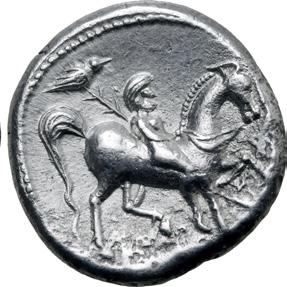
Good Very Fine; area of corrosion on edge (12-3h obv., 3-6h rev.), otherwise bright, lustrous metal.
Ex Roma Numismatics Ltd., Auction XXVII, 22 March 2023, lot 9 (hammer: GBP 1,800).



750
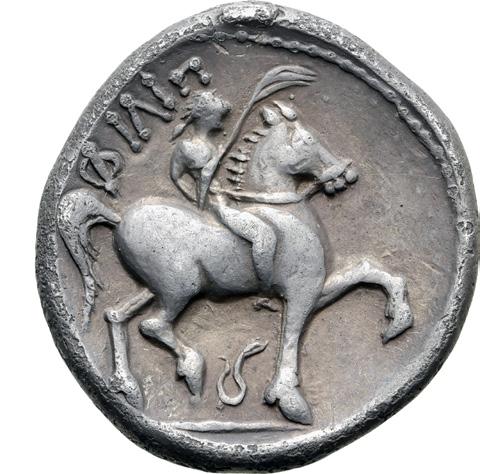
3.
Good Very Fine. Very Rare.
Ex VIA GmbH, Auction 1, 23 November 2021, lot 20.

Good Very Fine; an


360

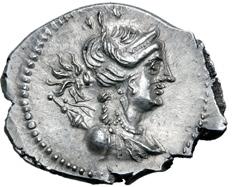


5.
Gaul, Massalia AR Drachm. Circa 150-125 BC. Draped bust of Artemis to right, wearing stephane; bow and quiver over shoulder / Lion standing to right; MAΣΣA -ΛIHTΩN around, Π between back legs, Δ under chest, Φ between front paws. Maurel 630; Depeyrot 41.39; BnF inv. 1282-4. 2.81g,
Mint State; previously NGC graded MS 5/5 - 3/5 (#2080858-003). Extremely rare variety with these three letters beneath lion.
Ex Roma Numismatics Ltd., Auction XX, 29 October 2020, lot 8; Ex Editions V. Gadoury, Auction 2018, 16 November 2018, lot 17 (hammer: EUR 750).

300
6. 180 No
Very Fine; scuffs to obv.
Ex Bertolami Fine Arts - ACR Auctions, E-Auction 105, 21 October 2021, lot 411 (hammer: EUR 950).

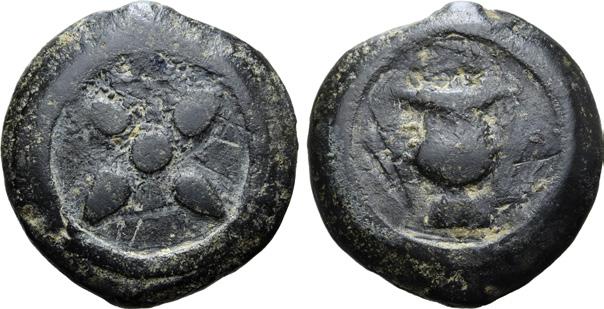

7. 120 No
Good Fine. Rare.
Ex Roma Numismatics Ltd., Auction XVIII, 29 September 2019, lot 463 (hammer: GBP 600).
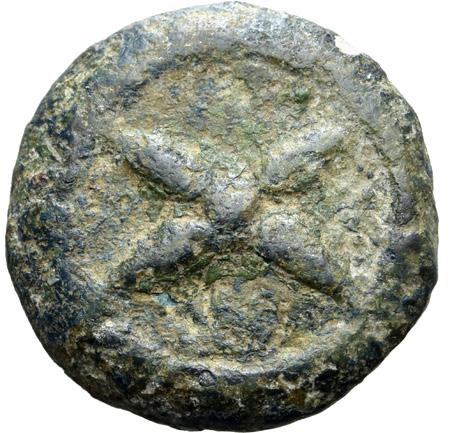
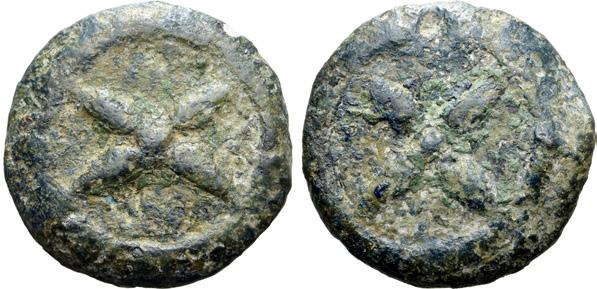

8.
Near Very Fine. Very Rare.
Ex St. James’s Auctions Ltd., Auction 49, 5 October 2021, lot 1004; Purchased from A. H. Baldwin & Sons, 4 July 1955.
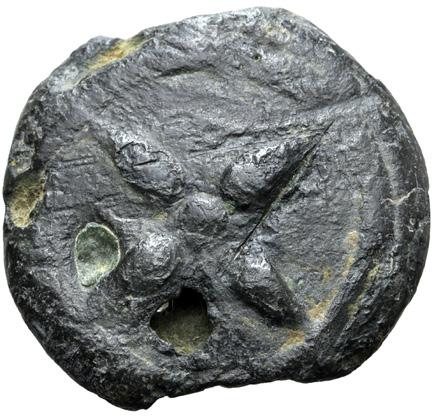


9.
Near Very Fine; hole caused by bubble in casting process.
Ex St. James’s Auctions Ltd., Auction 49, 5 October 2021, lot 1003; Purchased from Seaby, 25 August 1955.
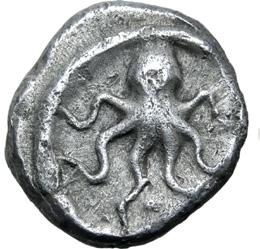
10. 2x
Good Very Fine. Very Rare.


2x
180
This coin published in I. Vecchi, Etruscan Coinage Part 1 (Milan, 2012); Ex Collection of a Swiss Etruscologist, Roma Numismatics Ltd., Auction XVI, 26 September 2018, lot 18 (hammer: GBP 900);
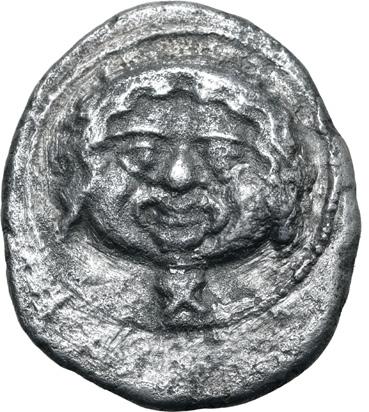


11. 300
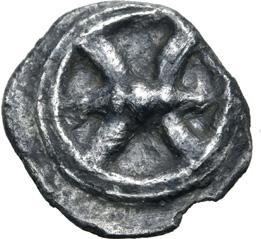
No Reserve 2x 2x


12.
13.


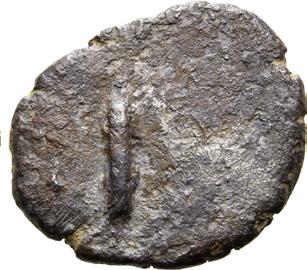
Etruria, Populonia AR Unit. 4th - 3rd century BC. Eagle with closed wings standing to right / I (mark of value). Unpublished in the standard references, cf. Roma E-108, 24; Roma XXVII, 17; Roma XXI, 9; X, 16 and 17. 1.02g, 12mm.
Extremely Fine. Extremely Rare; unpublished and apparently one of only seven known.
1,050 No Reserve
Ex Vitangelo Collection, Roma Numismatics Ltd., E-Sale 77, 26 November 2020, lot 108 (collector’s ticket included, previously sold for GBP 3,800).

14.
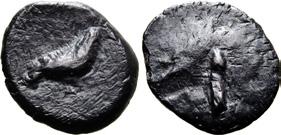

Etruria, Populonia AR Unit. 4th - 3rd century BC. Eagle with closed wings standing to right / I (mark of value). Unpublished in the standard references, cf. Roma E-108, 24; Roma XXVII, 17; Roma XXI, 9; E-77, 108; X, 16 and 17. 0.94g, 12mm.
Good Very Fine. Extremely Rare; unpublished in the standard references.

15.
120 No Reserve



Etruria, Populonia AR 20 Asses. Circa 300-250 BC. Facing head of Metus, hair bound with diadem; X X (mark of value) below / Blank. EC I, 60.11102 (O38); HN Italy 152. 8.54g, 25mm.
Near Extremely Fine.
Ex Collection of a Swiss Etruscologist, Roma Numismatics Ltd., Auction XVI, 26 September 2018, lot 40.

Populonia
Very Fine.
600
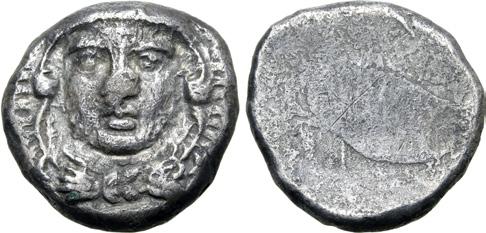

16. 240 No
Ex Collection of a Swiss Etruscologist, Roma Numismatics Ltd., Auction XVI, 26 September 2018, lot 44.

17.
Very Fine.

Ex Collection of a Swiss Etruscologist, Roma Numismatics Ltd., Auction XVI, 26 September 2018, lot 49.

300
18.
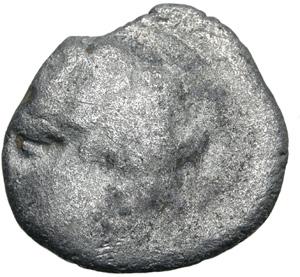
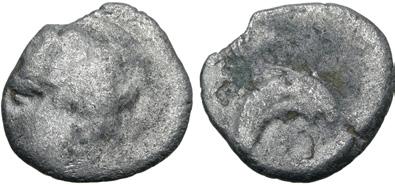
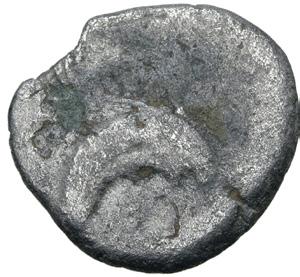
Etruria, Populonia AR 10 Asses. Circa 300-250 BC. Laureate male head to left / Dolphin to right. EC I, 72 (O12); HN Italy -; HGC 1, -. 2.56g, 16mm.
Near Very Fine. Extremely Rare; possibly only the third known example.
Ex Artemide Aste s.r.l., Auction 55E, 26 June 2021, lot 6.
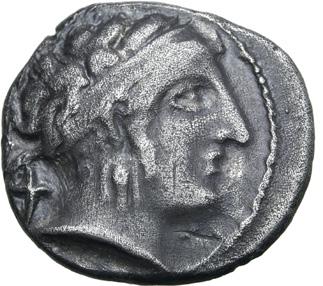
19.
90 No Reserve


Etruria, Populonia AR 10 Asses. Circa 300-250 BC. Female head to right, wearing broad hair band and triple-pendant earring; + (mark of value) behind / Blank. EC I, 75.41-63 (O12); HN Italy 165; HGC 1, 123. 3.99g, 18mm.
Very Fine; pleasant old cabinet tone.
Ex Collection of a Swiss Etruscologist, Roma Numismatics Ltd., Auction XVI, 26 September 2018, lot 55 (hammer: GBP 1,000).

20.
300
No Reserve

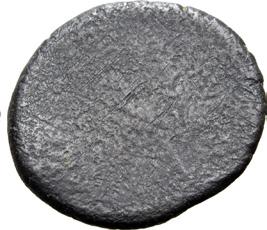
Etruria, Populonia AR 5 Asses. 3rd century BC. Diademed and bearded male head to right; V (mark of value) behind / Blank. EC I, 89 (O1); HN Italy 174; Sambon 98; HGC 1, 132. 2.02g, 15mm.
Good Very Fine. Rare.
Ex Artemide Aste s.r.l., Auction 52, 26 October 2019, lot 26.
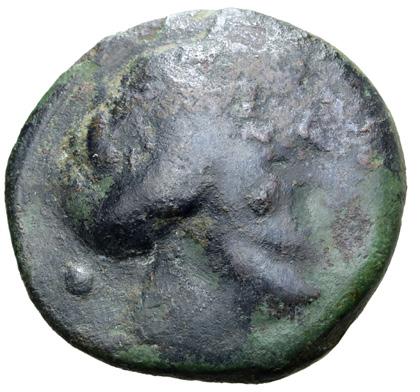
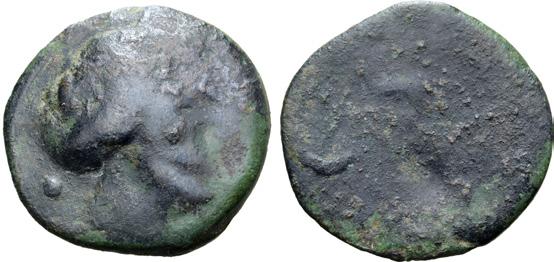
Good Fine. Extremely Rare, one of only two known examples.
This coin published in I. Vecchi, Etruscan Coinage Part 1 (Milan, 2012); Ex VCV Collection, Roma Numismatics Ltd., Auction X, 27 September 2015, lot 85.
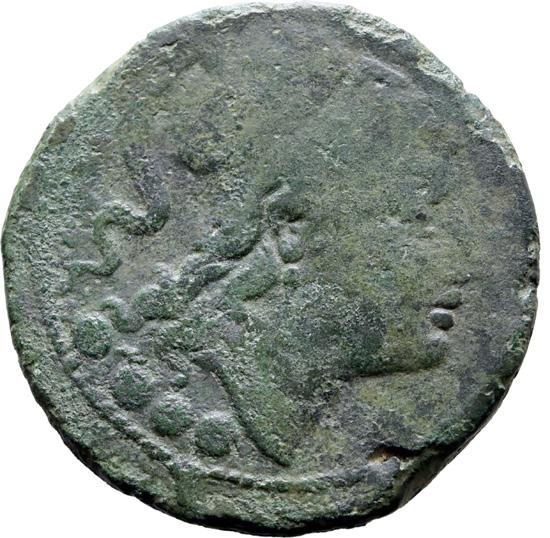

120 No Reserve


Very Fine, weakly struck. Rare.
This coin published in I. Vecchi, Etruscan Coinage Part 1 (Milan, 2012); Ex VCV Collection, Roma Numismatics Ltd., Auction 10, 27 September 2015, lot 87 (hammer: GBP 700).
The main bronze issues are made up of various denominations tariffed in unciae (represented by pellets) on a weight standard based on a nominal bronze as of 81g which was extant in Rome after the post-semilibral phase of c. 215-212 BC (Crawford 1974, 41).
23.
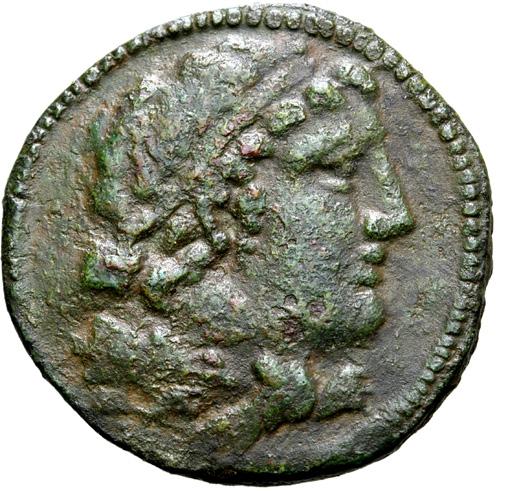

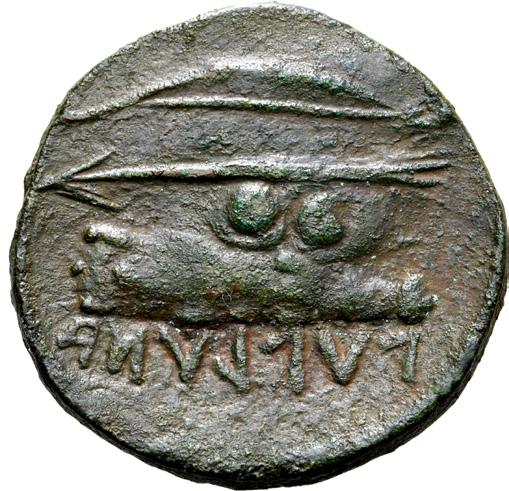
Etruria, Populonia Æ Sextans. Circa 215-211 BC. Diademed head of young Hercle to right, club over shoulder / Etruscan legend ‘pvplvna’, bow, arrow and club; •• (mark of value) between. EC I, 136.15 (this coin); HN Italy 187; Sambon 116; HGC 1, 181. 12.22g, 28mm, 5h.
Good Very Fine. Rare, and unusually well preserved for this issue.
This coin published in I. Vecchi, Etruscan Coinage Part 1 (Milan, 2012); Ex VCV Collection, Roma Numismatics Ltd., Auction 10, 27 September 2015, lot 90 (hammer: GBP 1,800).

24.
900 No Reserve


Etruria, Populonia Æ Sextans. Circa 215-211 BC. Diademed head of young Hercle to right, club over shoulder / Etruscan legend ‘pvplvna’, bow, arrow and club; •• (mark of value) between. EC I, 136.18 (this coin); HN Italy 187; Sambon 116; HGC 1, 181. 13.67g, 30mm, 5h.
Very Fine; edge split. Rare.
This coin published in I. Vecchi, Etruscan Coinage Part 1 (Milan, 2012); Ex Baldwin’s Auctions Ltd., Auction 99, 4 May 2016, lot 567; Ex Lord Renfrew Collection, purchased from Spink & Son Ltd, 21 September 1960.


60 No Reserve

Etruria, Populonia Æ Triens of 10 Units. Circa 215-211 BC. Bust of Sethlans to right, wearing pileus decorated with laurel-wreath; X behind / Etruscan legend ‘pvplvna’ below hammer and tongs; •••• (mark of value) between. EC I, 140.54 (this coin);
Very Fine. Rare.
This coin published in I. Vecchi, Etruscan Coinage Part 1 (Milan, 2012); Ex VCV Collection, Auction X, 27 September 2015, lot 92 (hammer: GBP 800).
The final bronze issues (EC I, 139-140) are also tariffed with X and /X and may be metrologically connected with the remarkable struck bronze coins with incuse reverse and marks of value 1 to 100, cf. Uncertain Central Italy, EC I, 1-17.
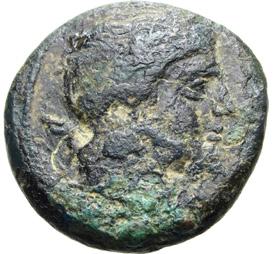
Very Fine.
300
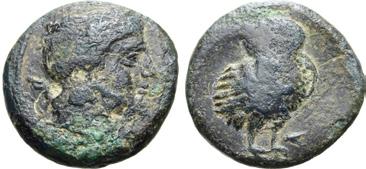
Ex Baldwin’s Auctions Ltd., Auction 99, 4 May 2016, lot 579; Purchased from A. H. Baldwin & Sons Ltd., 17 April 1957 (misdescribed as Velia).
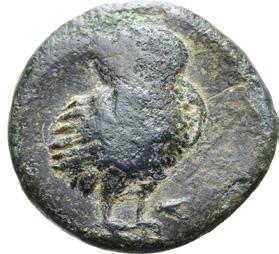
45

27.
Near Very Fine. Very Rare.

Ex Bertolami Fine Arts - ACR Auctions, E-Auction 64, 13 January 2019, lot 10.

28.
Near Very Fine.

Near Very Fine.
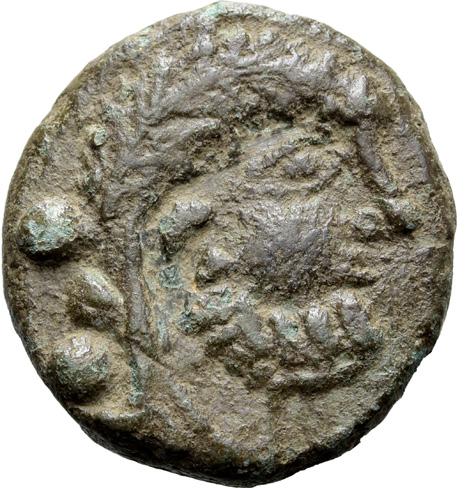
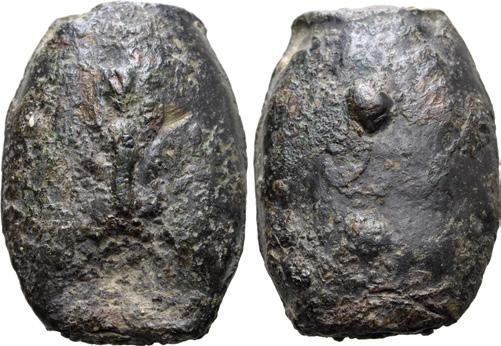
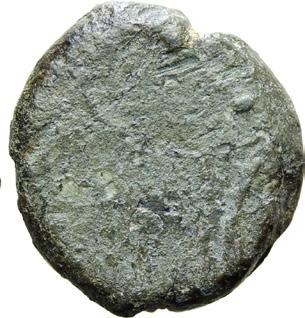




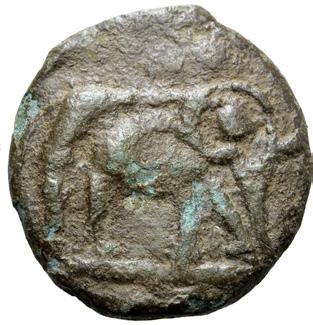
Good Very Fine. Extremely Rare; seemingly no others offered at auction in over twenty




31.
Samnium, Meles Cast Æ Sextans. Time of Hannibal, 216-210 BC. Bearded head of Hercules-Baal to right, club over shoulder; •• (mark of value) behind / African elephant with mahout advancing to left. ICC 325; Campana, PN 83, 1995, pp. 283-8, 2 A/a; Haeberlin p. 175, 9 pl. 69, 40; HN Italy 442; HGC 1, 343. 20.65g, 28mm, 12h.
Good Very Fine. Extremely Rare with elephant to left.
900 No Reserve
Meles was a Samnite oppidum which Hannibal occupied as a base for his supply train; the precise location of which is unknown. The town was retaken by Rome in 210 BC. The coin types are derived from Barcid issues from Spain (cf. ACIP 553 and for discussion see: E.S.G Robinson, Essays Mattingly, p. 40).
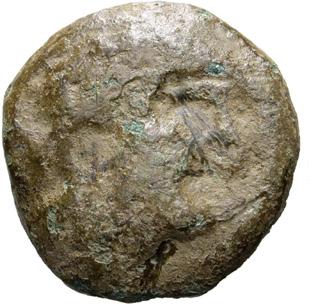
32.
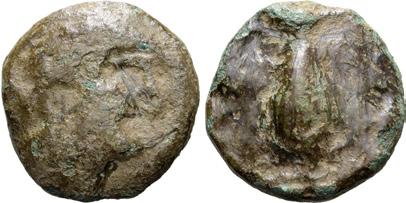
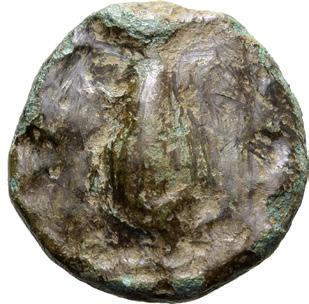
Samnium, Meles Cast Æ Semuncia. Time of Hannibal, 216-210 BC. Beardless male head to right / Barley grain. Unpublished in the standard references. 6.16g, 18mm, 12h.
Good Fine. Extremely Rare; the second recorded example.
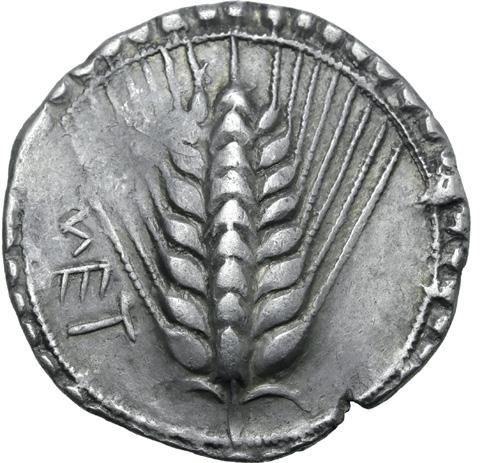
33.
240 No Reserve

Lucania, Metapontion AR Stater. Circa 540-510 BC. Ear of barley with eight grains and bracts
Good Very Fine; an attractive early stater of Metapontion.
Ex Roma Numismatics Ltd., E-Sale 102, 3 November 2022, lot 3 (hammer: GBP 500).

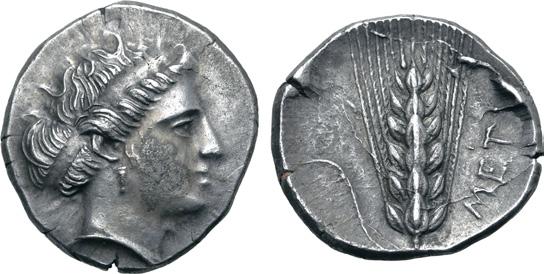


Extremely Fine. Rare.
Ex Roma Numismatics Ltd., Auction IV, 30 September 2012, lot 17; Ex Gorny & Mosch Giessener Münzhandlung, Auction 200, 10 October 2011, lot 1065; Ex Münzhandlung Ritter, List 66, May 2004, #124.

35.
NGC graded Ch XF 5/5 - 4/5 (#6625604-003).
Acquired from Pars Coins, San Jose CA.




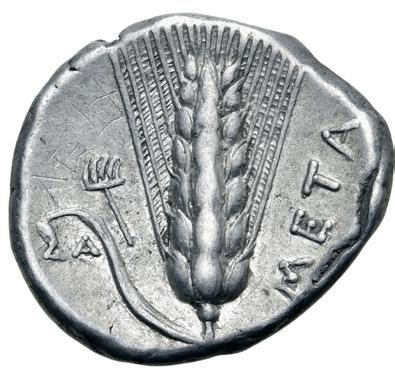
Wreathed
36. 480
Near Extremely Fine.
Acquired from Pars Coins, San Jose CA.


Metapontion AR Stater. Circa 330-290 BC. Da-, magistrate. Wreathed
Near Extremely Fine; highly lustrous.

Demeter
Ex Roma Numismatics Ltd., Auction XXVII, 22 March 2023, lot 31 (sold but buyer defaulted).


wearing triple pendant

38.
Near Extremely Fine; attractive light tone with hints of golden iridescence.
Ex Roma Numismatics Ltd., E-Sale 102, 3 November 2022, lot 4.


39.
Good Very Fine.
Ex Roma Numismatics Ltd., E-Sale 104, 15 December 2022, lot 20.
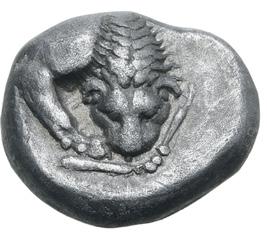
40.
Velia
Drachm.
Near Extremely Fine.


240

Ex Roma Numismatics Ltd., Auction XXVII, 22 March 2023, lot 43 (hammer: GBP 700).

41.
Velia
Drachm. Circa
Near Extremely Fine.

Ex Roma Numismatics Ltd., Auction XXVII, 22 March 2023, lot 43.

42.
300 No Reserve


Calabria, Tarentum AR Nomos. Circa 280-272 BC. Si- and Lykon, magistrates. Nude
Extremely Fine.
on horseback
Ex Group SGF, Classical Numismatic Group, Electronic Auction 347, 25 March 2015, lot 24.

43.
Near Mint State; some mineral adhesions.

Ex Roma Numismatics Ltd., Auction XXIII, 24 March 2022, lot 19 (hammer: GBP 2,800).
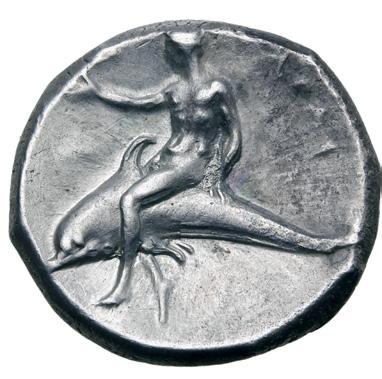
right,
lance
right
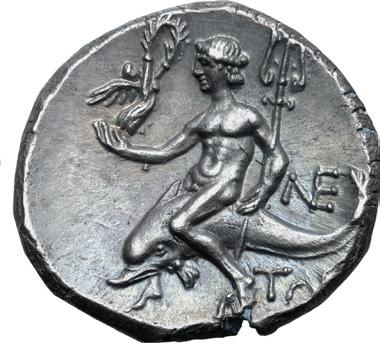
and
1,050 No
44.

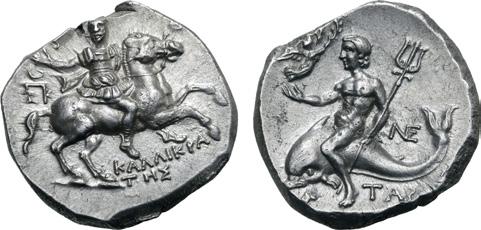
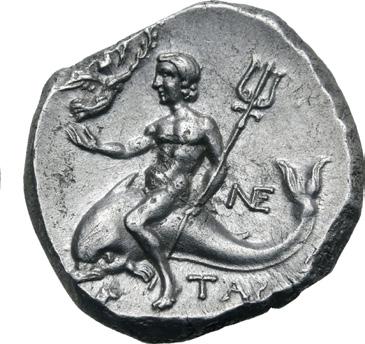
Calabria, Tarentum AR Nomos. Circa 240-228 BC. Kallikrates, magistrate. Reduced standard. Strategos, [holding Nike who crowns him], in extended right hand, on horse rearing to right; crescent above monogram behind, KAΛΛIKPATHΣ in two lines below / Taras astride dolphin to left, holding Nike, who crowns him, in extended right hand, cradling trident in left arm; ligate NE behind, TAP[AΣ] below. Vlasto 965 (same dies); SNG ANS 1261 (same dies); SNG BnF 2061; HN Italy 1059; HGC 1, 905. 6.52g, 20mm, 1h.
Good Extremely Fine.
Ex Nomos AG, Auction 22, 22 June 2021, lot 31.
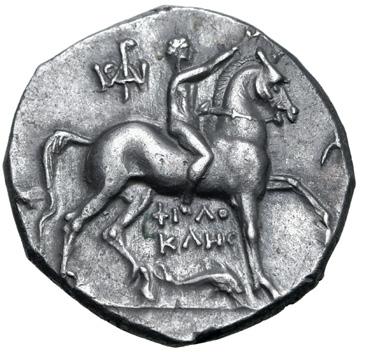
45.
900 No Reserve


Calabria, Tarentum AR Nomos. Circa 240-228 BC. Philokles, magistrate. Reduced standard. Nude youth on horseback to right, crowning horse with wreath; monograms to left and right; below, ΦΙΛΟΚΛΗΣ in two lines over dolphin to right / Taras astride dolphin to left, holding horse rhyton and trident; two amphoroi (or loutrophoroi?) to right, on elaborate stands and with lids, ΤΑΡΑΣ below. Vlasto 950-2; SNG ANS 1254; HN Italy 1057; HGC 1, 903. 6.58g, 20mm, 9h.
Good Extremely Fine.
Ex Roma Numismatics Ltd., Auction XXIII, 24 March 2022, lot 22 (hammer: GBP 1,800).
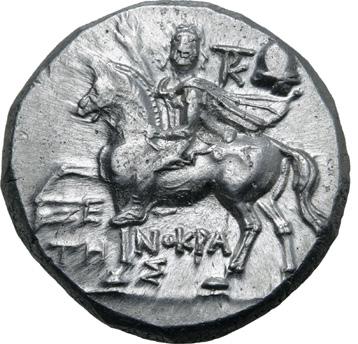
46.
750 No Reserve


Calabria, Tarentum AR Nomos. Circa 240-228 BC. Xenokrates, magistrate. Reduced standard. Bearded strategos on horse walking to left, wearing short tunic and chlamys, raising hand
Good Extremely Fine.
Ex Alan Pitres Collection.

Good Very Fine; beautiful old cabinet tone.
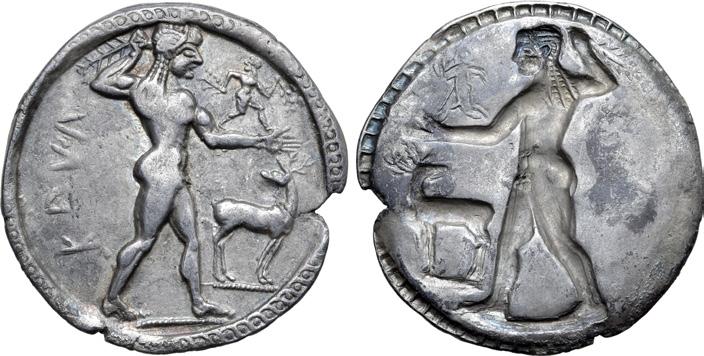
300 No Reserve

2,400 No Reserve

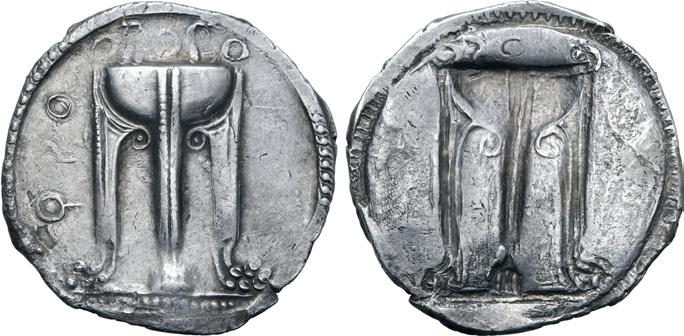

48.
Near Extremely Fine; lustrous, lightly toned fields.
Ex Roma Numismatics Ltd., E-Sale 103, 24 November 2022, lot 22.

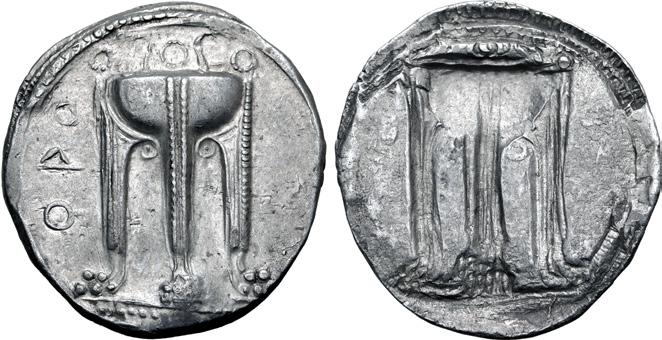
49.
Kroton
Extremely Fine.
Ex Roma Numismatics Ltd., E-Sale 71, 28 May 2020, lot 250; Ex Roma Numismatics Ltd., E-Live Auction 2, 30 August 2018, lot 77.
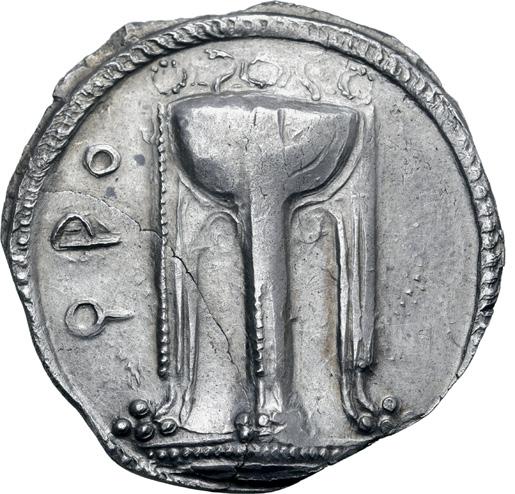


300
300

50. 240
Near Extremely Fine; flan crack, edge chips, lightly toned fields.



Bruttium, Kroton AR Stater. Circa 350-300 BC. Eagle standing to left on olive branch, with wings displayed and head raised / [KPOTΩ]NIATAN, tripod lebes with legs terminating in lion’s feet; B to right. SNG ANS 359 (same dies); HN Italy 2171; HGC 1, 1464. 7.82g, 22mm, 7h.
Ex Roma Numismatics Ltd., Auction XX, 29 October 2020, lot 35. No Reserve



Bruttium, Lokroi Epizephyrioi AR Stater. Circa 350-275 BC. Pegasos flying to left; ΛO below / Head of Athena to right wearing Corinthian helmet; M on neck guard. Pegasi 8; SNG Ashmolean 1544; SNG ANS 505; HN Italy 2339; HGC 1, 1574. 8.45g, 22mm, 3h.
52. 900
Extremely Fine; beautiful old cabinet tone. Privately
from London Coin Galleries, 2017.

53.


Bruttium, Lokroi Epizephyrioi AR Stater. Circa 350-275 BC. Pegasos flying to left / Head of Athena to left, wearing Corinthian helmet; ΛOKPΩN around. Pegasi 10; HN Italy 2341; HGC 1, -. 8.61g, 24mm, 10h.
Near Extremely Fine; planchet flaw, some scratches, attractive old cabinet tone.
59, 27 January 2004, lot 4068.
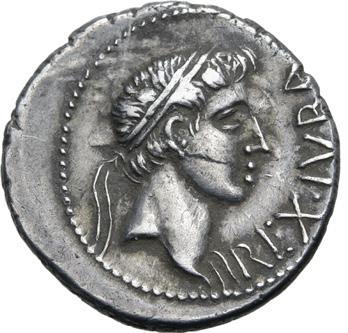
54.
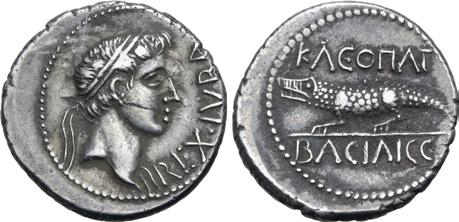

Kingdom of Mauretania, Juba II, with Kleopatra Selene, AR Denarius. Caesarea, Circa AD 11-23. REX IVBA, diademed head of Juba to right / Crocodile standing to left on ground line; KΛЄOΠATPA above, BACIΛICCA below. Mazard 340; MAA 104; SNG Copenhagen 592. 4.02g, 19mm, 7h.
Good Very Fine. Scarce.
Ex Roma Numismatics Ltd., E-Sale 105, 19 January 2023, lot 29 (hammer: GBP 950).

Africa, Carthage AV
450



55. 4,500
Good Extremely Fine.
Ex Leu Numismatik AG, Web Auction 16, 22 May 2021, lot 248.
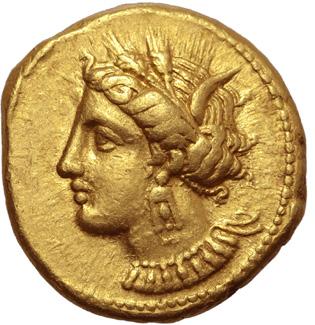
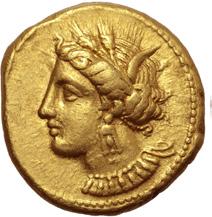
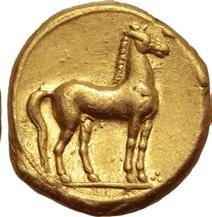

56.
North Africa, Carthage AV Stater. Circa 350-320 BC. Wreathed head of Tanit to left, wearing triple-pendant earring and pendant necklace / Horse standing to right on ground line; three pellets before. Jenkins & Lewis Group IIIf, 50 (same dies); CNP 1.5h; MAA 4. 9.48g, 18mm, 6h.
Extremely Fine; some minor surface marks, lustrous metal. Rare.
Ex Roma Numismatics Ltd., E-Sale 66, 9 January 2020, lot 236; Acquired from Classical Numismatic Group.

57.

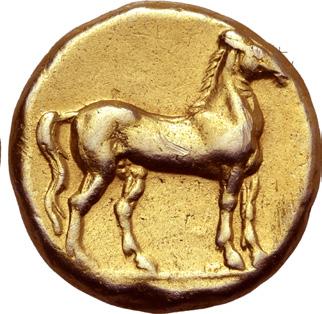
North Africa, Carthage EL Stater. Circa 310-270 BC. Wreathed head of Tanit to left, wearing triple-pendant earring and pendant necklace / Horse standing to right on ground line; three pellets above line, three pellets on line. Jenkins & Lewis Group VI, 337-8; CNP 2.6p; MAA 13. 7.47g, 18mm, 12h.
Very Fine; scratches to the reverse.
Ex Roma Numismatics Ltd., Auction 7, 22 March 2014, lot 67.


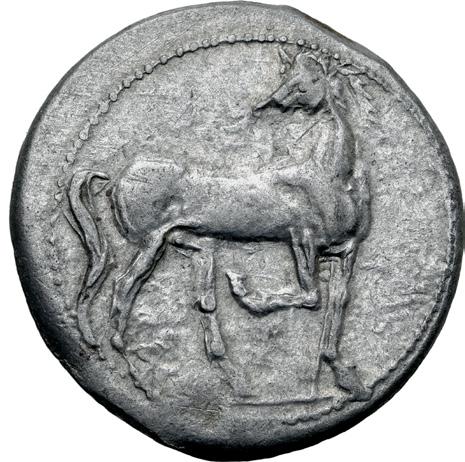
58.
North Africa, Carthage BI Tridrachm. Second Punic War, circa 203-201 BC. Wreathed head of Tanit to left, wearing triple-pendant earring and [necklace] / Horse standing to right, right foreleg raised, head reverted. MAA 81; CNP 103; SNG Copenhagen 390. 8.88g, 26mm, 12h.
Near Extremely Fine; very high silver content for the issue.




Sicily, Siculo-Punic AR Tetradrachm. Lilybaion (as ‘Cape of Melkart’), circa 330-305 BC. Charioteer, holding kentron and reins, driving galloping quadriga to right, Nike flying above to left to crown charioteer; Punic legend RSMLQRT in exergue / Head of Tanit-Persephone to right, wearing wreath of grain-ears, triple-pendant earring and pearl necklace; three dolphins around. Jenkins, Punic 37 (O14/R28); Jameson 597 (same dies); de Luynes 920 (same dies); HGC 2, 741. 17.56g, 25mm, 1h.
59. 1,500
Good Very Fine; attractive old cabinet tone. Rare.
Ex Roma Numismatics Ltd., Auction XV, 5 April 2018, lot 47; Ex Hess-Divo AG, Auction 332, 31 May 2017, lot 20.
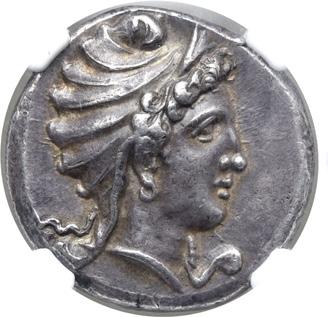
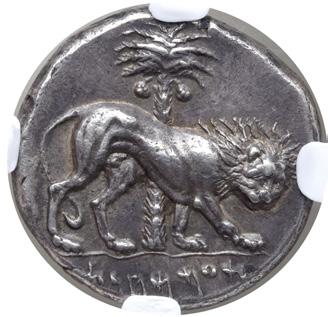

Sicily, Siculo-Punic AR Tetradrachm. ‘People of the Camp’ mint (Entella?), circa 320-315 BC. Female head (Artemis-Tanit or Elissa-Dido?) to right, wearing Phrygian tiara / Lion walking to right; palm tree with three date clusters behind, s’mmhnt (‘People of the Camp’) in Punic in exergue. Jenkins, Punic, series 4, 272 (O85-R226, these dies); De Luynes 1472 (these dies); Rizzo pl. 68, 8 (these dies); Boston MFA 36 (these dies). 17.31g. NGC graded AU★ 5/5 - 5/5 (#6674505-002). Extremely Rare.
39,000 No Reserve
Ex ‘Exceptional Collection’ assembled between the early 70’s-late 90’s, Numismatica Ars Classica, Auction 132, 30 May 2022, lot 233 (hammer: CHF 130,000).
Carthage, at the head of considerable commercial empire in the western Mediterranean, like Etruria and Phoenicia, did not adopt the Greek practice of coining until the last decade of the 5th century BC when she came into direct contact with the Greek city states of Sicily such as Naxos, Syracuse and Messana, which had started to produce coins of the highest technical quality in the artistic style of the late archaic Greek school in the last quarter of the 6th century BC.
The origin of the so-called Siculo-Punic coinage, often of rather crude style mostly imitating contemporary Syracusan tetradrachms produced at Rash Melkarth (= ‘Promontory of Herakles’, possibly Kephaloidion), Panormos (Ziz, ‘the splendid’), Motya (the ‘spinning factory’) and the ‘people of the camp’ and ‘pay master’ military mint (generally considered that of Entella) for the payment of the army including many Italian and Greek mercenaries, is dated to about 410 BC and the Carthaginian military operations in Sicily. Hannibal, grandson of Hamilcar, taking the opportunity presented by the quarrels of the Greek cities in Sicily and of the mutual exhaustion of Athens and Syracuse, invaded western Sicily with a strong military force and defeated the Greeks at Himera in 409.
The obverse female figure is wearing an oriental tiara in the form of a Phrygian cap, which in Greek iconography generally denotes personages of oriental origin, including Amazons, Trojans, Phrygians, Persians and the great Anatolian mother goddess Kybele and her youthful lover Attis, as seen on the coinage of Amastris (cf. SNG BM Black Sea 1304).
19th and 20th century numismatists poetically described this head as that of Dido (Virgil) or historically, Elissa (Timaeus), the sister of Pygmalion, king of Tyre, who fled Phoenicia to found Carthage in 814 BC (cf. Pierre Straus in Münzen und Medaillon sale 43, 1970, 33-4). However, a realistically more convincing interpretation is that it is the portrait of a goddess also represented in certain terracotta figurines of the latter 4th century found at the archaeological sites of Selinos and Gela, both within the Punic sphere of influence by this time. These terracottas depict a female in a Phrygian cap, sometimes accompanied by a lion and a palm tree. This goddess has been called Artemis-Astarte by some authorities and Kybele by others, but the only certainty is that she was one of the great Asian nature-deities, who were subject to syncretic amalgamation in the Hellenistic period (cf. P. Orlandini, ‘Typologia e cronologia del Materiale archeologico di Gela della nuova fondazione di Timoleonte all’atà di Ierone II,’ in Archeologia Classica 9, 1957, pl. 14, 2). The reverse type combines two of her symbolic attributes. The palm tree is an ancient Semitic fertility symbol, recalling the Carthaginian homeland in Phoenicia. The lion is associated with the Asian mother goddess in her aspect as mistress of wild beasts. The lion is also a solar symbol as is the horse, which appears regularly on Punic coinage.
The die engraving of both sides of this coin is of exceptional and restrained classical Greek workmanship. The obverse is graced with a portrait of serene divinity, realistic curly hair below a pleated headdress, reminiscent of the finest 5th century sculpture. The reverse is no less of a masterpiece, depicting a majestic lion with a muscular body, protruding veins, luxuriant mane and emphasis on the power of the animal reminiscent of 4th century funerary lions found in the Kerameikos cemetery in Athens.
61.
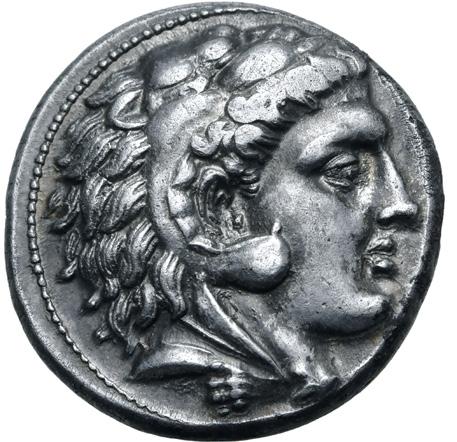


Sicily, Siculo-Punic AR Tetradrachm. Entella or Lilybaion (?), circa 300-289 BC. Head of Herakles to right, wearing lion skin headdress / Head of horse to left; date palm tree behind, ‘MMḤNT (in Punic) below. Jenkins, Punic 370 (O115/R293); CNP 270; BAR Issue 5; GPCG Period IV. C. 19 (same obv. die); HGC 2, 293. 16.65g, 25mm, 2h.
Extremely Fine.
Ex Roma Numismatics Ltd., Auction XVII, 28 March 2019, lot 351.

62.
1,200
No Reserve


Sicily, Enna Æ 22mm. Struck under Roman Rule, 44-36 BC. L. Cestius and L. Munatius, duoviri. MVN HENNAE, female (Proserpina?) head to right / M CESTIVS L MVNATIVS II VIR, naked male figure, wearing a cloak, standing to left with outstretched hand. RPC I 662; BMC 11; CNS 13; SNG ANS 1338; HGC 2, 405. 8.66g, 22mm, 12h.
Near Very Fine. Rare.
Ex Anders Collection, collector’s tickets included.
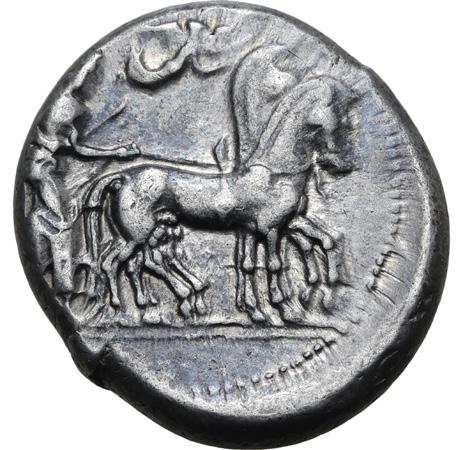
63.
60 No Reserve

Gela AR Tetradrachm. Circa 480-470 BC. Charioteer, holding kentron and reins,
Good Very Fine.
Ex Roma Numismatics Ltd., Auction 7, 22 March 2014, lot 89.



900
No Reserve

64.
Extremely Fine; beautiful old cabinet tone, some light scratches
obv.
Ex Dr. Busso Peus Nachfolger, Auction 403, 27 April 2011, lot 40 (hammer: EUR 10,000);
Numismatica Ars Classica AG, Auction 54, 24 March 2010,
3,000 No Reserve

65.
Extremely Fine; attractively toned with a splendid portrait struck in high relief.
From the David Freedman Collection; Ex Roma Numismatics Ltd., Auction XXV, 22 September 2022, lot 125; Ex Bertolami Fine Arts - ACR Auctions, Auction 24, 22 June 2016, lot 168.
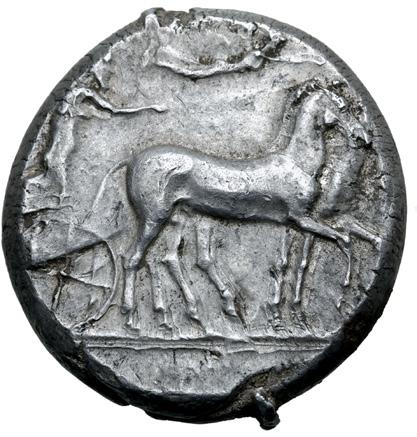


66.
Extremely Fine.
Ex Bertolami Fine Arts - ACR Auctions, Auction 109, 4 May 2022, lot 92 (hammer: EUR 5,500).

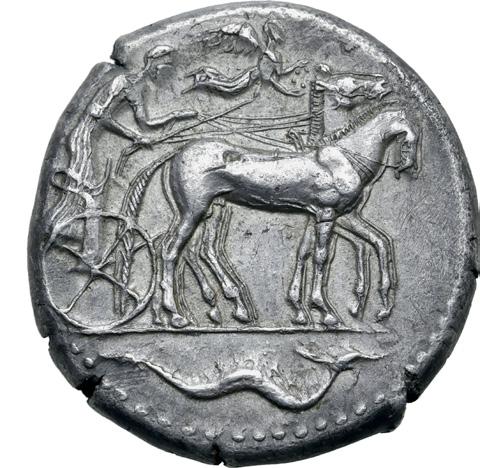
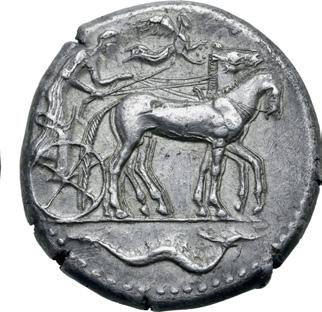
Randazzo
(same
SNG
6,000 Reserve: 11,500

2,400 No Reserve
The talented engraver who signed some of his dies simply with an ‘A’ was the very first master engraver to sign his dies at Syracuse, around 15 years before other masters such as Eumenos, Kimon and Euainetos began signing theirs.

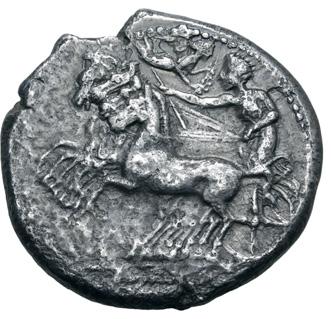

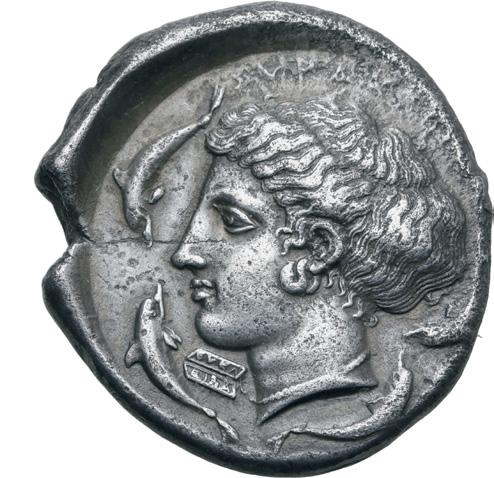
Sicily, Syracuse AR Tetradrachm. Second Democracy, circa 415-405 BC. Obverse die signed by Eumenes and reverse die signed by Eukleidas. Charioteer, holding kentron in right hand and reins in both, driving fast quadriga to left; Nike above, flying to right, crowning charioteer with wreath; [EYMENOY] in exergue / Head of Arethusa to left, wearing double-pendant earring, hair bound by ampyx and net-like sphendone; below chin, diptych inscribed EYKΛEIΔA in two lines, ΣYPAKOΣIΩN and four dolphins around. Fischer-Bossert, Coins 24 (O9/R16); Boston MFA 402 = Warren 372 (same dies); SNG ANS 259 (same dies); BMC 193 (same dies); HGC 2, 1328. 16.70g, 26mm, 4h.
Good Very Fine; minor flan crack, trace of oxidation on reverse. Scarce.
67. 2,100 No Reserve
Acquired from Phidias, France.
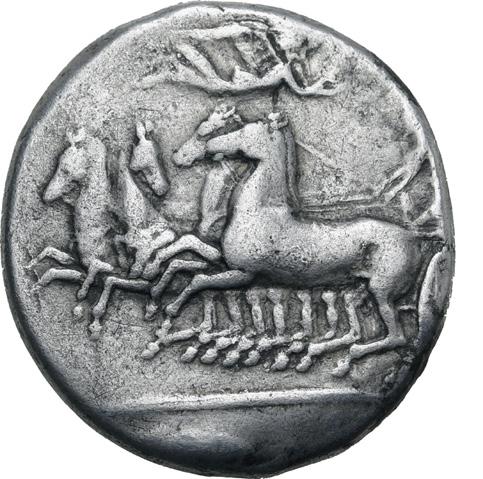


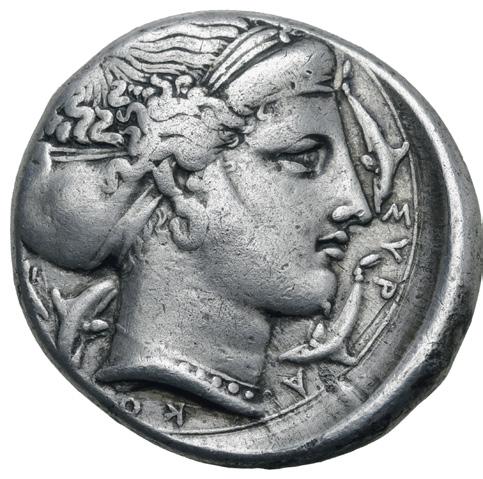
Sicily, Syracuse AR Tetradrachm. Time of the Second Democracy, circa 415-405 BC. Charioteer, holding kentron in right hand and reins in both, driving fast quadriga to left; Nike above, flying to
Very Fine; from dies of magnificent style, bright and lustrous metal. Rare.
Ex David Redman Collection, Roma Numismatics Ltd., E-Sale 104, 15 December 2022, lot 69, collector’s ticket included (hammer: GBP 2,400); Ex Nomos AG, obolos 6, 20 November 2016, lot 210; Ex Schweizerischer Bankverein, Auction 5, 16 October 1979, 106.
1,200






Sicily, Syracuse AV 100 Litrai - Double Dekadrachm. Dionysios I, circa 405-400 BC. Unsigned dies in the style of Kimon. Head of Arethusa to left, wearing triple-pendant earring and necklace, hair in sphendone ornamented with two stars; ΣYPAKO[ΣIΩN] before, A behind / Herakles kneeling to right, strangling the Nemean Lion. Bérend 30; Gulbenkian 324 (same dies); Rizzo pl. L, 12 (same rev. die); SNG ANS 332-333 (same dies); Pozzi 606 (A rather than AK behind); Jameson 1917 var. (A behind); HGC 2, 1275 var. (same). 5.78g, 15mm, 3h.
Good Extremely Fine; small edge mark, otherwise a spectacular example with a crisp portrait in high relief. Extremely Rare; a very rare denomination in itself, and furthermore a variety unpublished in a number of the major collections.
18,000 No Reserve
Ex Jean Vinchon Numismatique, June 2022 Auction, 29 June 2022, lot 24 (hammer: EUR 50,000).
This particular issue dates to circa 405 BC, following the election of Dionysios as supreme military commander of Syracuse in recognition of his achievements in the war against Carthage and his subsequent seizure of total power.
Syracuse had only recently repelled an Athenian invasion of Sicily that resulted in the complete destruction of Athens’ expeditionary force and ultimately contributed significantly to Athens’ defeat at the hands of Sparta in the Peloponnesian War. Then under Dionysios in 405 BC, despite the ruin of great cities such as Akragas and Gela, Syracuse overcame a Carthaginian invasion that might have resulted in a comprehensive conquest of the island. Such glory was short-lived, however, as the rule of Dionysios’ son and successor was to bring civil strife that would weaken the power of Syracuse. Never again would the city issue coinage on such a grand scale, and this coin represents part of the last great flourishing of classical numismatic art at Syracuse before two centuries of steady decline and eventual conquest at the hands of the Romans.
The wonderful Syracusan 100 litrai or double dekadrachms are considered amongst some of the finest gold coinage of the Greek world, and are associated with the magnificent dekadrachms of Euainetos, whose signature also appears on the earlier dies of the gold denomination issue. The serenely graceful head of the sea-nymph Arethusa, rendered in very similar style to the great die-engraver Euainetos, is presented in delightful contrast to the dynamic rendering of the first labour of Hercules, the slaying of the Nemean lion, on the reverse. The die-engraver’s masterful composition within the bounds of a circular constraint produces a scene of great power and climax, both Herakles’ and the lion’s backs arched as the hero bends to tighten his grip around the lion’s neck and it strains desperately against him to escape. As a great Doric hero and ancestor of the Doric city of Syracuse, Herakles’ defeat of the lion, the symbol of Africa, has powerful connotations for Syracuse’s own conflict with the African city of Carthage.
70.



Sicily, Syracuse AR Tetradrachm. Time of the Second Democracy, circa 415-405 BC. Charioteer, holding kentron in right hand and reins in both, driving fast quadriga to left; Nike above, flying to right, crowning charioteer with open wreath; grain ear in exergue / Diademed head of Arethusa to right, wearing earring and necklace, hair in ampyx and sphendone; ΣYPAKOΣION and four dolphins around. Tudeer 63 (V22/R41); Fischer-Bossert 63 (V22/R41); SNG ANS 281; Rizzo pl. XLVII, 10 (same dies); BMC 221 (same dies); Boston MFA 414 = Warren 382 (same dies); Gulbenkian 285 (same dies); Jameson 108 (same dies); HGC 2, 1339. 16.85g, 27mm, 3h.
Very Fine; from dies of magnificent style, bright and lustrous metal. Rare.
Ex David Redman Collection, Roma Numismatics Ltd., E-Sale 104, 15 December 2022, lot 69, collector’s ticket included;
Ex Nomos AG, obolos 6, 20 November 2016, lot 210;
Ex Schweizerischer Bankverein, Auction 5, 16 October 1979, 106.


71.
Sicily, Syracuse Æ 27mm. Time of Timoleon and the Third Democracy, circa 339/8-334
Near Extremely Fine.
Ex F. Cruse Collection.
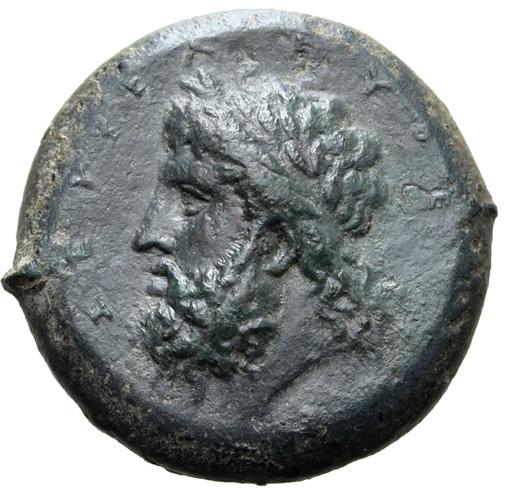
72.
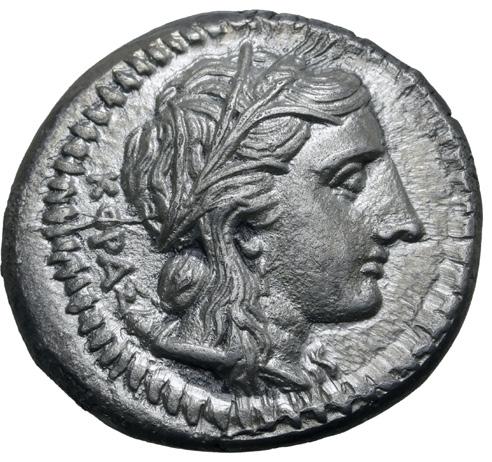
Good Extremely Fine.
Ex Leu
Chaponnière
900

450 No Reserve


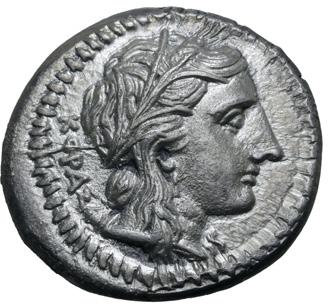
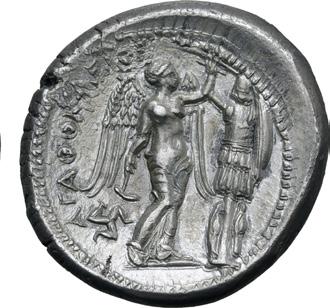

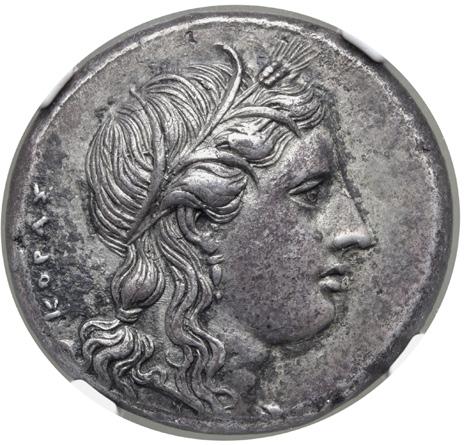

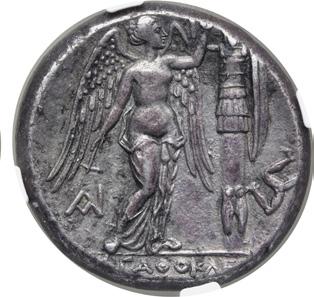

74.
Sicily, Syracuse AR Tetradrachm. Time of Agathokles, circa 310-305 BC. Head of Kore to right, wearing wreath of grain ears and single-pendant earring; KOPAΣ behind / Nike standing to right, erecting trophy to right; monogram to lower left, triskeles to right, [A]ΓAΘOKΛE[OΣ] in exergue. Ierardi 103e (O21/R64 - this coin [corr. prov.]); BAR Issue 23; Boston MFA 463 = Warren 406 (same dies); HGC 2, 1536.
NGC graded Ch XF 4/5 - 3/5, scratches (#5769822-001); beautiful old cabinet tone. Rare.
This coin cited in M. Ierardi, ‘The Tetradrachms of Agathocles of Syracuse: A Preliminary Study’ in AJN 7/8 (1995-6), p. 53;
Ex Roma Numismatics Ltd., Auction XXIII, 24 March 2022, lot 73;
Ex Classical Numismatic Group, Auction 114, 13 May 2020, lot 73;
Ex Weise Collection, Gemini LLC, Auction I, 11 January 2005, lot 48;
Ex F. Sternberg AG, Auction XII, 18 November 1982, lot 78.
1,800 No Reserve
With the usurpation of Agathokles in 317 BC, Syracuse once more monopolised the right of coinage for the whole of Sicily, even more distinctly than in the time of Dionysios. Yet the reign of Agathokles, as noted by Malcolm Bell (Morgantine Studies I, 1981) “was a watershed for the arts in Sicily, just as it was for politics. The change from a conservative late-classical style to the new modes of the early-Hellenistic period came very quickly, within the space of a decade, and it coincided with the replacement of democratic government by the new monarchy. It is clearly perceptible in the coins that... document the full acceptance of early-Hellenistic style.”
Depicted often as a cruel and unscrupulous adventurer and tyrant, Agathokles achieved little of lasting historical importance; indeed after his death anarchy erupted both in Syracuse, where a damnatio memoriae was decreed, and in other places that had been under his rule (Diod. Sic. 21. 18).
Nonetheless, his patronage of the arts left a legacy of beauty as embodied by a small number of surviving works of art from his reign, and smaller but no less wonderful objects such as this stunning coin.




75.
Sicily, Syracuse AR 10 Litrai. Time of Hieronymos, circa 215-214 BC. Diademed head to left; K (retrograde) behind / BAΣIΛEOΣ IEPΩNYMOY, winged thunderbolt; KI above. Holloway 41 (O21/R33); SNG ANS 1029 (these dies); HGC 2, 1567. 8.18g, 23mm, 3h.
Good Extremely Fine; light cleaning marks, beautiful cabinet tone with iridescent highlights.
Ex Münzhandlung Basel, Auction 10, 15 March 1938, lot 144.
1,500 No Reserve
Hieronymos ascended to the throne of Syracuse at a time of crisis. A Roman consular army of eight legions and allied troops had been annihilated at Cannae only the year before, and Roman power had been dealt a considerable shock. The repercussions of that defeat had been profoundly felt in Sicily; the former king Hieron II had remained steadfast in his loyalty and support to Rome though a significant party in the city favoured abandoning the Roman alliance and joining the cause of Carthage, despite their traditional enmity to that people. The young Hieronymos, who had already shown signs of weakness and depravity of character, allowed himself to be influenced by his pro-Carthaginian uncles into breaking the alliance with Rome, a decision that would have disastrous consequences for Syracuse.


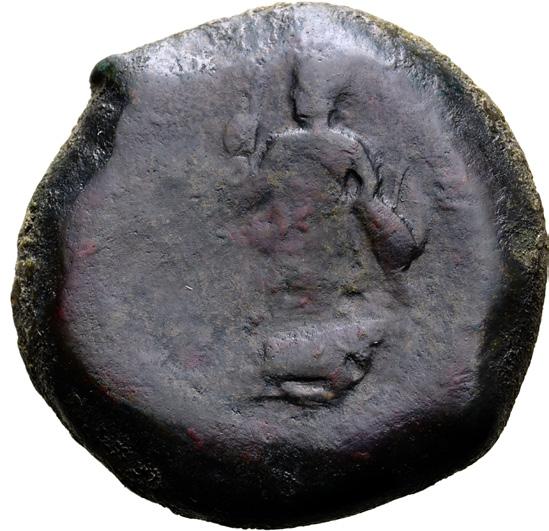
Sicily, the Tyrrhenoi Æ 31mm. Circa 354/3-336 BC. Helmeted head of Athena to right; TYPPH around / Athena standing facing, head to left, holding spear in right hand and resting hand on grounded shield to right; M in right field. Castrizio series I, 1; Campana 1; CNS 1; HGC 2, 1657. 35.46g, 31mm, 5h.
Fine. Very Rare.
Ex Roma Numismatics Ltd., E-Sale 81, 25 February 2021, lot 71;
Ex collection of a Photographer, Roma Numismatics Ltd., E-Sale 64, 28 November 2019, lot 226;
Ex Hans Hermann Gutknecht Collection, Münzen & Medaillen Deutschland GmbH, Auction 17, 4 October 2005, lot 402; Acquired in 1987.
In 384 Dionysios I of Syracuse raided the south coast of Etruria and returned to Sicily with a band of Etruscan soldiers who had surrendered. He probably settled them in the vicinity of the Sileraioi, near present-day Alimena. Here these Etruscan mercenaries struck coins naming themselves as the Tyrrhenoi - the Greek exonym for the Etruscans (their own name for themselves being Rasenna). This mercenary mint ceased to mint coinage overstruck on Syracusan drachmae when the Tyrrhenoi were wiped out by Timoleon in the 330s BC.


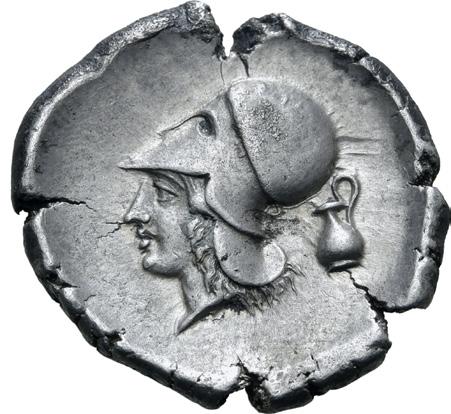
Extremely Fine; slight die shift to obv., struck on a very broad planchet. Very Rare.
Ex Leu Numismatik AG, Web Auction 20, 16 July 2022, lot 663.
Ex Rockefeller university Collection



78.
Akarnania, Anaktorion AR Stater. 350-300
Extremely Fine; obv. struck from slightly worn die, attractive light cabinet tone.

360 No Reserve
Ex David Redman Collection, Roma Numismatics Ltd., E-Sale 104, 15 December 2022, lot 69, collector’s ticket included (hammer: GBP 900);
Ex Auktionshaus Felzmann, Auction 154, 3 November 2015, lot 1247;
Ex Roma Numismatics Ltd., E-Sale 4, 28 December 2013, lot 88;
Ex Rockefeller University / Dr. Alfred E. Mirsky Collection, Gemini, LLC, Auction VII, 9 January 2011, lot 1137.
79.
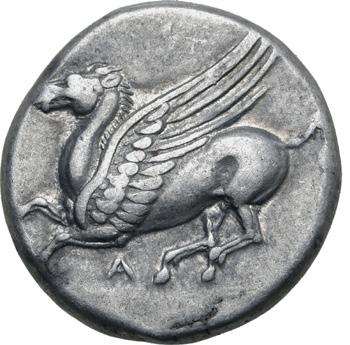


Akarnania, Argos Amphilochikon AR Stater. Circa 340-300 BC. Pegasos flying to left; Λ below / Head of Athena to left, wearing Corinthian helmet; crested Corinthian helmet to left behind. Pegasi 11; Imhoof-Blumer, Akarnaniens 12; BCD Akarnania 132-3; HGC 4, 783. 8.52g, 19mm, 6h.
Near Extremely Fine; well-centred, and with an attractive light cabinet tone. Previously graded by NGC Ch EF, 4/5 - 4/5.
Ex Classical Numismatic Group, Electronic Auction 523, 7 September 2022, lot 111; Ex Stack’s Bowers Galleries (& Ponterio), Collector’s Choice Auction, 22 February 2022, lot 75674 (hammer: USD 1,800).
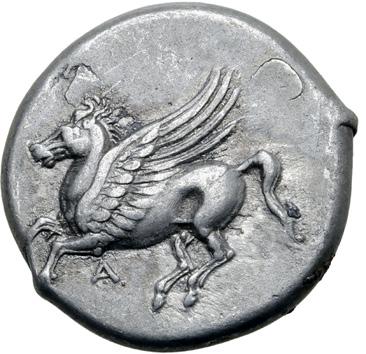
80.
450

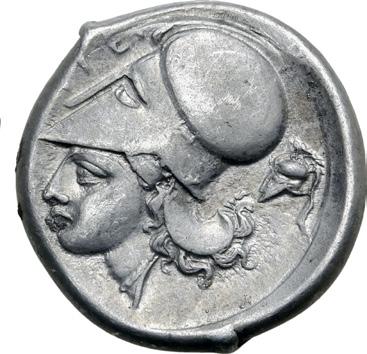
Akarnania, Argos Amphilochikon AR Stater. Circa 340-300 BC. Pegasos flying to left; A below / Head of Athena to left, wearing Corinthian helmet; APΓEI above to left, crested Corinthian helmet to left behind. Pegasi 11; Imhoof-Blumer, Akarnaniens 12; BCD Akarnania 132-3; HGC 4, 783. 8.53g, 20mm, 10h.
Extremely Fine.
300


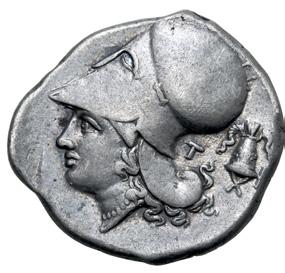
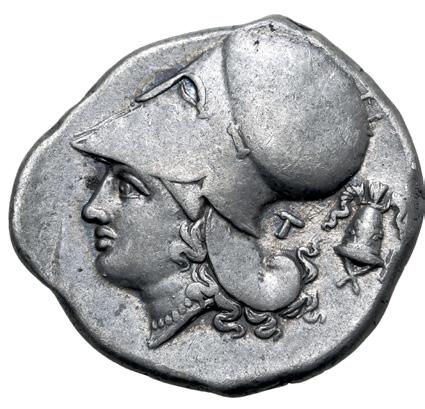
BC. Pegasos flying to left; Λ below / Head of Athena to left, wearing Corinthian helmet; T-I and crested Macedonian helmet behind. Pegasi 151; BCD Akarnania 272; HGC 4, 825. 8.53g, 23mm, 9h.
Ex Leu Numismatik AG, Web Auction 24, 3 December 2022, lot 1105 (hammer: CHF 1,100). No Reserve
T HESSALy

82.

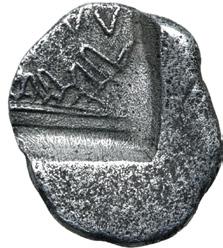
Thessaly, Larissa AR Obol. Circa 479-460 BC. Head of the nymph Larissa to left / Sandal of Jason to left; ΛA[…](inverted) above, all within incuse square. BCD Thessaly I 1097; BCD Thessaly II 349.2; HGC 4, 403. 0.61g, 9mm, 12h.
83.
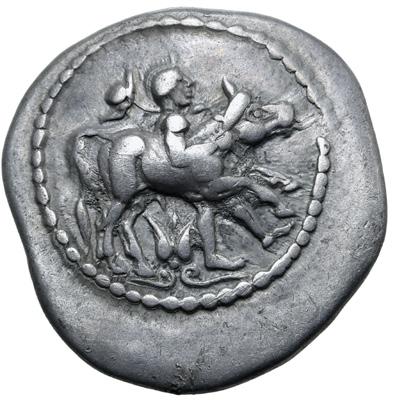

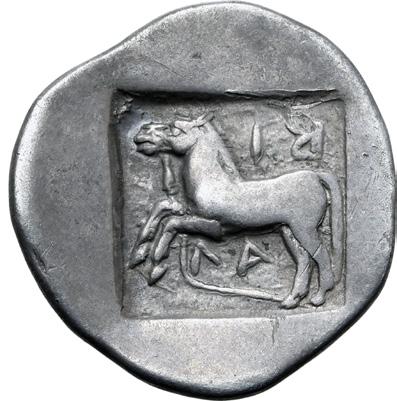
Thessaly, Larissa AR Drachm. Circa 475-425 BC. Thessalos advancing to right, with petasos over shoulders and chlamys tied at neck, holding a band around forehead of bull rushing to right, lotus flower below / Horse prancing to left; Λ-Α; below, R-I above; all within incuse square. BCD Thessaly II 152 var. (same obv. die; arrangement of ethnic); cf. Lorber, Thessalian 9; HGC 4, 411. 5.83g, 22mm, 5h.
Good Very Fine; struck on a broad flan.
Ex Classical Numismatic Group, Classical Numismatic Review XL.2, Summer 2015, 405151; Ex BCD Collection, Classical Numismatic Group, Electronic Auction 348, 8 April 2015, lot 198.




180 No Reserve
Thessaly, Larissa AR Drachm. Circa 356-342 BC. Head of the nymph Larissa facing slightly to left, with hair in ampyx / Horse standing to right, preparing to lie down; ΛAPIΣ-AIΩN above and below. BCD Thessaly II 324; HGC 4, 453 var. (rev. legend arrangement). 6.13g, 20mm, 10h.
Near Extremely Fine; wonderful old cabinet tone.
Ex Roma Numismatics Ltd., E-Sale 104, 15 December 2022, lot 71 (hammer: GBP 550).
Previously purchased from Silbury Coins; Reportedly ex Seaby, 1950s.

85.
240
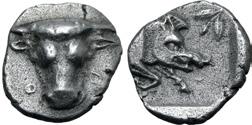

0.92g, 9mm, 6h.
Good Very Fine.
Ex Roma Numismatics Ltd., Auction 7, 22 March 2014, lot 225.

86.
Near Extremely Fine.

Ex Roma Numismatics Ltd., E-Sale 103, 24 November 2022, lot 171 (hammer: GBP 440).

60 No Reserve
180 No Reserve
87.


Near Mint State; lustrous, with a sharply struck reverse. Very Rare.
Ex Leu Numismatik AG, Web Auction 20, 16 July 2022, lot 825 (hammer: CHF 1,200).
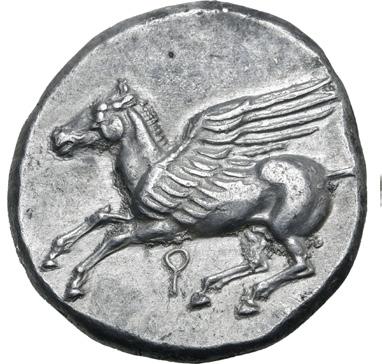


88.
89.
Corinthia,



600

900
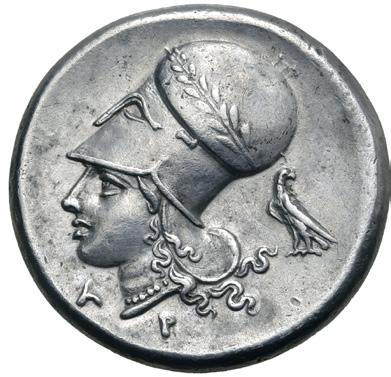
AR Stater. Circa 345-307 BC. Pegasos flying to left; Ϙ below / Head of Athena to left, wearing laureate Corinthian helmet; A-P flanking below, eagle standing behind to left, head reverted. BCD Corinth 101; Pegasi 426; Ravel 1008; SNG Copenhagen 73-4; HGC 4, 1848. 8.55g, 21mm, 2h.
Ex Classical Numismatic Group, Auction 121, 6 October 2022, lot 270 (hammer: USD 1,600). No Reserve


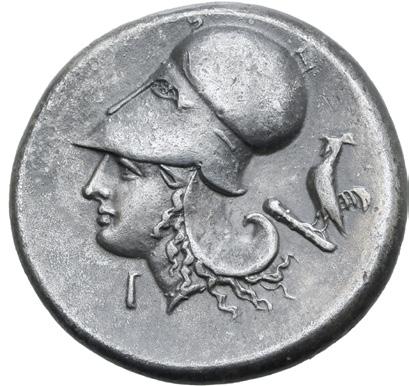
Corinthia, Corinth AR Stater. Circa 345-307 BC. Pegasos flying to left; Ϙ below / Head of Athena to left, wearing Corinthian helmet; Ι below chin, cockerel standing to left on club behind. BCD Corinth 113; Pegasi 423; Ravel 1032; SNG Copenhagen 112; SNG Lockett 2092; SNG Fitzwilliam 3410; HGC 4, 1848. 8.42g, 22mm, 6h.
Extremely Fine; attractive cabinet tone over lustrous metal.
90. 600 No
91.



Corinthia, Corinth AR Drachm. Circa 330-300 BC. Pegasos flying to left; Ϙ below / Head of Aphrodite to left, wearing sakkos; Δ below chin. BCD Corinth 156-8 var. (letters on rev.); SNG Copenhagen 130 var. (same); HGC 4, 1869. 2.50g, 17mm, 12h.
Near Extremely Fine; attractive old cabinet tone. Rare variant.
Ex Roma Numismatics Ltd., Auction XXVII, 22 March 2023, lot 123 (hammer: GBP 600).
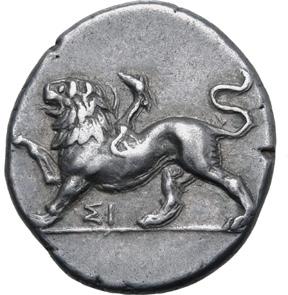
92.
300 No Reserve


Sikyonia, Sikyon AR Triobol. Circa 330-280 BC. Chimaera advancing to left, with raised forepaw; ΣI below / Dove flying to left; Δ above tail feathers. BCD Peloponnesos 298 (this coin); SNG Copenhagen 61 var. (ΔI on rev.); BMC 112; HGC 5, 213. 2.98g, 17mm, 7h.
Extremely Fine; an excellent strike, with a beautiful iridescent cabinet tone. Very Rare.
Ex CNG Inventory # 814040 (2008);
Ex BCD Collection, LHS Numismatik, Auction 96, 8 May 2006, lot 298; Reportedly acquired for 5,000 FF from JBV in September 1987.
300 No Reserve

Attica, Athens AR Tetradrachm. Circa late
Good Very Fine; displaying a full helmet
Ex Roma Numismatics Ltd., Auction XXII,



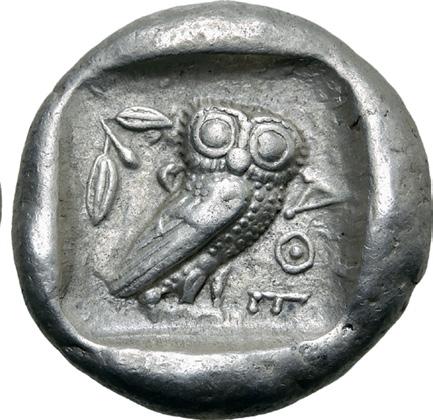
2,400
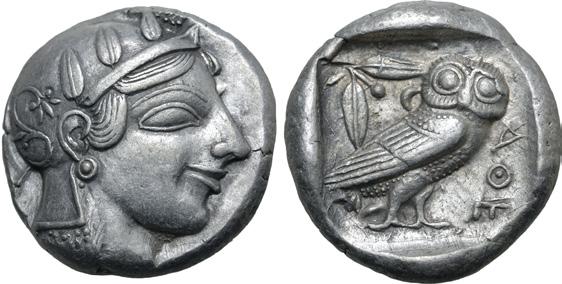

Extremely Fine. 300
95.
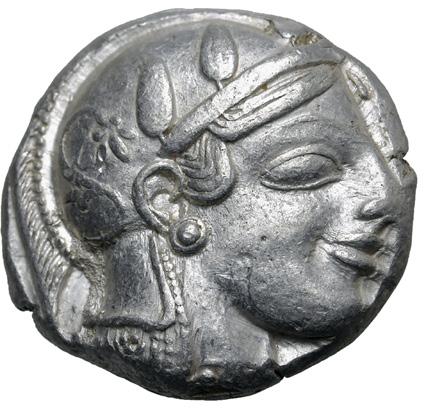
Athens
Extremely Fine.

96.
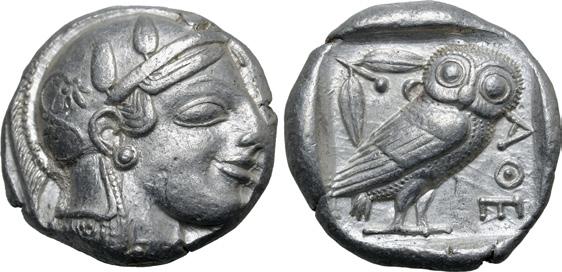

1596. 17.21g, 24mm, 11h.

300 No Reserve

Attica, Athens AR Tetradrachm. Circa 460-454 BC. Late “transitional” issue. Head of Athena to right, wearing crested Attic helmet ornamented with three olive leaves above visor and spiral palmette on bowl, round earring with central
and pearl
/ Owl
to
with head facing, olive sprig and crescent behind, ΑΘΕ before; all within incuse square. Starr pl. XXIII 10’; Kroll 8; HGC 4, 1596. 17.16g, 24mm, 7h.
Extremely Fine.

Athens
NGC graded AU 5/5 - 4/5 (#4883344-031).
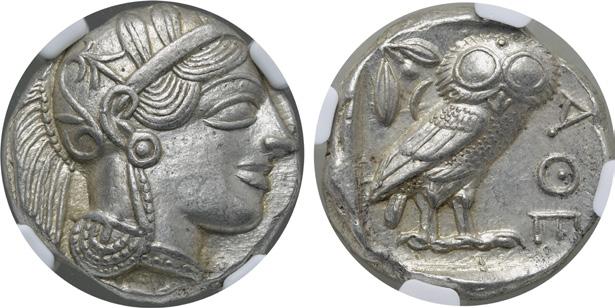
Ex Roma Numismatics Ltd., Auction XXIII, 24 March 2022, lot 123.
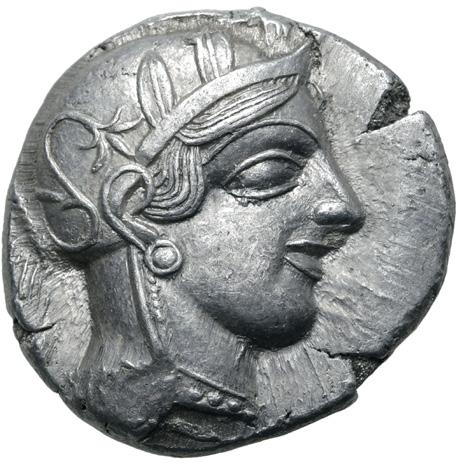

98.
Near Mint State; struck on a generous planchet.
Ex Roma Numismatics Ltd., E-Sale 107, 16 March 2023, lot 166.
300 No Reserve

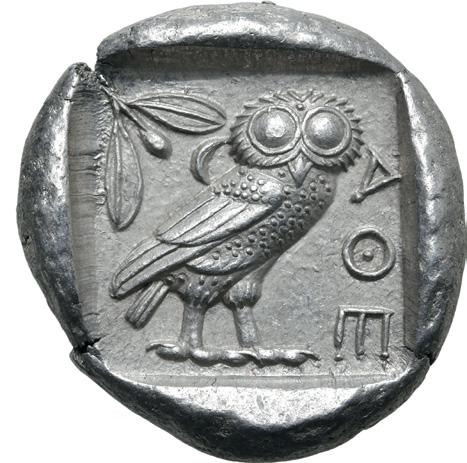
101.


Near Mint State; lustrous metal, struck on a broad flan.
Ex Roma Numismatics Ltd., E-Sale 102, 3 November 2022, lot 74.

Good Extremely Fine.

Ex Roma Numismatics Ltd., E-Sale 102, 3 November 2022, lot 55.


Good Extremely Fine; minor contact mark on cheek, highly lustrous metal.
Ex Roma Numismatics Ltd., E-Sale 102, 3 November 2022, lot 69.
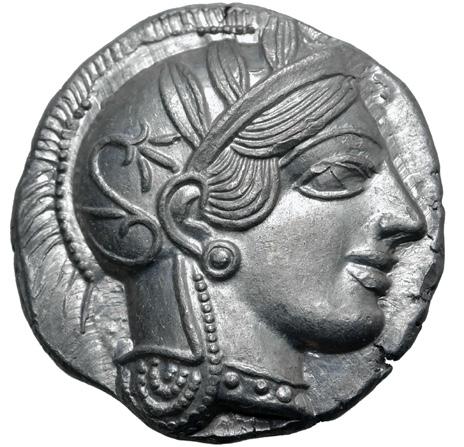
102.
Fleur De Coin; near full helmet crest.


300

300
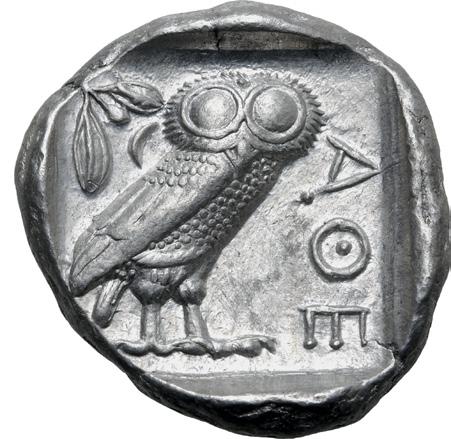
300
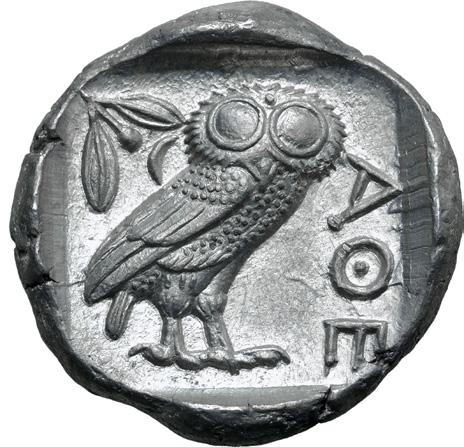
300 No

103.
Mint State.


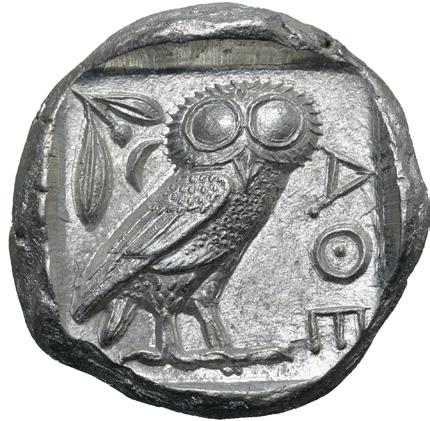


104.
Good Extremely Fine; planchet flaw to rev.

105.
Near Mint State; die shift to reverse, full helmet crest.


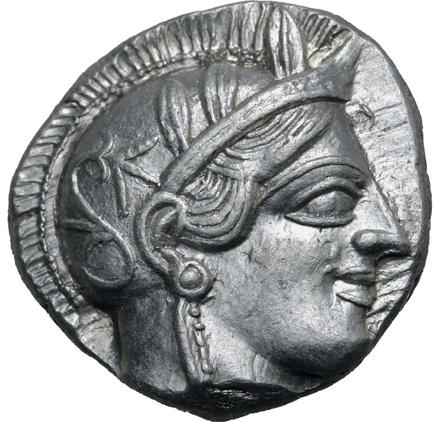





107.
Good Extremely Fine; full helmet crest.
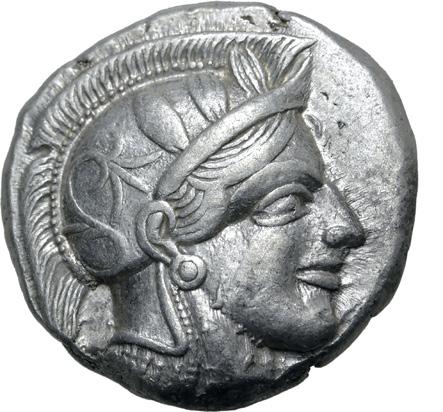

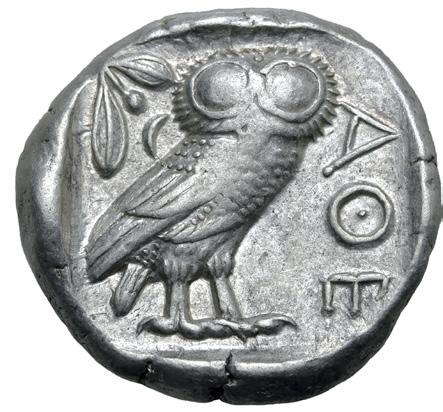
108.
Extremely Fine; area of flatness, full helmet crest.

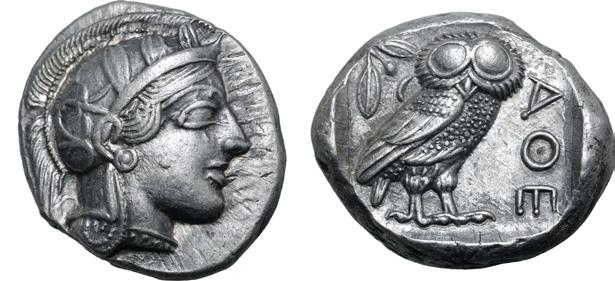

109.
Good Extremely Fine; full helmet crest.
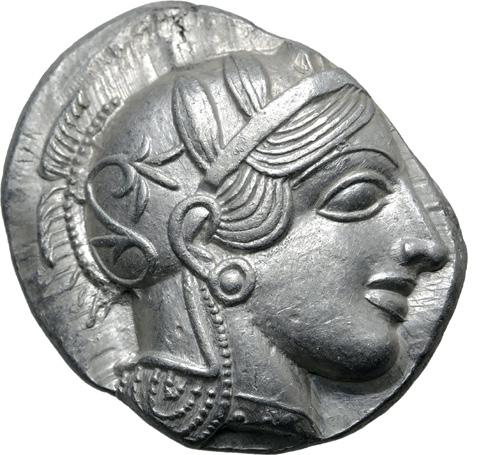


110.

111.
Good Extremely Fine.
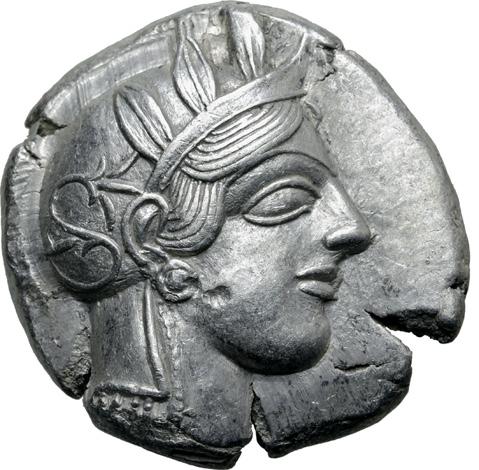



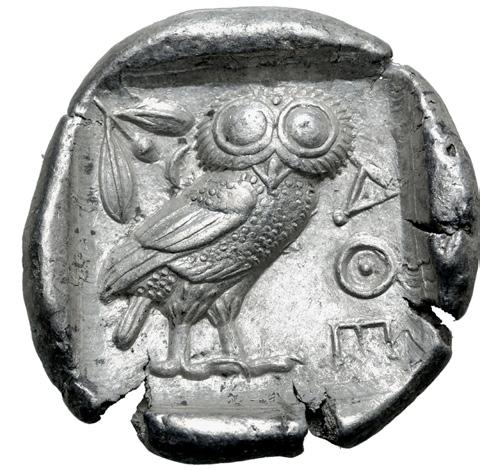
112.
Good Extremely Fine.

113.

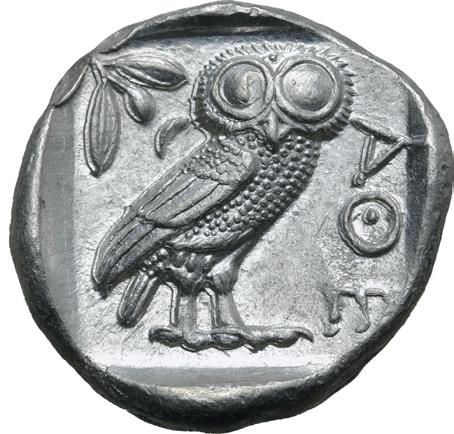
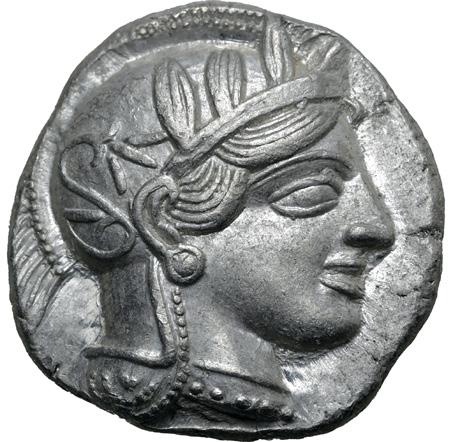
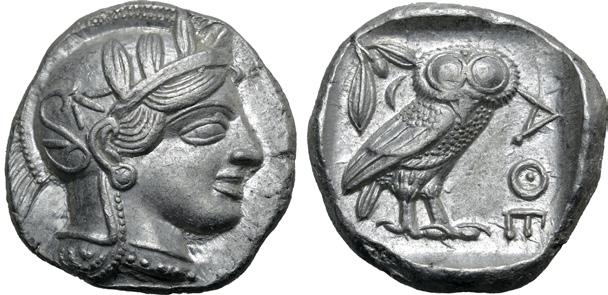
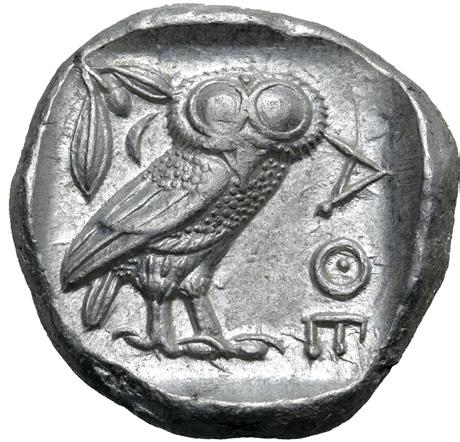
114.
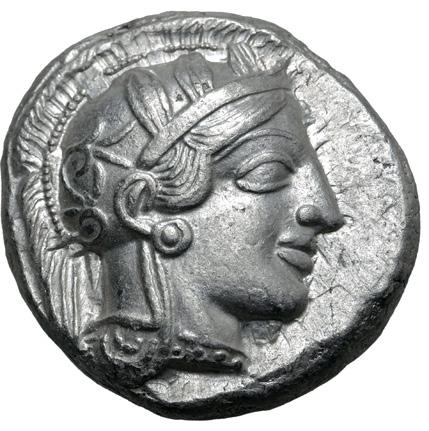
115.
Extremely Fine; full helmet crest.

116.
Near Mint State; near full helmet crest.

117.
Good Extremely Fine.
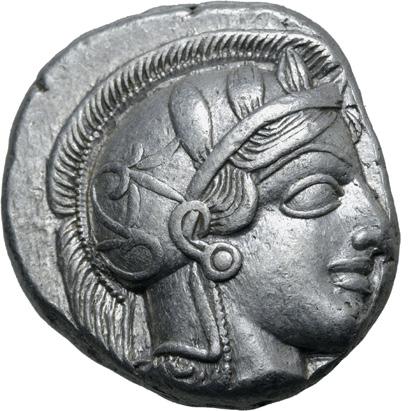


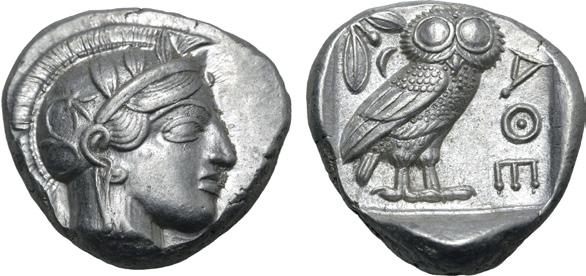

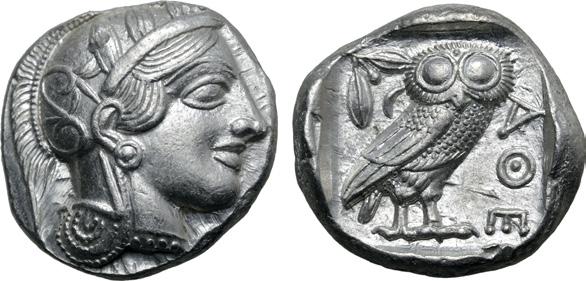
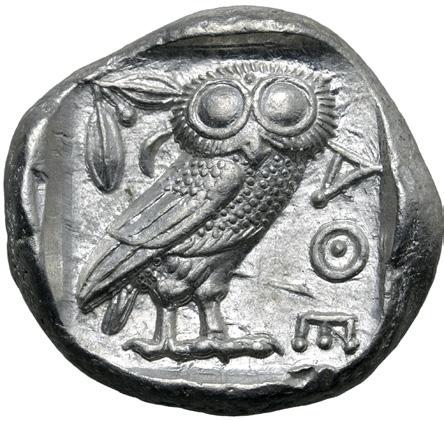


118.

119.
Good Extremely Fine; near full helmet crest.
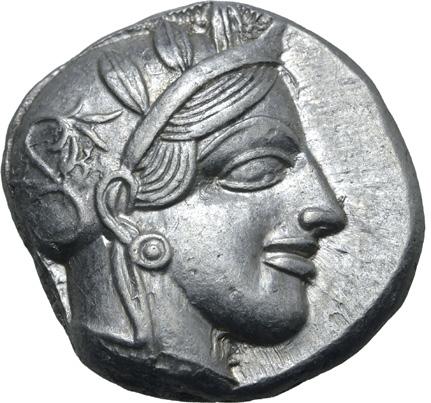


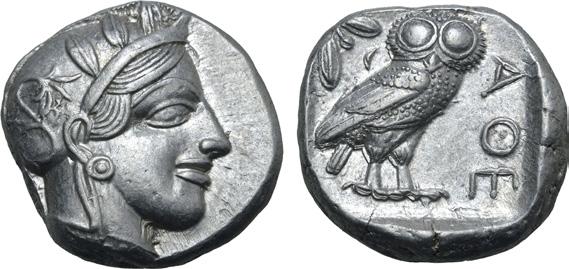

120.
Extremely Fine.


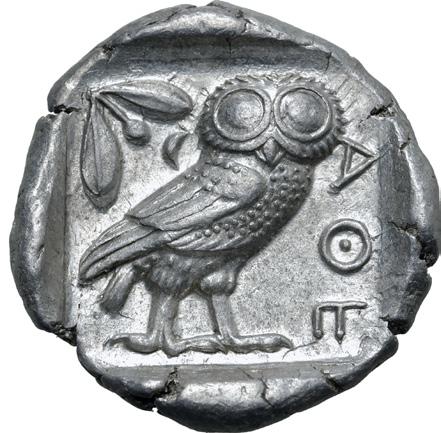
121.
122.

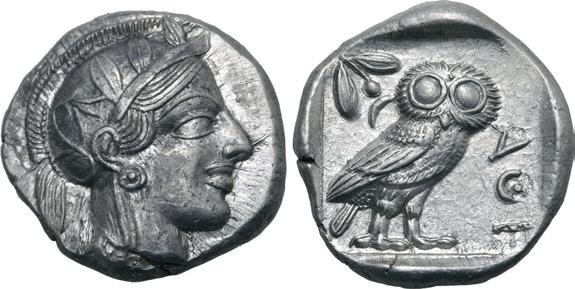
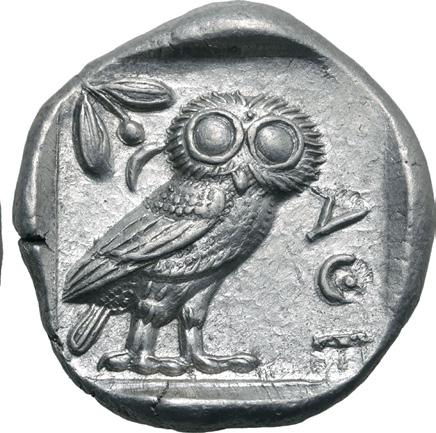

123.
Good Extremely Fine; full helmet crest.

124.
Near Mint State.





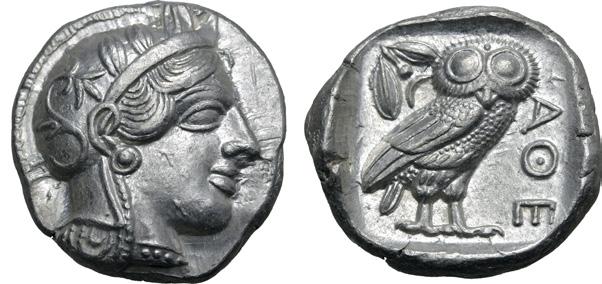
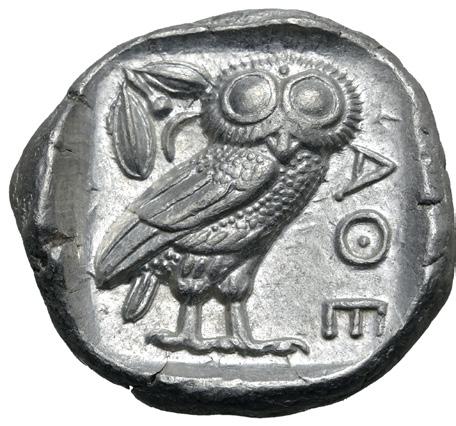
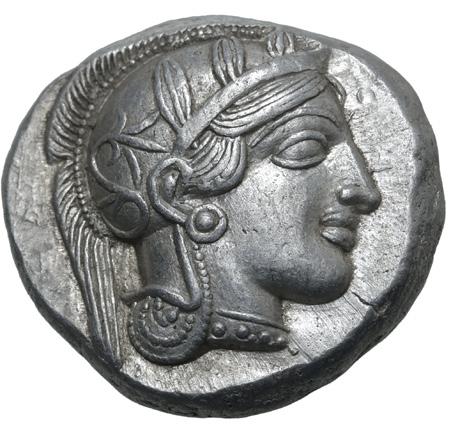



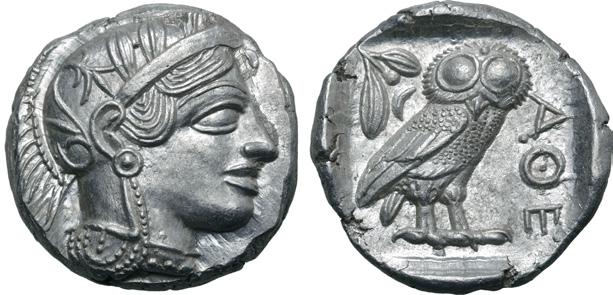

127.
Near Mint State.



128.
Good Extremely Fine; near full helmet crest.


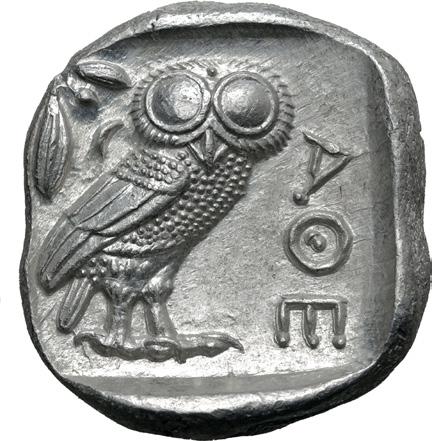

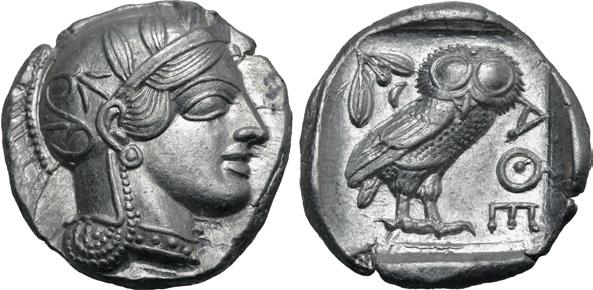

131.
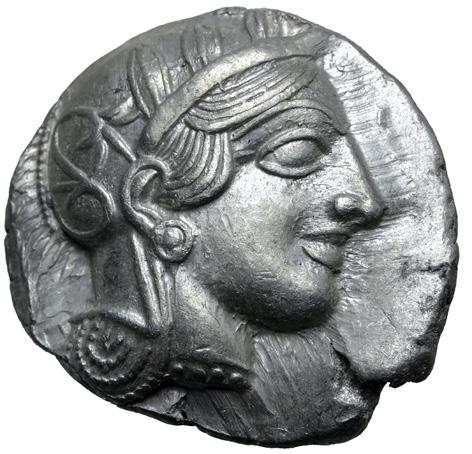
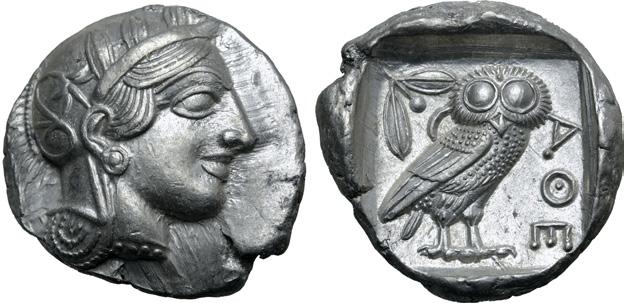
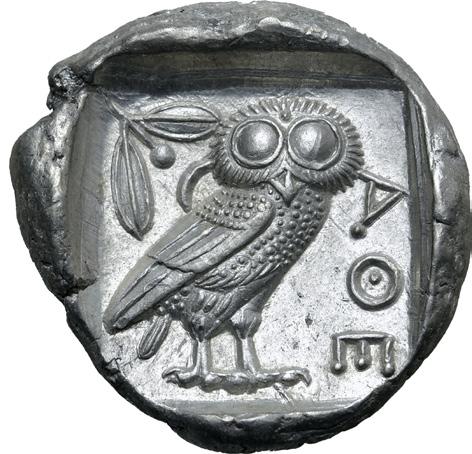
Attica, Athens AR Tetradrachm. Circa 454-404 BC. Head of Athena to right, wearing crested Attic helmet ornamented with three olive leaves above visor and spiral palmette on bowl, round earring with central boss, and pearl necklace / Owl standing to right with head facing, olive sprig and crescent behind, ΑΘΕ before; all within incuse square. Kroll 8; Dewing 1591-8; SNG Copenhagen 31; HGC 4, 1597. 17.18g, 26mm, 10h.
Good Extremely Fine.
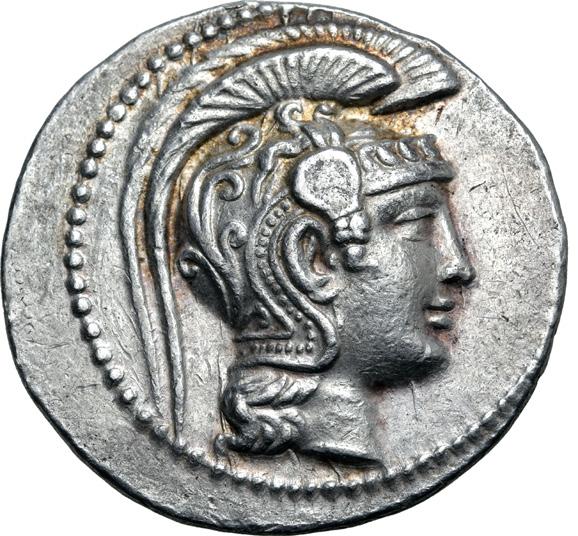


132.
Attica, Athens AR New Style Tetradrachm. Circa 165/4 BC. Polycharm-, Nikog- and Philodr- magistrates. Head of Athena Parthenos to right, wearing necklace, pendant earring, and triple-crested Attic helmet decorated with the protomes of four horses above the visor, a Pegasos in flight rightward above the raised earpiece, and a curvilinear ornament on the bowl / Owl standing to right, head facing, on amphora with Γ (month); A-ӨE above
ΠOΛY-XAPM NIKOΓ ΦΙΛΟΔP (magistrates’ names) in four lines across fields, winged kerykeion to left, ME below; all within wreath. Thompson 376d corr. (magistrate name) var. (same obv. die, unlisted controls); HGC 4, 1602. 16.85g, 32mm, 12h.
Extremely Fine.
Ex Classical Numismatic Group, Triton XIV, 4 January 2011, lot 214.
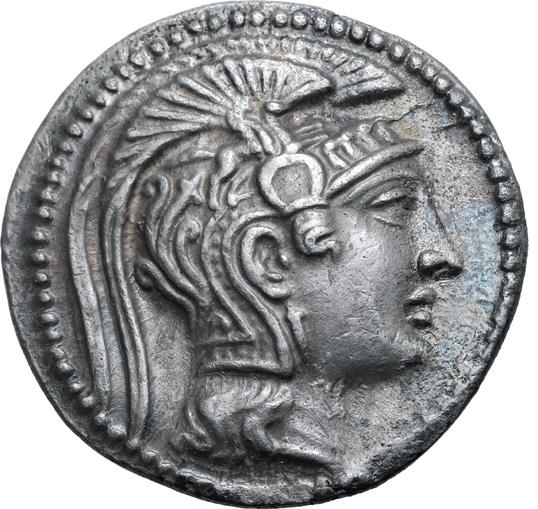
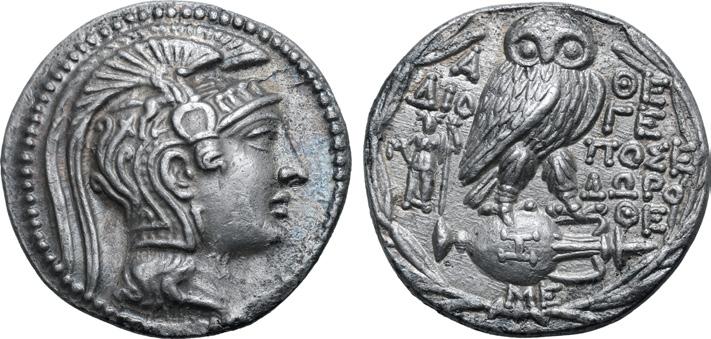

133.
Attica, Athens AR New Style Tetradrachm. Circa 129/8 BC. Dioge-, Posei- and Dorothe-, magistrates. Head of Athena Parthenos to right, wearing necklace, pendant earring, and triple-crested Attic helmet decorated with the protomes of four horses above the visor, a Pegasos in flight rightward above the raised earpiece, and a curvilinear ornament on the bowl / Owl standing to right, head facing, on amphora with I (month); A-ӨE above ΔΙΟΓΕ ΠΟΣΕ ΔΩΡΟΘΕ (magistrates’ names) in five lines across fields, Dionysos standing facing in left field, holding thyrsos, ME below amphora; all within wreath. Thompson 417e; HGC 4, 1602. 16.81g, 30mm, 12h.
Extremely Fine; light marks to cheek, attractive light cabinet tone with golden iridescence.
Ex A. Tkalec AG, 22 April 2007, lot 51.

134.
Thebes AR Stater. Circa 425-395
Good Very Fine. Very Rare.
Ex Nomos AG, obolos 4, 21 February 2016, lot 237; Ex American collection, formed before 2000.
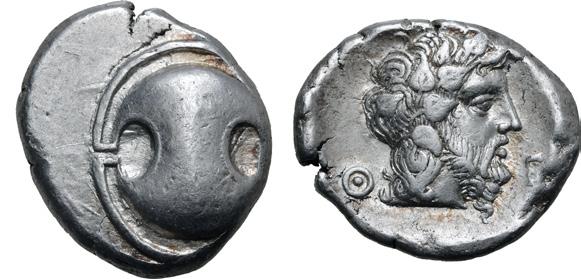



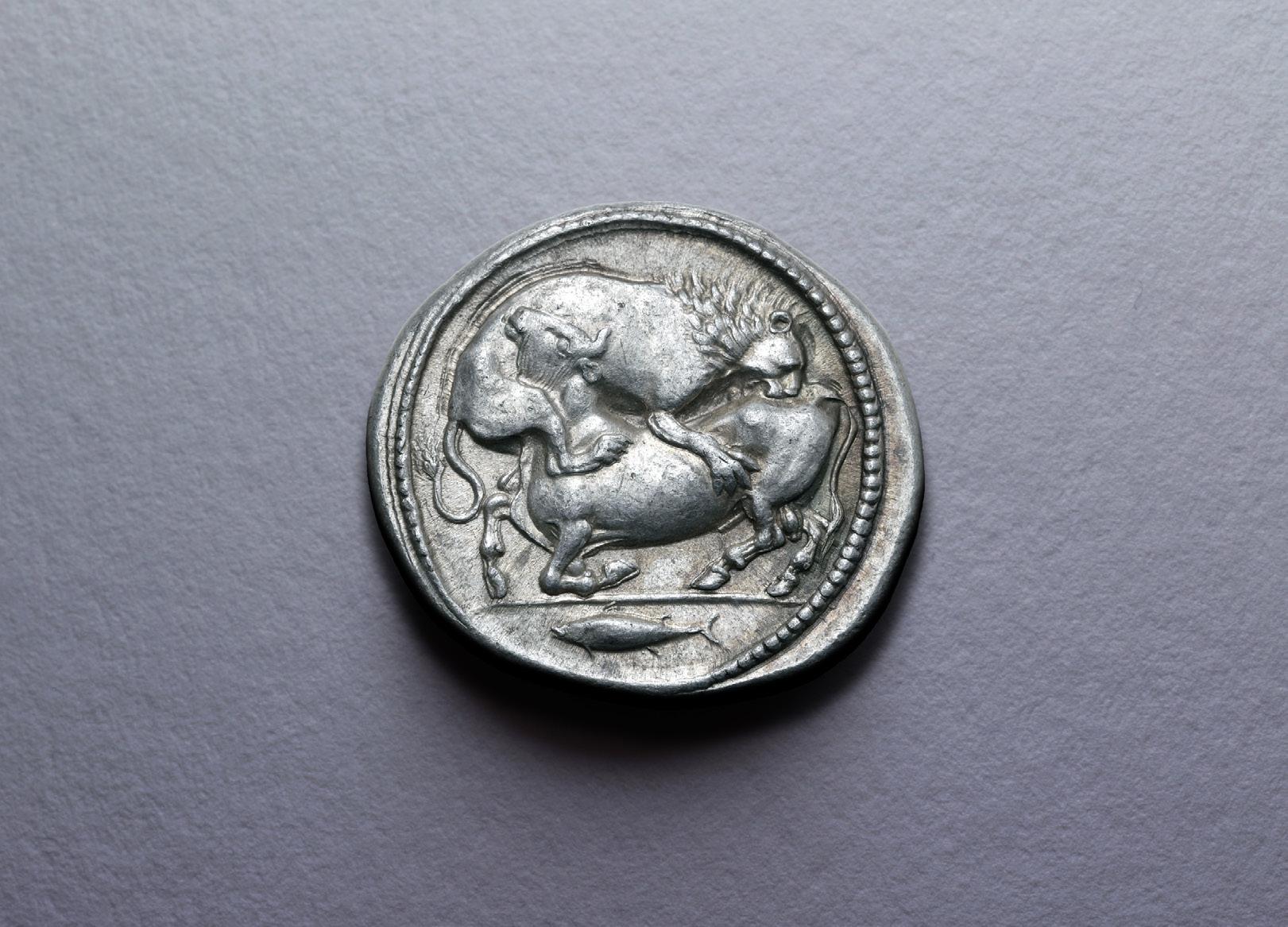
Macedon, Akanthos AR Tetradrachm. Circa 470-430 BC. Bull collapsing to left, head raised, attacked and mauled by lion upon his
tunny fish to left in exergue / AKANΘION in shallow incuse around quadripartite square, the quarters raised and granulated. Desneux 96ff; Weber 1863; HGC 3.1, 385. 17.29g, 30mm, 5h.
Good Extremely Fine; beautiful cabinet tone.
Ex Auktionshaus H. D. Rauch GmbH, Auction 107, 12 November 2018, lot 98 (hammer: EUR 13,000).
6,000 No Reserve
The ubiquitous and persistent theme of the lion-bull combat can be traced back to the figurate art of the third millennium, where the geometrical motifs are replaced by narrative symbolic representations, and the scene is characteristic of Near Eastern art in its infancy. The earliest known depiction occurs on a ewer found at Uruk dated to the latter part of the Protoliterate period, circa 3300 BC. That ewer has a relief depiction of a lion attacking a bull from behind (see Henri Frankfort, Art and Architecture of the Ancient Orient, 1963). The scene became widely distributed by 500 BC, featuring prominently in the Achaemenid Empire, and in particular at the palace of Darios in Persepolis, where it occurs no fewer than twenty seven times, including on the main staircase leading to the imperial complex. Its frequent appearance in key locations strongly suggests an important symbolic significance, which unfortunately has not survived antiquity in any explicitly clear form.
Explanations for the symbolism and its power over the ancient peoples who reproduced it with prodigious enthusiasm have ranged from it being an expression of royal power, to an astronomical allusion, as well as it being an embodiment of the constant struggle between civilisation (represented by the domesticated bull) and nature (represented by the untameable lion). This latter argument may well hold true for the Mesopotamians of Uruk, who it is known took a rather grim view of the world, seeing it as a battleground of opposing powers.
One interpretation that has gained traction in recent years is that the motif is apotropaic in nature, serving to ward off evil in a similar function to the gorgoneion, which like the lion attack motif is very prevalent in ancient Greek coinage, though there is little evidence to support such a notion.
G. E. Markoe (‘The Lion Attack in Archaic Greek Art’, Classical Antiquity Vol. 8, 1, 1989) convincingly suggests that a more likely explanation may be found in the examination of archaic Greek epic poetry, particularly in Homeric literature, wherein a lion attacking cattle or sheep is repeatedly employed as a simile for the aggression and valour of combatant heroes. In notable passages, Agamemnon’s victorious advance against the Trojans in the Iliad (11.113ff and 129) and Hektor’s successful pursuit of the Achaeans (15.630ff) are both likened to a lion triumphing over its hapless prey. In both of these cases the allusion is completed by the defeated being compared to fleeing prey animals. In all, there are twenty five examples present in the Iliad of heroic warriors being compared to leonine aggressors, with the victims variously compared to boars, sheep, goats, bulls or deer. The repetition of this literary device is clearly demonstrative of how deeply rooted the imagery was in the Greek (and perhaps more generally human) consciousness. Of further and great significance is the involvement of the gods as the primary instigators of heroic leonine aggression in almost every case, and as it is made clear that the lion itself is an animal that is divinely directed to its prey (11.480, by a daimon), so then is the lion attack a metaphor for divinely inspired heroic triumph.
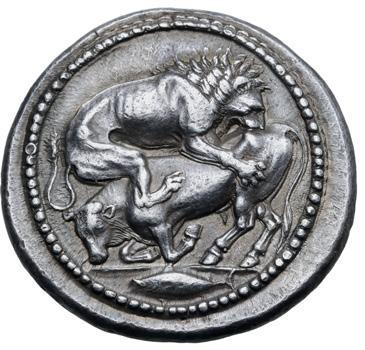
136.
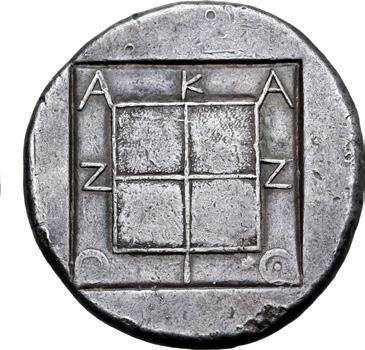

Extremely Fine; beautiful cabinet tone. A beautiful composition, the half-facing head of the bull evidently the work of a talented engraver. Ex Roma Numismatics Ltd., Auction XIX, 26 March 2020, lot 364.
6,000 No Reserve

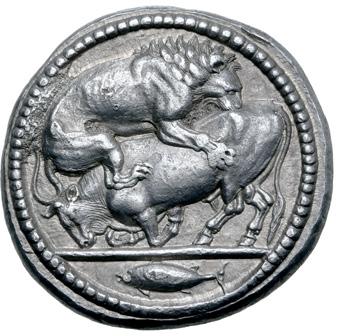
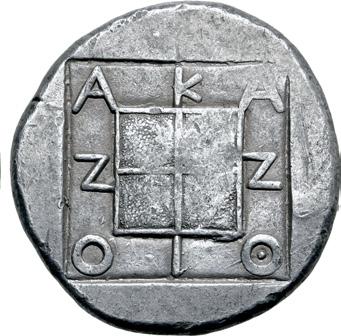
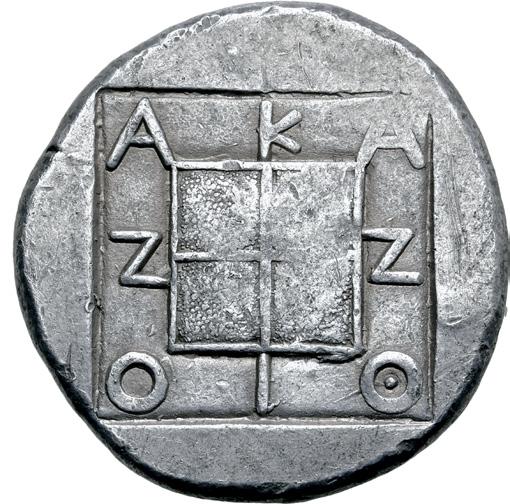
137.
Extremely Fine; light cabinet tone.
3,600 No Reserve
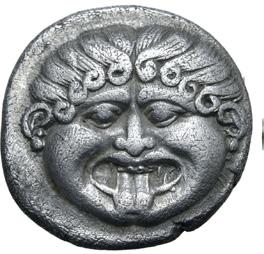



138.
Neapolis AR Hemidrachm. Circa
Near Extremely Fine.
Ex Roma Numismatics Ltd., E-Sale 103, 24 November 2022, lot 271.

139.
Chalkidian
Extremely Fine.
Acquired from Nomos AG.
AR Tetradrachm.



140.
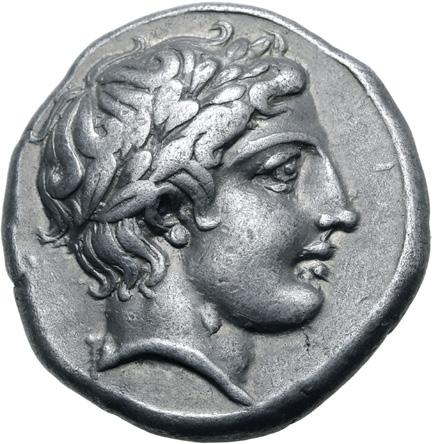


Chalkidian League AR Tetradrachm. Olynthos,
Robinson & Clement Group H,

383/2
Good Very Fine; minor flan flaw to rev., attractive deep cabinet tone over lustrous
The growing influence and expansionist aims of the Chalkidian League led by Olynthos in 382 BC led to calls from Amyntas of Macedon, as well as the cities of Akanthos and Apollonia (who anticipated imminent conquest by the League), for Spartan intervention to check the League’s power. Sparta, keen to reassert its presence in northern Greece, consented and a force of 10,000 was mobilised and dispatched against the League.
After several years of protracted but indecisive warfare, Olynthos agreed to dissolve the Chalkidian League. However, this dissolution appears to have been little more than a token formality, since in the following year the League appears among the members of the Athenian naval confederacy, and twenty years later Demosthenes reported the power of the League as being much greater than before the Spartan expedition.
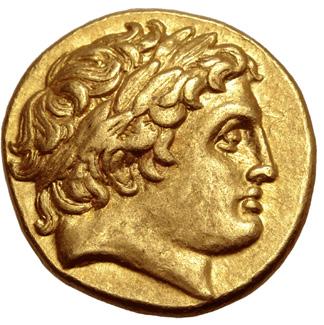



141.
Kingdom of Macedon, Philip II AV Stater. Pella, circa 340/36-328 BC. Laureate head of Apollo to right / Charioteer, holding kentron and reins, driving galloping biga to right; cornucopiae below horses, ΦΙΛΙΠΠΟΥ in exergue. Le Rider -, cf. pl. 65, 393-395; cf. HGC 3.1, 846. 8.54g, 18mm, 12h.
Near Mint State. Extremely rare symbol, possibly unique from these dies.
Ex Roma Numismatics Ltd., Auction XIX, 26 March 2020, lot 370;
Ex Roma Numismatics Ltd., Auction XVI, 26 September 2018, lot 211.

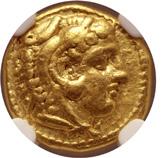
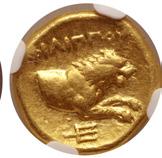

142.
Kingdom of Macedon, Philip II AV Hemistater. Amphipolis, circa 340-328 BC. Head of Herakles to right, wearing lion skin headdress / Forepart of lion to right; trident below, ΦΙΛΙΠΠΟΥ above. Le Rider 43; SNG ANS 217 (same dies); HGC 3.1, 848. 4.29g, 13mm, 6h.
NGC graded Ch XF 5/5 - 4/5 (#6158067-002). Very Rare.
Ex GK Collection, Roma Numismatics Ltd., Auction XXIII, 24 March 2022, lot 157 (hammer: GBP 5,500);
Ex Leu Numismatik AG, Auction 1, 25 October 2017, lot 45;
Ex Viennese collection, formed in the 1990s.

143.



Kingdom of Macedon, Philip II AV 1/8 Stater. Pella, circa 340-328 BC. Head of Herakles to right, wearing lion skin headdress / Trident head, ΦΙΛΙΠΠΟΥ to left. Le Rider 113 (D56/R48); SNG ANS 233 (same rev die); HGC 3.1, 856. 1.07g, 9mm.
NGC graded XF 5/5 - 4/5 (#6158069-003).
Ex GK Collection, Roma Numismatics Ltd., Auction XXIII, 24 March 2022, lot 156 (hammer: GBP 1,700);
Ex Leu Numismatik AG, Auction 1, 25 October 2017, lot 47.

144.



Kingdom of Macedon, Philip II AV 1/8 Stater. Uncertain mint, circa 340-328 BC. Head of Herakles to right, wearing lion skin headdress / Club or dagger(?), ΦΙΛΙΠ-ΠΟΥ above and below. Unpublished in the standard references, cf. Le Rider 89ff. var (rev. type); cf. SNG ANS 228 var. (same); cf. HGC 3.1, 854 var. (same). 1.06g, 9mm, 12h.
Very Fine. Seemingly unique and unpublished with this reverse type.
145.




Kingdom of Macedon, Philip II AV Stater. Magnesia, circa 323-315 BC. Laureate head of Apollo to right / Charioteer driving biga to right, bee at right, ΦΙΛΙΠΠΟΥ and spear head below. Thompson, Philip 3; Le Rider pl.90, 15; SNG ANS 310-4. 8.56g, 18mm, 6h.
Good Extremely Fine; of fine style, lustrous.
Ex Roma Numismatics Ltd., Auction VIII, 28 September 2014, lot 372.
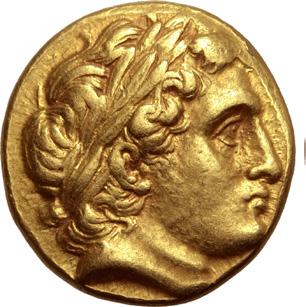
146.


Kingdom of Macedon, Philip II AV Stater. Magnesia, circa 323-315 BC. Laureate head of Apollo to right / Charioteer driving biga to right, bee at right, ΦΙΛΙΠΠΟΥ and [spear head below]. Thompson, Philip 3; Le Rider pl.90, 15; SNG ANS 310-4. 8.56g, 18mm, 6h.
Good Very Fine.
Ex Numismatica Ars Classica, Auction 84, 20 May 2015, lot 1449; Ex Astarte S.A., Auction XXII, 12 June 2010, lot 40.

147.


Kingdom of Macedon, Philip II AR 1/10 Tetradrachm. Struck under Antipater, Polyperchon, or Kassander. Pella, circa 323/2 - 315 BC. Diademed head to right / ΦIΛIΠΠOY, bridled head of horse to right, thunderbolt below. Le Rider 482 (D255/R397); SNG ANS 437; HGC 3.1 -. 1.24g, 12mm, 12h. Extremely Fine; slightly porous. Extremely Rare.

148.
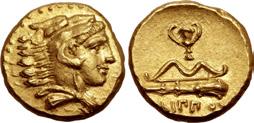

Kingdom of Macedon, temp. Philip II - Alexander III AV Quarter Stater. Pella, circa 342-328 BC. Head of Herakles to right, wearing lion skin headdress / Kantharos above bow and club; [ΦΙ]ΛΙΠΠΟΥ below. Le Rider 64 (D44/R34); SNG ANS 221-223; HGC 3.1, 851 var. (placement of control). 2.15g, 10mm, 9h.
Near Mint State.
Ex Roma Numismatics Ltd., Auction XXIII, 24 March 2022, lot 148 (hammer: GBP 4,400).
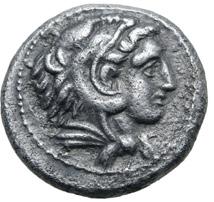
149.
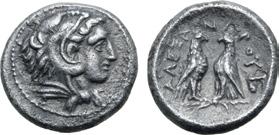

Kingdom of Macedon, Alexander III ‘the Great’ AR Diobol. ‘Amphipolis’, circa 336-323 BC. Young head of Herakles to right, wearing lion skin headdress / ΑΛΕΞΑΝΔΡΟΥ, two eagles standing facing one another on thunderbolt. Price 155; HGC 3.1, 906. 1.32g, 11mm, 9h.
150.

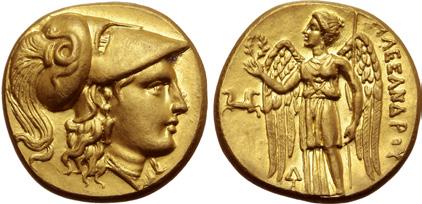

Kingdom of Macedon, Alexander III ‘the Great’ AV Stater. Struck under Kalas or Demarchos. Lampsakos, circa 328-323 BC. Head of Athena to right, wearing Corinthian helmet decorated with serpent on the bowl / Nike standing to left, holding wreath and stylis, AΛEΞANΔPOY to right; two horse foreparts conjoined, monogram under left wing. Price 1358; SNG Copenhagen 630; Müller 394. 8.54g, 17mm, 6h.
Good Extremely Fine.

151.


Kingdom of Macedon, Alexander III ‘the Great’ AV Stater. Struck under Menander. Sardes, circa 334-323 BC. Head of Athena to right, wearing triplecrested Corinthian helmet decorated with coiled serpent / Nike standing to left, holding wreath and stylis; ΑΛΕΞΑΝΔΡΟΥ to right, serpent in left field. Price 2532; ADM I Series III. 8.65g, 17mm, 12h.
Good Very Fine; some scrapes.

152.
750


Kingdom of Macedon, Alexander III ‘the Great’ AR Tetradrachm. Tarsos, circa 323 BC. Head of Herakles to right, wearing lion skin headdress / Zeus Aëtophoros seated to left, holding sceptre; ΒΑΣΙΛΕΩΣ above, AΛEΞANΔPOY to right, dolphin swimming upward in left field, Θ below throne. Price 3035 corr. = Akçakale 47 corr. (same obv. die; symbol); Newell, Tarsos -; CNG MBS 78, 404 (same dies); Rauch E-11, 71 (same dies). 17.24g, 27mm, 6h.
Extremely Fine. Extremely Rare issue, perhaps only the fourth known example.

153.
450
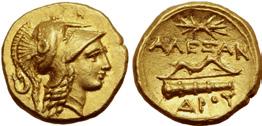

Kingdom of Macedon, temp. Alexander III - Philip III AV Quarter Stater. ‘Amphipolis’, circa 330-320 BC. Head of Athena to right, wearing triplecrested helmet decorated with a coiled serpent / ΑΛΕΞΑΝΔΡΟΥ divided in two lines by bow above club; thunderbolt above. Price 165; SNG Alpha Bank 464-6; SNG Saroglos 179; HGC 3.1, 897a. 2.16g, 11mm, 6h.
Good Extremely Fine.
Ex Roma Numismatics Ltd., Auction XXIII, 24 March 2022, lot 164 (hammer: GBP 4,600).

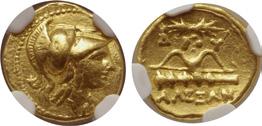

Kingdom of Macedon, temp. Alexander III - Philip III AV Quarter Stater. ‘Amphipolis’, circa 330-320 BC. Head of Athena to right, wearing triplecrested helmet decorated with a coiled serpent / ΑΛΕΞΑΝΔΡΟΥ beginning in lower field, divided in two lines by bow above club; thunderbolt above. Price 165 var. (rev. legend placement); SNG Alpha Bank 466; De Nederlandsche Bank, Amsterdam RE-04705 (same dies); HGC 3.1, 897a. 2.14g, 11mm, 6h.
NGC graded Ch VF 5/5 - 3/5, edge marks (#6158069-006). A rare variant; only one example in the Pella archive with this rev. legend placement.
Ex GK Collection, Roma Numismatics Ltd., Auction XXIII, 24 March 2022, lot 165 (hammer: GBP 2,200);
Ex Hess-Divo AG, Auction 336, 27 May 2019, lot 15;
Ex Prof. Dr. Hagen Tronnier Collection, Fritz Rudolf Künker GmbH & Co. KG, Auction 94, 27 September 2004, lot 666;
Ex Gerhard Hirsch Nachfolger, Auction 145, 27 February 1985, lot 60.
155.



Kingdom of Macedon, Philip III Arrhidaios AV Stater. Struck under Leonnatos, Arrhidaios, or Antigonos I, in the types of Alexander III. Lampsakos, circa 323-317 BC. Head of Athena to right, wearing triple-crested Corinthian helmet decorated with coiled serpent / Nike standing to left, holding wreath and stylis; ΦΙΛΙΠΠOY to right, buckle in left field, crescent-over-A under left wing. Price P14; ADM II Series IX, 173 var. (same obv. die, different positions of controls); HGC 3.1, 968a. 8.59g, 17mm, 6h.
NGC graded XF 5/5 - 3/5, edge scuff (#6158069-008).
Ex GK Collection, Roma Numismatics Ltd., Auction XXIII, 24 March 2022, lot 178 (hammer: GBP 5,500); Ex Numismatik Naumann, Auction 45, 3 July 2016, lot 121.
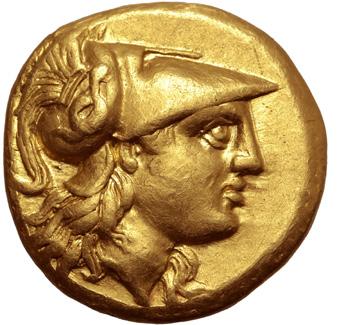
156.
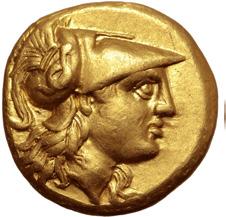

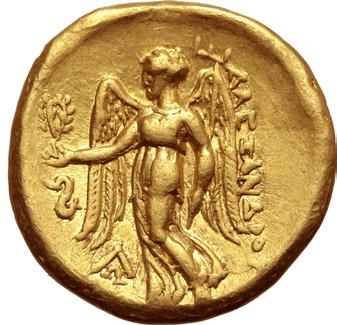
Kingdom of Macedon, Philip III Arrhidaios AV Stater. Struck under Leonnatos, Arrhidaios, or Antigonos I, in the name and types of Alexander III. Lampsakos, circa 323-317 BC. Head of Athena to right, wearing triple-crested Corinthian helmet decorated with coiled serpent / Nike standing to left, holding wreath and stylis; ΑΛΕΞΑΝΔΡΟΥ to right, buckle to in left field, monogram under left wing. Price 1374. 8.58g, 19mm, 3h.
Near Extremely Fine; edge repaired.
Ex GK Collection, Roma Numismatics Ltd., Auction XXIII, 24 March 2022, lot 168 (hammer: GBP 4,400); Ex Leu Numismatik AG, Web Auction 9, 7 September 2019, lot 133.

157.

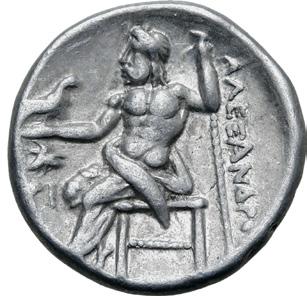
Kingdom of Macedon, Philip III Arrhidaios AR Drachm. Struck under Menander or Kleitos, in the name and types of Alexander III. Sardes, circa 323318 BC. Head of Herakles to right, wearing lion skin headdress / Zeus Aëtophoros seated to left, holding sceptre; AΛEΞANΔPO[Y] to right, bee above TI in left field. Price 2626; Müller 521; SNG Copenhagen 961. 4.22g, 17mm, 12h.
Near Extremely Fine.
Ex Roma Numismatics Ltd., E-Sale 103, 24 November 2022, lot 322.

158.



Kingdom of Macedon, Philip III Arrhidaios AV Stater. Struck under Koinos, In the name and types of Alexander III. Susa, circa 322-320 BC. Head of Athena to right, wearing triple-crested Corinthian helmet decorated with sphinx on the bowl / Nike standing facing, head to left, holding wreath and stylis; BAΣIΛEΩΣ to left, AΛEΞANΔPOY to right, ΛA under left wing, monogram under right. Price 3844 var. (griffin on helmet); SNG Alpha Bank -; SNG München -; CNG Triton XX, 119 (same obv. die); Heritage 3030, 23725 (hammer: USD 22,000) = CNG 93, 161 (same obv. die); Gorny & Mosch 203, 137 (same obv. die). 8.58g, 18mm, 3h.
Extremely Fine; lustrous. Extremely Rare; seemingly only three other examples on CoinArchives.




159.
Kingdom of Macedon, temp. Philip III - Kassander AV Stater. In the name and types of Philip II. Pella, circa 323-315 BC. Laureate head of Apollo to right / Charioteer, holding kentron and reins, driving galloping biga to right; Boiotian shield below, ΦIΛIΠΠOY in exergue. Le Rider 607e (D234/R442 - this coin); SNG ANS 198 (same dies); Gulbenkian 831 (same dies); Pozzi 843 (same dies); HGC 3.1, 986.
NGC graded Ch AU 5/5 - 3/5, marks, brushed, fine style (#6154656-003); a truly spectacular example, boldly struck from fresh dies. Extremely Rare. This coin published in G. Le Rider, Le monnayage d’argent et d’or de Philippe II (Paris, 1977);
5,400
Ex Roma Numismatics Ltd., Auction XXIII, 24 March 2022, lot 183 (hammer: GBP 7,500);
Ex Classical Numismatic Group, Triton XXIV, 19 January 2021, lot 479 (hammer: USD 9,000);
Ex Seaby Coin & Medal Bulletin, Number 737, January 1980, no. A1 (noting: “the finest specimen of this coin we have ever seen, splendid style, would grace any collection”);
Ex H. M. Collection, Émile Bourgey, 15 December 1909, lot 116.

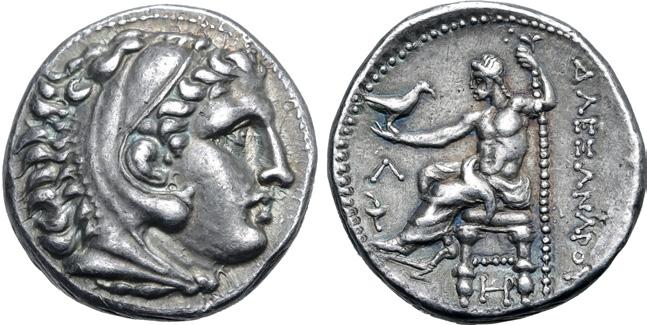

160.
Extremely Fine; attractive vivid iridescent toning. Previously NGC graded Ch XF★ 5/5 - 5/5 (#3762400-002).
Ex Fritz Rudolf Künker GmbH & Co. KG, Auction 376, 18 October 2022, lot 4509;
Ex Classical Numismatic Group, Electronic Auction 427, 2 August 2018, lot 128;
Ex Fritz Rudolf Künker GmbH & Co. KG, Auction 326, 7 October 2019, lot 215.


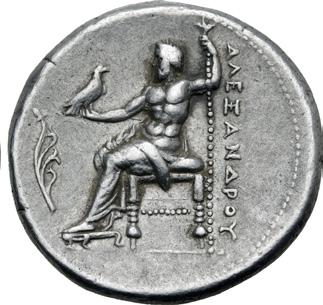
161.
861; Müller 281. 16.96g, 27mm,
Extremely Fine; an attractive, highly lustrous specimen.
Ex Roma Numismatics Ltd., E-Sale 104, 15 December 2022, lot 176 (hammer: GBP 1,200).

162.



Kingdom of Macedon, Antigonos I Monophthalmos AR Drachm. Struck as Strategos or king of Asia, in the name and types of Alexander III. Lampsakos, circa 310-301 BC. Head of Herakles to right, wearing lion skin headdress / Zeus Aëtophoros seated to left, holding sceptre; [A] ΛEΞANΔPOY to right, forepart of Pegasos to left in left field, monogram beneath throne. Price 1382; Müller 612; SNG Copenhagen 887; ADM II Series XVIII. 4.35g, 16mm, 9h.
Extremely Fine.
Ex Roma Numismatics Ltd., E-Sale 103, 24 November 2022, lot 338.

163.
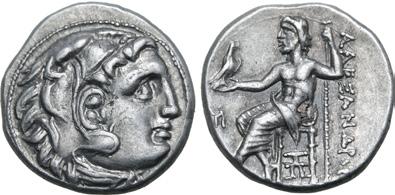

Kingdom of Macedon, Antigonos I Monophthalmos AR Drachm. Struck as Strategos or king of Asia, in the name and types of Alexander III. Abydos(?), circa 310-301 BC. Head of Herakles to right, wearing lion skin headdress / Zeus Aëtophoros seated to left, holding sceptre; AΛEΞANΔPOY to right, monogram in left field, monogram below throne. Price 1531; Müller 1621; SNG Copenhagen 996. 4.33g, 17mm, 2h.
Good Extremely Fine; flan flaw to rev.
Ex Roma Numismatics Ltd., E-Sale 103, 24 November 2022, lot 343.

164.


Kingdom of Macedon, Antigonos I Monophthalmos AR Drachm. Struck as Strategos or king of Asia, in the name and types of Alexander III. Abydos(?), circa 310-301 BC. Head of Herakles to right, wearing lion skin headdress / Zeus Aëtophoros seated to left, holding sceptre; AΛEΞANΔP[OY] to right, monogram in left field, ivy-leaf beneath throne. Price 1560; Müller 252; SNG Copenhagen
Extremely Fine.
Ex Roma Numismatics Ltd., E-Sale 103, 24 November 2022, lot 348.



Near Extremely Fine; beautiful old cabinet tone. Extremely Rare.
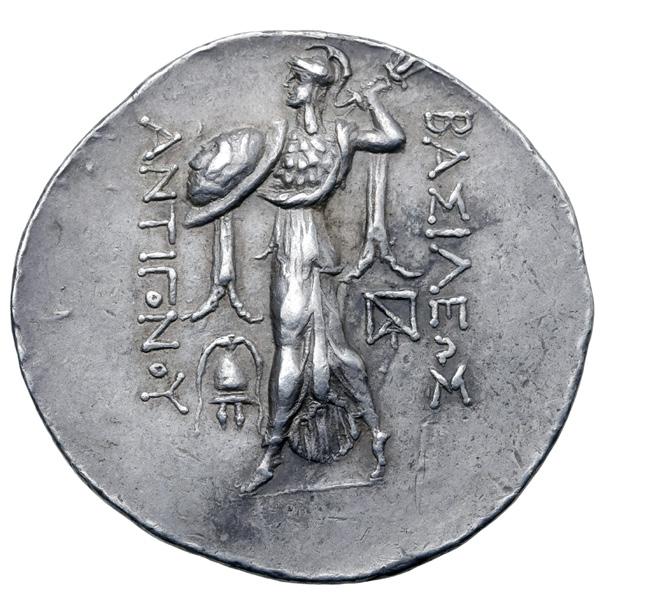
166.
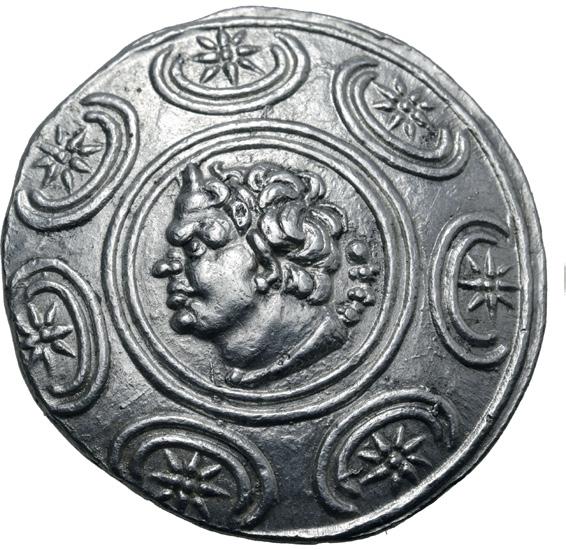

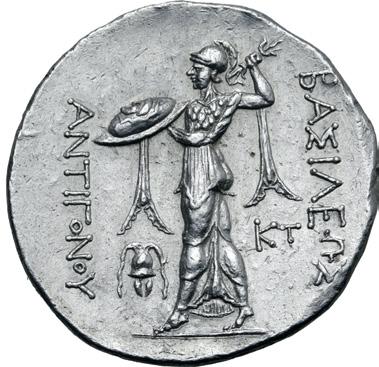

Kingdom of Macedon, Antigonos III Doson AR Tetradrachm. In the name and types of Antigonos II Gonatas. Amphipolis or Pella, circa 229-221/0
BC. Horned head of Pan to left, lagobolon over shoulder, on boss of Macedonian shield / Athena Alkidemos standing to left, wielding thunderbolt and shield; ΒΑΣΙΛΕΩΣ to right, ΑΝΤΙΓΟΝΟΥ to left, crested Macedonian helmet to inner left, KT to inner right. TEA Period IV, Group 4, 22 (O07/R21); HGC 3.1, 1042 (Antigonos II Gonatas). 17.07g, 31mm, 11h.
Extremely Fine; lightly brushed.
Acquired from Numisfitz GmbH.

167.
600 No
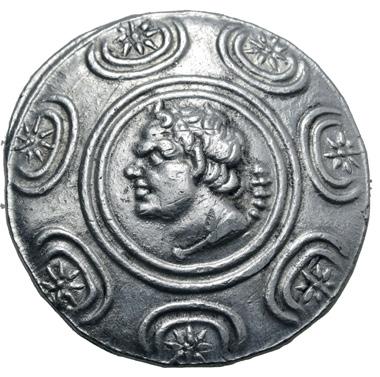


Kingdom of Macedon, Antigonos III Doson AR Tetradrachm. In the name and types of Antigonos II Gonatas. Amphipolis or Pella, circa 229-221/0
BC. Horned head of Pan to left, lagobolon over shoulder, on boss of Macedonian shield / Athena Alkidemos standing to left, wielding thunderbolt and shield; ΒΑΣΙΛΕΩΣ to right, ΑΝΤΙΓΟΝΟΥ to left, crested Macedonian helmet to inner left, TI to inner right. TEA Period IV, Group 7, 32 (O11/R30); HGC 3.1, 1042 (Antigonos II Gonatas). 17.11g, 32mm, 8h.
Extremely Fine; lightly brushed.
Acquired from Numisfitz GmbH.
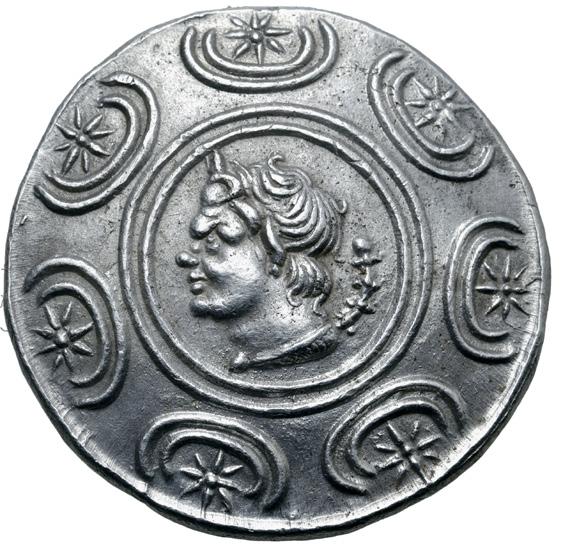
168.
600



Kingdom of Macedon, Antigonos III Doson AR Tetradrachm. In the name and types of Antigonos II Gonatas. Amphipolis or Pella, circa 229-221/0 BC. Horned head of Pan to left, lagobolon over shoulder, on boss of Macedonian shield / Athena Alkidemos standing to left, wielding thunderbolt and shield; ΒΑΣΙΛΕΩΣ to right, ΑΝΤΙΓΟΝΟΥ to left, crested Macedonian helmet to inner left, TI to inner right. TEA Period IV, - (O14/R- [unlisted rev. die]); HGC 3.1, 1042 (Antigonos II Gonatas). 17.10g, 30mm, 12h.
Good Extremely Fine; light contact mark on rev.
Acquired from Numisfitz GmbH.
600

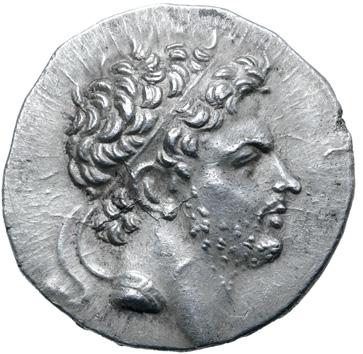
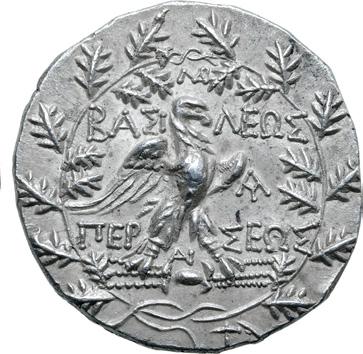

169.
Kingdom of Macedon, Perseus AR Tetradrachm. Amphipolis or Pella mint, circa 171-168 BC. Reduced standard. Au-, mintmaster. Diademed head to right / Eagle, with wings spread, standing to right on thunderbolt; BAΣIΛEΩΣ across upper fields, ΠEP-ΣEΩΣ across lower fields, NK monogram above, AY (mintmaster’s) monogram in right field, AI monogram between legs; all within oak wreath, plow to left below. F. De Luca, The Tetradrachms of Perseus of Macedonia 253 (O52/R224); Mamroth, Perseus, 25; SNG Alpha Bank 1132; HGC 3.1, 1094. 15.50g, 30mm, 12h.
Good Extremely Fine.
Ex Morton & Eden, Auction 119, 6 December 2022, lot 27 (hammer: GBP 3,500). Ex European Ambassador Collection, formed in the 1950s and 1960s.

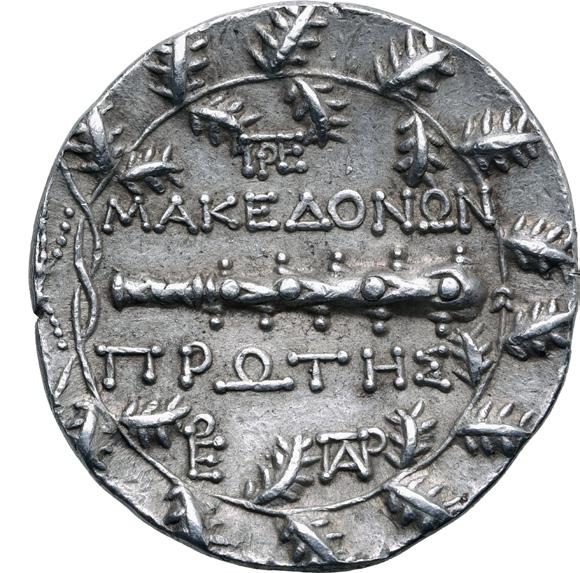

170.
Macedon under Roman rule, First Meris AR Tetradrachm. Amphipolis, circa 167-149 BC. Diademed and draped bust of Artemis to right; bow and quiver at shoulder; all within tondo of Macedonian shield / ΜΑΚΕΔΟΝΩΝ ΠΡΩΤΗΣ, horizontal club; monograms above and below, all within oak wreath tied at left; thunderbolt in outer left field. AMNG III/1, 172; SNG Copenhagen 1313 (same obv. die); SNG Ashmolean -. 16.95g, 32mm, 8h.
Near Extremely Fine; pleasant matte cabinet tone.
Ex Roma Numismatics Ltd., E-Sale 103, 24 November 2022, lot 374 (hammer: GBP 750); Reportedly acquired from Bertolami Fine Arts - ACR Auctions (old collector’s ticket included).

171.



Thraco-Macedonian, Uncertain mint in the lower Strymon valley EL 1/48 Stater. Late 6th century BC, under Athenian influence. Owl standing to left, head facing with prominent eyes / Rough incuse square. Unpublished in the standard references; for early Macedonian electrum issues, cf. Svoronos, HPM pp. 183-91 and pl. 16, 1-24. 0.29g, 5mm.
Extremely Fine. Unique and unpublished.
Ex Roma Numismatics Ltd., Auction XXV, 22 September 2022, lot 296 (hammer: GBP 1,700).
Coinage was introduced into the Thraco-Macedonian region, between the rivers Strymon and Nestos, in the last decades of the sixth century by the early Greek venturers and colonists. The richly wooded landscape could provide timber for shipbuilding as well as the equally attractive gold and silver of Mt. Pangeion, said to have been discovered first by the Phoenicians, then systematically mined by the local Thracian tribes. Athens in particular is well known to have enjoyed a significant income from mines of the Strymon area controlled by the tyrant Pisistratos, who after his exile in 556 BC, returned to Athens and subsequently oversaw the introduction of coinage with the unmistakable owl of Athena symbol from about 545 BC (cf. ACGC 165; HGC 4, 1603). The head facing owl became the standard reverse type of Athens from about 525 BC and during the height of the Delian League led by Athens became the most popular coin type in Asia Minor and the Persian-dominated Near East, universally as known as glaux (γλαύξ, little owl).
172.



Thraco-Macedonian Pangeion Region(?), uncertain mint AR Tritartemorion. Circa 450 BC. Monkey squatting to left / Round shield within incuse circle. Tzamalis 67; Demeester 41; NAC 82, 104 (hammer: CHF 475); Roma 2, 131. 0.25g, 5mm.
Near Extremely Fine; beautifully toned. Exceptionally Rare; undoubtedly among the very finest of the few left-facing monkey types to come to auction in the past two decades, and certainly on par with the right-facing specimen sold for USD 3,750 in 2012 (Gemini IX, 46).
Ex Roma Numismatics Ltd., E-Live Auction 5, 27 September 2022, lot 312.
This enigmatic series, showing a monkey squatting either right or left with a round shield on the reverse, is the only Greek coinage of the classical period to depict such an animal. It is known that monkeys were kept as house pets in antiquity, but its significance in this context is unknown.
173.
No lot.
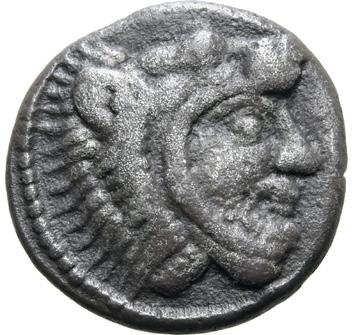



150
174.
Thrace, Dikaia AR Stater. Circa 490-475 BC. Head of Herakles to right, wearing lion skin headdress; dotted border around / Head of bull to left, Δ-Ι-Κ (retrograde) around; all within shallow incuse square. Schönert-Geiss 23/5; May, NC 1965, 30; Jameson 1055 (same dies). 7.27g, 20mm, 7h.
Very Fine; of excellent late archaic style. Very Rare.
Ex Roma Numismatics Ltd., E-Live Auction 5, 27 September 2022, lot 323;
Ex Roma Numismatics Ltd., Auction IV, 30 September 2012, lot 246;
Ex Dix Noonan Webb Ltd, Auctions A7 & CC2, 17 March 2009, lot 1135.
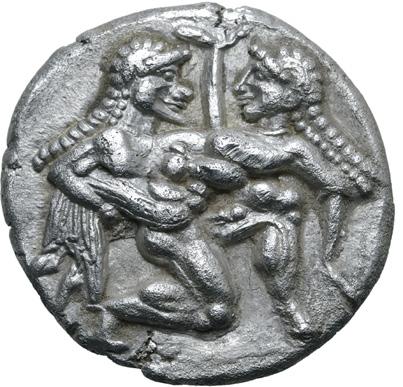


Islands off Thrace, Thasos AR Stater. Circa 520-510 BC. Naked and bearded ithyphallic satyr with goat’s ear and
Near Extremely Fine.
Ex Roma Numismatics Ltd., Auction VII, 22 March 2014, lot 480 (hammer: GBP 3,250).

600
600
Ritual abduction as a form of exogamy was frequent in tribal societies. The reference here is probably to the cult of Dionysos and is perhaps modelled on one of the stone reliefs for which it was famous for, as later with the Herakles archer type, Guide de Thasos, 2000, fig. 85. For a very similar archaic treatment of the same satyr abducting a maenad theme see J. Boardman, Greek Sculpture: The Archaic Period,
a sculpture from Delphi dated to about 525 BC.
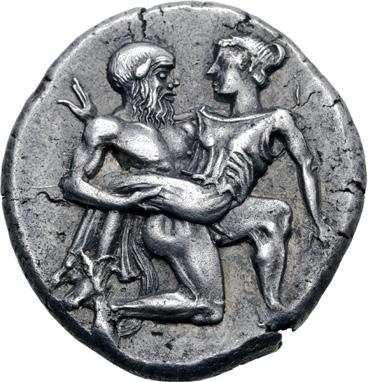

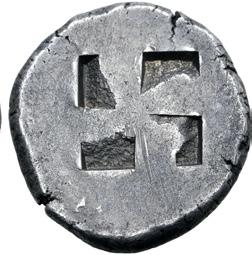

176.
Islands off Thrace, Thasos AR Stater. Circa 412-404 BC. Nude satyr in kneeling-running stance to right, carrying off protesting nymph; I in upper right field / Quadripartite incuse square. Le Rider, Thasiennes 6 var. (letter on obverse); HPM pl. X, 27-8 var. (same); HGC 6, 334 var. (same); NAC 134, 220 (same obv. die); CNG Triton XXII, 166 (same obv. die). 9.00g, 22mm.
Good Extremely Fine. Extremely Rare; one of the finest known examples.
Ex Roma Numismatics Ltd., Auction XXVII, 22 March 2023, lot 201 (hammer: GBP 6,000).
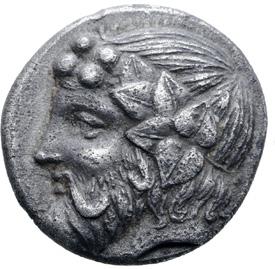
177.



Islands off Thrace, Thasos AR Drachm. Circa 404-355 BC. Head of Dionysos to left, wearing ivy wreath / Herakles kneeling to right, drawing bow; [ΘΑ]ΣΙΟN to left, head of Pan to lower right; all within linear border within incuse square. Le Rider, Thasiennes 24; West, period III, pl. 26c; BMC 45; HGC 6, 345. 3.77g, 15mm, 9h.
Extremely Fine.


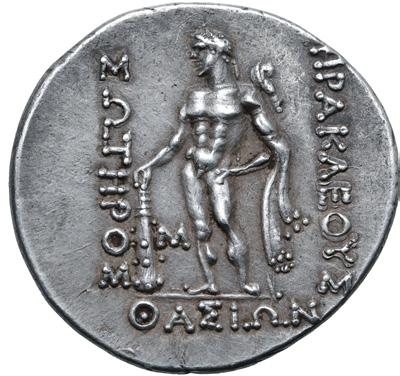

178.
Islands off Thrace, Thasos AR Tetradrachm. Circa 168/7-148 BC. Head of young Dionysos to right, wearing ivy wreath / HPAKΛEOYΣ ΣΩTHPOΣ, Herakles standing to left, holding club and lion skin; M to inner left, ΘAΣIΩN below. Le Rider, Thasiennes 51; SNG Copenhagen 1039; BMC 72; HGC 6, 359. 16.87g, 33mm, 12h.
Good Extremely Fine; dies of fine style, a highly attractive example.
Ex Leu Numismatik AG, Web Auction 20, 16 July 2022, lot 447 (hammer: CHF 2,000).

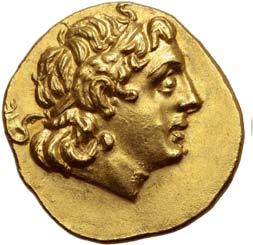

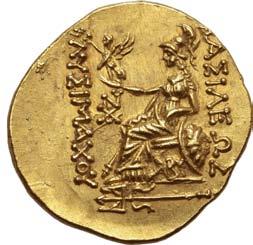
179.
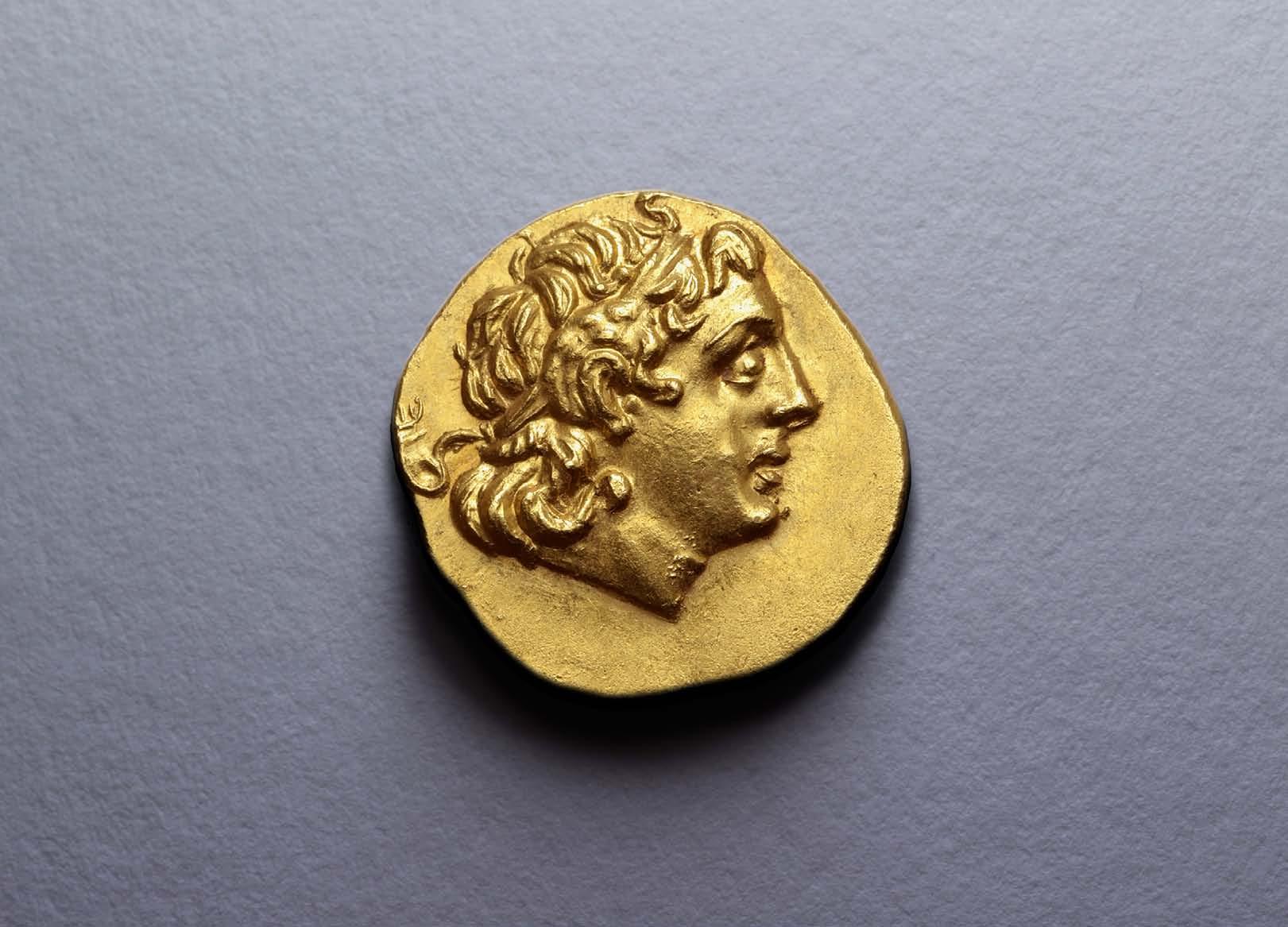
Kings of Thrace, Lysimachos AV Stater. Byzantion, 305-281 BC. Diademed head of the deified Alexander to right, with horn of Ammon / Athena Nikephoros seated to left, resting left arm on shield, transverse spear in background; ΒΑΣΙΛΕΩΣ to right, ΛΥΣΙΜΑΧΟΥ crowned by Nike to left, monogram in left field, BY below throne, trident in exergue. Price -; Müller -, cf. 231 (tetradrachm with this monogram); Marinescu Issue 135, 453 (O174/R432); A. Zograph, The Tooapse Hoard, NC 1925, illustration on p.29 (same dies); CNG Triton VI, 228 (same dies). 8.47g, 21mm, 12h. Mint State; a wonderful example. Extremely rare with this monogram.
4,800 No Reserve
Ex Nomos AG, Auction 25, 20 November 2022, lot 78 (hammer: CHF 11,000); Ex collection of a Nobleman (†1940) and “undoubtedly from the Tuapse (Tooapse) Hoard of 1908 (IGCH 1120)” - Nomos.
“One of the most remarkable of the ‘Successors’ of Alexander” in the words of D. Sear, Lysimachos became King of Thrace in 306 BC, following a period of personal service to Alexander as somatophylax (bodyguard) to the famous conqueror (Sear, Greek Coins and Their Values, Volume 2, 1978, p. 634). According to Justin, Lysimachos gained favour with Alexander, despite disobeying the Macedonian king in assisting condemned philosopher Kallisthenes, when he proved himself capable of killing a lion with his bare hands (Justin, Epitome of Pompey Trogue’s “Philippic histories”, 15.3). For such a feat, which was also narrated by Pausanias, Lysimachos was “exalted far above any nobility of birth by the proofs which he had given of personal merit” (Pausanias, Description of Greece, 1.9.5; Justin, Epitome of Pompey Trogue’s “Philippic histories”, 15.3). A lion head appears on the shield of Athena Nikephoros on this coin reverse and Lysimachos adopted the front part of a lion as a numismatic symbol above the monogram on many of his coins (e.g. silver drachm, Thompson 65), perhaps alluding to this story of his heroic strength and bravery.
Types like this beautifully detailed stater stand out among the coinages of the Diadochi due to the obverse portrait: the Thracian king continued to feature Alexander on his gold staters and silver tetradrachms even after the other Diadochi had ceased to depict Alexander. Lysimachos’ coinage represents Alexander as a distinguished and deified figure, his diadem and ram’s horns signifying his royal and divine status as king and son of Zeus Ammon. K. Dahmen identifies this notable numismatic design as an assertion of Lysimachos’ particular legitimacy as a successor to Alexander, elevating the living Lysimachos by association with the qualities of the late Macedonian conqueror (Dahmen, The Legend of Alexander the Great on Greek and Roman Coins, 2007, p.17). The reverse imagery attests to the Thracian king’s personal successes: the depiction of the war goddess Athena, with her Nike attribute crowning Lysimachos’ inscribed name, can be understood to refer to the king’s military achievements, specifically perhaps the Battle at Ipsos in 301 BC (O. Morkholm, Early Hellenistic Coinage from the Accession of Alexander to the Peace of Apamea, 1991, p.81).
180.
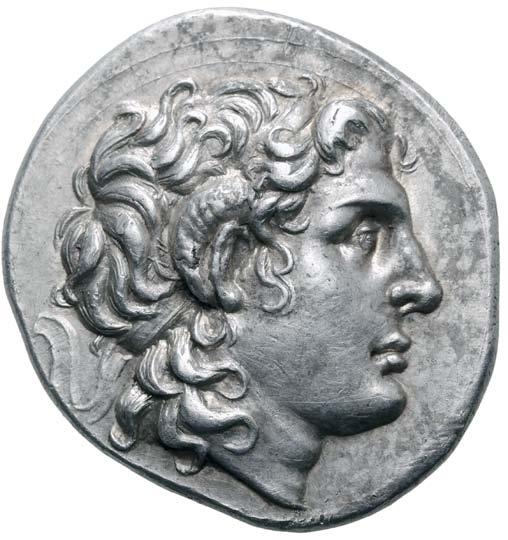
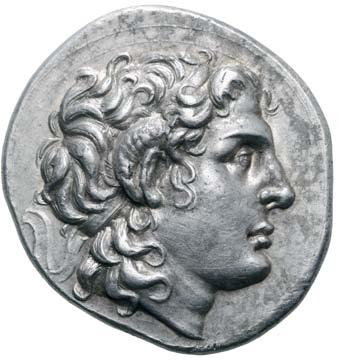


Good Extremely Fine; minor die breaks on rev., struck from dies of wonderful style. Exceedingly Rare; only one other example on CoinArchives, none in the ANS photofile.
2,250 No Reserve
Ex Classical Numismatic Group, Auction 117, 19 May 2021, lot 81 (hammer: USD 6,500).
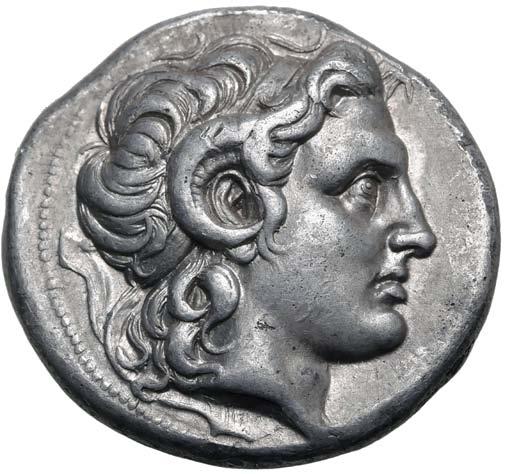

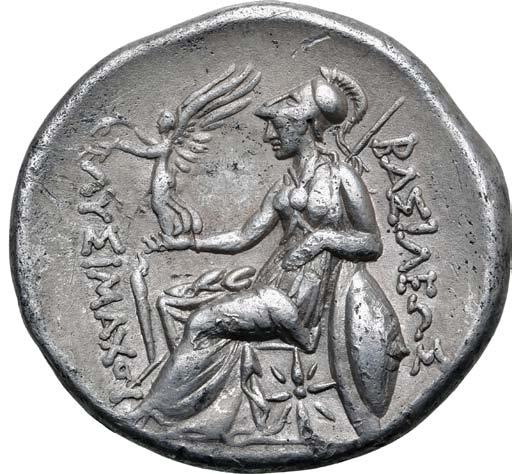
181.
Extremely Fine; attractive light cabinet tone.
Ex Roma Numismatics Ltd., E-Sale 105, 19 January 2023, lot 165 (hammer: GBP 1,600).
182. 750 No Reserve




Good Extremely Fine; a bold portrait in high relief.



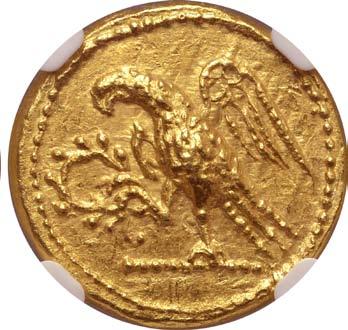
183.
Geto-Dacian dynasts, Koson AV Stater. Circa 44-42 BC. Roman consul (L. Junius Brutus?) walking to left, accompanied by two lictors; OΛB monogram before, KOΣΩN in exergue / Eagle with spread wings standing to left on sceptre, clutching laurel wreath in right talon. RPC I 1701A; Hourmouziadis dies A/a; BMC 2; HGC 3.2, 2049. 8.35g.
NGC graded MS 5/5 - 5/5 (#3813121-019).
Ex Heritage World Coin Auctions, CICF Signature Sale 3040, 9 April 2015, lot 29058.
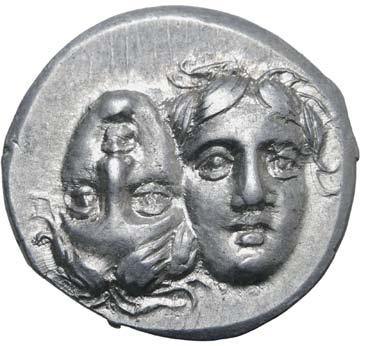
184.


Moesia, Istros AR Drachm. Circa 313-280 BC. Facing male heads, the left inverted / IΣTPIH, sea-eagle to left, grasping dolphin with talons; monogram in exergue. Dima Group IV, Subgroup IV; CNO type 7142; SNG BM Black Sea 247-8; AMNG I 417; HGC 3.2 1802. 5.66g, 20mm, 1h.
Good Extremely Fine; a lustrous, well-centred example.
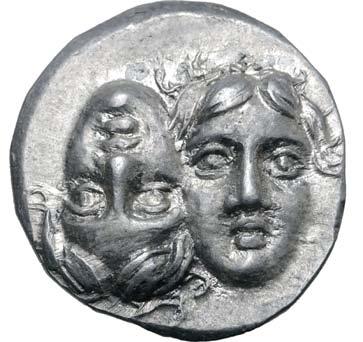
185.
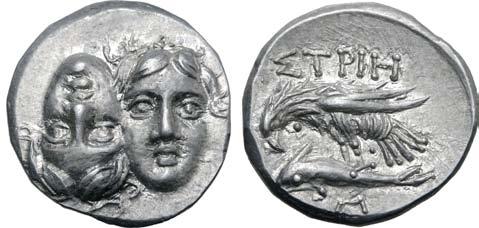

Moesia, Istros AR Drachm. Circa 313-280 BC. Facing male heads, the left inverted / IΣTPIH, sea-eagle to left, grasping dolphin with talons; two pellets
1802. 5.45g, 19mm, 11h.
Good Extremely Fine; a lustrous example.
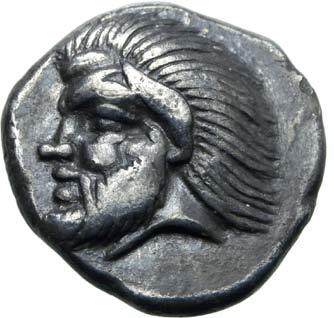
186.
Near Extremely Fine; attractive deep old cabinet tone. Very Rare.


Ex Classical Numismatic Group, Electronic Auction 376, 15 June 2016, lot 121.

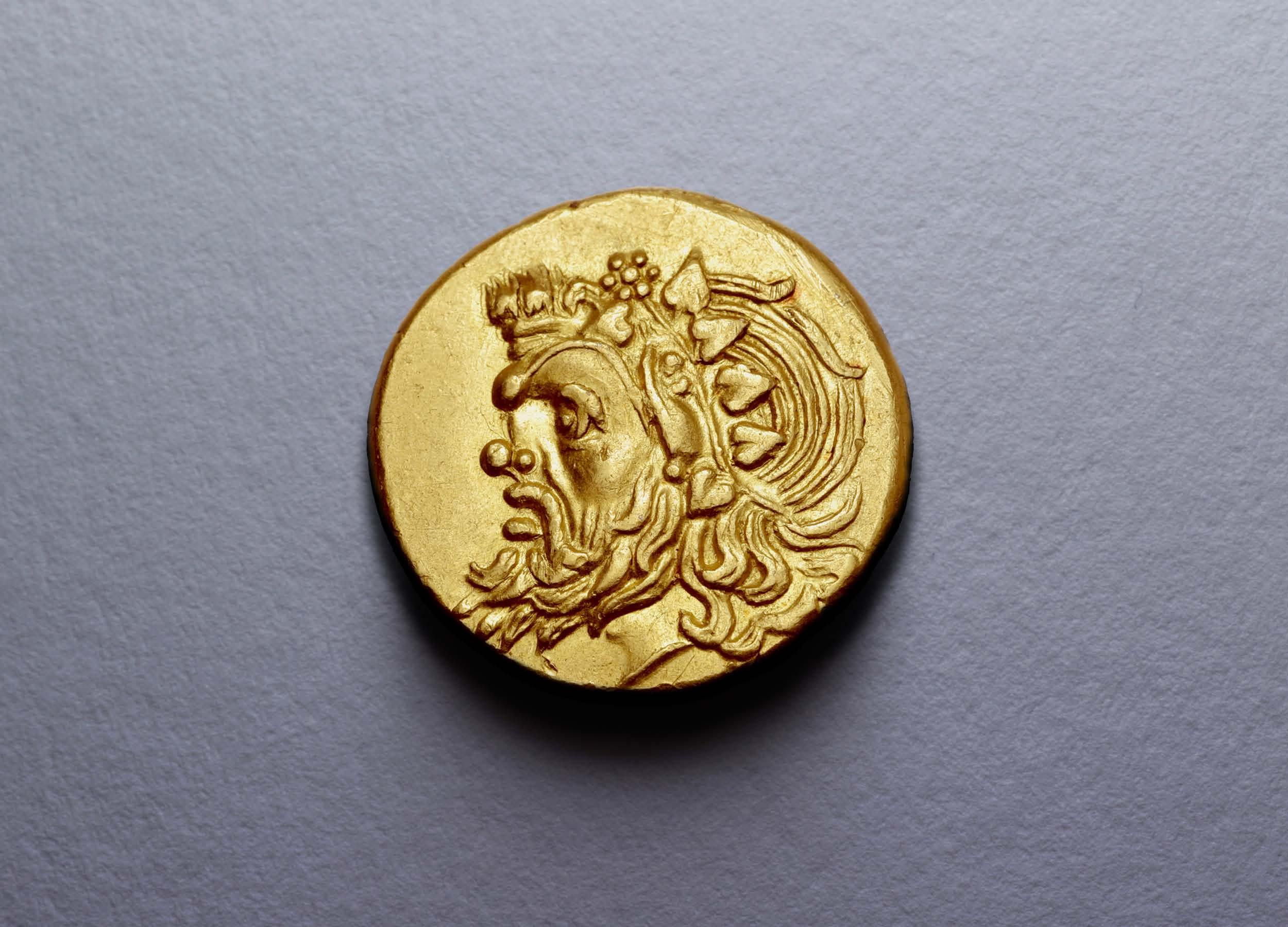

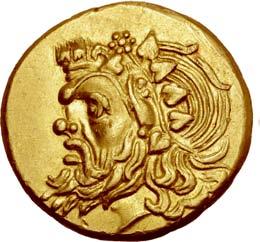
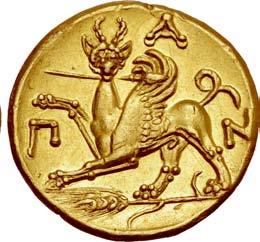
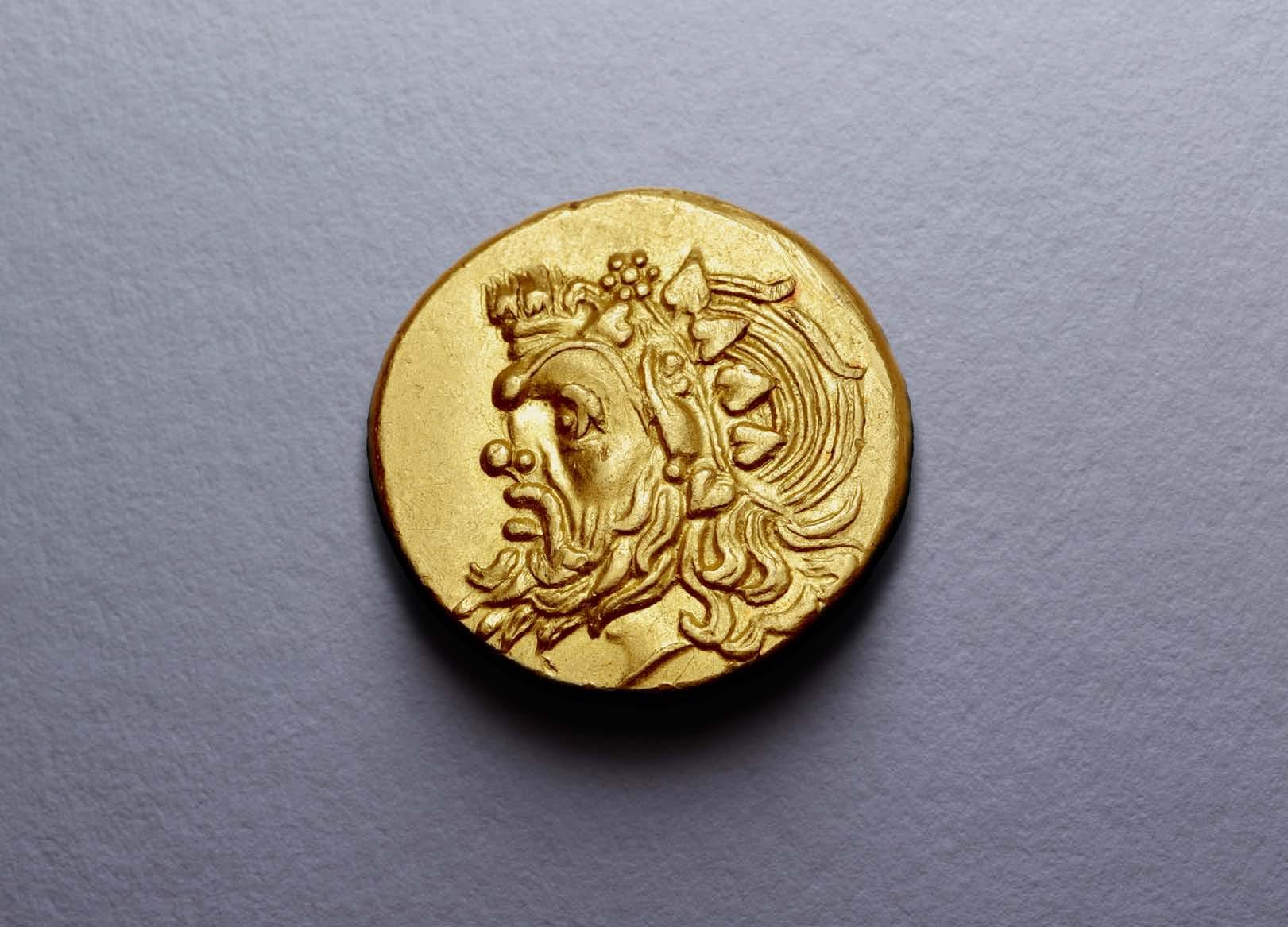
Kimmerian Bosporos, Pantikapaion AV Stater. Circa 325-310 BC. Bearded head of satyr to left, wearing ivy wreath / Π-Α-Ν around griffin standing to left, head facing, holding spear in its mouth, forepaw raised, on grain ear. SNG Stancomb 547 (this coin); MacDonald 63; SNG BM Black Sea 878 (same dies); Gulbenkian 590 (same obv. die); Hunt I, 95 (same obv. die); Kraay-Hirmer 440 (same obverse die); HGC 7, 24 (same dies). 8.58g, 21mm, 12h.
Extremely Fine; ex mount, lustrous metal.
21,000 No Reserve
This coin published in Sylloge Nummorum Graecorum, Great Britain, Volume XI, The William Stancomb Collection of Coins of the Black Sea Region (Oxford, 2000);
Ex Roma Numismatics Ltd., Auction XXIII, 24 March 2022, lot 207 (hammer: GBP 55,000);
Ex William Stancomb Collection; Roma Numismatics Ltd., Auction XVIII, 29 September 2019, lot 378;
Ex Sotheby’s (London), 5-6 October 1989, lot 11.
Pantikapaion, founded by Milesians in circa 575 BC, was a small hub of trade and crafts until it became the capital of the Kingdom of Bosporos in around 480 BC. The Bosporan Kingdom appears to have coalesced from a defensive league established to counter the threat of Skythian tribes to Greek cities in the area. Pantikapaion seems to have been the obvious choice for a capital due to its favourable geographical features: strategically located on a hill, it also commanded a harbour east of the city which could hold up to 30 ships, thus allowing the city to maintain a naval force. Pantikapaion became both powerful and wealthy under its first dynastic rulers the Archaianaktidai. Dubbed tyrants by Diodorus (Diodorus Siculus, The Library of History, 12.31.1) probably because of their aggressive policy of expansion, the Greek Geographer Strabo disputed this view and described them instead as ‘equitable’ (Strabo, Geographica , 7.4.4). The Archaianaktid dynasty was in 438 BC usurped by a Hellenised family of Thracians, the Spartokids, and by the time this issue was struck in c. 325-310 King Pairisades I (344-310) ruled over a Bosporan Kingdom that had grown from a local hegemony to a large Hellenistic kingdom, extending from the Tauroi to the Caucasus. Pairisades continued to expand Bosporan influence, eventually expanding the kingdom more than even his father had in the Bosporan Expansion Wars; he became king of the Sindoi through strategic marriage to his cousin Komosarye, annexed the city Tanais, and subdued many tribes around the Maeotic Swamp.
Pantikapaion was the only city in the Bosporan Kingdom to strike its own coinage until c. 450-425 BC, after which time mints can be found in other cities including Gorgippa and Phanagoria. Pantikapaion’s coinage was initially primarily silver in the fifth century, but as the city’s wealth and power grew, so did its coinage and golden staters such as the present example became a widely recognised product of the mint. The obverse figure, here described as a satyr, is identified by Sear (Greek Coins and their values,1978) as the god Pan, the connection being drawn no doubt from the city’s name, although it should be noted that the etymology of Pantikapaion is from a proto-Skythian language meaning ‘fish-path’ and makes no reference to the god.
The griffin on the reverse of this coin is notable as it bears the head of a horned lion rather than the typical eagle head. The reason for this seems little discussed in literature and rarely is the distinction even noted. The prevalence of lions on the Pantikapaian coinage is presumably the reason; the facing head of a lion can be seen on much of the silver coinage of this mint and is assumed to be a symbol of Apollo, specifically the Milesian cult of Apollo at the Delphinion and at Didyma (Zograf, Antichnye Monety, Materialy i Issledovania po Arkheologii SSSR 16, 1951). The Milesian connection to the almost mask-like facing lion makes it likely that the die engravers for these distinctive staters syncretised the lion and griffin for their own purpose of developing a unique type that celebrated the city of Pantikapaion and the primary source of its wealth – the grain upon which the griffin stands.
188.



Kimmerian Bosporos, Pantikapaion Æ 20mm. Circa 310-304/3 BC. Head of bearded Satyr to right / Π-Α-Ν around forepart of griffin to left; sturgeon to left below. MacDonald 69; SNG BM Black Sea 869-71; SNG Stancomb 541-2; HGC 7, 113. 6.52g, 20mm, 12h.
Good Extremely Fine; attractive glossy chestnut patina.
Ex Leu Numismatik AG, Web Auction 23, 22 August 2022, lot 3262 (hammer: CHF 600); Ex Pontos Euxeinos Collection, formed in the late 1990s and early 2000s.

189.
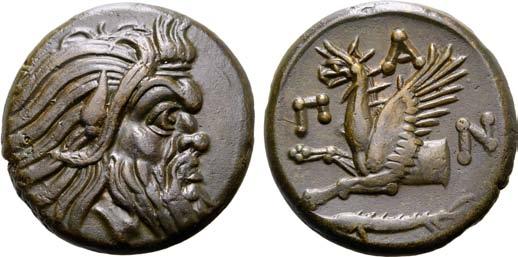

Kimmerian Bosporos, Pantikapaion Æ 21mm. Circa 310-304/3 BC. Head of bearded Satyr to right / Π-Α-Ν around forepart of griffin to left; sturgeon to left below. MacDonald 69; SNG BM Black Sea 869-71; SNG Stancomb 541-2; HGC 7, 113. 8.23g, 21mm, 12h.
Extremely Fine.
Ex Leu Numismatik AG, Web Auction 23, 22 August 2022, lot 3260 (hammer: CHF 400).

190.

Kimmerian Bosporos, Pantikapaion Æ 21mm. Circa 310-304/3 BC. Head of bearded Satyr to right /
Good Extremely Fine.
Ex Roma Numismatics Ltd., E-Sale 103, 24 November 2022, lot 470 (hammer: GBP 360).

191.
Good Extremely Fine.
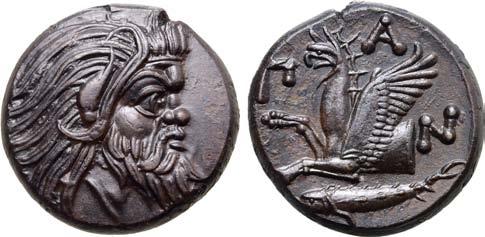
Ex Roma Numismatics Ltd., E-Sale 103, 24 November 2022, lot 471 (hammer: GBP 340).

192.
Very Fine;
Ex
Very Rare.







193.
Kings of Armenia, Tigranes II ‘the Great’ AR Tetradrachm. Tigranokerta, circa 80-68 BC. Diademed and draped bust to right, wearing Armenian tiara with five peaks and emblazoned with star between two eagles; bead and reel border around / Tyche of Artaxata seated to right on rock pile, holding palm branch, river god Araxes swimming to right below; BAΣIΛEΩΣ to right, TIΓPANOY to left, monograms to inner right and on rock; all within wreath. Kovacs 71.2 (same obv. die); SCADA Group 3; CAA 20; ACV 34. 15.89g, 26mm, 2h.
Good Extremely Fine; beautiful old cabinet tone, with excellent surface conditions.
Ex Leu Numismatik AG, Auction 11, 14 May 2022, lot 153 (hammer: CHF 5,500);
Ex J.T.B. Collection, Roma Numismatics Ltd., Auction XI, 7 April 2016, lot 472 (hammer: GBP 3,600);
Ex Gorny & Mosch Giessener Münzhandlung, Auction 200, 10 March 2011, lot 2017 (hammer: EUR 2,800).

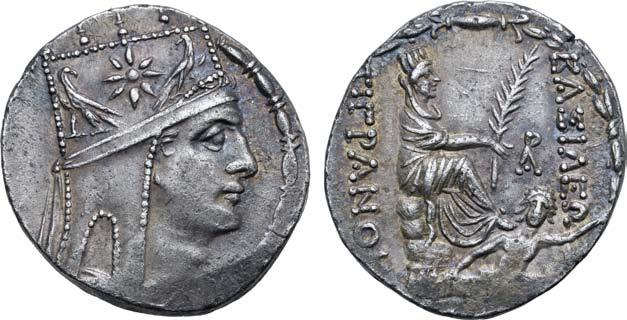
194.
1,500

Kings of Armenia, Tigranes II ‘the Great’ AR Tetradrachm. Tigranokerta, circa 80-68 BC. Diademed and draped bust to right, wearing Armenian tiara with five peaks and emblazoned with star between two eagles; bead and reel border around / Tyche of Artaxata seated to right on rock pile, holding palm branch, river god Araxes swimming to right below; BAΣIΛEΩΣ to right, TIΓPANOY to left, AP monogram to inner right, ΔΗ monogram on rock; all within wreath. Kovacs 74.1; SCADA Group 1; CAA 17. 15.81g, 27mm, 12h.
Good Extremely Fine; attractive iridescence around devices with underlying lustre, excellent metal quality for the issue.
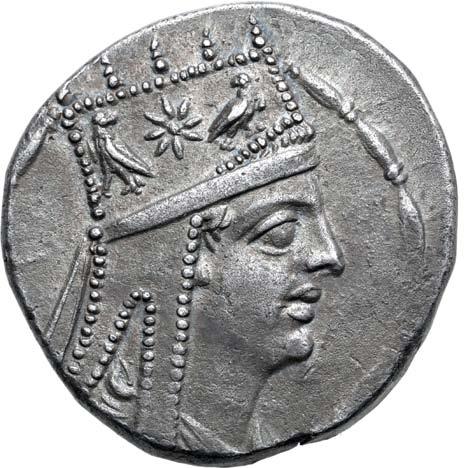


195.
Kings of Armenia, Tigranes II ‘the Great’ AR Tetradrachm. Tigranokerta, circa 80-68 BC. Diademed and draped bust to right, wearing Armenian tiara with five peaks and emblazoned with star between two eagles; bead and reel border around / Tyche of Artaxata seated to right on rock pile, holding palm branch, river god Araxes swimming to right below; BAΣIΛEΩΣ
Good Extremely Fine.
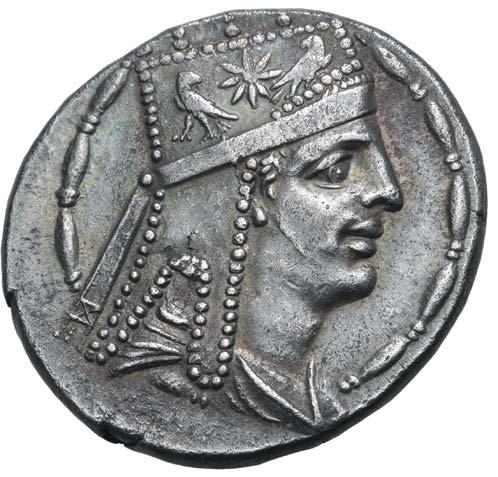


196.
Good
197.
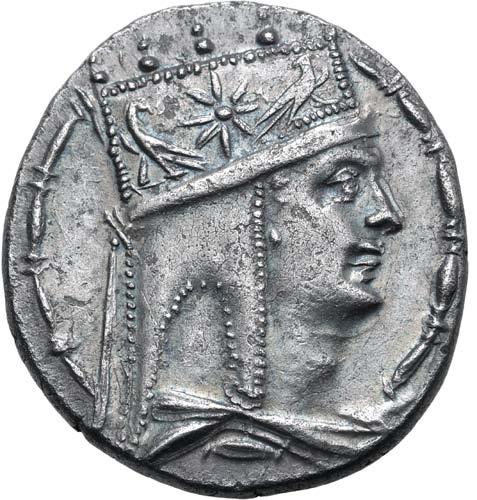


Kings of Armenia, Tigranes II ‘the Great’ AR Tetradrachm. Tigranokerta, circa 80-68 BC. Diademed and draped bust to right, wearing Armenian tiara with five peaks and emblazoned with star between two eagles; bead and reel border around / Tyche of Artaxata seated to right on rock pile, holding palm branch, river god Araxes swimming to right below; BAΣIΛEΩΣ to right, TIΓPANOY to left, AP monogram to inner right, ΔΗ monogram on rock; all within wreath. Kovacs 74.1; SCADA Group 1; CAA 17. 15.85g, 28mm, 12h.
Good Extremely Fine.

198.
180

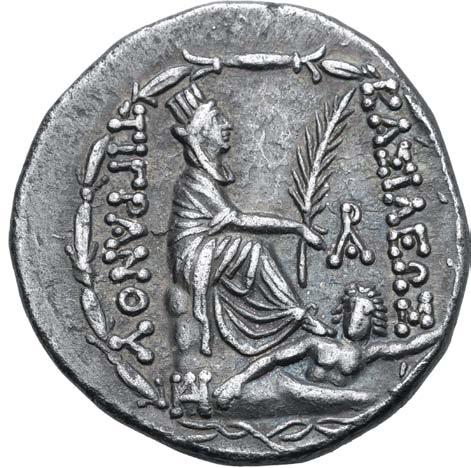
Kings of Armenia, Tigranes II ‘the Great’ AR Tetradrachm. Tigranokerta, circa 80-68 BC. Diademed and draped bust to right, wearing Armenian tiara with five peaks and emblazoned with star between two eagles; bead and reel border around / Tyche of Artaxata seated to right on rock pile, holding palm branch, river god Araxes swimming to right below; BAΣIΛEΩΣ to right, TIΓPANOY to left, AP monogram to inner right, ΔΗ monogram on rock; all within wreath. Kovacs 74.1; SCADA Group 1; CAA 17. 15.55g, 26mm, 12h.
Extremely Fine.

199.
180


Kings of Armenia, Tigranes II ‘the Great’ AR Tetradrachm. Tigranokerta, circa 80-68 BC. Diademed and draped bust to right, wearing Armenian tiara with five peaks and emblazoned with star between two eagles; bead and reel border around / Tyche of Artaxata seated to right on rock pile, holding palm branch, river god Araxes swimming to right below; BAΣIΛEΩΣ to right,
Good Extremely Fine.

200.
Good Extremely Fine.

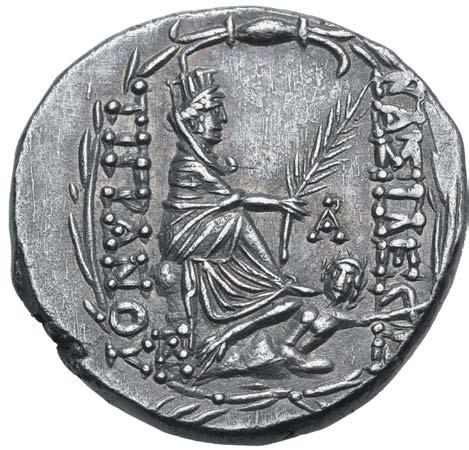
180
201.
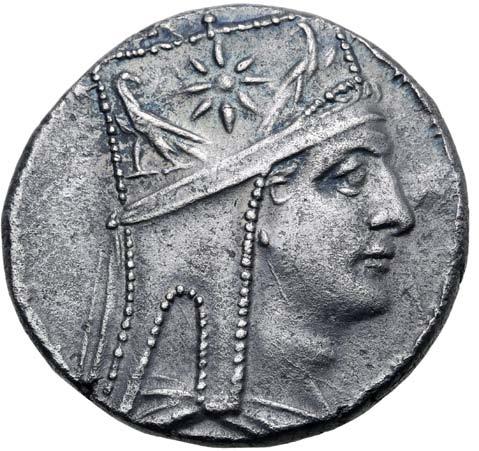


Kings of Armenia, Tigranes II ‘the Great’ AR Tetradrachm. Tigranokerta, circa 80-68 BC. Diademed and draped bust to right, wearing Armenian tiara with five peaks and emblazoned with star between two eagles; bead and reel border around / Tyche of Artaxata seated to right on rock pile, holding palm branch, river god Araxes swimming to right below; BAΣIΛEΩΣ to right, TIΓPANOY to left, AP monogram to inner right, ΔΗ monogram on rock; all within wreath. Kovacs 74.1; SCADA Group 1; CAA 17. 16.00g, 26mm, 12h.
Good Extremely Fine.
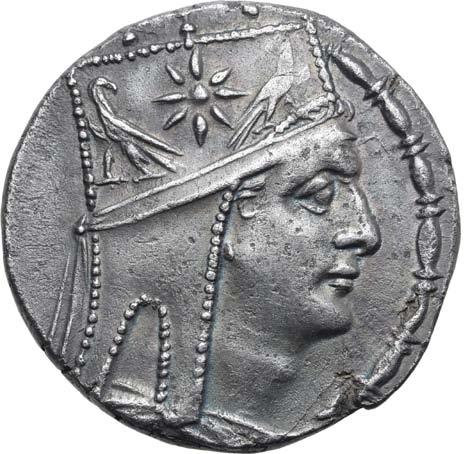
202.
180


Kings of Armenia, Tigranes II ‘the Great’ AR Tetradrachm. Tigranokerta, circa 80-68 BC. Diademed and draped bust to right, wearing Armenian tiara with five peaks and emblazoned with star between two eagles; bead and reel border around / Tyche of Artaxata seated to right on rock pile, holding palm branch, river god Araxes swimming to right below; BAΣIΛEΩΣ to right, TIΓPANOY to left, AP monogram to inner right, ΔΗ monogram on rock; all within wreath. Kovacs 74.1; SCADA Group 1; CAA 17. 16.11g, 26mm, 1h.
Extremely Fine.
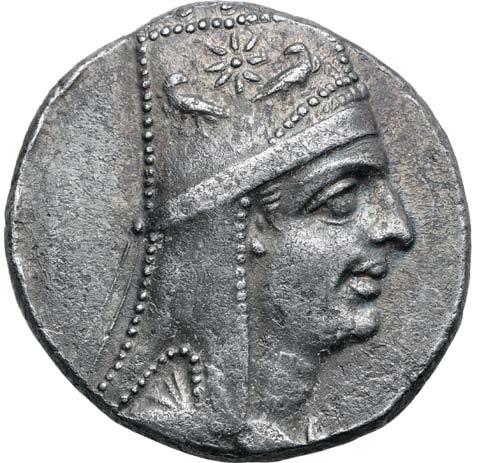
203.
180
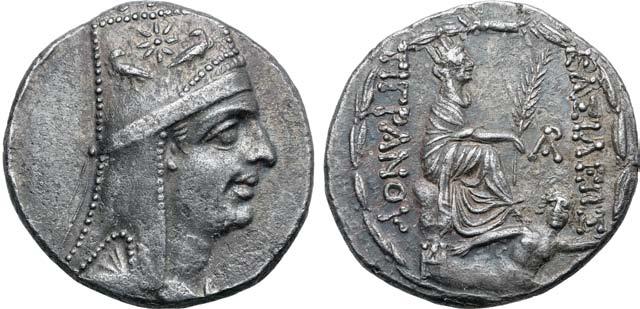
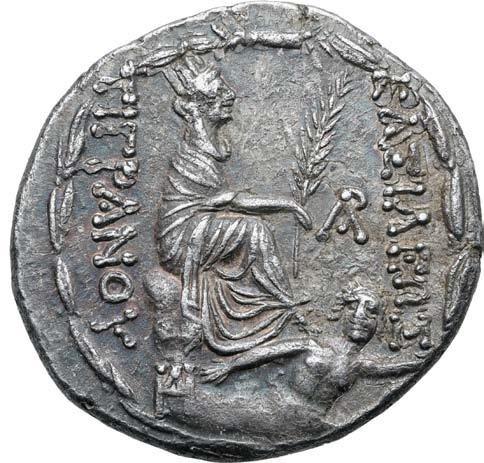
Kings of Armenia, Tigranes II ‘the Great’ AR Tetradrachm. Tigranokerta, circa 80-68 BC. Diademed and draped bust to right, wearing Armenian tiara with five peaks and emblazoned with star between two eagles; bead and reel border around / Tyche of Artaxata seated to right on rock pile, holding palm branch, river god Araxes swimming to right below; BAΣIΛEΩΣ to right,
Extremely Fine.

204.
Extremely Fine.

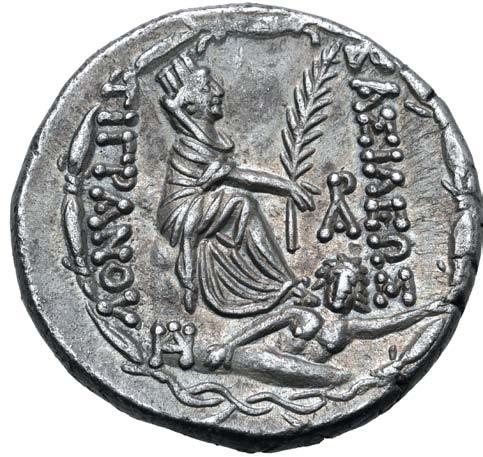
180
180
205.

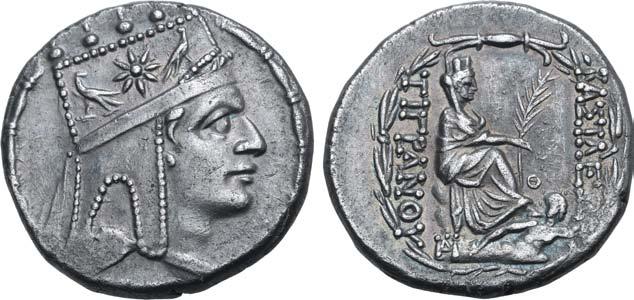
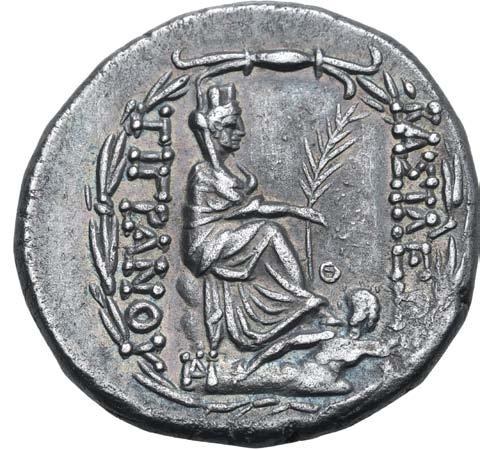
Kings of Armenia, Tigranes II ‘the Great’ AR Tetradrachm. Tigranokerta, circa 80-68 BC. Diademed and draped bust to right, wearing Armenian tiara with five peaks and emblazoned with star between two eagles; bead and reel border around / Tyche of Artaxata seated to right on rock pile, holding palm branch, river god Araxes swimming to right below; BAΣIΛEΩΣ to right, TIΓPANOY to left, Θ to inner right, ΔH monogram to lower left, all within wreath. Kovacs 74.2; SCADA Group 1; CAA 19; ACV 31. 15.84g, 26mm, 12h.
Extremely Fine.

206.
180
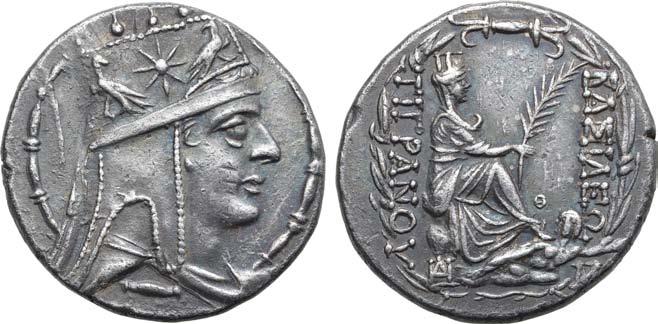
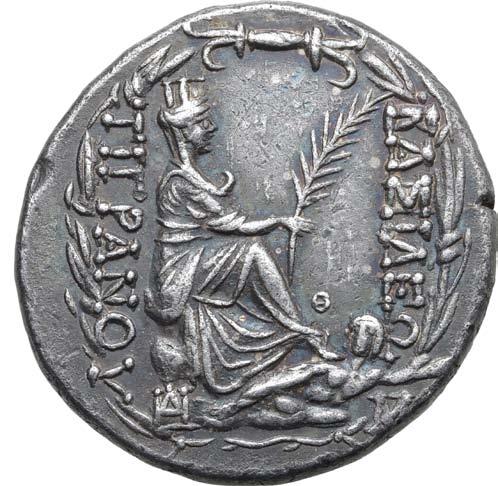
Kings of Armenia, Tigranes II ‘the Great’ AR Tetradrachm. Tigranokerta, circa 80-68 BC. Diademed and draped bust to right, wearing Armenian tiara with five peaks and emblazoned with star between two eagles; bead and reel border around / Tyche of Artaxata seated to right on rock pile, holding palm branch, river god Araxes swimming to right below; BAΣIΛEΩΣ to right, TIΓPANOY to left, Θ to inner right, ΔH monogram to lower left, all within wreath. Kovacs 74.2; SCADA Group 1; CAA 19; ACV 31. 15.50g, 27mm, 12h.
Extremely Fine.
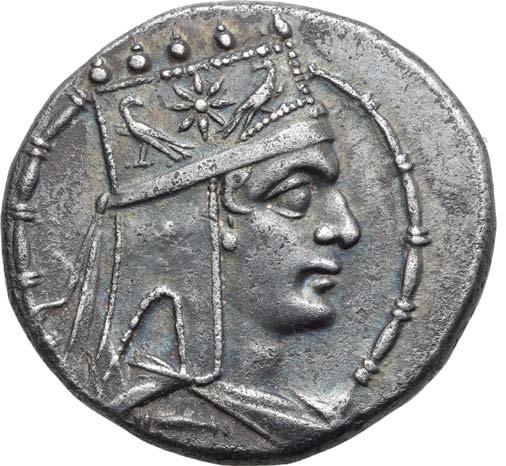
207.
180

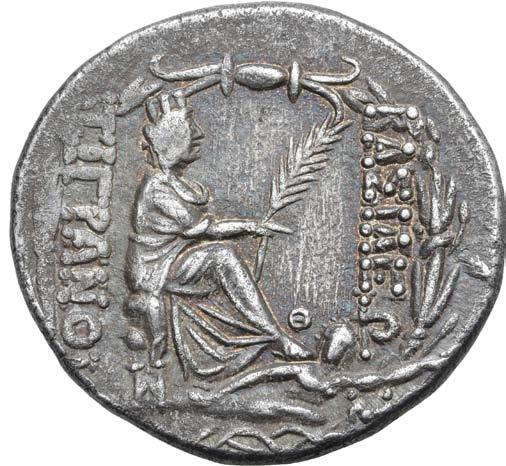
Kings of Armenia, Tigranes II ‘the Great’ AR Tetradrachm. Tigranokerta, circa 80-68 BC. Diademed and draped bust to right, wearing Armenian tiara with five peaks and emblazoned with star between two eagles; bead and reel border around / Tyche of Artaxata seated to right on rock pile, holding palm branch, river god Araxes swimming to right below; BAΣIΛEΩΣ
Near Extremely Fine.

208.
Extremely
180


180
209.



Kings of Armenia, Tigranes II ‘the Great’ AR Tetradrachm. Tigranokerta, circa 80-68 BC. Diademed and draped bust to right, wearing Armenian tiara with five peaks and emblazoned with star between two eagles; bead and reel border around / Tyche of Artaxata seated to right on rock pile, holding palm branch, river god Araxes swimming to right below; BAΣIΛEΩΣ to right, TIΓPANOY to left, Θ to inner right, ΔH monogram to lower left, all within wreath. Kovacs 74.2; SCADA Group 1; CAA 19; ACV 31. 15.82g, 27mm, 12h.
Extremely Fine.

210.
180
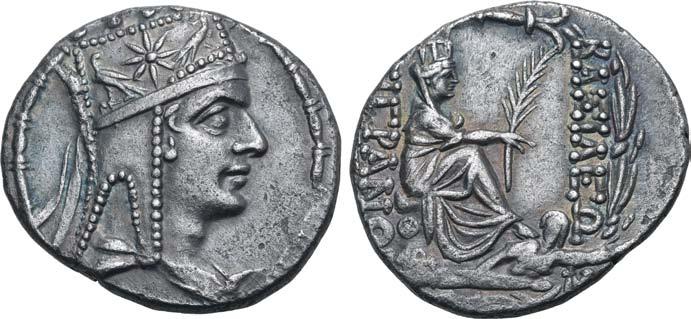
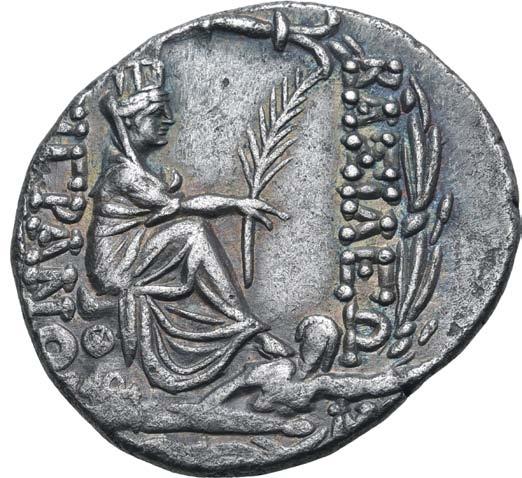
Kings of Armenia, Tigranes II ‘the Great’ AR Tetradrachm. Tigranokerta, circa 80-68 BC. Diademed and draped bust to right, wearing Armenian tiara with five peaks and emblazoned with star between two eagles; bead and reel border around / Tyche of Artaxata seated to right on rock pile, holding palm branch, river god Araxes swimming to right below; BAΣIΛEΩΣ to right, TIΓPANOY to left, two monograms on rock; all within wreath. Kovacs 75.1; SCADA Group 8; CAA 21; ACV 33. 15.92g,
Extremely Fine.
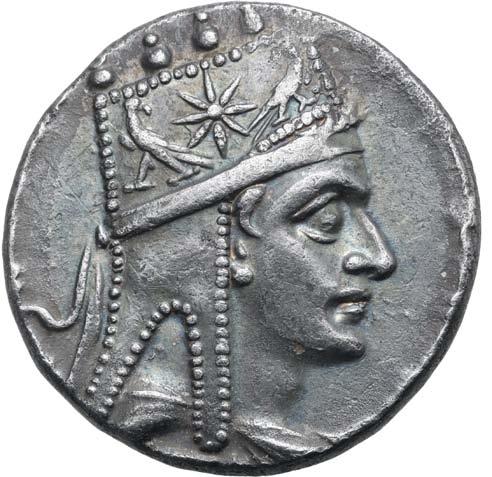
211.
of Armenia,
Extremely Fine.

212.
Good
180
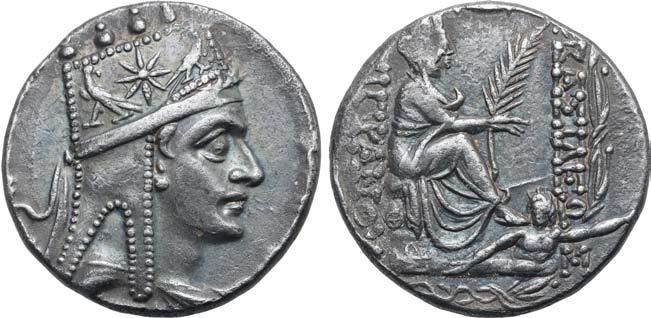

180
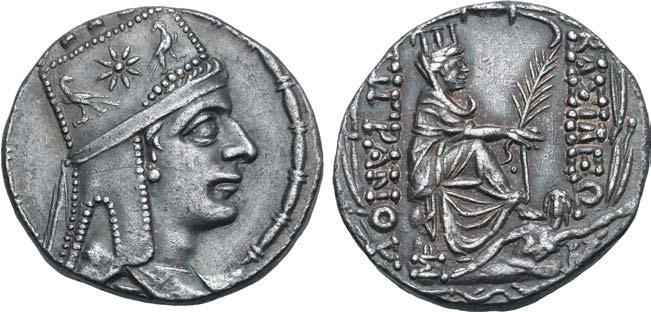
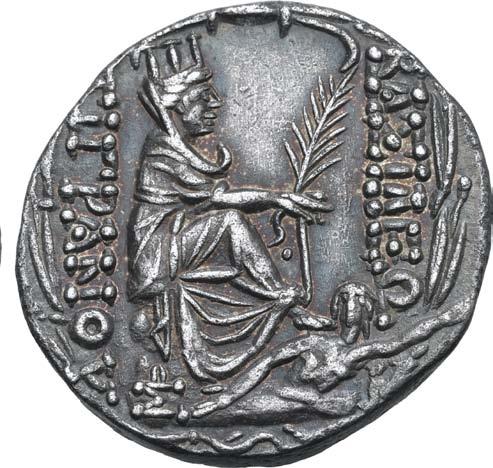
180
213.


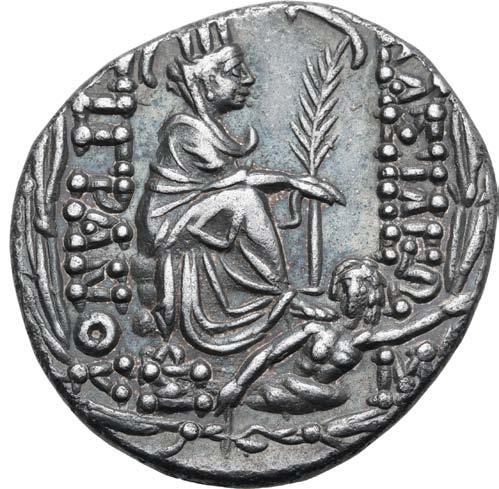
Kings of Armenia, Tigranes II ‘the Great’ AR Tetradrachm. Tigranokerta, circa 80-68 BC. Diademed and draped bust to right, wearing Armenian tiara with five peaks and emblazoned with star between two eagles; bead and reel border around / Tyche of Artaxata seated to right on rock pile, holding palm branch, river god Araxes swimming to right below; BAΣIΛEΩΣ to right, TIΓPANOY to left, monogram on rock; all within wreath. Kovacs 75.2; SCADA Group 7; CAA 31-2. 15.83g, 28mm, 12h.
Extremely Fine.

214.
180


Kings of Armenia, Tigranes II ‘the Great’ AR Tetradrachm. Tigranokerta, circa 80-68 BC. Diademed and draped bust to right, wearing Armenian tiara with five peaks and emblazoned with star between two eagles; bead and reel border around / Tyche of Artaxata seated to right on rock pile, holding palm branch, river god Araxes swimming to right below; BAΣIΛEΩΣ to right, TIΓPANOY to left, monogram on rock; all within wreath. Kovacs 75.2; SCADA Group 7; CAA 31-2. 16.10g, 28mm, 12h.
Extremely Fine.

215.
Kings of Armenia, Tigranes II ‘the
and
Extremely Fine.

AR

216.
180

Tigranokerta,
80-68


217.



Kings of Armenia, Tigranes II ‘the Great’ AR Tetradrachm. Tigranokerta, circa 80-68 BC. Jewel-diademed and draped bust to right, wearing Armenian tiara with five peaks and emblazoned with star between two eagles; bead and reel border around / Tyche of Artaxata seated to right on rock pile, holding palm branch, river god Araxes swimming to right below; BAΣIΛEΩΣ to right, TIΓPANOY to left, monogram on rock; all within wreath. Kovacs 75.3 (same obv. die); SCADA Group 7; CAA 21; ACV 33. 15.79g, 27mm, 12h.
Extremely Fine.

218.
180

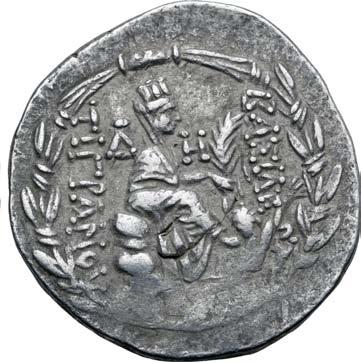
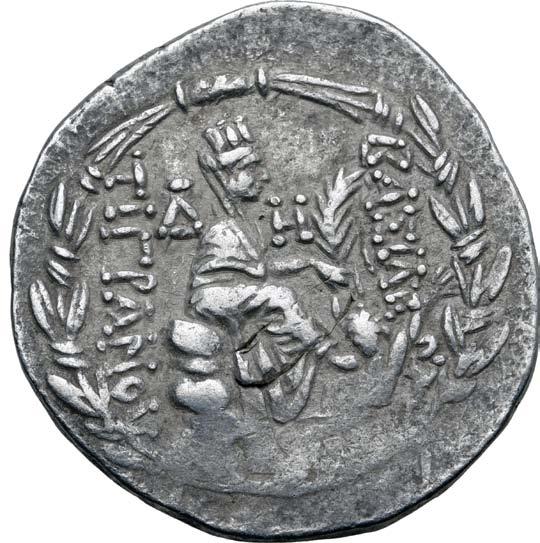
Kings of Armenia, Tigranes ‘the Younger’ AR Tetradrachm. Tigranokerta or Artagigarta(?), circa 66/5 BC. Diademed and draped bust to right, wearing Armenian tiara with five peaks and emblazoned with comet; bead and reel border around / Tyche of Artaxata seated to right on rock pile, holding palm branch, river god Araxes swimming to right below; BAΣIΛEΩΣ to right, TIΓPANOY to left, Δ-H across fields. Kovacs 153; SCADA Group 3 dies A1/P- (unlisted rev. die, Tigranes II); CNG 46, 663. 16.32g, 31mm, 12h.
Very Fine; minor flan flaw. Exceedingly Rare; seemingly the first example to be offered at auction since 1998.
1.500
Reserve: 12,000
Tigranes ‘the Younger’, son of Tigranes II, became co-ruler with his father in 77/6 BC when he was just 20 years old. Kovacs notes that this issue, naming a ‘King Tigranes’ and displaying a bust wearing an Armenian tiara decorated with a comet should in fact be viewed as coins of this Tigranes the Younger, struck alongside corresponding issues of Tigranes II during their joint rule. It marks a period of relative harmony in their otherwise unstable relationship, and indeed the numismatic evidence shows that the following year Tigranes the Younger was in Damascus and Shayegan (2011) suggests that it was here that he plotted with his father-in-law Phraates III to overthrow his father. This plot was abandoned when Armenia faced a threat from Roman forces and father and son united against their common enemy. Tigranes the Younger did however go on to betray his father to Pompey the Great in the hope that this would secure him sole rule of Armenia. This proved ultimately unsuccessful since he was only granted the rule of Sophene and even this was only for a brief time, as Pompey removed him after a few months due to suspicions over his Parthian connections.
Kovacs is the only scholar who attributes this coin to Tigranes the Younger rather than his father; other academics claim that no coins of this ruler were struck at all. In defending his attribution, Kovacs highlights the distinctive features of the son’s coinage as being characterised in particular by ‘younger portraits’, and a comet upon his tiara rather than the standard eagle-flanked star
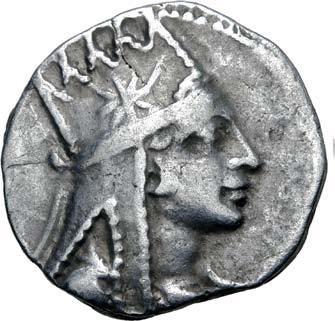
219.

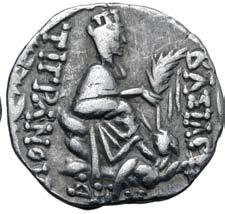
Near Very Fine. Exceedingly Rare; seemingly the first recorded example.

900
Reserve: 3,000
221.
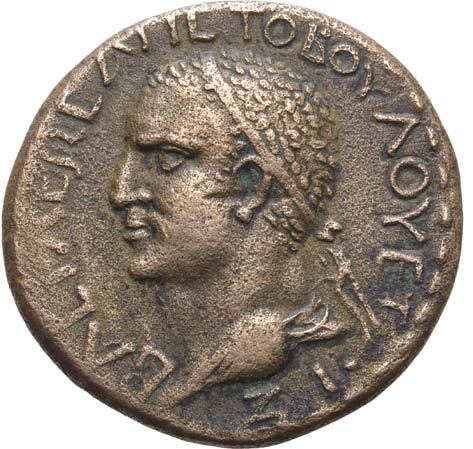
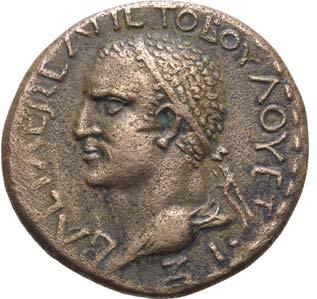

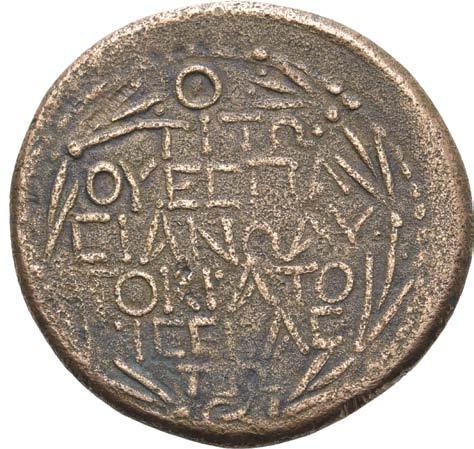
Kings of Armenia Minor, Aristoboulos Æ 26mm. Nikopolis-ad-Lycum, or Chalkis, dated year 17 = AD 70/1. BACIΛEΩC APICTOBOYΛOY ET IZ, diademed and draped bust to left; c/m: monogram within square incuse / TITΩ OΥECΠACIANΩ AYTOKPATΩP CEBACTΩ in six lines within wreath. Kovacs 301; Meshorer 367a; Hendin, GBC 6
Good Very Fine; attractive portrait. Very Rare.
1,200 No Reserve




222.
Kings of Pontos, Mithradates VI Eupator AR Tetradrachm. Dated Bithyno Pontic Era 206, month 3 = December 92/1 BC. Diademed head to right / Pegasos on ground line to left, preparing to lie down; BAΣΙΛEΩΣ above, MIΘPAΔATOY EYΠATOPOΣ in two lines below; star-in-crescent to left, CΣ (year) and monogram to right, Γ (month) below; all within Dionysiac wreath of ivy and fruit. De Callataÿ pl. IV (D33/R-); Waddington p. 15, 15; DCA 688; HGC 7, 338. 16.68g, 33mm, 12h.
Good Extremely Fine. Extremely Rare; no other examples of this date on CoinArchives.
Ex Roma Numismatics Ltd., Auction XXIII, 24 March 2022, lot 254.
1,800 No Reserve
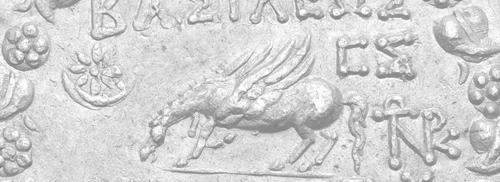
223.


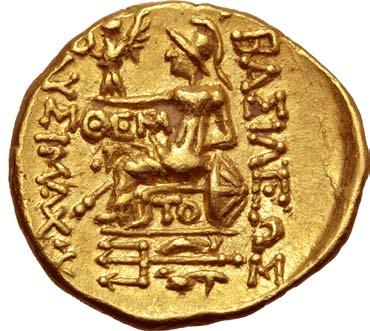
Kings of Pontos, Mithradates VI Eupator AV Stater. First Mithradatic War issue. Tomis, circa 88-86 BC. Struck in the name and types of Lysimachos of Thrace. Diademed head of the deified Alexander to right, with horn of Ammon / Athena Nikephoros seated to left, shield at her side; ΒΑΣΙΛΕΩΣ to right, ΛΥΣΙMΑXOY to left; ΘΕΜ to inner left, TO on throne, ornamented trident in exergue. Callataÿ p. 141 (D4/R1); AMNG I, 2480; SNG Copenhagen 1091 (same dies); HGC 3.2, 1931. 8.27g, 20mm, 12h.
Good Very Fine.
Ex Classical Numismatic Group, Electronic Auction 339, 19 November 2014, lot 111.
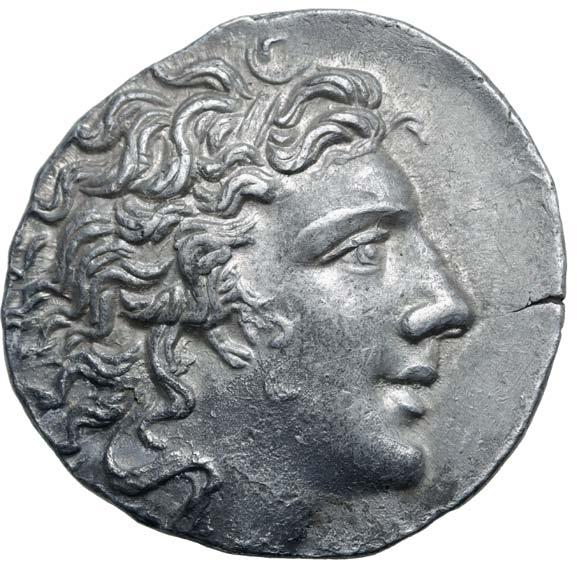
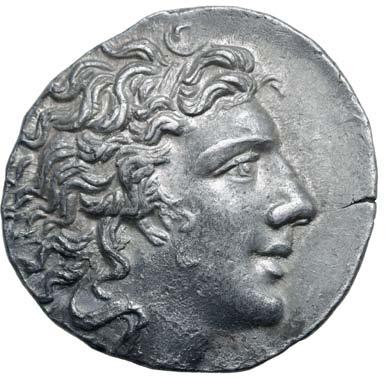
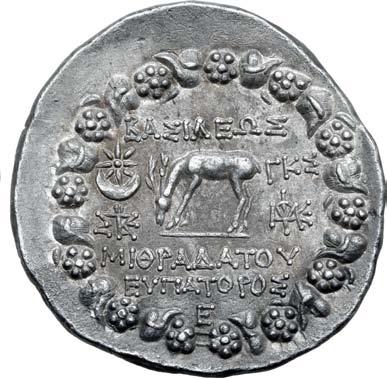

224.
Kings of Pontos, Mithradates VI Eupator AR Tetradrachm. Dated Bithyno Pontic Era 223, month 5 = February 74 BC. Diademed head to right / Stag grazing to left; BAΣIΛEΩΣ above, MIΘPAΔATOY EYΠATOPOΣ in two lines below; star-in-crescent above monogram to left, ΓKΣ (date) above monogram
Extremely Fine.
Ex Roma Numismatics Ltd., E-Sale 106, 16 February 2023, lot 241 (hammer: GBP 2,600).

225.
Extremely Fine. Rare.

From the David Freedman Collection; Ex Roma Numismatics Ltd., Auction XXIII, 24 March 2022, lot 261.

226.

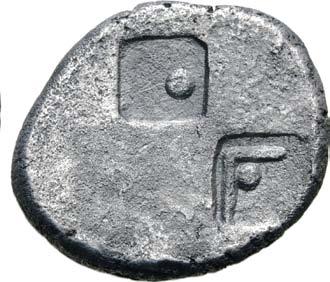

600 No Reserve 1,500 Reserve: 3,400 1,200 No Reserve
227.
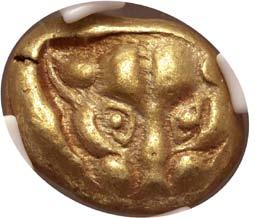
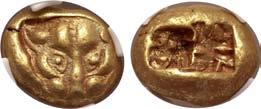
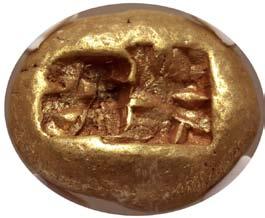
2x 2x
Ionia, uncertain mint EL Hekte. Circa 600-550 BC. Lydo-Milesian standard. Facing head of lion or panther within triangular incuse on a raised area / Two square punches with raised lines within. Weidauer 160 = Traité I 30 = Boston MFA 1753 = Warren 1721; SNG Kayhan 711. 2.35g.
NGC graded Ch XF 4/5 - 4/5, edge scuffs (#5872643-008). Rare.
Acquired from Vilmar Numismatics.
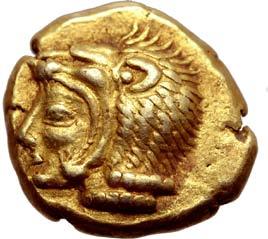
228.


Ionia, Erythrai EL Hekte. Circa 550-500 BC. Head of Herakles to left, wearing lion skin headdress / Rough quadripartite incuse square. SNG Kayhan 737-38; SNG Von Aulock 1942; Boston MFA 1806-7. 2.59g, 11mm.
Extremely Fine.
Ex Roma Numismatics Ltd., Auction XXIII, 24 March 2022, lot 272 (hammer: GBP 1,500).



229.
Troas, Abydos AR Tetradrachm. Circa 80-70 BC. Iphiados, magistrate. Draped bust of Artemis to right, wearing stephanos; bow and quiver over shoulder / Eagle, with wings spread, standing to right; ABYΔHNΩN above, IΦIAΔOY below, radiate head of Helios to right with star above in
Good Very Fine; beautiful old cabinet tone. Rare.

Good Very Fine. Extremely Rare.

231.



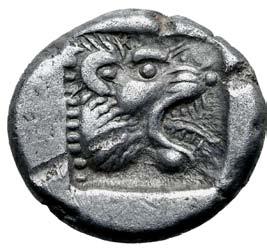

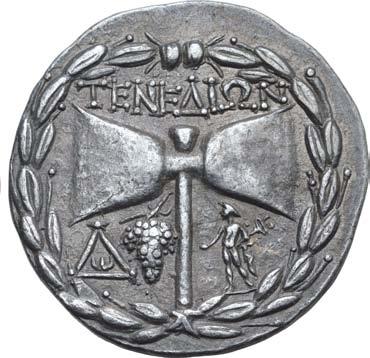

Islands off Troas, Tenedos AR Tetradrachm. Circa 160-70 BC. Janiform head of a laureate bearded male to left and female to right, wearing stephanos / Labrys; TENEΔIΩN above, handle flanked by monogram and grape bunch to left, small figure of Hermes with kerykeion to right; all within laurel wreath. Callataÿ, Tenedos -, cf. 49-55 (drachms) corr. (monogram); BMC -, cf. 33 (drachm); HGC 6, 390 var. (this control not listed). 16.13g, 31mm, 12h.
Extremely Fine; fine style, well centred with a beautiful even cabinet tone. Apparently unpublished with this control in this denomination.
Ex Roma Numismatics Ltd., Auction XXVII, 22 March 2023, lot 257 (hammer: GBP 16,000).
7,500
No Reserve
Tenedos was an island of strategic importance throughout antiquity due to its location at the entrance to the Hellespont, which ensured every ship sailing to or from the Propontis and the Black Sea would pass by. It is referenced in both Homer’s Iliad and Virgil’s Aeneid, in the latter as the place where the Greek fleet was concealed towards the end of their siege of Troy in order to trick the Trojans into taking the fateful Trojan horse within the walls of the city. During the fifth century, Athens used the island as a stronghold to protect their vital shipping routes, but it came under the influence of successive Hellenistic dynasties from the third century onwards: controlled first by the Seleukids, then the Attalids and eventually by Mithridates VI Eupator, who used the island as a naval base in the Third Mithridatic War against the Roman general Lucullus in 73-63 BC. It was during the latter’s long reign that this type and other stephanophoric (wreath-bearing) Tenedian tetradrachms were first minted.
The labrys on the reverse of this coin is a reference to the Tenedian foundational myth, in which the hero Tenes used an axe to sever the mooring lines of his father’s ship when he attempted to land on the island to reconcile with his son. In Pausanias’ version of the myth, he concludes “for this reason a by-word has arisen, which is used of those who make a stern refusal: so and so has cut whatever it may be with an axe of Tenedos” (Paus. 10.14.4). Indeed, Cicero, writing less than half a century from the time of this coin’s issue jokes to his brother Quintus about Tenedos’ unsuccessful request to the Roman senate to be made a free city: “well then, the liberty of the Tenedians has been chopped by the Tenedian axe” (Letters to his brother Quintus, 2.9).

233.
Extremely Fine; fine style, slight doubling on obv. Apparently unpublished with this control in this denomination.


7,500 No Reserve




234.
Good Very Fine. Extremely rare with this control symbol.
3,600 No Reserve
235.



Islands off Troas, Tenedos AR Tetradrachm. Circa 100-80 BC. Janiform head of a laureate bearded male to left and female to right, wearing stephanos / Labrys; TENEΔIΩN above, handle flanked by monogram and grape bunch to left, Athena Promachos to right; all within laurel wreath. Callataÿ, Tenedos 56-62 (D13); HGC 6, 390. 15.93g, 31m, 1h.
Good Very Fine. Rare.

2x

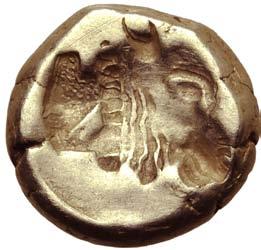
Lesbos, Mytilene EL Hekte. Circa 521-478 BC. Head of roaring lion to right / Incuse head of calf to right; rectangular punch behind. Bodenstedt 13; SNG Copenhagen 301; SNG von Aulock 1685-6; SNG Kayhan 100; Rosen 554; HGC 9, 638. 2.53g, 10mm, 4h.
Near Extremely Fine.

237.
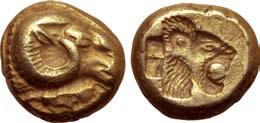

Lesbos, Mytilene EL Hekte. Circa 521-478 BC. Head of ram to right; cock standing to left below, pecking at ground / Incuse head of roaring lion to right; rectangular punch behind. Bodenstedt 16; SNG Copenhagen -; SNG Kayhan -; Rosen 556; HGC 9, 641. 2.50g, 10mm, 11h.
Near Extremely Fine.


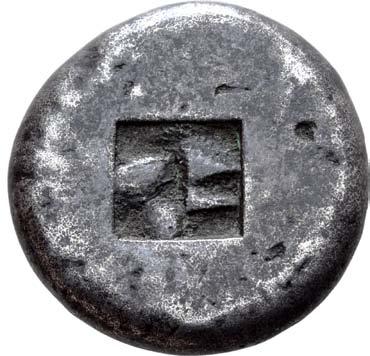
Lesbos, uncertain mint BI Stater. Circa 550-450 BC. Confronted calves’ heads; tree between / Rough incuse square. Lazzarini, Contribution, Series III; SNG von Aulock 1682; SNG Ashmolean 1488-91; BMC p. 154, 46-9; Dewing 2251; HGC 6, 1076. 11.24g, 20mm.
Acquired from Gorny & Mosch Giessener Münzhandlung; With dealer’s ticket from Münzkabinett Funk.

239.

2x 2x
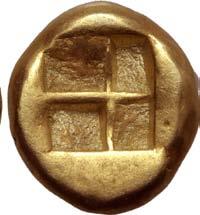
Mysia, Kyzikos EL Hemihekte - 1/12 Stater. Circa 550-500 BC. Crab, holding head of tunny to right in its claws / Quadripartite incuse square. Von Fritze I 37; SNG BnF 176-7; Jameson 2160 = Weber 4966. 1.35g, 9mm.
Ex Roma Numismatics Ltd., Auction VII, 22 March 2014, lot 629.
300 No Reserve 900 No Reserve 300 No Reserve 600 No Reserve 2,400 No Reserve
240.



Mysia, Kyzikos EL Hekte. Circa 550-500 BC. Head of lioness to left, with collar of pearls; tunny fish upwards behind / Quadripartite incuse square. Von Fritze I 39; Boston MFA 1413; SNG BnF 178; Rosen 432. 2.64g, 11mm.
Extremely Fine; obv. banker’s mark.

241.

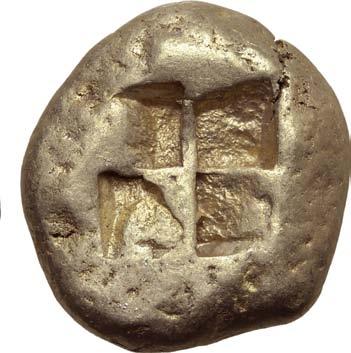
Mysia, Kyzikos EL Stater. Circa 550-500 BC. Helmeted head of Athena to left; tunny fish downwards to right / Quadripartite incuse square. Von Fritze I 64, pl. II, 17; Greenwell 26; Boston MFA 1432 = Warren 1445; SNG BnF -; BMC 18; Gillet 1058; Gulbenkian 608; Jameson 2168 = Weber 4970; Myrmekion 9; Rosen 445 = SNG von Aulock 7282. 16.09g, 20mm.
Very Fine. Very Rare.
Ex Roma Numismatics Ltd., Auction XVII, 28 March 2019, lot 466.

242.


3x 3x
Mysia, Kyzikos EL Hemihekte - 1/12 Stater. Circa 550-450 BC. Archaic bearded head to left; tunny fish below / Quadripartite incuse square. Von Fritze I 66; SNG BnF 194 var. (denomination); Jameson 2170 var. (denomination); Rosen 447 var. (denomination); Hurter & Liewald I-III -. 1.34g, 8mm.
Near Mint State. Extremely Rare in this denomination - no other examples on CoinArchives.
Ex Roma Numismatics Ltd., Auction XXIII, 24 March 2022, lot 283 (hammer: GBP 2,400).
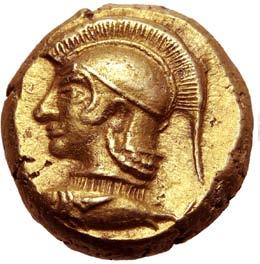
2x
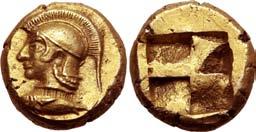

2x
Mysia, Kyzikos EL Hekte. Circa 550-500 BC. Head of Athena to left, wearing crested helmet; tunny fish below / Quadripartite
Good Extremely Fine.

243. 2x 2x
About Extremely Fine. Very Rare.

245.



Near Extremely Fine; interesting obv. banker’s mark of vine tendril(?) punched


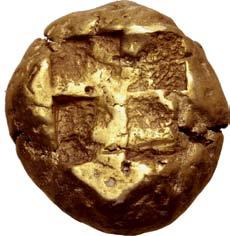
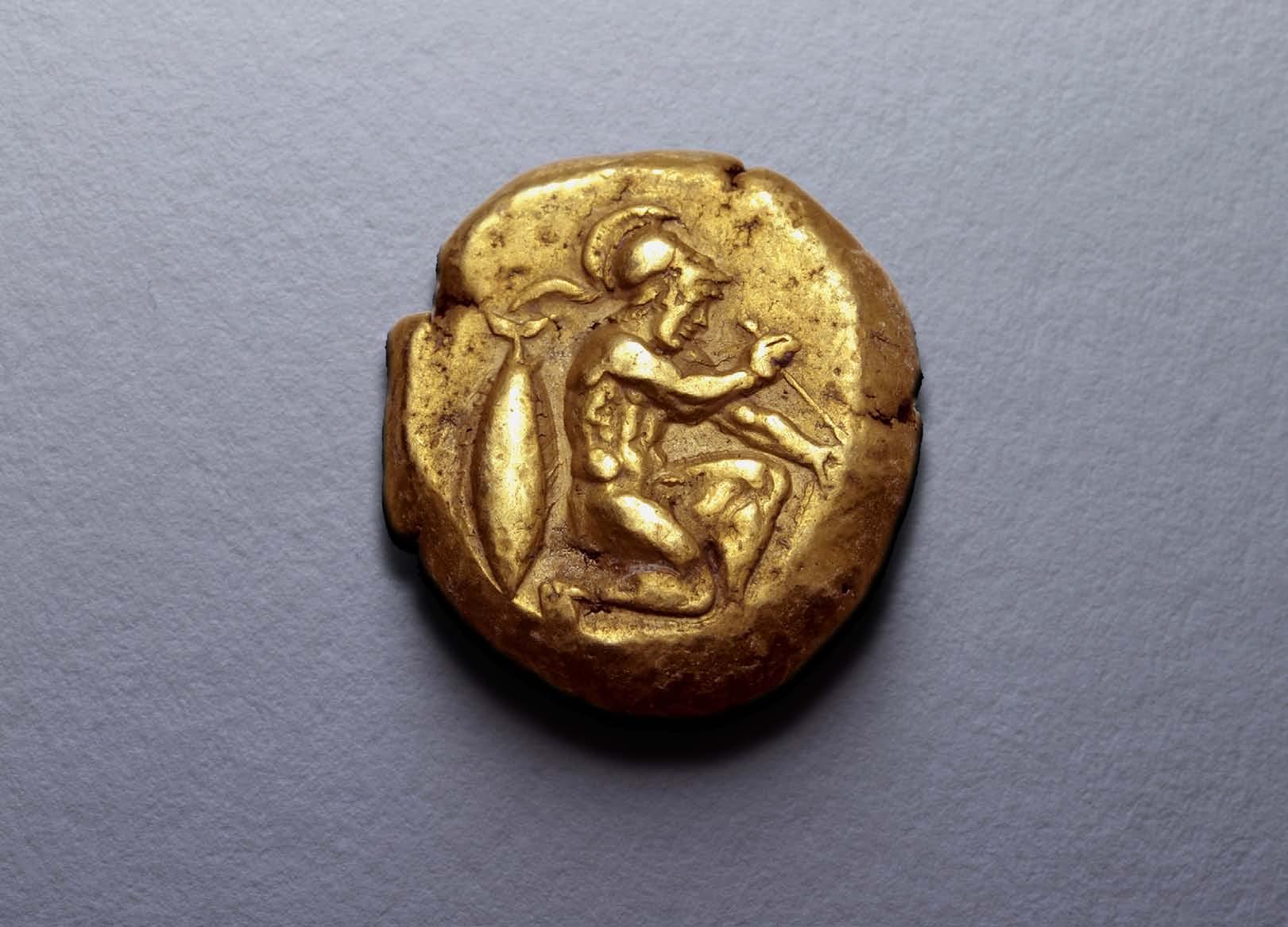
Extremely Fine. Very Rare.
Ex Roma Numismatics Ltd., Auction XXVII, 22 March 2023, lot 277 (hammer: GBP 16,000).
7,500 No Reserve
This coin, from a short series of warrior/hero types, was thought by W. Greenwell (The Electrum Coinage of Cyzicus, NC 1887) to represent either Jason or one of his Argonaut companions; given their appearance in the mythical history of Kyzikos it is not an unfair proposition.
There was a strong tradition in the ancient Greek world of relating larger, pre-existent myths to particular localities - as evidently happened with this story of Kyzikos. Many of the major early Greek myths and associated texts were particularly conducive to such secondary myth-making - the Iliad, for instance, is encyclopaedic in its incorporation of different localities in the Greek world (many seemingly added by later editors), while the stories of Odysseus’ voyage home and the Argonauts’ quest for the Golden Fleece were particularly convenient in that they could be made to stop off in any number of places on their journeys. Often, these connections would have been suggested by particular features of the landscape (e.g. a large hill being named as a burial ground for a hero) and verbal ‘clues’ in the oral and written sources of the larger myth, and we might suppose that the underlying motivation was to connect one’s homeland to a famous legend in order to glorify it, or even just to bring the story ‘home’ and make it relevant to one’s own locale - or perhaps a combination of both, for bards who were travelling and wanted to integrate the world of their audience into the legends they were reciting. Later historians and other writers repeated and refuted such stories, often having to weigh up between conflicting accounts. Apollonius Rhodius, scholar and poet in the library of Alexandria, for instance, incorporated the story of the Argonauts in Kyzikos into book one of his retelling of Jason’s adventure, the Argonautica, several centuries after the minting of the present coin and when such a mythical ‘history’ had long since solidified.
248.
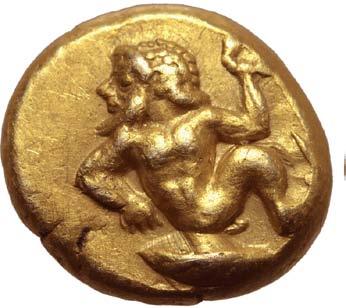
Very Rare


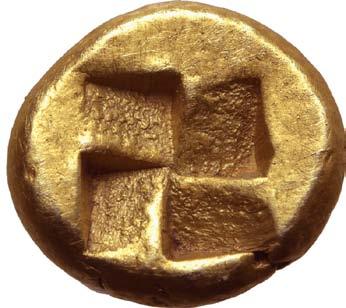
Mysia, Kyzikos EL Hemihekte - 1/12 Stater. Circa 550-450 BC. Triton reclining to left, holding wreath in raised left hand, leaning on left elbow; tunny fish to left below / Quadripartite incuse square. Cf. Von Fritze I 126 (unlisted denomination); cf. Greenwell 11 (same); cf. Hurter & Liewald I 26a (stater); cf. Hurter & Liewald II 78 (Triton holding tunny before); cf. Boston MFA 1425 (hekte); cf. SNG BnF 276 (hekte); cf. BMC 24 (stater); cf. Gulbenkian 614 (hekte); cf. Jameson 2561 (hekte); cf. Rosen 503 (hekte); Traité -; Weber -; Münzen und Medaillen AG 52, 168; Triton XI, 209. 1.32g, 9mm.
Extremely Fine. Very Rare; particularly in this denomination.
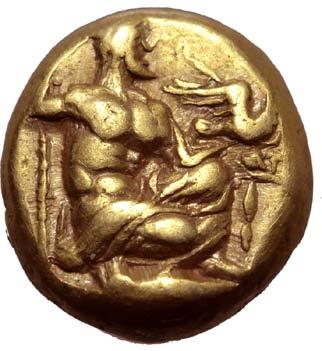


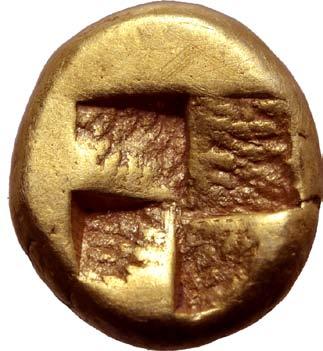
249.
Extremely Fine. Extremely rare denomination.


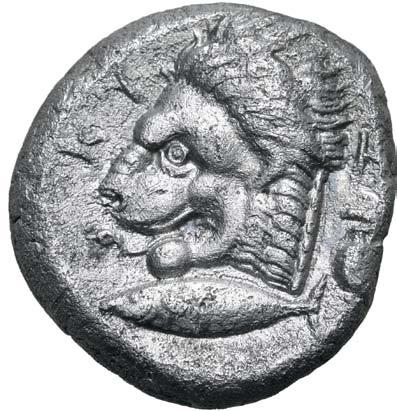
1,800 No Reserve
250.
Mysia, Kyzikos EL Hemihekte - 1/12 Stater. Circa 450-400 BC. Zeus, nude to waist, kneeling to right, holding sceptre with his right hand, eagle taking flight from his extended left hand; [tunny fish to right] below / Quadripartite incuse square. Von Fritze I -, cf. 145, pl. IV, 32 (stater); cf. Boston MFA 1530 = Warren 1422 (stater); cf. Hurter-Liewald, SNR 83 (2004), 145 (hekte - 1/6 stater); cf. Roma XXVII, 279 (1/6 stater); cf. CNG E-408, 143 (1/24 stater). 1.32g, 9mm.
450 No Reserve
Mysia, Kyzikos AR Tetradrachm. Circa 390-340 BC. Head of Kore Soteira to left, two grain ears in hair, wearing sphendone covered with veil, singlependant earring and necklace; ΣΩTEIPA above / Head of roaring lion to left, tongue protruding; KY-エI around, oinochoe behind, tunny fish to left below. Von Fritze 23, pl. V, 32; SNG BnF 400; SNG von Aulock 7339; SNG Copenhagen 53. 14.74g, 23mm, 6h.
Good Very Fine.
247. 300 No Reserve



Mysia, Pergamon AR Cistophoric Tetradrachm. 150-140 BC. Serpent emerging from cista mystica; all within ivy wreath / Two serpents entwined around bow and bowcase; in right field, dolphin swimming to left; monogram in left field. Kleiner & Noe Series 23a; SNG von Aulock 7460; SNG Copenhagen 414. 12.60g, 29mm, 12h.
Extremely Fine.
Ex Nomos AG, Obolos 19, 8 May 2021, lot 333.


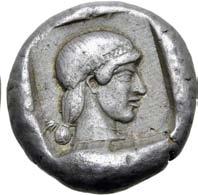
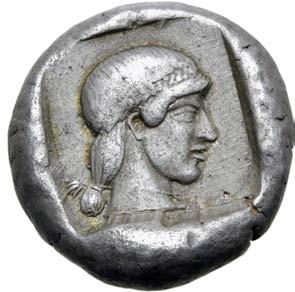
251.
Karia, Knidos AR Drachm. Circa 465-449 BC. Lion’s protome with open jaws to right / Head of Aphrodite to right, wearing decorated tainia and necklace, her hair falling down the back of her neck, tied at the end; all within incuse square. HNO 609 (temp.); Cahn 74.4 = SNG Copenhagen 234 (same dies). 6.12g, 17mm, 6h.
Near Extremely Fine.
From the David Freedman Collection; Privately purchased from Max Tursi.

252.


Karia, Mylasa AR Drachm. In the name and types of Alexander III of Macedon. Circa 300 BC. Head of Herakles to right, wearing lion skin headdress / Zeus Aëtophoros seated to left, holding sceptre; ΑΛΕΞΑΝΔΡΟΥ to right, monogram in Ω in left field, KΛ below throne. Price 2478. 4.25g, 17mm, 2h.
Extremely Fine. Rare.
Ex Roma Numismatics Ltd., E-Sale 103, 24 November 2022, lot 505.

253.


Rhodos, Kamiros AR Obol. Circa 500-460 BC. Aiginetic standard. Fig leaf / Rough incuse square. HNO 370 (temp., tritemorion); SNG Keckman 3234; cf. BMC p. 224, 10; HCG 6, 1390 (tritemorion). 0.61g, 8mm.
Very Fine. Very Rare.
Ex Roma Numismatics Ltd., Auction XXII, 7 October 2021, lot 357.

254.
Very Fine; double struck.
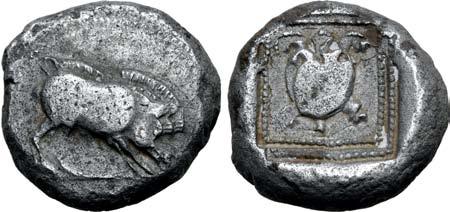
Ex Roma Numismatics Ltd., Auction 7, 22 March 2014, lot 706.

255.
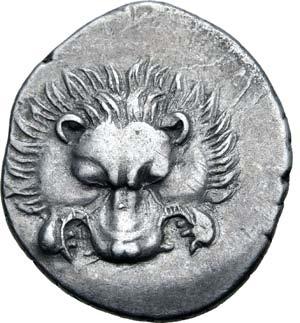

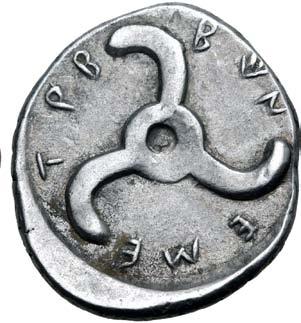
Dynasts of Lykia, Trbbenimi AR Third Stater. Wedrei, circa 390-375 BC. Facing lion’s scalp / Triskeles; TPBB��NEME around; all within shallow incuse circle. Müseler VIII, 25-27; Falghera 197-202; SNG von Aulock 4215; Podalia 158-70. 2.90g, 18mm.
Extremely Fine.
Ex Roma Numismatics Ltd., Auction XXIII, 24 March 2022, lot 317.

256.


Good Very Fine; area of flat strike. Scarcer type with wrestlers fighting with both arms and legs.
Ex Numismatik Naumann, Auction 107, 5 September 2021, lot 208 (hammer: 600 EUR).

257.
Good Extremely Fine; attractive deep old cabinet tone.



Ex Gorny & Mosch Giessener Münzhandlung, Auction 273, 19 November 2020, lot 227 (hammer: EUR 5,000); Ex Gorny & Mosch Giessener Münzhandlung, Auction 257, 15 October 2018, lot 498; Ex old Munich collection, acquired before 1973.

258.
Cilicia, Kelenderis AR Stater.

430-420
Extremely Fine; well-centred and lustrous.
Ex JTB Collection, Triton XXIV, 19 January 2021, lot 735 (hammer: USD 3,250).
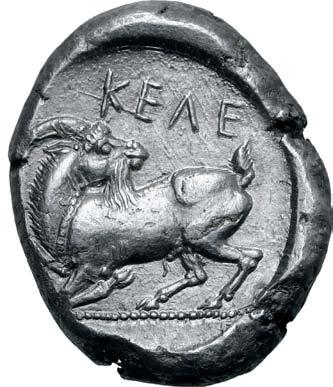

259.
Only 6 cited on RPC Online


Cilicia, Olba Æ 17mm. Circa AD 70. M. Antonius Polemo II, dynast. Μ ΑΝΤ ΠΟΛEΜΩΝΟΣ ΒΑΣΙΛΕΩΣ, club / ΚΟΙΝΟΝ ΛΑΛΑΣΕΩΝ ΚΑΙ ΚΕΝΝΑΤΩΝ, harpa. RPC I 3742 corr. (rev. legend); Staffieri 36. 3.44g, 17mm, 12h.
Good Very Fine. Very Rare; only 6 cited on RPC online.
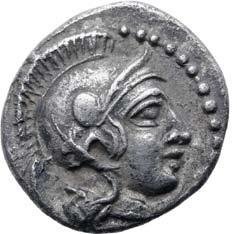
260.

Cilicia, Soloi AR Obol. Circa 350-330 BC. Head of Athena to right, wearing crested
0.77g, 9mm, 9h.
Good Extremely Fine.
Ex Leu Numismatik AG, Web Auction 20, 16 July 2022, lot 1358 (hammer: CHF 440); Ex Papillon, E-Auction 5, 6 March 2021, lot 333.

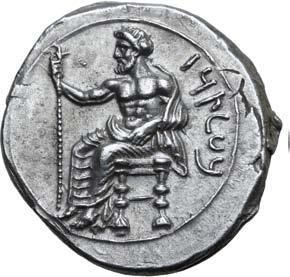

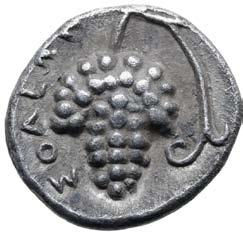

261.
Near Mint State; light horn silver deposits at edge, a highly attractive and wonderfully detailed specimen.
Ex Auktionshaus H. D. Rauch GmbH, Auction 112, 10 June 2021, lot 676.
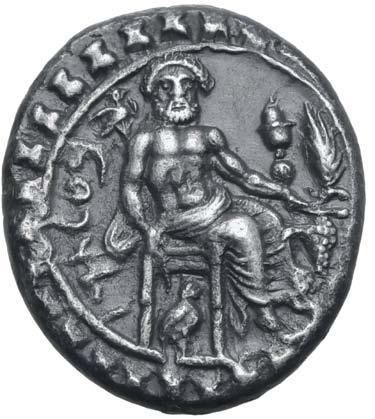
262.
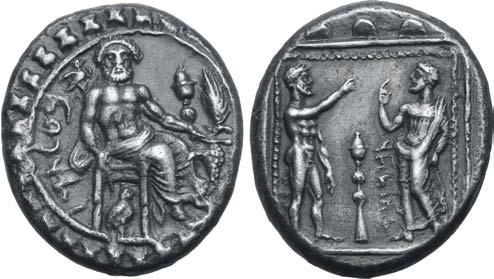

Cilicia, Tarsos AR Stater. Datames, satrap of Cilicia and Cappadocia, circa 369-361 BC. Baaltars seated to right on throne, head facing, holding bunch of grapes and grain ear in left hand, with eagle-tipped sceptre cradled in right arm; B’LTRZ in Aramaic to left, thymiaterion to right, eagle below throne, all within crenellated wall / Ana, nude, facing Datames, both with right arms raised; thymiaterion and ‘TRDMW’ in Aramaic between, ‘ANA’ in Aramaic behind Ana’s leg, all within square dotted border within
Near Extremely Fine; die breaks on obverse.
Ex Roma Numismatics Ltd, Auction 7, 22 March 2014, lot 720.
263.



Cilicia, Tarsos AR Stater. Datames, satrap of Cilicia and Cappadocia, circa 369-361 BC. Baaltars seated to right on throne, holding bunch of grapes and grain ear in left hand, with eagle-tipped sceptre cradled in right arm; B’LTRZ in Aramaic to left, thymiaterion to right, bucranium beneath throne, all within crenellated wall / Tarkumuwa (Datames) seated to right, in full Persian garb, inspecting arrow held in his left hand; TRDMW in Aramaic to left, bow to right, winged solar disk in upper right field. Casabonne type 2; Moysey issue 6; SNG BnF 286-8; SNG Levante 88; Traité II 610; SNG Copenhagen 295-6; SNG von Aulock 5952. 10.54g, 24mm, 11h.
Near Mint State; struck off-centre, otherwise a stellar example.
Ex Auktionshaus H. D. Rauch GmbH, Auction 112, 10 June 2021, lot 675.
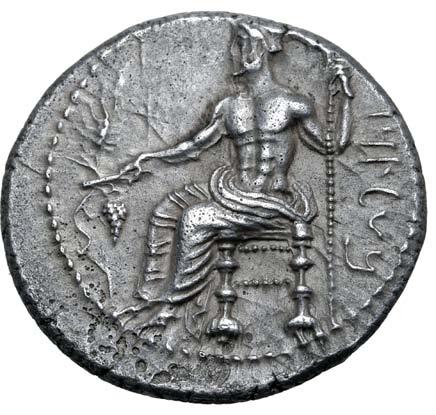
264.


Extremely Fine; pleasant light cabinet tone, minor scratch.
Ex Roma Numismatics Ltd., E-Sale 24, 30 January 2016, lot 191.
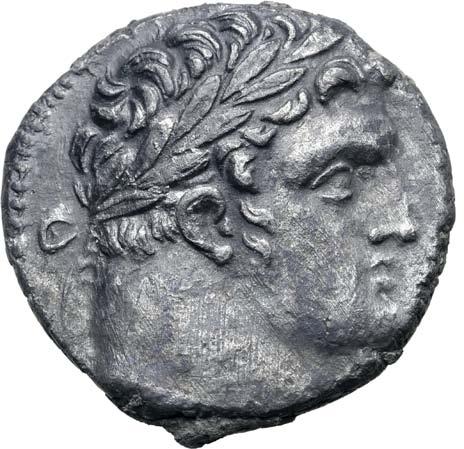

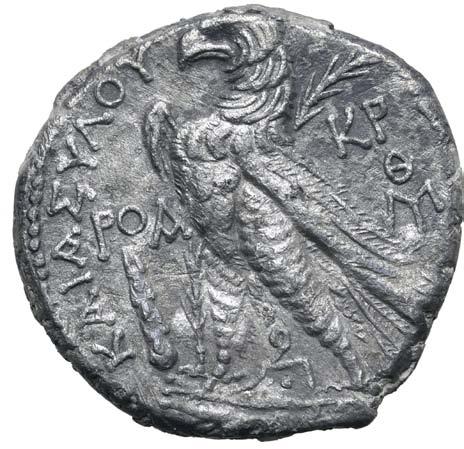
265.
Phoenicia, Tyre AR Shekel. Dated CY 171 = AD 45/6. Laureate head of Melkart to right / [ΤΥPΟΥ ΙΕΡΑΣ] ΚΑΙ ΑΣΥΛΟΥ, eagle standing to left on prow, palm behind; POA (date) above club to left, KP above θ over monogram to right, Phoenician letter Bet
Extremely Fine.

266.


Kyrenaika, Kyrene AR Didrachm. Temp. Magas, circa 294-275 BC. Horned head of Zeus Karneios to left / Silphion plant; two stars across upper fields, KY-PA across lower fields. BMC 237; SNG Copenhagen 1237. 7.63g, 20mm, 12h.
Near Extremely Fine; light cabinet tone.
Ex Classical Numismatic Group, Auction 121, 6 October 2022, lot 609 (hammer: USD 1,300).
267.

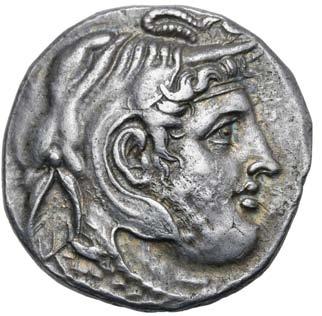

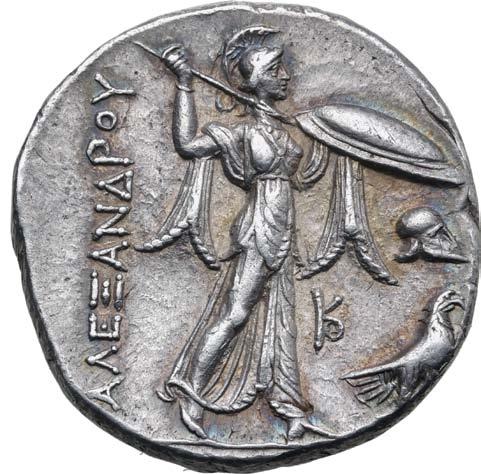
Ptolemaic Kingdom of Egypt, Ptolemy I Soter, as satrap or king, AR Tetradrachm. In the name of Alexander III of Macedon. Alexandria, circa 306-300 BC. Head of deified Alexander to right with horn of Ammon, wearing mitra of Dionysos and elephant headdress, aegis around neck; tiny Δ on aegis / Athena Alkidemos advancing to right, brandishing spear and holding shield; AΛEΞANΔPOY in left field, helmet, monogram and eagle on thunderbolt in right field. CPE 70; Svoronos 164; Zervos Issue 29. 15.68g, 26mm, 12h.
Extremely Fine; beautiful iridescence around devices.
1,800 No Reserve
Ex Leu Numismatik AG, Web Auction 23, 22 August 2022, lot 3477 (erroneously attributed to Gorny & Mosch sale 138, hammer: CHF 3,800).
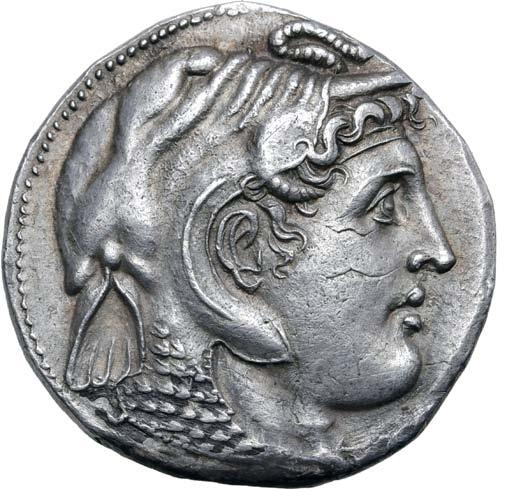
268.
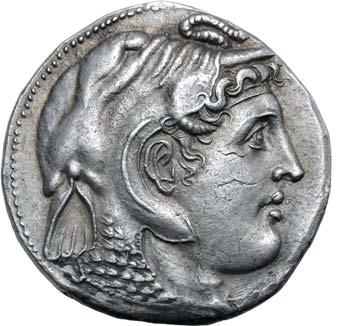

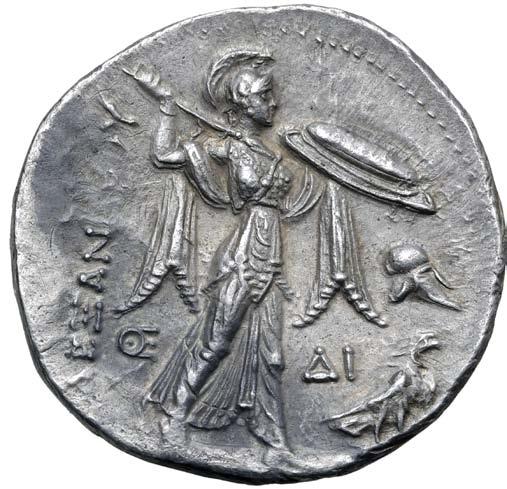
Ptolemaic Kingdom of Egypt, Ptolemy I Soter, as satrap or king, AR Tetradrachm. In the name of Alexander III of Macedon. Alexandria, circa 306-300 BC. Head of deified Alexander to right with horn of Ammon, wearing mitra of Dionysos and elephant headdress, aegis around neck / Athena Alkidemos advancing to right, brandishing spear and holding shield; ΑΛΕΞΑΝΔΡOY to outer left, ΘE monogram to left, ΔI and Corinthian helmet above eagle on thunderbolt in right field. CPE 73; Svoronos 177; Boston MFA 2258 (same obv. die); SNG Lockett 3394 (same obv. die); SNG Copenhagen 30 var. (monogram to left). 15.53g, 28mm, 12h.
Good Extremely Fine; a wonderful portrait.
Ex Leu Numismatik AG, Web Auction 23, 22 August 2022, lot 3479 (hammer: CHF 5,005).

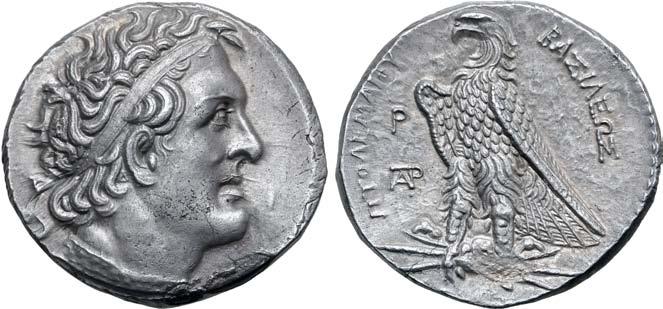
269.
1,800 No Reserve

Near Mint State; planchet flaw to rev.; edge previously repaired; well detailed with hints of golden iridescence.
Ex Fritz Rudolf Künker GmbH & Co. KG, Auction 347, 22 March 2021, lot 7; Reportedly previously acquired in March 1986.
750 No Reserve


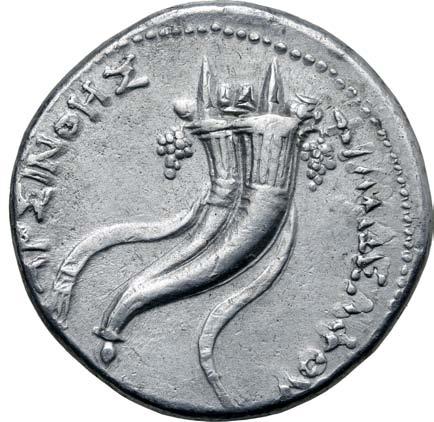
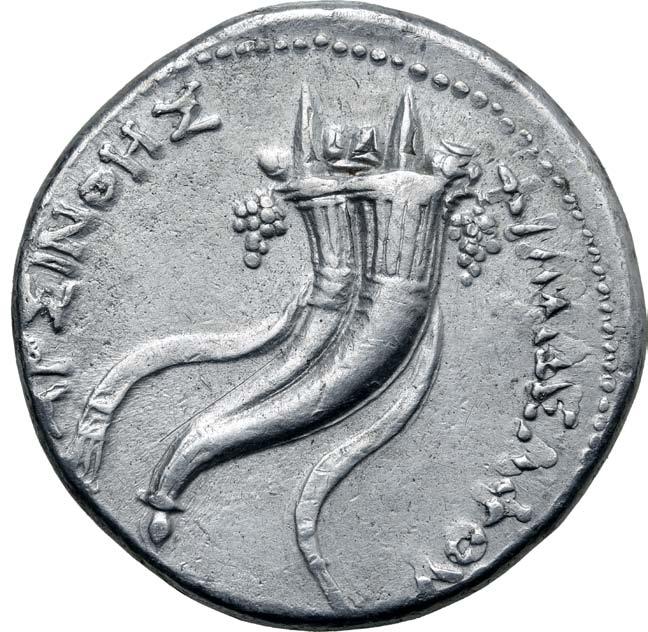
270.
Ptolemaic Kingdom of Egypt, Arsinoe II (wife of Ptolemy II) AR Dekadrachm. Alexandria, posthumous issue under Ptolemy II, circa 261-252 BC. Veiled head of deified Arsinoe with ram’s horn to right, wearing diademed stephane, sceptre surmounted by lotus over left shoulder; P in left field / Double cornucopiae, grape bunches hanging at sides, bound with fillet; AΡΣINOHΣ ΦIΛAΔEΛΦOY around. CPE 335; Svoronos 496 (dated 254 BC); BMC 17; SNG Copenhagen 135; Troxell, ‘Arsinoe’s Non-Era’ in Museum Notes 28 (1983), p. 42. 34.82g, 35mm, 12h. Near Extremely Fine. Very Rare; six examples known to Svoronos and only two on CoinArchives.
1,200 No Reserve


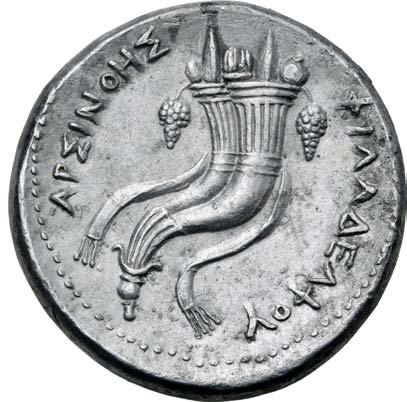

271.
Ptolemaic Kingdom of Egypt, Arsinoe II (wife of Ptolemy II) AR Dekadrachm. Alexandria, posthumous issue under Ptolemy II, circa 253-249 BC. Veiled head of deified Arsinoe with ram’s horn to right, wearing diademed stephane, sceptre surmounted by lotus over left shoulder; KK in left field / Double cornucopiae, grape bunches hanging at sides, bound with fillet; AΡΣINOHΣ ΦIΛAΔEΛΦOY around. CPE 352; Svoronos 945 (dated 237 BC under Ptolemy III, 1 example listed) = BMC 25; Troxell, ‘Arsinoe’s Non-Era’ in Museum Notes 28 (1983), p. 44 (7 examples, dated circa 253/2-246 BC). 35.00g, 33mm, 12h.
Extremely Fine; scuff to obverse. Very Rare.
1,500 No Reserve


272.

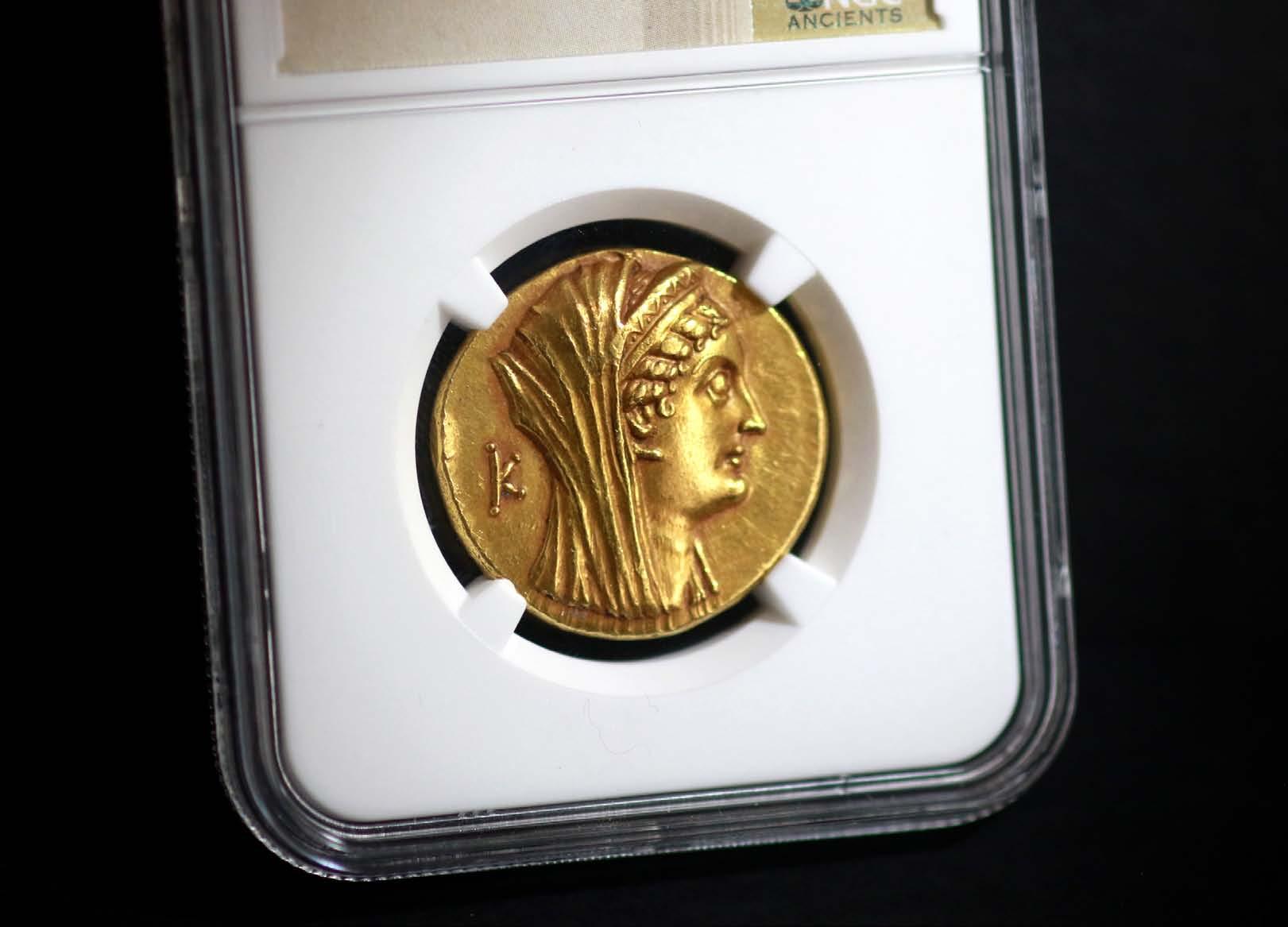
Ptolemaic Kingdom of Egypt, Arsinoe II (wife of Ptolemy II) AV Mnaieon (Oktadrachm). Struck under Ptolemy VI-VIII. Alexandria, circa 180-116 BC. Veiled head of deified Arsinoe with ram’s horn to right, wearing diademed stephane, sceptre surmounted by lotus over left shoulder; K to left / Double cornucopiae, grape bunches hanging at sides, bound with fillet; APΣINOHΣ ΦIΛAΔEΛΦOY around. Svoronos 1498-9; SNG Copenhagen 322; Troxell p. 67, 8.
NGC graded Ch AU 5/5 - 2/5, brushed (#6674413-002).
Ex Morton & Eden, Auction 119, 6 December 2022, lot 65 (hammer: GBP 26,000).
13,500 No Reserve
The daughter of Ptolemy I and his wife Berenike, Arsinoe II was born in 316 BC in the nascent Ptolemaic kingdom of Egypt. After a swift political marriage to Lysimachos of Thrace at the age of fifteen, she was married again to Ptolemy Keraunos, her half-brother, but fled Macedon immediately after the wedding to the protection of Egypt, which had passed to her younger brother Ptolemy II. The two gained the epithet ‘Philadelphoi’ or ‘siblinglover’ after they married in 273-272 BC: the practice of sibling marriage was traditional for Egyptian pharaohs, but was known only to the Greeks in deities such as Zeus and Hera. However, their marriage provided a model which was followed by most subsequent Ptolemaic monarchs, and its divine connotations only advanced their power. The image of Arsinoe here portrays a beautiful and serene queen, with considerable attention devoted to her curled hairstyle and the drape of her veil, while her usual attributes of cornucopiae associate her with peace and prosperity
She was considered a capable co-ruler who directed Egypt’s foreign affairs, and her death prompted a great outpouring of gold coinage to mark her full deification, emphasised in this portrait by a glimpse of a ram’s horn emerging from her veil, reminiscent of the horn of Ammon on images of the deified Alexander the Great.

Extremely Fine. Rare with this date.

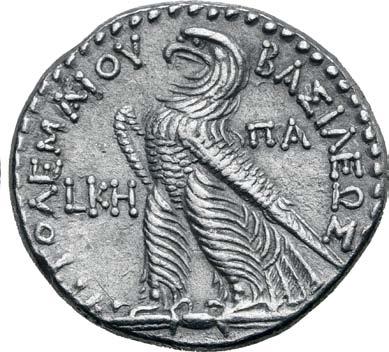
274.
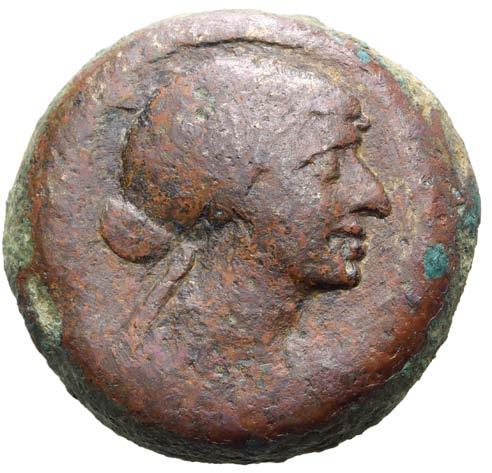


Ptolemaic Kingdom of Egypt, Kleopatra VII Thea Neotera Æ Diobol - 80 Drachmai. Alexandria, 51-30 BC. Diademed and draped bust to right / [KΛEOΠATPAΣ] BAΣIΛIΣ[ΣHΣ], eagle standing to left on thunderbolt; cornucopiae to left, Π (mark of value) to right. Svoronos 1871; Weiser 183; SNG Copenhagen 419-21; Noeske 380-2. 20.43g, 27mm, 12h.
Near Very Fine. Very Rare.

275.
300

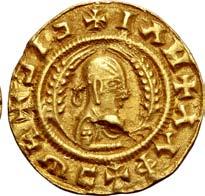
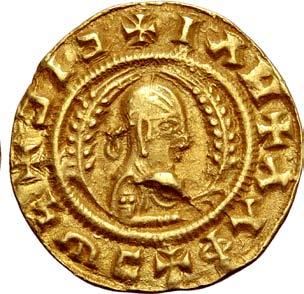
Kingdom of Axum, Eon (Noe) AV Unit. Circa AD 410-450. ⧾ ΛCX ⧾ ΛCΛ ⧾ CΛC ⧾ CIN (interpretation uncertain - “King of the land of the Abyssinians” [much abbreviated]?), crowned and draped bust to right, holding stick, flanked by wheat stalks; all within circular border / ⧾ IѠC ⧾ CIC ⧾ IAN ⧾ ΛΛΦ (“Eon man of Anaaf”), draped bust to right, wearing headcloth, flanked by wheat stalks; all within circular border. Hahn & Keck 38; SACAM 222-30; H 28a; AC 59-60. 1.58g, 17mm, 12h.
Extremely Fine; struck from slightly worn dies. Rare.
Ex Roma Numismatics Ltd., Auction XXVII, 22 March 2023, lot 339; Ex important collection of Aksumite coins, Leu Numismatik AG, Web Auction 20, 16 July 2022, lot 3190.

276.
360


Kingdom of Axum, Ebana AV Unit. Circa AD 460-480. ⧾ CΛC ⧾ ΛCΛ ⧾⧾ CΛ ⧾ CIN (interpretation uncertain - “King of the land of the Abyssinians” [much abbreviated]?), crowned bust to right, holding stick, grain ears flanking; within circular border / ⧾ ΛNΛ ⧾ BAC ⧾ ΛCΛ ⧾ BCC (“King Ebana”), draped bust to right, wearing headcloth, holding fly-whisk, grain ears flanking; • above bust; within circular border. Hahn & Keck 43; SACAM 255-76; H 34; AC 71-3. 1.59g, 16mm, 12h.
Near Extremely Fine.
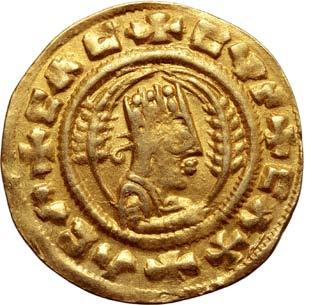
277.


Kingdom of Axum, Ebana AV Unit. Circa AD 460-480. ⧾ CΛX ⧾ ΛCΛ ⧾ CΛC ⧾ CVN (sic-interpretation uncertain - “King of the land of the Abyssinians” [much abbreviated]?), crowned bust to right, holding stick, grain ears flanking; within circular border / ⧾ ΛNΛ ⧾ CAC ⧾ ΛCΛ ⧾ CEB (“King Ebana”), draped bust to right, wearing headcloth, holding fly-whisk, grain ears flanking; within circular border. Hahn & Keck 43; SACAM 274; H 34; AC 71-3.
Near Extremely Fine. Rare.
Ex important collection of Aksumite coins, Leu Numismatik AG, Web Auction 20, 18 July 2022, lot 3206.
300
278.



Kingdom of Axum, Ebana AV Unit. Circa AD 460-480. ⧾ CΛX ⧾ ΛCΛ ⧾ CΛC ⧾ CIN (interpretation uncertain - “King of the land of the Abyssinians” [much abbreviated]?), crowned bust to right, holding stick, grain ears flanking; within circular border / ⧾ ΛNΛ ⧾ CAC ⧾ ΛCΛ ⧾ CCC (“King Ebana”), draped bust to right, wearing headcloth, holding fly-whisk, grain ears flanking; within circular border. Hahn & Keck 43; SACAM 259; H 34; AC 71-3. 1.62g, 16mm, 12h.
Good Extremely Fine.
Ex Roma Numismatics Ltd., Auction XXVII, 22 March 2023, lot 342.

279.
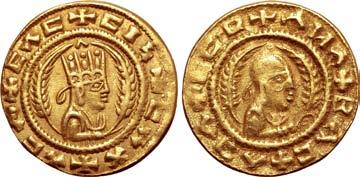

Kingdom of Axum, Ebana AV Unit. Circa AD 460-480. ⧾ CΛX ⧾ ΛCΛ ⧾ CΛC ⧾ CIN (interpretation uncertain - “King of the land of the Abyssinians” [much abbreviated]?), crowned bust to right, holding stick, grain ears flanking; within circular border / ⧾ ΛNΛ ⧾ BAC ⧾ ΛCΛ ⧾ CEB (“King Ebana”), draped bust to right, wearing headcloth, holding fly-whisk, grain ears flanking; within circular border. Hahn & Keck 43; SACAM 262 (same obv. die); H 34; AC 71-3; Vaccaro 38 (Esbael). 1.46g, 15mm, 11h.
Near Extremely Fine.
Ex Roma Numismatics Ltd., E-Sale 105, 19 January 2023, lot 399.

280.
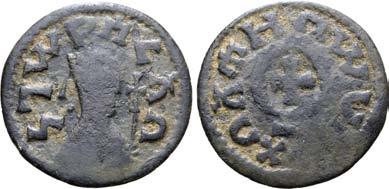

Kingdom of Axum, Israel Æ Unit. AD 575-580. Crowned and draped bust to right, holding cruciform sceptre; Ge’ez legend ነገሠየሰረአለ (ngí Ysrýl ‘King Yisrāʾēl’) around / Cross with flared arms within circular border, X[C] below; Ge’ez legend ለአሐዘበ ሠሀ[ለ] (lýhzb íhl “mercy to the people”) around. Hahn & Keck 79; SACAM -; H 47; AC 144; Vaccaro 51; Roma XXVII, 349 (hammer: 9,000 GBP); Roma XXII, 80 (hammer: 13,000 GBP). 1.05g, 17mm, 1h.
Near Very Fine. Extremely Rare; only seven examples cited by Hahn & Keck, three of which are in museums, two on CoinArchives.

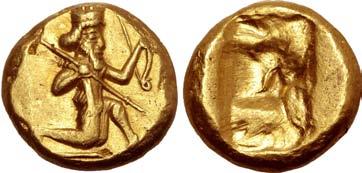
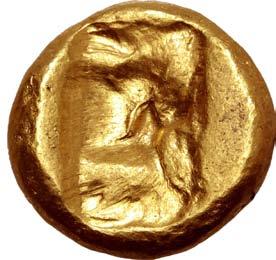
Persia, Achaemenid Empire AV Daric. Time of Darios I to Xerxes II. Sardes, circa 485-420 BC. Persian Great King or hero, wearing kidaris and kandys, in kneeling-running stance to right on exergual line, holding apple-tipped spear and strung bow; quiver over shoulder / Rectangular incuse punch. Carradice Type IIIb, Group A/B (pl. XIII, 27); Meadows, Administration 321; BMC Arabia pl. XXIV, 26; Sunrise 24; cf. GRPC Lydia G61. 8.39g, 15mm.
Extremely Fine; lustrous metal with light red toning, well centred and struck for the type - a wonderful example.
Ex Jonathan P. Rosen Collection, Classical Numismatic Group, Auction 114, 13 May 2020, lot 431 (hammer: USD 3,500).
The ancient Greeks themselves believed that the term ‘dareikos’ was derived from the name of Darius the Great, an assessment that many modern scholars agree with. Others however have generally supposed that the Greek term can be traced back to old Persian ‘dari’ (golden) and that it was first associated with the name of Darius only in later folk etymology. Both suppositions may be equally valid.
While the Persians had not traditionally used coinage, Cyrus the Great had introduced it to the Persian empire with the conquest of the Lydian Kingdom in 546 BC. The Lydian coinage series featuring a confronted lion and bull type was continued at first, but under the reign of the third Great King, Darios I, the Lydian gold stater was converted into a type bearing the stylised image of the Persian ruler or a hero, a type which would last with little modification until the conquest of Persia by Alexander in the 330s BC. One of the principal motivating factors behind this institution of an official Persian currency was the requirement to pay Greek mercenaries, who were accustomed to receiving payment in coinage, or for official use as bribes and subsidies.
Indeed, nothing demonstrates the power of the gold daric more succinctly than when Sparta was waging an increasingly successful war led by Agesilaos II against Persia in Asia Minor (398-395 BC). Unable to defeat the Spartan army, the satrap Pharnabazos sent an Asiatic Greek by the name of Timocrates of Rhodes to distribute ten thousand gold darics in the major cities of mainland Greece and thus incite them to war against Sparta. Athens, Thebes, Corinth and Argos quickly entered into conflict with Sparta, precipitating a messenger to be sent to Agesilaos ordering him to return to Greece. The recall was a bitter disappointment to Agesilaos, who wryly observed that “but for ten thousand ‘archers’, he would have vanquished all Asia.”
282.



Persia, Achaemenid Empire AV Daric. Time of Darios I to Xerxes II. Sardes, circa 485-420 BC. Persian Great King or hero, wearing kidaris and kandys, in kneeling-running stance to right on exergual line, holding apple-tipped spear and strung bow; quiver over shoulder / Rectangular incuse punch. Carradice Type IIIb, Group A/B (pl. XIII, 27); Meadows, Administration 321; BMC Arabia 40-43 (pl. XXIV, 24-26); Sunrise 24; GRPC Lydia G61. 8.27g, 16mm.
Near Extremely Fine.
Ex Roma Numismatics Ltd., E-Sale 106, 16 February 2023, lot 416.

283.
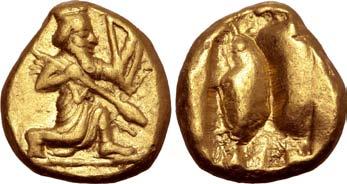

Persia, Achaemenid Empire AV Daric. Time of Darios I to Xerxes II. Sardes, circa 485-420 BC. Persian Great King or hero, wearing kidaris and kandys, in kneeling-running stance to right on exergual line, holding apple-tipped spear and strung bow; quiver over shoulder / Rectangular incuse punch. Carradice Type IIIb, Group A/B (pl. XIII, 27); Meadows, Administration 321; BMC Arabia 40-43 (pl. XXIV, 24-26); Sunrise 24; GRPC Lydia G61. 8.29g, 16mm.
Near Extremely Fine.
Ex Roma Numismatics Ltd., E-Sale 106, 16 February 2023, lot 417.
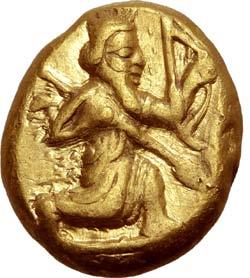
284.

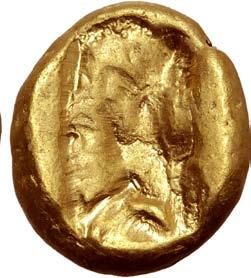
Persia, Achaemenid Empire AV Daric. Time of Darios I to Xerxes II. Sardes, circa 485-420 BC. Persian Great King or hero, wearing kidaris and kandys, in kneeling-running stance to right on exergual line, holding apple-tipped spear and strung bow; quiver over shoulder / Rectangular incuse punch. Carradice Type IIIb, Group A/B (pl. XIII, 27); Meadows, Administration 321; BMC Arabia 40-43 (pl. XXIV, 24-26); Sunrise 24; GRPC Lydia G61. 8.32g, 16mm.
Good Very Fine.
Ex Roma Numismatics Ltd., E-Sale 107, 16 March 2023, lot 571.

285.
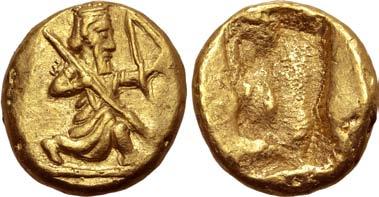

Persia, Achaemenid Empire AV Daric. Time of Xerxes II to Artaxerxes II. Sardes, circa 420-375 BC. Persian Great King or hero, wearing kidaris and kandys, in kneeling-running stance to right on exergual line, holding apple-tipped spear and strung bow; quiver over shoulder / Rectangular incuse punch. Carradice
Near Extremely Fine.
Ex Roma Numismatics Ltd., E-Sale 107, 16 March 2023, lot 570.

Achaemenid
Near


287.


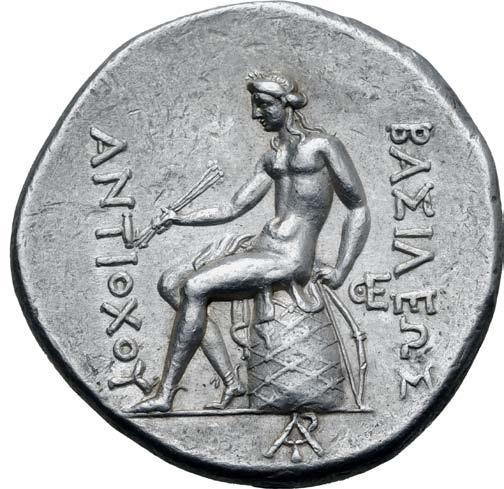
Seleukid Empire, Antiochos I Soter AR Tetradrachm. Smyrna, circa 281-261 BC. Diademed head to right / Apollo Delphios seated to left on omphalos, testing arrow and resting left hand on grounded bow; ΒΑΣΙΛΕΩΣ to right, ΑΝΤΙΟΧΟΥ to left, monogram in inner right field, monogram in exergue. SC 311.2; WSM 1494; HGC 9,128a. 16.77g, 28mm, 12h.
Extremely Fine.
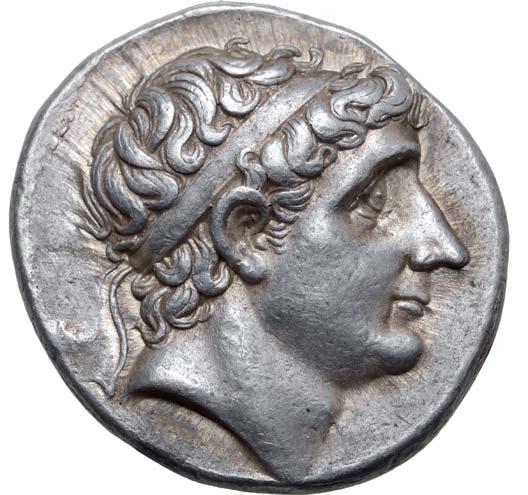


288.
Seleukid Empire, Antiochos I Soter AR Tetradrachm. Seleukeia on the Tigris, circa 281-261 BC. Diademed head to right / Apollo Delphios seated to left on omphalos, testing arrow and resting left hand on grounded bow; ΒΑΣΙΛΕΩΣ to right, ΑΝΤΙΟΧΟΥ to left, AP monogram to outer left, HP monogram to outer right. SC 379.3a; ESM 149; HGC 9, 128g. 17.20g, 29mm, 9h.
Near Extremely Fine; struck in high relief, attractive light cabinet tone with golden iridescent highlights.
Ex Dr. G.W. Collection, Schweizerische Kreditanstalt (Crédit Suisse), List 59, Spring 1993, no. 90; Ex Frank Sternberg AG, Auction 26, 16 November 1992, lot 114.

289.


Seleukid Empire, Antiochos I Soter AR Drachm. Aï Khanoum, circa 280-271 BC. Diademed head to right / Horned and bridled horse’s head to right; ΒΑΣΙΛΕΩΣ behind, [ΑΝ]ΤΙΟΧΟΥ
Good Very Fine.
Acquired from Pars Coins, San Jose CA.



290.
Extremely Fine; a striking portrait.
Ex Roma Numismatics Ltd., E-Sale 98, 16 June 2022, lot 545.
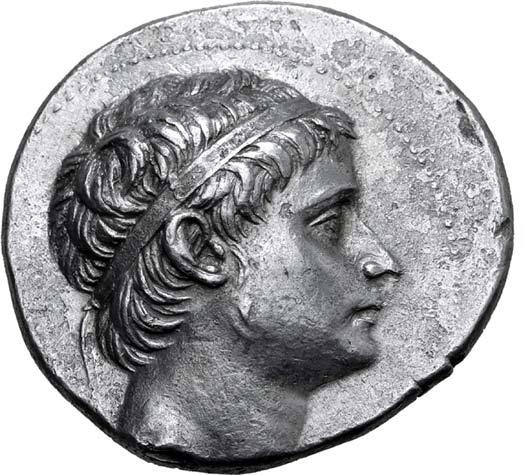
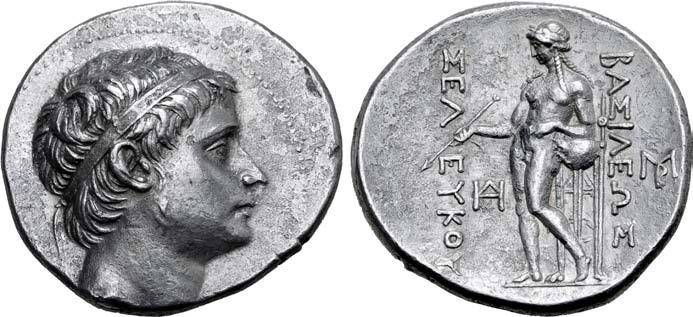
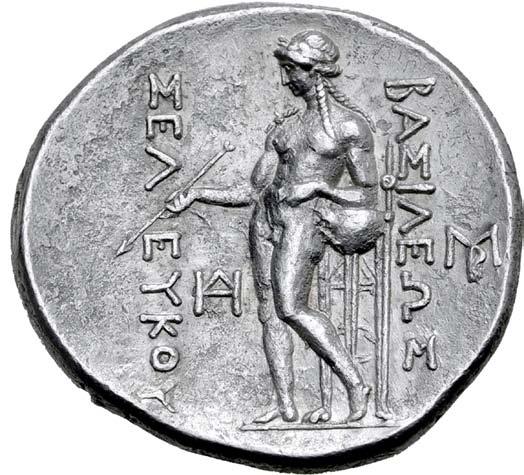
291.
Extremely Fine; a fine portrait struck in high relief.
Ex Roma Numismatics Ltd., Auction XXVII, 22 March 2023, lot 372.

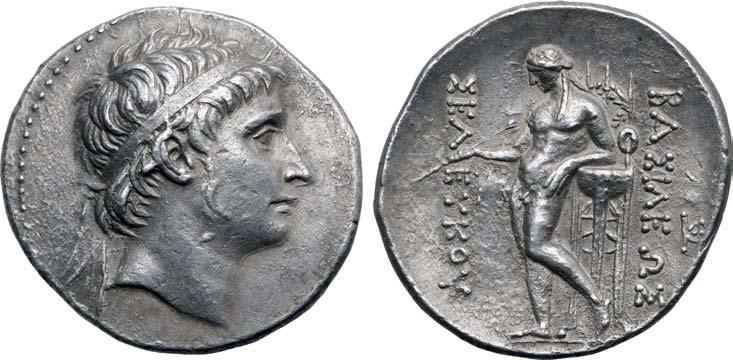

292.
Extremely Fine.
Ex Leu Numismatik AG, Web Auction 20, 16 July 2022, lot 1528.

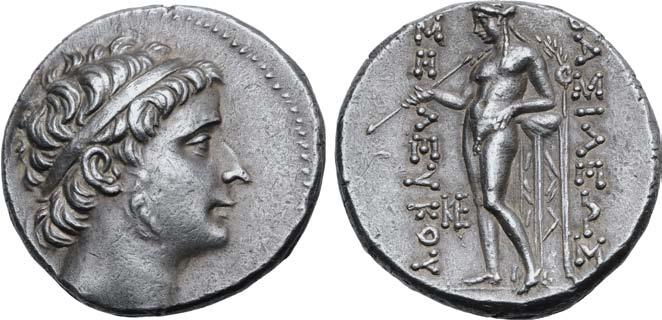
293.
Extremely Fine; attractive iridescence around devices.
Ex Leu Numismatik AG, Web Auction 20, 16 July 2022, lot 1522 (hammer: CHF 1,300).
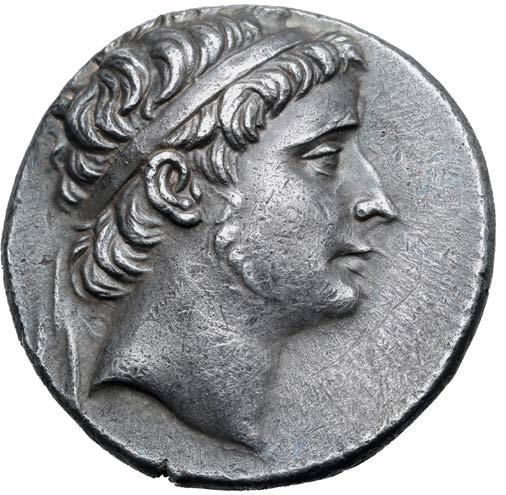


294. 450 No Reserve
Extremely Fine; an attractive cabinet tone. Scarce with this control mark.

295.
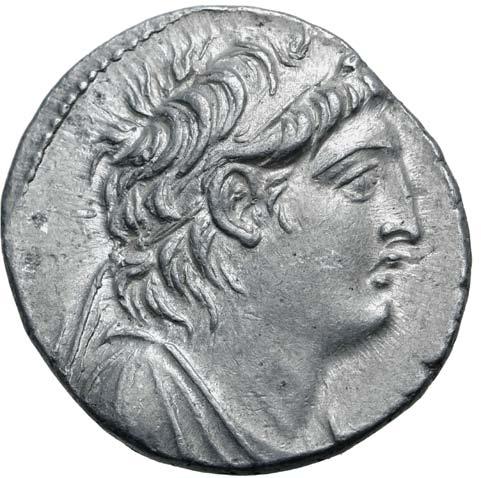


Seleukid Empire, Antiochos VII Euergetes (Sidetes) AR Tetradrachm. Tyre, dated SE 177 = 136/5 BC. Diademed and draped bust to right / BAΣIΛEΩΣ ANTIOXOY, eagle standing to left on prow, with palm branch over shoulder; APE above monogram of Tyre on club in left field, AΣ above ZOP (date) to right, monogram between legs. SC 2109.5a; DCA 198; HGC 9, 1074. 14.04g, 27mm, 1h.
Extremely Fine; minor rev. die break on head of eagle.
Ex Leu Numismatik AG, Web Auction 20, 16 July 2022, lot 1601.

296.
300
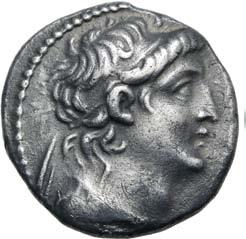


Seleukid Empire, Antiochos VII Euergetes (Sidetes) AR Didrachm. Tyre, dated SE 179 = 134/3 BC. Diademed and draped bust to right / BAΣIΛEΩΣ [ANTIOXOY], eagle standing to left on ship’s ram, with palm branch over shoulder; APE above monogram of Tyre on club in left field, AΣ above ΘOP (date) to right, monogram between legs. SC 2110.7; SNG Spaer 2057; DCA 201; HGC 9, 1077. 6.88g, 20mm, 1h.
Good Very Fine; struck on sound metal, lustrous and lightly toned. Extremely Rare.
Ex Roma Numismatics Ltd., E-Sale 102, 3 November 2022, lot 549.
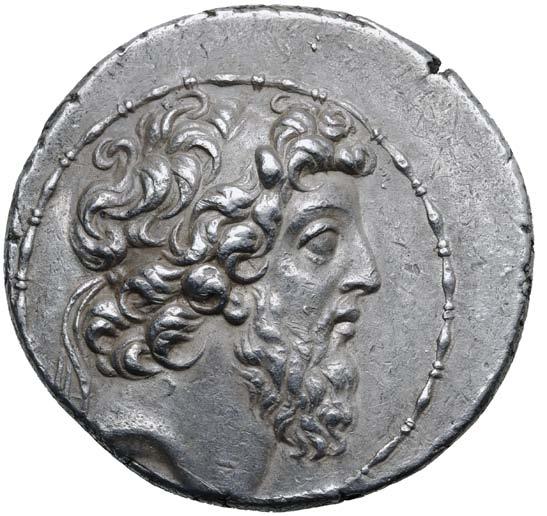
297.



Seleukid Empire, Demetrios II Nikator AR Tetradrachm. Second reign. Antioch on the Orontes, 129-128 BC. Diademed head to right / Zeus Nikephoros seated to left, holding sceptre; BAΣIΛEΩΣ ΔHMHTPIOY to right, ΘEOY NIKATOPOΣ to left, Ξ to outer left, O below throne. SC 2166.2c; SMA 320; HGC 9, 1117b. 16.31g, 30mm, 1h.
Good Extremely Fine.
Ex Peter Corcoran Collection, The New York Sale 54, 11 January 2022, lot 72 (hammer: USD 2,900); Ex Numismatik Lanz München, Auction 117, 24 November 2003, lot 416; Ex Gerhard Hirsch Nachfolger, Auction 157, 26 February 1988, lot 185.
298.



Seleukid Empire, Demetrios II Nikator AR Tetradrachm. Second reign. Tyre, dated SE 185 = 128/7 BC. Diademed and draped bust to right / BAΣIΛEΩΣ ΔHMHTPIOY, eagle standing to left on prow, with palm frond over shoulder; APE above monogram of Tyre on club in left field, AΣ above EΠP (date) in right field, monogram between legs. SC 2195.3b; DCA 230; HGC 9, 1122. 14.05g, 29mm, 12h.
Extremely Fine; lustrous and lightly toned.
Ex Leu Numismatik AG, Web Auction 12, 30 May 2020, lot 613.

299.
450 No Reserve
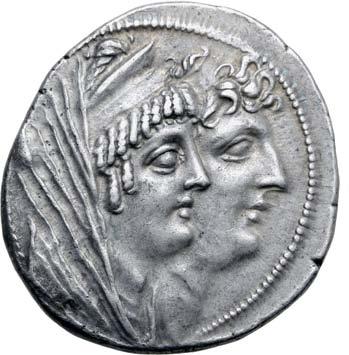

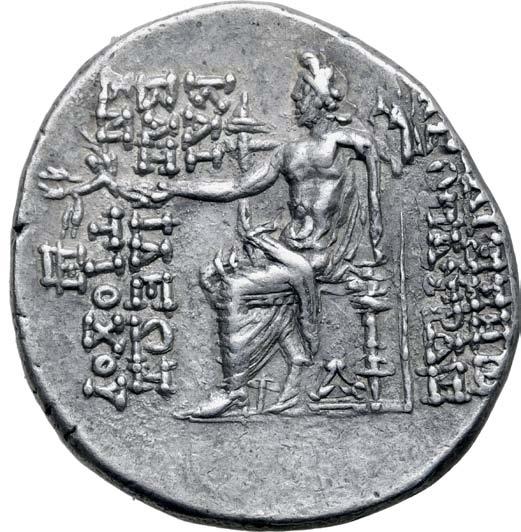
Seleukid Empire, Kleopatra Thea and Antiochos VIII AR Tetradrachm. Antioch on the Orontes, circa 122-121 BC. Jugate busts of Kleopatra Thea, draped and wearing diadem and stephane, and Antiochos VIII wearing diadem, to right / Zeus Nikephoros seated to left, holding sceptre; [ΒΑΣΙΛΙ] ΣΣΗΣ KΛΕΟΠΑΤΡΑΣ to right, KAI ΒΑΣΙΛΕΩΣ ANTIOXOY
Extremely Fine.
Ex Historical Scholar Collection; Ex Roma Numismatics Ltd., Auction VIII, 28 March 2014, lot 716.
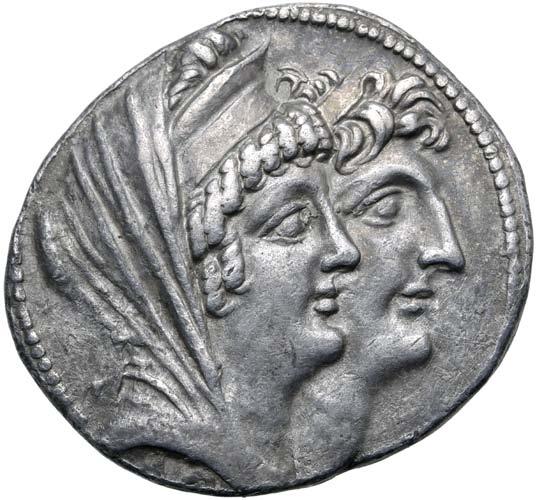
300.
Near Extremely Fine; attractive light cabinet tone.


Ex Roma Numismatics Ltd., Auction XXV, 22 September 2022, lot 518 (hammer: GBP 1,500).
1,050 No Reserve

600 No Reserve
301.



Seleukid Empire, Seleukos VI Epiphanes Nikator AR Drachm. Antioch on the Orontes, Circa 96-94 BC. Diademed head to right / Nike advancing to left, holding wreath; [B]AΣIΛEΩΣ ΣEΛEYKOY to right, NIKATOPOΣ to left, monogram above A in left field, C in inner left field. SC 2416; SMA 427; HGC 9, 1273. 3.78g, 18mm, 12h.
Extremely Fine; light cabinet tone, some mineral adhesions. Very Rare.
Ex Roma Numismatics Ltd., Auction XXVII, 22 March 2023, lot 395.
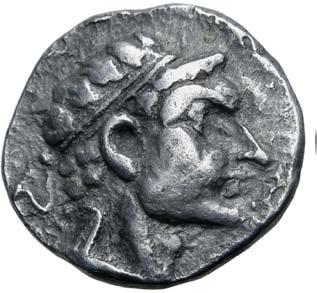
302.


Kings of Elymais, Kamnaskires II Nikephoros AR Drachm. Circa 145-139 BC. Diademed head to right; monogram(?) behind / Apollo Delphios seated to left on omphalos, holding arrow and resting hand on bow; BAΣIΛE[ΩΣ] KAMNA NIKE. van’t Haaff 2.1.2-3 var. (rev. legend). 3.87g, 17mm, 12h.
Very Fine. Extremely Rare.
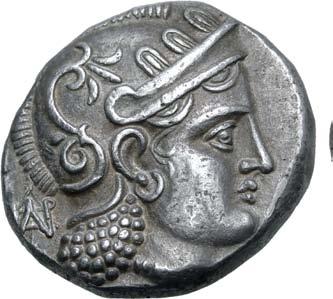
303.
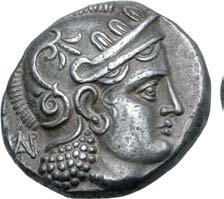


Parthia(?), ‘Athenian Series’ AR Didrachm. Hekatompylos(?), circa 246/5-239/8 BC. Attic standard. Head of Athena to right, wearing earring, necklace, and crested Attic helmet decorated with three olive leaves over visor and a spiral palmette on the bowl; monogram of Andragoras(?) behind / Owl standing to right, head facing; behind, prow and grape bunch on vine with leaf, AΘE before. Roma XIV, 331; Bopearachchi, Sophytes Series 1A; SNG ANS 6; N&A 43-45; HGC 12, 3. 8.06g, 18mm, 7h.
Extremely Fine.
Ex Roma Numismatics Ltd., Auction XXIII, 24 March 2022, lot 400; Ex 1960s Andragoras-Sophytes Group, present in Germany in 1975, subsequently exported to the USA.

304.
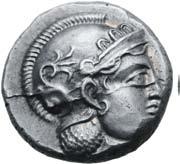


Parthia(?), ‘Eagle Series’ AR Drachm. Hekatompylos(?), circa 246-238 BC. Local standard. Head of Athena to right, wearing earring, necklace, and crested Attic helmet decorated with three olive leaves over visor and a spiral palmette on the bowl / Eagle standing to left, head to right; behind, grape cluster on vine with leaf, kerykeion above. Roma XIV, 335; Bopearachchi, Sophytes Series 2A; SNG ANS -; Mitchiner 26d; N&A 63-4; HGC 12, 8. 3.56g, 14mm, 6h.
Mint State; minor obv. die break, attractive hints of iridescence around devices.
Ex Roma Numismatics Ltd., Auction XXVII, 22 March 2023, lot 410; From the 1960s Andragoras-Sophytes Group, present in Germany in 1975, subsequently exported to the USA.
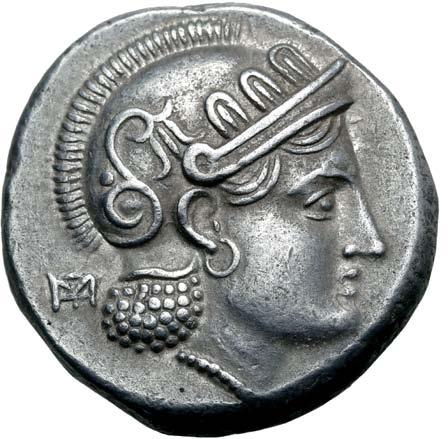
305.

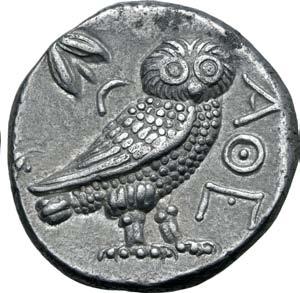
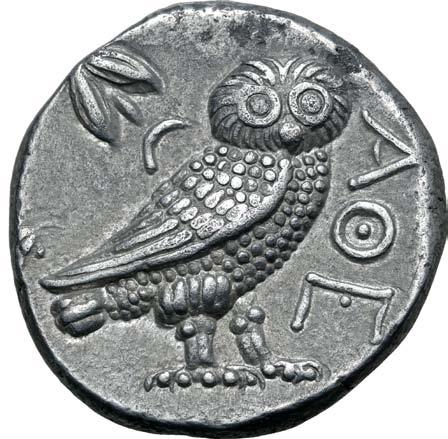
Baktria, ‘Athenian Series’ AR Tetradrachm. Uncertain mint in the Oxus region, circa 261-239/8 BC. Attic standard. Head of Athena to right, wearing earring, necklace, and crested Attic helmet decorated with three olive leaves over visor and a spiral palmette on the bowl; monogram behind / Owl standing to right, head facing; olive sprig and crescent behind, grape bunch over tail, AΘE before. Roma XIV, 354; Bopearachchi, Sophytes Series 1A; Mitchiner
About Extremely Fine.
Ex Roma Numismatics Ltd., Auction XVII, 28 March 2019, lot 593; Ex the 1960s Andragoras-Sophytes Group, present in Germany in 1975, subsequently exported to the USA.

306.
600 No Reserve
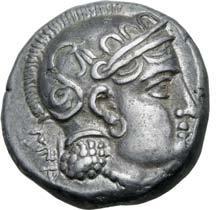
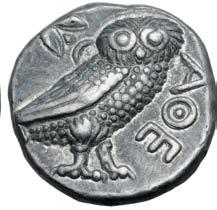

Baktria, ‘Athenian Series’ AR Didrachm. Uncertain mint in the Oxus region, circa 261-239/8 BC. Attic standard. Head of Athena to right, wearing earring, necklace, and crested Attic helmet decorated with three olive leaves over visor and a spiral palmette on the bowl; MNA behind / Owl standing to right, head facing; olive sprig and crescent behind, AΘE before. Roma XIV, 349; Bopearachchi, Sophytes -; Mitchiner -; SNG ANS -; N&A -, cf. 1819 (tetradrachms); CNG E-115, 180 (misdescribed). 8.13g, 18mm, 6h.
Extremely Fine. Very Rare.
Ex Roma Numismatics Ltd., Auction XVII, 28 March 2019, lot 592; Ex the 1960s Andragoras-Sophytes Group, present in Germany in 1975, subsequently exported to the USA.
600 No Reserve
The appearance of the letters MNA on their own, not preceded by ΣTA, which also appear in abbreviated form as MN and M, both on this ‘Athenian Series’ coinage and on the helmeted portrait issues of Sophytes, is suggestive of MNA being either a magistral mark, or an engraver’s signature. While the prominent placement of MNA on both the double daric and the tetradrachm would seem to be counter-indicative of its being a signature because of its brazen size and obtrusiveness, on the helmeted portrait coins of Sophytes it is very discreetly placed on the bust truncation. The fact that it is so well hidden (and on the tetradrachms, abbreviated simply to ‘M’) very strongly argues against it being a magistrate or subordinate official’s name. The Baktrian ‘Athenian series’ coinage, judging from its lack of wear, must have been issued immediately prior to or concurrent to Sophytes’ named coinage.



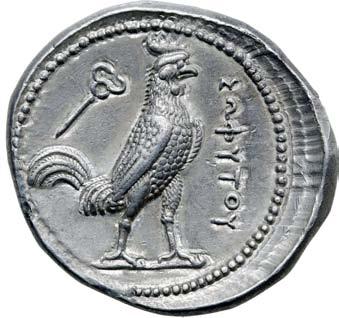

Baktria, Sophytes AR Tetradrachm. Uncertain mint in the Oxus region, circa 246/5-235 BC. Attic standard. Head of Seleukos(?) to right, wearing laurel wreathed Attic helmet decorated with spiral pattern on crest and eagle wings on cheek-guard; no letters on bust truncation / Cockerel standing to right; kerykeion behind, ΣΩΦYΤΟΥ to right. Jansari 70 var. (O1/R-), cf. 72 (O-/R1): an apparent hybrid of dies with a Sophytes(?) obv. and a reverse previously known with Athena obv.; cf. Bopearachchi, Sophytes Series 3A, pl. I, 1; for type cf. SNG ANS 21-23 (drachm); Mitchiner 29 (drachm); Whitehead NC 1943, pp. 64, 1 and pl. III, 7-8 (drachm). 16.72g, 28mm, 7h.
Good Extremely Fine; a bold and expressive portrait engraved in the finest Hellenistic style. Extremely Rare.
Ex Roma Numismatics Ltd., E-Live Auction 4, 29 November 2018, lot 452 (hammer: GBP 19,000); Ex 1960s Andragoras-Sophytes Group, present in Germany in 1975, subsequently exported to the USA.
6,000
This portrait, which has all too often been simply assumed to be that of Sophytes himself, is eminently worthy of further scrutiny. It is the work of a highly talented individual, and depicts what should by any account be a great general, helmeted in Attic style and wearing the laurel wreath of a conqueror. Unfortunately the actions of Sophytes, whatever they might have been, were either not recorded or have long since been lost. We cannot therefore determine whether this individual may indeed have performed such deeds as to be worthy of commemoration in such a fashion. In examining the features of the individual depicted on this coin however, it becomes immediately apparent that there are distinct similarities with certain idealised portraits of Seleukos I. It is conceivable that we should see in this portrait not an image of the unknown ruler Sophytes, but an idealised image of the deified Seleukos, as can be found on the somewhat earlier coinage of Philetairos. Those images (cf. in particular Gulbenkian 966) have nearly identical features - in particular the heavy brow, aquiline nose, down-turned mouth and prominent chin.
The historical sources offer us few clues as to the dating of Sophytes’ rule. They tell us that Stasanor was satrap of Baktria until at least 316 BC, and that Seleukos reintegrated Baktria into his empire on his eastern anabasis in c. 305. An early date therefore seems highly unlikely. Turning to the evidence of the coin itself, numismatists have correctly observed that the obverse portrait is derived from the similar type of Seleukos on his trophy tetradrachms (SC 174), which should be dated to after c. 301 BC; the presence of the somewhat worn elephant-quadriga tetradrachm in the present group pushes the date even further to the right, and into the third century. Now, the presence of this type in this group along with coins of Andragoras indicates a considerably later date than previously supposed. We have already proposed with good reason that the coinage of Andragoras should be dated to c.246/5-239/8 BC and that given the patterns of wear that may be observed upon them, there is sufficient justification to argue for the dating of Sophytes’ named coinage to c. 246/5-235, after Andragoras had begun coining but before Diodotos II would have been free to dispose of any lesser regional powers. This turbulent time period has already afforded us a plausible reason for the striking of Andragoras’ coinage. It is possible that Sophytes too was prompted to look to the security of his own territory following the effective withdrawal of the central government’s influence in that area. Diodotos I too struck his own coinage in Baktria, which while bearing his own portrait on the obverse nevertheless maintained the name ‘Antiochos’ on the reverse as a token symbol of loyalty. Does Sophytes coinage, with a distinctly ‘local’ reverse type, seek to achieve the same veneer of loyalty as that of Philetairos and Diodotos by placing the image of Seleukos I, the founder of the Seleukid empire, on his obverse?

308.

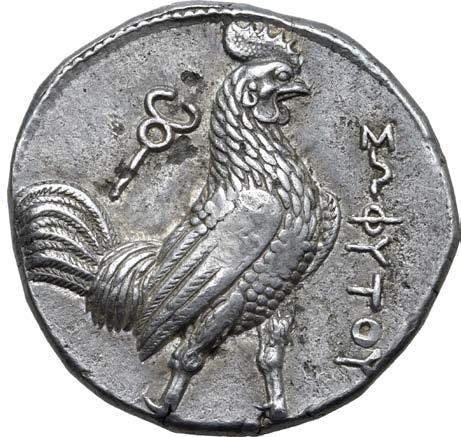

Baktria, Sophytes AR Tetradrachm. Uncertain mint in the Oxus region, circa 246/5-235 BC. Attic standard. Head of Seleukos(?)
wearing laurel wreathed Attic helmet decorated with spiral pattern on crest and eagle wings on
M on bust truncation / Cockerel standing
kerykeion behind, ΣΩΦYΤΟΥ to right. Jansari 71 (O2/R2) = Roma XV, 348 (same dies); cf. Bopearachchi, Sophytes Series 3A, pl. I, 1; for type cf. SNG ANS 21-23 (drachm); Mitchiner 29 (drachm); Whitehead NC 1943, pp. 64, 1 and pl. III, 7-8 (drachm); Roma XIV, 365 var. (no M under truncation). 17.04g, 25mm, 6h.
Extremely Fine; light flatness on rev. but otherwise a very pleasant example of this highly desirable type, with a pleasant light cabinet tone. Extremely Rare.
Ex Roma Numismatics Ltd., E-Sale 58, 20 June 2019, lot 401 (hammer: GBP 16,000); Ex 1960s Andragoras-Sophytes Group, present in Germany in 1975, subsequently exported to the USA.




309.
Baktria, Sophytes AR Drachm. Uncertain mint in the Oxus region, circa 246/5-235 BC. Attic standard. Head of Seleukos(?) to right, wearing laurel wreathed Attic helmet decorated with spiral pattern on crest and eagle wings on cheek-guard; M on bust truncation / Cockerel standing to right; kerykeion behind, ΣΩΦYΤΟΥ to right. Jansari 47 (O26/R33, this coin); Bopearachchi, Sophytes Series 3A, pl. I, 3; SNG ANS 21-23; Mitchiner 29b; HGC 12, 14. 3.86g, 16mm, 6h.
Near Mint State. Very Rare.
This coin published in S. Jansari, ‘The Sophytes Coins: from the Punjab to Bactria and back again’, in NC 2018; Ex Roma Numismatics Ltd., Auction XXIII, 24 March 2022, lot 411 (hammer: GBP 4,000);
Ex Long Valley River Collection, Roma Numismatics Ltd., Auction XX, 29 October 2020, lot 339;
Ex Roma Numismatics Ltd., Auction XV, 5 April 2018, lot 350;
Ex 1960s Andragoras-Sophytes Group, present in Germany in 1975, subsequently exported to the USA.
310.
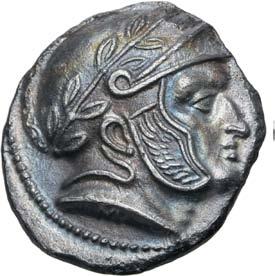
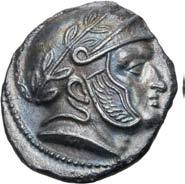
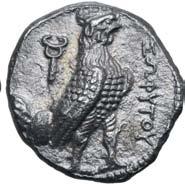

Baktria, Sophytes AR Drachm. Uncertain mint in the Oxus region, circa 246/5-235 BC. Attic standard. Head of Seleukos(?) to right, wearing laurel wreathed Attic helmet decorated with spiral pattern on crest and eagle wings on cheek-guard; M on bust truncation / Cockerel standing to right; kerykeion behind, ΣΩΦYΤΟΥ to right. Jansari 13-52; Roma XIV, 367 var. (MNA on bust truncation); Bopearachchi, Sophytes Series 3A, pl. I, 3; SNG ANS 21-24; Mitchiner 29a; cf. Whitehead NC 1943, pp. 64, 1 and pl. III, 7-8; HGC 12, 14. 3.61g, 16mm, 6h.
Good Extremely Fine; iridescent cabinet tone. Very Rare.
Ex Roma Numismatics Ltd., Auction XXII, 7 October 2021, lot 456.
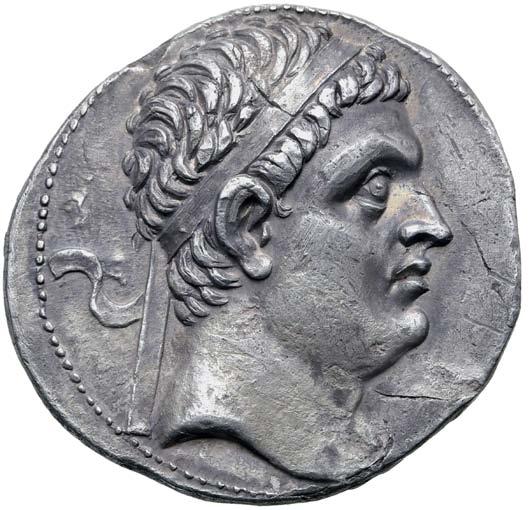

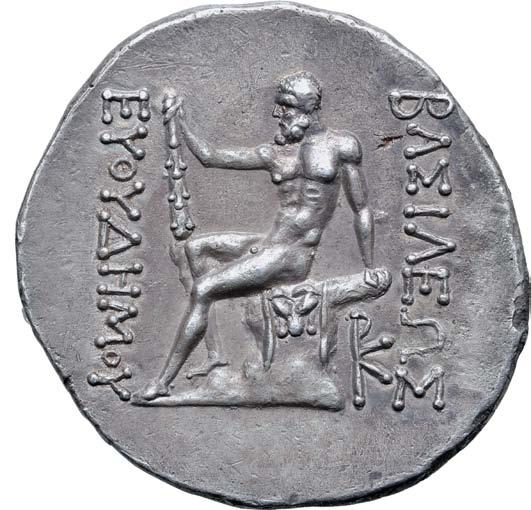
311.
Greco-Baktrian Kingdom, Euthydemos I Theos Megas AR Tetradrachm. Mint B (“Baktra”), circa 215-210 BC. Diademed head to right / Herakles seated to left on lion skin draped over rocks, holding club set on right leg; BAΣIΛEΩΣ and monogram to right, EYΘYΔHMOY to left. Glenn, Group IV (O94/R- [unlisted rev. die]); Kritt B13; Bopearachchi 9A; SNG ANS 136; HGC 12, 42. 16.36g, 30mm, 11h.
Good Extremely Fine; minor planchet flaws, attractive cabinet tone.
Ex JTB Numismatic Collection (collector’s ticket included), Roma Numismatics Ltd., Auction XXV, 22 September 2022, lot 544 (hammer: GBP 3,200);
Ex Lampasas Collection, Classical Numismatic Group, Electronic Sale 484, 27 January 2021, lot 471;
Ex Peter K. Tompa Collection, Classical Numismatic Group, Auction 112, 11 September 2019, lot 396; Acquired from Frank Kovacs, 19 November 2004.

312.


Greco-Baktrian Kingdom, Eukratides I Megas AR Drachm. Circa 170-145 BC. Diademed and draped bust to right / The Dioskouroi on horses prancing to right, each holding spear and palm; ΒΑΣΙΛΕΩΣ
Good Extremely Fine. Scarce.
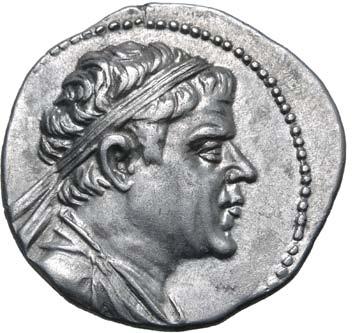
313.
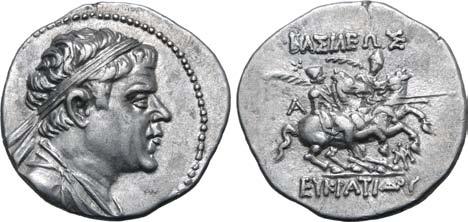


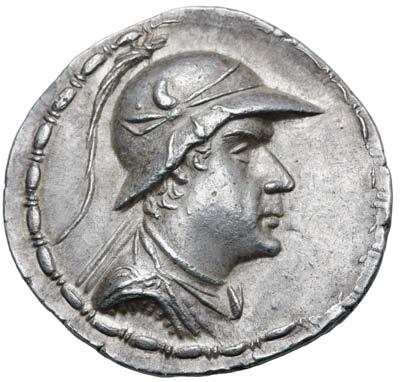


314.
Greco-Baktrian Kingdom, Eukratides I Megas AR Tetradrachm. Circa 170-145 BC. Diademed and draped bust to right, wearing crested helmet adorned with bull’s horn and ear / The Dioskouroi on horses prancing to right, each holding spear and palm; ΒΑΣΙΛΕΩΣ ΜΕΓΑΛΟΥ above, ΕΥΚΡΑΤΙΔΟΥ below, monogram in right field. Bopearachchi 6E; Mitchiner 177ee; SNG ANS 465; HGC 12, 131. 17.00g, 33mm, 12h.
Good Extremely Fine; flan slightly bent, highly lustrous and lightly toned.
Ex Roma Numismatics Ltd., E-Sale 102, 3 November 2022, lot 578.
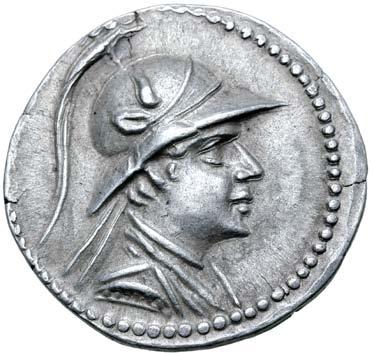
315.
450
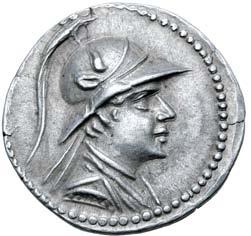


Greco-Baktrian Kingdom, Eukratides I Megas AR Drachm. Circa 170-145 BC. Diademed and draped bust to right, wearing crested helmet adorned with bull’s horn and ear / The Dioskouroi on horses prancing to right, each holding spear and palm; ΒΑΣΙΛΕΩΣ ΜΕΓΑΛΟΥ above, ΕΥΚΡΑΤΙΔΟΥ below, monogram in lower left field. Bopearachchi 7J; Bopearachchi & Rahman -; Mitchiner 178d; SNG ANS 483; HGC 12, 136. 4.25g, 20mm, 12h.
Good Extremely Fine.




316.
Greco-Baktrian Kingdom, Eukratides I Megas, with Heliokles and Laodike, AR Tetradrachm. Circa 170-145 BC. Dynastic pedigree issue. Jugate draped busts of Heliokles and Laodice to right, HΛIOKΛEOYΣ above, KAI ΛAOΔIKHΣ below; monogram behind / Diademed and draped bust to right, wearing crested helmet adorned with bull’s horn and ear, BAΣIΛEYΣ MEΓAΣ above, EYKPATIΔHΣ below. Bopearachchi 15A; Bopearachchi & Rahman 263; Mitchiner 182a; SNG ANS 526-527; HGC 12, 133. 16.94g, 32mm, 12h.
Good Extremely Fine. Rare, and in outstanding condition for the type.
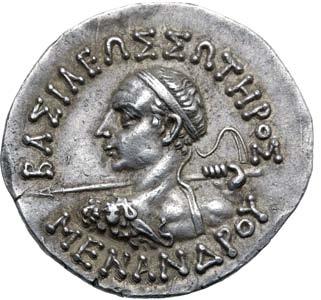


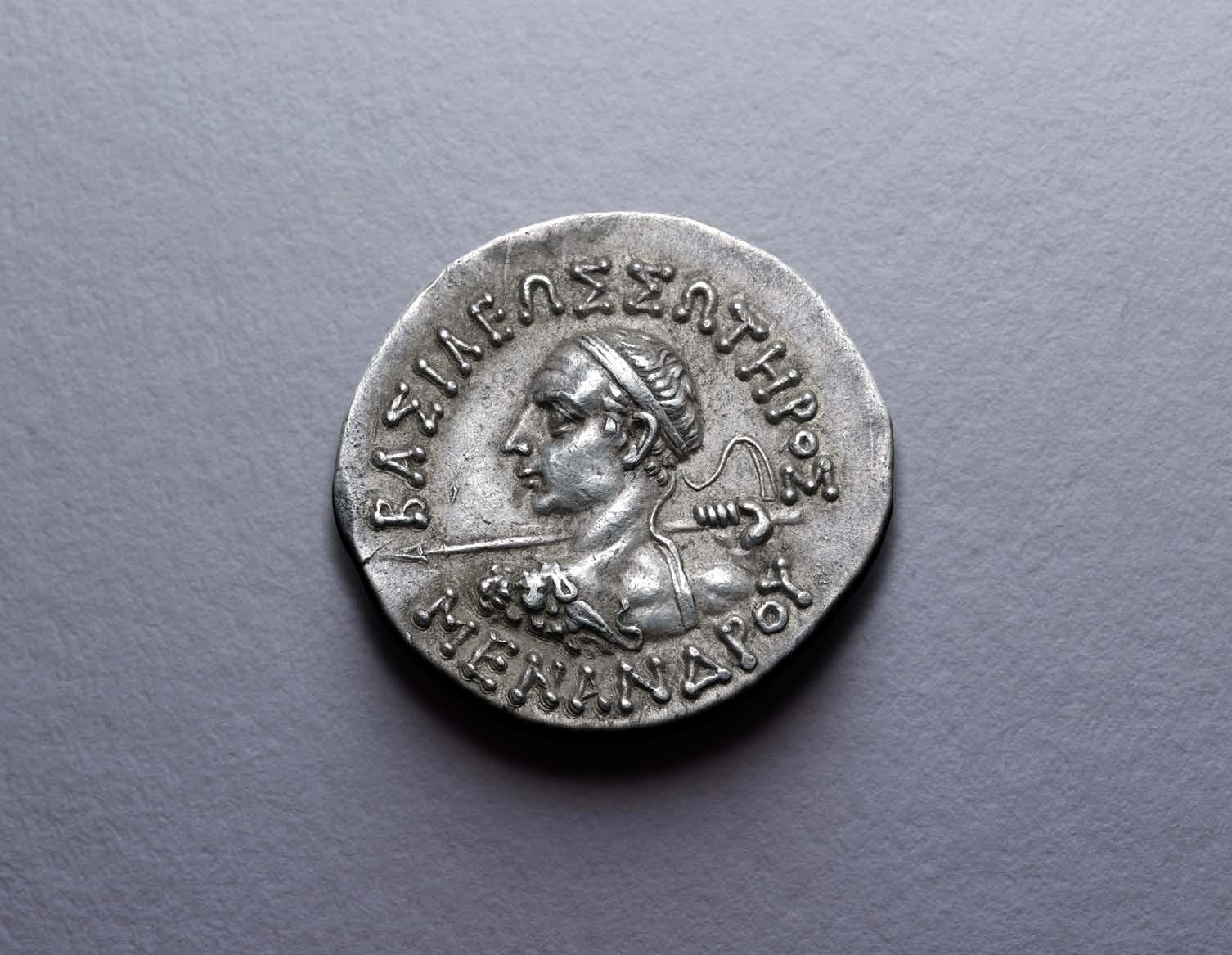
Indo-Greek Kingdom, Menander I Soter AR Tetradrachm. Circa 165/55-130 BC. BAΣIΛEΩΣ ΣΩTHPOΣ MENANΔPOY, diademed heroic bust to left, seen from behind, wearing aegis over shoulder, brandishing spear / ‘Maharajasa tratarasa Menamdrasa’ in Kharosthi, Athena Alkidemos standing to left, wielding thunderbolt and shield; monogram to right. Bopearachchi 8C = Mitchiner 219a; Bopearachchi & Rahman 322; SNG ANS -; HGC 12, 180; Roma E-18, 562 = Roma E-23, 257 = Roma E-30, 202; CNG e399, 321; CNG e443, 206; CNG e461, 248. 9.88g, 26mm, 12h.
Good Extremely Fine; a bold portrait, beautiful old cabinet tone. Extremely Rare; only one example known to both Bopearachchi and Mitchiner, only a handful of examples on CoinArchives, and undoubtedly the finest known.
Ex Rubellite Collection, Roma Numismatics Ltd., Auction XXIII, 24 March 2022, lot 450 (hammer: GBP 6,000).
The origins of the Indo-Greek Kingdom can be traced all the way back to the time of Alexander the Great, who famously led his armies as far as North West India and conquered large parts of the region in 326 BC. After Alexander’s death, his empire fragmented and the Indian territories fell under the rule of the emperor Chandragupta, founder of the Mauryan empire, until 185 BC when it was toppled by Pushyamitra Shunga, founder of the Shunga Empire. There followed several incursions by Greco-Baktrian kings into India, the most significant of which was by Menander I Soter, who Strabo highlights as having advanced further than his predecessors and subdued more peoples (Geographica, 11.11.1) and is therefore widely considered to be the most important of the Indo-Greek kings.
Save for a very limited account by Strabo, the literary record of Menander ’s military endeavours is scant, with epigraphic and numismatic evidence forming much of the basis of modern understanding of this part of his life. It seems that he launched several campaigns in the Indian subcontinent, with some sources, notably the Hathigumpha inscription, stating that his troops reached as far East as the city of Mathura in modern-day Uttar Pradesh. The precise geographical extent of his empire remains unclear and it is certainly possible that the borders fluctuated throughout his rule, but the few sources all corroborate the view that he ruled a large area of North West India for between 25 to 35 years. The prosperity of his dominions is attested by the preponderance of coinage, the find-locations of which have also helped to somewhat illuminate the boundaries of his empire. The numismatic record could also be seen to hint at his style of leadership, with the large majority of issues exemplifying bilingual legends, in both Greek and Kharosthi, as is the case here. This is perhaps an indication that he placed emphasis on integration and unity with the peoples over whom he ruled.
This view is further supported by accounts of his religious life, which by contrast with the lack of detail of his military achievements, is expounded upon in great depth in the Buddhist text the Milinda Panha, which relates a dialogue (real or imagined) between the Buddhist sage Nagasena and Menander himself - ‘Milinda’ being the translation of Menander into the Buddhist liturgical script of the time, Pali. Buddhist tradition has it that Menander converted to Buddhism and the Milinda Panha, which likely dates to after his death, is a retelling of the conversation he had with the sage when the ruler asked many questions about the faith, at the end of which he made the decision to convert. A decision which undoubtedly ingratiated him with the many Buddhist populations who lived in his empire.
319.



Kushano-Sasanians, temp. Ardaxšīr (Ardashir) - Pērōz (Fīrūz) I AV Dinar. In the name of Vasudeva I. Uncertain Baktrian mint, AD 230-270. King standing facing, nimbate, diademed and crowned, head to left, sacrificing over altar and holding trident; flames at shoulder, filleted trident and symbol to left, swastika between legs, nandipana to right / Ithyphallic Siva standing facing, holding diadem and trident; behind, the bull Nandi standing to left; tamgha and pellet to upper left, OHPO to right. MK 692 (O92/R5, Vasudeva II); ANS Kushan 1698 corr. (swastika not mentioned in text); Donum Burns 474. 8.08g, 27mm, 12h.
Mint State.
Acquired from Pars Coins, San Jose CA.

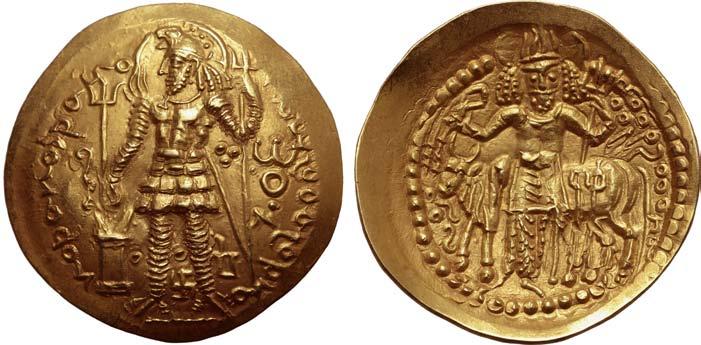

320.
Kushano-Sasanians, Pērōz (Fīrūz) I AV Dinar. Baktrian mint (Balkh?), AD 245-270. King standing facing, head to left, wearing lion-head crown, flames at shoulders, sacrificing over altar and holding trident; trident to left, pellet to right of altar, pellet over swastika between legs, Brahmi ‘pe’ to right of leg, three pellets below left arm, tamgha and N to right / Exalted god standing facing, holding diadem with ribbons and trident; behind, the bull Nandi standing to
MK 706
-;
Burns -; CNG Triton XVIII, 866 (same obv. die). 7.86g, 29mm, 12h.
Mint State. Very Rare; only two recorded by Göbl, seemingly only one other on CoinArchives.
Ex Roma Numismatics Ltd., Auction XXIII, 24 March 2022, lot 483.
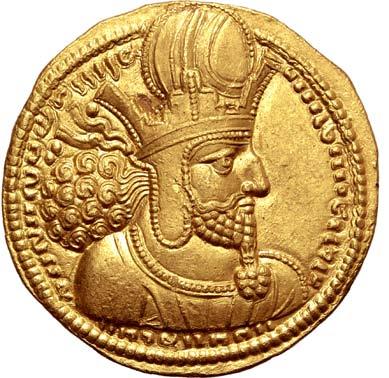
321.
Mint State.
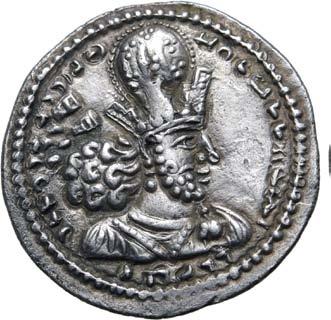
322.
Good Extremely Fine. Extremely Rare. Acquired from Pars Coins, San Jose CA.

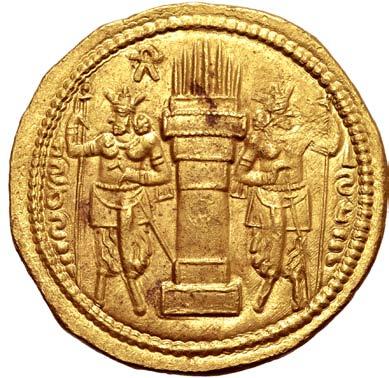


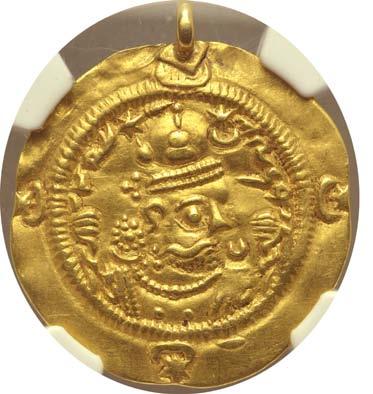
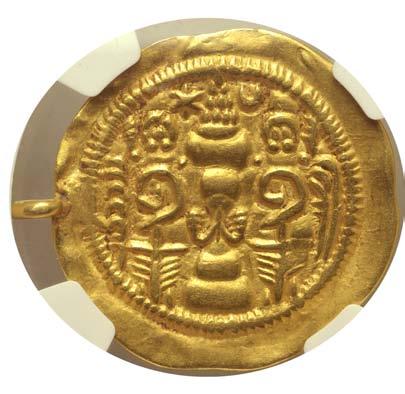

323.
NGC graded Ch XF 5/5 - 1/5, mounted (#6833714-002). Seemingly unique and unpublished, with no other gold coins known for Hormizd IV
6,000 No Reserve
Very Rare
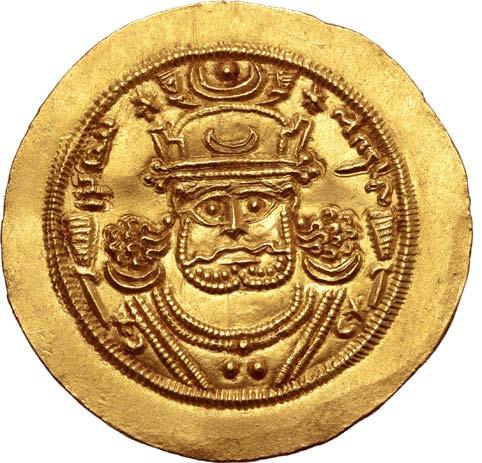



324.
Near Mint State. Very Rare.
2,400 No Reserve


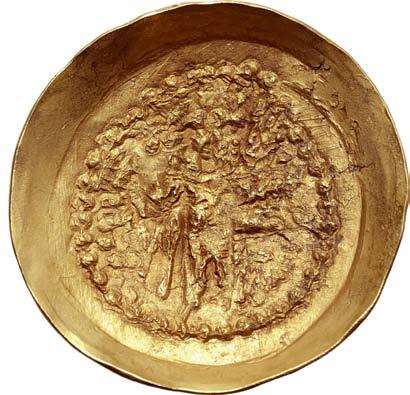
325.
Kidarite Huns, temp. Kidara AV Dinar. In the name and types of Vahrām (Bahram) I Kushanshah. Boxlo (Balkh) mint, circa AD 350-365. King standing facing, wearing lotus crown with ribbons, head to left, sacrificing over altar and holding trident; flames at shoulders, filleted trident to left, middle prong surmounted by crescent, Brahmi ‘ba’ over Kidarite tamgha and rosette of seven pellets in right field / Siva standing facing, holding diadem and trident; behind, the bull Nandi standing to left. Cribb, Kidarites 6C; MK 735; ANS Kushan -. 7.54g, 34mm, 12h.
Mint State; typically blundered reverse, otherwise a tremendous example.
Ex Roma Numismatics Ltd., E-Live Auction 5, 27 September 2022, lot 454; Ex Roma Numismatics Ltd., Auction XXII, 7 October 2021, lot 519.

326.
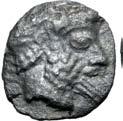
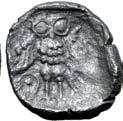
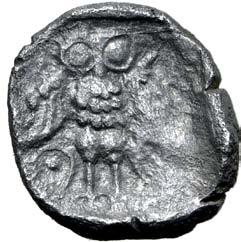
Philistia (Palestine), uncertain mint AR Obol. Gaza(?), circa 450-333 BC. Laureate and bearded male head (Ba’al Arwad) to right / Owl standing facing, wings spread; olive spring and crescent to upper left, AΘE around; all within incuse square. Gitler & Tal pg. 204, XIV, 290 var.
Sofaer
Extremely Fine. Extremely Rare.
Ex Roma Numismatics Ltd., Auction XXIII, 24 March 2022, lot 508.

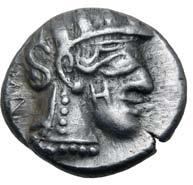

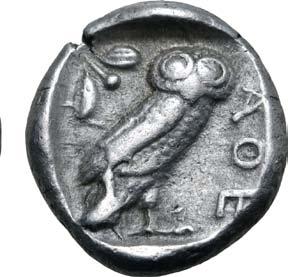
327.
300
lot. 328.
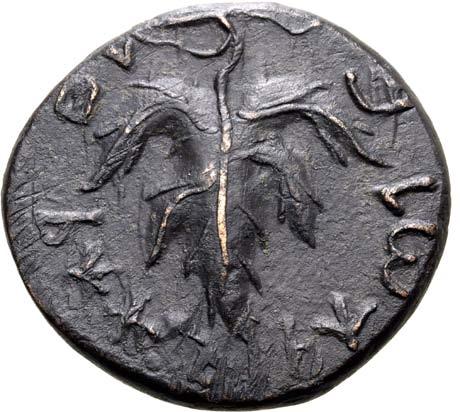


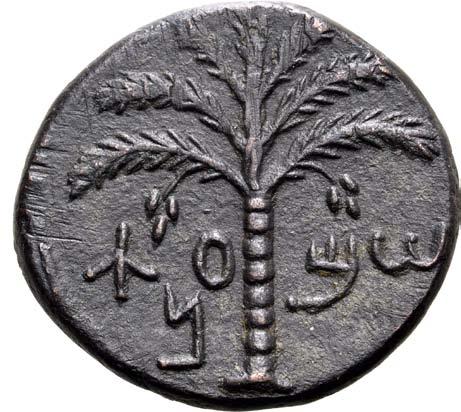
330.
Good Extremely Fine.
Ex Roma Numismatics Ltd., E-Sale 103, 24 November 2022, lot 705.

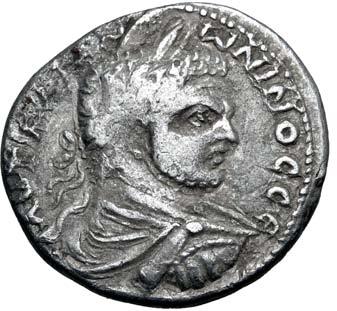



332.




Q. Hortensius Hortalus Æ 25mm of Cassandrea or Dium, Macedon. Struck as Proconsul, circa 43-42 BC. Q HORTENSI PRO • COS, bare head to right / PRAEF COLONI • DEDVC, ox yoke, plough and measuring rod(?) with vexillum. S. Kremydi-Sicilianou, The Coinage of the Roman Colony of Dion, Biblioteca 4 of the Hellenic Numismatic Society, Athens 1996, p. 257, 1-8 and pl. 32; RPC I 1509.24 (this coin); FITA, p. 33. 13.91g, 25mm, 12h.
Good Very Fine. Extremely Rare.
This coin published at Roman Provincial Coinage Online (rpc.ashmus.ox.ac.uk); Ex Roma Numismatics Ltd., Auction XXI, 24 March 2021, lot 371 (hammer: 2,600 GBP).

333.
No Reserve
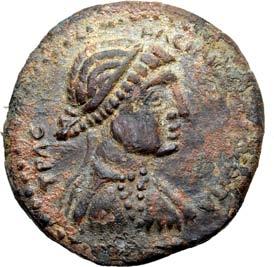


Marc Antony and Cleopatra VII Æ 23mm of Chalcis, Seleucis and Pieria. Dated RY 21 (Egyptian) and 6 (Phoenician) of Cleopatra = 32/31 BC. BACIΛICCHC KΛЄOΠATPAC, diademed and draped bust of Cleopatra to right / ЄTOYC KA TOY KAI Ϛ ΘЄAC NЄѠTЄPAC, bare head of Marc Antony to right. RPC I 4771; DCA 476; SNG Copenhagen 383 (Phoenicia); HGC 9, 1451. 9.86g, 23mm, 3h.
Extremely Fine; two superb portraits for the type.

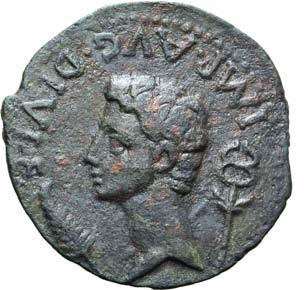

No Reserve

334. 300
Ex Roma Numismatics Ltd., E-Live Auction 1, 25 July 2018, lot 363 (hammer: £800).



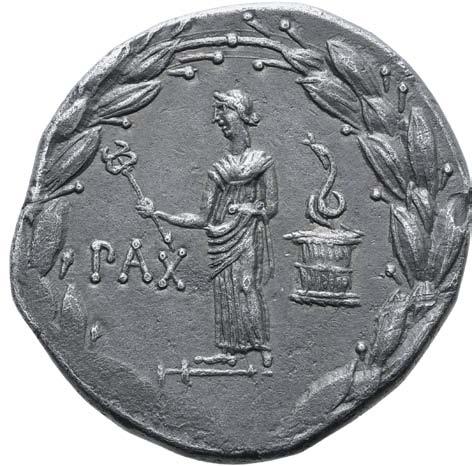
335.
Augustus AR Cistophorus of Ephesus, Ionia. Circa 28-20 BC. IMP•CAESAR•DIVI•F•COS•VI•LIBERTATIS•P•R•VINDEX, laureate head to right / Pax standing to left on parazonium, holding caduceus, snake emerging from cista mystica in right field, PAX in left field; all within laurel-wreath. RPC I 2203; RIC I 476; BMCRE 691; RSC 218. 11.99g, 26mm, 12h.
Good Extremely Fine; beautiful old cabinet tone.
Ex Roma Numismatics Ltd., E-Sale 65, 19 December 2019, lot 565.
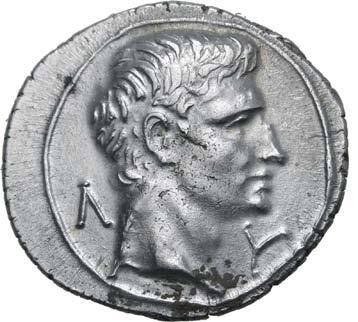
336.



Augustus AR Drachm of Masicytus, Lycia. 27-20 BC. Bare head of Augustus assimilating features of Agrippa to right; Λ-Y across fields / Two citharas; MA below. RPC I 3309; SNG von Aulock -; BMC -; Troxell, Lycian League, 121. 3.44g, 20mm, 12h.
Near Mint State. Very Rare.
Ex Roma Numismatics Ltd., E-Sale 103, 24 November 2022, lot 710.

337.
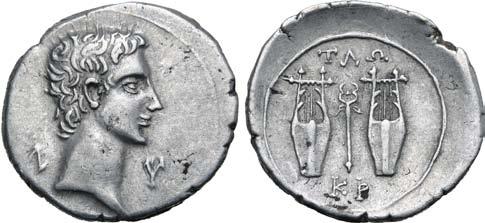

Augustus AR Drachm of Tlos and Kragos, Lycian League. Circa 27-20 BC. Bare head to right; Λ-Y flanking / Two citharas;
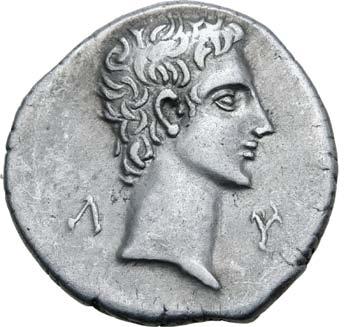
338.
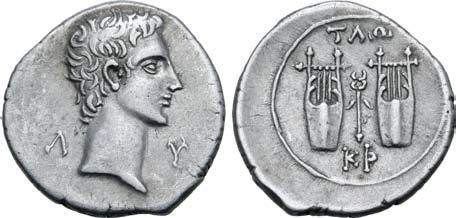

339.

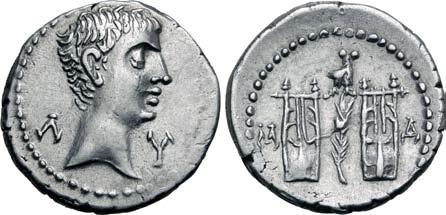
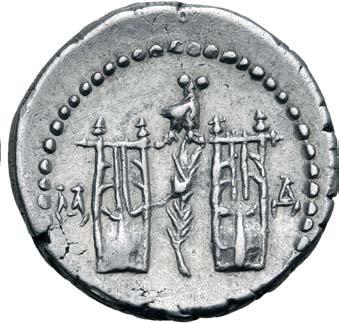
Augustus AR Drachm of Masicytus, Lycian League. 27-20 BC. Bare head to right; Λ-Υ across fields / Two citharas; branch between, owl above, M-A across fields. RPC I 3309c; Troxell, Lycian League, 123. 3.94g, 19mm, 12h.
Good Extremely Fine; a superior example.
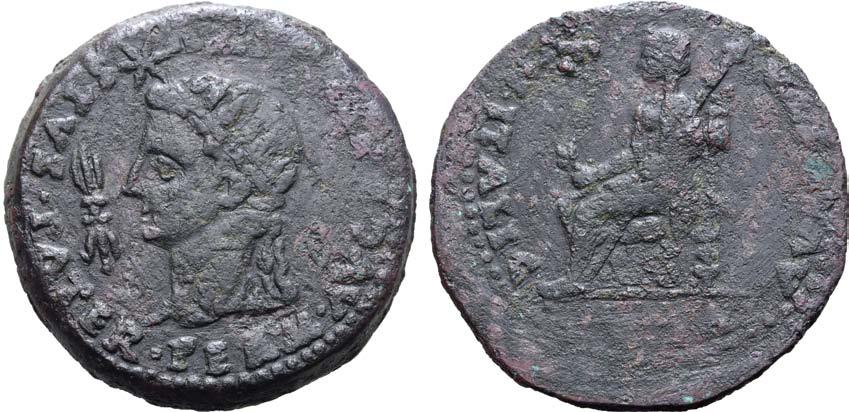
340.
Augustus, with Livia
Near Very Fine.
Ex Roma Numismatics Ltd., Auction IV, 30 September 2012, lot 2011.

341.
(third
Near Very Fine.
of Augustus) Æ “Dupondius”
Emerita,
Ex collection of V.B., United Kingdom, Roma Numismatics Ltd., E-Sale 43, 3 February 2018, lot 307 (hammer: 1,500 GBP).
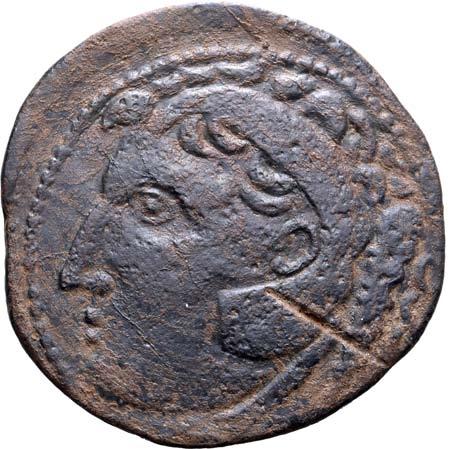

Agrippa Ӕ “Sestertius” of Gades, Hispania. Struck under Augustus, circa 27-12
/ M AGRIPPA
180
60
150

Head of Hercules-Melqart
wearing lion
Very Fine; typical test cut(?) to obv. Extremely Rare; just four specimens cited by RPC Online and a further three found on CoinArchives.
Ex Roma Numismatics Ltd., E-Sale 39, 26 August 2017, lot 2 (hammer: 1,800 GBP).
300
A. Guadàn contends that the marks located on the obverses of all known examples of this issue, at first glance mere test cuts, may in fact be evidence of ‘denominational revaluation’. See p. 18 of ‘Las monedas de Gades’ (Barcelona, 1963) for further deliberations.



343.
Trajan, with Marciana (sister of Trajan), Æ 28mm of Anazarbus, Cilicia. Dated CY 132 = AD 113/4. [ΑΥΤΟ ΚΑΙ ΝЄΡ ΤΡΑΙΑ]ΝΟС СЄ ΓЄΡ ΔΑ, laureate bust to right / [ΚΑΙСΑΡЄ ΠΡ ΑΝ]ΑΖΑΡΒ ΜΑΡΚΙΑΝΗΝ [ΘЄ], draped bust to right; ЄΤ-[ΒΛΡ] (date) across fields. RPC III 3371; Ziegler 107-9; SNG BnF 2022 var. (rev. legend). 9.27g, 28mm, 12h.
Extremely Fine; a highly attractive portrait of Marciana.
Ex Roma Numismatics Ltd., E-Sale 102, 3 November 2022, lot 698.
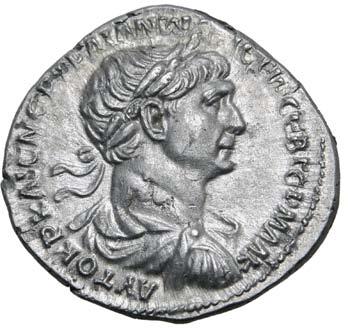
344.
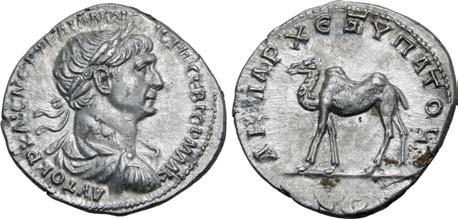
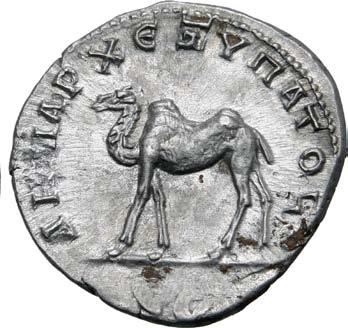
Trajan AR Drachm of Bostra, Arabia. AD 114-116. ΑΥΤΟΚΡ ΚΑΙϹ ΝЄΡ ΤΡΑΙΑΝѠ ΑΡΙϹΤѠ ϹЄΒ ΓЄΡΜ ΔΑΚ, laureate, draped and cuirassed bust to right / ΔΗΜΑΡΧ ЄΞ ΥΠΑΤΟ Ϛ, camel to left. RPC III 4076 (Arabian mint); Sydenham, Caesarea 205; Metcalf 18. 2.87g, 19mm, 7h.
Good Extremely Fine.


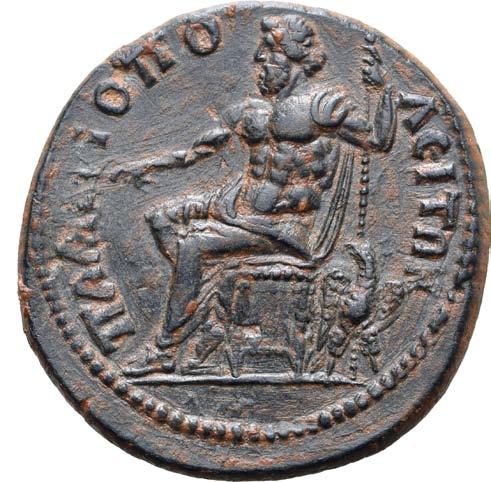
345.
Antoninus Pius Æ 28mm of Palaeopolis, Pisidia. After AD 147. ΑVΤ ΚΑΙ ΑΔΡ ΑΝΤΩΝЄΙΝΟϹ, laureate head to right / ΠΑΛΑΙΟΠΟΛЄΙΤΩΝ, Zeus seated to left, holding thunderbolt and sceptre, eagle facing to lower right, head to left. RPC IV.3 Online 3316 (temporary); Von Aulock, Pisidien I, 1069-85; SNG Copenhagen 172. 10.42g, 28mm, 6h.
Extremely Fine; cleaning marks in fields; struck from dies of wonderful style.
Ex Leu Numismatik AG, Web Auction 20, 16 July 2022, lot 2035; Ex Auktionshaus H. D. Rauch GmbH, Auction 112, 10 June 2021, lot 708.

Antoninus Pius Æ
Alexandria, Egypt.
RY 8 = AD 144/5. ΑVΤ Κ Τ ΑΙΛ ΑΔΡ
Very Fine; an attractive specimen from the Zodiac series, unobtrusive holing. Rare in this condition. This coin published at Roman Provincial Coinage Online (rpc.ashmus.ox.ac.uk);
Ex Giovanni Maria Staffieri Collection, Classical Numismatic Group, Triton XXI, 9 January 2018, lot 125 (hammer: USD 2,250);
Ex Kerry K. Wetterstrom Collection, Classical Numismatic Auctions Ltd., Auction XIII, 4 December 1990, lot 178.

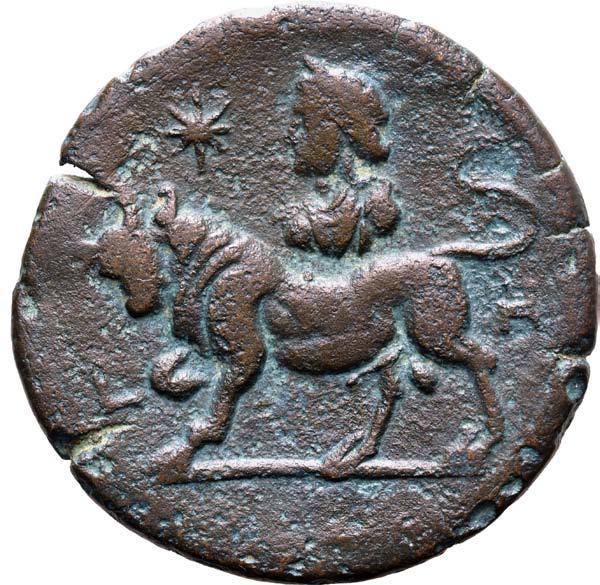

Antoninus Pius Æ Drachm of Alexandria, Egypt. Zodiac series, dated RY 8 = AD 144/5. ΑVΤ Κ Τ ΑΙΛ ΑΔΡ ΑΝΤѠΝΙΝΟϹ ϹЄΒ ЄVϹ, laureate, draped and cuirassed bust to right / Venus in Taurus (night house): bull, with head lowered, butting to left; above, star and draped bust of Aphrodite to left, wearing stephane; L-H (date) across fields. RPC IV.4 Online 864 (temporary); Dattari (Savio) 2959; Emmett 1450. 24.26g, 32mm, 12h.
Near Very Fine. Rare with this bust type.
Ex Roma Numismatics Ltd., Auction XIV, 21 September 2017, lot 422.



348.
Good Very Fine; attractive green patina, perfectly centred. Very Rare. This coin published at Roman Provincial Coinage Online (rpc.ashmus.ox.ac.uk); Acquired from Numisfitz GmbH.

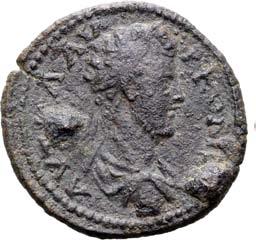

349.
Commodus Æ 21mm of Elaea, Aeolis. AD 191-192. ΑVΤ Κ Λ ΑVΡ ΚOΜ[OΔ..],
Very Fine. Rare, and with a beautiful reverse of sculptural quality.
Ex Roma Numismatics Ltd., E-Sale 93, 28 July 2022, lot 1341.
150 No


347. 60
90
350.




Septimius Severus Æ 22mm of Gythium, Laconia. AD 193-211. ΛΟV CЄΠ CЄOVHPOC, laureate head to right / ΓVΘЄΑΤѠΝ, to left, Herakles standing to right, lion skin over left shoulder, club over right shoulder, holding apples(?); to right, Apollo, standing to right, head to left, holding bow.
BCD Peloponnesos -; BCD Peloponnesos II -; BMC -; Dura -; cf. NCP p. 60 (interesting note on whether the statues of Apollo and Herakles belong to the same group). 5.88g, 22mm, 4h.
Very Fine. Apparently unique.
According to Pausanias, the geographer, the people of Gythium said that their city had no human founder, but that Herakles and Apollo, when they were reconciled after their strife for the possession of the tripod, united to found the city and that in the market-place there were images of both (Description of Greece, III.21.8). Considering that the roman provincial coinage in the Peloponnese during the Severan period used architectural and artistic themes inspired by local monuments, this coin is possibly the only document for the famous sculpture of the two city’s founders at Agora.

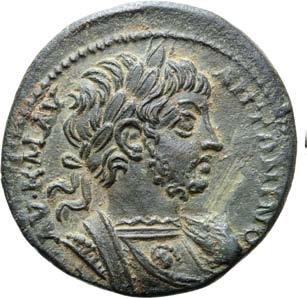

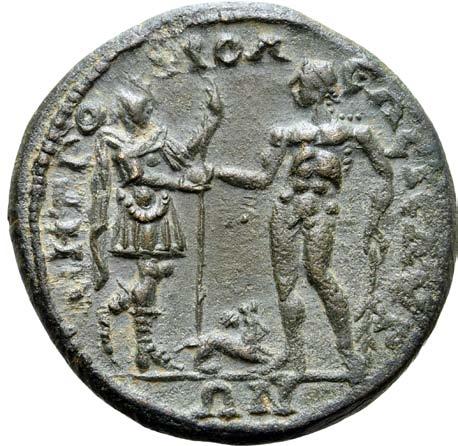
Caracalla Æ 25mm of Isaura, Cilicia. AD 198-217. ΑV Κ Μ ΑV ΑΝΤΩΝΙΝΟC, laureate and cuirassed bust to right, with aegis on breastplate / ΜΗΤΡΟΠΟΛΕΩC ΙCΑΥΡΩΝ, emperor standing to right, holding spear, receiving uncertain object from Apollo standing to left, holding laurel branch, animal recumbent to right, head to left, between them. SNG BnF 494-5 (same obv. die); SNG Levante - (but cf. 262); SNG von Aulock 5410. 9.53g, 25mm, 6h.
Good Extremely Fine; attractive dark green patina. Very Rare.
Ex Leu Numismatik AG, Web Auction 23, 22 August 2022, lot 3657; Ex collection of Regierungsrat Dr. iur. Hans Krähenbühl, Leu Numismatik AG, Auction 8, 23 October 2021, lot 191; Ex Münzen & Medaillen AG, Auction 41, 18-19 June 1970, lot 544.
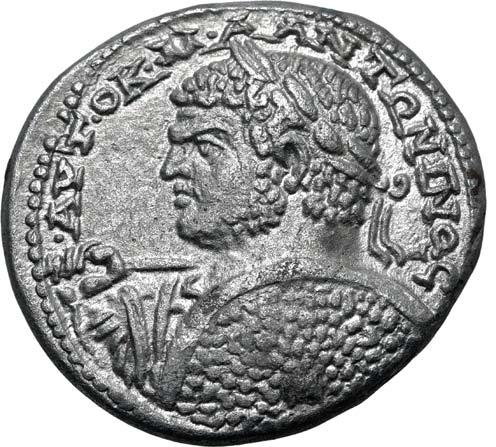
352.



Caracalla AR Tetradrachm of Aradus, Phoenicia. AD 215-217. ΑΥΤΟ K M A ANTΩNINOC, laureate and cuirassed bust to left, holding spear and eagle-tipped sceptre / ΔΗΜΑΡ ЄΞ ΥΠΑΤΟCTΔ, eagle standing facing, wings spread, head to right, wreath in beak; crescent between legs. Prieur 1257; CNG 443, 375 (hammer: 1,200 USD). 12.25g, 27mm, 12h.
Near Extremely Fine. Extremely Rare; only two known to Prieur, and only one other example on CoinArchives. Ex Roma Numismatics Ltd., E-Sale 104, 15 December 2022, lot 704.
353.
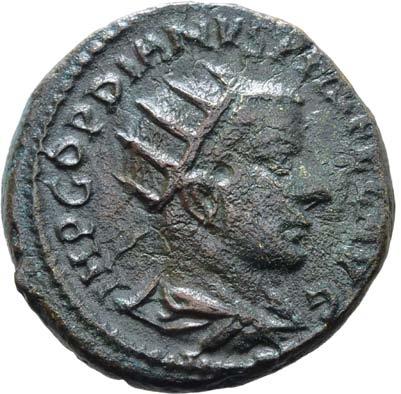

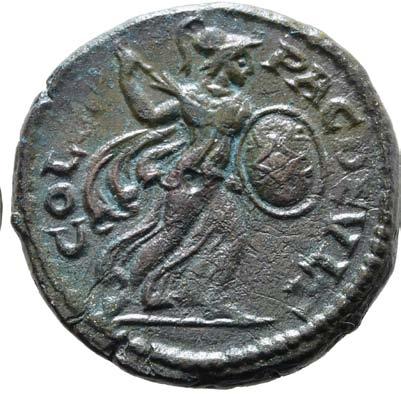
Gordian III Æ 22mm of Deultum, Thrace. AD 241-242. IMP GORDIANVS PIVS FEL AVG, radiate, draped and cuirassed bust to right / COL PAC DEVLT, Minerva advancing to right, brandishing spear and holding shield. RPC VII.2 942; Jurukova 327. 8.22g, 22mm, 8h.
Good Very Fine.
Ex Roma Numismatics Ltd., E-Sale 103, 24 November 2022, lot 806.




354.
Gordian III, with Tranquillina, Æ 28mm of Tomis, Moesia Inferior. AD 238-244. AVT K M ANT ΓOPΔIANOC AVΓ CЄ TPANKVΛΛЄINA, laureate, draped and cuirassed bust of Gordian facing to right towards draped bust of Tranquillina, wearing stephane and facing to left / MHTPOΠONTOV TOMEΩC, griffin sitting to right, resting forepaw upon wheel to right; Δ-C across fields. RPC VII.2 1691; AMNG I.2, 3553; Varbanov 5688. 11.54g, 28mm, 7h.
Extremely Fine.
Ex Roma Numismatics Ltd., E-Sale 102, 3 November 2022, lot 755.

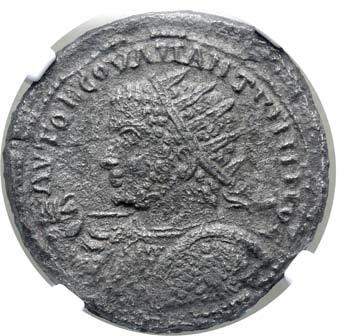


355.
Uranius Antoninus BI Tetradrachm of Emesa, Seleucis and Pieria. AD 253-254. AVTOK K COVΛΠ ANTѠNINOC, radiate and cuirassed bust to left, wearing balteus, holding spear and shield decorated with Victory holding wreath / ΔHMAPX ЄΞ O[VCIAC], eagle standing facing with wings spread, head to left holding wreath in beak; S-C across fields, ЄM[ICA] in exergue. RPC IX 1872; Prieur 1043; Baldus II, 14-5. 9.43g. NGC graded AU 5/5 - 1/5 (#5770904-004).
Ex Heritage World Coin Auctions, ANA Signature Sale 3094, 19 August 2021, lot 34162.
356.
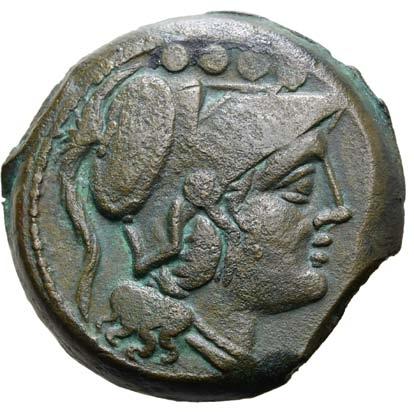
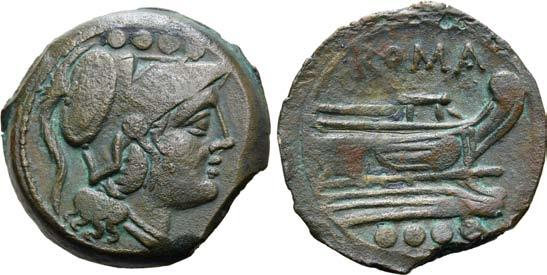
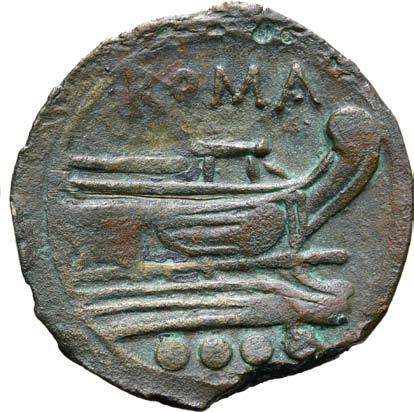
Æ
Good Very Fine.
Ex Roma Numismatics Ltd., E-Sale 101, 13 October 2022, lot 897.

357.
Æ
Extremely Fine.
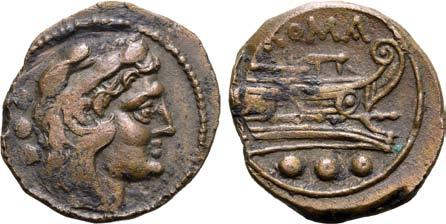
Ex Roma Numismatics Ltd., E-Sale 101, 13 October 2022, lot 904.
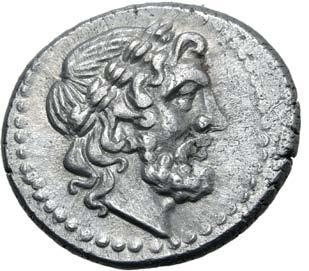
358.

Good Extremely Fine. Previously NGC graded Ch AU (#4374477-186).
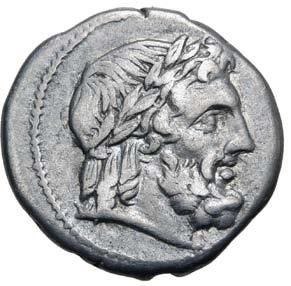
Very Fine. Very Rare.
Ex
“Very rare
90
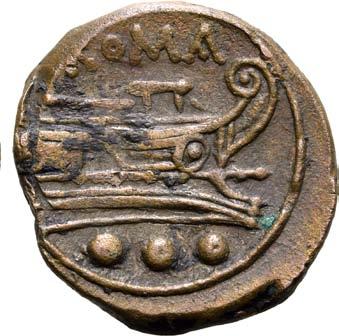

300


360.
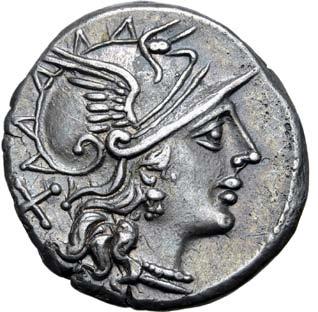


L. Saufeius AR Denarius. Rome, 152 BC. Helmeted head of Roma to right; X (mark of value) behind / Victory driving galloping biga to right, holding reins and whip; L•SAVF (VF ligate) below horses, ROMA within linear frame in exergue. Crawford 204/1; BMCRR Rome 834; RSC Saufeia 1. 3.84g, 18mm, 9h.
Good Extremely Fine.
Ex Roma Numismatics Ltd., Auction XXVII, 22 March 2023, lot 505.

361.


L. Saufeius AR Denarius. Rome, 152 BC. Helmeted head of Roma to right; X (mark of value) behind / Victory driving galloping biga to right, holding reins and whip; L•SAVF (VF ligate) below horses, ROMA within linear frame in exergue. Crawford 204/1; BMCRR Rome 834; RSC Saufeia 1. 4.26g, 18mm, 8h.
Near Extremely Fine; marvellous iridescent tone.
Ex Roma Numismatics Ltd., Auction XXVII, 22 March 2023, lot 506.
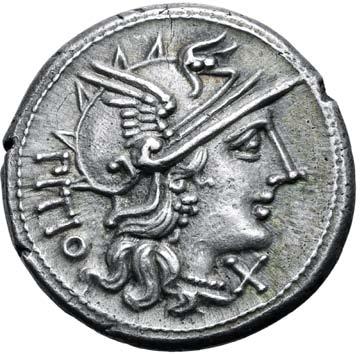
362.
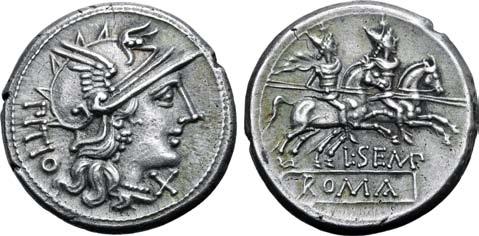
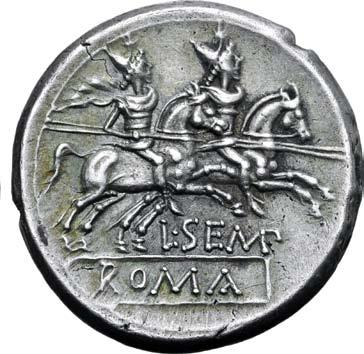
L. Sempronius Pitio AR Denarius. Rome, 148 BC. Helmeted head of Roma to right; PITIO downwards behind, X (mark of value) below chin / The Dioscuri, each holding spear, riding to right; L•SEMP below, ROMA within
Good Extremely Fine; well-centred on large flan, minor flan crack at 12h, attractive
of iridescent tone.

363.
Near Mint State; attractive light cabinet
Ex Roma Numismatics Ltd, E-Sale 105, 19 January 2023, lot 697.
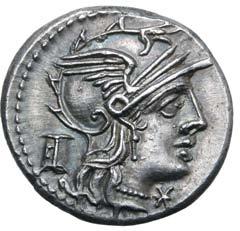


364.
Aburius

Denarius.


Mint State.
Ex Bertolami Fine Arts - ACR Auctions, Auction 44, 20 April 2018, lot 218.

365.
Near Mint State.

Ex Roma Numismatics Ltd., E-Sale 107, 16 March 2023, lot 900.
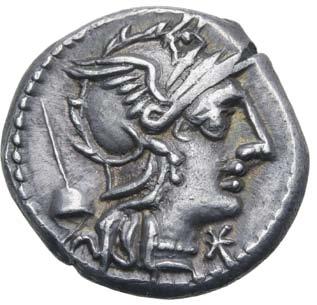
366.
Extremely Fine; attractive old cabinet tone.
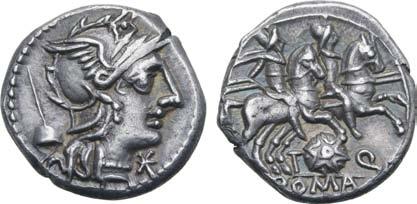

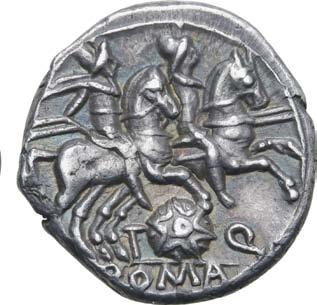
Ex American collection of Roman Republican and Imperatorial coins, Leu Numismatik AG, Web Auction 24, 3 December 2022, lot 199; Ex Artemide Aste s.r.l., Auction XXXIII, 2 July 2011,
67
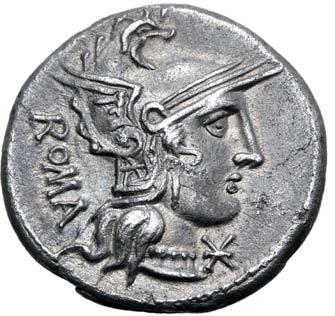
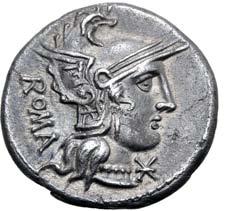
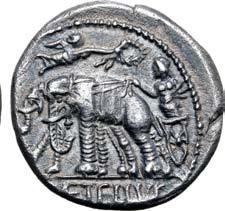

Extremely Fine; minor scrape to obv., attractive old cabinet tone.
This coin published in Richard Schaefer’s Roman Republican Die Project (RRDP), processed clippings, 269_sd, available online at: http://numismatics.org/archives/ark:/53695/schaefer.rrdp.processed_200-299#schaefer_clippings_output_269_sd; Ex Áureo & Calicó, Auction 388, 27 April 2022, lot 388;



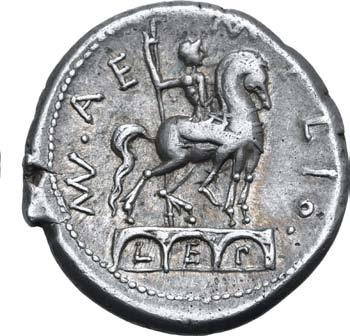
368.
Mn. Aemilius Lepidus AR Denarius. Rome, 114 BC. Laureate bust to right; star behind, ROMA (partially ligate) upwards before/ Three arches on which stands equestrian statue; horseman wearing cuirass and wreath, holding spear; MN•AEMILIO (partially ligate) around, LEP between arches. Crawford 291/1; BMCRR Italy 590; RSC Aemilia 7. 3.88g, 19mm, 4h.
Near Extremely Fine.
Acquired from Numismatica Ars Classica; Privately purchased from A.H. Baldwin & Sons Ltd., 3 February 1973.
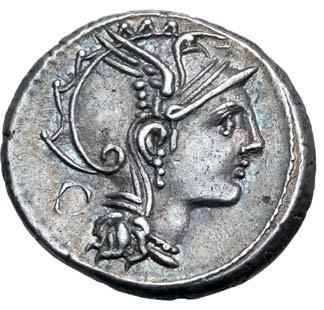

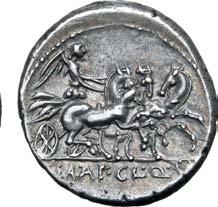
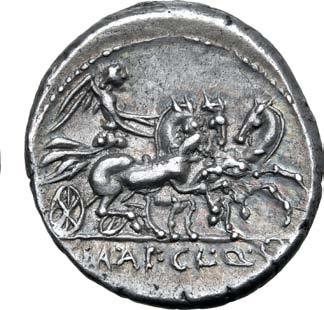
369.
T. Manlius Mancinus, Appius Claudius Pulcher, and Q. Urbinius AR Denarius. Rome, 111-110 BC. Helmeted head of Roma to right; quadrangular device behind / Victory driving triga to right; T•MANL•AP•CL•Q•VR (partially ligate) in exergue. Crawford 299/1b; BMCRR Rome 1293-5; RSC Mallia 2 & Claudia 3. 3.87g, 18mm, 3h.
Good Extremely Fine; attractive light cabinet tone.
Acquired from Numismatica Ars Classica; Privately purchased from A.H. Baldwin & Sons Ltd., 1 September 1972.


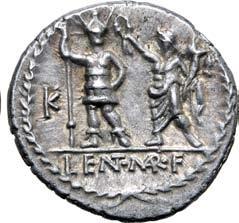
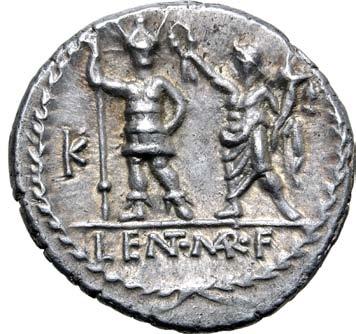
370.
P. Cornelius Lentulus M. f. AR Denarius. Rome, 100 BC.
BMCRR
Good Extremely Fine; attractive old cabinet tone with golden iridescence around the devices.
This coin published in A. Banti. Corpus Nummorum Romanorum, Monetazione Repubblicana (Firenze, 1980-1982); Ex Vogelberg Collection, Roma Numismatics Ltd., Auction XXV, 22 September 2022, lot 729 (hammer: GBP 1,300).


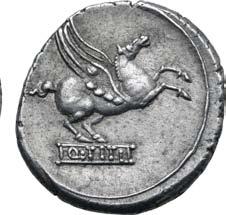
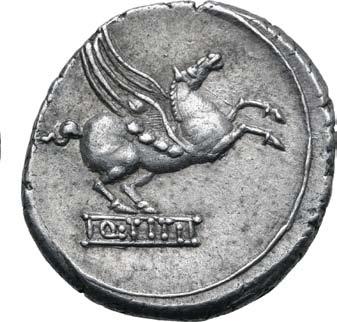
371.
Q. Titius AR Denarius. Rome, 90 BC. Bearded head of Mutinus Titinus to right, wearing winged diadem, lock of hair falling down neck / Pegasus springing to right on tablet inscribed Q•TITI. Crawford 341/1; BMCRR Rome 2220-4; Sydenham 691; RSC Titia 1; RBW 1274. 3.96g, 19mm, 2h.
Extremely Fine.
This coin published in Richard Schaefer’s Roman Republican Die Project (RRDP), binder 03, p. 268, available online at: http://numismatics.org/ archives/ark:/53695/schaefer.rrdp.b03#schaefer.rrdp.b03_0316; Privately purchased from Dr. Martina Dieterle, 2 February 2006; Ex Classical Numismatic Group, Triton VI, 14 January 2003 lot 653.
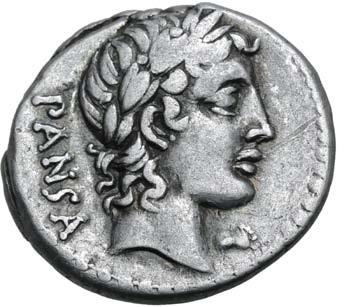



300
372.
C. Vibius C. f. Pansa AR Denarius. Rome, 90 BC. Laureate head of Apollo to right; PANSA downwards behind, foot before / Minerva driving galloping quadriga to left, holding reins, spear and trophy; C•VIBIVS[•C•F] in exergue. Crawford 342/4a; Sydenham 686; BMCRR Rome -; RSC Vibia 4; Roma XIX, 696 (hammer: 5,000 GBP). 3.81g, 17mm, 6h.
About Good Very Fine; obv. scratch. Extremely Rare.
Ex Roma Numismatics Ltd, E-Sale 105, 19 January 2023, lot 737 (hammer: GBP 750).

373.
300


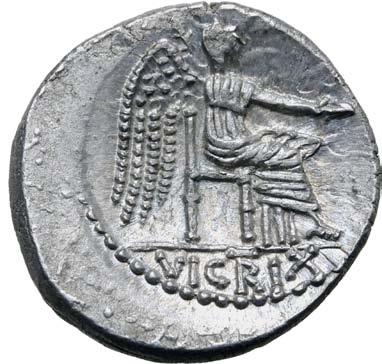
M. Porcius Cato AR Quinarius. Rome, 89 BC. Head of Liber to right, wearing ivy-wreath; M•CATO (ligate) behind, control letter E below / Victory seated to right, holding patera and palm-branch over left shoulder; VICTRIX (ligate) in exergue. Crawford 343/2b; RSC Porcia 7a; King 46. 2.17g, 14mm, 6h.
Near Mint State; attractive cabinet tone with lustre around the devices.
Ex Naville Numismatics Ltd., Auction 75, 31 July 2022, lot 393.
374.



L. Julius Bursio AR Denarius. Rome, 85 BC. Male head to right, with attributes of Apollo, Mercury and Neptune; plough (control symbol) behind / Victory driving quadriga to right, holding reins and wreath; ⊥XXX above horses, L•IVLI•BVRS[IO] in exergue. Crawford 352/1c; De Ruyter obv. die 166; BMCRR Rome 2508 ff. var. (control symbol and number); RSC Julia 5a. 4.24g, 20mm, 11h.
Near Mint State; sharp details, pleasant old cabinet tone.
Ex LNB Collection of J Bursio Denarii, Roma Numismatics Ltd., E-Live Auction 6, 25 March 2023, lot 615.
Ex Fritz Rudolf Künker GmbH & Co. KG, Auction 257, 10 October 2014, lot 8398;
Ex Gorny & Mosch Giessener Münzhandlung, Auction 176, 10 March 2009, lot 1861.
375.
No lot.




90
No Reserve
376.
L. Cornelius Sulla AR Denarius. Mint moving with Sulla in Asia or Greece, 84-83 BC. Diademed bust of Venus to right; Cupid standing to left before, holding palm, L•SVLLA below / Capis and lituus between two trophies; IMPER above, ITERVM below. Crawford 359/2; BMCRR East 3; RSC Cornelia 29; FFC 632 (this coin). 3.76g, 18mm, 12h.
Extremely Fine; unusually complete and well-centred.
No
Reserve



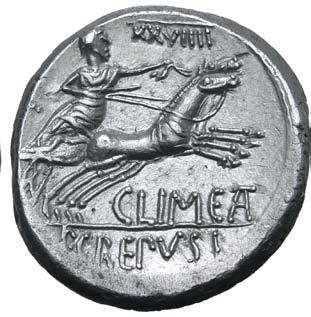
377.
L. Censorinus, P. Crepusius, and C. Limetanus AR Denarius. Rome, 82 BC. Veiled, diademed and draped bust of Venus to right; L•CENSORIN behind / Venus driving biga to right, holding goad and reins; XXVIIII (control number) above, C•LIMETA (partially ligate) below, P•CREPVSI in exergue. Crawford 360/1b; BMCRR Rome 2642 var. (control number); RSC Marcia 27. 3.73g, 18mm, 5h.
Good Extremely Fine; lustrous metal.
Ex Scipio Collection;
Ex Numismatica Ars Classica, Auction 11, 29 April 1998, lot 226.
No Reserve

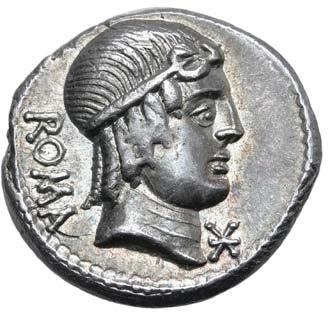
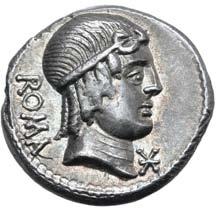


378.
M. Caecilius Q. f. Q. n. Metellus AR Denarius. Rome, 82-80
Extremely Fine; attractive vivid iridescent toning.
Ex Artemide Aste s.r.l., Auction LVII, 30 April 2022, lot 349.


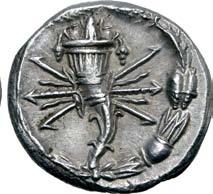

379.
Good Extremely Fine.
Ex Noonans, Auction 253, 13 April 2022, lot 1286; Previously purchased from P. Munro-Walker, September 1970.




380.
Near Mint State; pleasant old cabinet tone.
Ex Roma Numismatics Ltd., Auction XXVII, 22 March 2023, lot 551.


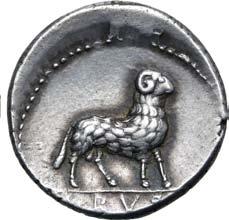

381.
About Extremely Fine.
Acquired from Numismatica Ars Classica; Reportedly privately purchased in 1981.


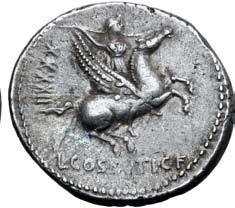

No Reserve
382.
About Extremely Fine; attractively toned. Rare with this control numeral.
Ex Bertolami Fine Arts - ACR Auctions, E-Auction 119, 10 July 2022, lot 399, sold with old collector’s ticket (hammer: EUR 1,300).
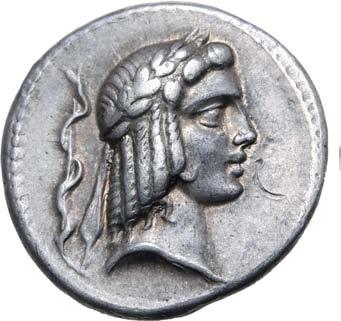
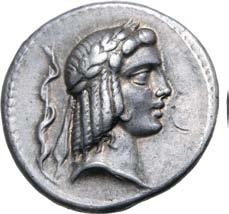
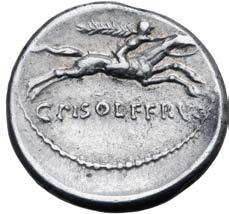
383.
Extremely Fine; banker’s mark to obv., attractive light cabinet tone over lustrous
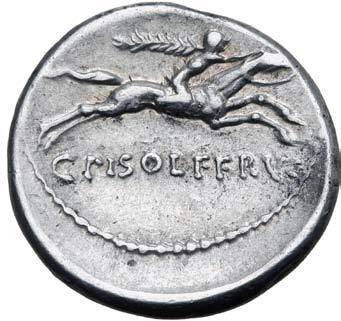
150
384.



M. Plaetorius M. f. Cestianus AR Denarius. Rome, 67 BC. Bust of ‘Vacuna’ to right, wearing a wreathed and crested helmet, bow and quiver on shoulder; cornucopiae below chin, CESTIANVS behind, S•C before / Eagle standing to right on thunderbolt, head to left; M• PLAETORIVS M•F•AED•CVR around. Crawford 409/1; BMCRR Rome 3596; RSC Plaetoria 4. 4.04g, 18mm, 6h.
Near Mint State.
Ex Roma Numismatics Ltd., Auction XVIII, 29 September 2019, lot 890; Ex A. Tkalec AG, 8 September 2008, lot 138.

385.
Good Very Fine.

386.
Extremely Fine; lustrous iridescence around devices.
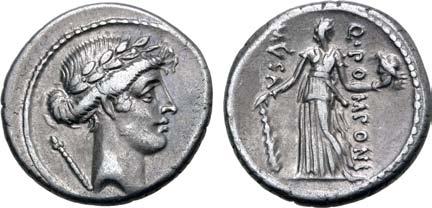


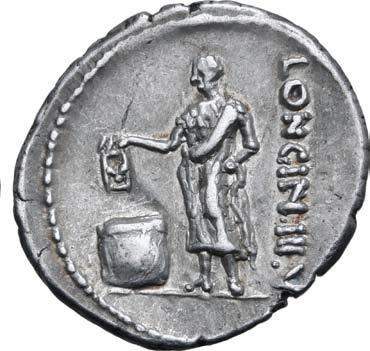
Ex American collection of Roman Republican and Imperatorial coins, Leu Numismatik AG, Web Auction 24, 3 December 2022, lot 399; Ex iNumis Mail Bid Sale 17, 23 March 2012, lot 130 (original ticket included).




387.
Good Extremely Fine; an outstanding example boasting a wonderful old cabinet tone and highly expressive portrait.
Ex Vitangelo Collection (collector’s ticket included).
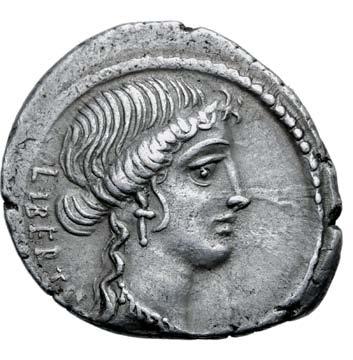
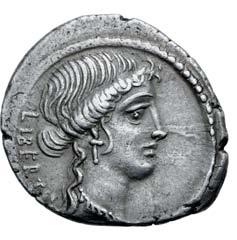
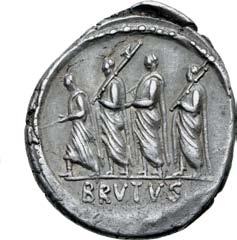

388.
Q. Servilius Caepio (M. Junius) Brutus AR Denarius. Rome, 54 BC. Bust of Libertas to right; LIBERTAS downward behind / Consul L. Junius Brutus, between two lictors, preceded by accensus, all walking to left; BRVTVS in exergue. Crawford 433/1; BMCRR Rome 3862; RBW 1542; RSC Junia 31. 3.81g, 20mm, 7h.
Extremely Fine; attractive cabinet tone.
Acquired from Monetarium Adelaide, 29th March 2010.
Struck a decade before the assassination of Julius Caesar and recalling the legendary expulsion of the Tarquins from Rome in 509 BC by L. Junius Brutus, his ancestor and the consul of that year, Brutus here uses the reverse type to illustrate his strong republican views, while the presence of the goddess Libertas on the obverse was particularly prescient of his participation in the events of 44 BC, the word ‘libertas’ reportedly being the watchword with which Brutus signalled the all-clear to his fellow conspirators.
When he became consul in 54, Brutus’ full name was Quintus Servilius Caepio Brutus, on account of his having been adopted by his uncle, Quintus Servilius Caepio. Having reverted to his birth name for a time, following Caesar’s assassination Brutus revived his adoptive name in order to illustrate his links to another famous tyrannicide, Gaius Servilius Ahala, from whom he was also descended.

389.
Extremely Fine.

Ex Dr. Busso Peus Nachfolger, Auction 431, 27 April 2022, lot 3389; Previously purchased from Münzhandlung Ritter, 25 March 2008.
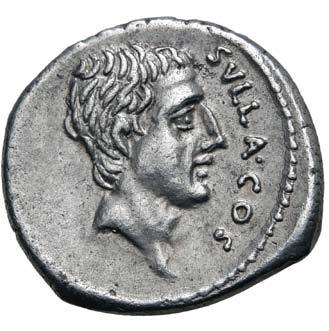
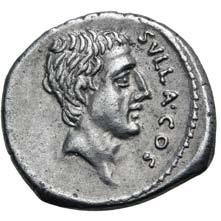

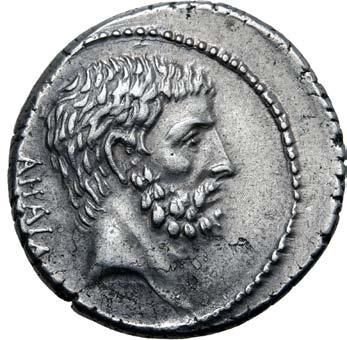

390.
Good Extremely Fine.
This coin published in Richard Schaefer’s Roman Republican Die Project (RRDP), binder 8, p. 122, available online at: http://numismatics.org/archives/ark:/53695/schaefer.rrdp.b08#schaefer.rrdp.b08_0146;
Numismatica Genevensis SA, Auction 16, 14 November 2022, lot 50 (hammer: CHF 3,500); Ex Numismatica Ars Classica AG, Auction 15, 18 May 1999, lot 171.
The moneyer for whom this issue struck, Q. Pompeius Rufus, was the grandson of the dictator Sulla. Bearing the only portrait of Sulla in the corpus of Roman numismatics, it is likely this is a good representation as, although struck posthumously, portraits of the famous ancestor would have survived.
391.
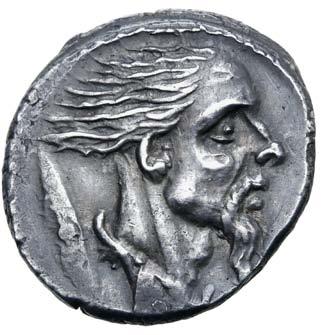
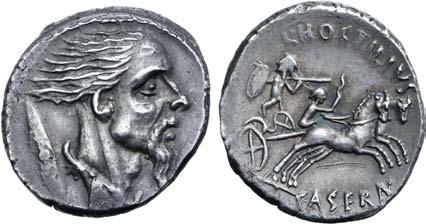
L. Hostilius Saserna AR Denarius. Rome, 48 BC. Head of Gallic captive to
448/2a; CRI 18; BMCRR Rome 3994-5; RSC Hostilia 2. 3.97g, 19mm, 6h.
Good Extremely Fine; beautiful old cabinet tone.
Ex Chaponnière & Firmenich SA, Auction 15, 21 May 2022, lot 39 (hammer: CHF 3,200);
Ex Chaponnière & Firmenich SA, Auction 9, 22 October 2017, lot 62.

The portrait of the Gallic warrior (in captivity) is believed to be Vercingetorix, leader of the great Gallic rebellion against Caesar in 55-54 BC.
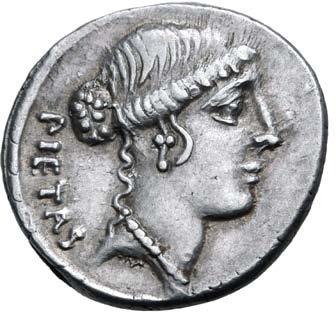
392.
Extremely Fine.

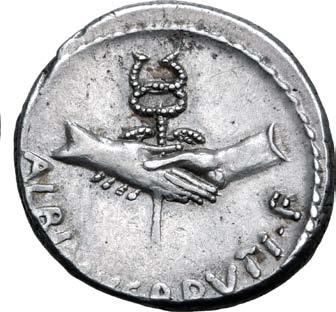
This coin published in Richard Schaefer’s Roman Republican Die Project (RRDP), processed clippings, 450-2_02_sd, available online at: http://numismatics.org/archives/ark:/53695/schaefer.rrdp.processed_400-499#schaefer_clippings_output_450-2_02_sd;
Ex Classical Numismatic Group, Electronic Auction 322, 12 March 2014, lot 496;
Ex E. Fornoni (Verona, Italy), Autumn List 2003, no. 249.



Good Extremely Fine; lustrous and lightly toned.
Ex Roma Numismatics Ltd., Auction XXVII, 22 March 2023, lot 596 (hammer: GBP 1,500); Ex Áureo & Calicó, Auction 319, 7 November 2018, lot 576; Ex Sotheby’s - Numismatic Fine Arts, 27-28 October 1993,

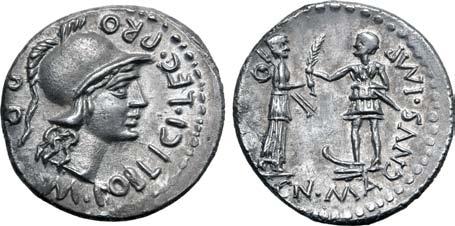

Good Extremely Fine.
Ex Roma Numismatics Ltd., E-Sale 101, 13 October 2022, lot 942.


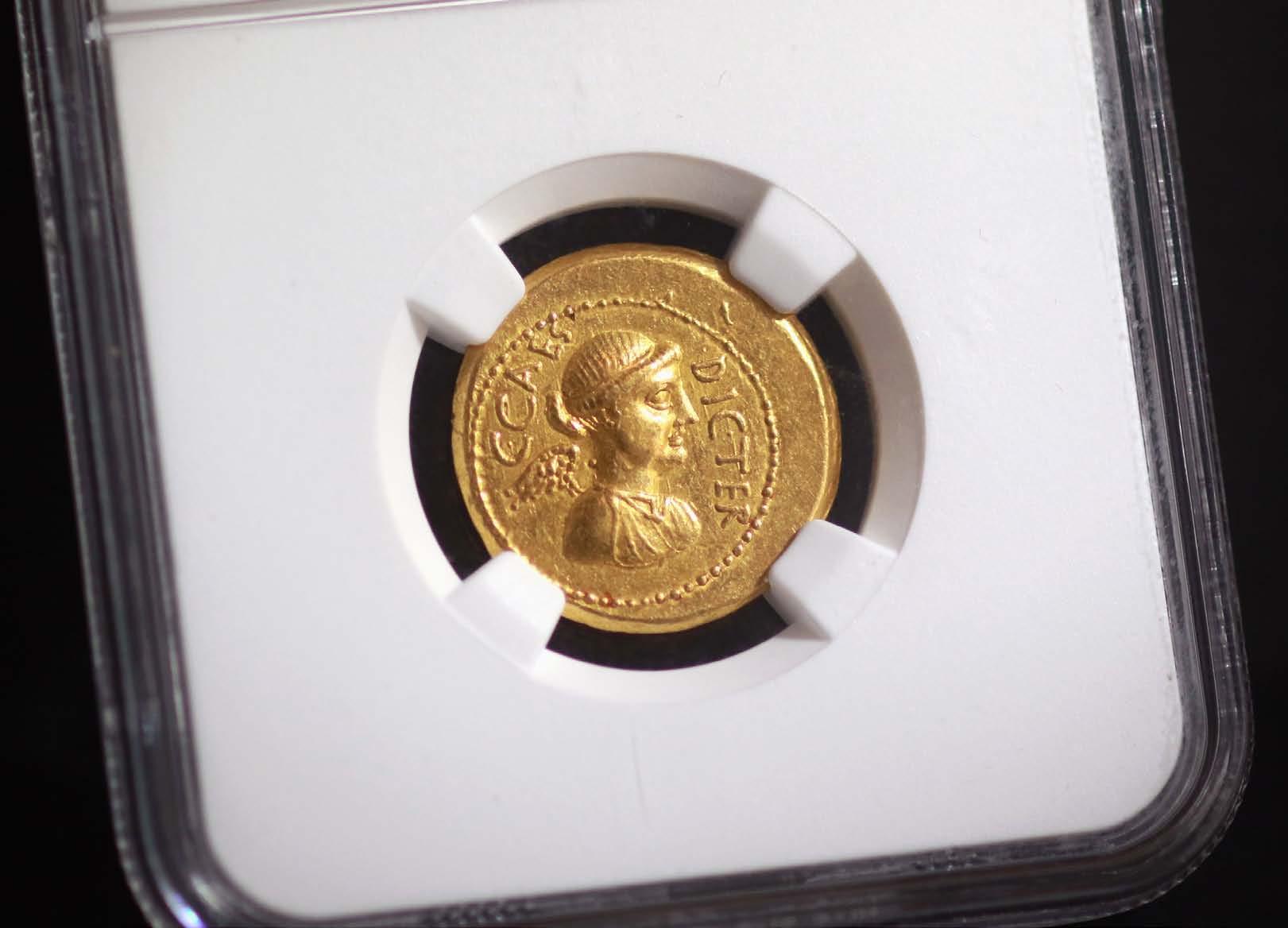
Julius Caesar AV Aureus. Rome, 45 BC. L. Munatius Plancus, urban prefect. C•CAES DIC•TER, draped bust of Victory to right / L•PLANC PR•VRB, ewer with handle. Crawford 475/1b; Bahrfeldt 20; CRI 60a; Calicó 44. 7.98g, 21mm, 6h.
NGC graded AU★ 5/5 - 5/5 (#6158054-001). Struck on a very broad planchet and among the finest known examples.
Ex GK Collection, Roma Numismatics Ltd., Auction XXIII, 24 March 2022, lot 763 (hammer: GBP 36,000); Ex Numismatica Ars Classica AG, Auction 97, 12 December 2016, lot 33.
15,000 No Reserve
Crawford allocates this issue to early 45 BC, on the basis of the legend DIC TER, referring to his appointment as dictator for the third time, but Sear follows Grueber’s view that this particular series was produced for Caesar’s Spanish triumph in October of that year. (CRI, p.42) The third dictatorship was awarded in April 46 BC, but its extraordinary powers were immediately extended for an unprecedented term of ten years instead of the customary one year. It therefore presents no problems for situating this issue towards the end of 45 BC, and regardless there was already numismatic precedent for Caesar retaining a dictatorial title beyond the period to which it strictly applied, reflecting, as Sear argues “Caesar’s cavalier attitude towards the niceties of constitutional convention.” (CRI, p.42)
Indeed, that the obverse type of the winged goddess Victory must refer to Caesar’s victory at Munda against Roman adversaries highlights Caesar’s increasing disdain for the factions of the aristocracy who continued to oppose him. The dictator even celebrated a triumph in the capital, an unprecedented (and taboo) commemoration of victory over other Romans, with no attempt to disguise or spin it as a defeat of a foreign power. The presence within the issue of a gold half-aureus, or quinarius, makes it almost certain that this type was minted specially for the Spanish triumph, since the denomination was typically associated with the distribution of largess at public celebrations.
Lucius Munatius Plancus, whose name appears on the reverse of this coin, was one of the Urban Prefects appointed by the dictator in 46 BC to administer the capital while he was on campaign. After this prominent issue of aurei was minted under his name, he rose to the position of governor of Transalpine Gaul in 44 BC where he founded the colony of Lugdunum, and later was appointed consul in 42 BC. Although he supported Marc Antony in the tumult which followed Caesar’s assassination, he eventually became an adviser to Octavian and according to Suetonius he dissuaded the princeps from assuming the name of Romulus as a ‘second founder of Rome’ (Suet. Aug. 7) and instead on 16 January 27 BC he formally proposed that the title ‘Augustus’, meaning ‘revered one’ be granted to the young princeps.



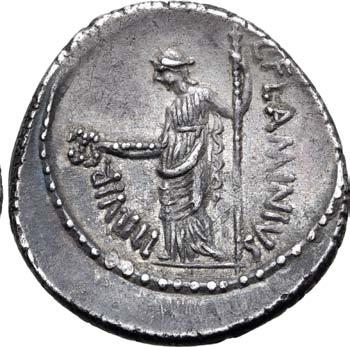
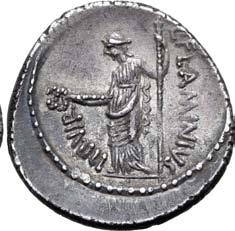
Good Extremely Fine; attractive cabinet tone, a wonderful portrait of Caesar.
This coin published in Richard Schaefer’s Roman Republican Die Project (RRDP), binder 12, p.
4,800 No Reserve
available online at: http://numismatics.org/ archives/ark:/53695/schaefer.rrdp.b12#schaefer.rrdp.b12_0024;
Ex Roma Numismatics Ltd., Auction XXIII, 24 March 2022, lot 769 (hammer: GBP 10,000);
Ex Viggo Collection, Classical Numismatic Group, Triton XXII, 8 January 2019, lot 946;
Ex JD Collection of Roman Republican Coins, Numismatica Ars Classica, Auction 72, 16 May 2013, lot 494;
Ex Numismatica Aretusa, Auction 2, 13 May 1994, lot 294.
In the years of his supremacy, Caesar had amassed unprecedented power by corrupting the institutions of the old Republic to his own requirements. First appointed Dictator in 49 BC by the Praetor (and future Triumvir) Marcus Aemilius Lepidus, possibly in order to preside over elections, Caesar resigned his Dictatorship within eleven days but in 48 BC he was appointed Dictator again, only this time for an indefinite period, and was also given permanent tribunician powers making his person sacrosanct and allowing him to veto the Senate. In 46 BC he was appointed Dictator for ten years, and he gave himself quasi-censorial powers under the mantle of ‘Prefect of the Morals’, enabling him to fill the Senate with his partisans who duly voted him the titles of Pater Patriae and Imperator. He increased the number of magistrates who were elected each year, thus allowing him to reward his supporters, and in October 45 BC, having served in the unconstitutional role of Sole Consul for that year, Caesar resigned his consulship and facilitated the election of two successors for the remainder of the year - theoretically restoring the ordinary consulship, but in practice submitting the Consuls to the Dictatorial executive - a practice that later become common under the empire. In February 44 BC, one month before his assassination, Caesar was appointed Dictator for life.
More followed; he was given the unprecedented honour of having his own likeness placed upon the Roman coinage, his statue was placed next to those of the kings, he was granted a golden chair in the Senate, and was permitted to wear triumphal dress whenever he chose. Then, at the festival of the Lupercal, Marc Antony presented Caesar with a royal diadem, and attempted to place it on his head. Yet for all these hideous affronts to the ancient institutions of the Republic and the sensibilities of the Roman people, perhaps his most egregious reform was the law he passed in preparation for his planned campaign against the Parthian Empire. Realising that his absence from Rome would impede his ability to install his own men in positions of power and that therefore his back would be exposed while away from the city, Caesar decreed that he would have the right to appoint all magistrates in 43 BC, and all consuls and tribunes in 42 BC, thus at a stroke transforming the magistrates from being representatives of the people to being representatives of the dictator.
Struck after Caesar’s assassination, this coin marks a departure from the portraiture on the coinage minted during his lifetime. Rather than the veiled head of Caesar the dictator, depicted instead is the wreathed head of the soon-to-be deified adoptive father of Octavian. This depiction of Caesar by Flaminius Chilo appears to be heavily influenced by Octavian’s concerted attempts in the aftermath of Caesar’s death to rehabilitate his image in the eyes of many of those at Rome who had developed concerns surrounding his increasing power and also, perhaps more cynically, to reinforce Octavian’s own legitimacy as his heir.
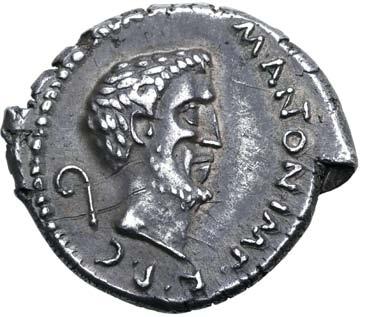

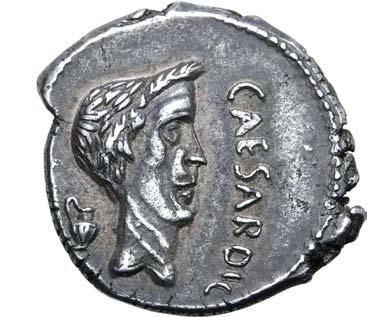
397.
Marc Antony and Julius Caesar AR Denarius. Military mint travelling with Antony in Cisalpine Gaul, autumn 43 BC. Bearded bare head of Antony to right; lituus behind, M M ANTON IMP•R•P•C downwards before / Laureate head of Caesar to right; capis behind, CAESAR•DIC downwards to right. Crawford 488/2; CRI 123; BMCRR Gaul 57; RSC 3a. 4.24g, 20mm, 11h.
Extremely Fine; a superb example of the type.
Privately acquired from Numismatica Ars Classica AG; Ex Dr. Busso Peus Nachfolger, Auction 330, 24 April 1991, lot 1049; Reportedly Ex Sotheby’s, uncertain auction, 1986, lot 42.
After the War of Mutina, Antony and Lepidus entered into an autocratic pact with Octavian, the Second Triumvirate. Antony struck these coins in this new atmosphere of cooperation to emphasise and remind the people of his former station as Caesar’s right hand man - a shrewd publicity tactic at once connecting himself to the memory of the people’s beloved dictator and subtly suggesting himself superior to his colleagues in prestige.

398.

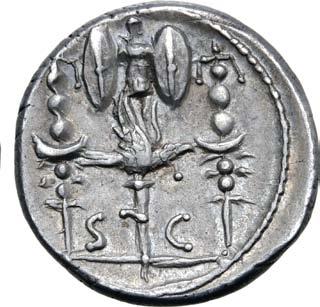
Octavian AR Denarius. Military mint travelling with Octavian in Greece, 42 BC. Helmeted and draped bust of young Mars to right, spear over left shoulder; CAESAR III VIR•R•P•C around / Aquila flanked by S-C between two signa, all set on ground line; trophy holding oval shields above. Crawford 497/3; CRI 138; BMCRR Gaul 96; RSC 248. 4.09g, 17mm, 9h.
Extremely Fine; attractive light old cabinet tone. Rare, and in excellent condition for the type.
Ex Fritz Rudolf Künker GmbH & Co. KG, Auction 377, 20 October 2022, lot 5651 (hammer: EUR 1,800), collector’s ticket included.

399.


C. Vibius Varus AR Denarius. Rome, 42 BC. Bust of Minerva to right, wearing crested Corinthian helmet and aegis / Hercules standing to left, resting hand on club set on ground and holding lion skin; C•VIBIVS downwards on right, VARVS downwards on left. Crawford 494/38; CRI 194; BMCRR Rome 4303; RSC Vibia 26. 3.93g, 20mm, 8h.
Near Extremely Fine; attractive golden tone.
Ex Roma Numismatics Ltd., Auction XXVII, 22 March 2023, lot 611.

400.
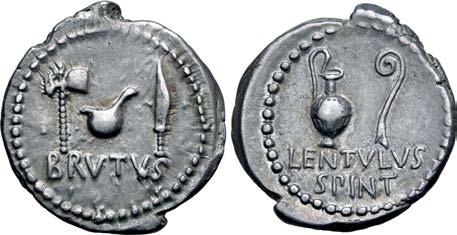

Q. Servilius Caepio (M. Junius) Brutus and P. Cornelius Lentulus Spinther AR Denarius. Smyrna, 43-42 BC. Sacrificial axe, simpulum and sacrificial dagger; BRVTVS below / Jug and lituus; LENTVLVS SPINT in two lines below. Crawford 500/7; CRI 198; BMCRR East 80; RSC 6. 3.76g, 20mm, 12h.
Good Very Fine.
Ex Brian Holland Collection, Classical Numismatic Group, Auction 121, 6 October 2022, lot 762; Ex Classical Numismatic Group, Mail Bid Sale 81, 20 May 2009, lot 958.
401.



Q. Servilius Caepio (M. Junius) Brutus AR Denarius. Military mint moving with Brutus in Asia Minor, 42 BC. L. Sestius, proquaestor. Veiled and draped bust of Libertas to right; L•SESTI•PRO•Q around / Tripod between sacrificial axe and simpulum; Q•CAEPIO•BRVTVS•PRO•COS around; all within beaded border. Crawford 502/2; CRI 201; BMCRR East 41; RSC 11. 3.69g, 19mm, 12h.
Good Extremely Fine; lustrous.
Ex Roma Numismatics Ltd., E-Live Auction 6, 25 March 2023, lot 155.
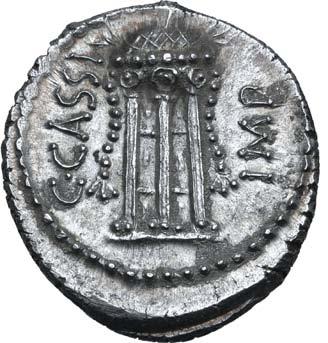
402.
600


C. Cassius Longinus and P. Cornelius Lentulus Spinther AR Denarius. Military mint travelling with Brutus and Cassius, probably at Smyrna, 43-42 BC. Tripod with cauldron, decorated with two laurel-branches; C•CASSI upwards to left, IMP upwards to right / Capis and lituus; LENTVLVS SPINT in two lines below. Crawford 500/1; CRI 219; RSC 7. 3.92g, 20mm, 6h.
Near Mint State; attractive light cabinet tone with underlying lustre.
Ex Roma Numismatics Ltd., E-Live Auction 6, 25 March 2023, lot 153.

403.
750
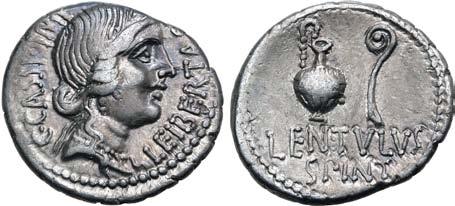
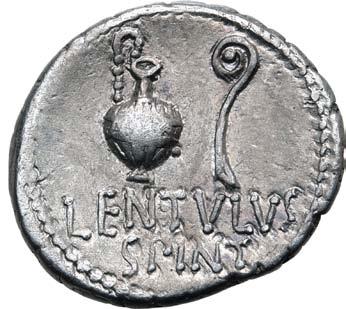
C. Cassius Longinus and P. Cornelius Lentulus Spinther AR Denarius. Military mint travelling with Brutus and Cassius, probably at Smyrna, early 42 BC. Diademed head of Libertas to right; LEIBERTAS upwards before, C•CASSI•IMP upwards behind / Capis and lituus; LENTVLVS SPINT in two lines below. Crawford 500/3; CRI 221; BMCRR East 77; RSC 4. 3.85g, 19mm, 6h.
Near Extremely Fine; attractive iridescence.
Ex Roma Numismatics Ltd., Auction XXVII, 22 March 2023, lot 615.

404.


Marc Antony and Octavian AR Denarius. Military mint moving with Antony, Ephesus, spring-early summer 41 BC. M. Barbatius Pollio, Quaestor Pro Praetore. M•ANT•IMP•AVG•III•VIR•R•P•C•M BARBAT•Q•P (MP and AV ligate), bare head of Antony to right / CAESAR•IMP•PONT•III•VIR•R•P•C•, bare head of Octavian to right. Crawford 517/2; CRI 243; BMCRR East 100; RSC 8a. 3.76g, 20mm, 12h. Extremely Fine; banker’s mark on obverse.
Ex Roma Numismatics Ltd., E-Sale 102, 3 November 2022, lot 887.


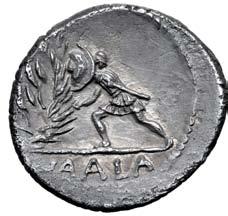

405.
C. Numonius Vaala AR Denarius. Rome, 41 BC. Bare head of Numonius Vaala to right; C•NVMONIVS downwards before, VAALA upwards behind / Soldier advancing to left, holding sword and shield, attacking vallum defended by [two soldiers]; VAALA in exergue. Crawford 514/2; CRI 322; BMCRR Rome 4216; Sydenham 1087; RSC Numonia 2. 2.90g, 18mm, 10h.
Near Mint State; a striking portrait accentuated by hints of golden iridescence.
Ex Fritz Rudolf Künker GmbH & Co. KG, Auction 280, 26 September 2016, lot 392.
1,500 No Reserve
The reverse type no doubt depicts the deeds of an ancestor which resulted in the cognomen Vaala. The first soldier to breach the enemy rampart (vallum) was awarded the corona vallaris. The details of this particular instance are not known to history.



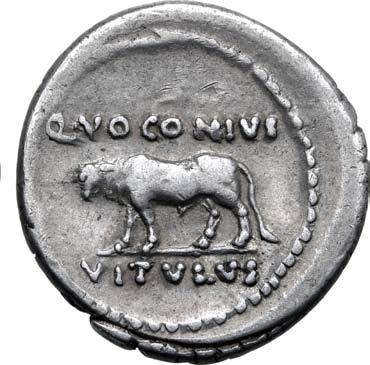
Divus Julius Caesar AR Denarius. Rome, 40 BC. Q. Voconius Vitulus, moneyer. Laureate head to right; DIVI•IVLI downwards before, lituus behind / Bull-calf walking to left; Q•VOCONIVS above, VITVLVS in exergue. Crawford 526/2; CRI 329; Sydenham 1132; BMCRR Rome 4308-10; RSC 46. 3.95g, 20mm, 10h.
Extremely Fine; a bold portrait of Caesar.
Ex Walter Luckhardt Collection, Dr. Busso Peus Nachfolger, Auction 433, 1 November 2022, lot 1431; Previously acquired from Santamaria, Rome, in 1940.
1,800 No Reserve
In 40 BC when this coin was struck, upon learning of the defeat of his brother Lucius and wife Fulvia in the Perusine War, Marc Antony set sail for Italy with a small army and two hundred ships which he had built in Asia. Arriving at Athens, Antony was met by his wife Fulvia and his mother Julia, who had taken refuge with Sextus and been sent by him with warships from Sicily. She was accompanied by some leading Pompeians whose aim was to bring Antony and Sextus into alliance against Octavian. Antony’s response to the embassy was to offer alliance in case of war and reconciliation in case of peace, suggesting that Antony believed that a lasting partnership with Octavian was still possible. These new lines of communication with Sextus provided an avenue by which former supporters of the liberators could find their way back from exile; the most prominent of these was Ahenobarbus, who met Antony at sea with his whole army and fleet; this combined force moved together to Brundisium, but was refused entry to the harbour by Octavian’s commander.
Despite initially laying siege to Brundisium, the triumvirs were able to negotiate a settlement that provided for a continued peace between them. The Treaty of Brundisium confirmed the de facto state of affairs, while further binding Octavian and Antony through the ill-fated marriage of Octavian’s sister Octavia to Antony. Antony furthermore received legions for his planned invasion of Parthia and Octavian received warships to counter the ongoing threat posed by Sextus Pompey. This denarius depicts the now deified Caesar on the obverse with a lituus, an augur’s staff representing his membership to the priestly college of augurs. Octavian’s possession of the augurship was also made clear on an issue with his portrait struck by the same moneyer (CRI 330) emphasising his relationship to Caesar, a propaganda tool also employed by Marc Antony (see CRI 253-5, 257-8). It is well attested how Octavian capitalised tremendously on his posthumous adoption by Caesar; in truth he owed everything he eventually achieved to this twist of fate. Octavian used Caesar’s reflected but undimmed prestige to legitimise himself and his ascent to power in the eyes of the Roman people and more importantly the legions, and thus the continuation of (often idealised) Caesar portrait issues at the Roman mint under Octavian’s control is hardly surprising.
This denarius, struck by Q. Voconius Vitulus, a partisan of Octavian of whom nothing else is known, features a purely personal reverse type with a punning allusion to his cognomen which translates as cow or calf. It was to be one of the last within the long tradition of the college of moneyers stretching back almost two and a half centuries, for the institution was abolished by the Triumvirate and state coinage placed under the direct control of the either the eastern of western Triumvir.

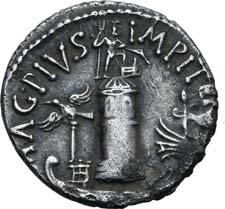

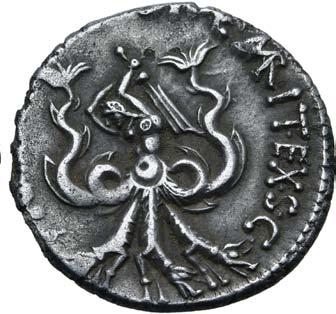
407.
Sextus Pompey AR Denarius. Sicily, 42-40 BC. The Pharos of Messana surmounted by a statue of Neptune; in foreground, galley to left adorned with legionary eagle, sceptre and trident, MAG•PIVS•IMP•ITER around / Scylla to left, wielding a rudder in both hands; [PRÆF•CLAS•ET]•ORÆ•MAR IT•EX•S•C (partially ligate) around. Crawford 511/4a; CRI 335; Sydenham 1348; BMCRR Sicily 18-19; RSC 2. 3.63g, 18mm, 10h.
Near Extremely Fine.
900
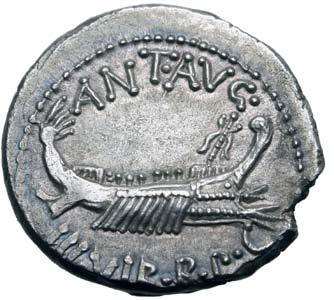
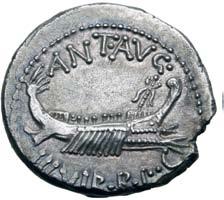


408.
Marc Antony Legionary AR Denarius. Military mint moving with Antony, autumn 32 - spring 31 BC. ANT•AVG III•VIR•R•P•C, praetorian galley to right / Aquila between two signa; LEG IV across fields. Crawford 544/17; CRI 352; BMCRR East 195; Sydenham 1219; RSC 30. 3.46g, 18mm, 6h.
Good Extremely Fine; light cabinet tone, an attractive example.
Ex Gorny & Mosch Giessener Münzhandlung, Auction 237, 7 March 2016, lot 1788.
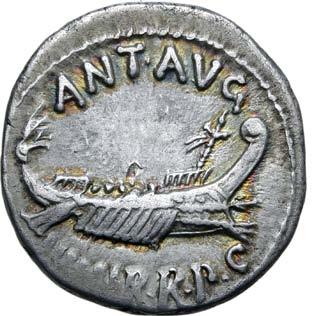
409.
450

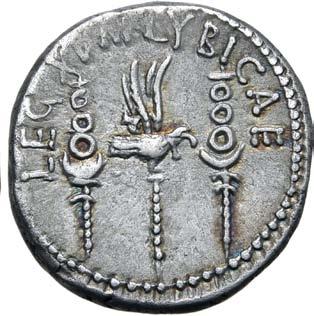
Marc Antony Legionary AR Denarius. Military mint moving with Antony, 32-31 BC. ANT•AVG III•VIR•R•P•C, praetorian galley to right / LEG•XVIII•LYBICAE, legionary aquila between two standards. Crawford 544/11; CRI 375; Sydenham 1240; RSC 53. 3.50g, 18mm, 6h.
Good Very Fine; splendid rainbow iridescence to both sides.
Ex Classical Numismatic Group, Mail Bid Sale 67, 22 September 2004, lot 1241 (hammer USD 950).

410.
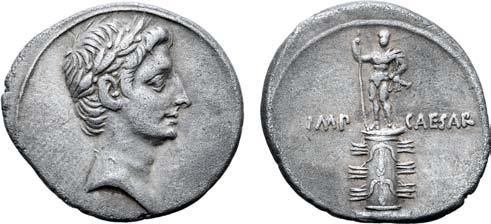
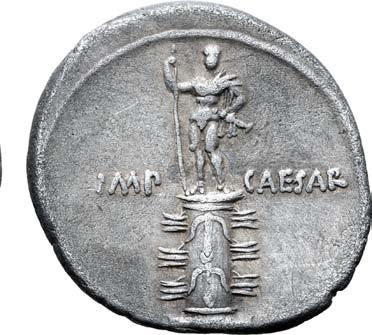
Octavian AR Denarius. Italian mint (Rome?), autumn 30 - summer 29 BC. Laureate head to right / Rostral column ornamented with two anchors and six beaks of galleys, surmounted by a statue of Octavian, naked but for cloak over left shoulder, holding spear and parazonium; IMP-CAESAR across fields. RIC I 271 (Augustus); CRI 423; BMCRE 633 (Augustus); BMCRR Rome 4349; RSC 124 (Augustus). 3.44g, 20mm, 10h.
Good Very Fine.

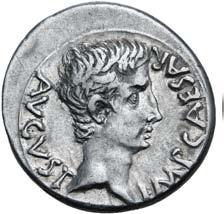
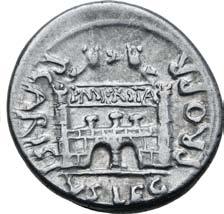
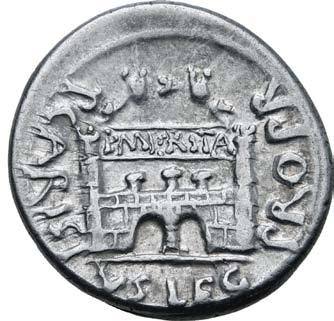
411.
Augustus AR Denarius. Emerita, 25-23 BC. P. Carisius, legatus pro praetore. IMP CAESAR AVGVSTVS, bare head to right / P CARISIVS LEG PRO PR, circular city wall with EMERITA inscribed above gate. RIC I 9a; BMCRE 124-5; RSC 397. 3.89g, 19mm, 8h.
Near Extremely Fine; lightly toned surfaces with underlying lustre, a handsome portrait of Augustus.
Ex Roma Numismatics Ltd., Auction XV, 5 April 2018, lot 453.


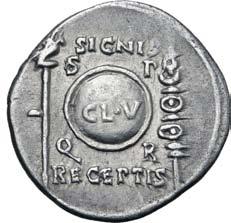
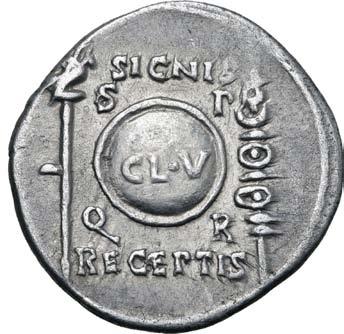
450
412.
Augustus AR Denarius. Uncertain Spanish mint (Colonia Patricia?), 19 BC. CAESAR AVGVSTVS, bare head to left / Round shield inscribed CL•V, aquila and signum flanking; SIGNIS above, RECEPTIS below, S P Q R around. RIC I 86b; BMCRE 420-421; RSC 267. 3.66g, 19mm, 5h.
Extremely Fine; an attractive portrait of Augustus.
Ex collection of Dipl.-Ing. Adrian Lang, Leu Numismatik AG, Web Auction 21, 19 July 2022, lot 4011; Ex Numismatik Lanz München, Auction 156, 2 June 2013, lot 254; Ex Helios Numismatik, Auction 8, 13 October 2012, lot 53.

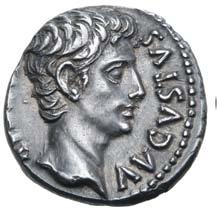

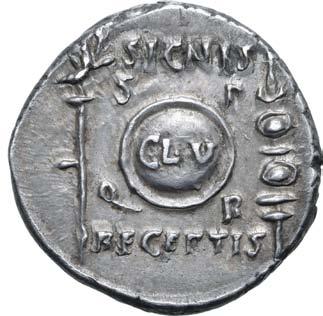
450
413.
Augustus AR Denarius. Colonia Patricia(?), 19 BC. CAESAR AVGVSTVS, bare head to right / Round shield inscribed CL•V, aquila and signum flanking; SIGNIS above, RECEPTIS below, S P Q R around. RIC I 86a; BMCRE 417-419; ACIP 4382; RSC 265. 3.87g, 18mm, 8h.
Near Extremely Fine; deep old cabinet tone.
Ex Leu Numismatik AG, Web Auction 21, 19 July 2022, lot 4010; Ex collection of Dipl.-Ing. Adrian Lang, Gorny & Mosch Giessener Münzhandlung, Auction 224, 13 October 2014, lot 432; Ex Editions V. Gadoury, Auction 2013, 30 November 2013, lot 47.
450
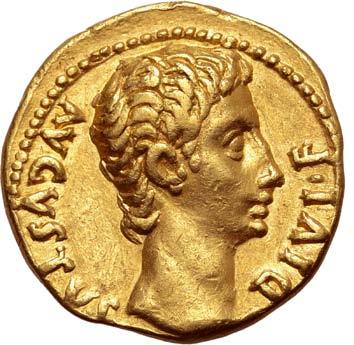
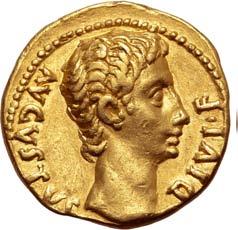

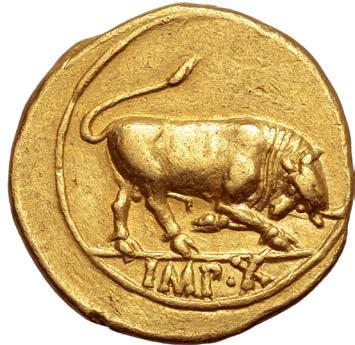
414.
Augustus AV Aureus. Lugdunum, 15-13 BC. AVGVSTVS DIVI•F, bare head to right / Bull butting to right, left foreleg raised, lashing his tail; IMP•X in exergue. RIC I 166a; Lyon 18; BMCRE 450 = BMCRR Gaul 162; Calicó 212; BN 1372. 7.96g, 20mm, 6h.
Near Extremely Fine.
Ex Roma Numismatics Ltd., E-Sale 53, 7 February 2019, lot 684; Ex P.P. Collection.
The charging bull or heifer is a reference from the famous type of Thurium, a city to which the family of Augustus had a connection: Suetonius relates that Gaius Octavius, Augustus’ natural father, defeated a Spartacist army near the town. Due to the high regard in which the family was held in the town, Augustus had been given the surname Thurinus at birth, and thus the type primarily represents a deeply personal allusion to the emperor and his father Gaius Octavius.
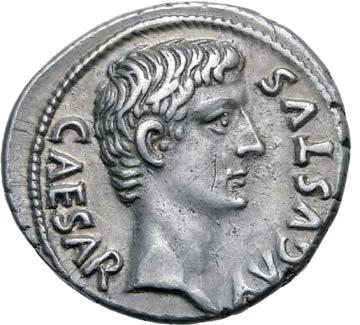

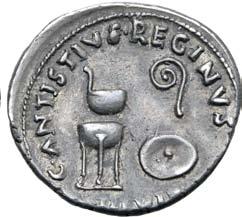

415.
Augustus AR Denarius. Rome, 13 BC. C. Antistius Reginus, moneyer. CAESAR AVGVSTVS, bare head to right / C • ANTISTIVS • REGINVS, simpulum and lituus above tripod and patera; [III•VIR] below. RIC I 410; BMCRE 119-120 = BMCRR Rome 4661-4662; BN 547; RSC 347. 3.79g, 20mm, 1h.
Extremely Fine; deep cabinet tone.
Ex Roma Numismatics Ltd., E-Sale 106, 16 February 2023, lot 767; Ex Paul-Francis Jacquier, Auction 50, 16 September 2022, lot 243.




416.
Augustus AR Denarius. Rome, 13 BC. C. Antistius Reginus, moneyer. CAESAR AVGVSTVS, bare head to right / C • ANTIS[TIVS] • REGINVS, simpulum and lituus above tripod and patera; III•VIR below. RIC I 410; BMCRE 119-120 = BMCRR Rome 4661-4662; BN 547; RSC 347. 3.94g, 19mm, 6h.
Extremely Fine.
Ex Auktionshaus H. D. Rauch GmbH, Auction 112, 10 June 2021, lot 803.




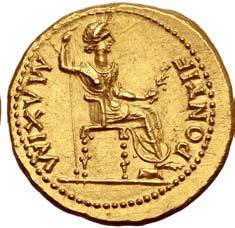
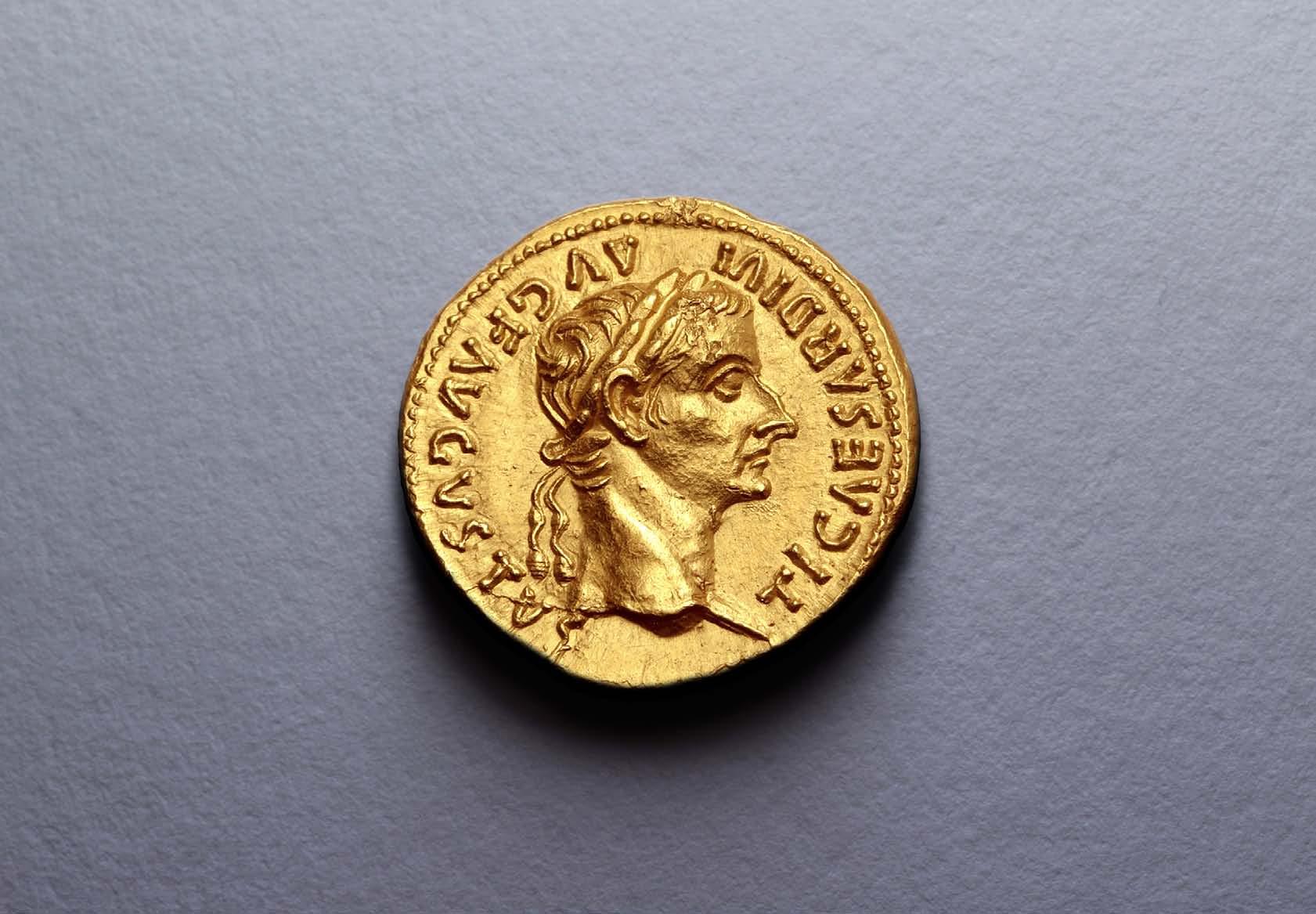
Mint State; a truly spectacular example.
Ex Roma Numismatics Ltd., Auction XXII, 7 October 2021, lot 676 (hammer: GBP 24,000).
12,000 No Reserve
Following a series of early issues honouring Divus Augustus and Tiberius’ military triumphs, the mint at Lugdunum settled upon striking one single type: ‘Pontif Maxim’. Numismatists identify the seated figure depicted on this ubiquitous reverse type as Livia, the wife of Augustus and mother of Tiberius, in the guise of Pax, the Roman personification of peace. The type was struck continuously for twenty three years and throughout that time, only minor changes were made to the portrait of Tiberius and the ornamentation of the throne. Despite the vast output of the ‘Pontif Maxim’ coinage, the significance of the type is not immediately clear - the depiction of Livia as Pax may represent a universal matronly ideal; Livia may be intended as the personification of what Seneca the Younger described in AD 55 as the ‘Pax Romana’ (‘Roman Peace’), the period of peace and stability marked by Octavian’s victory over Mark Antony at the battle of Actium in 31 BC, which brought to an end to the prolonged period of civil war.
Certainly, during the last decade of the 1st century BC Livia began to appear more frequently in the preserved sources, and L. Brännstedt (‘Femina princeps: Livia’s position in the Roman state’) suggests that “her role as mater and uxor at this time was becoming an integral part of Augustus’ political program, and being made publicly manifest on a large scale.” Brännstedt furthermore asserts that “the appointment on March 6, 12 BC of Augustus as pontifex maximus was crucial for the development of Livia’s mater-role... Augustus’ religious role was identified as that of a father to his family. Strengthening the paternal connotations of Augustus’ leadership, the appointment of him as pontifex maximus would also have favoured Livia’s impact as mater”. The identification of Livia with Pax therefore strongly associated the imperial family with the continued prosperity of the Empire, and hence should be seen as primarily a propagandistic instrument for the reinforcement of the imperial cult.
In contrast to the official portrayals of Livia as a matriarch embodying traditional Roman ideals, contemporary sources were often highly critical of her, describing her as a murderess who was determined to secure the succession for her son Tiberius. Cassius Dio describes how Livia was blamed for the death of Augustus’ nephew Marcellus who, having married the Emperor’s daughter Julia, was favoured as an heir, and later, the deaths of Gaius and Lucius Caesars (55.33.4 and 55.10a.10). Tacitus moreover suggests that Livia convinced Augustus to banish his then only surviving grandson, Agrippa Postumus, on this basis that his character was not in keeping with Augustan ideals (1.1.3). Dio recounts that following years of banishment, a visit undertaken by Augustus to reconcile with his grandson drove Livia to poison her husband in order to secure the succession for Tiberius (56.30.2). These accusations are however mainly dismissed as malicious fabrications spread by political enemies of the dynasty.
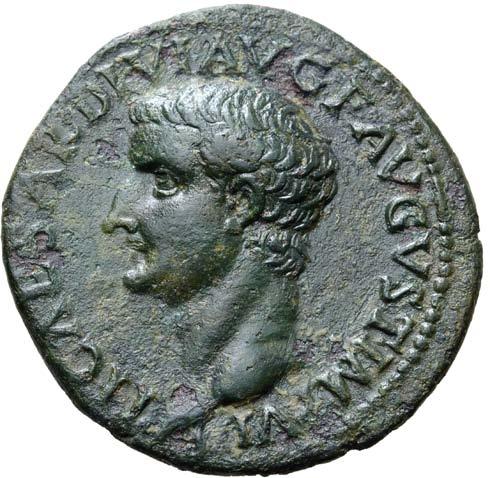


Ex



419.
Near Extremely Fine; collection number ‘61’ on reverse.
Ex Jesus Vico S.A., Auction 160, 14 December 2021, lot 375; Ex Lonja del Almidón (Madrid), 30 March 1936.

420.
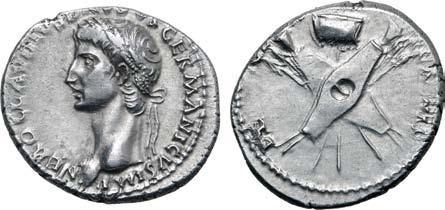
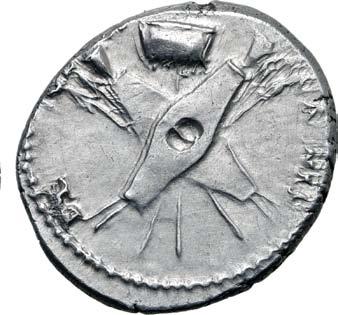
Nero Claudius Drusus (father of Claudius) AR Denarius. Rome, AD 41-45. NERO CLAVDIVS DRVSVS GERMANICVS IMP, laureate head to left / DE GERMANIS, two oblong shields crossed, over vexillum, four spears and two trumpets. RIC I 74 (Claudius); BMCRE 107; RSC 6; BN 109-10 (Claudius). 3.79g, 19mm, 1h.
Good Extremely Fine. Very Rare.
Ex Shackleford Collection, Roma Numismatics Ltd., Auction XXI, 24 March 2021, lot 509.
Roman history, like that of any enduring empire, allows for speculation about how the course of events might have changed had certain people died, or in this case, not died. A perfect study in this is Nero Claudius Drusus, the younger brother of the future Emperor Tiberius. Unlike Tiberius, whom Augustus had always disliked, Drusus was much beloved by Rome’s first emperor. When Augustus wrested Livia from her first husband, she was already pregnant with Drusus and gave birth to him months after her marriage to Augustus. It is commonly understood that Livia’s first husband had sired Nero Claudius Drusus, and had been legally declared the father before the couple divorced - but it is not impossible that Augustus was the father. Speculation aside, Augustus took instantly to the newborn Drusus and treated him as if he was a son of his own blood. The same cannot be said for Drusus’ brother Tiberius, who was already four years old when he came to live in Augustus’ household. Augustus saw personally to Drusus’ education and arranged his marriage to his noble and wealthy niece Antonia. Drusus’ career advanced quickly, having in 19 BC been granted the ability to hold all public offices five years before the minimum age requirement, and after a spell commanding alongside his brother he spent three years leading a campaign in Germania.
In his lifetime Nero Claudius Drusus was one of the most celebrated military commanders of the age, leading the first Roman legions across the Rhine and rapidly accruing a string of victories and conquests in Germania; in the course of his Germanic campaigns Drusus sought out multiple (at least three) Germanic chieftains, challenging and beating them in single combat. The sources are ambiguous, but imply that at some point he claimed the spolia opima (the arms and armour taken by a Roman general from the body of an opposing commander slain in single combat) from a Germanic king, thus becoming the fourth and final Roman to gain this honour, the most prestigious any Roman general could aspire to.
Drusus dedicated the great Altar of Lugdunum to Augustus on August 1, 10 BC, the very day that his youngest son, Claudius (who struck this denarius in posthumous remembrance 50 years after his death) was born. But Drusus’ great possibilities ended tragically in 9 BC when he died of injuries he received falling off a horse at age 29. This reverse type celebrates his German campaign - for which his eldest son, Germanicus, was renamed.


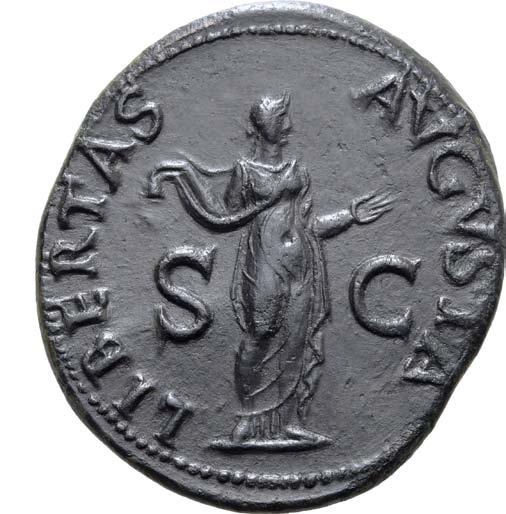
421.
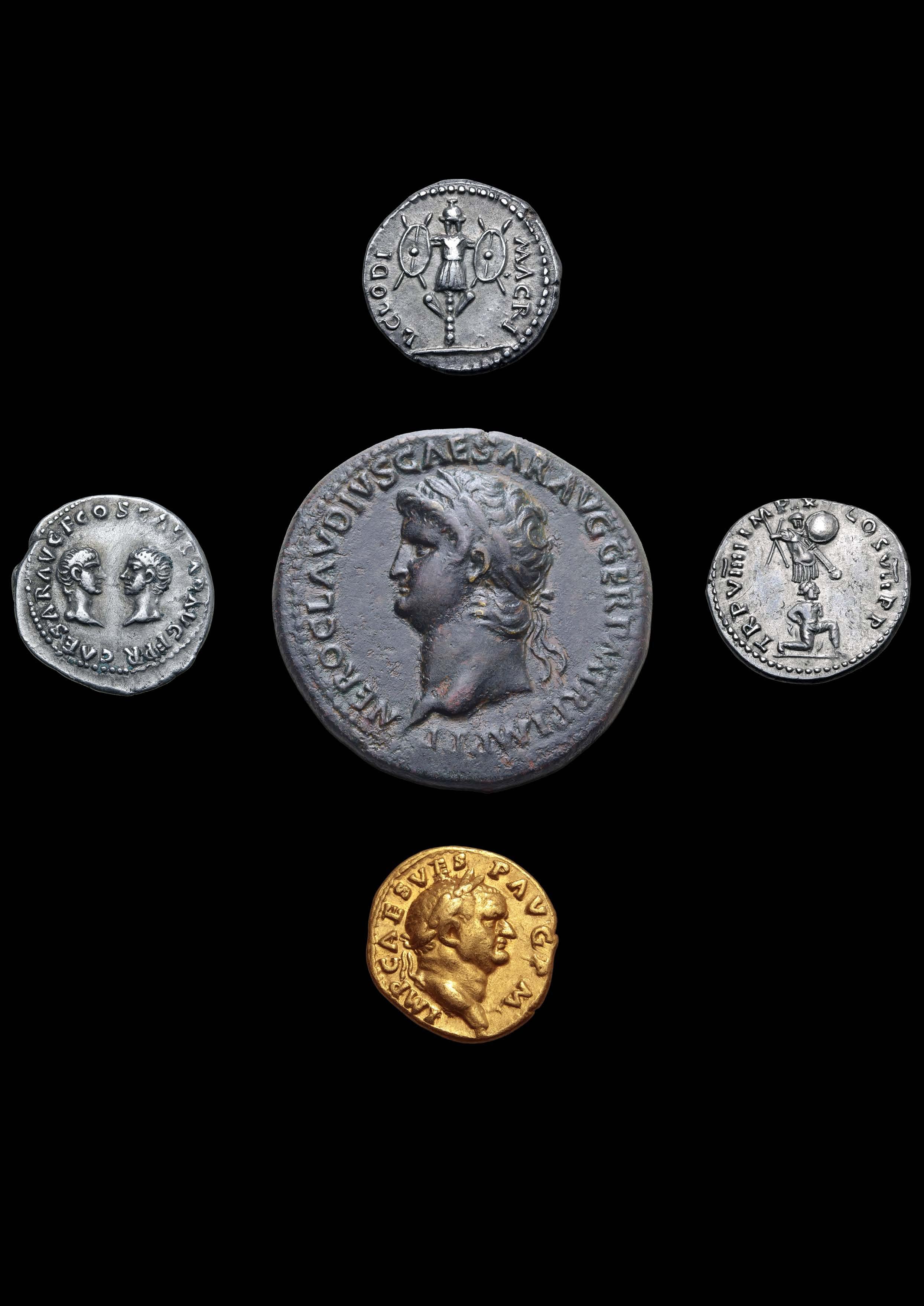

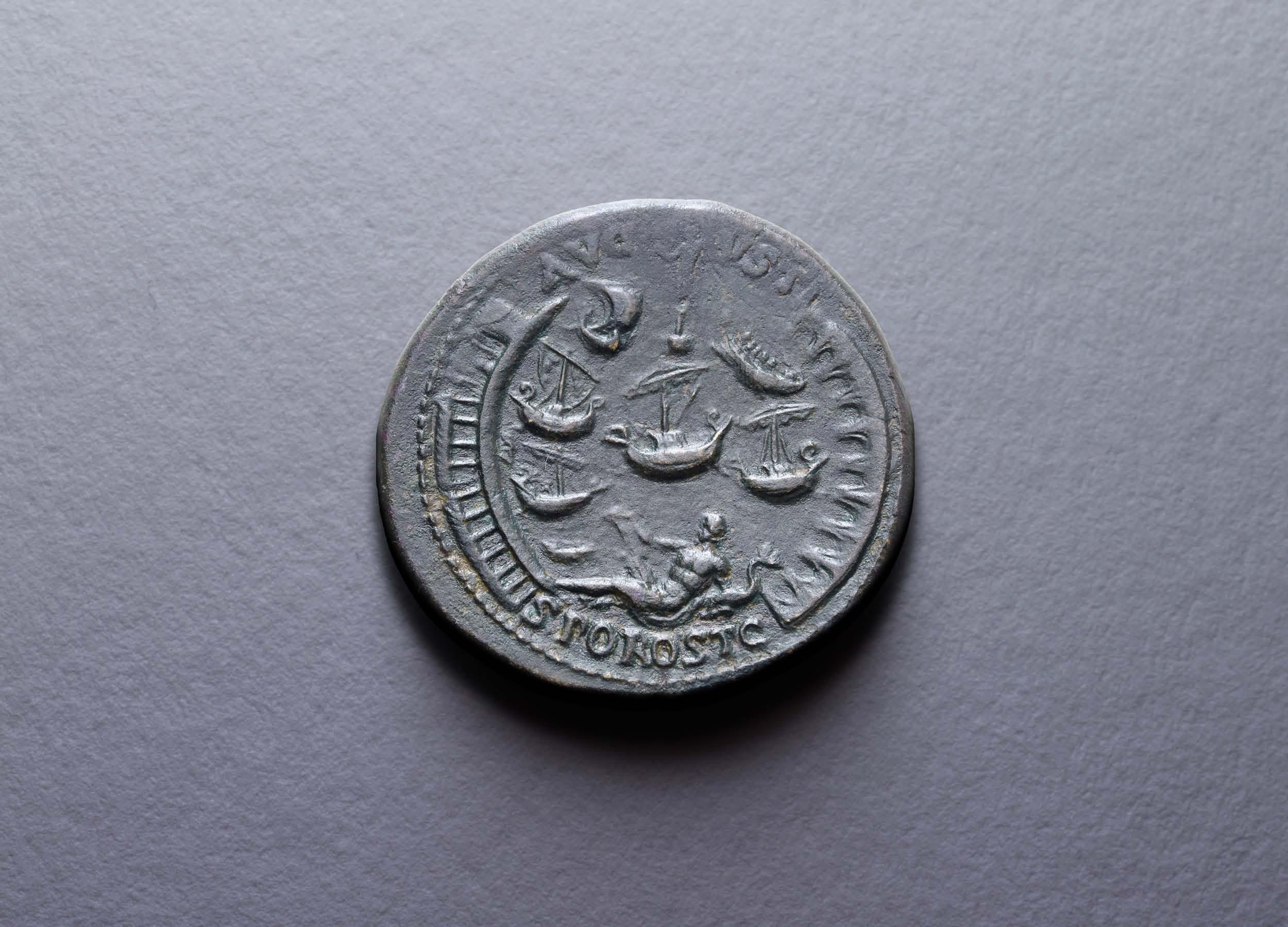

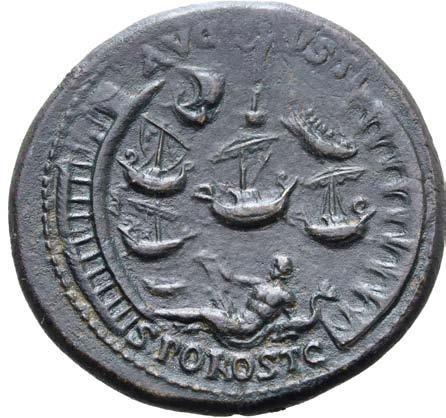
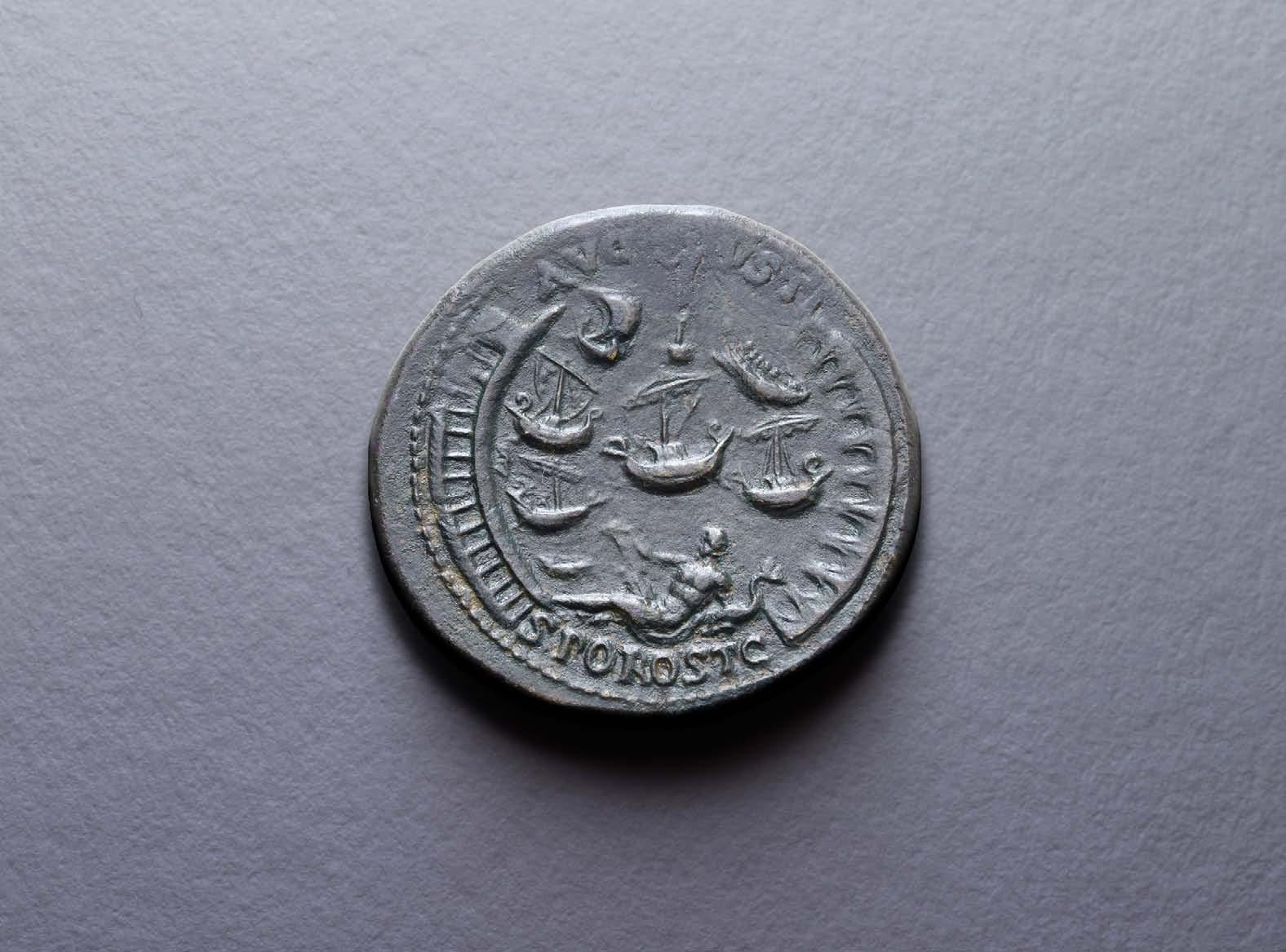
Nero Æ Sestertius. Rome, AD 62-68. NERO CLAVDIVS CAESAR AVG GER P M TR P IMP P
/
Ostia:
ships within harbour; at top is pharus surmounted by statue of Neptune; below is reclining figure of
holding
and
crescent-shaped pier with portico, terminating with figure sacrificing at altar and building; to right, crescent-shaped row of breakwaters or slips; AVGVSTI above, SPOR OST C below. RIC I 182; BN 291 (same rev. die); BMCRE 135 var. (seven ships). 28.32g, 37mm, 6h.
Near Extremely Fine. Scarce.
Ex Jesus Vico S.A., Auction 162, 12 July 2022, lot 131 (hammer: EUR 22,000); Ex Numismatic Fine Arts Inc., Auction XVIII, Beverly Hills, 11 April 1987, lot 441; Ex Bank Leu AG, Auction 33, 3 May 1983, lot 27.
10,500
No Reserve
This precise and intricately designed masterpiece of numismatic design depicts on its reverse an exquisite interpretation of the recently completed harbour at Ostia, begun by Claudius in AD 42 and simply named Portus (‘Harbour’). The porticos of the harbour curve around the left of the image and the breakwaters the right. A statue of Neptune, god of the sea, watches over the harbour from a lighthouse and at the entrance of the harbour the reclining river god Tiber is depicted holding a rudder and dolphin. These details are just the frame of this elaborate design, which has as its central focus a series of ships coming and going from the harbour supplying goods and grain to the people of Rome.
A site of tremendous importance, Ostia was once (as its name, derived from the Latin word for mouth, os, suggests) the seaport of the city of Rome located at the mouth of the Tiber, through which goods could arrive from overseas into the city. Settled first in the 7th Century BC as most likely the first Roman colonia (colony), it shows signs of continuous development into the Imperial period, by which time its primary importance was as the site through which the huge overseas grain imports reached the city of Rome, long since swollen beyond any ability to self-sustain. Yet it had a debilitating feature: sandbars, which prevented large ships from penetrating beyond its coastline and meant that goods had to be transported from vessel to vessel in order to reach the city. Both Augustus and Julius Caesar had plans to expand the harbour and render it more useful for the centre of the empire. Yet the considerable cost and engineering required to complete the works held them back and it was not until the reign of Claudius that the project was finally begun.
Suetonius describes the remarkable technological feats that Claudius initiated: “He constructed the harbour at Ostia by building curving breakwaters on the right and left, while before the entrance he placed a mole in deep water. To give this mole a firmer foundation, he first sank the ship in which the great obelisk had been brought from Egypt, and then securing it by piles, built upon it a very lofty tower after the model of the Pharos at Alexandria, to be lighted at night and guide the course of ships.” (Suetonius, The Lives, 20.3). The marvel of the works was commented on far and wide, and it even appeared on Pliny the Elder’s list of the ‘most marvellous buildings in Rome’, NH 36. 121125.
Ancient sources notably do not give any mention to Nero’s involvement in the completion of the harbour although it has often been cited as the reason for the issue of this remarkable series of sestertii. The literary evidence, however, suggests that Portus was perhaps completed while Claudius was still ruling. Naomi A. Weiss (‘The Visual Language of Nero’s Harbour Sestertii’, MAAR 58, 2013) argues convincingly instead that its primary message was of the security of the grain supply route under Nero, intended for an audience of the urban poor of Rome who would have dealt on a daily basis with low-denomination coins such as this. She states that the grain fleets’ “protection by architectural, technological, military and divine means” is encompassed in the symbols of this depiction. While the oared war-galley in the top right leaves the harbour as an extension of Roman military force, suggesting armed protection of the grain convoys, a narrative of the continuous and secure travel of these convoys is told by the merchant ship entering into the bustling harbour from top left while others lie at anchor in the centre. Overseeing all of this with divine favour is the reclining Tiber, through whose benevolent waters the grain is able to flow upriver to the hungry masses.


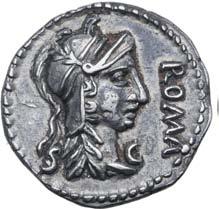

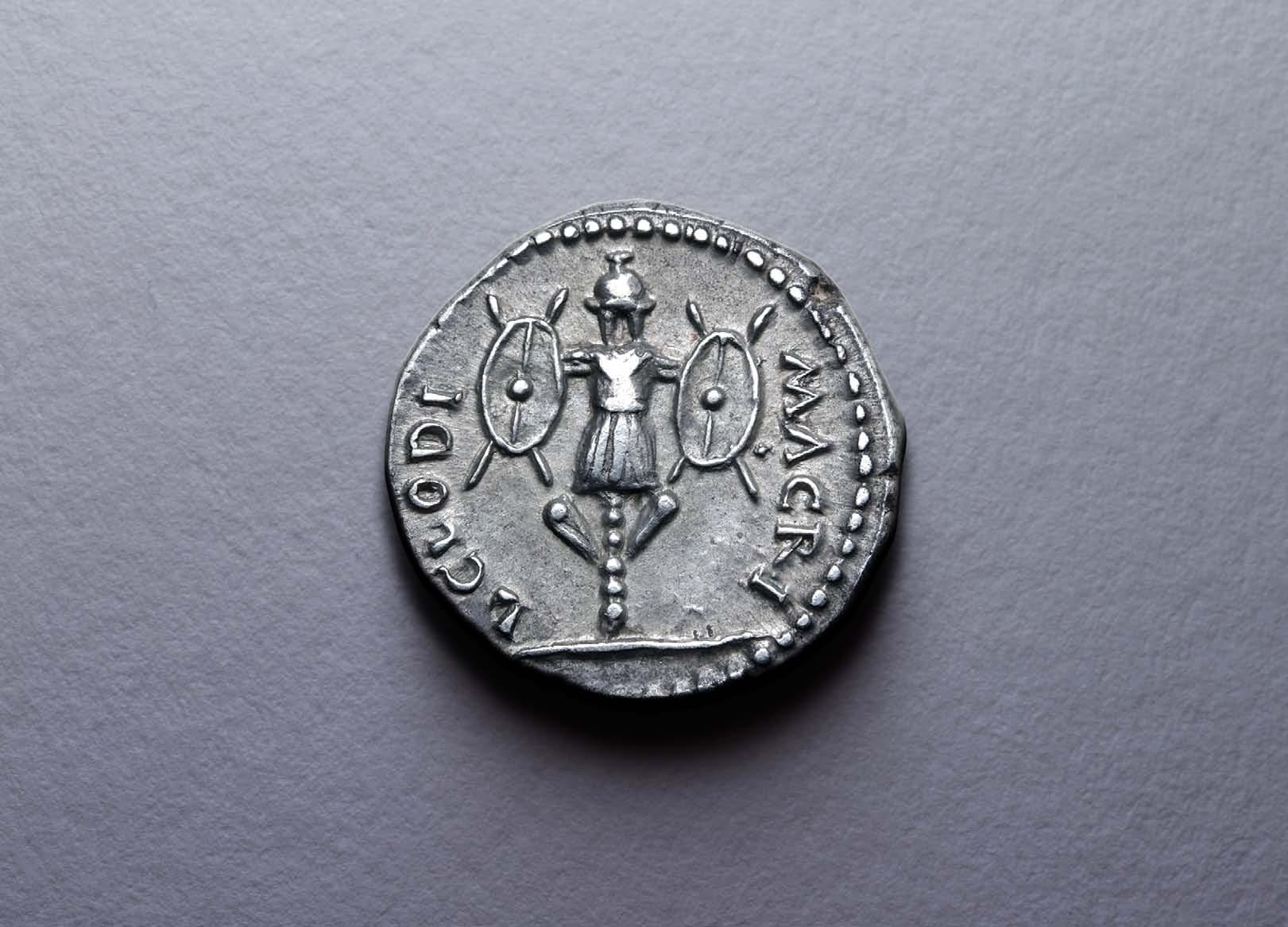
Clodius Macer AR Denarius. Carthage(?), April - October(?) AD 68. Helmeted head of Roma to right; ROMA before, S-C across fields / L CLODI MACRI, trophy. RIC I 31 var. (SC below); BMCRE p. 287 note var. (same); C. 9 var. (same); Hewitt, NC 1983, pl. XII, 47 var. (same); BN -. 3.47g, 18mm, 6h.
Extremely Fine; minor nick on cheek, well-struck on good metal with an attractive iridescent tone. An apparently unrecorded variety of an extremely rare type.
Ex Numismatica Ars Classica AG, Auction 101, 24 October 2017, lot 161 (hammer: CHF 47,500);
Ex Barry Feirstein Collection IV, Numismatica Ars Classica AG, Auction 45, 2 April 2008, lot 95;
Ex Pegasi Numismatics, Auction II, 8 June 1996, lot 298;
Ex Frank Sternberg, Auction XXVI, 16 November 1992, lot 290 (illustrated on the cover).
Clodius Macer led a revolt in North Africa against Nero in the spring of AD 68. Described by RIC as “short and ineffectual” (see RIC 1, p. 230), the revolt spanned several months which included the end of the Julio-Claudian dynasty with the suicide of Nero and the beginning of the ‘Year of Four Emperors’, a period described by Tacitus as “rich in disasters, terrible with battles, torn by civil struggles, horrible even in peace.” (Histories I.2). His coinage is extremely rare and several of his types are only known to us through a single example.
Though barely mentioned in the ancient literature (there are only two short references to him in Tacitus’ Histories), Clodius Macer was officially legatus Augusti propraetore Africae and was able to establish himself in North Africa with the support of Legio III Augusta and Legio I Macriana. It is very likely that he controlled Carthage and the mint there since a group of his denarii depict the obverse bust of CARTHAGO. If so, he had control over an important naval base and posed a threat to the corn supply from North Africa to Rome. The purpose of the revolt cannot be said to establish Clodius Macer as emperor, rather the numismatic evidence generally points to a desire to return to the ideals of the Republic and the end of imperial rule.
Many of the types used by Clodius Macer can be traced to Republican coins, as exemplified by the current coin with the trophy reverse type which is very similar to a coin issued by Brutus (cf. CRI 209). In addition, many of Clodius Macer’s coins use the formulaic SC (senatus consulto), not used on Roman silver coins since around 40 BC (See NAC Auction 101, lot 161). This was a tactic also possibly employed by Galba on his ‘African’ issues, if indeed they were struck by Galba and not merely issued in his name. Further similarities have been pointed out between the coinage of Clodius Macer and Galba such as the use of the genitive case for their names and the decision (not sustained for long by Galba) to not appear laureate (see The Coinage of L. Clodius Macer (AD 68) by K. V. Hewitt (1983), pp. 64-80). These similarities perhaps point to a unity in purpose while Nero was still alive, a wish to overthrow the emperor. However, Clodius Macer’s continual rebellion against imperial rule once Galba had ascended to power led to his execution in October 68 (see Tacitus Histories I.7).
425.
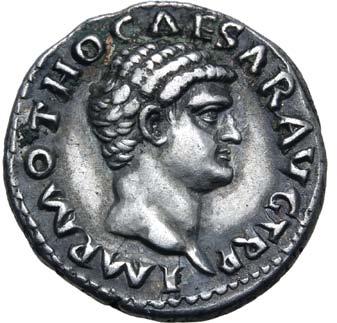

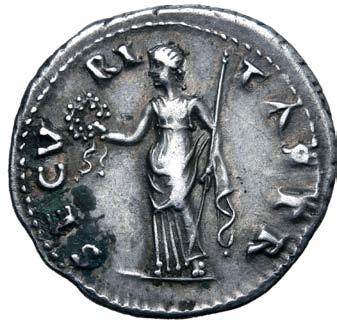
426.
427.
Otho AR Denarius. Rome, AD 69. IMP M OTHO CAESAR AVG TR P, bare head to right / SECVRITAS P R, Securitas standing to left, holding wreath and sceptre. RIC I 8; BMCRE 17; RSC 17. 3.32g, 19mm, 6h.
Extremely Fine.
Ex Artemide Aste s.r.l., Auction LVII, 30 May 2022, lot 480 (hammer: EUR 3,200).
It is well known that the emperor Otho regularly wore a wig to hide his hair loss, a fact that can be clearly seen on this coin. The abrupt transition from hairline to face along with the regular, pattern-like waves makes it clear to the viewer that the portrait subject is bewigged. There was more to Otho’s decision to don this item than to merely appear distinguished; the association of hair loss with lack of virility and inviting derision is well documented in Suetonius when discussing Julius Caesar’s baldness. Gleason (1990) expands further on this evidence suggesting that hair loss may also have been considered to lead to ‘dangerous effeminisation’, a quality not desirable in a Roman Emperor
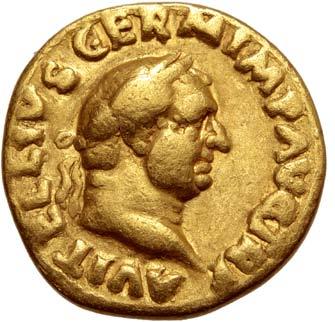



Vitellius AV Aureus. Rome, late April - 20 December AD 69. A VITELLIVS GERM IMP AVG TR P, laureate head to right / LIBERTAS RESTITVTA, Libertas standing facing, head to right, holding pileus and long rod. RIC I 104; C. 46; BMCRE 30; Calicó 562. 7.07g, 19mm,
Near Very Fine.
Ex Roma Numismatics Ltd., E-Sale 102, 3 November 2022, lot 912.



Very Fine; plugged at 12h.
Ex D.K. Collection;
Ex Mendoza Collection, Classical Numismatic Group, Electronic Auction 465, 8 April 2020, lot 366.


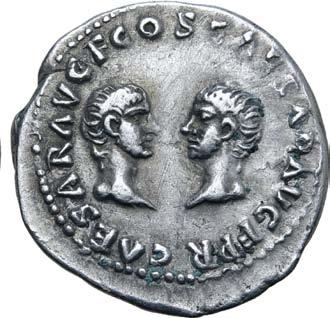
900
424. 750
Near Extremely Fine.
Ex Phidias (Paris), vente numismatique, 29 June 2022, lot 190.


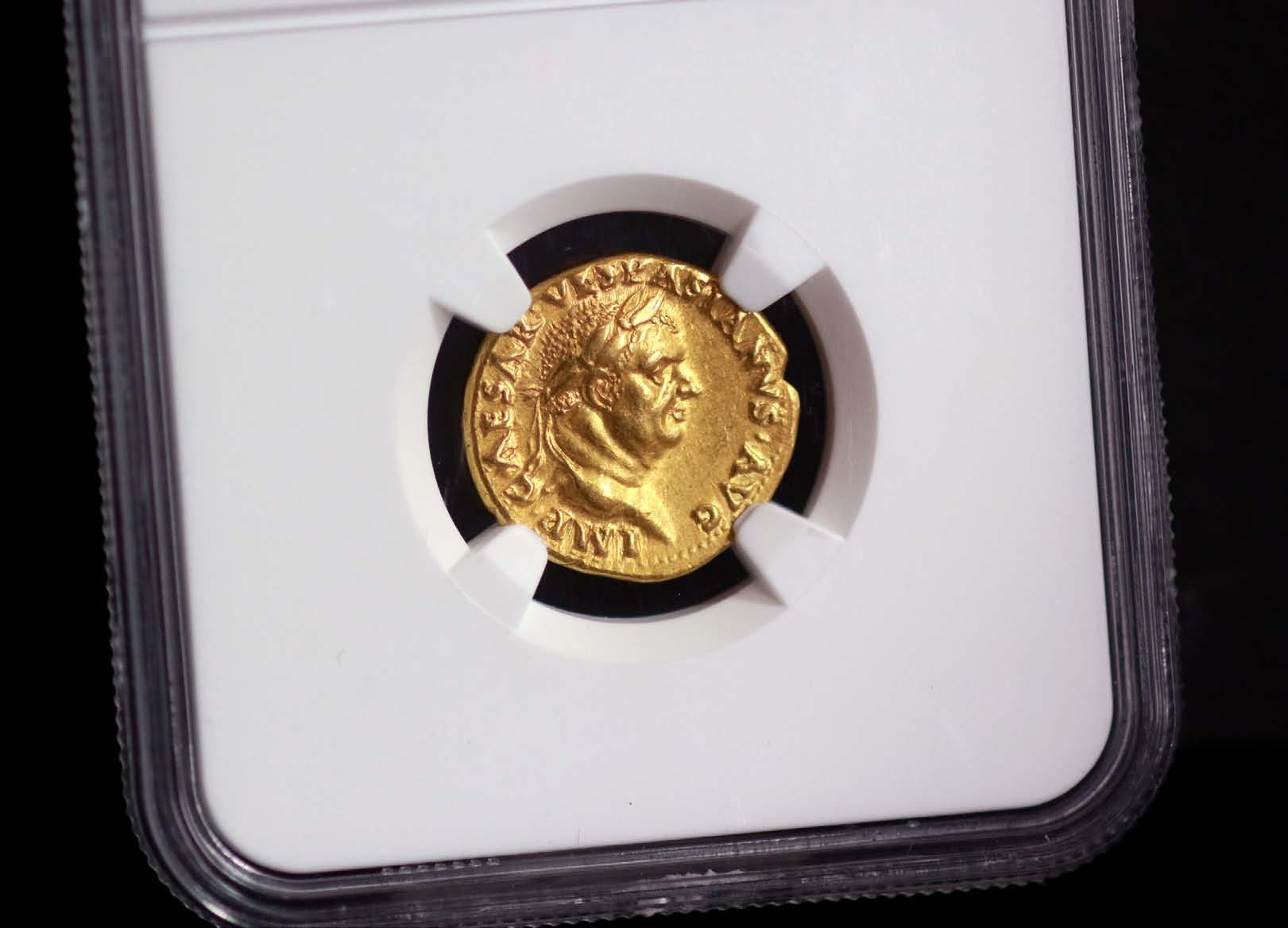
Vespasian AV Aureus. Lugdunum, AD 71. IMP CAESAR VESPASIANVS
/ TITVS ET DOMITIAN
NGC graded Ch XF 4/5 - 4/5 (#6944528-001). Struck from dies of fine style and preserved with beautifully lustrous metal. Unpublished and seemingly unique - a remarkable addition to the corpus of Flavian coinage.
7,500 No Reserve
This unpublished aureus provides an illuminating insight into the relationship between the emperor Vespasian and his sons Titus and Domitian and his desire to establish the legitimacy of his new Flavian dynasty. The implied emphasis on a linear succession, highlighted by the depiction of his two sons on the reverse of this coin is particularly pertinent from a historical perspective, given that Titus’ succession of Vespasian in AD 79 represented the first occasion since the inception of the principate by Augustus that a biological child had been the successor to an emperor.
Vespasian, having been sent to Judaea by Nero in AD 66 to put down the Jewish rebellion, was joined by Titus, by now a tried, tested and capable commander who brought his own legion to support the existing troops. Josephus describes in vivid detail the taking of the city of Taricheae by Titus, who he says was the first to enter the city ahead of his men, his boldness taking those guarding the walls by surprise and allowing his forces to overwhelm them, to the delight of his father (The Wars of the Jews, III.10.5-6).
During the chaos that ensued at Rome after the death of Nero in AD 69, Titus was sent to pay Vespasian’s respects to the new emperor Galba, although he never reached Rome as he learned en route that Galba was already dead at the hands of Otho, with Vitellius preparing to march on Rome. Titus therefore abandoned the journey and rejoined his father in Judaea; he was then the crucial interlocutor (Tacitus, Histories, II.5) between Vespasian and the Syrian governor in negotiations that gained the military support of the governor of Syria, Gaius Licinius Mucianus. This provided Vespasian with the necessary forces to emphatically defeat the third new emperor of the same year, Vitellius, and ascend to the purple in December of AD 69.
Titus was left in Judaea in AD 69, entrusted with bringing an end to the Jewish rebellion, thus freeing Vespasian to march on Rome. After his success at the siege of Jerusalem he returned to Rome, arriving in AD 71, which coincides with the date for the striking of this coin. He was received with much acclaim and fanfare, and his father immediately appointed him to several positions within the state, including those of consul and Praetorian Prefect, the latter giving him authority over the Praetorian guard. Both he and his brother Domitian were furthermore confirmed in the rank of Caesar, to which they had already been appointed, and received the honorific of Princeps Iuventutis.
While Domitian was 12 years Titus’ junior and therefore had been less able to demonstrate the same military and diplomatic abilities as his brother by the time Vespasian came to power, he was nevertheless promoted simultaneously with Titus. This decision to show no outward favouritism appears to be reflected by the iconography of this coin, which depicts them as equals: they are both seated on curule chairs, which had been long-associated with offices of power, despite the fact that in reality Domitian’s official roles as Caesar and Praetor were only nominal and did not represent the wielding of any significant control. It is clear, however, that Vespasian was eager to represent both his sons as worthy successors.
429.
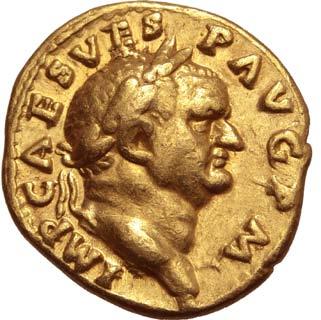



Vespasian AV Aureus. “Judaea Capta” commemorative issue. Rome, AD 71. IMP CAES VESP AVG P M, laureate head to right / Victory standing to right on globe, holding wreath and palm; VIC-AVG across fields. RIC II.1 47; C. 583; BMCRE 63; BN 47; Calicó 698; Roma XV, 527 (hammer: 5,500 GBP). 7.28g, 18mm, 6h.
Good Very Fine.
Ex Roma Numismatics Ltd, E-Sale 100, 28 July 2022, lot 1028.
Part of the series of victory issues struck after the successful conclusion of the Jewish War.

430.


Vespasian AR Denarius. Rome, AD 77-78. CAESAR VESPASIANVS AVG, laureate head to right / Modius with seven ears of grain; IMP-XIX across fields. RIC II.1 980; BMCRE 216; RSC 219. 3.21g, 19mm, 5h.
Near Extremely Fine.
Ex Jesus Vico S.A., Auction 160, 14 December 2021, lot 384 (since professionally conserved).
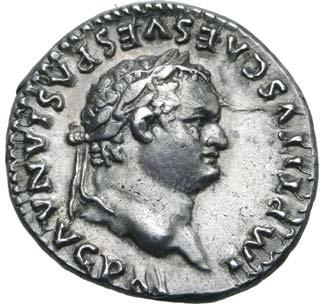
431.


Titus AR Denarius. Rome, AD 79. IMP TITVS CAES VESPASIAN AVG P M, laureate head to right / TR P VIIII IMP XV COS VII P P, captive, with hands tied behind back, kneeling before trophy composed of helmet, cuirass, crossed spears, shield and parazonium. RIC II.1 49; BMCRE 31; RSC 295. 3.48g, 18mm, 6h.
Good Extremely Fine.
Ex Naville Numismatics Ltd., Auction 73, 8 May 2022, lot 459.

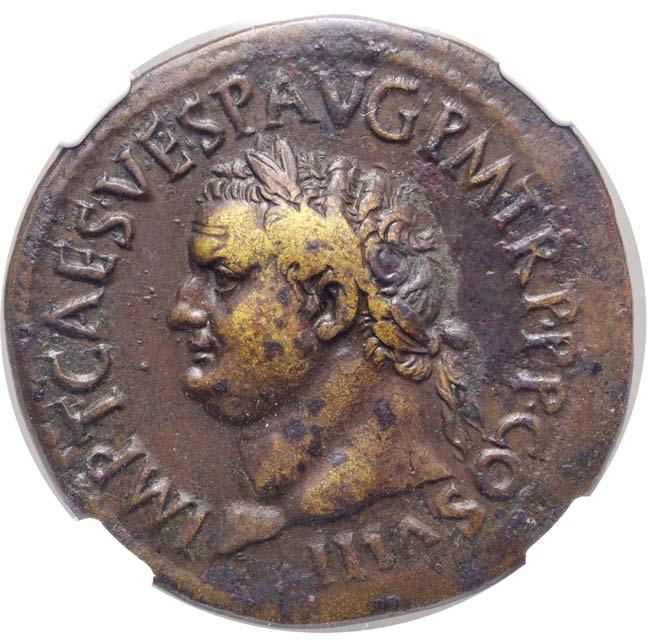
432.
Titus Æ Sestertius. Rome, AD 80-81. IMP T CAES VESP AVG P M TR P P P COS VIII, laureate

/ Spes
holding flower and raising skirt; S-C across fields. RIC II.1 170; C. 222; BMCRE 184. 23.19g.
NGC graded Ch VF 5/5 - 3/5, Fine Style, lt. smoothing (#4682639-008).
Ex Roma Numismatics Ltd., E-Live Auction 6, 25 March 2023, lot 173; Ex collection of Ralph van Deman Magoffin (1874-1942), Stack’s Bowers Galleries (& Ponterio), January 2019 NYINC Auction, 11 January 2019, lot 42161.


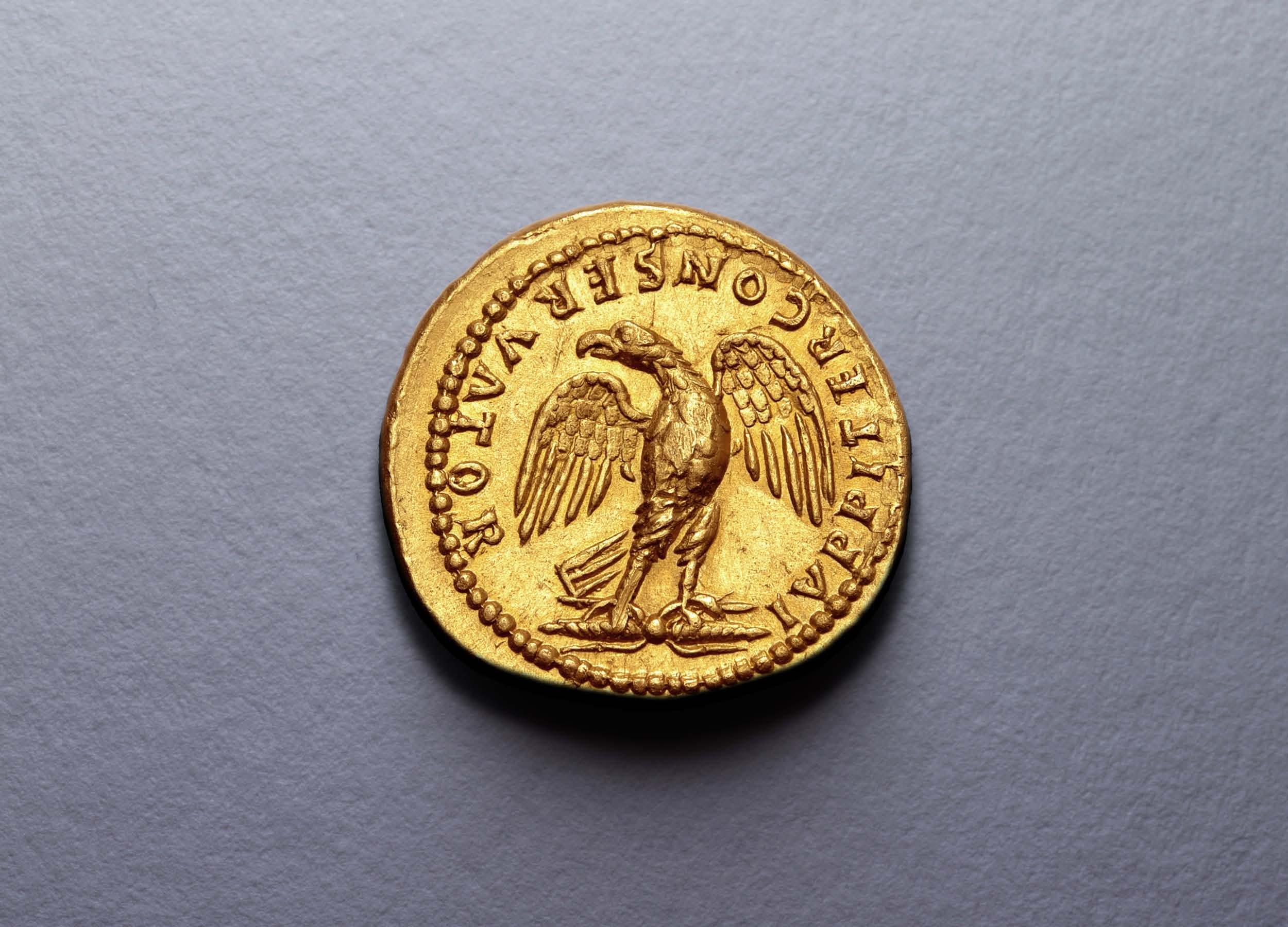

433.
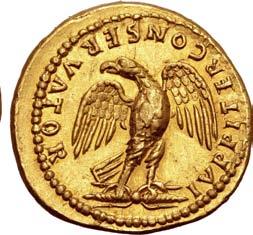

Domitian AV Aureus. Rome, AD 82-83. IMP CAES DOMITIANVS
Good Extremely Fine. Very Rare.
Ex G.T. Collection of the Twelve Caesars, Roma Numismatics Ltd., Auction XX, 30 October 2020, lot 501; Ex Numismatica Ars Classica AG, Auction 100, 29 May 2017, lot 462 (hammer: CHF 32,000).
12,000 No Reserve
The aquila (eagle) has long been regarded as one of the most ancient and enduring emblems of the Roman people. Its importance to the Romans derives from its association with Jupiter, supreme deity of the Roman pantheon, revered as the patron of the Roman state since the earliest days of the kings.
Stemming ultimately from the Greek tradition of the ‘aetos dios’ being the personal messenger and companion of Zeus, its mythological history is uncertain, and the surviving sources are very late; according to Antoninus Liberalis (Metamorphoses VI), c. AD 100-300, it was once a mortal king name Periphas, renowned for his just and noble rule, transformed by Zeus and made king of the birds.
Fulgentius (Mythologiarum Libri III), c. AD 475-525 relates the eagle as being a creation of the primordial goddess Gaia, appearing before Zeus at the start of the Titanomachy, the great war between the Olympian gods and their predecessors the Titans, which Zeus took to be a favourable omen of victory leading him to adopt the eagle as his own attribute: “for so happy an omen, especially since victory did ensue, he made a golden eagle for his war standards and consecrated it to the might of his protection, whereby also among the Romans, standards of this kind are carried.”
Frequently employed as a representative motif with protective connotations invoking the divine assistance of Jupiter (hence the thunderbolt it often clutches), the eagle itself was associated with strength, courage and far-sightedness, on account of which qualities it was readily adopted by the Roman military as a legionary ensign along with the wolf, bull, horse and boar (Pliny the Elder, Naturalis Historia X.16). From the second consulship of Gaius Marius in 104 BC, the Aquila became the sole symbol of the Roman legions.
On the Roman coinage, the eagle was utilized on some of the earliest issues, appearing on aes signatum (BMC 2, Crawford 4.1a) in the early-mid third century BC, and on the gold coinage issued during the Second Punic War c. 211-207, and subsequently employed sporadically throughout the time of the Republic. Its usage on Imperial coinage after the reign of Augustus is surprisingly limited, but the type was revived by the Flavians for issues of gold and silver, after which time the eagle appears almost invariably either on ‘consecration’ issues denoting the elevation of an emperor or empress to a status of divinity (as when Zeus sent his eagle to fetch the handsome youth Ganymede to heaven to become the cup-bearer of the gods), or as an adjunct symbol. It would not be until after the fall of the Western Empire that the eagle would once again be featured as the principal type of the coinage of Rome, c. AD 493-534; this municipal coinage would also be the last issued by the ancient Romans in their own name.
As such it may be argued that there is a melancholic circularity to the Roman coinage as there is also found in the names of her rulers: as Romulus and Augustus were the first king and first emperor, and Romulus Augustus the last emperor, so too was the eagle boldly imprinted on both the earliest and last coins of Rome.

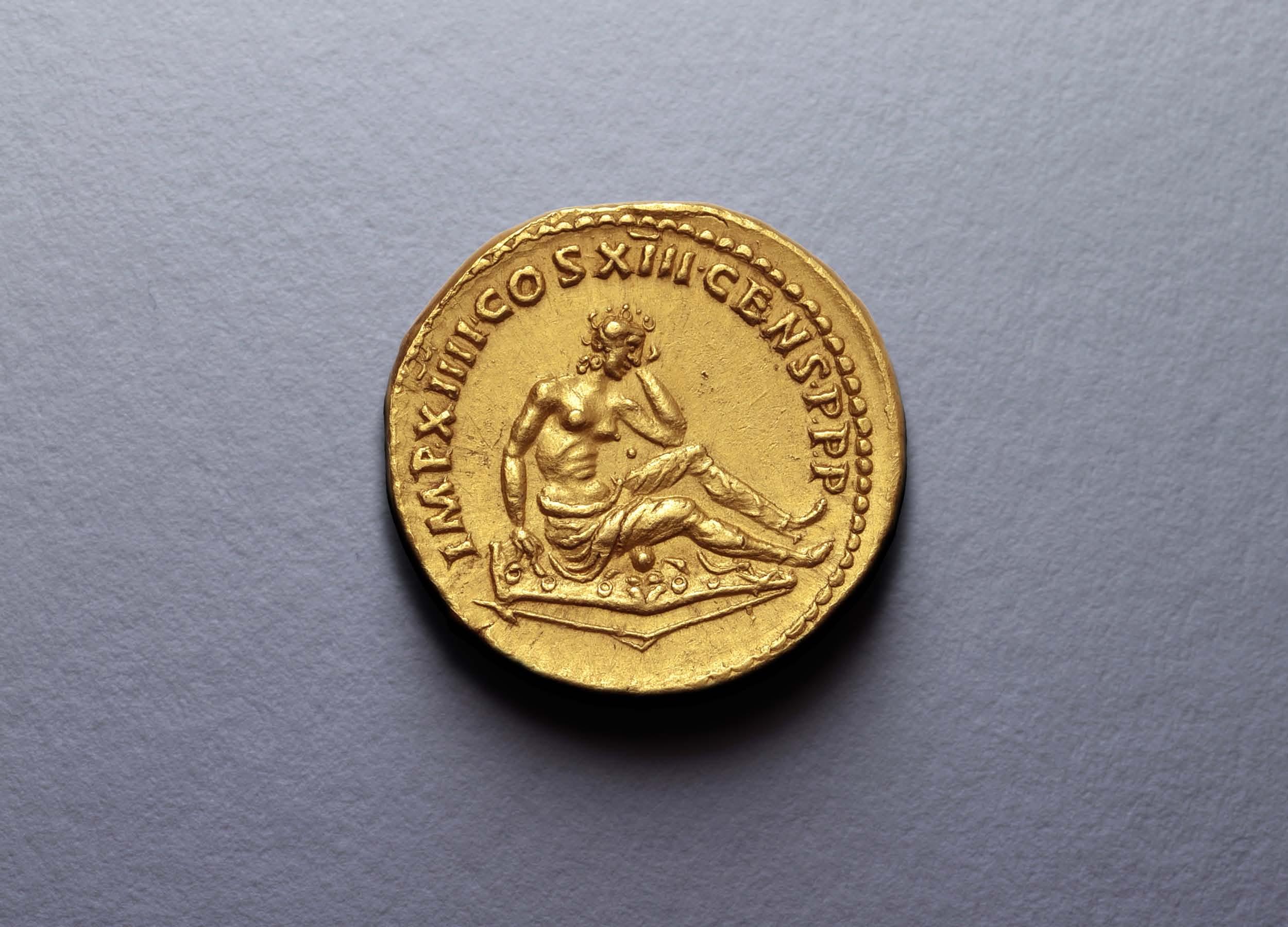
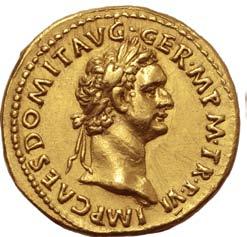
434.


Domitian AV Aureus. Rome, AD 87. IMP CAES DOMIT AVG GERM P M TR P
/ IMP XIIII COS XIII CENS
female German captive seated on shield to right in attitude of mourning; broken spear below. RIC II.1 513 (R2); C. -; BMCRE -; Calicó 882. 7.62g, 20mm, 6h. Extremely Fine; light traces of mounting and marks, an excellent example, with wonderful reverse detail. Previously graded Ch XF 5/5 - 3/5, Fine Style, edge filed (#4282739-003). Very Rare.
Ex Numismatica Ars Classica, Auction 120, 6 October 2020, lot 738;
Ex Classical Numismatic Group, Triton XXIII, 14 January 2020, lot 711;
Ex Leu Numismatik AG, Auction 2, 11 May 2018, lot 248;
Ex cgb.fr, e-Monnaies March 2017, lot 68.
7,920
No Reserve
This beautiful issue was struck in commemoration of Domitian’s campaigns against the Chatti in Germany in AD 83. At Domitian’s accession following the death of both his father and brother, Domitian was keen to accrue military victories of his own. Much of his career had been spent performing a purely ceremonial role in the governance of the provinces, and his lust for glory following his father and brother’s impressive military victories was noted by Suetonius, as he explains he “...planned a quite unnecessary expedition into Gaul and Germany, from which his father’s friends managed to dissuade him”.
Domitian’s need to prove himself and equal his familial predecessors’ achievements is perhaps understandable given the shadow of reflected glory he had lived in all his life; the new emperor’s opportunity presented itself when the Chatti, a German tribe, invaded Roman territory in the area of modern Mainz. By AD 83/84 Domitian had successfully dealt with the incursion and for his victory, a distinction he had long been craving, Domitian staged a triumphal entry to the capital with pomp and splendour. He also granted himself the title of ‘Germanicus’ (Jones, The Emperor Domitian, p.128-131), he renamed the month of September ‘Germanicus’ and from the year AD 85 he began minting coins with the legend GERMANIA CAPTA, an echo of the magnificent triumphal celebrations of AD 71, when Vespasian and Titus returned to Rome following the pacification of Judea.
It was in this context that the present aureus was struck. Encompassed by the emperor’s new title ‘Germanicus’ and the formula denoting his consulship for the fourteenth time sits a figure with her head bowed, resting in her hand, the personification of Germania - mourning. Soft drapery falls over Germania’s lap as she sits beside an ornate hexagonal shield that could not withstand the might of the Roman forces and a spear, broken in the middle and rendered unusable. The pathos of this scene is reminiscent of the sculpture now generally referred to as the Dying Gaul and housed in the Capitoline Museums in Rome.
However, doubt is cast on the validity of Domitian’s success against the Chatti by Suetonius, who deemed the campaign ‘unjustified’ (Suetonius, Life of Domitian 6) and by Tacitus in his ‘Agricola’. Though perhaps somewhat biased as Tacitus was writing about the life of his father-in-law, when discussing his successes in Britain he mentions that “Domitian heard, as was his wont, with joy in his face but anxiety in his heart. He felt conscious that all men laughed at his late mock triumph over Germany, for which there had been purchased from traders people whose dress and hair might be made to resemble those of captives, whereas now a real and splendid victory, with the destruction of thousands of the enemy, was being celebrated with just applause.” These writers saw the campaign and the proceeding celebrations as extravagant beyond reason. To them it seemed a construction to overshadow the glory granted to Vespasian and Titus, considering the very small territorial gain the campaign resulted in and the fact that neither Vespasian nor Titus took the title ‘Iudaicus’ following their victories in Judea (Jones, The Emperor Domitian, p.129).
Yet despite being wrapped up in a programme of self-aggrandizement the campaign was in itself significant and had a lasting historical impact, not so much for the territory gained than for the measures taken to secure this territory in the future. With his victory over the Chatti, Domitian laid the foundations for a new system of securing the Roman frontiers in Germany, which resulted in the Limes: a series of watch towers, signal stations and a network of roads with which the borders of the empire could be rapidly reinforced and defended.



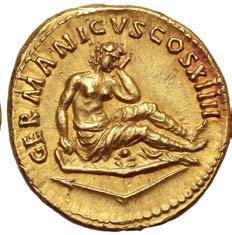

Domitian AV Aureus. Rome, AD 88. DOMITIANVS AVGVSTVS, laureate head to right / GERMANICVS COS XIIII, Germania seated to right on shield; broken spear below. RIC II.1 560 (same dies); C. 148; BMCRE 143; Biaggi
Near Mint State; small planchet manufacturing flaw on neck, a marvellous portrait of Domitian. Rare.
Ex Nomos AG, Auction 24, 22 May 2022, lot 404 (hammer: CHF 44,000);
Ex Numismatica Ars Classica, Auction 41, 20 November 2007, lot 69;
Ex Sotheby’s, 8 July 1996, lot 168;
Ex Numismatic Fine Arts, Auction XX, 9 March 1988, lot 168.
21,000
No Reserve
This beautiful issue was struck in commemoration of Domitian’s campaigns against the Chatti in Germany in AD 83. At Domitian’s accession following the death of both his father and brother, Domitian was keen to accrue military victories of his own. Much of his career had been spent performing a purely ceremonial role in the governance of the provinces, and his lust for glory following his father and brother’s impressive military victories was noted by Suetonius, as he explains he “...planned a quite unnecessary expedition into Gaul and Germany, from which his father’s friends managed to dissuade him”.
Domitian’s pathological need to prove himself and equal his familial predecessors’ achievements is perhaps understandable given the shadow of reflected glory he had lived in all his life; the new emperor’s opportunity presented itself when the Chatti, a German tribe, invaded Roman territory in the area of modern Mayence. By AD 83/84 Domitian had successfully dealt with the incursion and for his victory, a distinction he had long been craving, Domitian staged a triumphal entry to the capital with pomp and splendour. He also granted himself the title of ‘Germanicus’ (see Jones, The Emperor Domitian, p. 128-131), he renamed the month of September ‘Germanicus’ and from the year AD 85 he began minting coins with the legend GERMANIA CAPTA, an echo of the magnificent triumphal celebrations of AD 71, when Vespasian and Titus returned to Rome following the pacification of Judea.
It was in this context that the present aureus was struck. Encompassed by the emperor’s new title ‘Germanicus’ and the formula denoting his consulship for the fourteenth time sits a figure with her head bowed, resting in her hand, the personification of Germania - mourning. Soft drapery falls over Germania’s lap as she sits beside an ornate hexagonal shield that could not withstand the might of the Roman forces and a spear, broken in the middle and rendered unusable. The pathos of this scene is reminiscent of the sculpture now generally referred to as the Dying Gaul and housed in the Capitoline Museums in Rome.
However, doubt is cast on the validity of Domitian’s success against the Chatti by Suetonius, who deemed the campaign ‘unjustified’ (Suetonius, Life of Domitian 6) and Tacitus in his ‘Agricola’. Though perhaps somewhat biased as Tacitus was writing about the life of his father-in-law, when discussing his successes in Britain he mentions that “Domitian heard, as was his wont, with joy in his face but anxiety in his heart. He felt conscious that all men laughed at his late mock triumph over Germany, for which there had been purchased from traders people whose dress and hair might be made to resemble those of captives, whereas now a real and splendid victory, with the destruction of thousands of the enemy, was being celebrated with just applause.” These writers saw the campaign and the proceeding celebrations as extravagant beyond reason. To them it seemed a construction to overshadow the glory granted to Vespasian and Titus, considering the very small territorial gain the campaign resulted in and the fact that neither Vespasian nor Titus took the title ‘Iudaicus’ following their victories in Judea (Jones, The Emperor Domitian, p. 129), .
Yet despite being wrapped up in a programme of self-aggrandizement the campaign was in itself significant and had a lasting historical impact, not so much for the territory gained than for the measures taken to secure this territory in the future. With his victory over the Chatti, Domitian laid the foundations for a new system of securing the Roman frontiers in Germany, which resulted in the Limes: a series of watch towers, signal stations and a network of roads with which the borders of the empire could be rapidly reinforced and defended.




436.
Nerva AR Denarius. Rome, AD 97. IMP NERVA CAES AVG P M TR P COS III P P, laureate head to right / FORTVNA AVGVST, Fortuna standing facing, head to left, holding cornucopiae and rudder. RIC II 16; BMCRE 37; RSC 66. 3.34g, 18mm, 6h. Mint State.
Ex Roma Numismatics Ltd., E-Sale 66, 9 January 2020, lot 915 (hammer: 1,500 GBP).


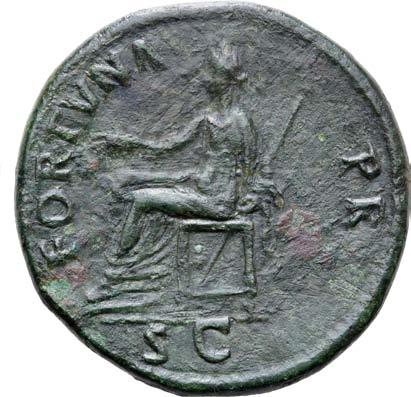
437.
Nerva Æ Sestertius. Rome, AD 97. IMP NERVA CAES AVG P M TR P COS III P P, laureate head to right / FORTVNA P R, Fortuna seated to left, holding corn-ears and sceptre; SC in exergue. RIC II 85; C. 80; BMCRE 110. 27.42g, 34mm, 5h.
Good Very Fine; light cleaning marks, featuring a handsome portrait of Nerva and an attractive green patina.
Ex Roma Numismatics Ltd., E-Live Auction 6, 25 March 2023, lot 184.
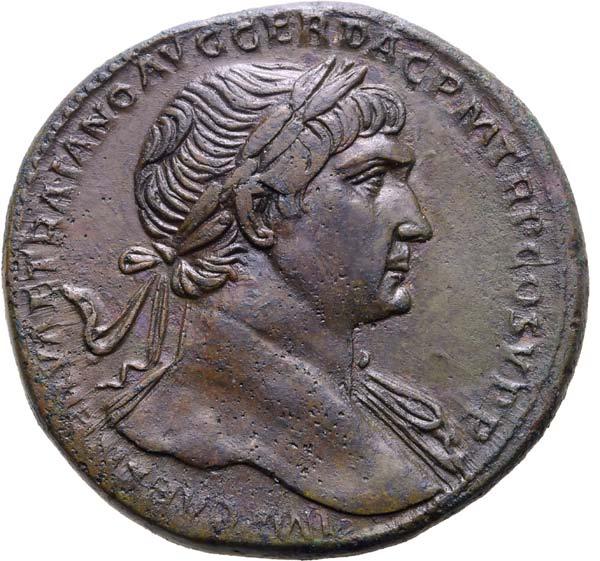


438.
Extremely Fine; boasting an attractive brown patina.
450
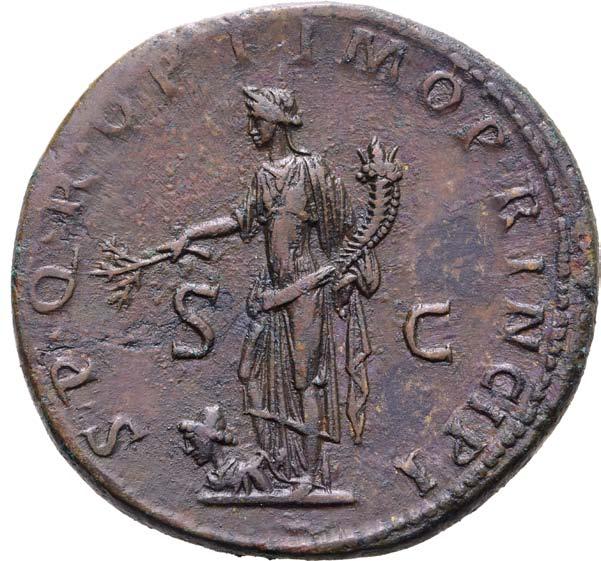
150
210

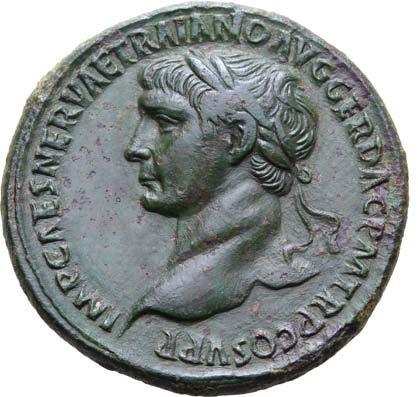
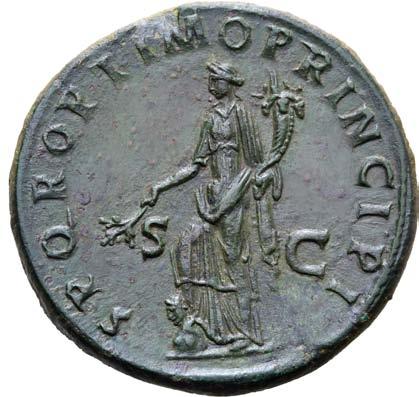

439.
Æ Sestertius. Rome, AD 104-107. IMP CAES NERVAE
II
M
P
Good Extremely Fine; a perfectly centred specimen featuring a handsome portrait and a beautiful green patina, lightly smoothed in fields. Extremely Rare; seemingly the finest of fewer than five known examples.
This coin published in J. Lacourt, Sesterces des Antonins, Volume I - Nerva - Trajan (France, 2022);
Ex Roma Numismatics Ltd., Auction XXIII, 24 March 2022, lot 920;
Ex Numismatica Ars Classica, Auction 59, 4 April 2011, lot 967.
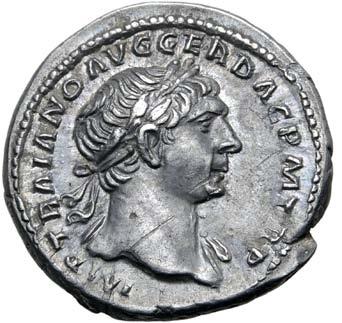
440.


Trajan AR Denarius. Rome, AD 108-109. IMP TRAIANO AVG GER DAC P M TR P, laureate bust to right, slight drapery on far shoulder / COS V P P S P Q R OPTIMO PRINC, Aequitas standing to left, holding scales and cornucopiae. RIC II p. XIV, addenda to p.252; BMCRE 281;
RSC 85. 3.33g, 19mm, 6h.
Good Extremely Fine; light scratch to obv., hints of blue-gold iridescence around the devices.
Ex Roma Numismatics Ltd., Auction XXIII, 24 March 2022, lot 927.
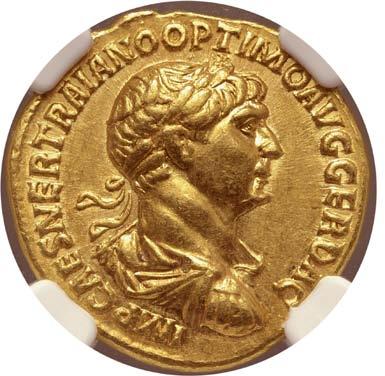


441.
NGC graded Ch XF 5/5 - 4/5 (6944543-007).
Ex Roma Numismatics Ltd., Auction XXIII, 24 March 2022, lot 935 (hammer: GBP 4,800).
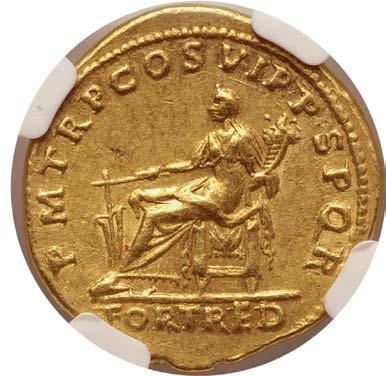

442.


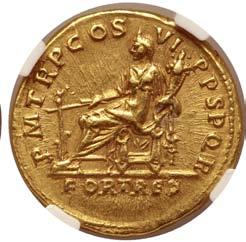
114-116.
NGC graded Ch XF 5/5 - 4/5, Fine Style (#6944528-004); a beautiful example of Trajan’s ‘heroic’ portraiture. Extremely Rare; only the second example to appear at auction in the past 20 years.
Ex Roma Numismatics Ltd., Auction XXIII, 24 March 2022, lot 934 (hammer: GBP 9,000).
4,500 No Reserve
Trajan’s portrait on the obverse of the present aureus casts him in a heroic guise, imbued with symbolism. The date for the striking of this coin coincides with his consenting to take the epithet of ‘Optimus’ as part of his personal title, an honorific that had been bestowed on him by the Senate back in AD 105. Indeed, there appears to be no modesty in the iconography of this portrait; not only is he wearing the divine attribute of the aegis, but he is also portrayed above a globe, highlighting the unending nature of his empire. The style of this portrait could furthermore be seen as combining a tradition of veristic portraits, which evokes the senatorial portraits of the Republican period, with a more idealised, allegorical image of a benevolent warrior emperor.




443.
Near Extremely Fine; a well-centred example.
1,800 No Reserve

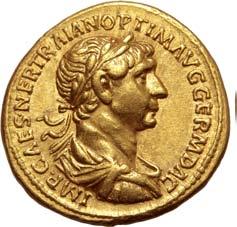


444.
Trajan AV Aureus. Rome, AD 116-117. IMP CAES NER TRAIAN OPTIM AVG GERM DAC, laureate, draped and cuirassed bust to right / PARTHICO P M TR P COS VI P P S P Q R•, radiate and draped bust of Sol to right. RIC II 329; C. 187 var. (obverse legend); BMCRE 621; Woytek 572f; Calicó 1038a. 7.19g, 20mm, 7h.
Extremely Fine.
In AD 113, Trajan left Rome to embark upon his Parthian campaign. Osroes despatched an embassy from the Parthian court which finally met the emperor in Athens, by which point it was too late for him to turn back, and as R. P. Longden so eloquently writes, ‘their apprehensive humility would have no doubt only sharpened his zest for the enterprise’. (Cf. Longden, R.P., ‘Notes on the Parthian Campaigns of Trajan’, The Journal of Roman Studies 21, (1931), pp. 1-35).
The following year, Trajan invaded Armenia, deposed its king Parthamasiris, and annexed it as a Roman province. In 115, Trajan also annexed Northern Mesopotamia, and later the same year he captured the Parthian capital of Ctesiphon. Following the conquest of Ctesiphon, Trajan accepted the title ‘Parthicus’ in 115-116, which features as the reverse legend on the types of this lot; the bust of Sol, who rises in the East, may symbolise Roman dominance over the region.
Trajan’s glory was short-lived, however, since in late 116 revolts broke out in Armenia and Northern Mesopotamia, forcing Trajan to abandon his campaign to increase the territory of the Rome and consolidate that which he had already gained. Dio Cassius relates that on looking out towards India, Trajan lamented that his age prevented him from following in the footsteps of Alexander (LXVIII 28.1).




445.
Hadrian AV Aureus. Rome, AD 118. IMP CAESAR TRAIAN HADRIANVS AVG, laureate, draped and cuirassed bust to right / P M TR P COS II, Fortuna seated to left, holding rudder and cornucopiae; FORT RED in exergue. RIC II.3 113; C. 746; BMCRE 72 (same rev. die); Biaggi 608; Calicó 1259 (same rev. die). 7.14g, 19mm, 7h.
Extremely Fine; well-centred. Very Rare.



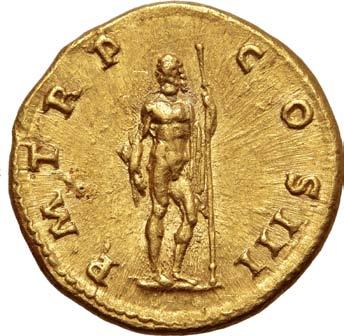
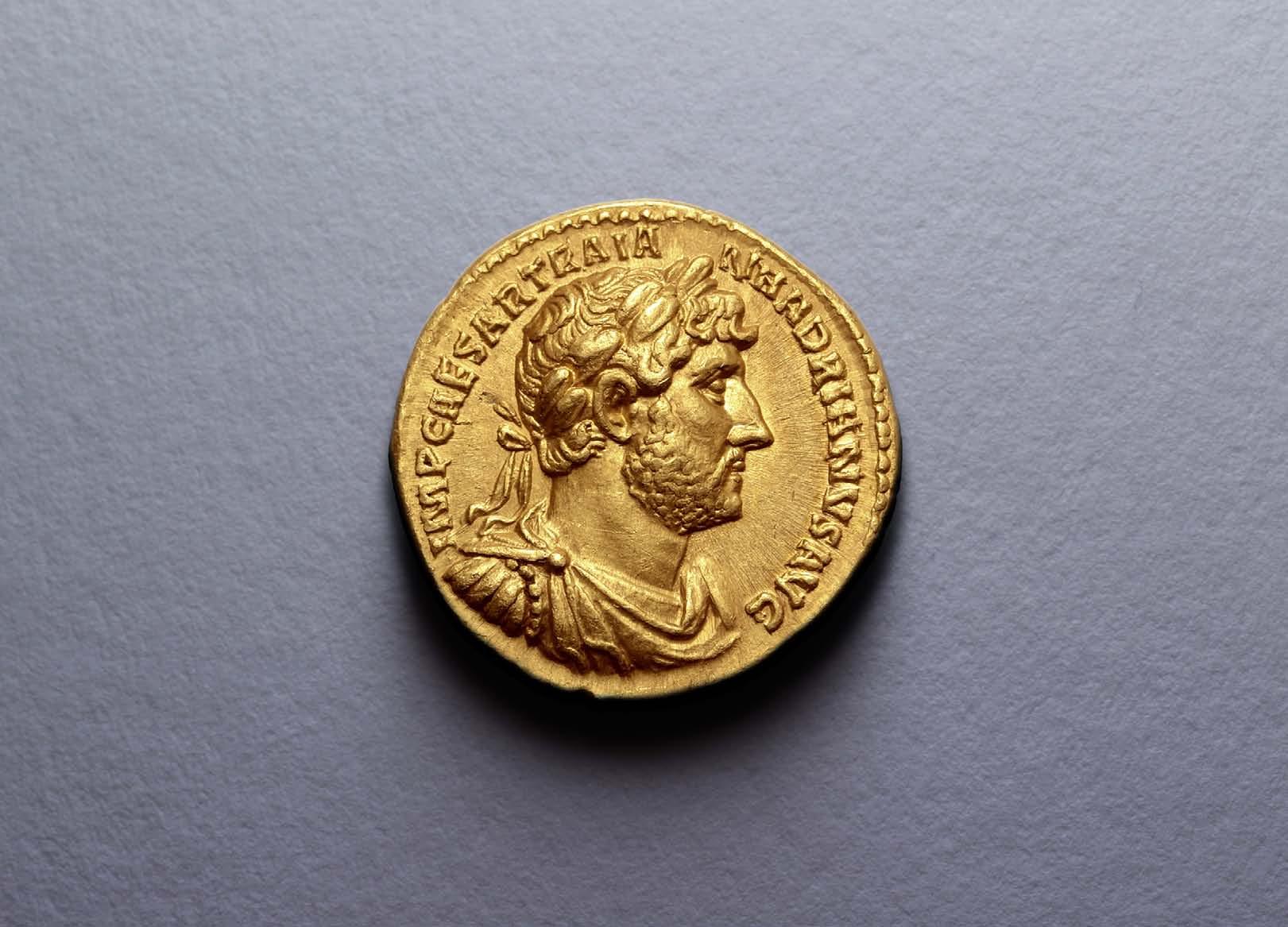
447.
Good Extremely Fine; a beautiful well-detailed portrait in high relief.

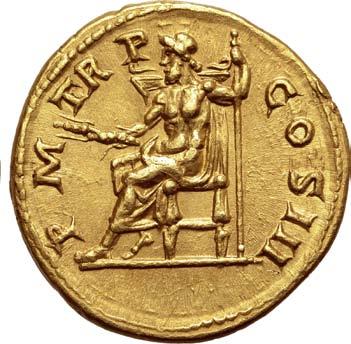

6,000 No Reserve
This beautiful aureus was struck after Hadrian had assumed the consulship for the third time in AD 119. In the days of the Republic to assume the consulship once, let alone twice or three times was one of the greatest honours to which a senator could aspire, and was often the culmination of a lifetime of public service both in government and on the field of battle. The Historia Augusta relates that ‘his own third consulship he held for only four months’ and that ‘having himself been consul three times, he reappointed many to the consulship for the third time and men without number to a second term’ (HA 8.5-6). Hadrian’s largesse and generosity towards the Senate in the early years of his reign stands in stark contrast to the austere, even hostile, attitude that characterise his last; his successor Antoninus Pius earned that most recognisable of cognomens for assuring the posthumous deification of Hadrian, possibly helped by the fact that ‘as Hadrian grew more cruel, he rescued many senators from the emperor’ (HA 24.4).



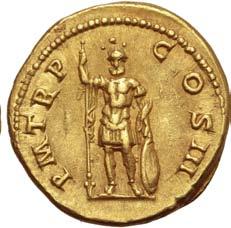
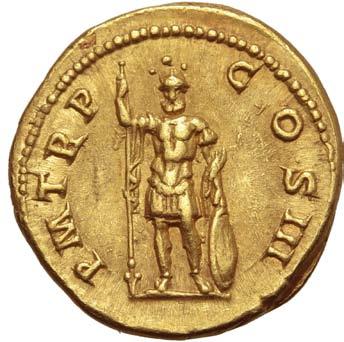
448.
Hadrian AV Aureus. Rome, AD 120-121. IMP CAESAR TRAIAN HADRIANVS AVG, laureate, draped and cuirassed bust to right / P M TR P COS III, Mars standing facing, holding inverted spear and resting hand on shield. RIC II.3 319; C. 1071; BMCRE 109; Calicó 1312 (same rev. die). 7.23g, 19mm, 6h.
Extremely Fine. Very Rare.

449.


Hadrian AR Quinarius. Rome, AD 120-121. IMP CAESAR TRAIAN HADRIANVS AVG, laureate head to right / P M TR P COS III, Victory seated to left, holding wreath and palm. RIC II.3 337; BMCRE 234; King 47; RSC 1136. 1.50g, 14mm, 6h.
Near Extremely Fine. Very Rare.
Ex Áureo & Calicó, Auction 221, 16 December 2009, lot 46.


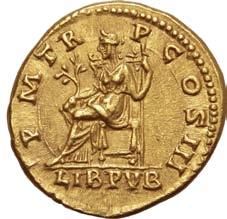
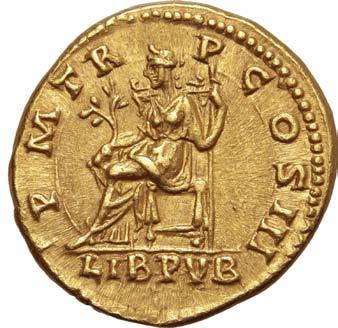
450.
Hadrian AV Aureus. Rome, AD 120-121. IMP CAESAR TRAIAN HADRIANVS AVG, laureate, draped and cuirassed bust to right / P M TR P COS III, Libertas, draped, seated to left, holding branch and sceptre; LIB PVB in exergue. RIC II.3 361; C. 902; BMCRE 281 (same rev. die); Biaggi 619; Calicó 1284. 7.19g, 19mm, 6h.
Good Extremely Fine; a stellar example. Very Rare; among the finest examples to come to auction in the past twenty years.

451.
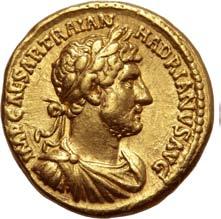
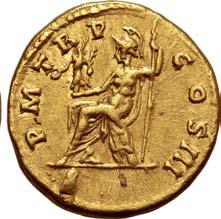
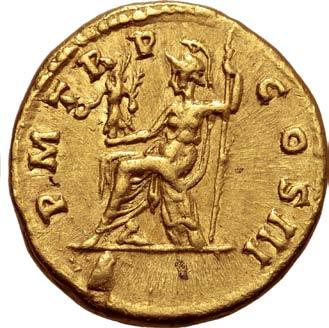
Hadrian AV Aureus. Rome, AD 121-123. IMP CAESAR TRAIAN HADRIANVS AVG, laureate, draped and cuirassed bust to right / P M TR P COS III, Roma seated to left, holding Victory and sceptre. RIC II.3 538; C. 1097; BMCRE 134-5; Calicó 1333. 7.21g, 18mm,
Good Very Fine.
Ex Roma Numismatics Ltd., E-Sale 106, 16 February 2023, lot 889.

AV
NGC graded Ch XF 5/5 - 5/5 (#6944528-005). An attractive specimen. Extremely Rare.
Ex Roma Numismatics Ltd., Auction XXIII, 24 March 2022, lot 966.
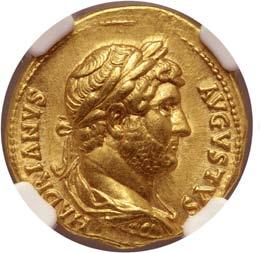

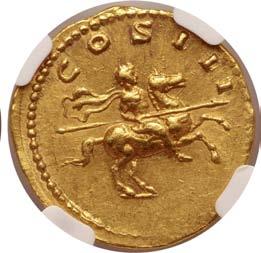
4,500
No Reserve
This very attractive equestrian aureus was struck to mark the triumphant return to Rome of the Emperor, and shows him riding into the city accepting the honours and praise of the people. Mattingly and Sydenham argue that during his four year absence from Rome there had been little change in the coinage, no development of style, and the mint had been virtually inactive. However, upon his return there was a great new output of coinage, of which this is a stunning example.
For his new coinage, Hadrian drops the long legends favoured by his predecessor Trajan, preferring to simplify them to HADRIANVS AVGVSTVS on the obverse and COS III on the reverse. This new obverse legend very distinctly calls into mind the coinage of the first Emperor Augustus, while the new, larger and more gracious style of imperial portrait that fills the fields of the flan is a complete change from the small, careful and cramped types of Trajan. Reverse types such as this one complement the new style and the result is a very attractive and artistic coin.
Hadrian’s reign was dominated by his extensive travels across the provinces, and indeed he spent more than half of his reign outside of Italy. A known Hellenophile, shortly before the return to Rome that prompted the issue of coinage to which this aureus belongs the Emperor had toured Greece and this, coupled with his studies in Greek academia, art and sculpture led the change to the very Hellenistic design we see here, a piece which can be seen as the product of the highest flourishing of Roman art and sculpture. Although no sculpture or written record of such survives, it is quite probable that this reverse type was modelled on an equestrian statue of Hadrian that stood in Rome and that is lost to us today. We know that numerous equestrian statues of Emperors once graced Rome, and we know that equestrian statues of Hadrian in particular existed - sources corroborate one at Aelia Capitolina on the Temple Mount directly above the Holy of Holies, and another is known to have adorned the Milion built by Constantine I at Constantinople, which along with an equestrian statue of Trajan, must have been removed from its original location and placed there.
Indeed, if it were the case that this coin depicts a now lost sculpture, this missing statue would easily fit into a series of imperial equestrian statues that are both well-attested and displayed on the Roman coinage, beginning with the sculpture of Augustus that can be seen on denarii of 16 BC struck under the moneyer L. Vinicius (RIC 362), through Domitian’s addition to the Forum Romanum in AD 91 and Trajan’s own statue in the Forum Traiani. All of these followed a traditional mode, of which the gilt bronze statue of Marcus Aurelius, which was also featured on that Emperor’s coinage and which is preserved in the Capitoline Museum, is the sole surviving example.
453.


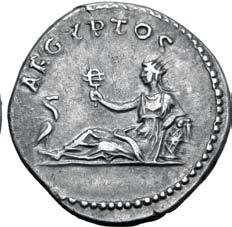
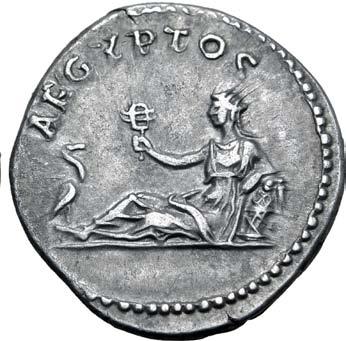
Hadrian AR Denarius. Rome, AD 130-133. HADRIANVS AVG COS III P P, laureate head to right / AEGYPTOS, Egypt reclining to left on basket, holding sistrum; Ibis before. RIC II.3 1481; BMCRE 801; RSC
Near Extremely Fine.
120
No Reserve
Acquired from Tayler & Fletcher, Two Day Auction of Antiques, Fine Art and Objects, 21 October 2021; Ex the Londonthorpe II Hoard, found in Lincolnshire, March 2018. Submitted for consideration as Treasure and returned to the finders. PAS ID: LANCUM-F93E5B. BM Ref: 2018 T178.
Found on 16th March 2018 while metal detecting on cultivated land, this was the second such find in the parish, after ‘Londonthorpe I’ was unearthed in 1976. The hoard was reportedly located in a crude cist inside a Roman greyware vessel (complete but broken, with interior staining from coins). A further three coins were handed in in April 2018 and a further six coins were reported by a second finder in July 2018, taking the total to 522 coins in all. Originally covered in green corrosion products and not legible, the coins were sent to the metal conservation laboratory in the British Museum where they were cleaned for identification purposes. The coins in the hoard are all silver denarii, the earliest coins in the hoard being Imperatorial denarii issued in 32-1 BC by Mark Antony and the latest being those issued during the reign of Antoninus Pius (AD 138-161).
The majority of the Hadrianic silver from this collection originates from the hoard.

454.
Hadrian AR Denarius. Rome, AD 130-133. HADRIANVS
Near Extremely Fine.

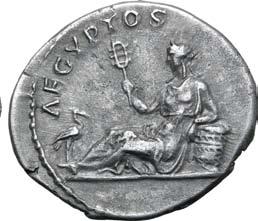

Acquired from Tayler & Fletcher, Two Day Auction of Antiques, Fine Art and Objects, 21 October 2021; Ex Londonthorpe II Hoard, found in Lincolnshire, March 2018. Submitted for consideration as Treasure and returned to the finders. PAS ID: LANCUM-F93E5B. BM Ref: 2018 T178.
120 No Reserve
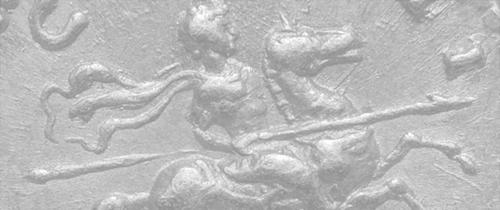


455.



1393,
7.38g,
Near Mint State. Very Rare and among the finest known examples of the type.
This coin illustrated in R.A. Abdy and P.F. Mittag, Roman Imperial Coinage II.3 (London, 2019); Ex Numismatica Ars Classica, Auction 120, 6 October 2020, lot 770 (hammer: CHF 32,000); Ex Bolla Collection, A. Tkalec AG - Astarte S.A., 28 February 2007, lot 36; Reportedly privately purchased from M. Ratto in 1958.
This reverse type most likely makes reference to Hadrian’s victory over Simon Bar Kochba in Judaea during the last Romano-Jewish war, known to contemporary Romans as the Expeditio Judaica (Jewish Expedition). Strack (pp. 132–9) and Mattingly (BMCRE p. cxlvi), both attribute the Victory reverses on the late aurei of Hadrian to this victory. This large-scale rebellion lasted from AD 132-136, and succeeded in establishing an independent state of Israel over parts of Judaea for over two years. Jewish gains were short-lived however, as Hadrian drafted in six full legions with auxiliaries and vexillations from up to six further legions, which finally crushed the revolt. According to Cassius Dio, 580,000 Jews were killed during the rebellion, 50 fortified towns and 985 villages were razed to the ground, and many more Jews sold into slavery. Roman military casualties were significant; Cassius Dio claimed that “many Romans, moreover, perished in this war”. Therefore, Hadrian, in writing to the Senate, did not employ the opening phrase commonly affected by the emperors: “If you and your children are in health, it is well; I and the army are in health.” Legio XXII Deiotariana was disbanded after severe losses, and Legio IX Hispana was possibly also disbanded as a result of the war, according to recent scholarship.



Very Fine; light surface marks to obv.
Ex Gorny & Mosch Giessener Münzhandlung, Auction 229, 10 March 2015,

457.
Ex Roma

Marcus Aurelius AV Aureus. Rome, AD 177-178. M AVREL▾ANTONINVS▾AVG▾, laureate, draped and cuirassed bust to


/ TR P XXXII▾IMP VIIII COS III P ▾P, Annona standing to left, holding cornucopiae and two ears of corn over modius at feet on
prow to
at feet on
RIC III 389; C. 957 var. (bust type); BMCRE 771 (same obv. die); Biaggi 905 (this coin); Faces of Power 302 (same obv. die); Calicó 2020 (same dies) corr. (bust type). 7.35g, 20mm, 12h.
NGC graded Ch MS 5/5 - 4/5, light mark (#6674257-002).
Ex Roma Numismatics Ltd., Auction XXIII, 24 March 2022, lot 996 (hammer: GBP 32,000);
Ex Numismatica Ars Classica AG, Auction 119 with Jesús Vico S.A., 6 October 2020, lot 111, then sold with an export licence issued by the government of Spain;
Privately purchased from Cayón Numismática, 1981;
Ex Leo Biaggi de Blasys Collection;
Privately purchased from H. A. Cahn in June 1950.
Annona was the divine personification of the grain supply to the city of Rome, a creation of Imperial pseudo-religious propaganda, manifested in iconography and cult practice, but lacking in narrative mythology or a historical tradition of devotion.
15,000
The Roman government used the term Cura Annonae (“care for the grain supply”), in reference to the import and distribution of grain to the residents of the city of Rome. Rome imported most of the grain consumed by its urban population, estimated to number one million people by the second century AD. Most of this grain was distributed through commercial or non-subsidized channels, but a dole of subsidized or free grain, and later bread, was provided by the government to about 200,000 of the poorer residents of the city of Rome. It has been estimated that each year as much as 60,000,000 modii of grain (about 420,000 tonnes) reached the city, equivalent to approximately 1,200 large vessels containing 50,000 modii (about 350 tonnes) each.
The grain ships that sailed principally from Egypt and Africa, and the shipping lanes they travelled were therefore of strategic importance. Whoever controlled the grain supply had an important measure of control over the city of Rome, which was utterly reliant on regular imports.
The depiction of Annona with a modius and grain ship on this coin is therefore closely associated with the principate, being one of the most ubiquitous and important manifestations of the emperor’s power to care for his people. The date when the Cura Annonae ended is unknown, but it may have lasted even into the 6th century, by which time the population of Rome had greatly declined through famine, war and economic ruin to as little as 100,000. The great machinery of empire that had once spanned all of Europe and sustained the greatest city on earth had been effectively shattered by barbarian migration and subsequent warfare, and with the eventual disappearance of the great grain fleets it would not be until the sixteenth century that vessels of similar tonnages would ply the waters of the Mediterranean again.

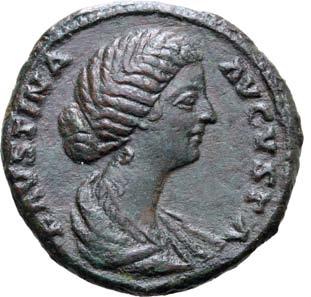
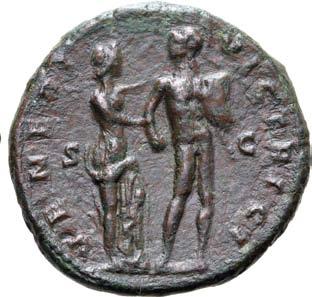

459.
Faustina II (wife of M. Aurelius) Æ As. Rome, AD 161-176. FAVSTINA AVGVSTA, draped bust to right / VENERI VICTRICI, Venus standing to right, holding arm of Mars standing facing, head to left, holding shield. RIC III 1680 (Aurelius); C. 241; BMCRE 999 (Aurelius). 10.85g, 26mm, 6h.
Good Very Fine. Rare.
Acquired from Andy Barratt (Malmesbury).
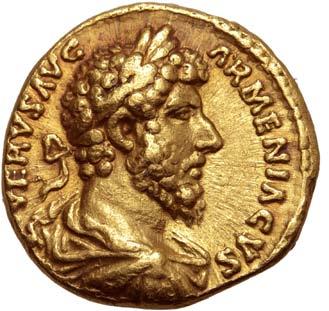

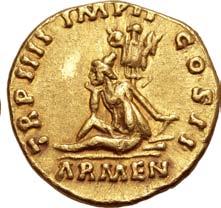

460.
Lucius Verus AV Aureus. Rome, AD 163-164. [L] VERVS AVG ARMENIACVS, laureate, draped and cuirassed bust to right / TR P IIII IMP II COS II, Armenia seated to left, hand resting on bow and quiver, trophy behind; ARMEN in exergue. RIC III 507 (Aurelius) var. (bust type); C. -; BMCRE 297 (Aurelius & Verus); Biaggi 947 var. (bust type, same rev. die); Calicó 2108. 6.81g, 18mm, 6h.
Good Very Fine.
Ex Leu Numismatik AG, Web Auction 20, 16 July 2022, lot 2510 (hammer: CHF 4,000); Ex Numismatica Ars Classica, Auction 84, 20 May 2015, lot 1912.
1,800 No Reserve
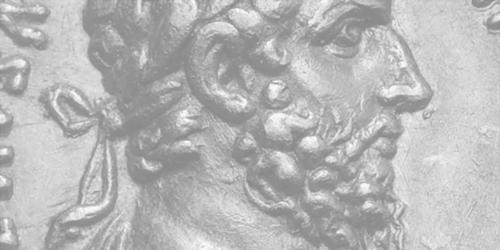




461.
Lucius Verus AV Aureus.

165.
Ex Numismatica Ars Classica - Jesús Vico S.A, Auction 119, 6 October 2020, lot 126 (hammer: CHF 20,000); Previously privately purchased from Lopez in 1977.
9,000 No Reserve
Lucius Verus, co-emperor with his better-known adoptive brother Marcus Aurelius from 161 until his death from disease in AD 169, was the eldest son of Lucius Aelius Caesar, Hadrian’s first intended heir who died in AD 138. Verus was adopted by Antoninus Pius alongside Marcus Aurelius and thus eventually became one of the first co-rulers of the Roman Empire, a system for the division of responsibilities which became more commonplace towards the end of the second century. Their partnership was cemented by Lucius Verus’ marriage to Marcus Aurelius’ daughter in AD 164.
Verus’ portrait follows the Antonine mode with a long face, tightly curled hair and pointed beard, emphasising continuity between emperors and a united front with Marcus Aurelius through visual likeness even though there was no biological dynastic link. He is portrayed cuirassed, which by the time of Hadrian had become the dominant costume of imperial portraiture, emphasising the emperor’s role in ensuring military security throughout the empire.
Verus indeed spent much of his reign shoring up the eastern boundaries of the Roman Empire. The obverse and reverse legends denote the titles with which he was honoured: Armeniacus (ARM) in AD 163 after the capture of the Armenian capital Artaxata, and Parthicus Maximus (PARTH MAX) after the invasion of Mesopotamia in AD 165, which led to his acclamation as imperator by the army for the third time.
The rare reverse type of this attractive aureus is particularly arresting: an image of the emperor on horseback, the horse rearing as he spears a fallen enemy below. The group is dynamic, the horse’s tail and Lucius Verus’ cloak emphasising decisive movement. Such images of the emperor mounted in combat had come into favour during the reign of Trajan; this type bears a striking similarity to the heroic image of the un-helmeted emperor on horseback trampling a fallen barbarian below, his cloak billowing out behind him, used extensively on Trajan’s coinage as well on the Great Trajanic Frieze (c.117-120), which was later reused to decorate the Arch of Constantine.
This image of the emperor as a military figure looked back beyond the Julio-Claudian preference for static imperial images which emphasised religious piety and civic authority to the Hellenistic taste for heroic representation and strong gestural poses. This reverse type of Lucius Verus emphasises personal charisma and military success, but belies the truth: the successes attributed to the emperor, for which he received so many titles, were all due to his experienced generals - Verus himself is not believed to have ever seen active combat.
462.
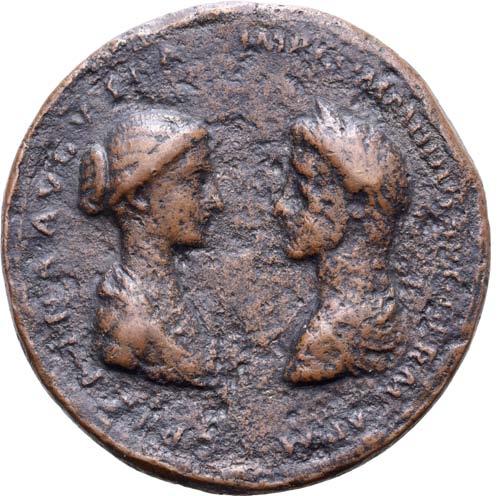
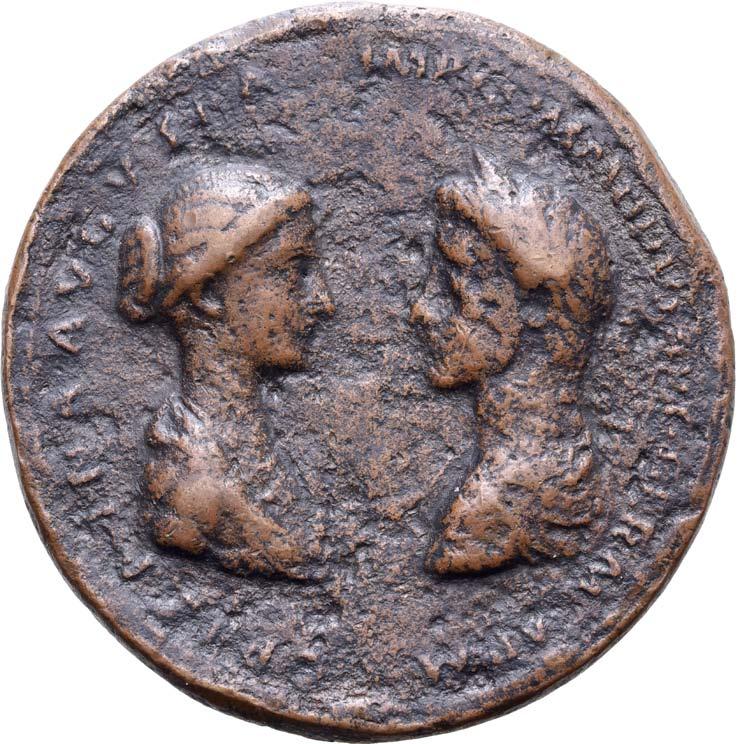
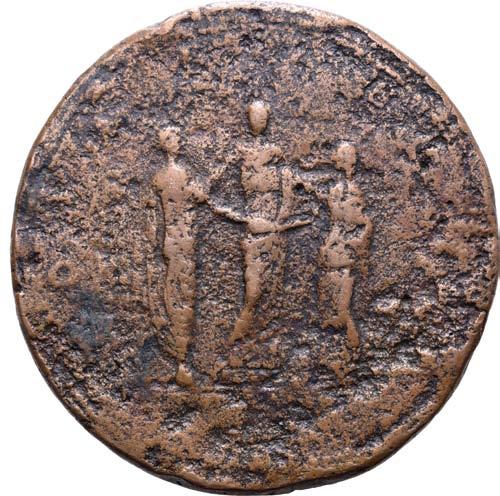
463.
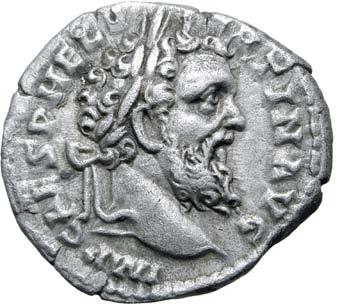
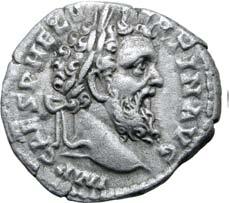




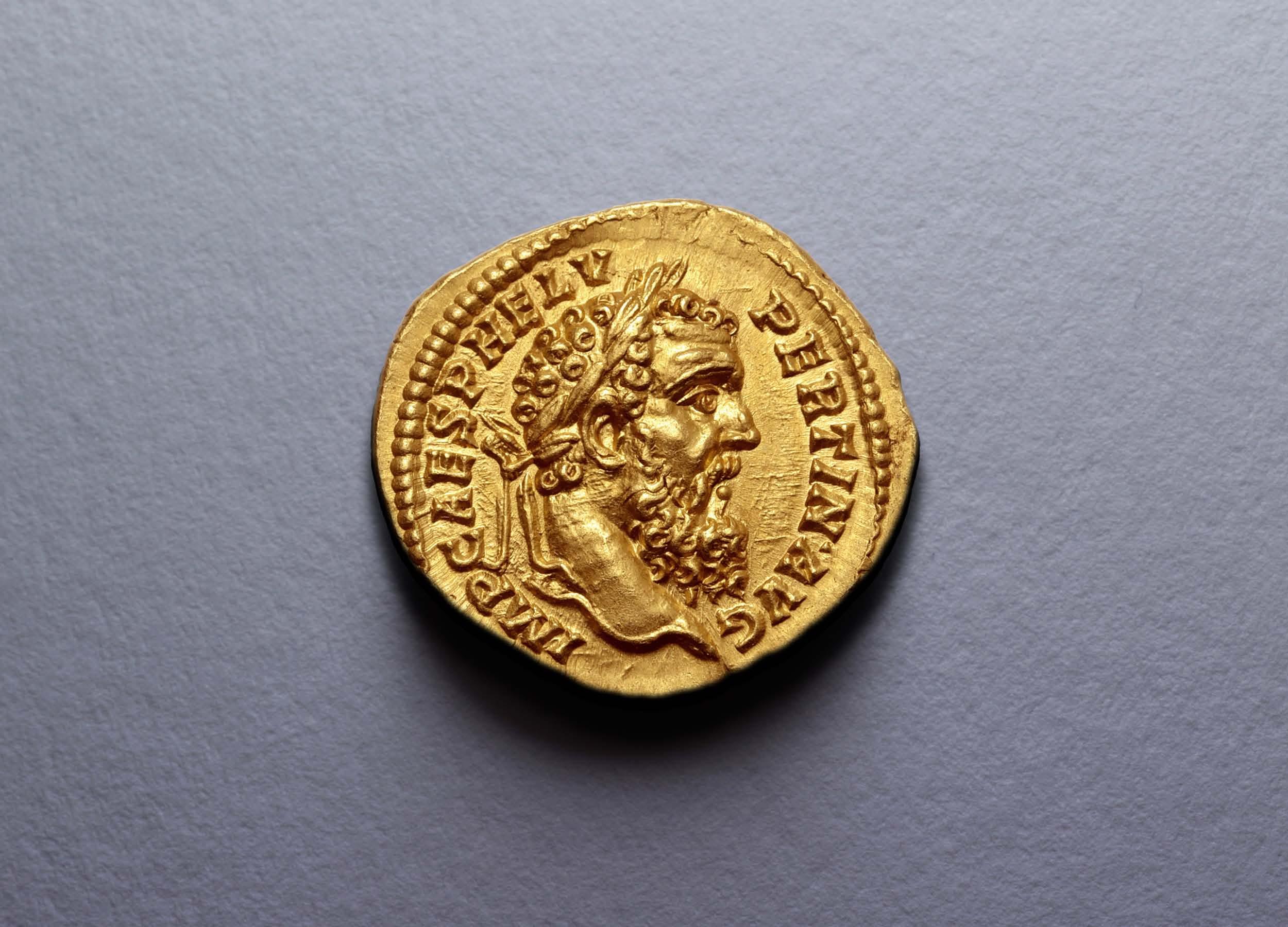


464.


Acquired from Classical Numismatic Group (inventory no. 595027, USD 85,000).
27,000
No Reserve
Pertinax was the first Emperor in the tumultuous ‘Year of Five Emperors’. His early life and career is well documented in the Historia Augusta: born into a humble family and the son of a freedman, Pertinax had originally tried to make his way in life as a teacher of grammar, but at some point decided to try to attain a greater station, and with the help of a patron he was commissioned an officer in the Roman army
Pertinax distinguished himself in a campaign against Parthia, and after postings in Britain and on the Danube he served as procurator in Dacia. His career suffered a serious setback during the reign of Marcus Aurelius on account of court intrigues, however he was recalled to assist Claudius Pompeianus during the Marcomannic Wars. In 175 he was made suffect consul, and he then served as governor of a string of provinces including Syria and Britain.
In the 180s he was sent to Britain where the army was in a state of mutiny. His attempt to calm the restive soldiers resulted in his bodyguard being attacked, and Pertinax was left for dead. After his recovery he severely punished the mutinous legion, adding to his reputation as a disciplinarian. In 187 he was forced to resign due to the legions having grown hostile to his strict command style. His career reached an apex when he was given the proconsulship of Africa, the urban prefecture of Rome, and a second consulship with the emperor as his colleague.
When Commodus was murdered on the last day of AD 192, Pertinax was still serving as urban prefect, and hurried to the Praetorian camp where he was proclaimed emperor the following morning. His attempts at reform and restraint, along with attempts to impose discipline on the unruly Praetorians, did not endear him to the Guard who had expected a large donative. After a reign of only three months, during which time he refused imperial titles for his wife and son, a contingent of several hundred Praetorian Guardsmen rushed the palace and Pertinax, although he almost succeeded in reasoning with them, was struck down. Yet by his understanding of the danger of his station and his wise decision not to associate his family with the purple, they were spared from violence.
The powerful portrait of this magnificent aureus shows the furrowed brow and weathered face of a man who had attained high position through hard work and discipline, now burdened by the cares of state. It is an appropriate depiction for an emperor who tried hard to bring the unravelling Roman system back onto the correct path but was ultimately slain for his efforts.
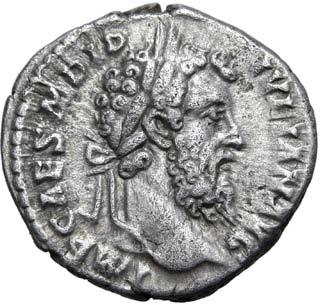
465.
Good Very Fine.



466.
450
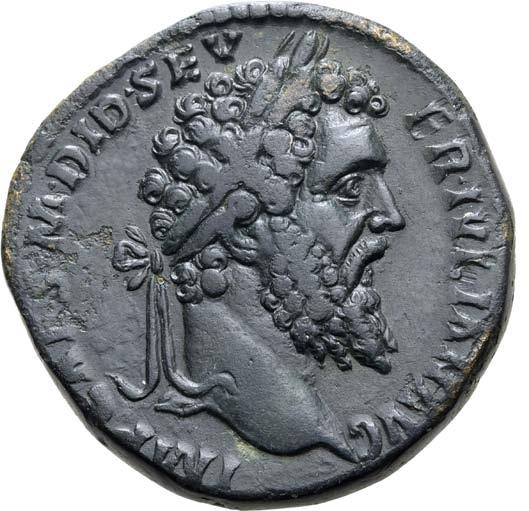
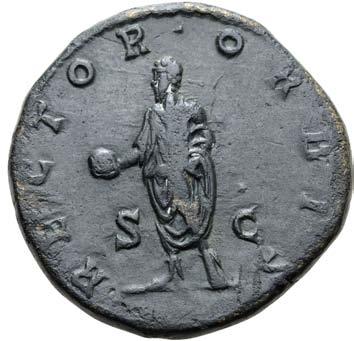
Didius Julianus Æ Sestertius. Rome, AD 193. IMP CAES M DID SEVER IVLIAN AVG, laureate head to right / RECTOR ORBIS, emperor standing facing, head to left, holding globe and scroll; S-C across fields. RIC IV 16; C. 17; Banti 6; BMCRE 28. 21.59g, 29mm, 11h.
Good Very Fine; very well preserved for the type.
Ex Heritage World Coin Auctions, NYINC Signature Sale 3071, 6 January 2019, lot 32145 (hammer: USD 6,000);
Ex Münzen & Medaillen AG, Auction 66, 22 November 1984, lot 679;
Ex John Work Garrett Collection Part I, Bank Leu - Numismatic Fine Arts, 16 May 1984, lot 642.
The previous Emperor Pertinax having been murdered after just three months in the imperial palace, Didius Julianus was raised to the purple in a shameful episode, where the sources record, the empire was ‘auctioned’ to the highest bidder by the Praetorian Guard. In fear of what troubles Julianus and the Praetorians could create if challenged, the senate were forced to submit to his rule and ratify his elevation to the throne, whilst at the same time bestowing honorific titles on his wife and daughter, Manlia Scantilla and Didia Clara. Cassius Dio relates that “The next day we [the Senators] went up to pay our respects to him, moulding our faces, so to speak, and posturing, so that our grief should not be detected. The populace, however, went about openly with sullen looks, spoke its mind as much as it pleased, and was getting ready to do anything it could. Finally, when he came to the senate-house and was about to sacrifice to Janus before the entrance, all fell to shouting, as if by preconcerted arrangement, calling him stealer of the empire and parricide” (LXXIV, 13, 2-3).
However, Julianus’ time in the palace was to be limited by the challenges of three provincial governors, all of whom laid claim to the imperial throne. Pescennius Niger in Syria, Clodius Albinus in Britain and Septimius Severus in Upper Pannonia all had themselves acclaimed emperor, Cassius Dio relating that it was the populace of the city that had first called for Niger to come to their aid. As the closest to Italy, Severus had the advantage and marched toward Rome, the spectre of his approaching army being enough to further weaken Julianus’ grip on power so that the Senate were able to condemn him to death and appoint Severus in his place. Seen in the knowledge of Julianus’ demise, the reverse type of the present piece featuring Fortuna is then somewhat ironic. The goddess of fortune and personification of luck in Roman religion, her depiction on the coinage would involved the goddess’ blessing for the both emperor and empire; however she was as equally dedicated to ensuring life’s capriciousness, as it must quickly have become apparent to Julianus.

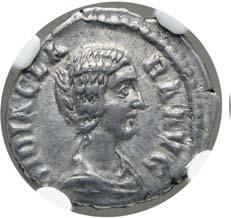
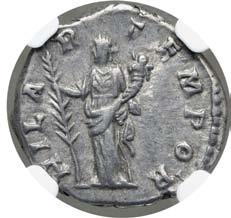

467.
Didia Clara (daughter of D. Julianus) AR Denarius. Rome, April-June AD 193. DIDIA CLARA AVG, draped bust to right / HILAR TEMPOR, Hilaritas standing to left, holding long palm and cornucopiae. RIC IV 10 (Julianus); BMCRE 14 (Julianus); RSC 3. 3.06g. NGC graded Ch XF 4/5 - 5/5 (#4278415-010).
Ex Thomas B. Cederlind.
This denarius, struck in the year her father Didius Julianus bought the throne of the Roman Empire at auction, shows Didia Clara as the proud bearer of the title Augusta which she and her mother Manlia Scantilla had assumed. Although she was allegedly the most beautiful woman in all of Rome, we know hardly anything about her life. She was married to Cornelius Repentinus, who served as a prefect of Rome during her father’s brief reign. Silver coins of this enigmatic Augusta are rare, and in gold they are very seldom seen.
Hilaritas commonly appears on the coinage of Didia Clara. This Roman goddess personified happiness and celebration, often in the wake of the birth of a child into the imperial family. There are no records available to confirm whether Didia had children, but perhaps this type of coinage offers a clue that she may have. However these children would have never received imperial positions as the new emperor Septimius Severus removed her title following the death of her parents in the summer of 193. The fate of this mysterious woman following such tragedy is unknown.
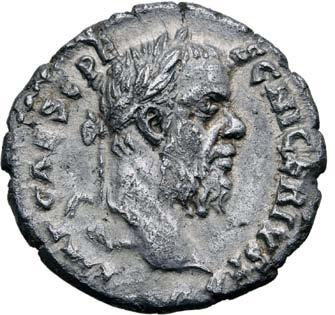



468.
Pescennius Niger AR Denarius. Antioch, AD 193-194. IMP CAES C PESC NIGER IVST AV, laureate head to right / INVICTP IMPEPAT (sic), trophy; arms at base. RIC IV 34a var. (rev. legend); BMCRE p. 77, § note var. (same); RSC 33 var. (same). 2.94g, 18mm, 12h.
Good Extremely Fine. Very Rare.
Ex Numismatica Ars Classica, Auction 54, 24 March 2010, lot 1205;
Ex Gorny & Mosch Giessener Münzhandlung, Auction 114, 4 March 2002, lot 348.
600
The scarcity of Pescennius Niger’s coinage today belies the fact that it was struck on a monumental scale, and we can only assume that after his defeat at the hands of Septimius Severus in AD 194 his coins were meticulously recalled and melted. Although it has been extensively published, there are such a huge number of minor varieties that no single catalogue is without numerous lacunae. It appears that the all of Niger’s coins were struck at Antioch and possibly a subsidiary mint operating at Caesarea in Cappadocia.

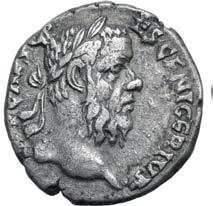

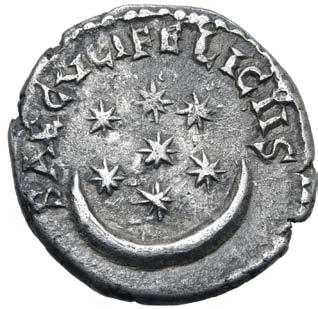
469.
Pescennius Niger AR Denarius. Antioch, AD 193-194. IMP CAES C PESCE NIGER IVST, laureate head to right / SAECVLI FELICIIS, seven stars above crescent. RIC IV 73 var. (legends); BMCRE 312 var. (same); RSC 64 var. (same). 3.06g, 18mm, 1h.
Good Very Fine. Very Rare.
Ex Dr V.J.A. Flynn Collection, Noble Numismatics Pty Ltd., Auction 117, 17 April 2018, lot 4774;
Ex Classical Numismatic Group, Auction 91, 9 September 2012, lot 919 (hammer: USD 2,100).

470.
Extremely Fine.
Ex Jean Elsen & ses Fils S.A., 10 June 2022, lot 451.


600
240

471.

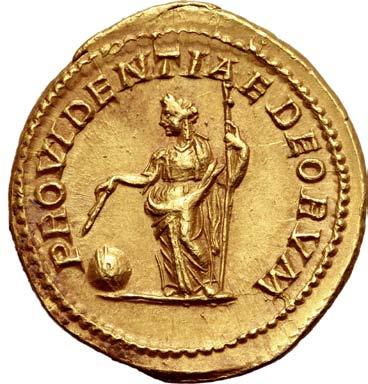


472.
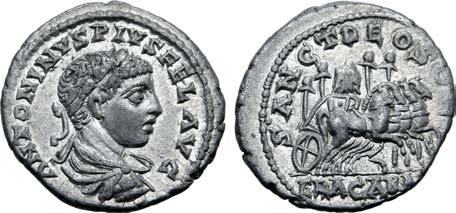

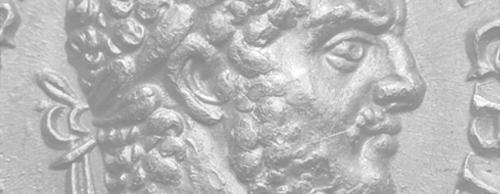
473.



Severus Alexander Æ Sestertius. Rome, AD 231-235. IMP ALEXANDER PIVS AVG, laureate bust to right, slight drapery on far shoulder / PROVIDENTIA AVG, Providentia standing
Near Mint State.
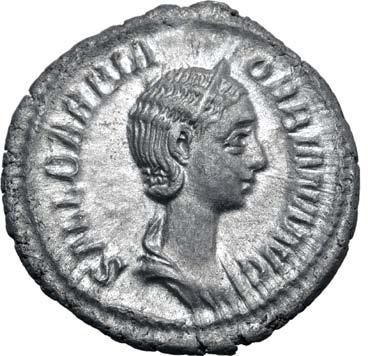
474.
Extremely Fine.
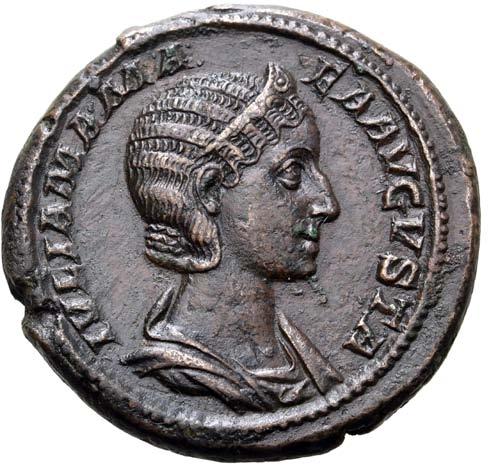
475.
Mamaea
S. Alexander)



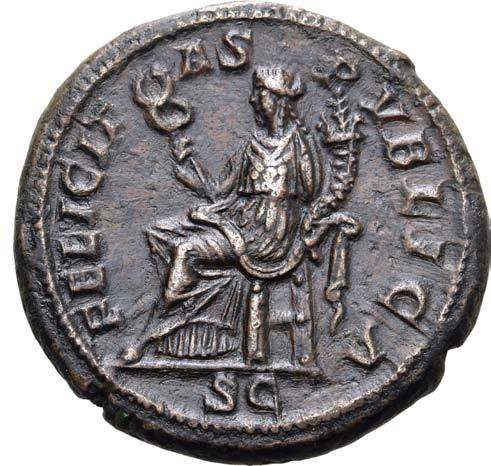
AD 230.
Extremely Fine; beautifully centred, attractive brown patina.
Ex Noble Numismatics Pty Ltd., Auction 129, 29 March 2022, lot 3508; Previously acquired from A. H. Baldwin & Sons, circa 2002.
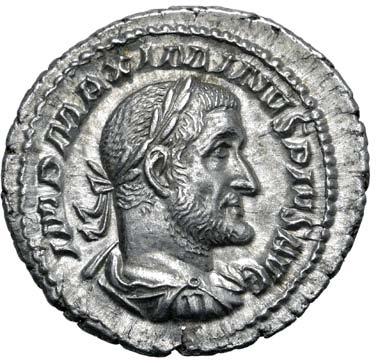
476.

Ex Roma Numismatics Ltd., E-Sale 102, 3 November 2022, lot 1026.

477.

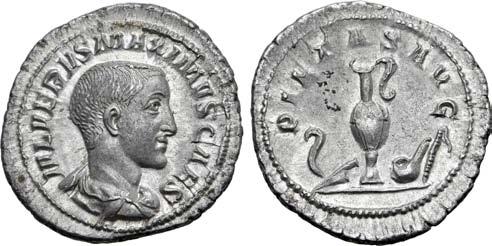

Maximus (son of Maximinus I), as Caesar, AR Denarius. Rome, AD 235-236. IVL VERVS MAXIMVS CAES, bare-headed and draped bust to right / PIETAS AVG, emblems of the pontificate: from left, lituus, knife, jug, simpulum and sprinkler. RIC IV 1; BMCRE 118 (Maximinus); RSC 1. 3.60g, 20mm, 6h.
Good Extremely Fine; attractive old cabinet tone.
Ex Nomos AG, Auction 22, 22 June 2021, lot 334.
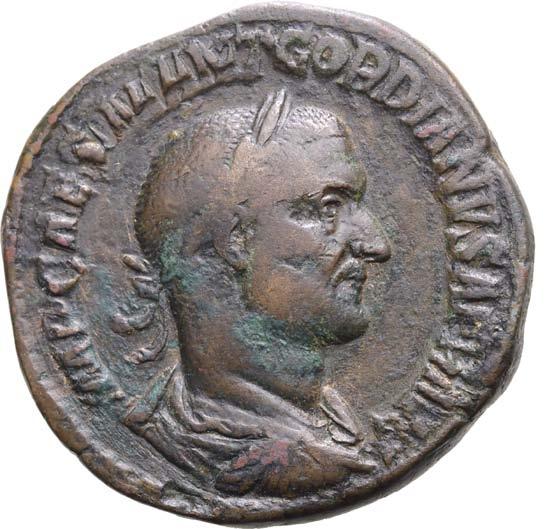
478.
300
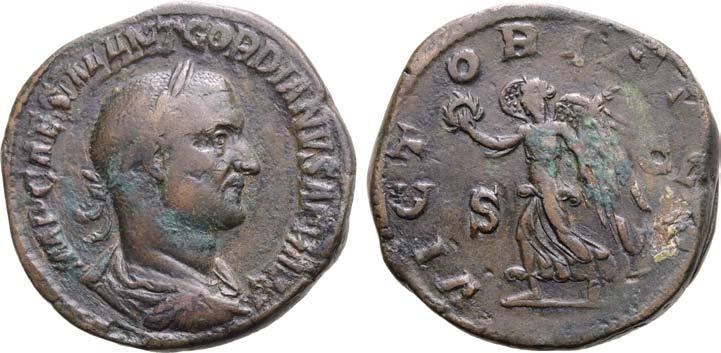
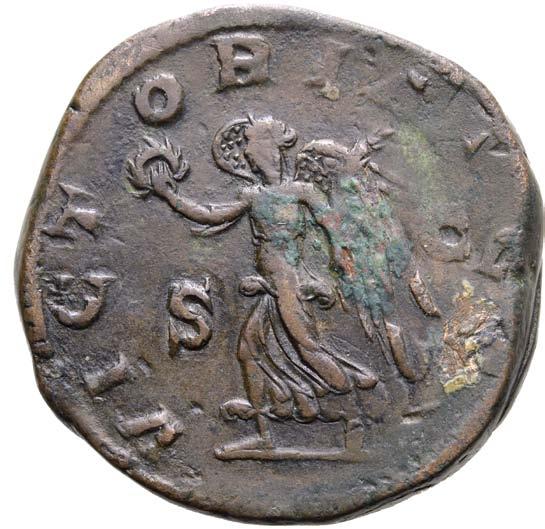
Gordian I Africanus Æ Sestertius. Rome, AD 238. IMP CAES M ANT GORDIANVS AFR AVG, laureate, draped and cuirassed bust to right / VICTORIA AVGG, Victory advancing to left, holding wreath and palm; S-C across fields. RIC IV 12; C. 14; BMCRE 14-16. 21.77g, 30mm, 12h.
Very Fine.
Privately acquired from Maxim Shick, November 2018; Export permit approved by the Israel Antiquities Authority, #539308.

479.
450
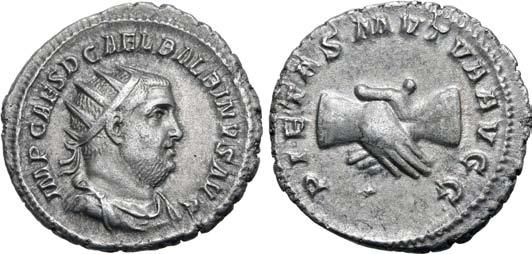

Balbinus AR Antoninianus. Rome, AD 238. IMP CAES D CAEL BALBINVS AVG, radiate, draped and cuirassed bust to right / PIETAS MVTVA AVGG, clasped hands. RIC IV 12; BMCRE 76; RSC 17. 4.62g, 22mm, 7h.
Extremely Fine.
Ex Dr. V. J. A. Flynn Collection, Noble Numismatics Pty Ltd., Auction 117, 17 April 2018, lot 4855; Ex White Mountain Collection, Classical Numismatic Group, Electronic Auction 202, 14 January 2009, lot 424.

480.
180


Pupienus AR Antoninianus. Rome, AD 238. IMP CAES PVPIEN MAXIMVS AVG, radiate, draped and cuirassed bust right / CARITAS MVTVA AVGG, clasped right hands. RIC IV 10b; BMCRE 87-91; RSC 3. 4.46g, 25mm, 11h.
Extremely Fine; well-centred on a broad planchet.
Ex Dr. V. J. A. Flynn Collection, Noble Numismatics Pty Ltd., Auction 117, 17 April 2018, lot 4857; Ex Classical Numismatic Group, Electronic Auction 264, 21 September 2011, lot 468.
300
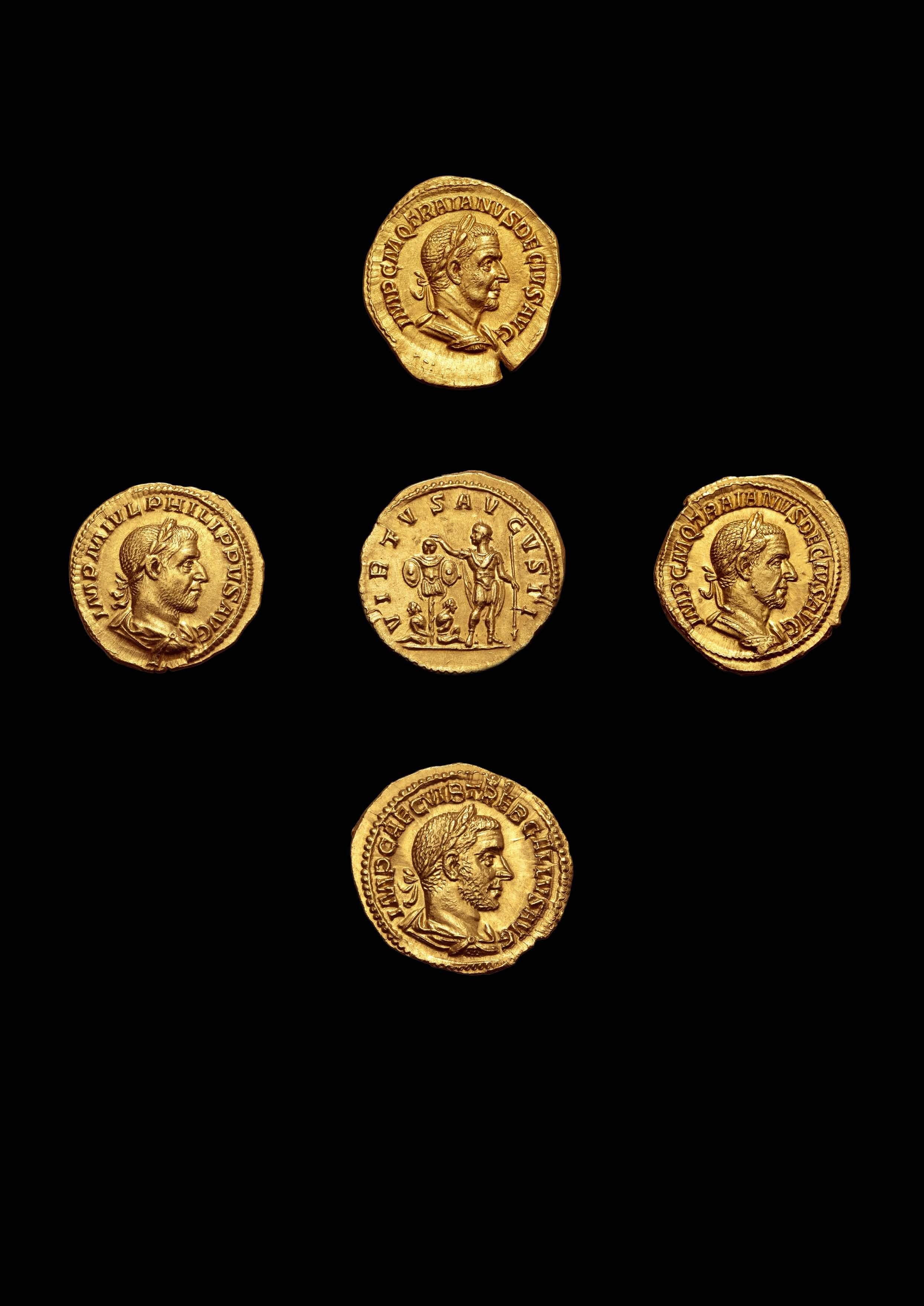


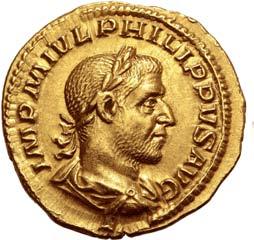
481.
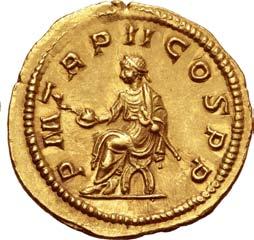

Extremely Fine. Very Rare; one of only six examples to appear at auction in the past two decades, of which this is one of the two finest specimens. Ex Classical Numismatic Group, Auction 117, 19 May 2021, lot 593 (hammer: USD 26,000).
10,500 No Reserve
Philip I, a man of Arab descent who rose to the post of Praetorian Prefect under Gordian III (AD 238-244), became emperor after allegedly staging a coup against the young emperor while they were on campaign in Persia. Although the empire was beset with many troubles, the reign started off with some promise. Philip was a conscientious ruler who showed tolerance toward Christians and other persecuted groups. He spent much of his reign on campaign on the Danube subduing invasions by Germanic tribes, but returned to Rome to preside over the Saecular Games in AD 248 which marked the one-thousandth year anniversary of Rome’s founding, along with his son Philip II whom he had elevated to co-Augustus. Unfortunately, trouble on the frontiers prompted Philip to dispatch the general Trajan Decius to quell the rebellions and deal with barbarian incursions. Instead, Decius was proclaimed emperor by the discontented legions in AD 249 and immediately marched on Rome. The elder Philip’s army met the usurper near modern Verona that summer, but was easily defeated. Philip himself either died in battle or was assassinated by his soldiers soon after (Michael L. Meckler, Philip the Arab).
Gold coins dating from the reign of Philip I are exceptionally rare due to the increasing scarcity of precious metals in the mid-third century. This coin is one of the finest of only six examples of the type to appear at auction in the past two decades, and it depicts the emperor so well-known for the violence which bookended his reign as a consummate civil leader, seated on a curule chair - the ancient symbol of magisterial power likely as old as Rome itself.
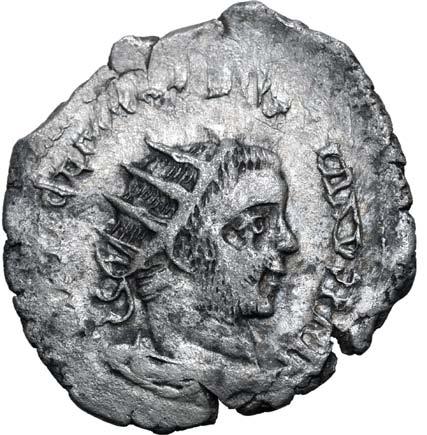
482.
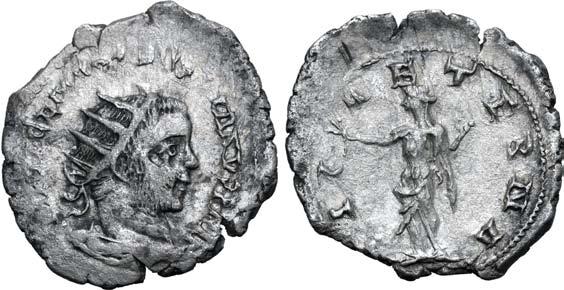

Pacatian AR Antoninianus. Viminacium, AD 248-249. IMP TI CL MAR PACATIANVS P F IN(?), radiate, draped and cuirassed bust to right / PAX AETERNA, Pax standing to left, holding branch and transverse sceptre. Cf. RIC IV 5 (R4). 4.28g, 20mm, 8h. Good Very Fine. Very Rare.
720 No Reserve
Ex Roma Numismatics Ltd., E-Live Auction 3, 25 October 2018, lot 823 (hammer: GBP 1,800).
Tiberius Claudius Marinus Pacatianus was raised to the purple by his troops, and then killed by them within a matter of months and before Trajan Decius, sent by the Emperor Philip I, was able to tackle him himself. Usurping power in the region of the Danube, later writers such as Zosimus relate that he was an officer of the army and perhaps of senatorial rank. Though no specific reasons for the rebellion are clear from the sources, the Danube frontier is known to have been threatened repeatedly by the Goths, and the sheer number of uprisings in this area led by the army is suggestive of serious and continuing unrest.
Though at least seven reverse types are known for Pacatian, the remaining coinage is extremely rare and in the main of poor quality. One reverse type, featuring Roma seated, securely dates Pacatian’s revolt to AD 248 as it commemorates the 1000th anniversary of the founding of Rome, an event that Philip I also marked on his coinage. Viminacium is taken to be the mint for Pacatian’s coinage due to similarities in style to other issues from this mint, and also because for the period of the rebellion no coins of Philip I were produced there.
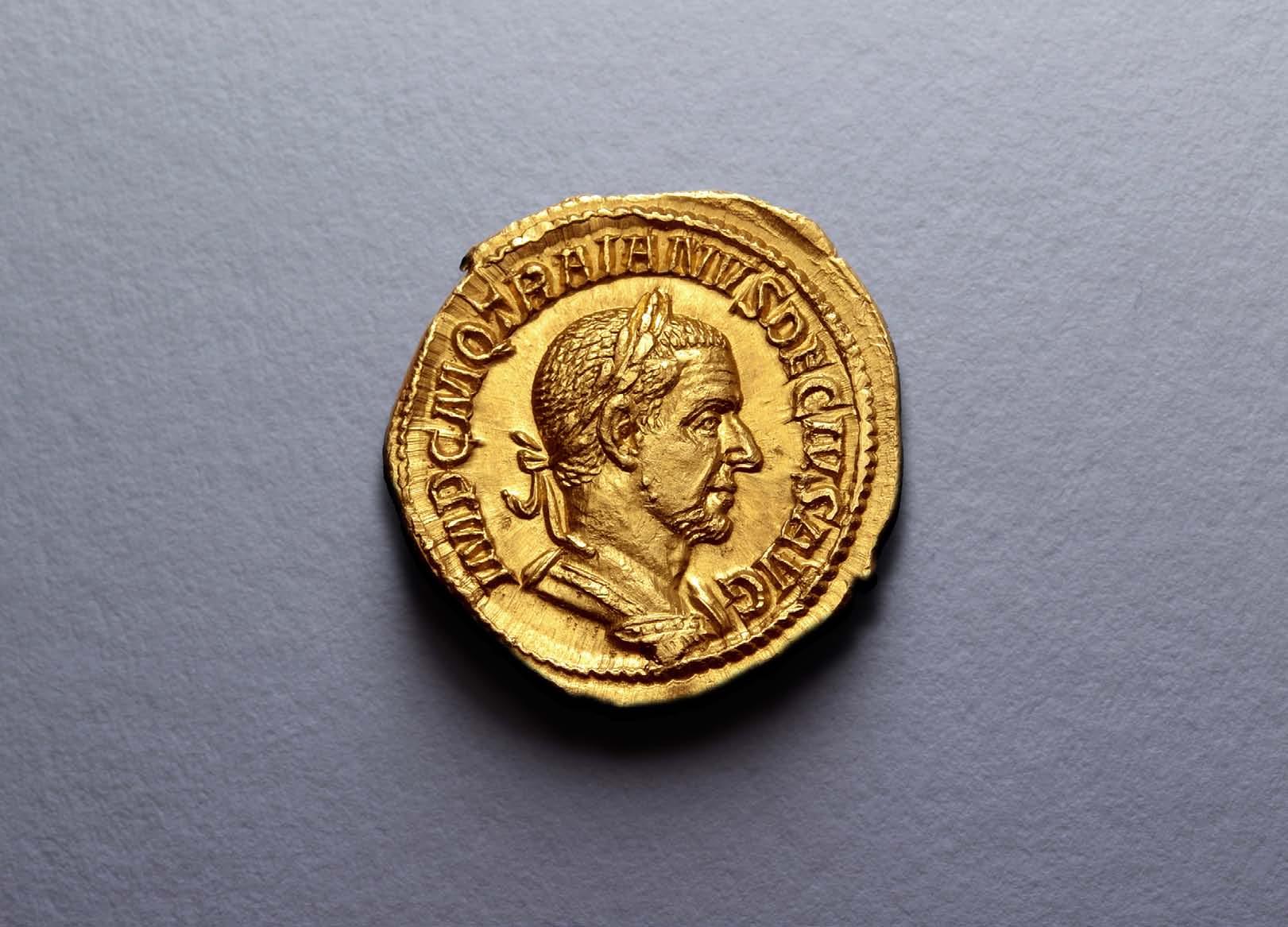

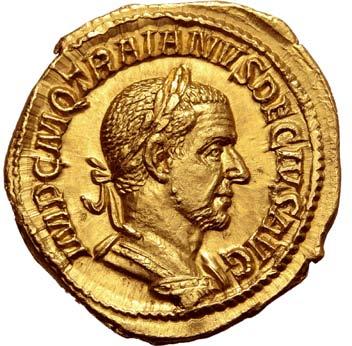

Trajan Decius AV Aureus. Rome, AD 249-251. IMP C M Q TRAIANVS DECIVS AVG, laureate and cuirassed bust to right / PANNONIAE, the two Pannoniae, veiled and draped, standing facing, their heads turned to left and right, each holding standard pointed outwards. RIC IV 21a; C. 85; Calicó 3295. 4.82g, 20mm, 7h.
Near Mint State; minor edge marks, lustrous metal. Fine style.
Ex Leu Numismatik AG, Auction 1, 25 October 2017, lot 318 (hammer: CHF 7,500).
Reserve
Trajan Decius was acclaimed emperor by his troops while campaigning in Moesia and Pannonia on behalf of Philip I ‘the Arab’. He had been sent to quell the revolt of the usurper Pacatian, who had been proclaimed emperor himself by his troops but was, ultimately, also killed by them before the intervention of Decius. According to Zosimus, Decius was apparently reluctant and unwilling to take power. However, having taken the purple, Philip now advanced against Decius and the two met in battle near Verona, where Philip’s forces were routed and he himself was killed. Subsequently, Decius’ accession was recognised by the Senate, who conferred on him the name Traianus in reference to his predecessor Trajan, the optimus princeps (‘best ruler’) of the Roman Empire.
Taking the name of Trajan was more than simple vainglory - in the first Dacian War of AD 101-102 Trajan had reduced the Danube region to the status of a client kingdom, later absorbing it into the empire after the second Dacian War in 105-106. The new emperor, who hailed from the very same region, was seen to have already quelled a revolt in the troubled frontier area, and it was hoped he would restore the strength of the State.
This however was not to be. Barbarian incursions into the empire were becoming more frequent and more daring, while internally the empire was weakened and unable to secure its frontiers. In 250-251 a major Gothic incursion crossed the Danube and raided parts of Moesia and Thrace. Decius surprised the Goths as they were laying siege to Nicopolis, and while they at first made to retreat, they doubled back and in turn caught Decius unprepared, dispersing the Roman army and sacking their camp.
Once the Roman army had reformed, Decius again marched to confront the Gothic invaders along with his son Herennius Etruscus and the general Trebonianus Gallus. At the Battle of Abritus in the second week of June 251 on a swampy patch of ground the Roman army initially routed the Goths’ front line, but made the mistake of pursuing their opponents into the swamp where they were ambushed and destroyed under a barrage of missiles.
Both Herennius Etruscus and Decius were slain, their bodies never recovered. Decius’ pay-chests amounting to several tons of gold, along with many weapons, were despoiled by the Goths and have since been discovered hoarded in many locations throughout the historic Gothic territories (The Battle of Abritus, the Imperial Treasury and Aurei in Barbaricum, Numismatic Chronicle 173, 2013, p. 151).
Trajan Decius thus earned for himself the dubious distinction of becoming the first reigning Augustus to be killed in battle by a foreign enemy. Trebonianus Gallus, maligned by Zosimus (1.25), became emperor on Decius’ death, and adopted his predecessor’s younger son, Hostilian, as joint emperor despite the latter’s young age preventing him from ruling in his own right.
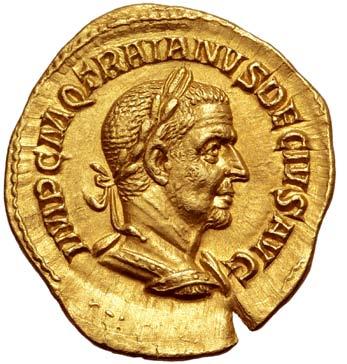
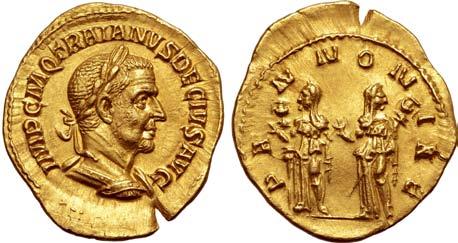
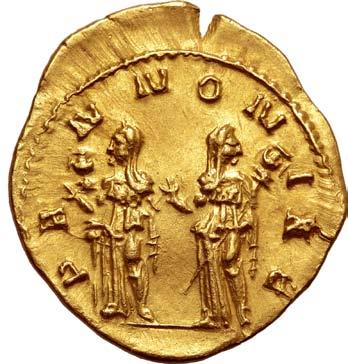
Trajan Decius AV Aureus. Rome, AD 249-251. IMP C M Q TRAIANVS DECIVS AVG, laureate and cuirassed bust to right / PANNONIAE, the two Pannoniae standing facing, veiled and draped, their heads turned to left and right looking away from each other, each holding standard pointed outwards. RIC IV 21a var. (bust type); C. 85; Calicó 3295. 3.94g, 20mm,
484. 1,500
Extremely Fine; minor surface flaw on cheek.

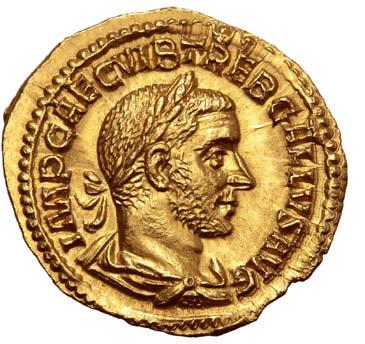
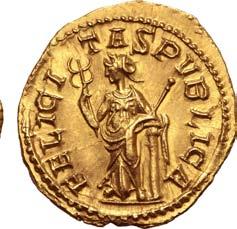

485.
Trebonianus Gallus AV Aureus. Rome, AD 251-253. IMP CAE C VIB TREB GALLVS AVG,
and
/ FELICITAS PVBLICA, Felicitas standing facing, head to
holding caduceus and sceptre, resting elbow on column. RIC IV 8 var. (bust type); Calicó 3333c (same dies). 3.52g, 20mm, 1h.
Mint State. Previously NGC graded MS 5/5 - 4/5 (#6327052-001). Exceedingly Rare; only one known to Calicó, with no others on CoinArchives. Ex Heritage World Coin Auctions, ANA Signature Sale 3101, 25 August 2022, lot 34109 (hammer: USD 13,000).
7,500 No Reserve
At a time when emperors were hard-pressed to maintain their position of power they were in many ways wholly dependent on the fickle attitudes of their armies. Trebonianus Gallus became emperor with the support of his army after the death of his predecessor Trajan Decius at the Battle of Abritus against the Scythian invaders in Moesia. In his portraiture, most notably on coins and a few sculptures such as the monumental bronze in the Metropolitan Museum of Art in New York, Gallus continued the iconographic tradition that was intended to present the emperor as a powerful general who could lead the armies and keep order in the empire. This iconography is characterised by a military style haircut, a short, stubble beard, and a stern, even menacing expression; all of which aspects owe their origins to the mature portrait types of Caracalla.
Early in his reign Gallus shared the purple with his predecessor’s son Hostilian, who had been Caesar in 251 at the time of his father’s death. However, Hostilian died in an outbreak of the plague which struck Rome later that year, leaving the way open for Gallus’ son Volusian to be made co-emperor with his father. The co-rulers were unfortunately too inept to deal with the pressures and instabilities that Rome faced, including economic crisis, famine and invasions by the Goths and Persians. It is then perhaps slightly ironic that Felicitas occupies the reserve of this coin, traditionally a symbol of wealth and prosperity, but this reflects the rather hopeful attempt of the co-emperors to maintain their power in part through the use of propaganda.

486.



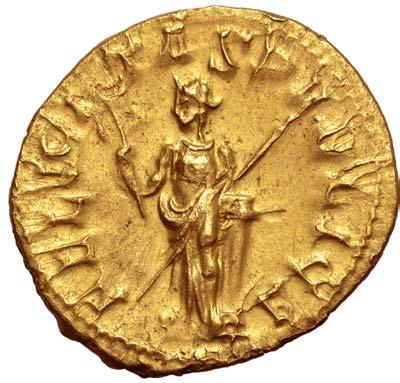
Trebonianus Gallus AV Binio (Double Aureus). Rome, AD 251-253. IMP CAE C VIB TREB GALLVS AVG, radiate, draped and cuirassed bust to right / FELICITAS PVBLICA, Felicitas standing facing, head to left, holding caduceus and sceptre, resting elbow on column. RIC IV 8 var. (rev. type); C. -; Biaggi -; Calicó 3333b (same dies). 7.54g, 22mm, 6h.
Good Extremely Fine. Extremely Rare; only one other on CoinArchives and the first to come to auction since 2005.
Ex Roma Numismatics Ltd., Auction XXVII, 22 March 2023, lot 722 (hammer: GBP 7,500).
The binio, otherwise called the double aureus, is identifiable by weight and the radiate portrait. It parallels the antoninianus which is distinguished from the denarius in the same way.
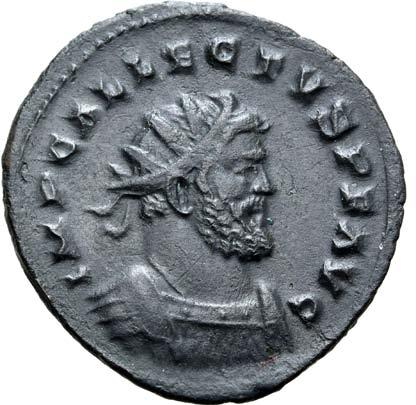
487.
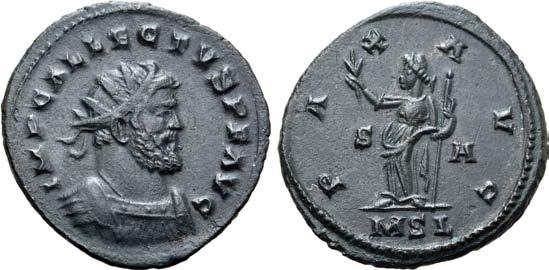

Allectus BI Radiate. London, AD 293-295. IMP C ALLECTVS P F AVG, radiate and cuirassed bust to right / PAX AVG, Pax standing to left, holding branch and vertical sceptre; S-A across fields, MSL in exergue. RIC V.2 28; Burnett 15; Webb 27. 4.37g, 24mm, 5h.
Extremely Fine.
Ex Richard Stirk Collection, Roma Numismatics Ltd., E-Sale 104, 15 December 2022, lot 1215;
Ex Roma Numismatics Ltd., E-Sale 76, 5 November 2020, lot 1172 (hammer: 260 GBP);
Ex Joel Malter Auctions, 23rd December 1982.

488.
489.
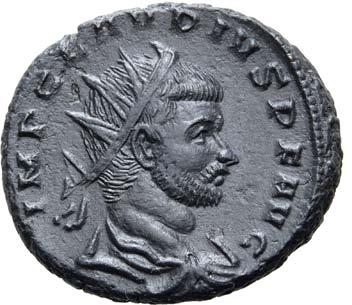
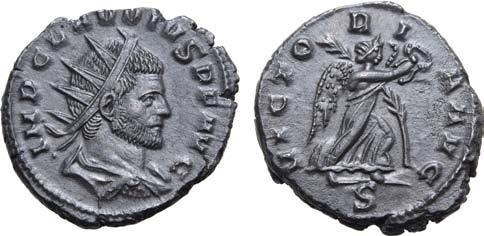
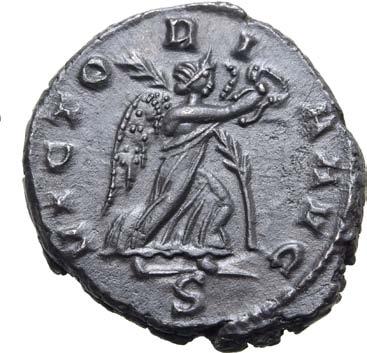
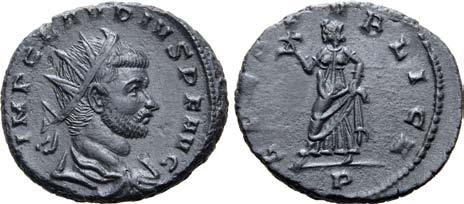
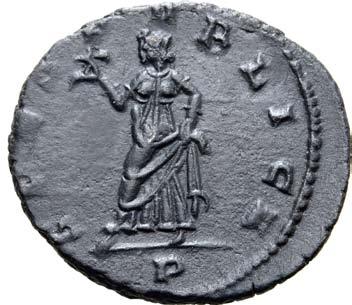
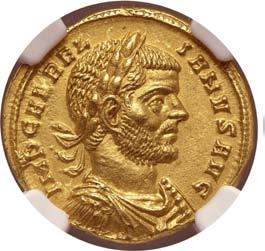



Aurelian AV Aureus. Mediolanum, AD 270. IMP C AVRELIANVS AVG, laureate, draped and cuirassed bust to right / CONCORDIA MILI, Concordia seated to left, holding standard in each hand. RIC V.1 166 (Siscia); MER-RIC 1353 (temporary); Calicó 3985.
NGC graded Ch AU 5/5 - 3/5, fine style (#6674414-003).
Ex Numismatica Ars Classica, Auction 132, 30 May 2022, lot 603 (hammer: CHF 17,000);
Ex Kunst und Münzen, Auction 28, 1992, lot 388;
Ex Giessener Münzhandlung, Auction 55, 14 May 1991, lot 763;
Ex Kunst und Münzen, Fixed Price List 66, 1991, lot 2;
Ex Numismatik Lanz München, Auction 50, 27 November 1989, lot 783.
7,500 No Reserve
Aurelian begun his career as a military commander, rising to become emperor under the authority of the Roman army in response to the instability of the state during the Crisis of the Third Century. It is not surprising then that there are multiple references to the army, most clearly seen through the reverse legend “CONCORDIA MILI” emphasising and willing harmony between the emperor and the military.
Aurelian’s first actions as emperor were aimed at consolidating the security of Roman territory; to that end in late AD 270 he campaigned against the barbarian incursions in northern Italia, driving the Vandals, Juthungi, and Sarmatians back across the border. His authority was by no means absolute, and Aurelian was challenged by the usurpers Septimius, Urbanus, Domitianus, and by the rebellion of Felicissimus. The latter revolt led by Felicissimus revolved around the imperial mint of Rome, with employees stealing imperial coinage, which ultimately led Aurelian to close the Rome mint, hence this coin was minted in Mediolanum.
To curry favour with the legions he commanded, Aurelian employed coinage to communicate the strength and importance of the army through both legends and imagery. The inclusion of Concordia, who embodies social concord, associates the quality of harmony with Aurelian’s reign while the inclusion of standards correlates to battlefield imagery where standards were symbolic of individual units and functioned as rallying points. They were thus widely recognised as a symbol of Roman military honour and more broadly as a symbol of the army in general. With multiple references to Aurelian’s militaristic outlook, this coin foreshadows the unprecedented success under his rule, which reunited the Roman Empire after its recent near collapse.
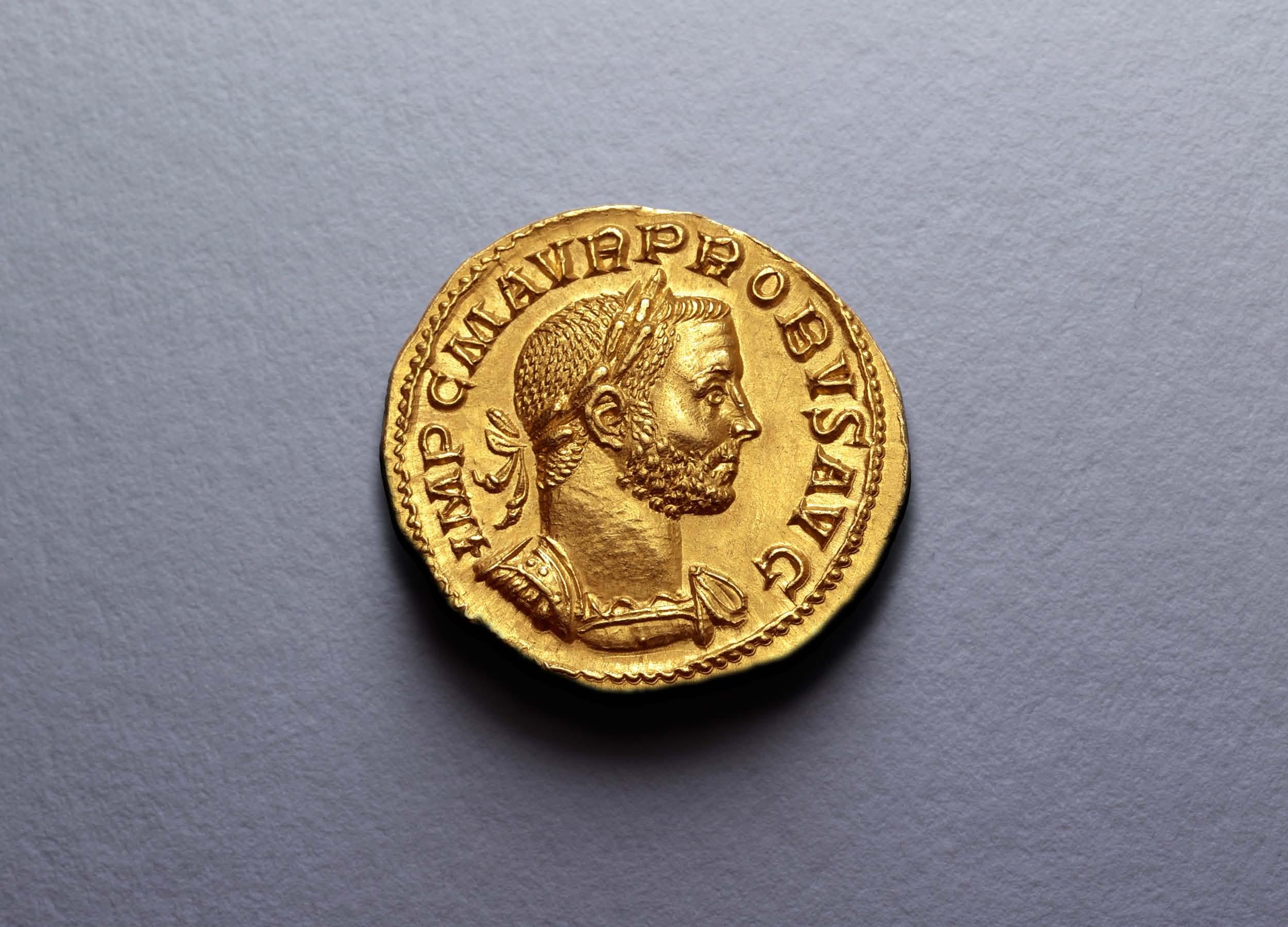

491.



Mint State. Extremely Rare; seemingly the only example on CoinArchives.
This coin published in X. Calicó, Los Aureos Romanos (2002);
Ex Numismatica Ars Classica, Auction 131, 30 May 2022, lot 110 (hammer: CHF 26,000);
Ex Roma Numismatics Ltd., Auction XVI, 26 September 2018, lot 785 (hammer: GBP 24,000);
Ex Chaponnière & Firmenich SA, Auction 8, 5 July 2017, lot 66;
Ex Numismatica Ars Classica 25, 25 June 2003, lot 565;
Ex Leo Biaggi de Blasys (1906-1979) Collection.
12,000 No Reserve
Probus’ ascension to the throne in AD 276 occurred at an unstable time for the Roman Empire: three emperors had died over the last year, two of whom were assassinated and the third is rumoured to have been; the security of the empire was threatened by foreign invasion and Florian, the brother of the previous emperor Tacitus, had been declared emperor by the senate and army in the West in opposition to Probus in the East. Probus therefore had a difficult task ahead of him to defeat his rival for the throne and restore order to a destabilised empire.
Probus had employed a Fabian strategy to defeat Florian, avoiding an outright battle and instead relying on skirmishes, the intensity of the summer heat and the discontent this caused among Florian’s army to weaken his enemy’s position. Florian was soon killed by his own forces, and Probus was confirmed as emperor by the Senate with a minimum of bloodshed.
Despite the calamitous state of the Empire when Probus ascended the throne, he proved himself to be an efficient and productive emperor, defeating numerous foreign enemies and improving some parts of the areas devastated by war through engaging the army during peacetime in building projects such as growing vines in Gaul, Pannonia and Moesia. Though his rule is covered to an extent by ancient historiographers, the stories often do not match up and the picture we receive of Probus’ rule is somewhat broad and lacking in detail. However, what the sources agree on are the great military achievements of this emperor and the respect he earned both from the conquered and his own people.
Despite his virtues, there was little security to be found in wearing the purple during this period. A long series of civil wars had created a penchant for general-emperors, elected by the army and thereby required to repay the soldiers for their support. Further, internal divisions had left Rome vulnerable to foreign enemies with Germanic tribes attacking the upper Rhine and Danube regions and Aurelian’s Persian campaign still unresolved. Finally, the threat of usurpation was ever present; over the six years Probus was emperor, he successfully put down three revolts but was ultimately assassinated by his own soldiers in AD 282 and replaced by the commander of the Praetorian Guard, Carus.


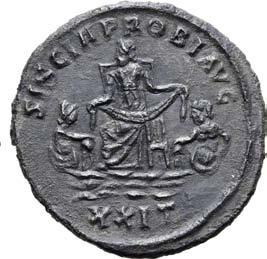

492.
Probus BI Antoninianus. Siscia, AD 276-282. IMP C M AVR PROBVS P AVG, radiate bust to left, wearing imperial mantle and holding eagle-tipped sceptre / SISCIA PROBI AVG, Siscia seated to left between river gods Savus and Colapis, holding diadem; XXIT below waves. RIC V.2 766. 3.90g, 21mm, 12h.
Extremely Fine. Very Rare.
Ex Roma Numismatics Ltd., E-Live Auction 3, 25 October 2018, lot 867 (hammer: £620).

493.
180



Probus BI Antoninianus. Ticinum, AD 277-278. IMP C PROBVS P F AVG, radiate and cuirassed bust to right / IOVI CONSERVAT, emperor standing to right, holding sceptre, receiving globe from Jupiter standing to left, holding sceptre; [V]XXT in exergue. RIC V.2 387; probuscoins.fr 3730. 4.29g, 23mm, 12h.
Good Extremely Fine.
Ex Terner Collection, Roma Numismatics Ltd., E-Sale 102, 3 November 2022, lot 1142.



494.
Good Extremely Fine.
Ex Terner Collection, Roma Numismatics Ltd., E-Sale 102, 3 November 2022, lot 1143.





495.

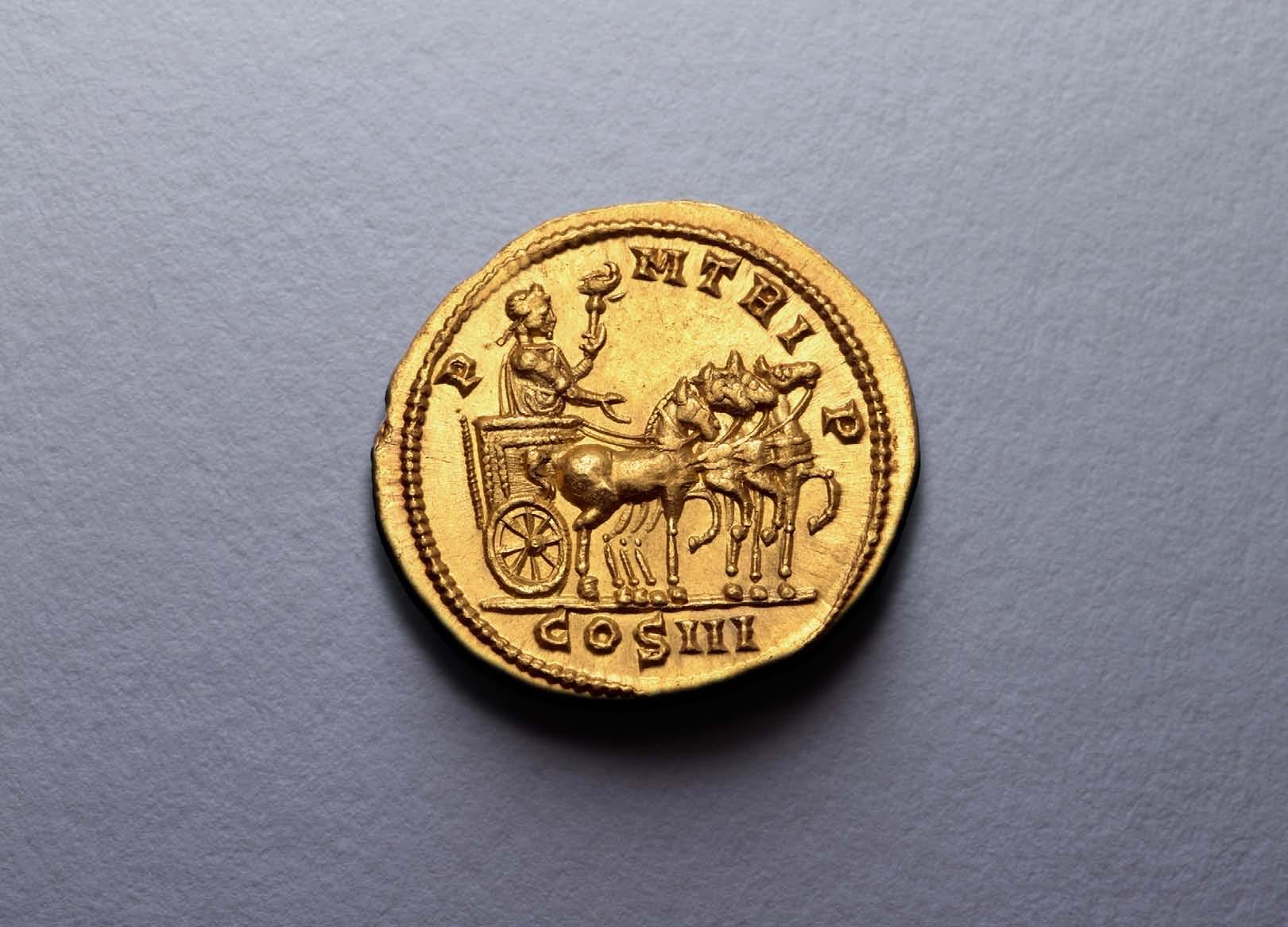
Probus AV Aureus. Siscia, AD 279. VIRTVS PROBI AVG, helmeted and cuirassed bust to right, helmet decorated with Victory driving biga / P M TRI P, emperor standing in car of slow quadriga to right, laureate and togate, holding eagle-tipped sceptre in left hand and extending right hand with open palm; COS III in exergue. RIC V.2 579 var. (bust to left); C. 453 var. (same); Calicó 4177 var. (same); Hunter 182 (same dies); NAC 105, 89 (same dies). 6.32g, 21mm, 7h.
NGC graded MS★, 5/5 - 4/5 (#6674413-004). Exceedingly Rare; only the third known example and one of just two in private hands.
Ex Roma Numismatics Ltd., Auction XXIII, 24 March 2022, lot 1069 (hammer: GBP 42,000); Ex Numismatica Ars Classica AG, Auction 120, 6 October 2020, lot 825 (hammer: CHF 48,000).
21,000
No Reserve
Raised to power by the army, Marcus Aurelius Probus was a product of the Third Century Crisis that saw a marked shift in the paradigm of imperial leadership. No longer did an emperor emerge from a system of succession, either as son or inherited heir of a sitting emperor, instead emperors were chosen by the military based on factors that included popularity, generosity towards the troops and their ability to produce measurable outcomes.
“As a youth Probus became so famed for his bodily strength that by approval of Valerian he received a tribuneship almost before his beard was grown” (Historia Augusta, 3.1). From this early recognition Probus went from strength to strength, becoming one of the highest placed lieutenants of the Emperor Aurelian and then supreme commander of the East under the Emperor Tacitus. Upon the death of Tacitus, Probus was made emperor by the army of Syria in AD 276, having defeated Florianus who too had attempted to ascend the imperial throne. The senate duly acknowledged the exploits of Probus and conferred upon him the names: Caesar, Augustus, Pontifex Maximus as well as granting him Tribunitian power and Proconsular command. However, the apparent stability granted to Probus by the affirmation of his leadership was not enough to quell the economic and social unrest that continuously threatened peace across the empire. Probus’ rule was marked by the threat of both usurpation and of advances from invaders along the borders. This instability made it all the more important for Probus to deliver, at all times, a composite vision of the emperor ‘victorious’ and we can see this reflected in his coinage. This specimen, of the highest rarity, encapsulates this idea across both its obverse and reverse.
On the reverse Probus stands garbed in ceremonial attire: togate with a laureate crown, he holds an eagle tipped sceptre in one hand and guides a quadriga with calm composure in the other. This composition draws direct parallels with triumphal and consular processions and thereby contributes a formal ritualistic facet to the image of the emperor victorious. On the obverse, the militant dimension of this image is added. Probus is presented as an emperor poised for battle in helmet and cuirass and the decoration of Victory driving biga clearly indicates the likely outcome of any action.
This image of Probus victorious prevails across his coinage and few issues celebrate any specific events, which presents a challenge to numismatists when trying to establish a chronology in his reign. We can however presume that due to the pairing of TRI P with COS III the coin celebrates the third or fourth renewal of his tribunician power due to the unorthodox (but consistent) links between titles across his coinage.
496.



Divus Nigrinian (son of Carinus) BI Antoninianus. Rome, AD 284. DIVO NIGRINIANO, radiate bust to right / CONSECRATIO, eagle standing facing with wings spread, head turned to left; KAA in exergue. RIC V.2 472 (Numerianus); C. 2; Pink VI/2, p. 9.
Good Very Fine.
Ex cgb.fr, Mail Bid Sale 61, 18 June 2014, lot 224; Ex cgb.fr, Mail Bid Sale 21, 18 June 2004, lot 3391.
300
Only a single inscription and the coins attest to the existence of Nigrinian, apparently a son of Carinus by Magnia Urbica who died at a young age and was consecrated.

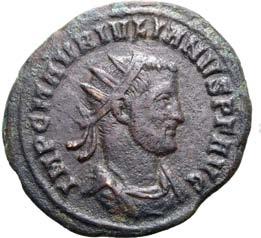
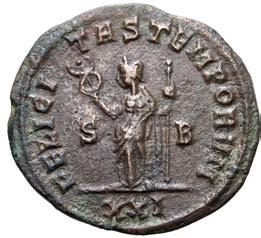
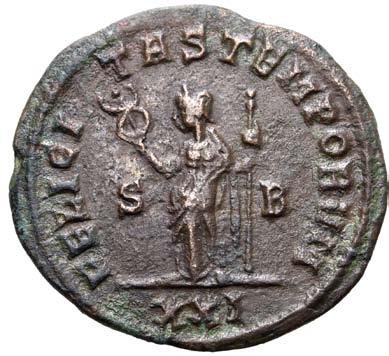
497.
Good Very Fine.
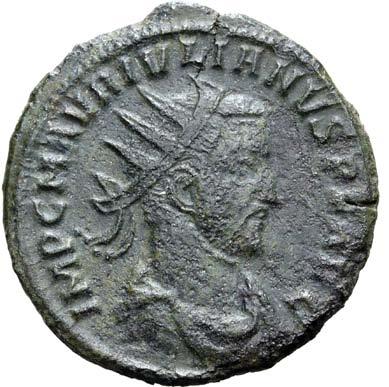



498.
Good Very Fine. Rare.
Ex Harlan J. Berk, Ltd., Buy or Bid Sale 205, 18 September 2018, lot 262 (hammer: USD 2,350); Previously purchased from Harlan Berk, August 1999.
One of the more serious of the ‘Thirty Tyrants’ described by Roman historians in the Historia Augusta, the revolt of Marcus Aurelius Julianus of Pannonia against Carinus in 284 caused the emperor to march from Britain and lead his army against the rebels near Verona, or perhaps in Illyricum (the sources are unclear), crushing them in early 285. Issued from the mint at Siscia, the coins of Julian of Pannonia are in the same good style that this mint had previously issued in the service of legitimate emperors.



499.

Near Mint State. Extremely Rare; no other examples offered at auction in the past 20 years.
This coin cited in G. Depeyrot, Les monnaies d’or (Wetteren, 1995-1996);
Ex Hess-Divo AG, Auction 328, 22 May 2015, lot 268 (hammer: CHF 26,000);
Ex Münzen und Medaillen AG Basel, Auction 43, 12 November 1970, lot 437.
6,000 No Reserve
It would ultimately be religious legitimisation, not military achievements, that would elevate Diocletian above his predecessors. The quasi-republican ideals of Augustus’ ‘primus inter pares’ system were abandoned for all but the tetrarchs themselves. Diocletian took to wearing a gold crown and jewels, and forbade the use of purple cloth to all but the emperors. His subjects were required to prostrate themselves in his presence (adoratio); the most fortunate were allowed the privilege of kissing the hem of his robe (proskynesis). The reverse of this coin further alludes to the quasi-divine aspects of the new ‘dominate’ system of government. Around 287 Diocletian assumed the title Iovius, and his colleague Maximian assumed the title Herculius; these grandiose new titles not only reflected the working dynamic between Diocletian and Maximian (while the one acted as supreme strategist, the other enforced imperial will by brute force), but more importantly by taking on divine attributes Diocletian intended to make the person of the emperor inviolate as the gods’ representative on earth.
Diocletian’s administrative and bureaucratic reforms encompassed far more than the decentralisation of imperial power. Some of his most enduring changes were to the Roman military. Instituting systematic annual conscription for the first time since the days of the Republic, Diocletian increased the overall size of the Roman army by roughly 33%, and more than doubled the number of legions and auxiliary units by creating smaller, more mobile detachments. A massive upgrade of the empire’s defensive infrastructure was undertaken across great swathes of the borders including new fortifications and roads. Centralised fabricae were introduced to provide arms and armour for the army on an industrial scale. The most significant change to the Roman military structure was the establishment of large personal escort armies (comitatus praesentales) which typically comprised 2030,000 elite palatine troops. These highly mobile armies were designed to quickly reinforce the border defences or crush potential usurpers. Indeed, while they proved highly effective during Diocletian’s reign, in his retirement he would live to see them misused by his successors, who now each had a substantial comitatus at their disposal to enforce their claims.
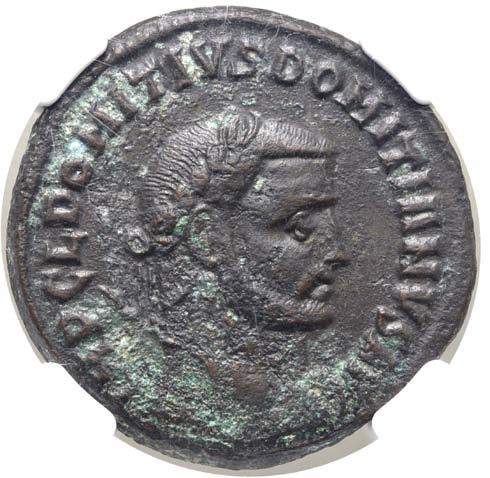
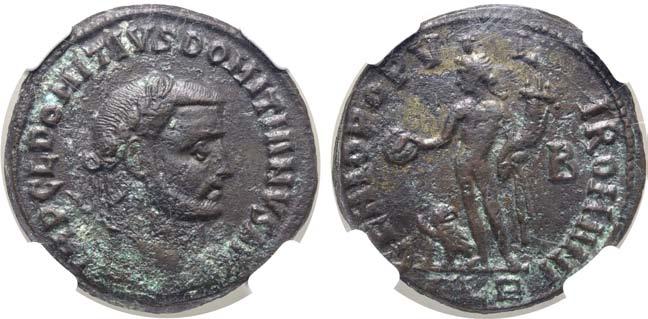

500.
NGC graded Ch XF 4/5 - 2/5 (#4529310-018).
Acquired from Sergey Nechayev (New York) in 2018.
600 No Reserve
Stationed in an Egypt that was overtaxed and burdened with considerable administrative corruption, Domitius Domitianus took the purple in an effort to ameliorate the lot of the local people. He instituted agricultural reforms and repairs to the decrepit irrigation channels, undertook a reform of the local coinage in order to improve commerce, and strengthened the province militarily.
Diocletian’s response was swift and brutal, and he invaded Egypt. Despite being heavily outnumbered, Domitianus was able to withstand Diocletian’s advance for months, and although by December of 297 Diocletian had control of Egypt, Alexandria refused to capitulate. Domitianus’ ultimate fate is unrecorded, however he was likely killed or assassinated. In his fury, Diocletian authorised a general sack of the city and a massacre of the population.
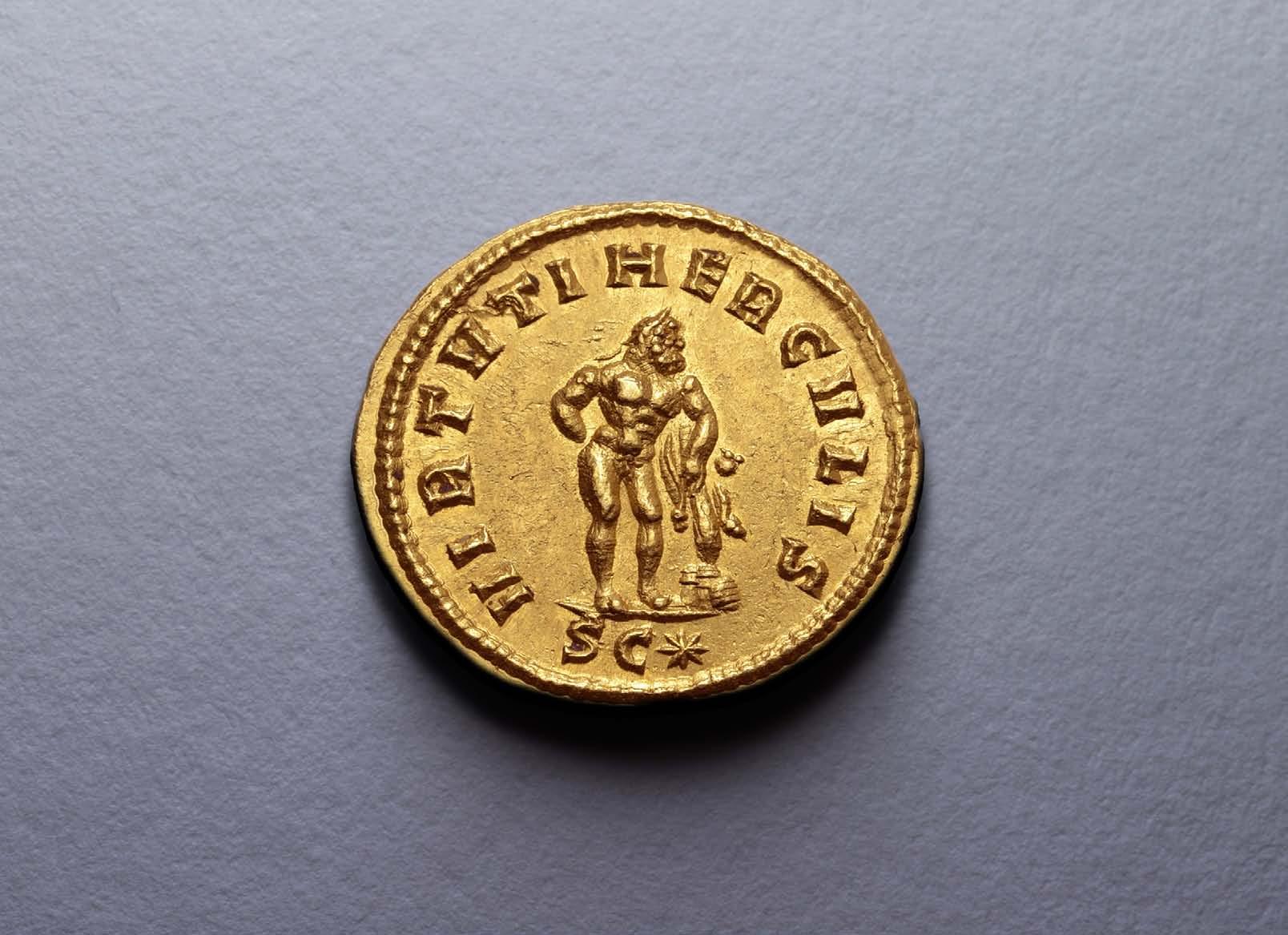
Maximian AV

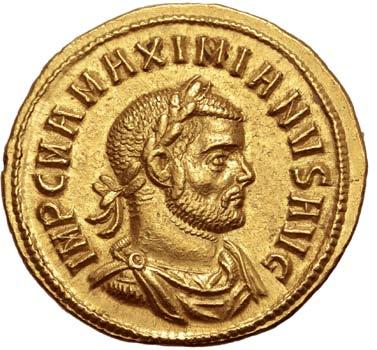

5.30g, 21mm, 12h.
Good Extremely Fine; a powerful rendering of Hercules. Extremely Rare; the only example on CoinArchives with this mintmark.
This coin published in G. Depeyrot, L’or du Bas-Empire, Inventaire justificatif des tomes 1 et 2, 2004, p.133, 6/4; Ex Dr. Hans Krähenbühl Collection, Leu Numismatik AG, Auction 8, 23 October 2021, lot 368 (hammer: CHF 15,000)
Purchased from Münzen & Medaillen AG, 25 October 1963; Ex Münzen & Medaillen AG, Auction XXV, 17 November 1962, lot 644.
6,000 No Reserve
In 293, Diocletian established the Tetrarchy, a system by which the empire was divided geographically into four areas and ruled by two Augusti and two Caesars. Prior to dividing power between four, Diocletian had initially promoted his ally Maximian to Augustus in 286 to rule with him as coemperor. At the same time, Mausaeus Carausius was appointed to defend the Channel from attacks by Frankish and Saxon pirates. However, Carausius showed his gratitude towards Maximian by usurping power and declaring himself Augustus of Britain and northern Gaul. It was therefore now imperative that Maximian also had a title and position of equal status to confront Carausius on equal standing. Diocletian, having just started to bring some semblance of stability back to the empire after decades of turbulence, was determined that civil war should not break out again. By co-opting Maximian as his fellow Augustus he seemingly hoped that the unrest developing in the north of the empire would be quelled and his program of reform could continue uninterrupted. So, as part of their assumption of joint power, Diocletian and Maximian adopted tutelary deities, namely Jupiter and Hercules respectively and took on the surnames Jovius and Herculius. From this point, most of their coinage was minted with reverse legends and types honouring Jupiter and Hercules, (see Sydenham, E.A. & Mattingly, H. eds., RIC V.2, 1933, p. 213), as shown on this coin.
According to myth, the Olympians were only able to defeat the giants with the help of Hercules, whose role is only obliquely referred to by ancient writers (Hesiod, Theogony 954), but it would seem was commonly known as part of the wider myth in the ancient world. Punished for murdering his wife and children in a rage visited on him by Hera queen of the gods, Hercules was tasked with ten labours to redeem himself, meted out by his cousin King Eurystheus (two of the tasks were disqualified as Hercules was considered to have received too much help). Ultimately, when these tasks were completed, he would be rewarded with immortality by the gods. The labour referred to on this coin is the first; the slaying of the Nemean Lion, indicated by the traditional lion-skin draped over a club. This imagery emphasises Hercules’ power over beasts and more broadly the taming of nature by men. This coin can therefore be seen as underpinning the two Augusti’s connection with their tutelary gods and emphasising the new order established in the empire.


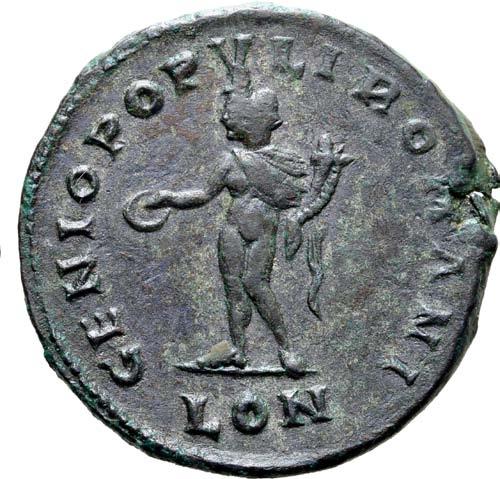
502.
Maximian BI Nummus. London, AD 297-305. IMP C MAXIMIANVS P F AVG, laureate head to right / GENIO POPVLI ROMANI, Genius, wearing modius on head, standing to left, holding patera and cornucopiae; LON in exergue. RIC VI 1b; C&T 1.01.002; RML 4. 8.80g, 27mm, 6h.
Near Extremely Fine. Very Rare; finer than the three other examples present on CoinArchives of this important issue, the first struck after re-taking London from the usurpers Carausius and Allectus.
Ex David Miller Collection, collector’s ticket included, Roma Numismatics Ltd., Auction XXIII, 24-25 March 2022, lot 623 (hammer: GBP 1,500).
300

503.


Maximian AR Argenteus. Thessalonica, AD 302. MAXIMIANVS AVG, laureate head to right / VIRTVS MILITVM, four-turreted camp gate with doors thrown open, star above arch; TS•B• in exergue. RIC VI 11b var. (unlisted officina); RSC 631†c var. (same). 3.46g, 20mm, 12h.
Near Mint State; bright and lustrous. Very Rare variant; unrecorded in RIC.
Ex Roma Numismatics Ltd., Auction XV, 5 April 2018, lot 632.
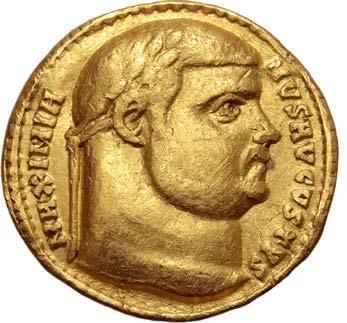


504.
300

Maximian AV Aureus. Nicomedia, AD 303-304. MAXIMIANVS AVGVSTVS, laureate head to right / XX MAXIMIANI AVG SMN in five lines within laurel wreath. RIC VI 14; C. 704; Depeyrot 7/3; Calicó 4768. 5.24g, 18mm, 12h.
Very Fine. Very Rare.
Ex David Miller Collection, Roma Numismatics Ltd., Auction XXIII, 25 March 2022, lot 625, collector’s ticket included (hammer: GBP 2,600); Ex Collection of GK, Ukrainian Emigrant, Roma Numismatics Ltd., Auction XXI, 24 March 2021, lot 728.
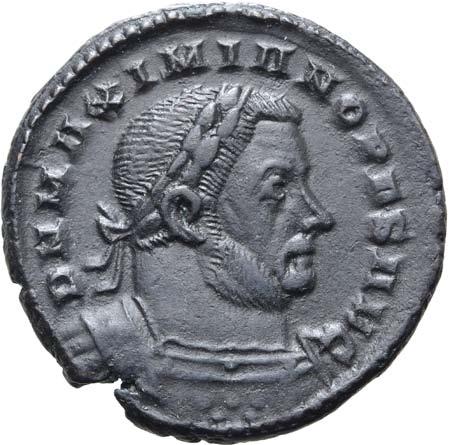


505.
Maximian BI Nummus. London, AD 307-310. D N MAXIMIANO P F S AVG, laureate and cuirassed bust
Extremely Fine. Scarce.
Ex Roma Numismatics Ltd., E-Live Auction 6, 25 March 2023, lot 304, uncertain dealer’s ticket included (£330).
/

506.


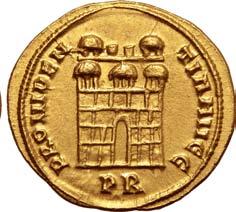
Constantius I, as Caesar, AV Aureus. Rome, AD 294-299. CONSTANTIVS CAES, laureate head to right / PROVIDENTIA AVGG, camp gate with three forward turrets, two small turrets behind between two towers; PR in exergue. RIC VI 6a; Depeyrot 12A/3 var. (rev. legend break); Calicó 4869. 5.39g, 19mm, 11h.
Good Extremely Fine. Extremely Rare; only 4 examples known to Depeyrot, three of which are in museums, and none others on CoinArchives with this legend break.
Ex Classical Numismatic Group, Auction 121, 6 October 2022, lot 953.
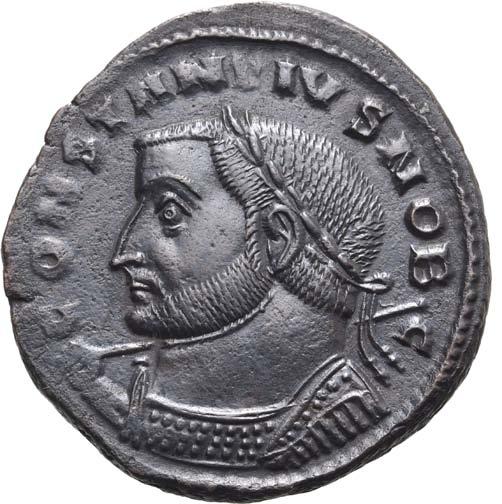

4,500 No Reserve

Constantius I, as Caesar, BI Nummus. Lugdunum, AD 301-303. CONSTANTIVS NOB C, laureate and cuirassed bust to left, holding sceptre over shoulder / GENIO POPVLI ROMANI, Genius, wearing modius on head, standing to left, holding patera over lit altar on left and cornucopiae; A in right field, PLC in exergue. RIC VI 167a. 11.11g, 29mm, 7h.
Good Extremely Fine; stripped and repatinated.
507. 45 No Reserve
Ex Roma Numismatics Ltd., E-Sale 103, 24 November 2022, lot 1221; From the Rauceby Hoard, found in Lincolnshire, July 2017. Submitted for consideration as Treasure and returned to the finders. PAS ID: LIN-F6D516. BM Ref: 2017 T649.
Part of a hoard found in Lincolnshire in July 2017 by a metal detectorist. An archaeological excavation of the site subsequently took place on 25th July. The coins were found in a ceramic vessel which was buried in the centre of a large oval pit lined with rough quarried limestone. The pot appears to have been placed on the limestone base and then further pieces of limestone were packed around it all the way up to the top of the pit. Dr Adam Daubney, the finds liaison officer, has argued that this careful burial method suggests the pot may have been a ceremonial or votive offering and hence may be evidence of so-called ‘ritual’ hoarding in Roman Britain. The coins found were predominantly billon nummi dating from between AD 294 and 307-8, and is the largest fully recorded Roman find from this period in Britain.



508.
Galerius BI Nummus. Aquileia, AD 306-307. IMP C MAXIMIANVS P F AVG, laureate, helmeted and cuirassed bust to right, with shield and sceptre / VIRTVS AVGG ET CAESS NN, emperor galloping to right, holding shield and spearing fallen enemy, further enemy below horse; AQS in exergue. RIC VI 81a. 10.07g, 29mm, 6h.
Extremely Fine. Exceedingly Rare; seemingly just two specimens held in public collections, and one further example on CoinArchives.
Ex Roma Numismatics Ltd., E-Sale 91, 2 December 2021, lot 1124 (hammer: GBP 700).
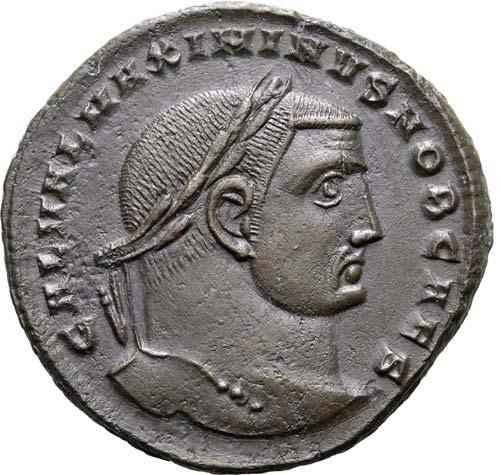


509.
Maximinus II, as Caesar, BI Nummus. Heraclea, AD 305-307. GAL VAL MAXIMINVS NOB CAES, laureate head to right / GENIO POPVLI ROMANI, Genius, wearing modius on head and chlamys over shoulder, standing facing, head to left, holding cornucopiae and patera, from which liquor flows; HTA in exergue. RIC VI 26b & p.532 note 3. 9.97g, 28mm, 11h.
Good Extremely Fine.
Ex Roma Numismatics Ltd., E-Sale 103, 24 November 2022, lot 1254.
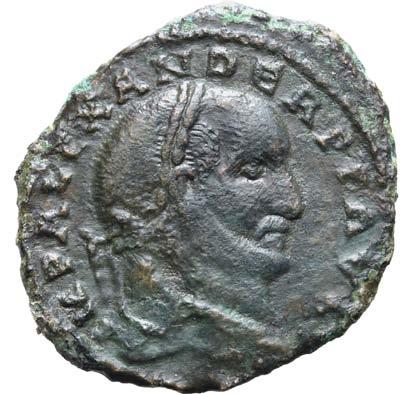
510.
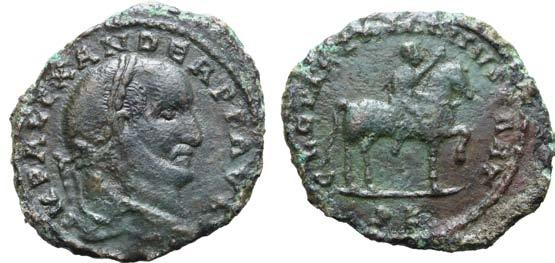

Domitius Alexander (usurper) Æ 23mm. Carthage, AD 308-311. IMP ALEXANDER P F AVG, laureate head to right / GLORIA EXERCITVS KART, Alexander on horseback to right, raising right hand; PK in exergue. RIC VI 66 var. (rev. legend break); BM 1862,0415.18 var. (same); Roma E-Sale 7, 1212. 4.48g, 23mm, 7h.
Good Very Fine; some details enhanced, somewhat smoothed. Extremely Rare.
Acquired from Ingemar Wallin Utvekling AB (Sweden), November 2018.
The usurper L. Domitius Alexander (Alexander of Carthage) was governor of Africa and had sworn allegiance to Maxentius, securing the all-important Carthaginian grain supply for Rome. Constantine and Maximian convinced Alexander to renege on this alliance, and thus he deserted to their camp and halted the grain shipments, causing famine and severe rioting in Rome. Maxentius sent his praetorian prefect Volusian with several Legions to North Africa to put an end to Alexander’s revolt and, when Constantine and Maximian offered no help, Volusian’s legions swiftly defeated Alexander and his troops. Alexander himself was captured and strangled shortly thereafter.

511.
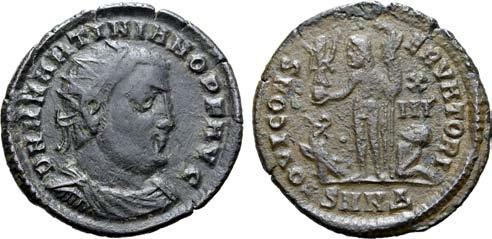
Martinian BI Nummus. Nicomedia, AD 324. D N M MARTINIANO P F AVG,
VII 46.
and
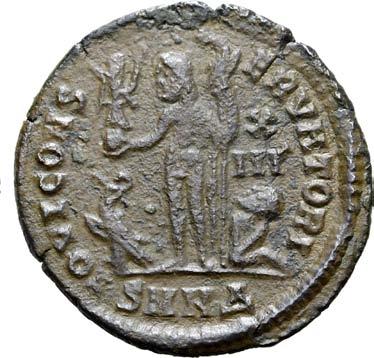
/
Near Extremely Fine. Scarce.
Ex Roma Numismatics Ltd., Auction XX, 29 October 2020, lot 695 (hammer: GBP 1,900).
512.


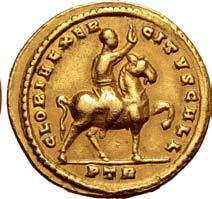

Constantine I ‘the Great’ AV Solidus. Treveri, AD 312-313. CONSTANTINVS P F AVG, laureate head to right / GLORIA EXERCITVS GALL, emperor riding to right, arm raised; PTR in exergue. RIC VI 812; C. 258; Depeyrot 17/5. 4.47g, 17mm, 6h.
Very Fine. Extremely Rare; only 2 other examples auctioned in the past 20 years.
Ex Harmers of London, Auction 3, 26 September 2022, lot 113; Ex Burgan Numismatique - Maison Florange, E-Auction 22-1, 6 March 2022, Lot 30.
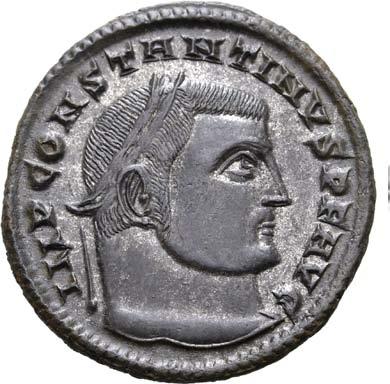
513.


Constantine I ‘the Great’ BI Nummus. Siscia, AD 315-316. IMP CONSTANTINVS P F AVG, laureate head to right / IOVI CONSERVATORI, Jupiter standing to left, leaning on sceptre and holding Victory on globe, eagle with wreath in beak at feet to left; A in right field, •SIS• in exergue. RIC VII 15. 4.04g, 22mm, 2h.
Near Mint State.
Ex Roma Numismatics Ltd., E-Sale 103, 24 November 2022, lot 1287.
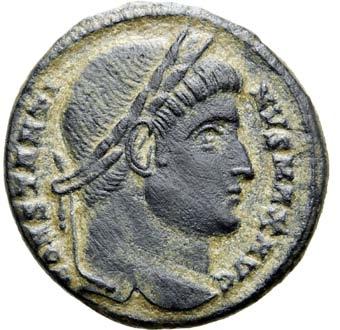
514.

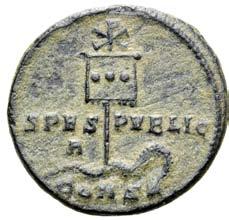

Constantine I ‘the Great’ BI Nummus. Constantinople, AD 327. CONSTANTINVS MAX AVG, laureate head to right / Labarum, with three medallions on vexillum and surmounted by Christogram, piercing serpent below; SPES PVBLIC across fields, A in left field, CONS below. RIC VII 19; LRBC 978. 3.11g, 18mm, 11h.
Good Extremely Fine. Very Rare.
Ex Roma Numismatics Ltd., Auction XX, 29 October 2020, lot 692 (hammer: GBP 4,400).
The reverse of this nummus, remarkable for being Constantine’s earliest use of Christian symbolism on his regular coinage, has been the subject of academic discourse for decades. The first numismatic instance of Constantine’s use of the Chi-Ro symbol was in a series of medallions struck after his victory at the Battle of the Milvian Bridge in AD 312, where he famously experienced a vision featuring a ‘cross of light in the heavens, above the sun’ (Eusebius, Life of Constantine, 1:28), the wearing of which would lead his troops to victory. Peter Weiss has convincingly argued that the physical phenomena that was witnessed that day was likely a parhelion, which rather like eclipses may have been responsible for more than one inspirational pre-battle vision throughout history (Weiss, ‘The Vision of Constantine’ in Journal of Roman Archaeology: 16, 2003). Whatever the cause, Constantine’s intentions following this event are what have caused controversy.
According to Weiss, rather than experiencing an immediate revelation, Constantine only interpreted this vision as Christian years later, which explains the long delay and very small proportion of coins featuring Christian imagery. Another interpretation of these events argues that Constantine was actually pursuing a deliberately slow strategy, in order to not stir resistance – particularly given the civil wars which already troubled his reign (DesRosiers and Vuong, Religious Competition in the Greco-Roman World, 2016). However, as early as 1962 (even before the publication of the relevant RIC volume) numismatic historian Richard Bruun expressed scepticism that the sign of the Chi-Ro would have been recognised as religious, in his seminal article ‘The Christian Signs on the Coins of Constantine’. The wider ‘pagan’ audience who handled coins of this type would have instead recognised it as a personal badge of the emperor - in this example, it is certainly presented as such in its placement atop the vexillum, where the medallions stand in for portraits of the imperial family.
The meaning of the snake suffers from similar ambiguities surrounding its meaning and reception. Depending on an author ’s views on the overtness of the other Christian imagery present, the snake can be interpreted either as a ‘universal’ symbol of evil, a representation of the recently-defeated pagan Licinius I, or a Judeo-Christian image of the demonic.
515.



Helena (mother of Constantine I) BI Nummus. Thessalonica, AD 318-319. HELENA N F, draped bust to right / Laurel wreath enclosing star. RIC VII
50. 3.11g, 19mm, 12h.
Near Extremely Fine.
Ex David Miller Collection, collector’s ticket included, Roma Numismatics Ltd. Auction XXIII, 25 March 2022, lot 651 (hammer: GBP 360).

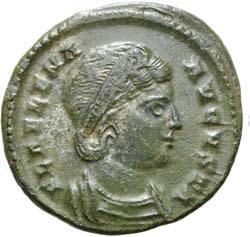


516.
Helena (mother of Constantine I) BI Nummus. London, AD 324-325. FL HELENA AVGVSTA, diademed and draped bust to right / SECVRITAS REI PVBLICE, Securitas standing to left, lowering branch and raising pallium; PLON in exergue. RIC VII 299; C&T 10.02.009; RML 1127 (this coin). 3.02g, 20mm, 6h.
Good Extremely Fine. Very Rare; exceptional quality for the issue - the finest of only 11 examples auctioned since 1997.
This coin published in K. Elks, The Roman Mint of London (London: London Ancient Coins Ltd);
Ex David Miller Collection, Roma Numismatics Ltd., Auction XXIII, 24 March 2022, lot 652 (hammer GBP £2,200).
No lot. 517.
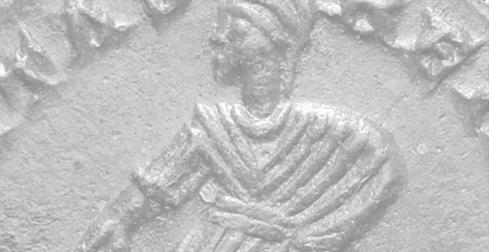
518.
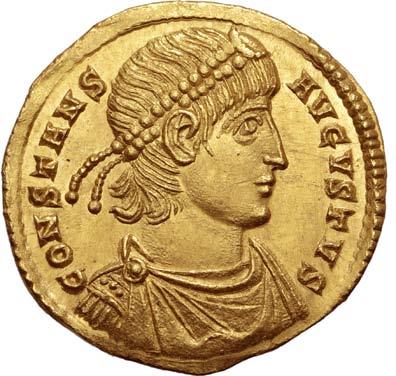

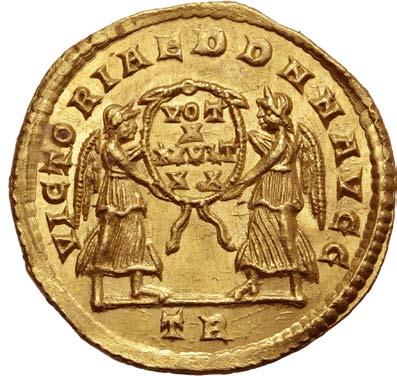
Constans AV Solidus. Decennalia issue. Treveri, AD 347-348. CONSTANS AVGVSTVS, pearl-diademed, draped and cuirassed bust to right / VICTORIAE D D N N AVGG, two Victories standing facing each other, holding shield inscribed VOT X MVLT XX; TR in exergue. RIC VIII 135; Depeyrot 6/3. 4.49g, 22mm, 6h.
Mint State; a couple of minor marks to obv., otherwise highly lustrous, untouched surfaces.
Ex Classical Numismatic Group, Auction 114, 13 May 2020, lot 1009 (hammer: USD 3,000); Privately purchased from Numismatic Fine Arts Inc. prior to 1995.
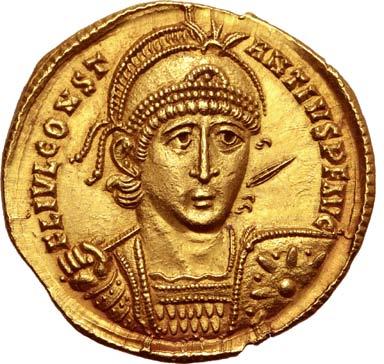
519.



Constantius II AV Solidus. Rome, AD 355-367. FL IVL CONSTANTIVS P F AVG, pearl-diademed, helmeted and cuirassed bust facing, holding spear and shield decorated with star / GLORIA REIPVBLICAE, Roma enthroned facing, holding spear, and Constantinopolis enthroned to left with foot on prow and holding sceptre, supporting between them shield inscribed VOT XXX MVLT XXXX in four lines; •RSMЄ• in exergue. RIC VIII 290 var. (mintmark); C. 117 var. (same); Depeyrot 12/1 var. (same); cf. Gorny & Mosch 236, 504 (same rev. die, but with christogram in shield on obv.). 4.55g, 21mm, 12h.
Near Mint State. Apparently unique and unpublished.
Ex Leu Numismatik AG, Auction 7, 24 October 2020, lot 1766 (hammer: CHF 4,800)
Ex Classical Numismatic Group, Triton XVII, 7 January 2014, lot 798.



520.
Ex Brian Henry Grover Collection, Roma Numismatics Ltd., E-Sale 72, 25 June 2020, lot 1666 (hammer: GBP 1,200).



521.
Mint State; an impressive and very finely detailed portrait.
Ex DMS Collection; Privately purchased from Brian Kritt, 17 November 2009, inventory no. 40030.
522.
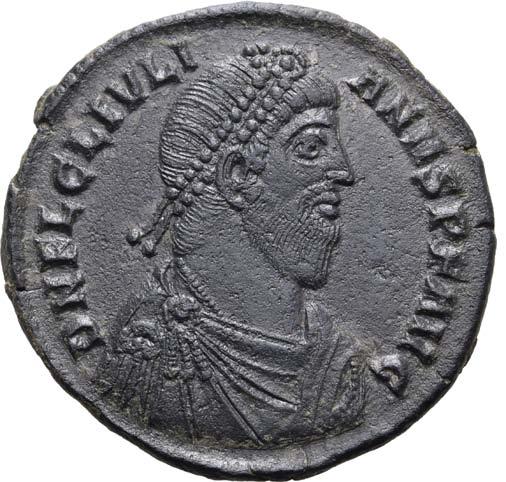

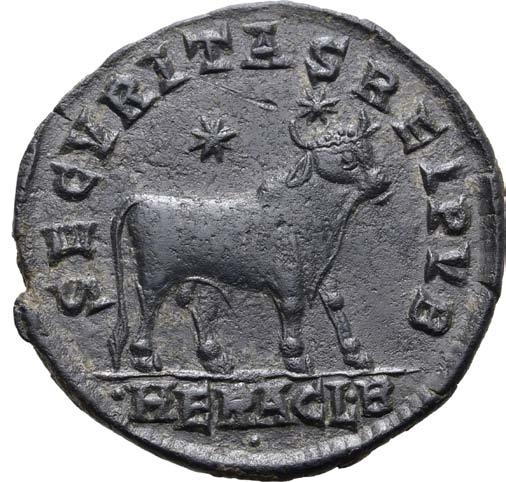
Julian II BI 28mm. Heraclea, AD 361-363. D N FL CL IVLIANVS P F AVG, pearl-diademed, draped and cuirassed bust to right / SECVRITAS REIPVB, bull standing to right, two stars above; •HERACL•B in exergue. RIC VIII 104. 9.00g, 28mm, 6h.
Good Extremely Fine.
Ex Morton & Eden, Auction 119, 6 December 2022, lot 81.
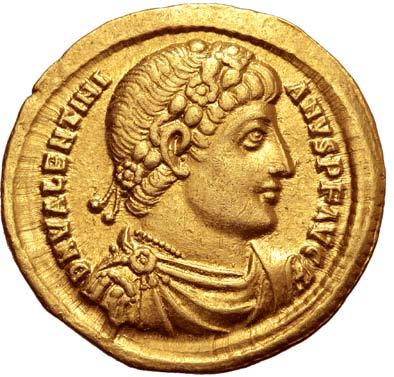
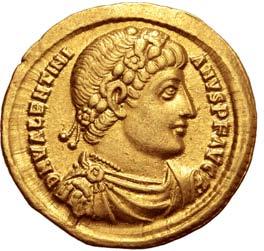
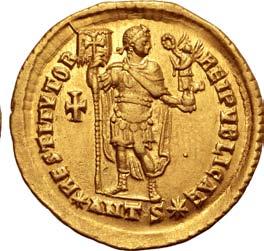

523.
Valentinian I AV Solidus. Antioch, AD 364-367. D N VALENTINIANVS P F AVG, rosette-diademed, draped and cuirassed bust to right / RESTITVTOR REIPVBLICAE, emperor standing facing, head to right, holding standard with cross and Victory on globe; cross in left field, *ANTS* in exergue. RIC IX 2b xxxviii; Depeyrot 20/1. 4.52g, 21mm, 5h.
Extremely Fine; ‘S’ graffito in reverse field.
Ex Leu Numismatik AG, Web Auction 20, 16 July 2022, lot 2811.
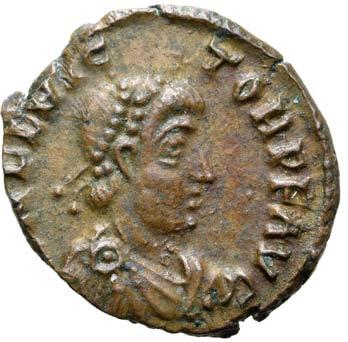
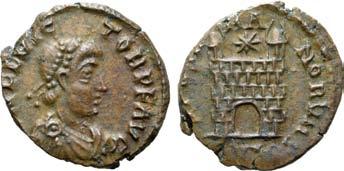

Flavius Victor Æ 14mm. Lugdunum, AD 383-388. D N FL VICTOR P F AVG, pearl-diademed, draped and cuirassed bust to right / SPES ROMANORVM, camp gate with no doors and two
Near Extremely Fine. Scarce.

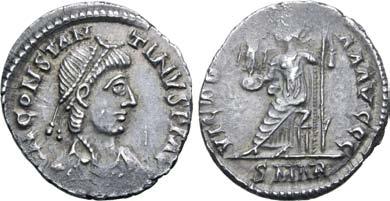
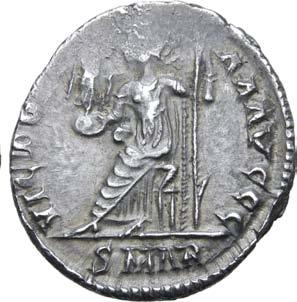
526.
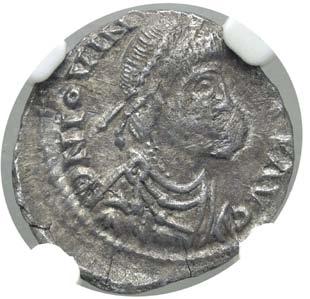


Jovinus AR Siliqua. Lugdunum, AD 411-413. D N IOVIN[VS P] F AVG, pearl-diademed, draped and cuirassed bust to right / VIC[TOR]IA AVGG, Roma seated to left on curule chair, holding Victory on globe and inverted spear; SMLDV in exergue. RIC X 1716; RSC 4†c. 1.56g.
NGC graded XF 3/5 - 3/5, lt. scratches (#5770058-004).
Acquired from Holding History Inc.
Following the defeat of the usurper known as Constantine III, Jovinus was proclaimed emperor at Mainz in 411, a puppet supported by Gundahar, king of the Burgundians, and Goar, king of the Alans. Jovinus kept his position in Gaul for two years, long enough to issue coinage that showed him wearing the imperial diadem.



527.
Theodosius II AV Solidus. Constantinople, AD 425-429. D N THEODOSIVS P F AVG, pearl-diademed, helmeted and cuirassed bust facing slightly to right, holding spear and shield decorated with horseman motif / SALVS REIPVBLICAE H, Theodosius II and Valentinian III enthroned facing, each holding mappa; star above, CONOB in exergue. RIC X 237; Depeyrot 79/1; DOCLR 374; MIRB 23. 4.46g, 21mm, 6h.
Mint State.
Ex Numismatik Naumann, Auction 75, 3 March 2019, lot 731.

528.
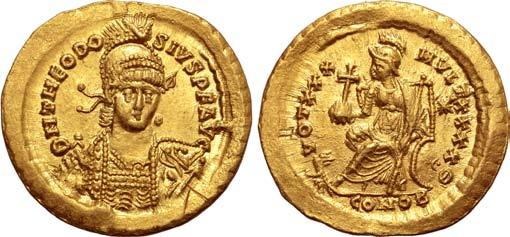
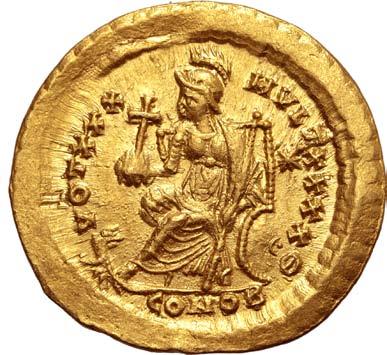
Theodosius II AV Solidus. Constantinople, AD 430-440. D N THEODOSIVS P F AVG, pearl-diademed, helmeted and cuirassed bust facing slightly to right, holding spear and shield decorated with horseman motif / VOT XXX MVLT XXXX Θ, Constantinopolis seated to left, holding globus cruciger and sceptre, foot on prow, shield by throne; star in right field, CONOB in exergue. RIC X 257; Depeyrot 81/1. 4.50g, 21mm, 6h.
Near Mint State; ‘Λ’ graffito on obv.
Ex Roma Numismatics Ltd., Auction XXVII, 22 March 2023, lot 782.
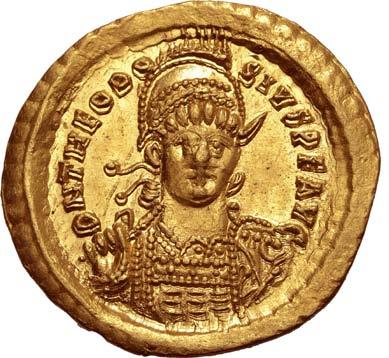
529.
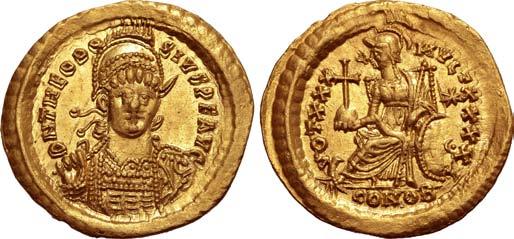

Theodosius II AV Solidus. Constantinople, AD 430-440. D N THEODOSIVS P F AVG, helmeted, pearl-diademed and cuirassed
Good Extremely Fine; double strike to obv.
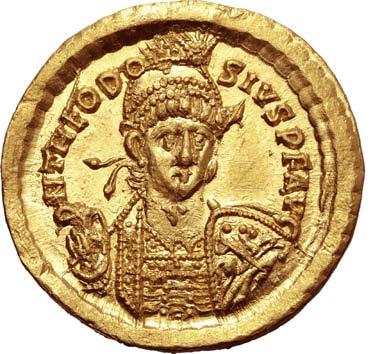
530.

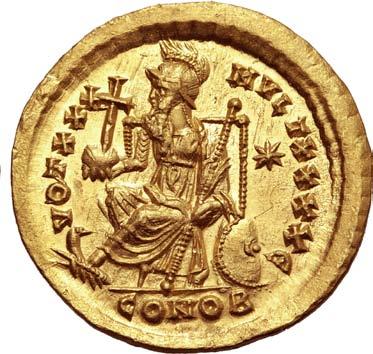
Good Extremely Fine; graffiti: ‘Z’ in obv. field, ‘ς’ in rev. field, highly lustrous metal.
Ex Roma Numismatics Ltd., E-Sale 107, 16 March 2023, lot 1379.
531.
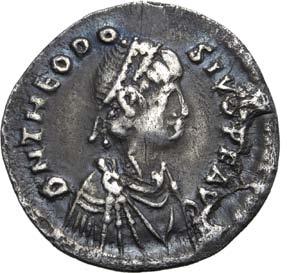
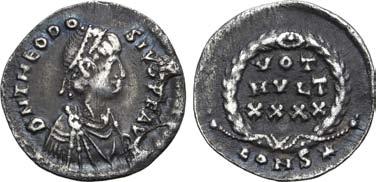

Theodosius II AR Siliqua. Constantinople, AD 438-450. D N THEODOSIVS P F AVG, pearl-diademed, draped and cuirassed bust to right / VOT MVLT XXXX in three lines within wreath; CONS* in exergue. RIC X 389; RSC 21. 0.86g, 16mm, 7h.
Good Very Fine; attractive old cabinet tone. Very Rare.
Ex David Miller Collection, Roma Numismatics Ltd., Auction XXIII, 25 March 2022, lot 721 (collector’s ticket included).
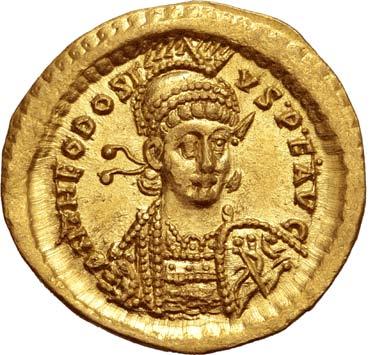



532.
Theodosius II AV Solidus. Constantinople, AD 441-450. D N THEODOSIVS • P • F • AVG, pearl-diademed, helmeted and cuirassed bust facing slightly to right, holding spear and shield decorated with horseman motif / IMP • XXXXII • COS • XVII • P • P •, Constantinopolis seated to left, holding globus cruciger and sceptre, foot on prow, shield by throne; star in left field, COMOB in exergue. RIC X 293; Depeyrot 84/1. 4.46g, 20mm, 6h.
Mint State.
Ex Roma Numismatics Ltd., Auction XXVII, 22 March 2023, lot 785.
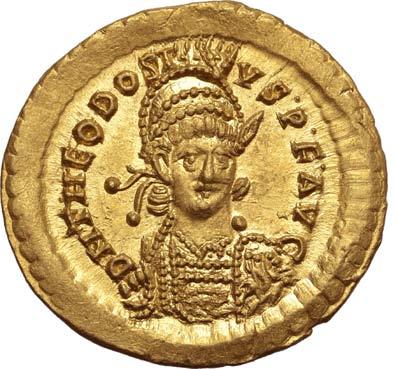



533.
Theodosius II AV Solidus. Constantinople, AD 441-450. D N THEODOSIVS • P •
Near Mint State.
Ex Roma Numismatics Ltd., Auction XXVII, 22 March 2023, lot 789.

534.
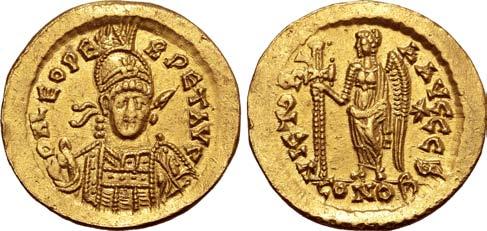

535.

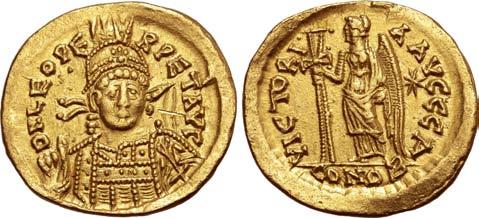
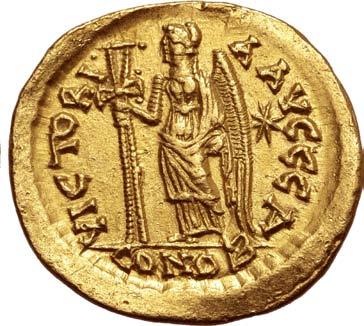
Leo I AV Solidus. Constantinople, AD 462 or 466. D N LEO PERPET AVG, pearl-diademed, helmeted and cuirassed bust facing slightly to right, holding spear and shield decorated with horseman motif / VICTORIA AVGGG A, Victory standing to left, holding long jewelled cross; star in right field, CONOB in exergue. RIC X 605; Depeyrot 93/1. 4.40g, 20mm, 6h.
Extremely Fine; ‘H’ graffito in obv. field.

536.


Leo I AV Solidus. Constantinople, AD 462 or 466. D N LEO PERPET AVG, pearl-diademed, helmeted and cuirassed bust facing slightly to right, holding spear and shield decorated with horseman motif / VICTORIA AVGGG B, Victory standing to left, holding long jewelled cross; star in right field, CONOB in exergue. RIC X 605; Depeyrot 93/1. 4.44g, 20mm, 5h.
Extremely Fine.

537.
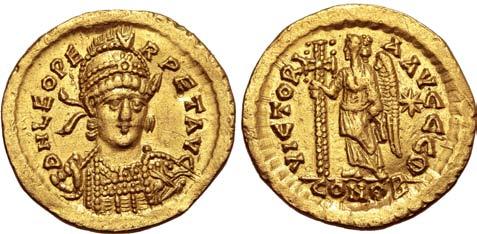
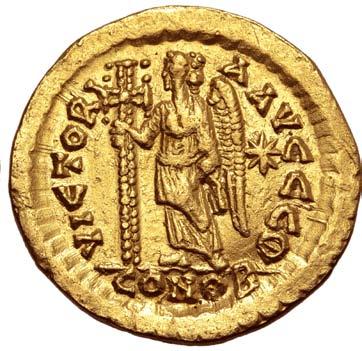
Leo I AV Solidus. Constantinople, AD 462 or 466. D N LEO PERPET AVG, pearl-diademed, helmeted and cuirassed bust facing slightly to right, holding spear and shield decorated with horseman motif / VICTORIA AVGGG B, Victory standing to left, holding long jewelled cross; star in right
Extremely Fine.

538.
Extremely Fine.
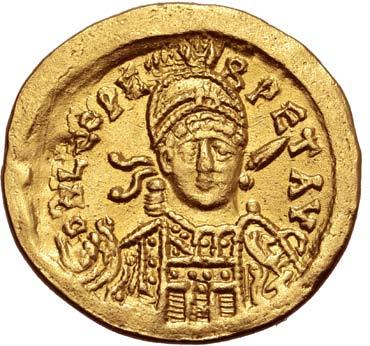
539.
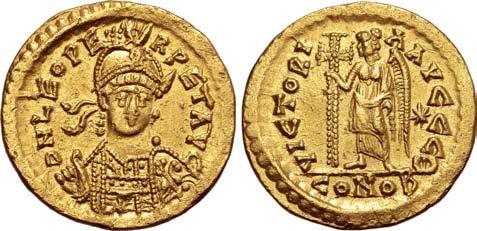
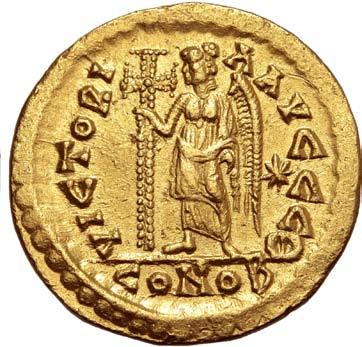
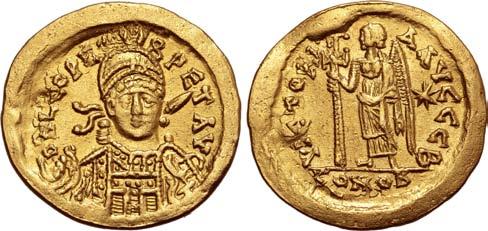

540.


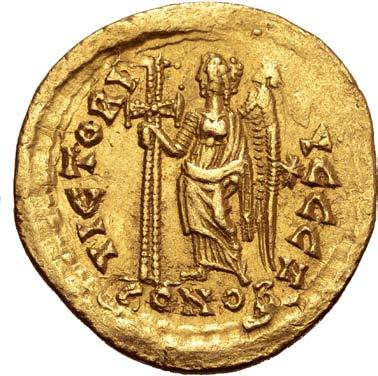
Leo I AV Solidus. Constantinople, AD 462 or 466. D N LEO PERPET AVG, pearl-diademed, helmeted and cuirassed bust facing slightly to right, holding spear and shield decorated with horseman motif / VICTORIA AVGGG Z, Victory standing to left, holding long jewelled cross; star in right field, CONOB in exergue. RIC X 605; Depeyrot 93/1. 4.48g, 21mm, 6h.
Extremely Fine.

541.


Leo I AV Solidus. Constantinople, AD 462 or 466. D N LEO PERPET AVG, pearl-diademed, helmeted and cuirassed bust facing slightly to right, holding spear and shield decorated with horseman motif / VICTORIA AVGGG H, Victory standing to left, holding long jewelled cross; star in right field, CONOB in exergue. RIC X 605; Depeyrot 93/1. 4.49g, 21mm, 6h.
Extremely Fine.

542.


Leo I AV Solidus. Constantinople, AD 462 or 466. D N LEO PERPET AVG, pearl-diademed, helmeted and cuirassed bust facing slightly to right, holding spear and shield decorated with horseman motif / VICTORIA AVGGG Z, Victory standing to left, holding long jewelled cross; star in right field, CONOB in exergue. RIC X 605;
Extremely Fine.

543.
Extremely Fine.
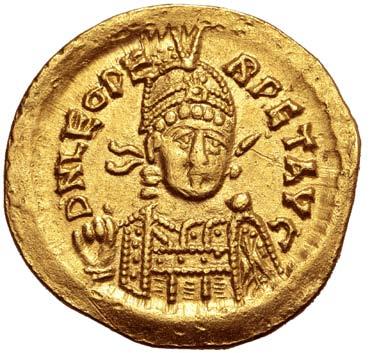
544.
Extremely
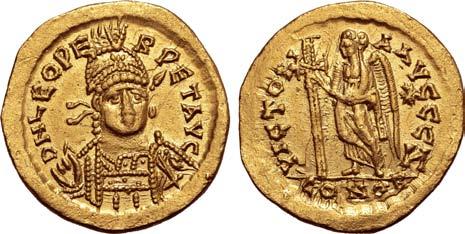
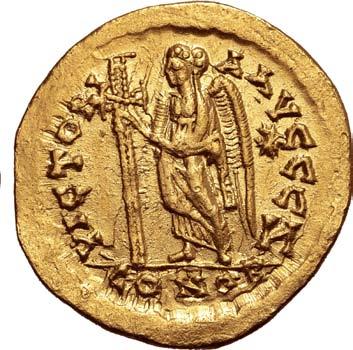
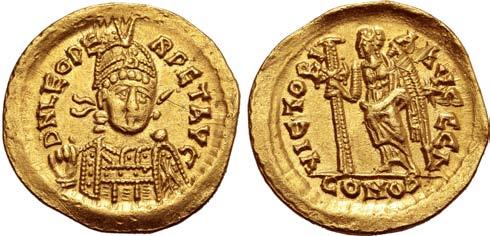

545.
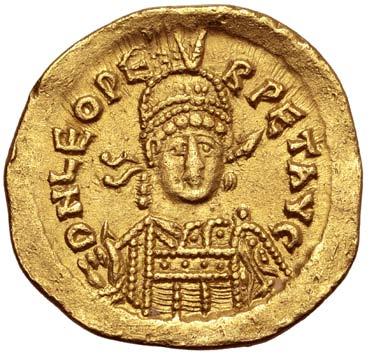
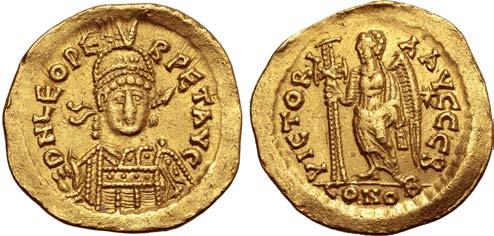

Leo I AV Solidus. Constantinople, AD 462 or 466. D N LEO PERPET AVG, pearl-diademed, helmeted and cuirassed bust facing slightly to right, holding spear and shield decorated with horseman motif / VICTORIA AVGGG B, Victory standing to left, holding long jewelled cross; star in right field, CONOB in exergue. RIC X 605; Depeyrot 93/1. 4.37g, 21mm, 7h.
Near Extremely Fine; flan slightly wavy.

546.
180


Leo I AV Solidus. Constantinople, AD 462 or 466. D N LEO PERPET AVG, pearl-diademed, helmeted and cuirassed bust facing slightly to right, holding spear and shield decorated with horseman motif / VICTORIA AVGGG Γ, Victory standing to left, holding long jewelled cross; star in right field, CONOB in exergue. RIC X 605; Depeyrot 93/1. 4.46g, 21mm, 6h.
Near Extremely Fine.
180

547.
Very Rare

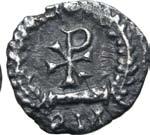
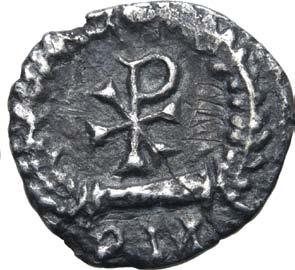
Libius Severus AR Half Siliqua. Rome, AD 461-465. D N LIB SEVERVS P F AVG, rosette-diademed, draped and cuirassed bust to right / Chi-rho within wreath; RM in exergue. RIC X 2712; DOCLR 899 corr. (obv. legend); RSC 16†a. 0.69g, 11mm, 6h.
Good Very Fine; minor flan crack, graffito in rev. field, attractive old cabinet tone. Very Rare.
Acquired from André Cichos, December 2018.
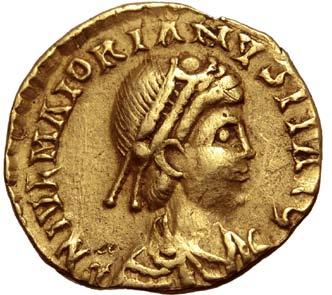
548.
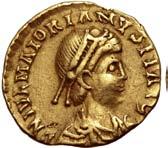


Majorian AV Tremissis. Ravenna, AD 457-461. D N IVL MAIORIANVS P F AVG, pearl-diademed, draped and cuirassed bust to right / Cross within wreath; COMOB below. RIC X 2610; Depeyrot 23/2; DOCLR 886; Lacam pl. 13, 41-3. 1.40g, 13mm, 6h.
Near Extremely Fine. Very Rare.
Ex S & S Collection, Classical Numismatic Group, Triton XXVI, 10 January 2023, lot 894; Ex Classical Numismatic Group, Triton III, 30 November 1999, lot 1276.
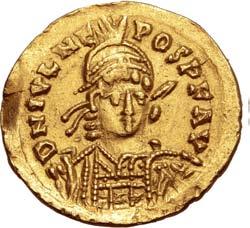

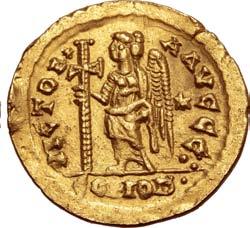

Julius Nepos AV Solidus. Rome, 19 June AD 474 - 28 August AD 475. D N IVL NEPOS P F AVG, helmeted, pearl-diademed and cuirassed bust facing, holding spear and shield decorated with horseman and fallen enemy motif / VICTORIA AVGGG:, Victory standing facing, head to left, holding long jewelled cross; star in right field, COMOB• in exergue. RIC X -; Depeyrot 77/1; DOC -; Lacam -. 4.26g, 20mm, 6h.
Extremely Fine. Extremely Rare; only one example cited by Depeyrot, that held by the Vatican museum, thus seemingly the only example in private hands.
4,500 No Reserve
Ex Roma Numismatics Ltd., Auction XXIII, 24 March 2022, lot 1141 (hammer: GBP 10,000).
While many historians consider Romulus Augustus to have been the last Roman emperor in the West, Julius Nepos’ claim to this dubious honour is no less strong. Elevated to the position of Augustus by the Eastern emperor Leo I in AD 474 in order to replace the usurper Glycerius, who had been raised to the vacant throne by the Burgundian Magister militum Gundobad, Julius Nepos was married to the niece of Leo I and was also the nephew of the sovereign governor of Dalmatia, Marcellinus, hence his agnomen of nepos - “nephew”.
In January, before Nepos could move against Glycerius, Leo I died and was succeeded by his grandson, the young Leo II, who chose his own father Zeno as co-emperor. While little is known of Glycerius, according to Ennodius, the emperor “made many measures for the public good”, and seems to have tried his best to remain on good terms with the East Roman Empire, making overtures for reconciliation and abstaining from choosing a second Consul in order to allow Leo II to be sole Consul for the year 474. Nonetheless, under Roman Law Glycerius’ elevation was illegal, as the Eastern emperor had the right to choose his co-emperor, and Zeno maintained the official position of Constantinople to deny recognition to Glycerius. Therefore, in the spring of 474, when the ports which had been closed for the winter reopened, Nepos made to cross the Adriatic Sea to depose Glycerius, who may have temporarily left the imperial court at Ravenna and relocated to Rome to resist the invasion, where he minted an extremely rare silver issue claiming himself as Augustus along with Leo II and Zeno. However, by June Nepos had entered Ravenna and deposed Glycerius without bloodshed, perhaps because he had failed to receive the support of the Roman Senate and Gallo-Roman aristocracy, or because his Magister militum Gundobad was absent from Italy either to raise more troops in Gaul, or to receive the legacy of his father Gundioc as King of the Burgundians. In any case, Nepos spared Glycerius’ life, an act of clemency possibly prompted by Glycerius’ apparently benevolent rule and the respect he had shown to the Eastern emperors throughout his short reign, and he was sent to lead a life of religious service as Bishop of Salona.
Nepos’ own reign was hardly longer than that that of his predecessor; in August of 475 his Magister militum Orestes took control of the government at Ravenna, forcing Nepos to flee by ship back to Dalmatia. Orestes then proceeded to enthrone his teenage son as the new emperor in the West, under the regnal name Romulus Augustus. Though deposed, Nepos continued to be recognised as the de jure Emperor of the West until his death in 480, whereupon Zeno formally abolished the division of the Empire, ending the last legal claim to the throne of the West Roman Empire.
550.
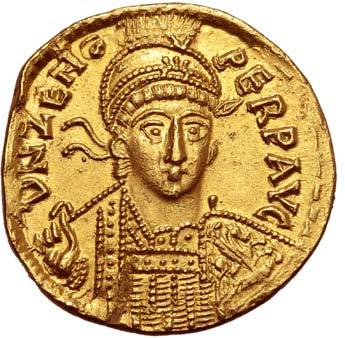


Zeno AV Solidus. Constantinople, AD 476-491. D N ZENO PERP AVG, pearl-diademed, helmeted and cuirassed bust facing slightly to right, holding spear and shield decorated with horseman motif / VICTORIA AVGGG I, Victory standing facing, head to left, holding long jewelled cross; star in right field, CONOB in exergue. RIC X 910 and 929; Depeyrot 108/1. 4.39g, 20mm, 6h.
Good Extremely Fine.
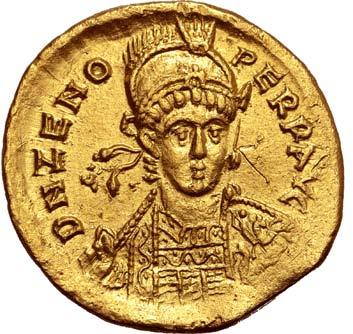
551.


Zeno AV Solidus. Constantinople, AD 476-491. D N ZENO PERP AVG, pearl-diademed, helmeted and cuirassed bust facing, holding spear and shield decorated with horseman motif / VICTORIA AVGGG Z, Victory standing facing, head to left, holding long jewelled cross; star in right field, CONOB in exergue. RIC X 910 and 929; Depeyrot 108/1. 4.46g, 20mm, 6h.
Extremely Fine; ‘K’ graffito in obv. field.

552.


Zeno AV Solidus. Constantinople, AD 476-491. D N ZENO PERP AVG, pearl-diademed, helmeted and cuirassed bust facing, holding spear and shield decorated with horseman motif / VICTORIA AVGGG A, Victory standing facing, head to left, holding long jewelled cross; star in right field, CONOR in exergue. RIC X 910 and 929; Depeyrot 108/1. 4.42g, 20mm, 6h.
Extremely Fine; ‘K’ graffito in obv. field.
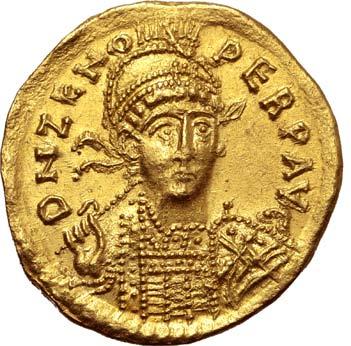

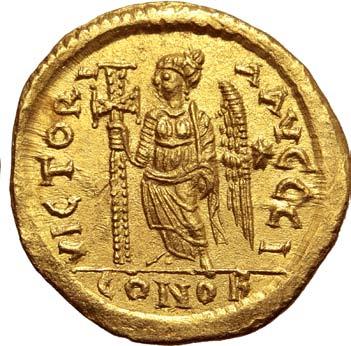
Zeno AV Solidus. Constantinople, AD 476-491. D N ZENO PERP AVG, pearl-diademed, helmeted and cuirassed bust facing slightly to right, holding spear and shield decorated with horseman motif / VICTORIA AVGGG I,
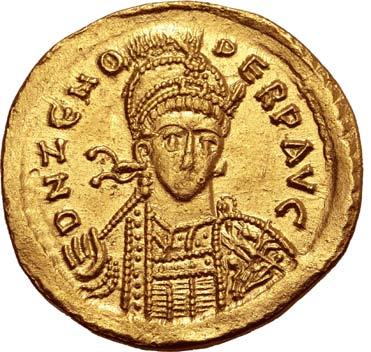
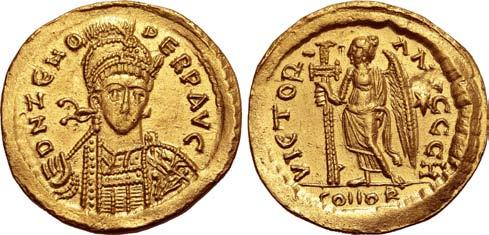
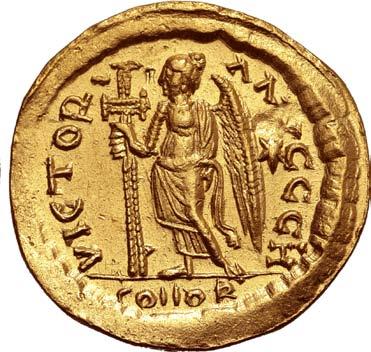
555.



Zeno AV Solidus. Constantinople, AD 476-491. D N ZENO PERP AVG, pearl-diademed, helmeted and cuirassed bust facing slightly to right, holding spear and shield decorated with horseman motif / VICTORIA AVGGG Γ, Victory standing facing, head to left, holding long jewelled cross; star in right field, CONOB in exergue. RIC X 910 and 929; Depeyrot 108/1. 4.47g, 20mm, 6h.
Extremely Fine.

556.

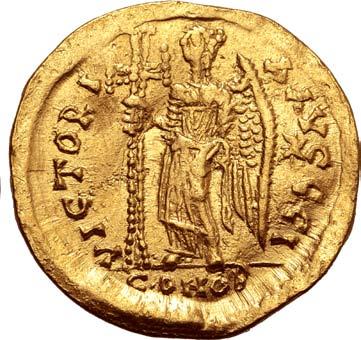
Zeno AV Solidus. Constantinople, AD 476-491. D N ZENO PERP AVG, pearl-diademed, helmeted and cuirassed bust facing slightly to right, holding spear and shield decorated with horseman motif / VICTORIA AVGGG I, Victory standing facing, head to left, holding long jewelled cross; star in right field, CONOB in exergue. RIC X 910 and 929; Depeyrot 108/1. 4.37g, 20mm, 6h.
Extremely Fine; cross graffito in obv. field, flan slightly wavy.

557.
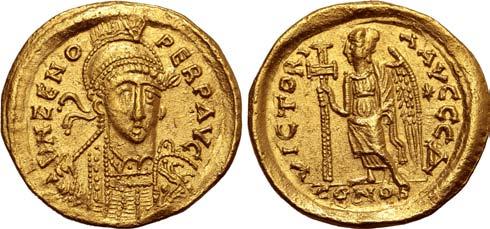

Zeno AV Solidus. Constantinople, AD 476-491. D N ZENO PERP AVG, pearl-diademed, helmeted and cuirassed bust facing, holding spear and shield decorated with horseman motif / VICTORIA AVGGG Δ, Victory standing facing, head to left, holding long jewelled cross; star in right field, CONOB in exergue. RIC X 911 and 930; Depeyrot 108/1. 4.45g, 20mm, 6h.
Extremely Fine.


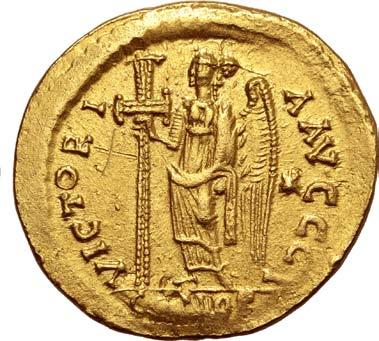
Zeno AV Solidus. Constantinople, AD 476-491. D N ZENO PERP AVG, pearl-diademed, helmeted and cuirassed bust facing, holding spear and shield decorated with horseman motif / VICTORIA AVGGG I, Victory standing facing, head to left, holding long jewelled
Good
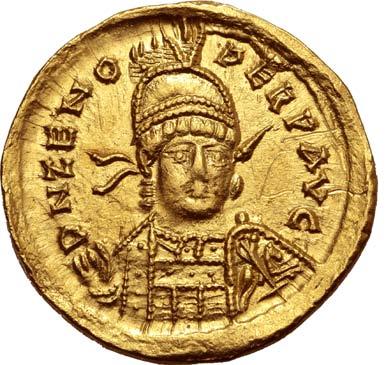


Good
560.

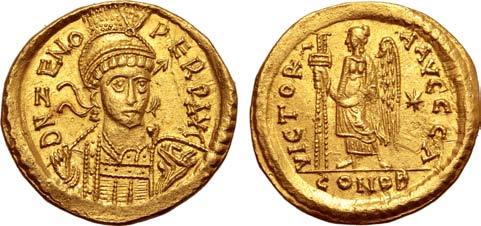

Zeno AV Solidus. Constantinople, AD 476-491. D N ZENO PERP AVG, pearl-diademed, helmeted and cuirassed bust facing, holding spear and shield decorated with horseman motif / VICTORIA AVGGG A, Victory standing facing, head to left, holding long jewelled cross; star in right field, CONOB in exergue. RIC X 911 and 930; Depeyrot 108/1. 4.43g, 20mm, 7h.
Extremely Fine.
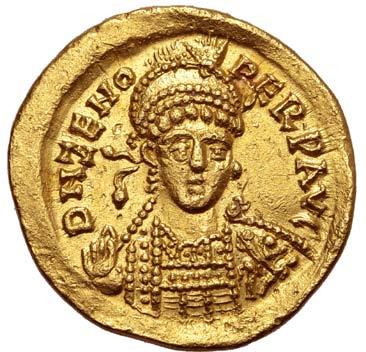
561.


Zeno AV Solidus. Constantinople, AD 476-491. D N ZENO PERP AVG, pearl-diademed, helmeted and cuirassed bust facing, holding spear and shield decorated with horseman motif / VICTORIA AVGGG Δ, Victory standing facing, head to left, holding long jewelled cross; star in right field, CONOB in exergue. RIC X 911 and 930; Depeyrot 108/1. 4.45g, 20mm, 5h.
Extremely Fine.

562.
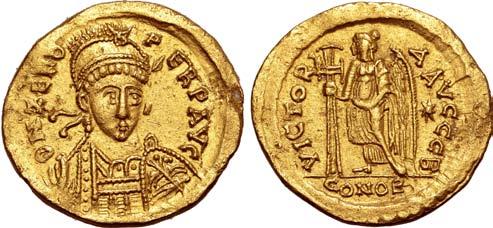

Zeno AV Solidus. Constantinople, AD 476-491. D N ZENO PERP AVG, pearl-diademed, helmeted and cuirassed bust facing, holding spear and shield decorated with horseman motif / VICTORIA AVGGG B, Victory standing facing, head to left, holding long jewelled cross; star in right field, CONOB in exergue. RIC
Good Extremely Fine.

563.
Near Extremely Fine.
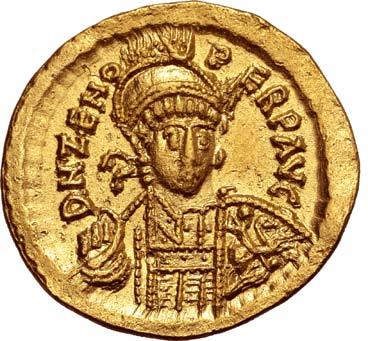


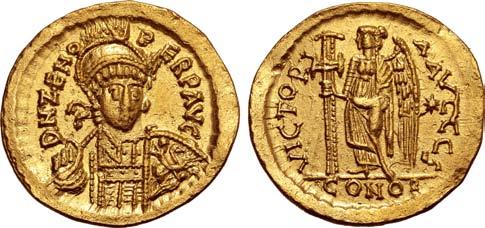

565.

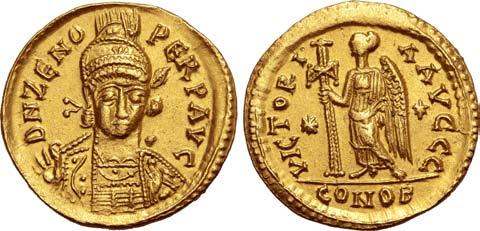

Zeno AV Solidus. Thessalonica, AD 476-491. D N ZENO PERP AVG, pearl-diademed, helmeted and cuirassed bust facing, holding spear and shield decorated with horseman motif / VICTORIA AVGGG, Victory standing facing, head to left, holding long jewelled cross; star in left and right fields, CONOB in exergue. RIC X 939; Depeyrot 62/1; DOC 666-8; MIRB 19. 4.45g, 20mm, 6h.
Extremely Fine; well-centred and highly lustrous. Very Rare.
Ex Roma Numismatics Ltd., Auction XXVII, 22 March 2023, lot 809.

566.
300

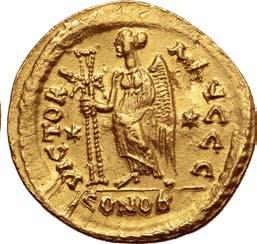

Zeno AV Solidus. Thessalonica, AD 476-491. D N ZENO PERP AVG, pearl-diademed, helmeted and cuirassed bust facing, holding spear and shield decorated with horseman motif / VICTORIA AVGGG, Victory standing facing, head to left, holding long jewelled cross; star in left and right fields, CONOB in exergue. RIC X 941; Depeyrot 62/1; MIRB 19; DOCLR 666-8. 4.42g, 21mm, 6h.
Good Extremely Fine.

567.
450
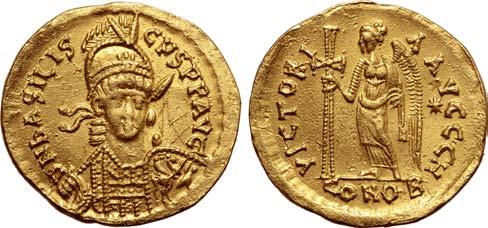
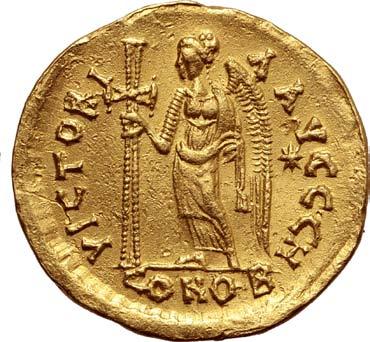
Basiliscus AV Solidus. Constantinople, 9 January - August AD 475. D N bASILISCЧS P P AVG, pearl-diademed, helmeted and cuirassed bust facing slightly to right, holding spear and shield decorated with horseman motif / VICTORIA AVGGG H, Victory standing facing, head to left, holding long jewelled cross; star in right field, CONOB in exergue. RIC X 1003; Depeyrot 101/1;
Extremely Fine; graffiti in obv. field. Rare.

568.
450


Basiliscus Æ 9mm. Uncertain mint (Constantinople or Cyzicus), AD January 475- August 476. D N b[...], pearl-diademed, draped and cuirassed bust to right / Monogram within wreath; [mintmark] in exergue. Cf. RIC X 1014 (Constantinople) and 1016 (Cyzicus); A Morello, Piccoli bronzi con monogramma: tra tarda antichità e primo Medioevo (V-VI secolo d. C.), 9/1-2. 1.01g.
NGC graded Ch XF 4/5 - 4/5 (#6062219-002).
Ex Rockport Collection, Heritage World Coin Auctions, Showcase Auction 61241, 19 December 2021, lot 97317; Previously privately purchased from Heritage Auctions in the 1980s.
300

569.


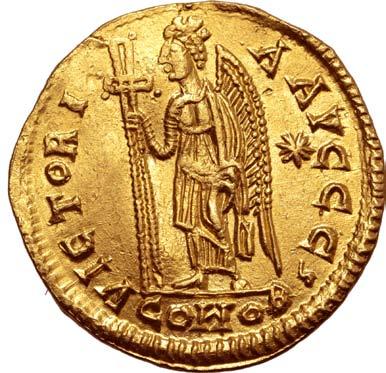
Pseudo-Imperial, uncertain AV Solidus. In the name of Zeno. Uncertain mint, AD 476-489. D И ZENO PERP AVG, pearl-diademed, helmeted and cuirassed bust facing slightly to right, holding spear and shield decorated with horseman motif / VICTORIA AVGGG S, Victory standing facing, head to left, holding long jewelled cross; star in right field, COMOB in exergue. For prototype, cf. RIC X 910 and 929, Depeyrot 108/1; for similar, cf. Roma XXIX, 590, Roma E-112, 1358, Roma XXVII, 816 and Roma XXV, 1130. 4.23g, 21mm, 5h.
Extremely Fine. Extremely Rare.
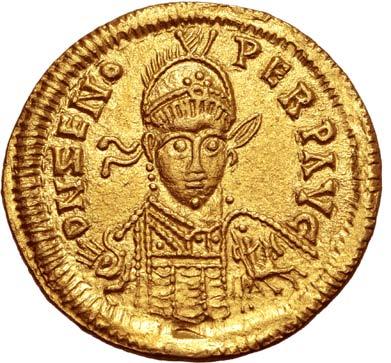
570.
900 No Reserve


Pseudo-Imperial, uncertain AV Solidus. In the name of Zeno. Uncertain mint, AD 476-489. D N ZENO PERP AVG (Z retrograde), pearl-diademed, helmeted and cuirassed bust facing slightly to right, holding spear and shield decorated with horseman motif / VICTORIA AVGGG S, Victory standing facing, head to left, holding long jewelled cross; star in right field, CONOB in exergue. For prototype, cf. RIC X 910 and 929, Depeyrot 108/1; for similar, cf. Roma XXIX, 591 and XXVIII, 698. 4.28g, 21mm, 6h.
Good Extremely Fine. Extremely Rare.
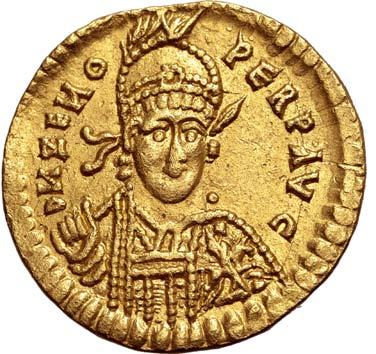
571.
900 No


Pseudo-Imperial, uncertain AV Solidus. In the name of Zeno. Uncertain mint, AD 476-489. D И ZEИO PERP AVG, pearl-diademed, helmeted and cuirassed bust facing slightly to right, holding spear and shield decorated with horseman motif / VICTORIA AVGGG I, Victory standing facing, head to left, holding long jewelled cross; star in right field, COMOB in exergue. For prototype, cf. RIC X 910 and 929, Depeyrot 108/1; for similar, cf. Roma XXVIII, 696 (hammer: 3,400 GBP) and Roma XXIII, 1153. 4.34g, 21mm, 6h.
Near Extremely Fine.
450
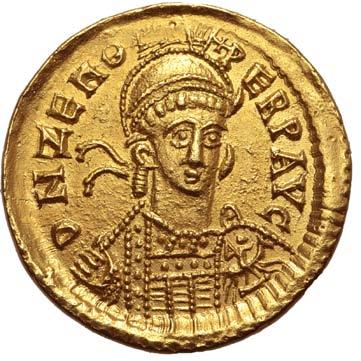
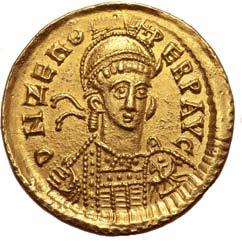

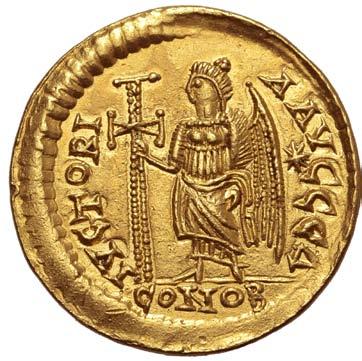
572.
Pseudo-Imperial, uncertain AV Solidus. In the name of Zeno. Uncertain mint, AD 476-489. D N ZENO PERP AVG, pearl-diademed, helmeted and cuirassed bust facing slightly to right, holding spear and shield decorated with horseman motif / IVCTORIA AVGGG Δ, Victory standing facing, head to left, holding long jewelled cross; star in right field, CONOB in exergue. For prototype, cf. RIC X 911 and 930, Depeyrot 108/1; Roma XXVII, 815 (same dies). 4.35g, 20mm, 6h.
Near Mint State; highly lustrous. Extremely Rare.
1,200
574.

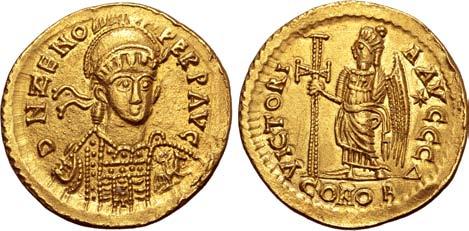
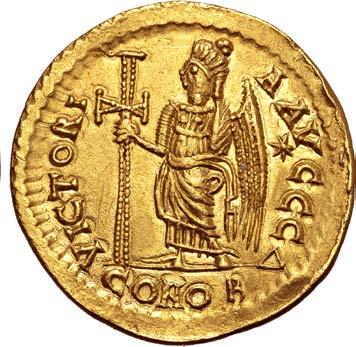
575.
576.
Pseudo-Imperial, uncertain AV Solidus. In the name of Zeno. Uncertain mint, AD 476-489. D N ZENO PERP AVG, pearl-diademed, helmeted and cuirassed bust facing slightly to right, holding spear and shield decorated with horseman motif / VICTORIA AVGGG Δ, Victory standing facing, head to left, holding long jewelled cross; star in right field, CONOB in exergue. For prototype, cf. RIC X 911 and 930, Depeyrot 108/1; for similar, cf. Roma XXVII, 815 (hammer: 3,000 GBP) and Roma XXVIII, 695. 4.34g, 20mm, 6h.
Good Extremely Fine. Extremely Rare.


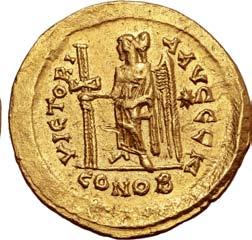
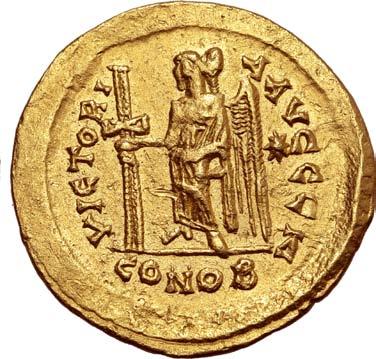
Pseudo-Imperial, Odovacar (Odoacer) AV Solidus. In the name of Zeno. Ravenna, AD 476-489. D N ZENO PERP F AVG, pearl-diademed, helmeted and cuirassed bust facing slightly to right, holding spear and shield decorated with horseman motif / VICTORIA AVGGG N, Victory standing facing, head to left, holding long jewelled cross; star in right field, CONOB in exergue. RIC X 3632; Depeyrot 43/1; DOCLR -; Lacam pl. 52, 39-44. 4.39g, 20mm, 6h.
Extremely Fine; ‘X’ graffito in obv. field. Extremely Rare.

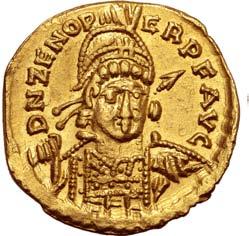


Pseudo-Imperial, Odovacar (Odoacer) AV Solidus. In the name of Zeno. Rome, AD 476-489. D N ZENO PERP F AVG, pearl-diademed, helmeted and cuirassed bust facing slightly to right, holding spear and shield decorated with horseman motif / VICTORIA AVGGG :, Victory standing facing, head to left, holding long jewelled cross; star in right field, COMOB in exergue. RIC X 3651; cf. Depeyrot 78/2 (Nepos); Lacam pl. 50, 1 (same obv. die); Roma XXVIII, 689 (same obv. die). 4.31g, 21mm, 7h.
Extremely Fine. Very Rare.


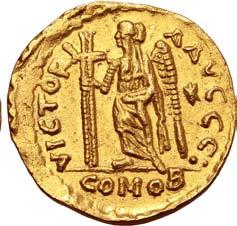

750
Pseudo-Imperial, Odovacar (Odoacer) AV Solidus. In the name of Zeno. Rome, AD 476-489. D N ZENO PERP F AVG, pearl-diademed, helmeted and cuirassed bust facing slightly to right, holding spear and shield decorated with horseman motif / VICTORIA AVGGG :, Victory standing facing, head to left, holding long jewelled cross; star in right field, COMOB in exergue. RIC X 3651; cf. Depeyrot 78/2 (Nepos); Lacam pl. 50, 3 (same rev. die). 4.36g, 19mm, 6h.
573. 900
Extremely Fine. Very Rare.



Pseudo-Imperial, Odovacar (Odoacer) AV Solidus. In the name of Zeno. Rome, AD 476-489. D N ZENO PERP F AVG, helmeted, pearl-diademed and cuirassed bust facing, holding spear and shield decorated with horseman motif / VICTORIA AVGGG Γ, Victory standing facing, head to left, holding long jewelled cross; star in right field, COMOB in exergue. RIC X 3654; Ladich -; MEC 1 -; BMC Vandals -; DOC -; Lacam p. 936, Class 1, Type 1 (same rev. die), Type 2 (same obv. die); Roma XXVIII, 813 (hammer: 3,400 GBP). 4.25g, 20mm, 6h.
Extremely Fine; ‘C’ graffito on obv., ‘+’ graffito in left and right rev. fields. Extremely Rare; rated R4 in RIC.
Ex Campostella Collection;
Acquired from A. H. Baldwin & Sons Ltd, 20 March 2007.

578.
750
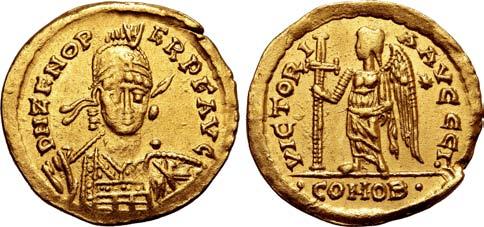
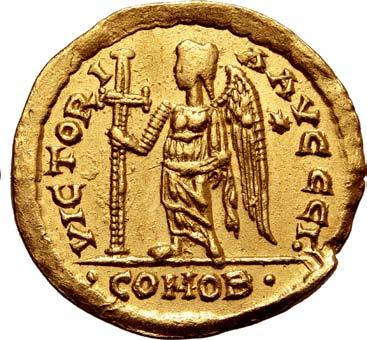
Pseudo-Imperial, Odovacar (Odoacer) AV Solidus. In the name of Zeno. Rome, AD 476-489. D N ZENO PERP F AVG, pearl-diademed, helmeted and cuirassed bust facing slightly to right, holding spear and shield decorated with horseman motif / VICTORIA AVGGG Γ•, Victory standing facing, head to left, holding long jewelled cross; star in right field, •COMOB• in exergue. RIC X 3655; Ladich p. 11; MEC 1, -; BMC Vandals -; DOC -; Lacam pls. 50-1, 10-24. 4.44g, 20mm, 6h.
Extremely Fine. Very Rare.

579.
750
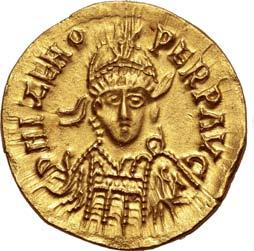


Visigoths, Uncertain King AV Solidus. In the name of Zeno. Arelate(?), AD 480-491. D N I ZENO PERP AVG, pearl-diademed, helmeted and cuirassed bust facing, holding spear and shield decorated with horseman and fallen enemy motif / VICTORIA AVGGG Z, Victory standing facing, head to left, holding long jewelled cross; star in right field, CONOB in exergue. DOCLR 690 (Arles?) = Lacam pl. 44, 136 (Visigoths, same dies); Roma XXIII, 1157 (same dies), Roma XXVII, 818 (same dies); Roma E-112, 1363 (same dies); Roma XXIX, 610 (same dies). 4.43g, 21mm, 6h.
Good Extremely Fine; highly lustrous. Extremely Rare.
This example is struck from the same dies as the DOC specimen which is tentatively attributed to Arelate (Arles) by Grierson and Mays on the basis of style. As Arles was annexed by the Visigothic kingdom after Zeno’s accession it has been argued that coins were likely to have been struck there in his name (DOC, p. 189) although this was disputed by Kent in RIC X.

580.
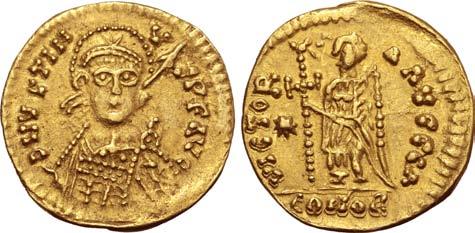

Pseudo-imperial, Merovingians AV Solidus. In the name of Justin I, circa AD 518-527. ƆI IVSTINVS P F AVC (sic), pearl-diademed, helmeted and cuirassed bust facing, holding spear and shield decorated with horseman motif / VICTORA AVCCCΛ, Victory standing to left, holding long cross, star in left field; CONOB in exergue. Belfort 5152 var. (I instead of N in obv. legend, P of christogram not present); MEC I -; Subjak Collection -; cf. CNG 72, 2272. 3.89g, 20mm, 6h.
Extremely Fine. Extremely Rare.
From Roma Numismatics Ltd., Auction XXV, 22 September 2022, lot 1143; Ex Argenor Numismatique, 17 April 2008, lot 72.
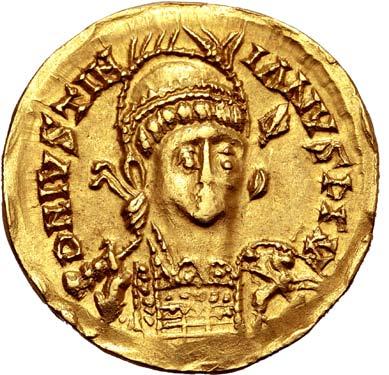



581.
Pseudo-imperial, uncertain (Ostrogoths?) AV Solidus. In the name of Justinian. Uncertain mint, temp. Athalaric - Witigis, AD 527- 536. D N IVSTINIANVS PΓ A V(struck over A below), pearl-diademed, helmeted and cuirassed bust facing slightly to right, holding spear and shield decorated with horseman motif / VICTORIA AVCCC •(?), Victory standing facing, head to left, holding long voided cross; star in left field, COWOB (sic) in exergue. Cf. Ladich 4 (Athalaric, Rome), 8 (Athalaric, Ravenna), 3 (Theodahad, Rome), 1 (Witigis, Ravenna); cf. COI 34 (Athalaric, Rome), 36b (Athalaric, Theodahad & Witigis, Ravenna); 38 (Baduila, Ticinum). 4.32g, 22mm, 6h.
Near Extremely Fine. Apparently unpublished - a variant with possible pellet at the end of the legend or unformed letter.
Ex Roma Numismatics Ltd., Auction XXV, 22 September 2022, lot 1136; Previously acquired from Numismatik Lanz München, May 1999.



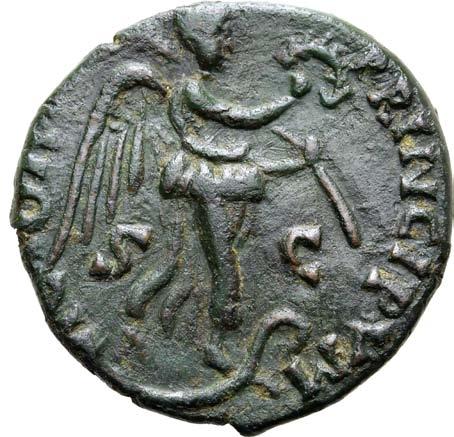
582.
Ostrogoths, Theodahad Æ 40 Nummi. Rome, circa AD 535. D N THEODΛHΛTVS REX, helmeted bust to right, wearing imperial mantle / VICTORIA PRINCIPVM, Victory standing to right on prow, holding wreath and palm; S-C across fields. A. Arslan and M. Metlich, ‘A die study of the Theodahad Folles’, in The Coinage of Ostrogothic Italy, p. 130, 1c, B1-L5 (this coin); Metlich 89b; MEC 141; MIB 81; BMC Vandals 19-24; Ladich 16-25. 9.44g. 25mm 6h.
Near Extremely Fine; superb green patina. An outstanding example of this very rare and fascinating issue.
This coin published in A. Arslan and M. Metlich, ‘A die study of the Theodahad Folles’, in The Coinage of Ostrogothic Italy (London, 2004); Ex Artemide Aste s.r.l. (San Marino), Auction LVIII, 5-6 November 2022, lot 568; Ex Apostolo Zeno (1668-1750) Collection = Dorotheum-Kunstabtailung, Sonder-Münzauktion, Sammlung Apostolo Zeno, 6 June 1956, lot 2591. This coin combines a ostensibly Ostrogothic portrait with a Flavian aged reverse type. As Grierson, p. 11, says ‘these folles are the most impressive coins issued by any Germanic ruler of the fifth or sixth centuries.’

583.


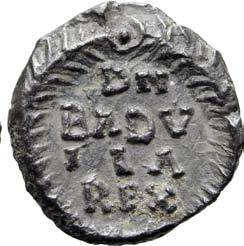
Ostrogoths, Baduila (Totila) AR Half Siliqua. In the name of Anastasius I. Ticinum, AD 541-552. D N [ΛNΛSTΛSIV]S P ΛVC, diademed bust to right, wearing ‘Ostrogothic’ garment / D N BΛDVILΛ REX in four lines within wreath. Metlich 70a; MEC 155;
Near Extremely Fine. Rare.
Ex Roma Numismatics Ltd., E-Sale 89, 28 October 2021, lot 1482.
COINS OF THE BYZANTINE EMPIRE
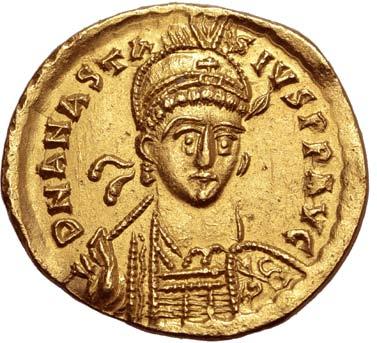
584.

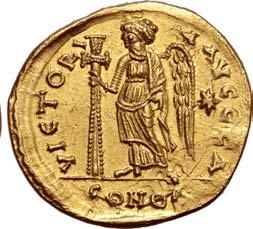

Anastasius I AV Solidus. Constantinople, AD 491-498. D N ANASTASIVS P P AVG, pearl-diademed, helmeted and cuirassed bust facing slightly to right, cross on helmet, holding spear and shield with horseman motif / VICTORIA AVGGG Δ, Victory standing facing, head to left, holding long jewelled cross; star in right field, CONOB in exergue. MIBE 4a; DOC 4-; Sear 3. 4.41g, 20mm, 6h.
Good Extremely Fine. Scarce type with the emperor’s helmet decorated with a cross rather than a trefoil ornament.
Ex Roma Numismatics Ltd., Auction XXVII, 22 March 2023, lot 824.




300 No Reserve
585. 586. 2x
Anastasius I AV Solidus. Constantinople, AD 498-518. D N ANASTASIVS P P AVG, pearl-diademed, helmeted and cuirassed bust facing slightly to right, holding spear and shield decorated with horseman motif / VICTORIA AVGGG S, Victory standing facing, head to left, holding long staff surmounted by staurogram; star in left field, CONOB in exergue. MIBE 7; DOC 7f; Sear 5. 4.47g, 21mm, 6h.
Good Extremely Fine; ex mount.
Ex Roma Numismatics Ltd., Auction XIV, 21 September 2017, lot 857.

2x
Justinian I AR Heavy 1/8
Extremely Fine. Rare.
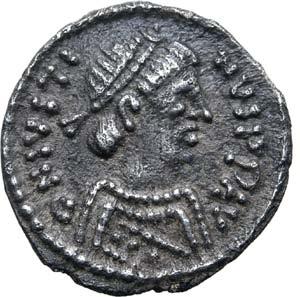

D N
180 No Reserve
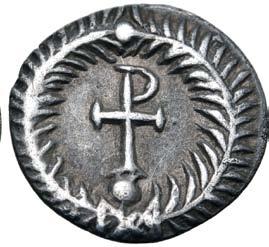
2x 240 No Reserve
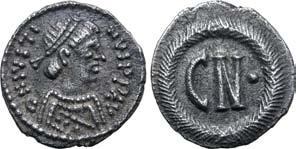
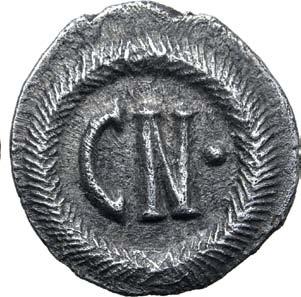
IVSTINVS P P AV, diademed bust to right, wearing ornamental robe / Large CN• within wreath. BCI 161 (heavy ¼ siliqua); MIBE 37; DOC 312 (Ravenna); Sear 411 (Ravenna). 0.62g, 12mm, 6h.
Ex Artemide Aste s.r.l. (San Marino), LVII, 30 April 2022, lot 612.
588.


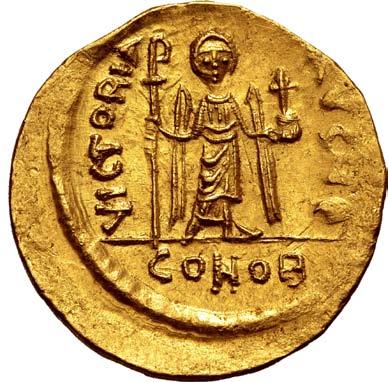
Phocas AV Solidus. Constantinople, AD 607-610. [∂] N FOCAS PЄRP AVI, draped and cuirassed bust facing, wearing crown without pendilia and holding globus cruciger / VICTORIA AVςЧ Є(?), angel standing facing, holding staff surmounted by staurogram and globus cruciger; CONOB in exergue. MIBE 11; DOC 10e; Sear 620. 4.49g, 21mm, 6h.
Mint State.
Ex Morton & Eden, Auction 119, 6 December 2022, lot 97; Ex European Ambassador Collection, formed in the 1950s and 1960s.
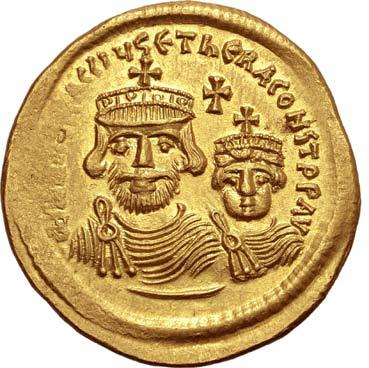
589.
300


Heraclius, with Heraclius Constantine, AV Solidus. Constantinople, circa AD 613-616. [∂∂ NN ҺЄRA]CLIVS ЄƮ ҺЄRA CONSƮ P P AV, facing busts of Heraclius and Heraclius Constantine, each wearing chlamys and elaborate crown with cross; cross between / VICTORIA AVςЧ I, cross potent on three steps; CONOB in exergue. MIB 8a; DOC 8j; Sear 734. 4.48g, 21mm, 7h.
Mint State; some flatness to edge.
Ex Roma Numismatics Ltd., E-Sale 106, 16 February 2023, lot 1432; Acquired from Paul-Francis Jacquier.

590.
300

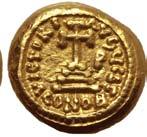

Constans II AV Solidus. Carthage, dated RY 3 = AD 644/5. D CONSTAN AVP, crowned and draped beardless bust facing, holding globus cruciger / VICTORI AVGVI Δ Γ, cross potent on three steps; P in right field, CONOB in exergue. MIB 57; DOC 108; Sear 1030. 4.40g, 11mm, 6h.
Extremely Fine. Very Rare.
Ex Bertolami Fine Arts, E-Auction 105, 21 October 2021, lot 2802.

591.



Constans II AV Solidus. Carthage, dated RY 3 = AD 644/5. D N CONTATINS PP, crowned and draped beardless bust facing, holding globus cruciger / VICTORIA VI Δ Γ, cross potent on three steps; Θ in right field, CONOB in exergue. MIB 59; DOC 111; Sear 1030. 4.42g, 11mm, 6h.
Extremely Fine. Very Rare.
Ex Artemide Aste s.r.l. (San Marino), LII, 26-27 October 2019, lot 453.
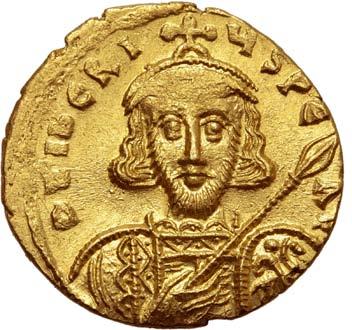



592.
Tiberius III Apsimar AV Solidus. Constantinople, AD 698-705. D ƮIЬЄRIЧS PЄ AV, crowned and cuirassed bust facing, with short beard, holding spear and shield decorated with horseman motif / VICTORIA AVςЧ I, cross potent on three steps; CONOB in exergue. MIB 1; DOC 1i; Sear 1360. 4.43g, 19mm, 6h.
Mint State; some flat strike, lustrous surfaces.
Ex Roma Numismatics Ltd., E-Sale 102, 3 November 2022, lot 1426.




Philippicus (Bardanes) AV Solidus. Constantinople, AD 711-713. ∂ N FILЄPICЧS MЧLTЧS AN, bust facing, with short beard, wearing loros and crown, holding globus cruciger and eagle-tipped sceptre surmounted by cross / VICTORIA AVςЧ S, cross potent on three steps; CONOB in exergue. MIB 1; DOC 1f; Sear 1447. 4.28g, 20mm, 6h.
Good Extremely Fine; highly lustrous, untouched surfaces.
Ex Roma Numismatics Ltd., E-Sale 102, 3 November 2022, lot 1432.
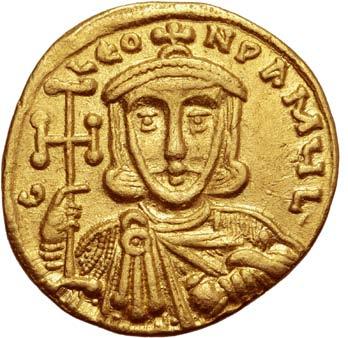


240
600
Constantine V Copronymus, with Leo III, AV Solidus. Constantinople, AD 742-745. C LЄON P A MЧL-, crowned and draped bust of Leo facing, holding cross potent and akakia / C N CONSƮANƮINЧS, crowned and draped bust of Constantine facing, holding cross potent and akakia. Füeg 2.B.3; DOC 1c; Sear 1550. 4.43g, 20mm, 6h. Extremely
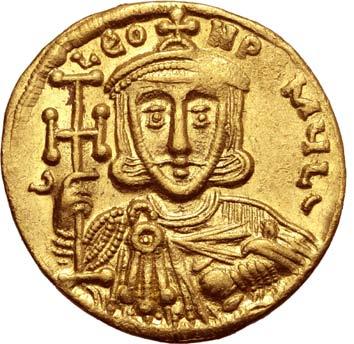
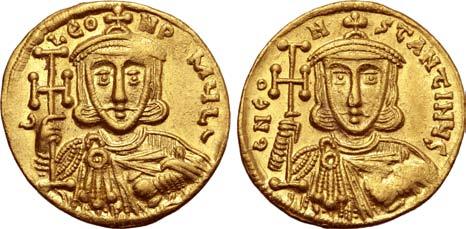

300
Constantine V Copronymus, with Leo III, AV Solidus. Constantinople, AD 742-745. C LЄON P A MЧL ‘, crowned and draped bust of Leo facing, holding cross potent and akakia / C N CONSƮANƮINЧS, crowned and draped bust of Constantine facing, holding cross potent and akakia. Füeg 2.B.4; DOC 1; Sear 1550. 4.45g, 20mm, 6h.
Good Extremely Fine.
300
596.

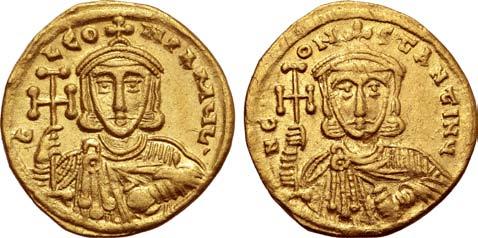
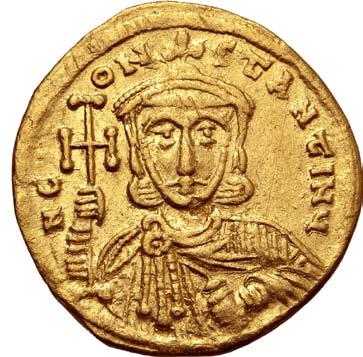
Constantine V Copronymus, with Leo III, AV Solidus. Constantinople, AD 742-745. C LЄON P A MЧL ‘, crowned and draped bust of Leo facing, holding cross potent and akakia / N CONSƮANƮINЧ, crowned and draped bust of Constantine facing, holding cross potent and akakia. Füeg 2.B.11; DOC 1; Sear 1550. 4.38g, 21mm, 6h.
Extremely Fine.
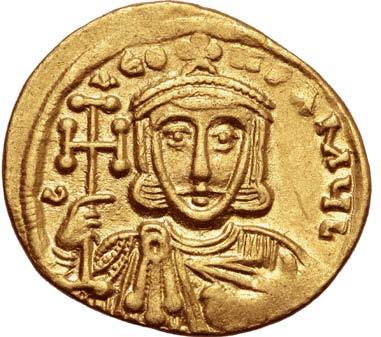
597.

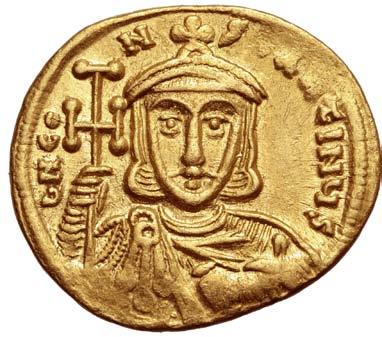
Constantine V Copronymus, with Leo III, AV Solidus. Constantinople, AD 742-745. C LЄON P A MЧL, crowned and draped bust of Leo facing, holding cross potent and akakia / C N CONSƮANƮINЧS, crowned and draped bust of Constantine facing, holding cross potent and akakia. Füeg 2.C.2; DOC 1; Sear 1550. 4.47g, 21mm, 6h.
Extremely Fine; area of flatness.
300
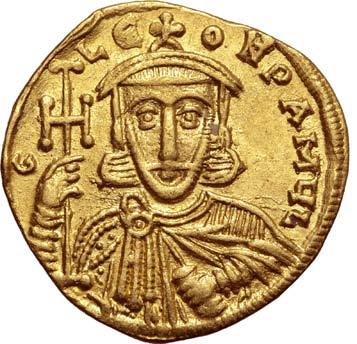



598.
Constantine V Copronymus, with Leo III, AV Solidus. Constantinople, AD 745-750. C LЄON P A MЧL, crowned and draped bust of Leo facing, holding cross potent and akakia / N CONSƮANƮINЧS, crowned and draped bust of Constantine facing, holding cross potent and akakia. Füeg 3.D.3; DOC 1g.4; Sear 1550. 4.38g, 20mm, 5h.
Good Extremely Fine.
450

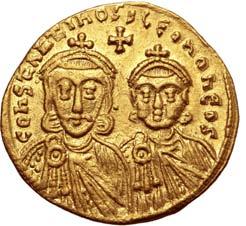


599.
Constantine V Copronymus, with Leo IV and Leo III, AV Solidus. Constantinople, AD 750-756. COҺSƮAҺƮIҺOS S LЄOҺ O ҺЄOS, crowned facing busts of Constantine V and Leo IV, each wearing chlamys; cross above, pellet between / C LЄON P A MЧΘ, crowned facing bust of Leo III wearing loros, holding cross potent. Füeg 4.A.1; DOC 2c.4; Sear 1551. 4.44g, 20mm, 6h.
Near Mint State.
300
600.



Constantine V Copronymus, with Leo IV and Leo III, AV Solidus. Constantinople, AD 750-756. COҺSƮAҺƮIҺOS S LЄOҺ O ҺЄOS, crowned facing busts of Constantine V and Leo IV, each wearing chlamys; cross above, pellet between / C LЄON P A MЧΘ, crowned facing bust of Leo III wearing loros, holding cross potent. Füeg 4.A.1; DOC 2c.4; Sear 1551. 4.47g, 20mm, 6h.
Near Mint State.



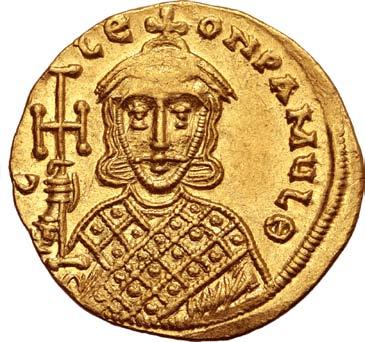
601.
Constantine V Copronymus, with Leo IV and Leo III, AV Solidus. Constantinople, AD 756-764. COҺSƮAҺƮIҺOS S LЄOҺ O ҺЄOS, crowned facing busts of Constantine V and Leo IV, each wearing chlamys; cross above / C LЄON P A MЧL Θ, crowned facing bust of Leo III wearing loros, holding cross potent in right hand. Füeg 5.A.1; DOC 2c; Sear 1551. 4.52g, 20mm, 6h.
Near Mint State; area of flatness.

602.
450


Constantine V Copronymus, with Leo IV and Leo III, AV Solidus. Constantinople, AD 773-775. COҺSƮAҺƮIҺOS S LЄOҺ O ҺЄOS, crowned facing busts of Constantine V and Leo IV, each wearing chlamys; cross above, pellet between / C LЄON P A MЧL, crowned facing bust of Leo III wearing loros, holding cross potent in right hand. Füeg 7.A.2; DOC 2a; Sear 1551. 4.50g, 21mm,
Good Extremely Fine.


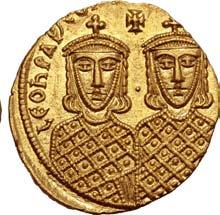

603.
Leo IV ‘the Khazar’, with Constantine VI, Leo III, and Constantine V, AV Solidus. Constantinople, AD 776-778. LЄOҺ VS S ЄςςOҺ COҺSTAҺTIҺOS O ҺЄOS, crowned facing busts of Leo IV and Constantine VI, each wearing chlamys; cross above, pellet between / LЄOҺ PAP’ CO[ҺSTAҺTIҺOS PATHR Θ?], crowned facing busts of Leo III and Constantine V, each wearing loros; cross above, pellet between. Füeg 1.1; DOC 1a; Sear 1583. 4.38g, 18mm, 6h.
Near Mint State.
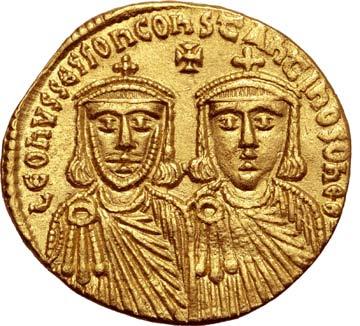



604.
Leo IV ‘the Khazar’, with Constantine VI, Leo III, and Constantine V, AV Solidus. Constantinople, AD 778-780. LЄOҺ VS S ЄςςOҺ COҺSƮAҺƮIҺOS O ҺЄO[S Θ?], crowned busts of Leo IV and Constantine VI facing, each wearing chlamys; cross above, pellet between / LЄOҺ PAP’ COҺSƮAҺƮIҺOS PAƮHR, crowned busts of Leo III and Constantine V facing, each wearing loros; cross above, pellet between. Füeg 2.A.1; DOC 1b; Sear 1583. 4.39g, 20mm, 6h.
Near Mint State.




605.
Constantine VI, with Leo III, Constantine V, and Leo IV, AV Solidus. Constantinople, AD 780-787. LЄOҺ VS S ЄςςOҺ COҺSƮAҺƮIҺOS O ҺЄOS, Leo IV and Constantine VI enthroned facing, each wearing crown and chlamys; cross above / LЄOҺ PAP COҺSƮAҺƮIҺOS PAƮHR, crowned facing busts of Leo III and Constantine V, each wearing loros; cross above, pellet between. Füeg 1.A.2; DOC 2.1 (Leo IV); Sear 1584 (Leo IV). 4.44g, 22mm, 6h.
Good Extremely Fine.
450
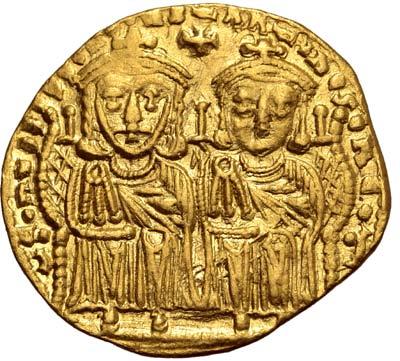
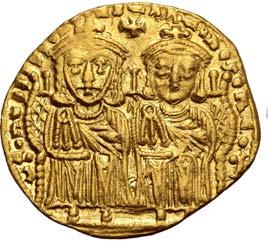


Constantine VI, with Leo III, Constantine V, and Leo IV AV Solidus. Constantinople, AD 780-787. LЄOҺ VS S ЄςςOҺ COҺSTAҺTIҺOS O ҺЄOS, Leo IV and Constantine VI enthroned facing, each wearing crown and chlamys; cross above / LЄOҺ PAP’ COҺSTAҺTIҺOS PATHR, crowned facing busts of Leo III and Constantine V, each wearing loros; cross above, pellet between. Füeg 1.B.1; DOC 2 (Leo IV); Sear 1584 (Leo IV). 4.41g, 22mm, 6h.
606. 240
Extremely Fine; slight bend to flan edge at 10h.
Ex Terner Collection, Roma Numismatics Ltd., E-Sale 102, 3 November 2022, lot 1444; Ex Roma Numismatics Ltd., E-Sale 82, 15 April 2021, lot 1751.
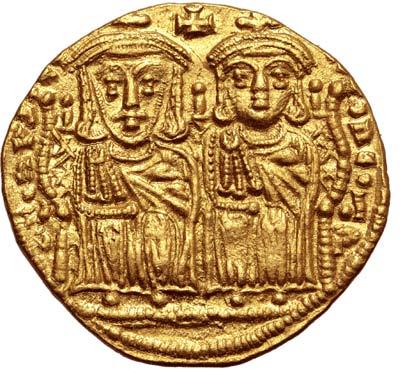

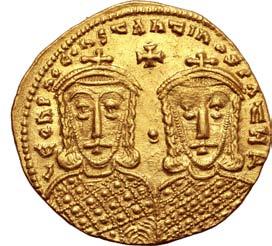

607.
Constantine VI, with Leo III, Constantine V, and Leo IV, AV Solidus. Constantinople, AD 780-787. LЄOҺ VS [S ЄςςOҺ COҺSƮAҺƮIҺOS] O ҺЄOS B, Leo IV and Constantine VI enthroned facing, each wearing crown and chlamys and holding akakia; cross above / LЄOҺ PAP COҺSƮAҺƮIҺOS PAƮHR, crowned facing busts of Leo III and Constantine V, each wearing loros; cross above, one pellet between. Füeg 1.C.2; DOC 2 (Leo IV); Sear 1584 (Leo IV). 4.47g, 22mm, 6h.
Near Mint State.
450 No Reserve




608.
Constantine VI and Irene, with Leo III, Constantine V, and Leo IV, AV Solidus. Constantinople, AD 787-790. COҺSTAҺTIҺOS C’ Ь’ Δ’, Constantine V, Leo III, and Leo IV seated facing, each crowned and draped / S IRIҺI AVΓ’ ΜΙƮΗR’, crowned facing busts of Constantine IV, draped and holding globus cruciger, and Irene, wearing loros and holding globus cruciger and cruciform sceptre; cross above, pellet between. Füeg C.2.4/Ir.2.5; DOC 1.1; Sear 1593. 4.29g, 20mm, 6h.
Good Extremely Fine.
600




609.
Constantine VI and Irene, with Leo III, Constantine V, and Leo IV, AV Solidus. Constantinople, AD 787-790. COҺS[TAҺTI]ҺOS C’ Ь’ Δ’, Constantine V, Leo III, and Leo IV seated facing, each crowned and draped / S IRIҺI AVΓ’ Μ[ΙƮΗ]R(?), crowned facing busts of Constantine IV, draped and holding globus cruciger, and Irene, wearing loros and holding globus cruciger and cruciform sceptre; cross above, pellet between. Cf. Füeg C.2.5/ Ir.2.15; DOC 1.2; Sear 1593. 4.48g, 20mm, 6h.
Good Extremely Fine; area of flatness.
600
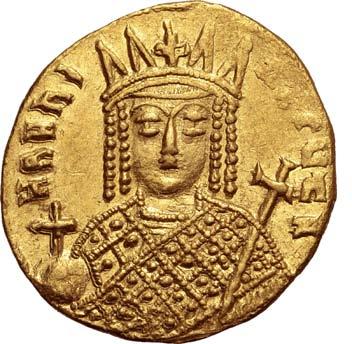



610.
Constantine VI and Irene AV Solidus. Constantinople, AD 793-797. HRHҺI AVΓYƮH, crowned facing bust of Irene, wearing loros, holding globus cruciger and cruciform sceptre / COҺSƮAҺƮINOS bAS’, crowned and draped facing bust of Constantine, wearing chlamys, holding globus cruciger and akakia. Füeg 5.D; DOC 3c.2; Sear 1594. 4.36g, 20mm, 7h.
Good Extremely Fine. Very Rare; especially with this obverse legend.




611.
Constantine VI and Irene AV Solidus. Constantinople, AD 793-797. IRIҺH AΓOVSƮI, crowned facing bust of Irene, wearing loros, holding globus cruciger and cruciform sceptre / COҺSƮAҺƮINOS [bAS’ ...], crowned and draped facing bust of Constantine, wearing chlamys, holding globus cruciger and akakia. Füeg 5; DOC 3a; Sear 1594. 4.38g, 21mm, 6h.
Mint State. Very Rare.
Ex Roma Numismatics Ltd., Auction XX, 29 October 2020, lot 748.

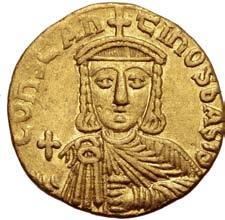


612.
Constantine VI and Irene AV Solidus. Constantinople, AD 793-797. IRIҺH AΓOVSƮI, crowned facing bust of Irene, wearing loros, holding globus cruciger and cruciform sceptre / COҺSƮAҺƮINOS bAS’ Θ, crowned and draped facing bust of Constantine, wearing chlamys, holding globus cruciger and akakia. Füeg 5.A; DOC 3a; Sear 1594. 4.46g, 18mm, 6h.
613.



Constantine VI and Irene AV Solidus. Constantinople, AD 793-797. IRIҺH AΓOVSƮI, crowned facing bust of Irene, wearing loros, holding globus cruciger and cruciform sceptre / COҺSƮAҺƮINOS bAS’ Θ, crowned and draped facing bust of Constantine, wearing chlamys, holding globus cruciger and akakia. Füeg 5.A; DOC 3a; Sear 1594. 4.44g, 21mm, 7h.
Near Mint State; area of flat strike.
Ex Roma Numismatics Ltd., Auction XXVII, 22 March 2023, lot 851.
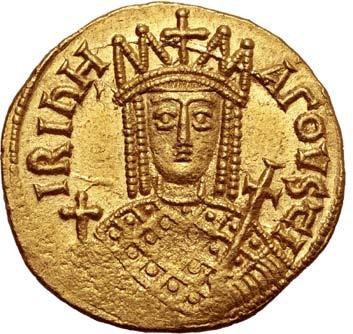
614.


Constantine VI and Irene AV Solidus. Constantinople, AD 793-797. IRIҺH AΓOVSƮI, crowned facing bust of Irene, wearing loros, holding globus cruciger and cruciform sceptre / COҺ[SƮAҺ]ƮINOS bAS’, crowned and draped facing bust of Constantine, wearing chlamys, holding globus cruciger and akakia. Füeg 5.B; DOC 3b; Sear 1594. 4.44g, 19mm, 6h.
Near Mint State; area of flatness.


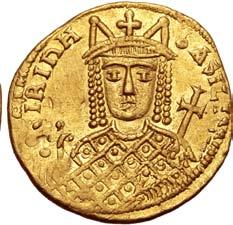
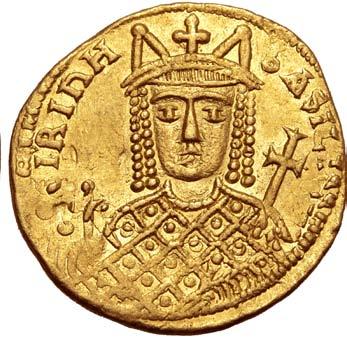
615.
Irene AV Solidus. Constantinople, AD 797-802. ЄIRIҺH ЬASILISSH, crowned bust of Irene facing, wearing loros, holding globus cruciger and cruciform sceptre / • ЄIPIҺH ЬASILISS[H ⴲ], crowned bust of Irene facing, wearing loros, holding globus cruciger and cruciform sceptre. Füeg 1.C.1; DOC 1a.2, 4-5; Sear 1599. 4.39g, 19mm, 6h.
Extremely Fine. Rare.
Ex Roma Numismatics Ltd., Auction XXVII, 22 March 2023, lot 853.
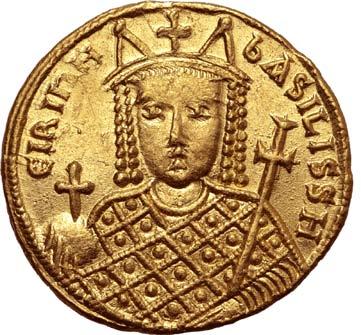



616.
Irene AV Solidus. Constantinople, AD 797-802. ЄIRIҺH ЬASILISSH, crowned bust of Irene facing, wearing loros, holding globus cruciger and cruciform sceptre / • ЄIRIҺH ЬASILISSH ⴲ, crowned bust of Irene facing, wearing loros, holding globus cruciger and cruciform sceptre. Füeg 1.C.1; DOC 1a; Sear 1599. 4.44g, 20mm, 6h.
Near
617.
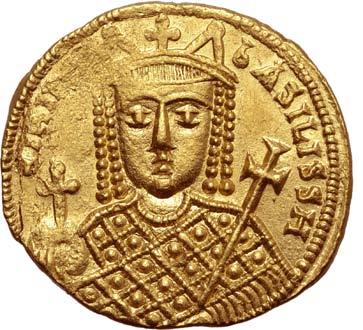
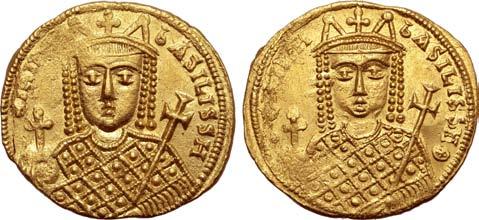

Irene AV Solidus. Constantinople, AD 797-802. ЄIRIҺH ЬASILISSH, crowned bust of Irene facing, wearing loros, holding globus cruciger and cruciform sceptre / • ЄIRIҺH ЬASILISSH ⴲ, crowned bust of Irene facing, wearing loros, holding globus cruciger and cruciform sceptre. Füeg 1.C.1; DOC 1a.2; Sear 1599. 4.41g, 20mm, 6h.
Good Extremely Fine; area of flatness.
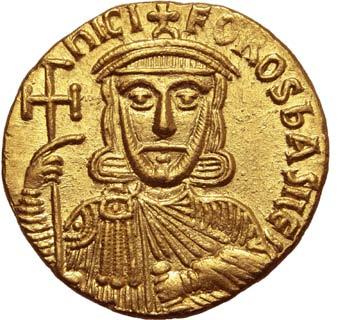
618.
300



Nicephorus I, with Stauracius, AV Solidus. Constantinople, AD 803-811. ҺICIFOROS ЬASILЄ’, crowned facing bust of Nicephorus, wearing chlamys, holding cross potent and akakia / SƮAVRACIS ∂ЄSPO’ X, crowned facing bust of Stauracius, wearing chlamys, holding globus cruciger and akakia. Füeg 2.A.2; DOC 2c; Sear 1604. 4.39g, 19mm, 6h.
Near Mint State; highly lustrous.
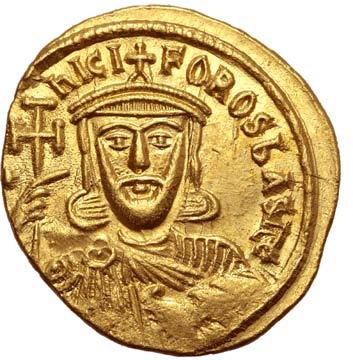
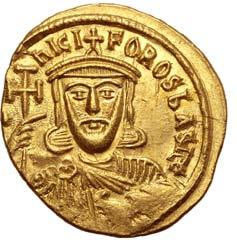
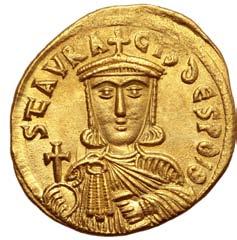

619.
Nicephorus I, with Stauracius, AV Solidus. Constantinople, AD 803-811. • ҺICIFOROS ЬASILЄ’, crowned facing bust of Nicephorus, wearing chlamys, holding cross potent and akakia / SƮAVRACIS ∂ЄSPO’ Θ, crowned facing bust of Stauracius, wearing chlamys, holding globus cruciger and akakia. Füeg 2.B.1; DOC 2b.1-2; Sear 1604. 4.48g, 20mm,
Mint State.



600
620. 90
Extremely Fine; attractive green patina.
Ex JR Collection (United States), Roma Numismatics Ltd., E-Sale 54, 28 February 2019, lot 1113.
621.
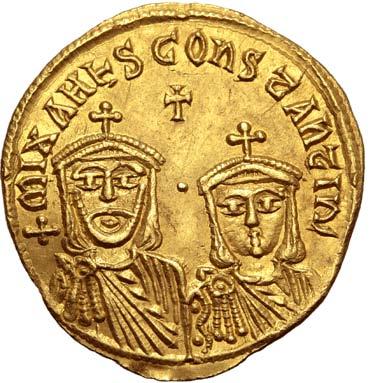
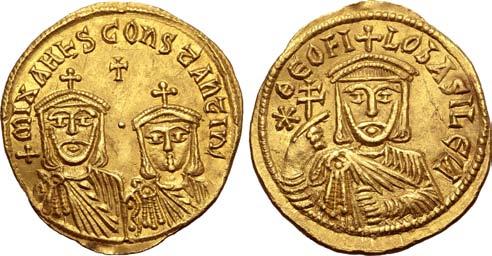

Theophilus, with Michael II and Constantine, AV Solidus. Constantinople, AD 831-842. ⧾ MIXAHL S COҺSTAҺTIҺ’, crowned facing busts of Michael II and Constantine, each wearing chlamys; cross above, pellet between / * ΘЄOFILOS bASILЄ’Λ, crowned facing bust of Theophilus, holding patriarchal cross and akakia. Füeg 3.E.2.z; DOC 3b; Sear 1653. 4.42g, 22mm, 6h.
Good Extremely Fine.
Ex collection formed in the Rhineland from late 1970s to late 1990s, Leu Numismatik AG, Web Auction 24, 3 December 2022, lot 621.
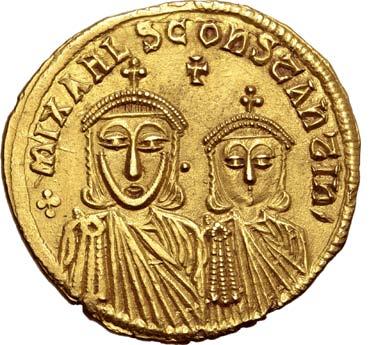


Theophilus, with Michael II and Constantine, AV Solidus. Constantinople, AD 831-842. ⧾ MIXAHL S COҺSTAҺTIҺ’, crowned facing busts of Michael II and Constantine, each wearing chlamys; cross above, pellet between / * ΘЄOFILOS bASILЄ Θ’, crowned facing bust of Theophilus, holding patriarchal cross and akakia. Füeg 3.H.2.y; DOC 3d; Sear 1653. 4.38g, 20mm, 6h.
Near Mint State.
Ex Morton & Eden, Auction 119, 6 December 2022, lot 140; Ex European Ambassador Collection, formed in the 1950s and 1960s.



Theophilus, with Michael II and Constantine, AV Solidus. Constantinople, AD 831-842. ⧾ MIXAHL S COҺSTAҺTIҺ’, crowned facing busts of Michael II and Constantine, each wearing chlamys; cross above, pellet between / * ΘЄOFILOS bASILЄ Θ, crowned facing bust of Theophilus, holding patriarchal cross and akakia. Füeg 3.H.2.y; DOC 3d; Sear 1653. 4.41g, 19mm, 6h.
Near Extremely Fine.
Ex Roma Numismatics Ltd., E-Sale 102, 3 November 2022, lot 1449.


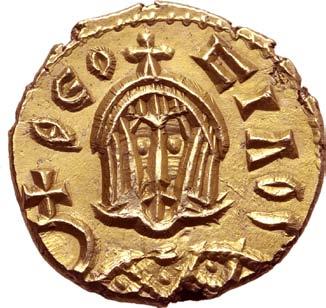
Theophilus AV Semissis. Syracuse, AD 831-842. ΘЄOFIΛOS, crowned facing bust, wearing chlamys and holding globus cruciger / ΘЄOFIΛOS, crowned facing bust, wearing loros and holding globus cruciger. BCI 877; DOC 26c; Spahr

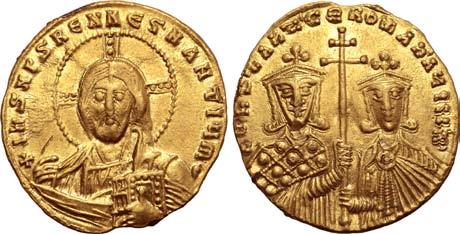
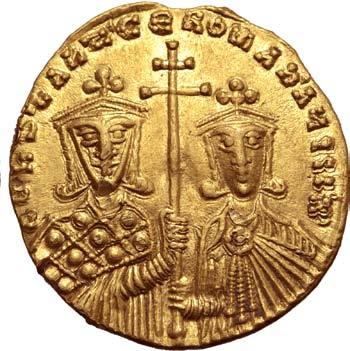
626.
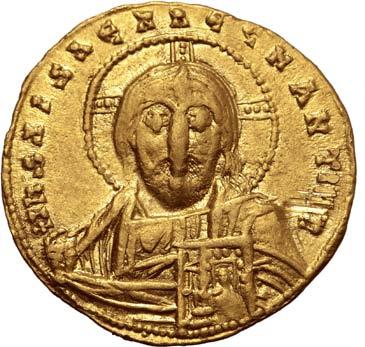


Constantine VII Porphyrogenitus, with Romanus II, AV Solidus. Constantinople, AD 950-955. ⧾ IҺS XPS RЄX RЄϚNANTIЧm, facing bust of Christ Pantokrator / COҺSƮAҺƮ’ CE ROMAҺ’ AЧϚϚ Ь R, crowned facing busts of Constantine VII, wearing loros, and Romanus II, wearing chlamys, holding patriarchal cross between them. Füeg 15.C.1; DOC 15; Sear 1751. 4.39g, 20mm, 6h.
Good Very Fine.

627.
180


Constantine IX Monomachus AV Tetarteron Nomisma. Constantinople, AD 1042-1055. ⧾ IS X XIΓ N CCNANm, bust of Christ Pantokrator facing / ⧾ CѠҺSTAҺT ҺOS bAIL m, crowned facing bust of Constantine, wearing jeweled chlamys, holding labarum and globus cruciger. DOC 5; Sear 1833. 3.97g, 18mm, 6h.
Extremely Fine. Rare.
Ex Roma Numismatics Ltd., Auction XXVII, 22 March 2023, lot 868.
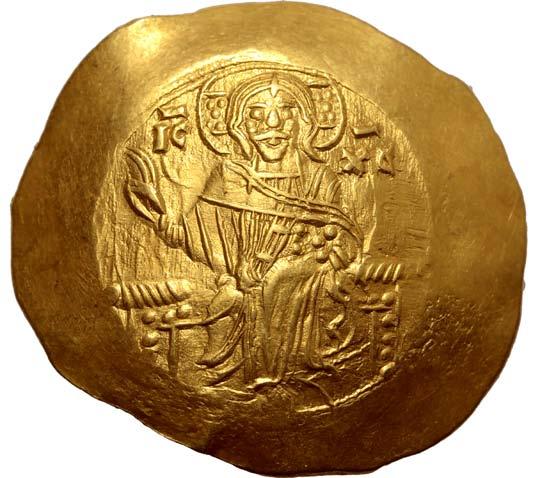

628.
III
Extremely Fine.
450

AV Hyperpyron. Emperor
Nicaea. Magnesia,
Ex Roma Numismatics Ltd., E-Sale 102, 3 November 2022, lot 1469.
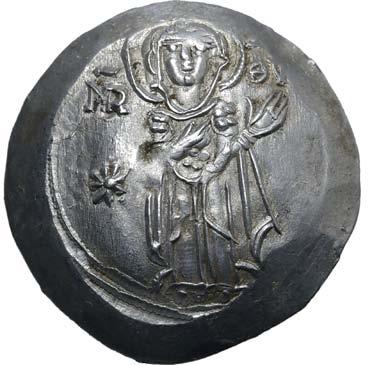
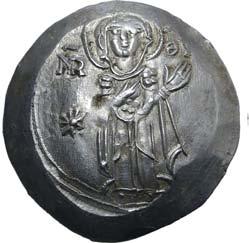


629. No lot. 630.
Empire of Trebizond, Andronicus I Gidon AR Aspron Trachy. Trebizond, AD 1222-1235. The Virgin standing facing,
Mint State.
Ex Roma Numismatics Ltd., Auction XXII, 8 October 2021, lot 968 (hammer: GBP 1,200).
450
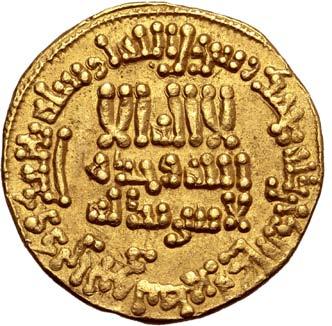
631.
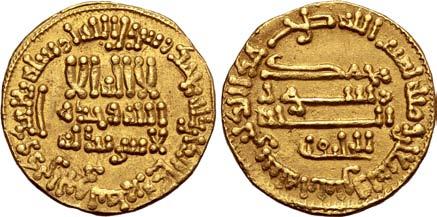

Abbasids, time of al-Rashid AV Dinar. Unnamed mint in Misr (Cairo), AH 192 = AD 808. Kalima in three lines, Quran IX, 33 around / Continuation of kalima in three lines; “li’l-khalifa” below, mint and date formula around. Album 218.13; Bernardi 73. 4.23g, 19mm, 12h.
Extremely Fine.
Ex GK Collection; Ex Morton & Eden, Auction 103, 24 October 2019, lot 187.




1,800
632. 633.
Abbasids, al-Muktafi AV Dinar. Harran mint, AH 290 = AD 902. Kalima in three lines; mint and date formula in inner margin, Quran XXX, 4-5 in outer margin / Continuation of Kalima in three lines; “al-Muktafi billah” below, Quran IX, 33 around. Album 243.1; Bernardi 226Hj. 3.69g, 26mm, 6h.
Good Extremely Fine. Very Rare.
Ex GK Collection; Ex Morton & Eden, Auction 103, 24 October 2019, lot 41 (hammer: GBP 1,400).
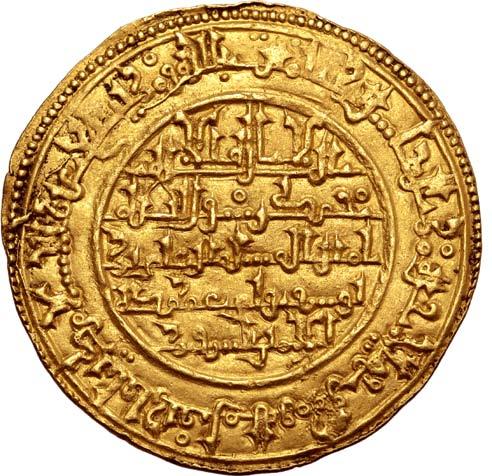
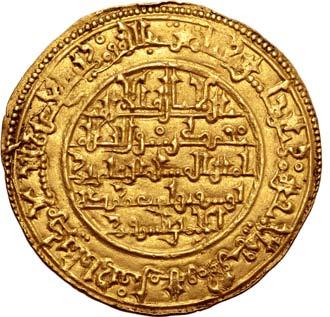
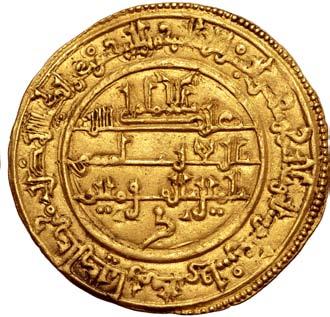

Almoravids, ‘Ali b. Yusuf, with his heir Sir b. ‘Ali AV Dinar. Madinat Fas mint, AH 536 = AD 1141. Kalima, “Commander of the Muslims ‘Ali bin Yusuf and his heir the prince Sir” in five lines; Quran III, 85 around / “The Imam Abd Allah Commander of the faithful” in four lines; mint and date formula around. CMA (Eustache) 231; Hazard -; Vives -. 4.13g, 27mm, 9h.
Extremely Fine. Very Rare.
Ex GK Collection; Ex Jesus Vico S.A., Auction 149, 16 November 2017, lot 609 (hammer: GBP 900).

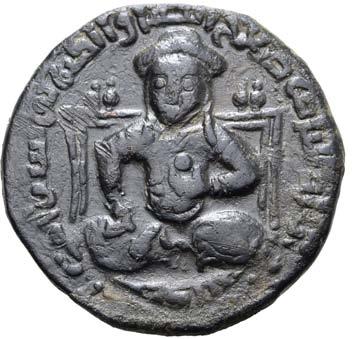


634.
Ayyubids, Al-Nasir Salah al-Din Yusuf Æ Dirham. Mayyafariqin(?) mint, AH 586 = AD 1190-1191. Seated sultan facing, holding orb, marginal legend around / Arabic inscription in three lines within marginal legends including mint and date formula. Album 791.4; Whelan Type III, 258-60; Balog, Ayyubids 182. 13.29g, 29mm, 5h.
Good Very Fine; well centred, glossy dark patina. Very Rare.
Ex Roma Numismatics Ltd., Islamic, Medieval and World Sale 2, 25 November 2022, lot 20;
Ex Don Ferrante Collection, acquired from Kölner Münzkabinett.




Ayyubids, Al-Kamil Muhammad I AV Dinar. Al-Qahira mint, AH 615-635 = AD 1218-1238. Mint and [date] formula in outer margin; citing the Abbasid caliph al-Mustansir billah in four lines / Name and titles in four lines; Qur ’an IX, 33 around. Album 811.1; cf. Balog 370. 4.53g, 22mm, 3h.
Extremely Fine; lightly clipped.
Ex Roma Numismatics Ltd., Auction XXIV, 28 March 2022, lot 1212.
635. 636.

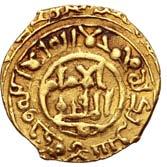


Burids, Atabegs of Damascus. Abaq AV 1/4 Dinar. Dimashq mint, AH 534-549 = AD 1140-1154. Citing the caliph “Imam al-Muqtafi” in two lines; kalima around / ‘al ghaya in two lines; citing the Great Seljuk ruler Sanjar; mint formula in outer margin. Album N784; SICA -. 1.12g, 14mm, 6h.
Good Very Fine. Extremely Rare.
Ex GK Collection;
Ex Morton & Eden, Auction 103, 24 October 2019, lot 76;
Ex Stephen Album Rare Coins - Wilkes & Curtis Ltd, Horizon Auction I, 2 October 2016, lot 409.
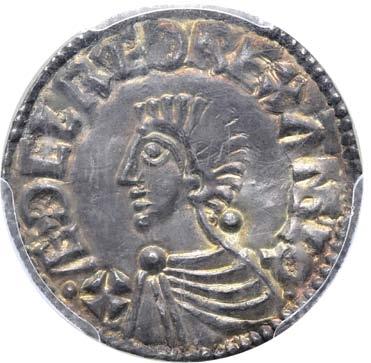
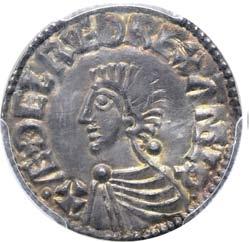


637.
Anglo-Saxon, Kings of All England. Aethelred II AR Penny. Long cross type. Winchester mint, 978-1016. Godwine, moneyer. ✠ ÆDELRED REX ANGLOX, draped bust to left / ✠ GODPINE MO PINT, voided long cross. SCBC 1151; North 774.
PCGS graded MS 63 (#44760659).
Ex Stack’s Bowers Galleries (& Ponterio), Summer 2022 Global Showcase Auction, 22 August 2022, lot 31146 (hammer: USD 1,100); Ex Mark and Lottie Salton Collection, sold with original collection ticket.

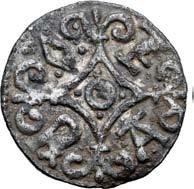
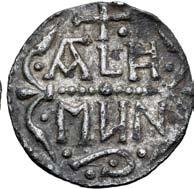

450
Anglo-Saxon, Kings of Mercia. Offa AR Penny. Light coinage. London mint, circa 765-792. Ealhmund, moneyer. Lozenge cross fleury with central pellet-in-annulet surrounded by four pellets; OFA RX (partially legate) within angles / ✠ ALHMUN∂ in four lines, divided by a beaded bar with fleury ends. SCBC 904; Chick 39; North 282; CNG Triton XXVII, 1238 = EMC 2011.0257. 1.24g, 16mm, 5h.
Good Very Fine.
Found in Shropshire, recorded by the Portable Antiquities Scheme and returned to the finder. PAS ID: DENO-2150DA.
638. 639.



600
Austria, Holy Roman Empire. Rudolf II AR Taler. Ensisheim mint, 1609. ✠ RVDOLPHVS * II * D * G * RO * IM * SE * AV * GER * HVN * BOH * REX, laureate and draped bust to right, lion’s head broach on shoulder; date before / NEC NON * ARCHIDVCES * AVS * DV * BV * LAN * G * AL * CO * FE, crowned coat-of-arms within ornate border. KM 246.3; Davenport 3034; Klemesch 132; Numista 140274.
NGC graded UNC Details, obv. scratched (#6674260-001).
Ex Leu Numismatik AG, Web Auction 22, 20 August 2022, lot 451 (hammer: CHF 2,600); Ex collection of Dr. Max Blaschegg (1930-2021), acquired from Hess on 25 January 1991.
It can be seen from the date on the obv. of this coin that the die was recut from that used for the previous year.

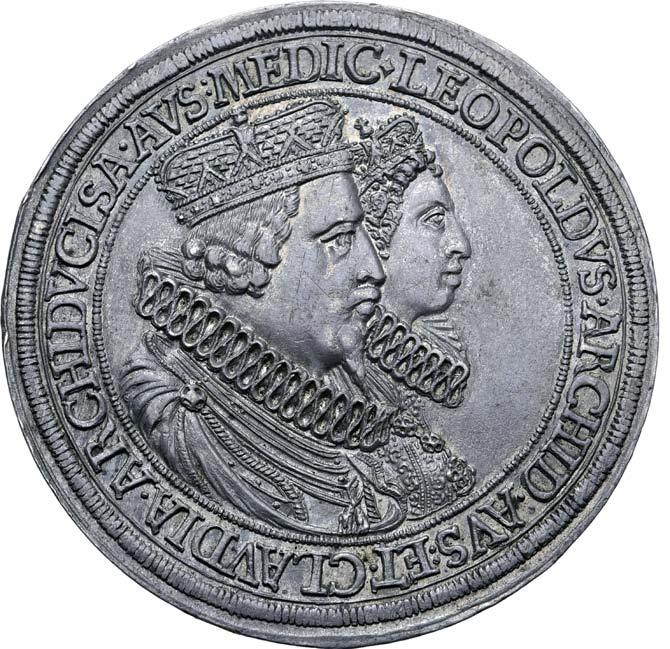
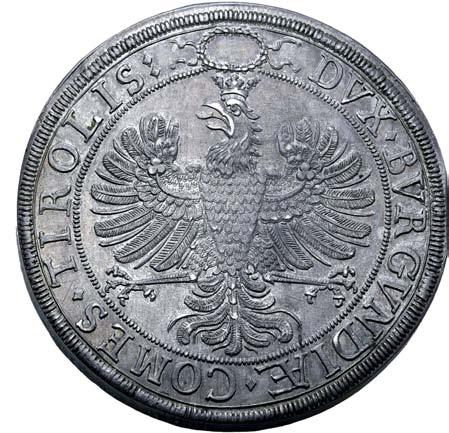
640.
Austria, Holy Roman Empire. Leopold V AR 2 Taler. Hall mint, after 1626. Commemorating his marriage to Claudia de Medici. LEOPOLDVS • ARCHID • AVS⠘ ET • CLAVDIA • ARCHIDVCISA • AVS⠘ MEDIC ⬩, conjoined crowned and draped busts of Archduke Leopold and Claudia de Medici to right / DVX ⬩ BVRGVNDIÆ ⬩ COMES ⬩ TIROLIS⠘, crowned eagle of Tyrol facing, wings spread, head to left, wreath above. KM 639; Davenport 3331; Numista 33503.
NGC graded AU 58 (#6674259-002).
Ex Leu Numismatik AG, Web Auction 22, 20 August 2022, lot 465 (hammer: CHF 1,803); Ex collection of Dr. Max Blaschegg (1930-2021), acquired from C. Freytag in December 1944.
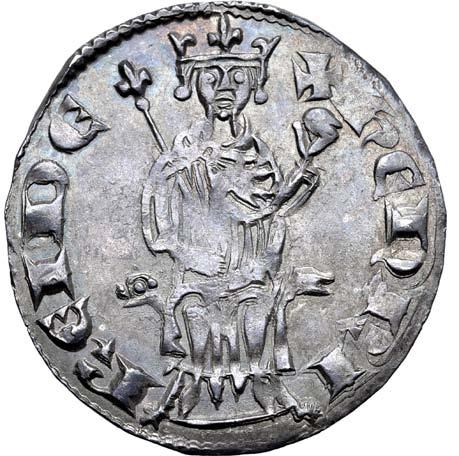
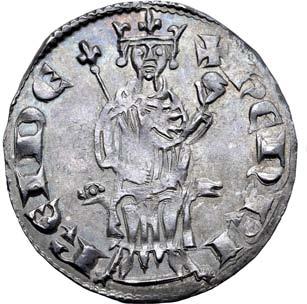
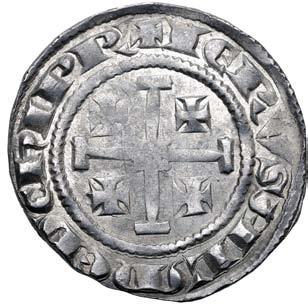
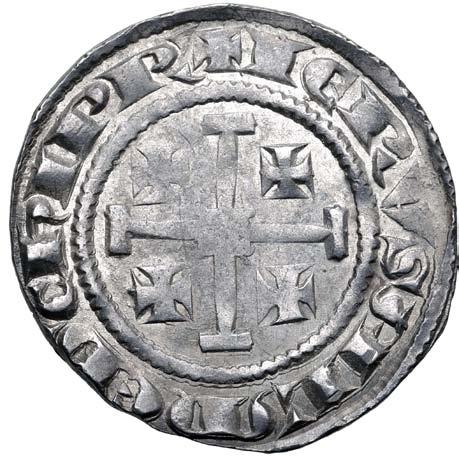
750
Crusader States, Cyprus (Lusignan Kingdom). Henry II AR Gros. Nicosia mint, 1285-1324. ҺЄNRI RЄI DЄ, king seated facing on throne decorated with lions, holding lis-tipped sceptre and globus cruciger / ✠ IЄRVSAL’ᙏ Є D’ CҺIPR’, cross of Jerusalem with square centre; crosses in each quarter part. M&P Series 1A, early phase, pl. 11, 1 (Obv. die J); Metcalf, Crusades 1995, 674-5; CCS 50. 4.68g, 26mm, 8h.
Extremely Fine; pleasant old cabinet tone.
Ex Roma Numismatics Ltd., Islamic, Medieval and World Sale 2, 25 November 2022, lot 165.




90
Crusader States, Cyprus (Lusignan Kingdom). Henry II AR Gros. Nicosia mint, 1285-1324. ҺЄNRI RЄI DЄ, king seated facing on throne decorated with lions, holding lis-tipped sceptre and globus cruciger; star in left field / ✠ IЄRVSAL’ᙏ Є D’ CҺIPR, cross of Jerusalem with square centre; crosses in each quarter part. M&P Series 1A, pl. 9, 1-10; Metcalf, Crusades 1995, 676-82; CCS 58. 4.68g, 26mm, 1h.
Extremely Fine; pleasant old cabinet tone.
Ex Roma Numismatics Ltd., Islamic, Medieval and World Sale 2, 25 November 2022, lot 166.
60
643.



Crusader States, Latin Kingdom of Jerusalem. Anonymous AV Bezant. Acre mint, second phase, struck 1148/9-1187. Imitating a dinar of the Fatimid caliph al-Amir. Beginning of caliphal titles in two lines, continuation of name and titles in inner margin; mint formula in outer margin / “’al, ghaya” in two lines across field, kalima in inner margin; Qur’an IX, 33 in outer margin. Cf. Balog & Yvon 25; Metcalf, Crusades 1995, 132; CCS 3. 3.77g, 21mm, 8h.
Extremely Fine; slightly wavy.

644.


Crusader States, Latin Kingdom of Jerusalem. Anonymous AV Bezant. Acre mint, second phase, struck 1148/9-1187. Imitating a dinar of the Fatimid caliph al-Amir. Beginning of caliphal titles in two lines, continuation of name and titles in inner margin; mint formula in outer margin / “’al, ghaya” in two lines across field, kalima in inner margin; Qur’an IX, 33 in outer margin. Cf. Balog & Yvon 27b; Metcalf, Crusades 1995, 136-141; CCS 4. 3.87g, 22mm, 1h.
Extremely Fine.
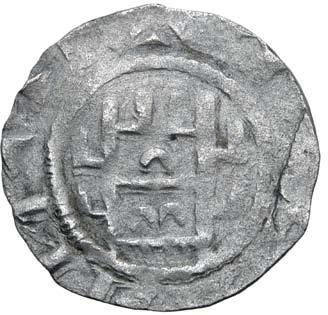
645.
300

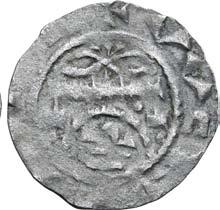

Crusader States, Latin Kingdom of Jerusalem. Time of Queen Sibylla BI Denier. Emergency coinage struck during the siege of Jerusalem, September 1187. ✠ [illegible legend of TVRRIS DAVIT or similar], Tower of David / ✠ VVCPV[…], the Holy Edicule within the Church of the Holy Sepulchre; above, guardian angel. CCS 51; Metcalf, Crusades p. 77; C.J. Sabine, “Numismatic iconography of the Tower of David and the Holy Sepulchre,” NC 1979, pl. 17, 3. 0.92g, 17mm, 2h.
Very Fine. Very rare and of great historical interest.
An extremely important Denier of historical and cultural interest and one of the few documents depicting the Holy Edicule with the tomb of Christ in the Holy Sepulchre during the Crusader era, the coin is an example of an extremely rare emergency issue, struck in the time of Queen Sibylla, during the siege of Jerusalem by Saladin (see C.J. Sabine, “Numismatic iconography of the Tower of David and the Holy Sepulchre,” NC 1979, p. 129-131). Balian d’Ibelin and the Patriarch Heraclius of Jerusalem ordered the stripping of the silver from the Holy Edicule in the Church of the Holy Sepulchre to strike coins with which to pay the city’s defenders. The relevant extract from the Chronicle of Ernoul (an eye witness account of the fall of Jerusalem) says: ‘Then Balian and the patriarch went and had the tomb Edicule of the Sepulchre which was all covered in silver uncovered; and then they had it taken away to be struck into money to give to the knights and sergeants.’

646.



Denmark, Kingdom. Svend II Estridsen AR Penny. Viborg mint, 1047-1075. Draped bust to left; cross above, lis-tipped sceptre before / Voided long cross with triple-crescent ends and pellet at centre; trefoils and crescents in alternating quarters. Hauberg 57; cf. Hede I, 58; Becker Collection 112. 0.65g, 17mm, 12h.
Good Very Fine; internal flan crack, edge chipped, old cabinet tone. Rare. Ex Roma Numismatics Ltd., E-Sale 71, 28 May 2020, lot 1491; Ex Warszawskie Centrum Numizmatyczne, Auction 73, 16 November 2019, lot 52.

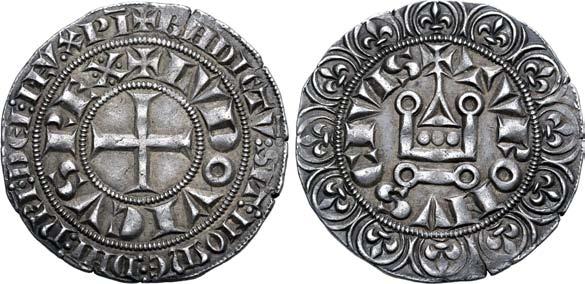

647.
France, Kingdom. Louis IX AR Gros Tournois. 1266-1270. ✠ BNDICTV ⁝ SIT ⁝ NOᙏЄ ⁝ DNI ⁝ ꞂRI ⁝ DЄI ⁝ IҺV.XPI in outer margin, ✠ LVDOVICVS REX (X with four pellets) in inner margin, short cross pattée / ✠ TVRONVS CIVIS around châtel tournois within border of twelve lis. Ciani 181c; Duplessy 190c; Grierson, Coins of Medieval Europe, 258. 4.08g, 24mm, 6h.
Extremely Fine.
Ex Roma Numismatics Ltd., Auction XXII, 8 October 2021, lot 989; Acquired from Beaussant Lefèvre, Paris.




270
648. 649.
France, Kingdom. Charles V le Sage (the Wise) AV Franc à pied. Paris mint, struck from 20 April 1365. KAROLV ˣ DI ˣ GR FRAИCORV ˣ RX, king standing facing within Gothic arch, holding sword with annulet pommel and Main de Justice; semé of nine lis to left and right / ✠ XPC ∗ VINCIT ∗ XPC ∗ RЄGNAT ∗ XPC ∗ IMPЄRAT, cross tréflée, pellet within angled quadrilobe at centre, cantoned with lis in first and fourth quarters, crown in second and third; all within angled quadrilobe, lis in spandrels. Duplessy 360; Ciani 457; Friedberg 284. 3.80g, 28mm, 3h.
Near Mint State; fine style.
Ex Classical Numismatic Group, Auction 121, 6 October 2022, lot 1172 (hammer: USD 4,000).

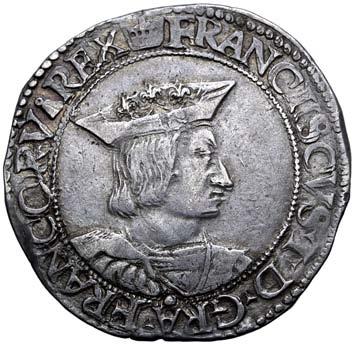

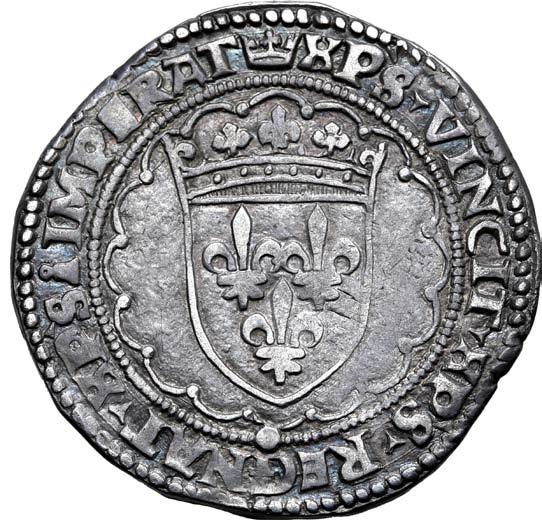
France, Kingdom. François I ‘le Restaurateur des Lettres’ (the Restorer of Letters) AR Teston. 3rd type. Rouen mint, 1515-1547. ♕ FRANCISCVS • I • D • GRA • FRANCORV (mintmark) REX, crowned bust to right / ♕ XPS • VINCIT • XPS • REGNAT • XPS (mintmark) IᙏPERAT, crowned coat-ofarms of France within polylobe. Duplessy 794; Lafaurie 659. 9.55g, 30mm, 2h.
Good Very Fine; struck on a broad planchet. Very rare in this condition.
Ex Roma Numismatics Ltd., Auction XXII, 8 October 2021, lot 1006; Acquired from Beaussant Lefèvre, Paris.
750
651. 652.



France, Kingdom. François I le Restaurateur des Lettres (the Restorer of Letters) AV Écu d’or. Toulouse mint, 5th type, 3rd emission, struck from 21 July 1519. ☘ FRANCISCVS : DEI : GRACIA : FRANCO : REX, crowned coat-of-arms of France, sunburst above / ☘ XPS : VINCIT : XPS : REGNAT : XPS : IMPERAT, cross fleurdelisée with pellet within quatrelobe at centre; cantoned with F in first and third quarters, lis in second and fourth. Duplessy 775; Ciani 1073-4; Friedberg 345. 3.38g, 27mm, 11h.
Good Extremely Fine.
Ex MDC Monnaies de Collection sarl, Auction 3, 1 December 2017, lot 398.
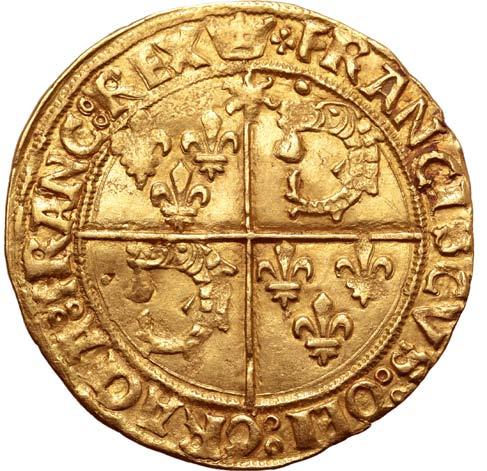


450 No
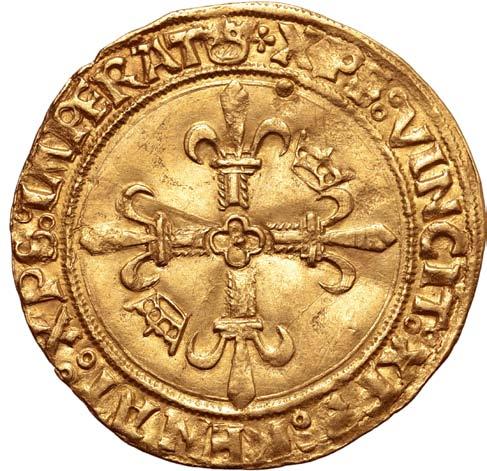
France, Kingdom. François I le Restaurateur des Lettres (the Restorer of Letters) AV Écu d’or au soleil du Dauphiné. Crémieu mint, 4th type, 3rd emission, 1528. ♛ ⧾ FRANCISCVS : DEI : GRACIA : FRANC : REX, coat-of-arms of the Dauphin of France; sunburst above / ♛ ⧾ XPS : VINCIT : XPS : RENAT : XPS : IMPERAT, cross fleurdelisée with pellet within quatrilobe at centre, cantoned with crowns in two quarters. Duplessy 785; Friedberg 353. 3.43g, 26mm, 9h.
Good Extremely Fine. Rare.
Ex Roma Numismatics Ltd., Auction XX, 30 October 2020, lot 860; Acquired from Jean Vinchon Numismatique & Phidias.
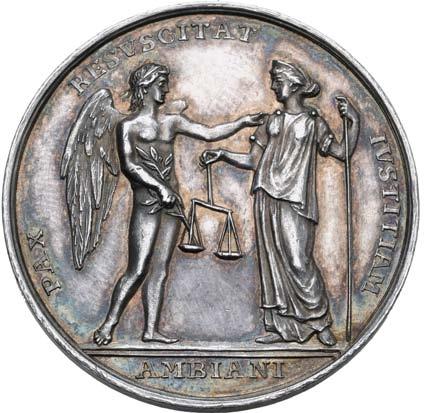


600
France, First Republic. Napoléon Bonaparte, as Premier Consul, AR Medal. Celebrating the Peace of Amiens. Dated 25th March 1802 (later restrike). Dies by Abramson. PAX RESVSCITAT IVSTITIAM, the Genius of Peace standing facing, head to right, holding palm and resting hand on shoulder of Justitia standing facing, head to left, holding scales and sceptre; AMBIANI in exergue / ET LEGES IMPERANT, Pallas seated to left, holding tablets of law; shield, spear and owl to right; D. XXV MARTII MDCCCII in two lines in exergue. Bramsen 2167. 12.56g, 34mm, 12h.
Mint State; appears as though a privy mark on edge has been removed. Very Rare.
Ex Westfälische Auktionsgesellschaft, Auction 78, 11 September 2017, lot 1390 (hammer: EUR 1,600).
450
653.

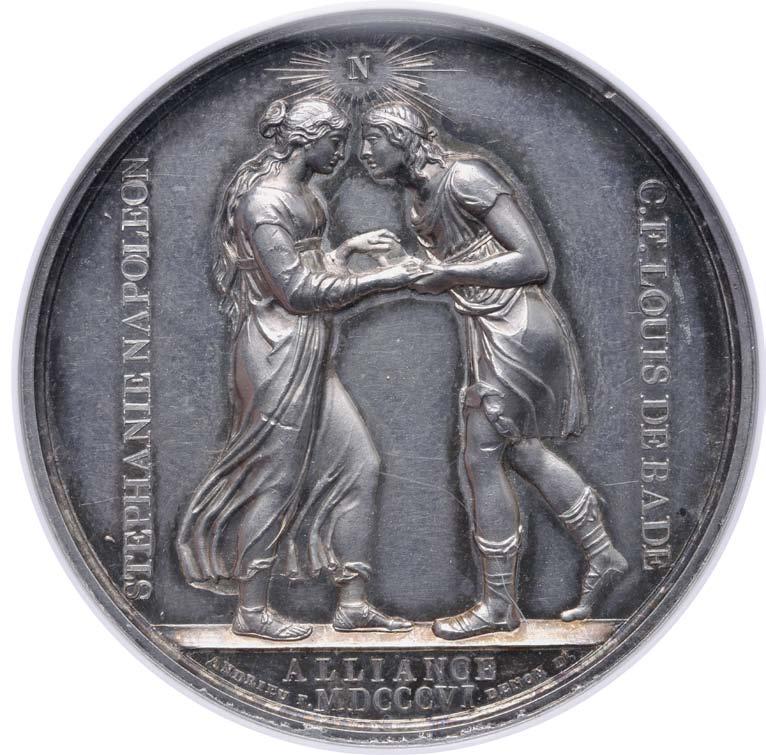

First Empire. Napoléon I AR Medal.
C.
NGC graded MS 61 (#5790006-046).
Acquired from MDC Monnaies de Collection sarl.

France, First Empire. Napoléon I Æ Medal. Commemorating the formation of the Banque de France. Dated 1809. Dies
Near Mint State; minor rim contact marks.
NAPOLEON
Ex R. T. Collection of Napoleonic Medals from the First French Republic and Empire, Roma Numismatics Ltd., Auction XXIV, 28 March 2022, lot 1849;
Ex Heritage World Coin Auctions, NYINC Signature Sale 3063, 16 January 2018, lot 34275.

France,
Near Mint
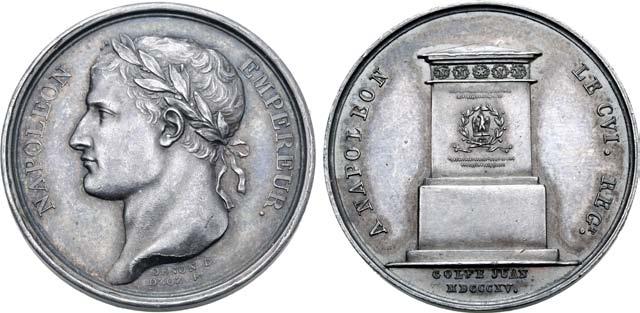
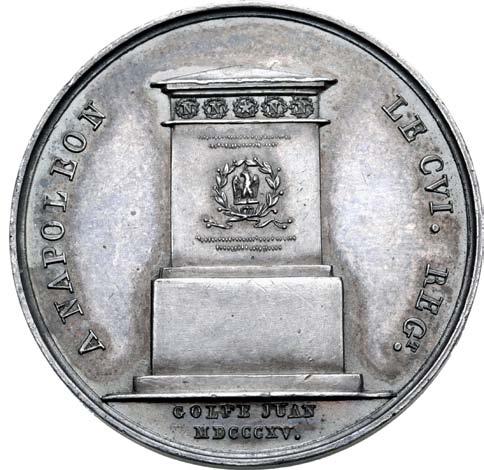
Ex MDC Monnaies de Collection sarl, Auction 4, 15 November 2018,
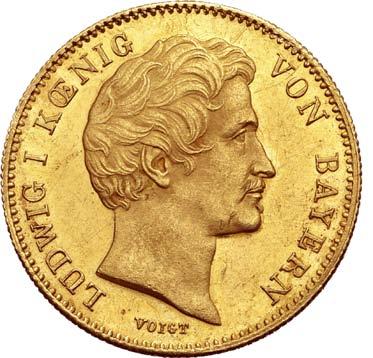
656.


German States, Bayern (Bavaria, Kingdom). Ludwig I AV Ducat. 1845. Dies by C. Voigt. LUDWIG I KŒNIG VON BAYERN, bare head to right; VOIGHT in small letters below truncation / GERECHT UND BEHARLICH, crowned coat-of-arms supported by two crowned lions; date below. KM 808; AKS 71; Jaeger 125; Friedberg 271. 3.51g, 21mm, 12h.
Mint State; highly lustrous fields. Very Rare.
Ex Numismatica Ranieri, Auction 9, 22 May 2016, lot 1224.
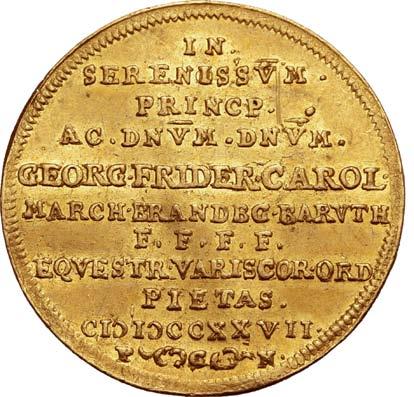
657.
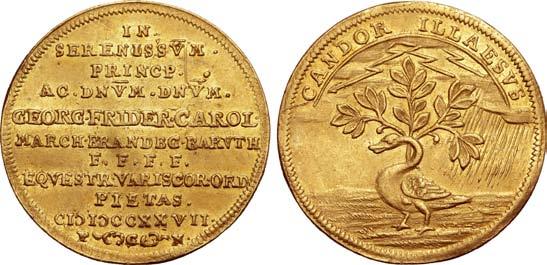
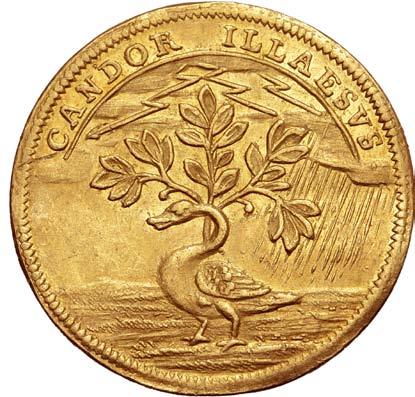
German States, Brandenburg-Bayreuth (Margraviate). George Friedrich Karl AV Medal of Ducat Weight. Nürnberg mint, 1727. Paul Gottlieb Nürnberger, mintmaster. Commissioned by the Höfer knighthood, part of the Vogtland knighthood. IN • SERENIS’SVM • PRINCP • AC • DNVM • DNVM • GEORG • FRIDER • CAROL • MARCH • BRANDBG • BARVTH F • F • F • F • EQVESTR • VARISCOR • ORD PIETAS • in nine lines across field above date; P-G-N within floral ornament below / CANDOR ILLAESVS, swan advancing to left before tree; lightning bolts above, rain shower to right. KM 164; Wilmersdörffer Coll. 710; Friedberg 385. 3.45g, 23mm, 12h.
Good Extremely Fine; lightly creased.
Ex Hess-Divo AG, Auction 331, 1 December 2016, lot 792.

658.


German States, Frankfurt (Free Imperial City) AV Ducat. In the name of Matthias (Holy Roman Emperor). 1619. N CO FVRTENSIS MON AVR REIP FRA, St. John standing to right with oval shield / MATTHIAS ROM IMP SEMP AVG (date) Æ(key), crowned and nimbate double-headed Imperial eagle facing with wings spread, holding sword and sceptre and with orb on breast. KM 54; Friedberg 960; Numista 200579. 3.21g, 24mm, 12h.
Good Extremely Fine. Rare.
Ex WAG Online oHG, Auction 82, 14 January 2018, lot 853.
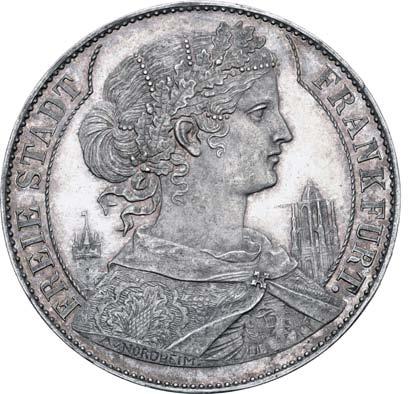
659.


German States, Frankfurt (Free Imperial City) AR Vereinstaler. 1857. FREIE STADT FRANKFURT., bust of Francofurtia to right, wearing ornate cloak and oak wreath; Eschenheimer Tower and two other rooftops behind right shoulder, cathedral tower behind to left / EIN VEREINSTHALER ⧾ XXX EIN PFUND FEIN ⧾, crowned imperial eagle facing, head to left, with wings spread, date below. Edge inscription: STARK ⍭ IM ⍭ RECHT ⍭∗⍭. KM 354; Kahnt 166; Thun 141. 18.57g, 33mm, 12h.
Near Mint State; untouched, mirror-like surfaces, light iridescent toning. Very Rare variant, only 1,350 minted.
Ex Heidelberger Münzhandlung Herbert Grün e.K., Auction 68, 13 May 2016, lot 149.
660.

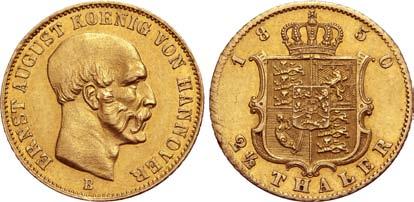

German States, Hannover (Kingdom). Ernst August AV 2 ½ Taler. 1850. ERNST AUGUST KOENIG VON HANNOVER, bare head to right, B below bust truncation / Crowned coat-of-arms, date above, denomination below. KM 215; Friedberg 1178; Numista 31267. 3.34g, 17mm, 12h.
Good Extremely Fine.
Ex Teutoburger Münzauktion GmbH, Auction 130, 1 September 2020, lot 304.
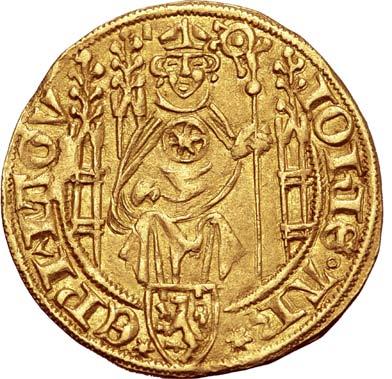
661. 662.
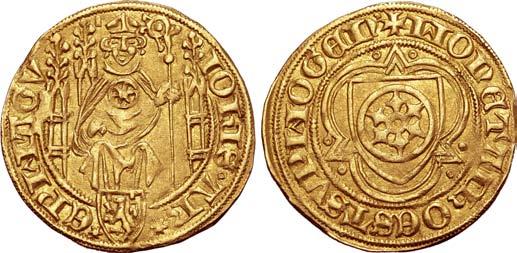
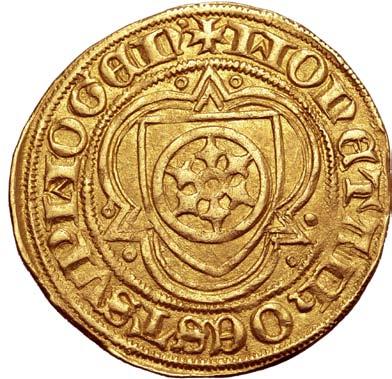
German States, Mayence (Mainz, Archdiocese). Johann II von Nassau AV Goldgulden. Höchst mint, 1404-1409. IOꞂIS ◦ ARЄP MAGV, Archbishop seated facing on throne, wearing mitre, holding crozier and with wheel on chest / ✠ MOꞂЄTA I ҺOЄST SVP MOGЄꞂ, shield-of-arms of Mayence within trilobe. Felke 701; Schlegel 25; Walther Coll. 110; Friedberg 1620. 3.52g, 22mm, 11h.
Extremely Fine.
Ex WAG Online oHG, Auction 115, 10 January 2021, lot 851.


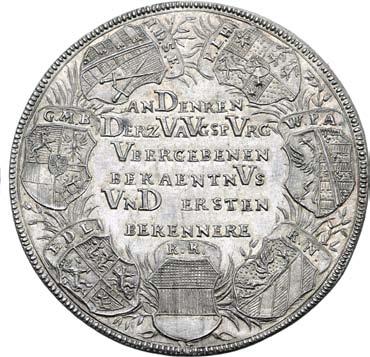
German States, Nürnberg (Free Imperial City) AR Medal. 1730. Struck for the 200th anniversary of the Augsburg Confession. Designs by Sigmund Dockler and Peter Paul Werner. Three city coats-of-arms surrounded by seven patriarchal coats-of-arms set on a wreath / AN DENKEN DERZ VA VGSP VRG VBERGEBENEN BERAENTNVS VND ERSTEN BERENNERE, (chronogram) in six lines within circle of seven coats-of-arms from the first seven signatories of the confession, set on wreath. Erlanger 1108; Whiting 430. 4.75g, 31mm, 12h.
Mint State; beautiful old cabinet tone. Rare.
Ex Dr. Busso Peus Nachfolger, Auction 426, 16 June 2020, lot 1011.




German States, Schwäbisch Hall (Free Imperial City) AV Ducat. In the name of Franz I (Holy Roman Emperor). Nuremberg mint, 1746. Dies by P.P. Werner; Carl Gottlieb Laufer, mintmaster. FRANCISCVS • D • G • ROM • IMP • SEMP • AVG •,
/ MONETA NOVA REIPUBLICÆ HALÆ SUEVICÆ,
Mint State;
Ex Heidelberger Münzhandlung Herbert Grün e.K., Auction 77, 12 November 2019, lot 1810.
664.


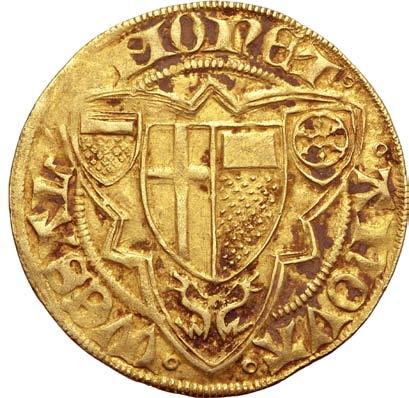
German States, Trier (Treves, Archdiocese). Werner von Falkenstein AV Goldgulden. Oberwesel mint, 1414-1417. WЄRꞂЄR’ ARЄP’ ∗ TRЄ’, St. John the Baptist standing facing, holding cross sceptre / ᙏONЄTA ꞂOVA WЄSAL’, shield-of-arms of Trier and Minzenberg in centre of trefoil, flanked by smaller shields-of-arms of Minzenberg and Mainz; two confronted dragon’s heads below. Noss 357; Felke 872; Friedberg 3424. 3.46g, 23mm, 7h. About Extremely Fine.
Ex collection of GK; Ex Auktionen Münzhandlung Sonntag, Auction 27, 27 November 2017, lot 1489.
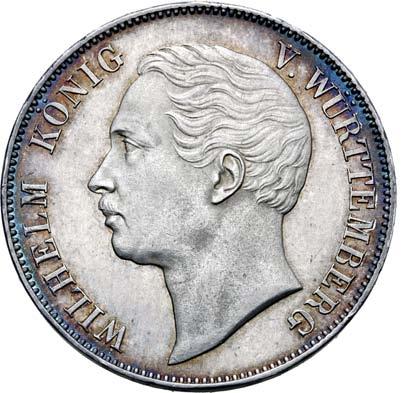
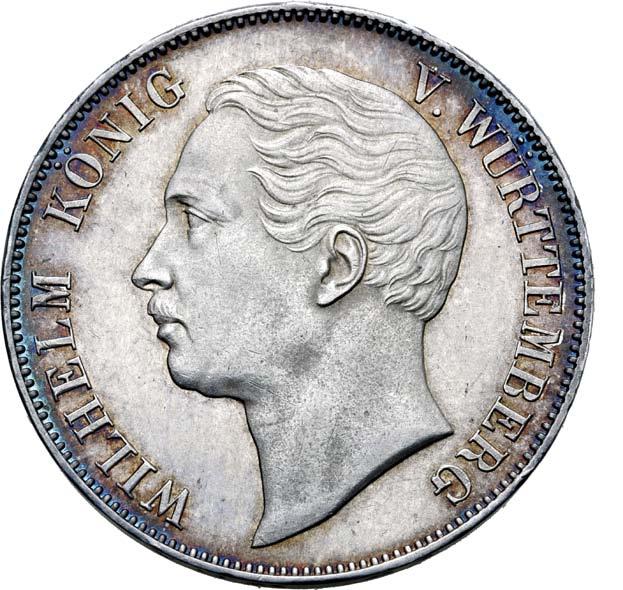

German States, Württemberg (Kingdom). Wilhelm I AR Vereinstaler. 1859. Designs by Carl Friedrich Voigt. WILLHELM KONIG V. WÜRTTEMBERG, bare head to left / EIN VEREINSTHALER ∗ XXX EIN PFUND FEIN, crowned and helmeted coat-of-arms held by crowned lion to left and stag to right; ribbon inscribed ‘furchtlos und trew’ below, date in exergue. Edge inscription: * MÜNZVERTRAG VOM 24 JANUAR 1857. KM 601; AKS 77. 18.45g, 33mm, 12h.
Near Mint State; attractive rainbow iridescence around edges.
Ex Dr. Busso Peus Nachfolger, Auction 426, 16 June 2020, lot 1131.



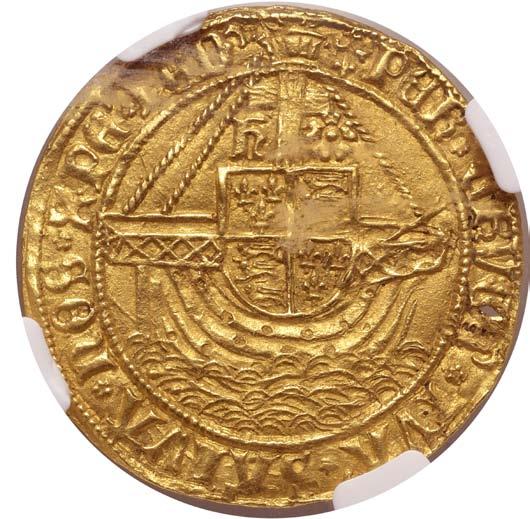
Great Britain, Tudor. Henry VII AV Angel. London (Tower) mint, 1504-1505. Class IV. (cross crosslet) hЄꞂRIC ⁑ DI⁑GRΛ’ x RЄX ⁑ ΛꞂGLIЄ’ ⁑ Z ⁑ FRΛ’, crowned, nimbate
NGC graded UNC Details, holed (#2124432-047).
Ex Sincona AG, Auction 75, 16 May 2022, lot 46 (hammer: CHF 6,000); Ex Spink, Auction 3014, 8 October 2003, lot 266; Ex L. A. Lawrence collection, Glendining & Co., 17 May 1950, lot 103.

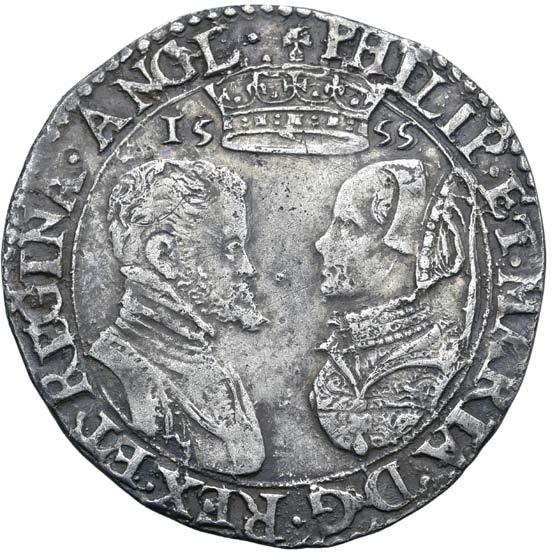
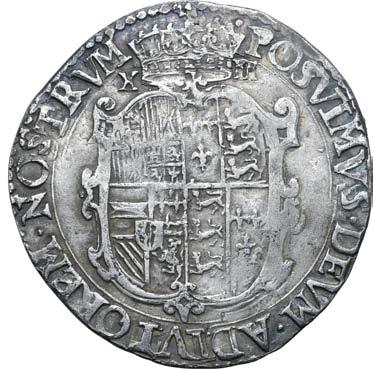
667.
Great Britain, Tudor. Philip and Mary Hammered AR Shilling. Tower (London) mint, 1555. ⚜ PHILIP • ET • MARIA • D • G • REX • ET • REGINA • ANGL •, bust of Philip to right, facing bust of Mary to left; crown dividing date above / POSVIMVS • DEVM • ADIVTOREM • NOSTRVM, coats-ofarms of Great Britain and Spain emblazoned on ornate escutcheon; crown dividing denomination above. SCBC 2501; North 1968. 5.71g, 31mm, 1h.
Good Very Fine; scattered marks, attractive cabinet tone. Ex Numisor SA, Auction 3, 17 October 2020, lot 331.


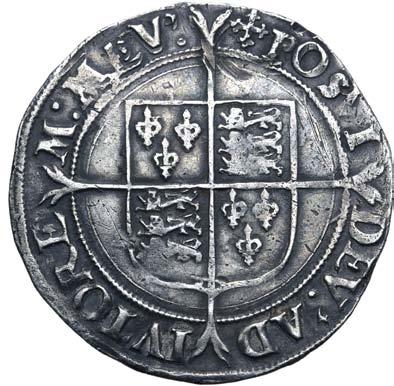
668.
600 No Reserve

Great Britain, Tudor. Elizabeth I AR Shilling. Second issue. Tower (London) mint, 1560-1561. ✠ ELIZABETH ⁝ D: G: AN’. FR’. ET• HIB’. REGINA, crowned bust to left, wearing ruffed collar / ✠ POSVI DEV’. ADIVTORE M: MEV’., coat-of-arms over long cross fourchée. SCBC 2555; North 1985. 5.82g, 33mm, 12h.
Extremely Fine; attractive light cabinet tone over lustrous metal.
300 No Reserve
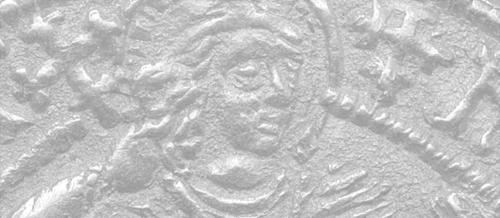



Great Britain, Tudor. Elizabeth I AV Angel. Tower (London) mint. Second ‘Restoration’ Coinage, Third and Fourth Issue, 1 November 1573 - 25 May 1574. (acorn over ermine) ELIZABETH : D ‘. G ‘. ANG .’ FR .’ ET : HI ‘ REGINA, the Archangel Michael slaying dragon with cross-pommelled lance / (acorn over ermine) A : DNO : FACTVM : EST : ISTVD : ET : EST : MIRABI .’ ship bearing coat-of-arms and cross over waves below; E - �� across fields. SCBC 2515; HCN 341; North 1991/2; Montagu -; Murdoch -; Lockett 4091 (this coin); Brown & Comber C12, and pl. IX (this coin; cf. Comber I, 15); Schneider I, 765 (the overmark unrepresented). 5.03g, 28mm, 7h.
NGC graded UNC Details, reverse graffiti, in limited edition black ‘Alderman Horace Hird’ holder (#6135299-006). Very Rare.
3,000 No Reserve
This coin published in I.D. Brown & C.H. Comber, Notes on the gold coinage of Elizabeth I (BNJ 59, 1989); Ex Alderman Horace Hird (1899-1973) Collection, with old collector’s ticket, Spink, Auction 21064, 28 September 2021, lot 5 (hammer: GBP 7,000); Ex “The Celebrated Collection formed by the late Richard Cyril Lockett Esq”, Glendining & Co., 26-27 April 1960, lot 4091 (hammer: GBP 130).
Brown and Comber record nine instances of this privy mark for this denomination (not accounting for duplication) as listed in the Spink Numismatic Circular and Seaby Bulletin between 1937 and 1983. Challis records the mint output for this Pyx Period at £8,143, the lowest for the Second Restoration Coinage.
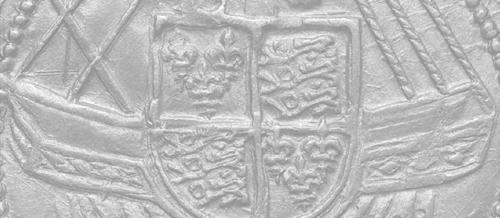
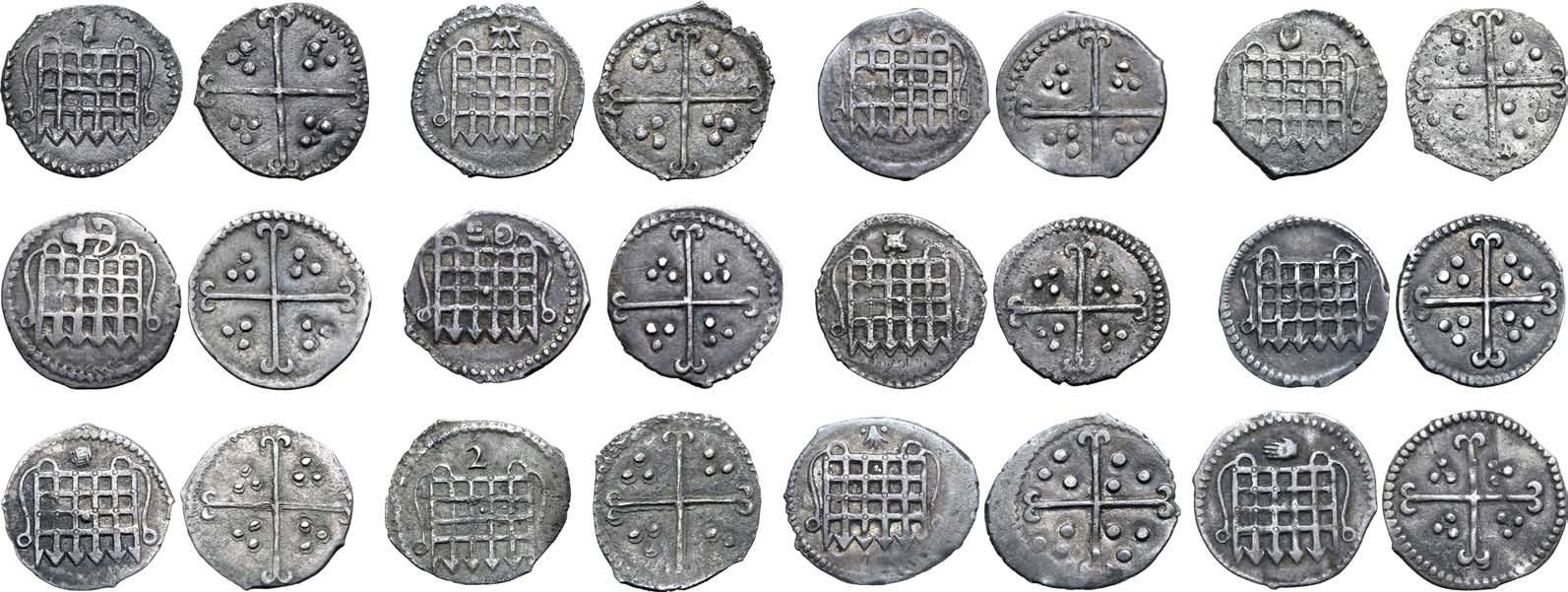
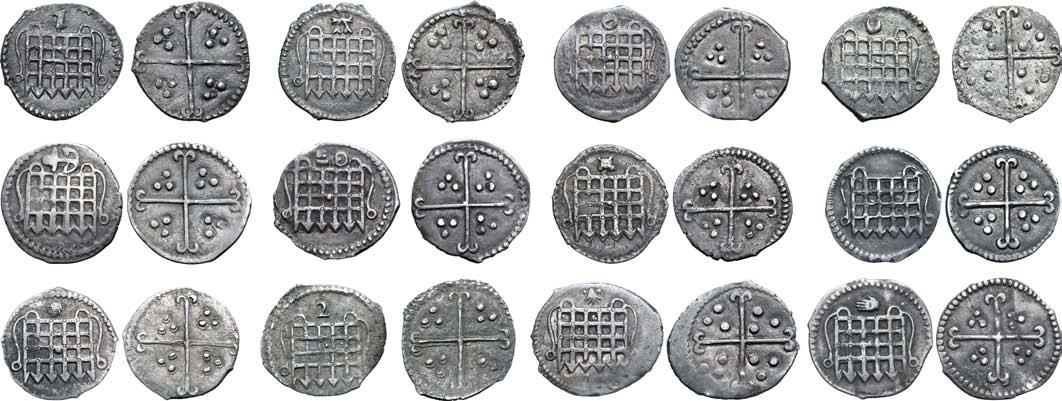
670.
Set of 12 Great Britain, Tudor. Elizabeth I AR Halfpennies. Tower (London) mint, 1582-1602. Sixth and Seventh issues. Portcullis; mintmark above / Cross moline; triple pellets in quarters. SCBC 2581 and 2588. Lot includes the following initial marks:
From the Sixth issue, 1582-1600:
No mintmark. (1582-1583)
A mintmark. (1582-1584)
Escallop mintmark. (1584-1586)
Crescent mintmark. (1587-1589)
Hand mintmark. (1590-1592)
Tun mintmark, (1592-1595)
Woolpack mintmark. (1594-1596)
Key mintmark. (1595-1598)
Anchor mintmark. (1598-1600)
0 mintmark. (1600)
From the Seventh issue, 1601-1602
1 mintmark. (1601-1602)
2 mintmark. (1602)
Lot sold as seen - no returns. A very difficult set to assemble, attractive examples.
Ex Arthur M. Fitts III Collection, Classical Numismatic Group, Auction 121, 6 October 2022, lot 1338; Ex Andrew Wayne Collection; Ex Classical Numismatic Group inventory 768310-768321 (March 2006); The Halfpennies with the hand and tun mintmarks are also ex R. Carlyon-Britton Collection.

671. 1,200 No Reserve
Fleur De Coin. In exemplary condition for the

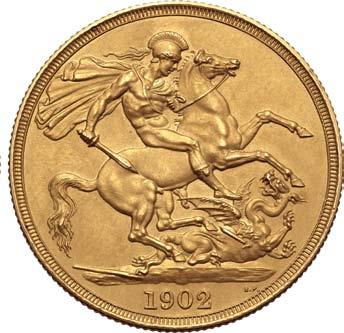
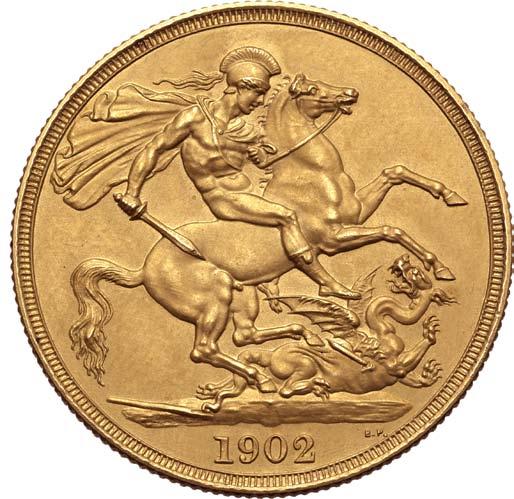
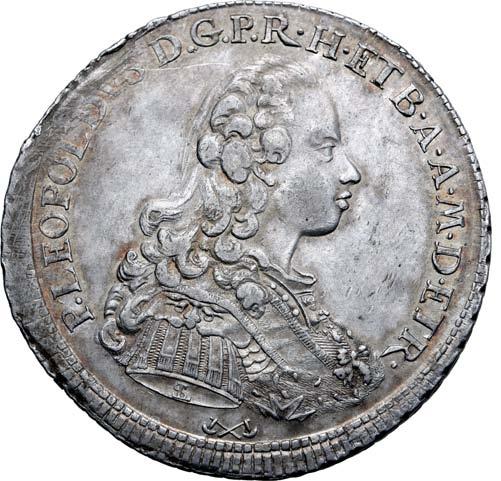
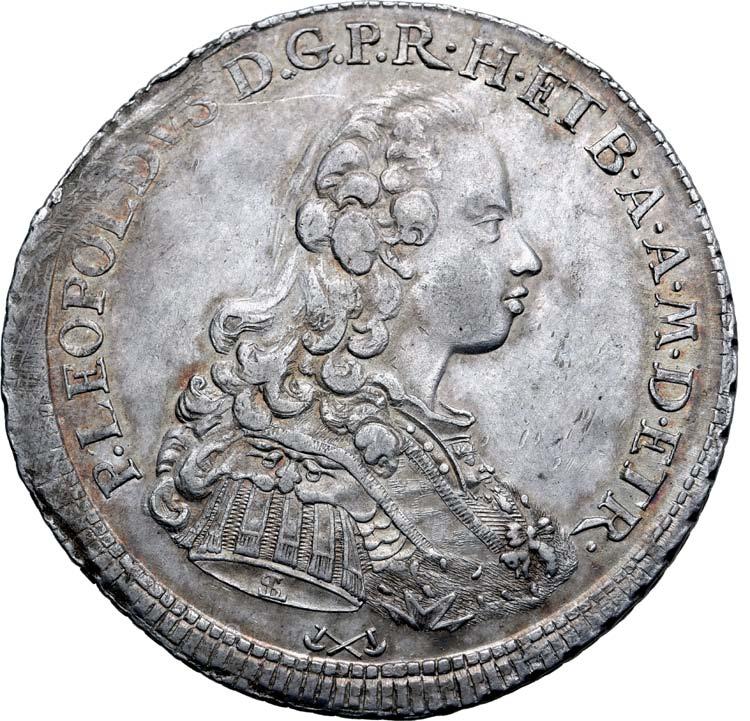
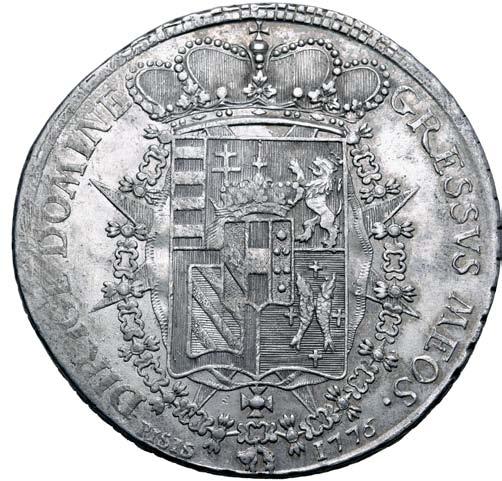
Italian States, Toscana (Tuscany, Grand Duchy). Pietro Leopoldo I di Lorena AR Francescone da 10 Paoli. Firenze (Florence) mint, 1776. Antonio Fabbrini, moneyer; Luigi Siries, die engraver. P • LEOPOLDVS D • G • P • R • H • ET B • A • A • M • D • ETR •, cuirassed bust to right; LS monogram below spaulder, crossed pikes below / DIRIGE DOMINE GRESSVS MEOS •, crowned arms superimposed on cross of St. Stephen, within collar of the Order of the Golden Fleece; PISIS and date below. Pucci 118; MIR 379/10; CNI -; Galeotti XIII, 23-4; Davenport 1514. 27.47g, 41mm, 6h.
Extremely Fine; pleasant light tone.
Ex Mike Ballerini Collection, Roma Numismatics Ltd., Auction XXIV, 28 March 2022, lot 1502 (collector’s ticket included).



Italian States, Toscana (Tuscany, Grand Duchy). Ferdinando III di Lorena AR Francescone da 10 Paoli. Firenze (Florence) mint, 1799. Francesco Grobert, moneyer; Luigi Siries, die engraver. FERDINANDVS • III • D • G • P • R • H • ET • B • A • A • M • D • ETRVR •, head to right; LS monogram and unicorn below / LEX TVA VERITAS •, crowned arms superimposed on cross of St. Stephen, within collar of the Order of the Golden Fleece; PISIS and date below. Pucci 63; MIR 405/8; Gigante 31; Davenport 1521. 27.42g, 42mm, 6h.
Good Extremely Fine. Very Rare.
Ex Mike Ballerini Collection, Roma Numismatics Ltd., Auction XXIV, 28 March 2022, lot 1572 (collector’s ticket included).

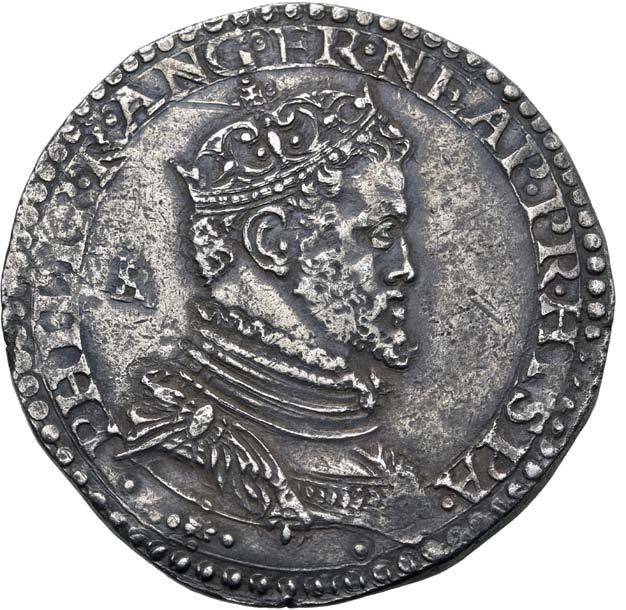

Italian States, Napoli (Naples, Kingdom). Filippo II di Spagna AR Mezzo Ducato. 1st phase, as King of England, France and Naples, and Prince of Spain. Giovanni Battista Ravaschiero, mintmaster. 1554-1556. PHILIP • R • ANG • FR • NEAP • PR • HISPA •, crowned, draped and cuirassed bust to right; IBR monogram behind / POSVIMIVS • DEVM •ADIVTOREM • NOST, crowned conjoined royal coat-of-arms of England and Spain emblazoned on ornate escutcheon. MIR 3; CNI XX pg. 19, 153; Pannuti 3. 14.60g, 35mm, 5h.
Near Extremely Fine; typical spots of flat strike, deep old cabinet tone.
Ex David Freedman Collection; Ex Classical Numismatic Group, Auction 67, 22 September 2004, lot 1954.
676.
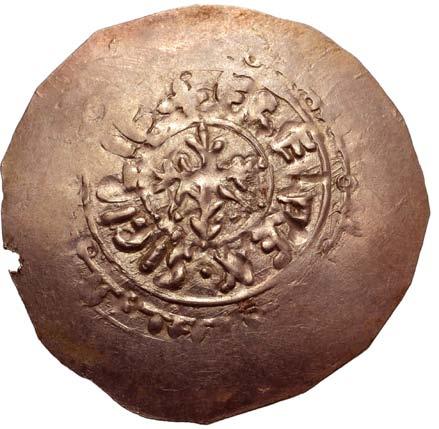



Italian States, Sicilia (Sicily, Kingdom). Frederick I (later Frederick II, Holy Roman Emperor) and Constance as Empress of the Holy Roman Empire, AV Tari. Amalfi mint, November 1198. Outer circle Kufic legend: ‘struck in his reign in the year five hundred ninety-five’; inner circle Latin legend: ⧾ FRE REX SICILIE around palm tree in fruit in central circle / Outer rim Kufic legend: ‘struck in the year one-hundred one-thousand ninety and eight; inner rim Kufic legend: ‘Constance imperatrix of the Romans’, around Latin cross in central circle. L. Travaini, ‘Le monete Sveve con legend arabe nel Regno di Sicilia (1194-1220)’ in RIN 1986, p.136, 2; MIR 36; MEC 14, p.166 fig. 3b; CNI XVII, p.10, 1, pl. 1, 14; G. Sambon, Repertario generale, 1113; M. Guglielmi, La monetazione degli Svevi nell’Italia meritionale, Serravalle RSM, 2000, p.67, 1; D. Spinelli, Monete cufiche, Napoli 1844, pl. 20, 1; R. Levinson, The Early Dated Coins of Europe 1234-1500, Clifton 2007, p.258; Friedberg 51. 0.83g, 24mm. Mint State; edge clipped. Very rare and of great numismatic importance.
1,800 No Reserve
This remarkable scyphate-shaped tari bears two dates: Hegira 595 and Christian era 1198, the earliest Anno Domini date ever recorded on a coin, which according to Philip Grierson and L. Travaini commemorates the investiture formally granted to Frederick II and Constance by Pope Innocent III on 19 November of that year. In return the pope received an annual cens of 1,000 ‘schifati’, cf. MEC pp.165-6.
Amalfi was an independent republic from the 7th century that managed to extract itself from Byzantine vassalage in 839 and first elected an independent duke in 958. By 944 Amalfitan merchants were already present at Constantinople, trading with Egypt by the late 10th century and rivalling Pisa and Genova in its domestic prosperity and maritime trade with Asia before the rise of the Venice. In 1073 the republic fell to the Norman countship of Apulia and was granted many rights and attained great wealth. In about 1080, Amalfitans founded a hospice for pilgrims in Islamic occupied Jerusalem, from which the Order of the Hospital (St. John of Jerusalem) later developed. Under Roger II in 1131, Amalfi passed into the kingdom of Sicily and by 1220 the Empire of Frederick II. In matters of medieval culture, Amalfi was famous for its multiculturalism, flourishing schools of law and mathematics, maritime code and the reputed Amalfitan Flavio Gioia, who in about 1300 was considered the first marine pilot to have introduced the sailor’s compass to Western navigation.
The date on the Amalfi tari must be connected to the fact that Islamic coinage had been dated from the time of the 5th Caliph, ‘Abd al-Malik in the 77th year of the Hagira, the migration of Muhammad and his followers from Mecca to Yathrib in AD 696/7. Amalfi had been within the Islamic monetary sphere strongly influenced by the Emirate of Sicily since the 10th century, in which the standard gold unit was the gold Tarì (meaning “fresh” or “newly minted money”), the Christian designation of Ruba’i or quarter Dinar with the ideal weight of 1.05g of gold.
The idea that coins should bear a date of issue referencing the time passed since the birth of Christ was not widespread in Europe until the mid 16th century. While the learned Scythian monk, Dionysus Exiguus from Tomis, formulated the Anno Domini calendar in the 6th century and is still used to enumerate the years of both the Julian and Gregorian calendars, it was not until the advent of this issue in 1198 that European coinage was so dated. This dating system was not utilised again until 1234 by the bishopric of Roskilde on its silver deniers and in 1251 in Arabic script on the Islamic-styled silver coinage by the crusader city of Acre. In the spring of 1250 the papal legate Odo of Châteauroux arrived in Syria and was scandalised to learn that the Franks were striking gold and silver coins with the name and dates of the Muslim Prophet and had them substituted with purely Christian legends and dates in the name of the Messiah, albeit written in Arabic to maintain acceptability in the region. Much later from 1372 dated groschen in the name of Charlemagne were struck on a regular basis at Aachen.
Frederick II, son of Holy Roman Emperor Henry VI of the Hohenstaufen dynasty and Constance the posthumous daughter of Roger II de Hauteville and heiress to the Norman kings of Sicily, was an infant of only three years of age when his father died and was crowned king of Sicily on papal authority at Palermo cathedral on 17 May 1198. Frederick’s minority under his mother only lasted five months as the regent died on 27 November 1198.




Italian States, Sicilia (Sicily, Kingdom). Frederick I (later Frederick II, Holy Roman Emperor) and Constance as Empress of the Holy Roman Empire, AV Tari. Amalfi mint, November 1198. Outer circle Kufic legend: ‘struck in his reign in the year five hundred ninety-five’; inner circle Latin legend: ⧾ FRE REX SICILIE around palm tree in fruit in central circle / Outer rim Kufic legend: ‘struck in the year one-hundred one-thousand ninety and eight; inner rim Kufic legend: ‘Constance imperatrix of the Romans’, around Latin cross in central circle. L. Travaini, ‘Le monete Sveve con legend arabe nel Regno di Sicilia (1194-1220)’ in RIN 1986, p.136, 2; MIR 36; MEC 14, p.166 fig. 3b; CNI XVII, p.10, 1, pl. 1, 14; G. Sambon, Repertario generale, 1113; M. Guglielmi, La monetazione degli Svevi nell’Italia meritionale, Serravalle RSM, 2000, p.67, 1; D. Spinelli, Monete cufiche, Napoli 1844, pl. 20, 1; R. Levinson, The Early Dated Coins of Europe 1234-1500, Clifton 2007, p.258; Friedberg 51. 0.86g, 27mm.
Mint State; area of flat striking. Very rare and of great numismatic importance.
1,800 No Reserve
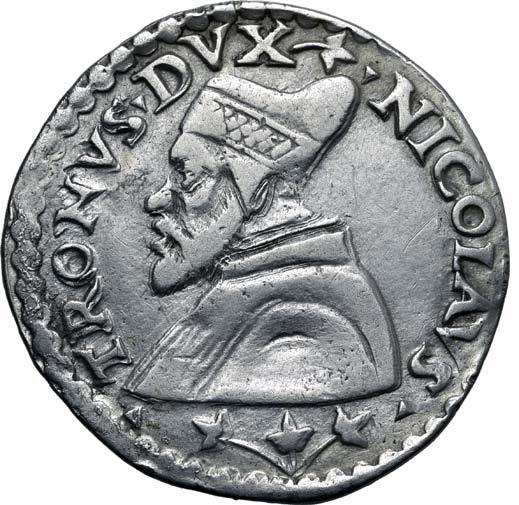



Good Very Fine.
No lot. 678.
300 No Reserve


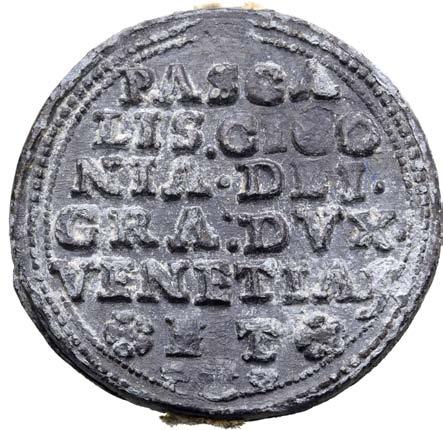
679.
Italian States, Venezia (Venice, Republic). Pasquale Cicogna PB Bolla. Doge LXXXVIII, 1585-1595. PASC • CICONIA ∗ DVX S • M • VENET ∗, St. Mark standing to right on left, holding Gospels and
•
•
•
Extremely Fine. Rare.
680. 150 No Reserve
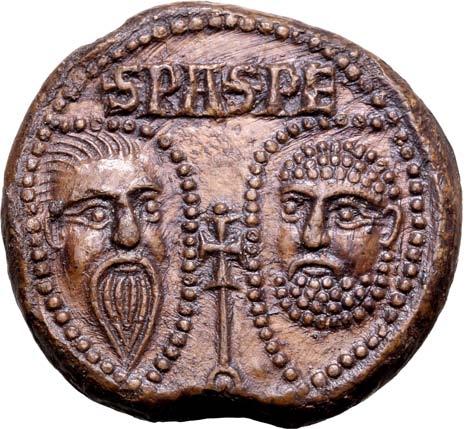


Extremely Fine; well centred, with a warm brown patina.

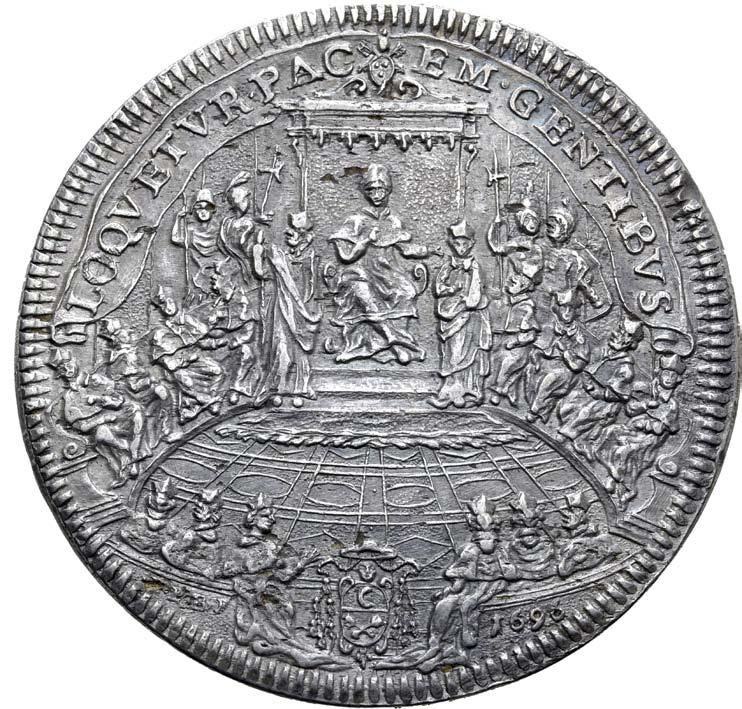

681.
Italian States, Stato Pontificio (Papal States). Innocent XII AR Piastra. Rome mint, 1696. Mons. Maffeo Farsetti, mintmaster; dies by Ferdinand de Saint Urbain. INNOCEN • XII • PONT • MAX • ANN • VI, capped bust to right, wearing mozzetta and stola; • S•V• on truncation / LOQVETVR • PACEM • GENTIBVS on banner above Pope enthroned in consistory; Farsetti arms below, flanked by P · P · B · F on left and date on right. MIR 2129/2; Muntoni 21; Berman 2228. 32.10g, 45mm, 12h.
Extremely Fine. Very Rare.
Purchased from Studio Numismatico Eugubium.
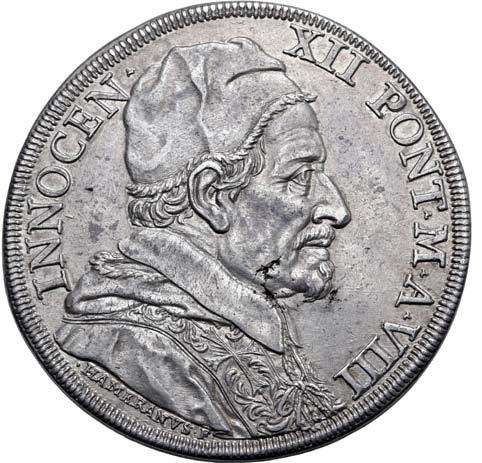
682.
600 No Reserve

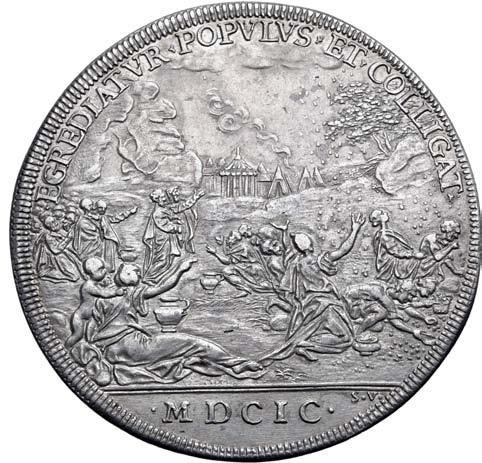
Italian States, Stato Pontificio (Papal States). Innocent XII AR Piastra. Rome mint, 1699. Dies by Giovanni Hamerani; Ferdinand de Saint Urbain, mintmaster. INNOCEN · XII PONT · M · A · VIII (triskeles stops), capped bust to right, wearing mozzetta and stola, • HAMERANVS • F • below / EGREDIATVR · POPVLVS · ET · COLLIGAT · (triskeles stops), Israelites gathering manna; S.V. to right below exergual line, • MDCIC • in exergue. MIR 2132/2; Muntoni 17; Berman 310; Davenport 4108. 31.23g, 45mm, 12h.
Extremely Fine. Very Rare.
Ex Centauro srl, Auction 2, 16 June 1998, lot 711.
683. 750 No Reserve
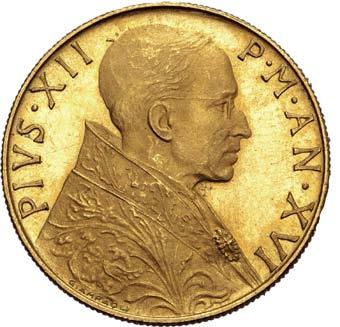


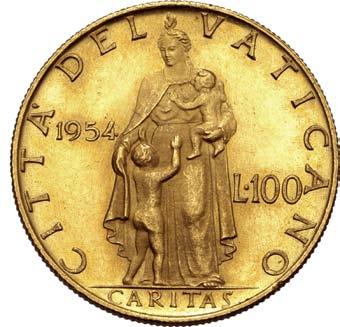
Italian States, Stato Pontificio (Papal States). Pius XII AV 100 Lire. Rome mint, dually dated RY 16 and 1954. PIVS • XII P • M • AN • XVI, bust to right, wearing mantum and zucchetto / CITTA’ DEL VATICANO, Caritas (Charity) standing facing, holding infant, with child at feet; date and denomination across fields, CARITAS in exergue. Pagani 720; Jencius 103; Muntoni 4c; Berman 3404; KM 53.1; Friedberg 290. 5.21g, 21mm, 6h. Mint State. With original presentation booklet.


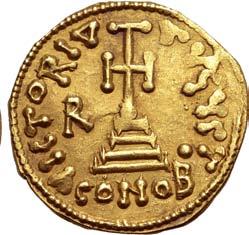

684.
Lombard Kingdom, Beneventum. Romoald II AV Solidus. In the name of Justinian II, AD 706-731. D N IVSTINVNVS P P, crowned and bearded bust facing, wearing chlamys, holding globus cruciger / VICTORIΔ AVGЧST, cross potent on globe set on four steps; R to left, • to lower right, CONOB in exergue. LCSI 22; MIR 148; MEC 1087; CNI pp. 120-4, 1-36; BMC Vandals 156, 3-6. 3.88g, 21mm, 6h.
Near Extremely Fine.
Ex Roma Numismatics Ltd., Auction XXII, 7 October 2021, lot 900; Ex Artemide Aste s.r.l. (San Marino), Auction XLVIII, 2 December 2017, lot 483.


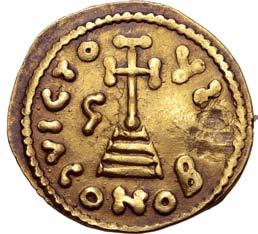

Lombard Kingdom, Beneventum. Gottschalk AV Solidus. In the name of Leo III. AD 739-742. D N LЄO P P, crowned and bearded bust facing, wearing chlamys and holding globus cruciger / VICTO YS [✶], cross potent on globe set on four steps; G to left, CONOB in exergue. LCSI 30b (this coin); MIR 159; MEC -; CNI p. 137, 16-17. 3.94g, 21mm, 6h.
Near Extremely Fine; minor metal flaw on rev. Very Rare.
This coin published in A. D’Andrea and C. Moretti, The Lombards’ coins of Southern Italy (Edizioni D’Andrea, 2014); Ex Roma Numismatics Ltd., Auction XXII, 7 October 2021, lot 902; Ex Numismatica Ars Classica AG, Auction 56, 8 October 2010, lot 556.



Lombard Kingdom, Beneventum. Liutprand AV Tremissis. In the name of Justinian
Extremely Fine. Extremely Rare.
This coin published in M. Chimienti and F. Raposelli, Italia meridionali continentali, Zecche minori (Pavia, 2010); Ex Roma Numismatics Ltd., Auction XXII, 7 October 2021, lot 904; Ex Numismatica Ars Classica AG, Auction 93, 24 May 2016, 1331 (interregnum); Ex Numismatica Ars Classica AG, Auction 20, 2-3 November 2000, lot 43; Ex Numismatica Ars Classica AG, Auction 10, 9 April, 1997, lot 793.
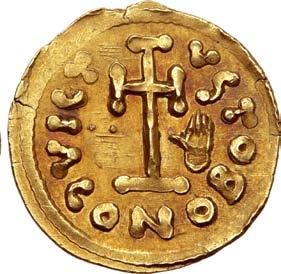
687.
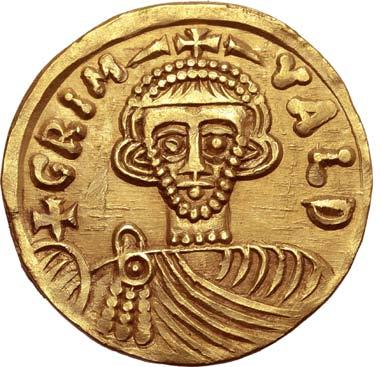

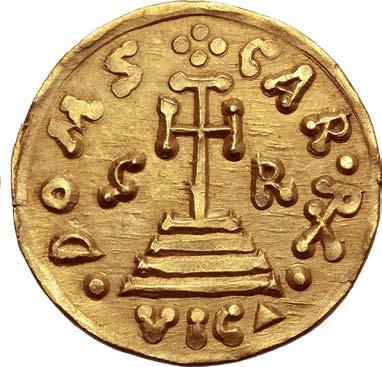
Lombard Kingdom, Beneventum. Grimoald III and Charlemagne AV Solidus. AD 788-792. GRIM - ⧾ - VALD, crowned and bearded bust facing, wearing chlamys and holding globus cruciger / • DOMS (four pellets) CAR • RX • , cross potent on three steps; G-R across fields, VICA in exergue. LCSI 60; MIR 186; CNI p. 154, 3-5; BMC Vandals p. 171, 3-5; Depeyrot 141B. 3.87g, 21mm, 6h.
Extremely Fine. Very Rare.
Ex Bertolami Fine Arts - ACR Auctions, Auction 87, 14 December 2020, lot 646.
Grimoald was the younger son of Arichis II and the first duke to place his full name on the coinage of Beneventum. From 788-792 he was a vassal of the Frankish king Charlemagne and together they defeated the Byzantines in Sicily. In 792 he made a bid for independence and replaced his title of Dux with Princeps.

688.


Lombard Kingdom, Beneventum. Grimoald III AV Solidus. 792-806. GRIMVALD, crowned and draped bust facing, holding globus cruciger / VICTORA ❖ PRINCIP, cross potent on globe set on three steps; two triangles flanking base; G-R across fields, C•ONO•B (retrograde) in exergue. LCSI 68; MIR 199; MEC 1101; CNI pp. 156-7, 22-8; Oddy 457 = BMC Vandals p. 172, 11, pl. 23, 8. 3.85g, 21mm, 7h.
Good Very Fine. Very Rare.

689.
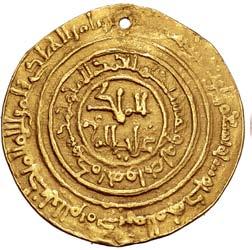
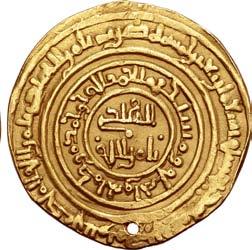

North Africa (Norman Kingdom). William I AV Dinar. Mahdia mint, dated AH 549 = AD 1154/5. Kufic legend outer circle: ‘Struck by order of the guide according to the command of God, King William, in the city of Mahdia in the year 549’; inner circle: ‘Praise be to God, it is fitting to praise Him and, He is deserving and worthy [of praise]’; centre: ‘King William’ / Kufic legend: outer and inner circles as obverse; centre: ‘the Guide according to the command of God’. For the only other known specimen see J. Rodriguez Lorente and T. Ibrahim, Numismatica de Ceuta Musulmana, Madrid, 1987, 221 = J. Johns, ‘Malik Ifriquya: The Norman Kingdom of Africa and the Fatimids’, Libyan Studies 18, 1987, pp. 92-4 = MEC 14, p. 120 = H. AbdulWahab, ‘Deux dinar normands de Mahdia’, Revue Tunisienne 1930, 1/3-4: pp. 215-218 and plate. 4.08g, 24mm, 6h.
Good Very Fine; contemporary piercing. Of the greatest rarity - the second recorded example.
Ex Roma Numismatics Ltd., Auction XVIII, 29 September 2019, lot 1364.
Roger (Roger) II, who became King of Sicily in 1130, made his kingdom the dominant power in the Mediterranean, thanks to a powerful fleet led by capable several admirals. He then made a series of conquests on the African coast, ranging from Tripoli (Libya) to Cape Bon (Tunisia) and Bona (Algeria) creating a Sicilian “protectorate”, supported in part by the remaining small Christian-Byzantine community still present in North Africa. In 1146 the Norman king took advantage of the internal troubles within Tripolitania to take, along with Admiral George of Antioch, the city of Tripoli and the coastal region of Sirte and in 1148 Mahdia, the ancient Roman city of Aphrodisium. From then on, the authority of the King of Sicily was established on a permanent basis. This authority did not aim at political domination, he was only interested in economic and strategic advantages: both immense. In 1154 William I inherited this small Norman ‘empire’ along the Ifriqiya coast to the borders of the Sahara as far as Gafsa. The local sheikhs submitted to the authority of the new king of Sicily, who tried to promote new Christian settlements in the region in order to protect the modest Christian population already existing. However, in 1156 Sfax was lost followed by Mahdia in 1160 to the Berber Muwahhidun, (‘the monotheists’ or ‘unifiers’), commonly known as the Almohads.


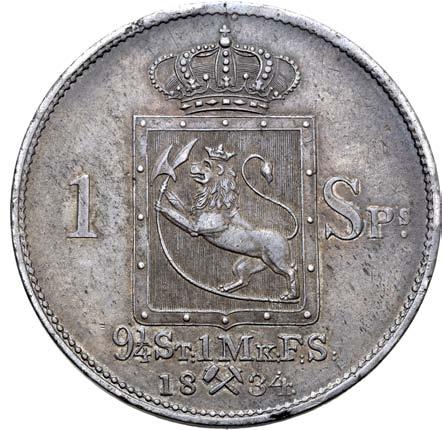
Norway, Kingdom. Karl XIV Johan AR Speciedaler. Kongsberg mint, 1834. CARL XIV JOHAN, NORGES SVER • G • OG V • KONGE •, bareheaded and draped bust to right / Crowned coat-of-arms; denomination across fields, value, mintmark and date below. KM 301; Davenport 241; Ahlström 12. 28.84g, 36mm, 12h.
Good Extremely Fine; attractive cabinet tone.
Ex Fritz Rudolf Künker GmbH & Co. KG, Auction 261, 11 March 2015, lot 5819.
690. 691.



900
No Reserve
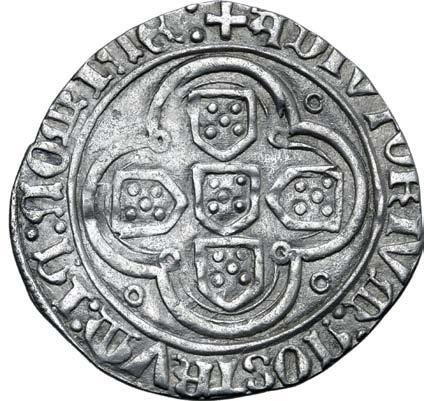
Portugal, Kingdom. Alfonso V AR Real Grosso - 24 Reais brancos. Lisboa (Lisbon) mint, circa 1457. ✠ ADIVTORIVᙏ : ꞂOSTRVᙏ : IꞂ : ꞂOᙏIꞂE, crowned ALFO between annulets; mintmark L below / ✠ ADIVTORIVᙏ : ꞂOSTRVᙏ : IꞂ : ꞂOᙏIꞂE :, five shields within quatrefoil tressure; annulet in each angle. Gomes 25.17; cf. MEC 6, 1004. 2.69g, 26mm, 12h.
Extremely Fine. Very Rare.
Ex Don Ferrante Collection, Roma Numismatics Ltd., E-Sale 73, 23 July 2020, lot 1407.

692.
600
No Reserve
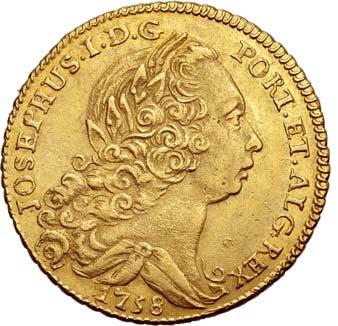


Portugal, Kingdom. José I AV 6400 Reis. Lisboa (Lisbon) mint, 1758. JOSEPHUS • I • D • G • PORT • ET • ALG • REX, laureate and draped bust to right / Crowned ornate coat-of-arms. Gomes 53.09; KM 240; Friedberg 101. 14.41g, 31mm, 12h.
Near Extremely Fine.
Ex Vitangelo Collection, Roma Numismatics Ltd., Auction XX, 30 October 2020, lot 1010.
300 No Reserve
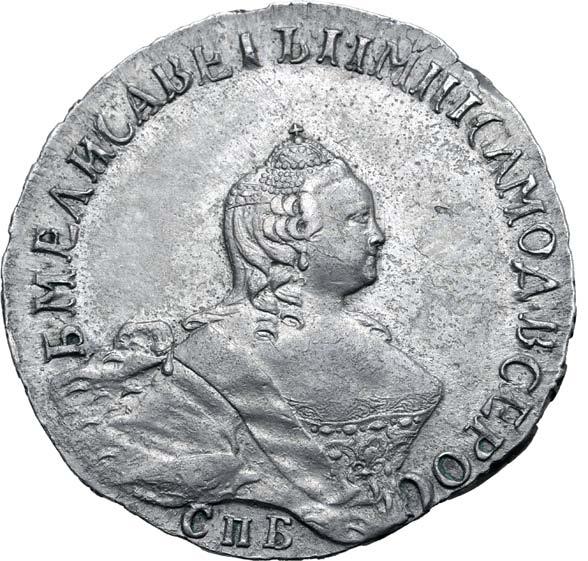
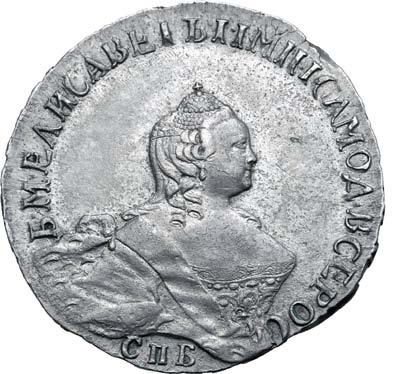

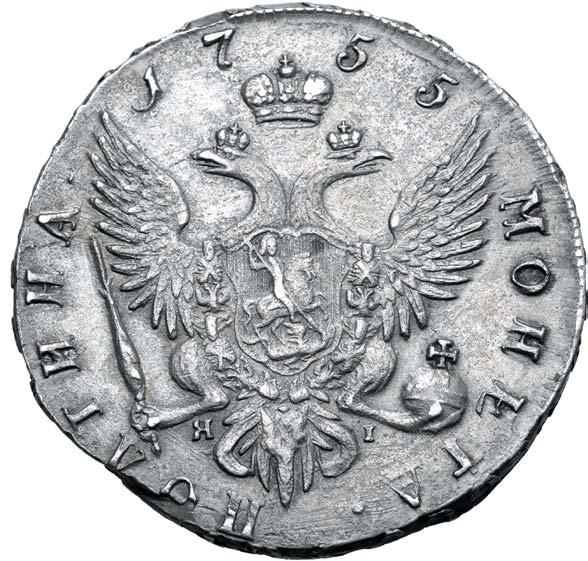
693.
Russia, Empire. Elizabeth AR Poltina (50 Kopeck). St. Petersburg mint, 1755. Б • М • ЕЛИСАВЕТЪ • I • IМП : I САМОД : ВСЕРОС :, crowned and draped bust to right; СПБ below / Crowned double-headed eagle facing with wings spread, wearing shield on breast depicting St. George slaying the dragon, and holding sceptre and orb; crown above, Я-I across lower fields, denomination and date around. Edge inscription: C.ПЕТЕРБƔРХСКАГО ✿✿ МOHETHAГO ✿ ДВОРА. Bitkin 325. 12.69g, 32mm, 12h.
NGG graded AU Details, tooled (#6945783-003). Traces of historical cleaning. Very Rare.
Ex Roma Numismatics Ltd., The GK Collection Part II, 24 March 2023, lot 73.

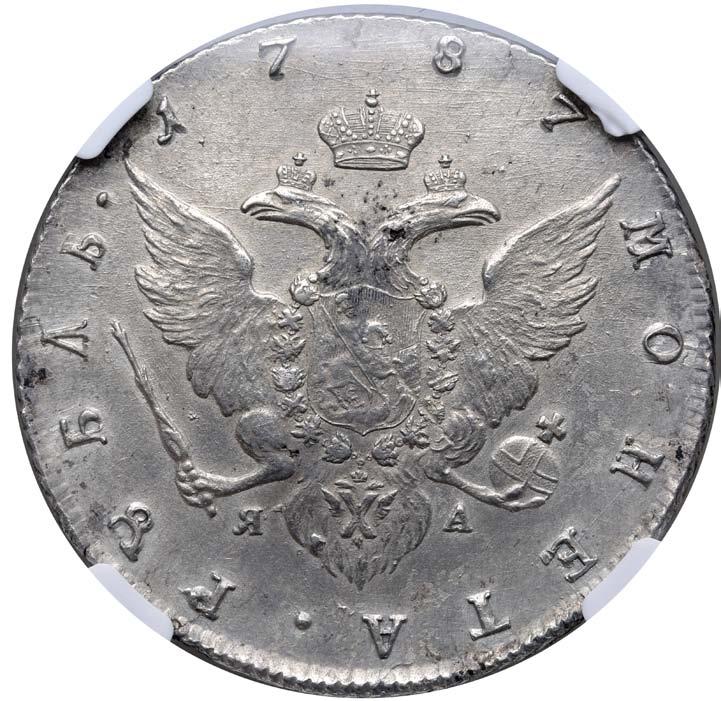

300
694.
Russia, Empire. Catherine II AR Rouble. St. Petersburg mint, 1787. Yakov Afanasyev, mintmaster. Б • М • ЕКАТЕРИНА • II • ІМП • ИСАМОД • ВСЕРОСC •, crowned and draped bust to right; СПБ below / Crowned double-headed eagle facing with wings spread, wearing shield on breast depicting St. George slaying the dragon, and holding sceptre and orb; crown above, Я-A across lower fields, denomination and date around. Bitkin 244. 22.94g, 39mm, 12h.
NGC graded AU Details, cleaned (#6674751-006).
Ex GK Collection (France) of Russian Coins.

695.
300

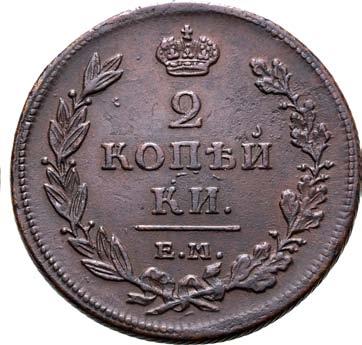
Russia, Empire. Alexander I CU 2 Kopeck. Ekaterinburg mint, 1812. Crowned double-headed eagle facing with wings spread, wearing shield on breast depicting St. George slaying the dragon, and holding sceptre and orb; crown above, H-M across lower fields, date below / Denomination above E.M.; crown above, wreath around. Bitkin 352. 13.50g, 29mm, 12h.
NGC graded AU Details (burnished), #6945783-001. Very Rare with the milled edge in this year’s 2 Kopeck issue; only two others on CoinArchives sold for EUR 1,200 (Peus 427, 2020), EUR 1,100 (Leipziger Münzhandlung und Auktion Heidrun Höhn, 2014).
120
Ex Roma Numismatics Ltd., The GK Collection Part II, 24 March 2023, lot 344.

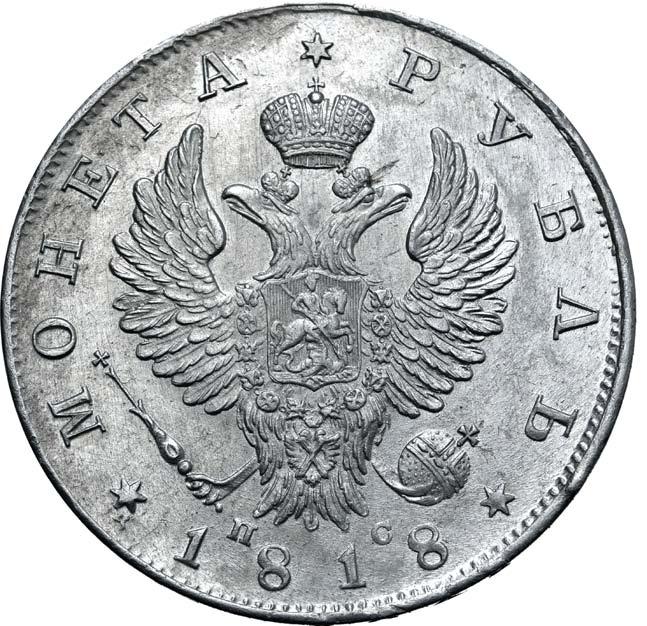

696.
Russia, Empire. Alexander I AR Rouble. St. Petersburg mint, 1818. Crowned double-headed eagle facing with wings spread, wearing shield on breast depicting St. George slaying the dragon and holding sceptre and orb; crown above, П-C across lower fields, denomination and date around / Issuing body and denomination in four lines, C.П.Б. below; crown above, wreath around. Edge inscription: • СЕР • 83 1/3 ПРОБЫ 4 ЗОЛ • 82 14/25 ДОЛИ. Bitkin 124. 20.52g, 35mm, 11h.
NGC graded UNC Details, cleaned (#6945783-002).
Ex Roma Numismatics Ltd., The GK Collection Part II, 24 March 2023, lot 358.

697.
300


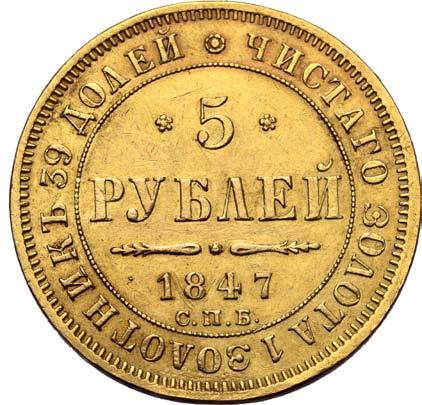
Russia, Empire. Nicholas I AV 5 Rouble. St. Petersburg mint, 1847. Crowned double-headed eagle facing with wings spread, wearing shield on breast depicting St. George slaying the dragon, with shields arranged across wings, and holding sceptre and orb; crown above, А-Г across lower fields / ✿ ЧИСТАГО ЗОЛОТА 1 ЗОЛОТНИКЪ 39 ДОЛЕЙ, denomination over date, С. П. Б. below; two flowers across upper fields. Bitkin 29. 6.52g, 23mm, 12h.
Good Extremely Fine; altered surface.
Ex Roma Numismatics Ltd., The GK Collection Part II, 24 March 2023, lot 479.



300
Russia, Empire. Nicholas I AR Rouble. St. Petersburg mint, 1847. ✸ ЧИСТАГО СЕРЕБРА 4 ЗОЛОТНИКА 21 ДОЛЯ, crowned double-headed eagle facing with wings spread, wearing shield on breast depicting St. George slaying the dragon, with shields arranged across wings, and holding sceptre and orb; crown above, П-A across lower fields / Denomination over date, C.П.Б. below; crown above and wreath around. Edge inscription: • СЕР • 83 1/3 ПРОБЫ 4 ЗОЛ • 82 14/25 ДОЛИ. Bitkin 212.
NGC graded AU 58 (#6672958-010).
Ex Roma Numismatics Ltd., The GK Collection Part II, 24 March 2023, lot 481; Ex Sincona AG, Auction 63, 8 June 2020, lot 1799.
150
699.



Russia, Empire. Nicholas II AR Rouble. Coronation commemorative issue. St. Petersburg mint, 1896. ★ Б. М. НИКОЛАЙ II ИМПЕРАТОРЪ И САМОДЕРЖЕЦЪ ВСЕРОСС ★, bare head to left; КОРОНОВАНЪ ВЪ МОСКВѢ 1896 Г. below / Crown with ribbons over sword and sceptre in saltire with orb at centre; denomination above, laurel and oak wreath around. Edge inscription: ЧИСТАГО СЕРЕБРА 4 ЗО ЛОТНИКА 21 ДОЛѦ (А•Г). Bitkin 322. 19.96g, 33m, 12h.
NGC graded UNC Details, obv. cleaned (#6945784-001). A spectacular example that compares very favourably with an example sold in January 2022 (Heritage NYINC Signature Sale 3098, lot 34336) for USD 16,000.
Ex Roma Numismatics Ltd., The GK Collection Part II, 24 March 2023, lot 641.

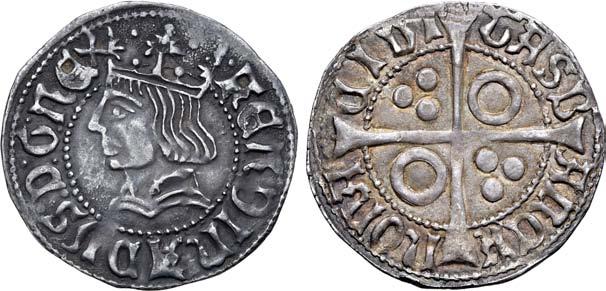

700.
Spanish States, Catalonia (Principality). Ferdinand II AR Croat. Barcelona mint, 1479-1516. FERDINADUS : D : G : REX, crowned bust to left / CIUITAS BARCKNONA, long cross; annulets and three bezants in alternating quarters. MEC 255. 3.20g, 25mm, 11h.
Good Very Fine.
Ex Brian Henry Grover Collection, Roma Numismatics Ltd., E-Sale 72, 25 June 2020, lot 1879.

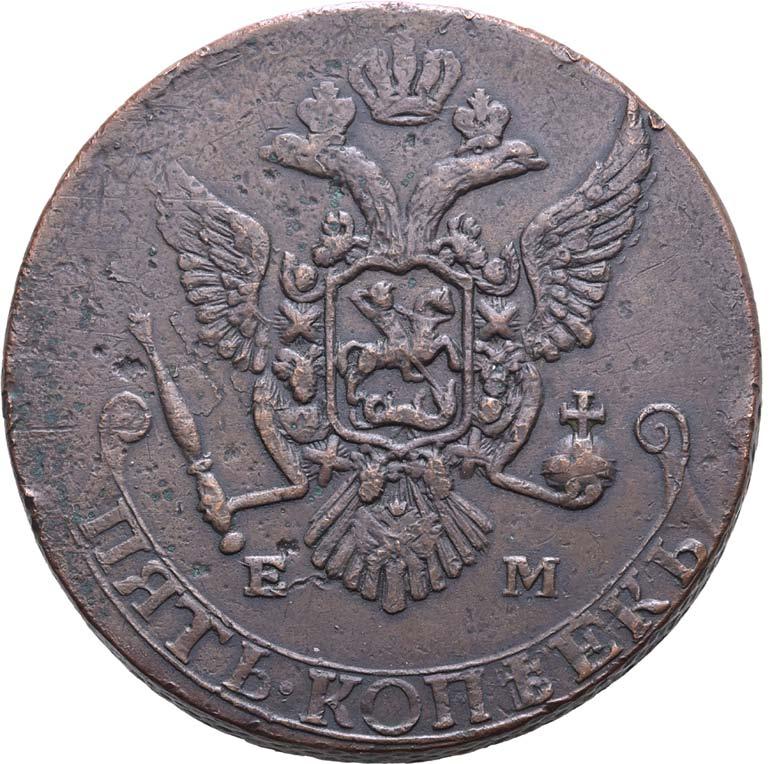

701.
Sweden, Kingdom. Gustav III CU 5 Kopeck. Avesta mint, 1788. Crowned double-headed eagle facing, wearing shield on breast depicting St. George slaying the dragon, and holding sceptre and orb; crown above, E-M across lower fields, denomination in scroll below / Crowned monogram within wreath; false date across fields. Bitkin Φ1288. 53.25g, 43mm, 12h.
Extremely Fine. Extremely Rare.
Ex collection of GK; Ex Fritz Rudolf Künker GmbH & Co. KG, Auction 113, 21 June 2006, lot 2503.
This extremely rare coin was part of a secretive issue minted in the Swedish town of Avesta in 1788, which the Swedes attempted to pass off as authentic Russian coins. The issue was intended for use by Swedish troops, who were at that time engaged in a war with the Russian Empire and who had need for coinage to pay Russian workers they had contracted on the border. The issue was minted with three different dates - 1764, 1778 and 1787to avoid any suspicion that might arise from large numbers of coins from the same year turning up in one place.



Switzerland, Bern AR Taler. 1835. REPUBLICA BERNENSIS, crowned coat-of-arms / DOMINUS PROVIDEBIT, Swiss landsknecht standing facing, holding sword; date below. Divo/Tobler 30; HMZ 2-230c; KM 199. 29.01g, 41mm, 6h.
Extremely Fine; beautiful old cabinet tone.
Ex Vitangelo Collection, Roma Numismatics Ltd., E-Sale 75, 20 October 2020, lot 1679.

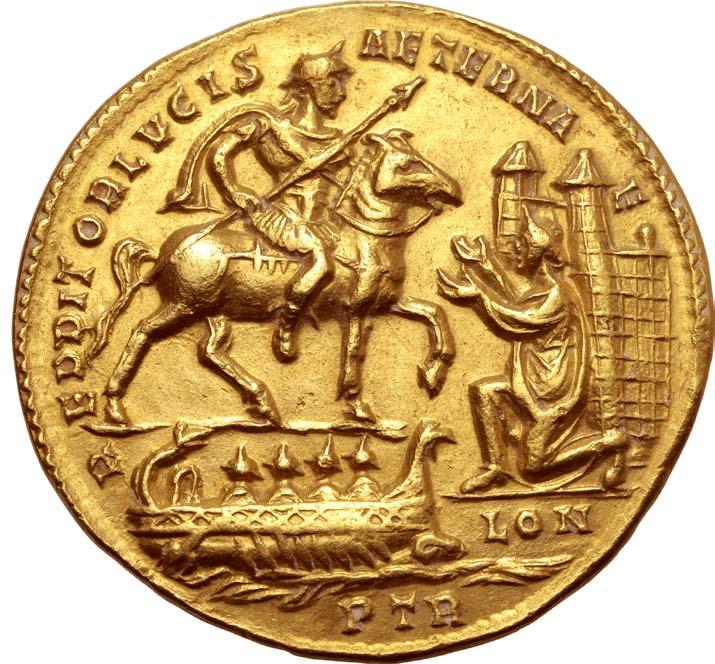
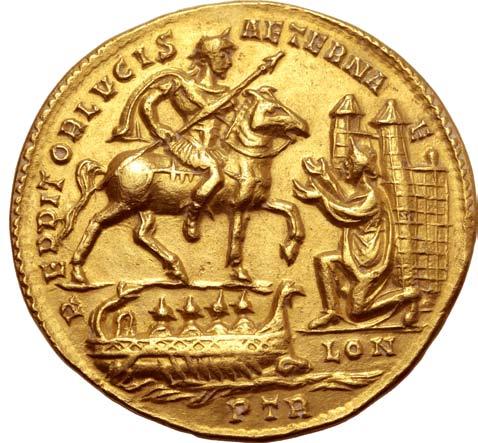
Reproduction: Constantius I, as Caesar, AV Medallion of Ten Aurei. Unknown maker, circa 20th century, copying an issue of Treveri, circa AD 297305. FL VAL CONSTANTIVS NOBIL CAES, laureate, draped and cuirassed bust to right / REDDITOR LVCIS AETERNAE, prince on horseback to right, holding spear, advancing towards city of London represented as a gate with two towers before which a female figure kneels in supplication with LON below, below the horse, galley to right on waves (the Thames), with four rowers; PTR in exergue. For prototype cf. RIC VI 34, p. 167; J. Babelon and A. Duquénoy, ‘Médaillons d’or du Trésor ď Arras; L’entrée de Constance Chlore à Londres en 296 après J.-C’ in Arethuse (Jan. 1924); cf. G. F. Hill ‘Roman coinage in London’, in An Inventory of the Historical Monuments in London, Volume 3, Roman London (London, 1928), note 5 and pl. 67; cf. P. Bastien and C. Metzger, Le trésor de Beaurains, dit d’Arras in Mémoires de la Commission départementale des monuments historiques du Pas-de- Calais (Wetteren: Éditions Numismatique romaine), 1977, no. 218. 52.87g, 39mm, 12h.
Condition as seen.
The Arras Museum holds the original “London medallion” that this piece reproduces. It was found as part of a hoard at Beaurains, near Arras, on 21st September 1922. Some of the gold from the hoard was melted down, some coins were sold to the city of Arras and some were kept by the workers who discovered the hoard and then dispersed. As such it is difficult to be certain of the original size of the hoard although Pierre Bastien estimated that there were originally 700 coins or medallions. (see Bastien and Metzger, Le trésor de Beaurains dit d’Arras, p. 25, 193-194). Arthur Evans informs us that the “London medallion” was only saved from being melted down “by the conscientious scruples of its possessor. The labourer to whose share it had fallen was to such an extent afflicted with doubts as to how far he was its rightful owner that he consulted his father confessor, who lived on the Belgian side of the frontier. The priest, on religious grounds, bade him take it back to his employer, and this important piece was thus saved from the melting-pot. This remarkable medallion may truly be said to supply the most valuable existing memorial of the important place that London occupied in the Roman Empire at the end of the third century.” (A. Evans, “Some Notes on the Arras Hoard: Inception of Solidus Standard on British Model in Medallions of Constantius Chlorus” in The Numismatic Chronicle and Journal of the Royal Numismatic Society, vol. 10, no. 39 (1930), p. 225).
The reserve of the medallion represents Constantius I’s campaign in Britain as recorded in the panegyric for Constantius in which Constantius invades Britain and defeats Allectus, and his soldiers later save the city of London from Frankish mercenaries (see Panegyrici Latini (VIII): Panegyric of Constantius).
A series of cast copies of the medallions from the Arras Hoard were made by M. Etienne Bourgey in the 1920s. Unlike Bourgey’s reproductions, this piece is stamped with an “R” on the obverse and does not match the flan shape of the original therefore it is unlikely to be part of that series.